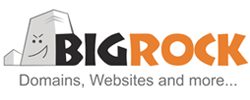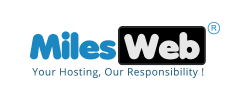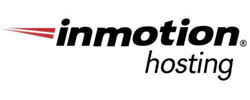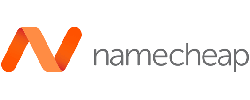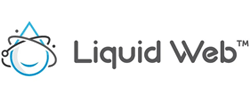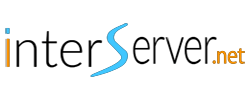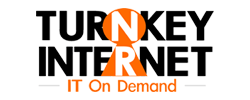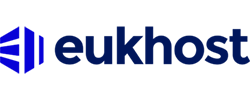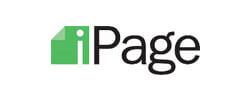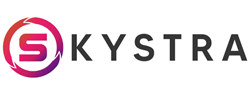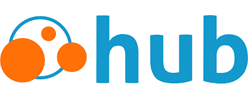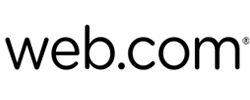30 Best Web Hosting Services Company
Last updated on January 19, 2025 by RGB Web Tech
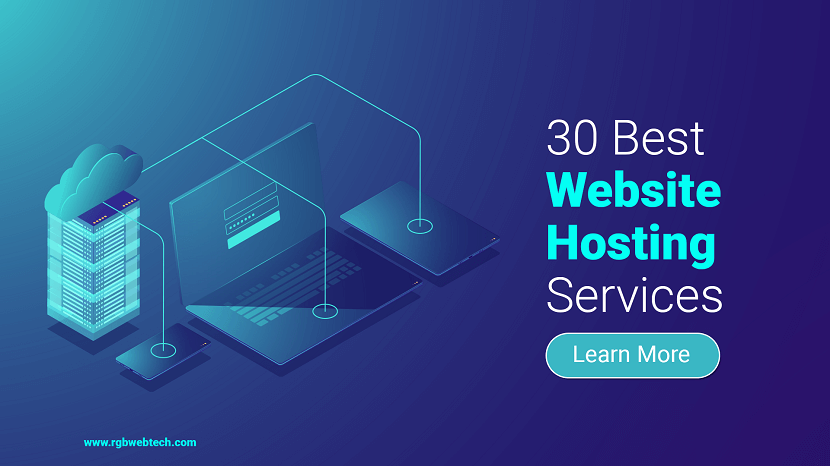
Introduction of Cheap Web Hosting Service
Cheap web hosting service refers to a type of web hosting that is available at a low cost. This hosting service is suitable for individuals, small businesses, or anyone who needs a simple website without the need for advanced features or high-performance servers.
A cheap web hosting service usually offers a shared hosting plan, where multiple websites are hosted on a single server. This type of hosting service is typically less expensive than other hosting options like dedicated hosting or VPS hosting, as the cost of server maintenance and upkeep is shared among multiple users.
While cheap web hosting services may have some limitations, such as limited storage space or bandwidth, they can still provide users with the basic tools and features needed to create and manage a website. These features may include a website builder, email accounts, and access to cPanel or other management tools.
Overall, a cheap web hosting service can be a good option for those on a tight budget who need to get a website up and running quickly without the need for advanced features or customization. It is important to research different providers to find one that offers reliable service and good customer support, as well as a plan that meets your specific needs and requirements.
Table of Article Contents
- What is Web Hosting?
- Top 30 Cheap Web Hosting Service Providers
- Advantages of Cheap Web Hosting Service
- Disadvantages of Cheap Web Hosting Service
- Types of Cheap Web Hosting Service
- Paid V/S FREE Cheap Web Hosting Service
- How to choose Cheap Web Hosting Service?
- Features of Cheap Web Hosting Service
- FAQs
- Conclusion
- Video
What is Web Hosting?
Web hosting refers to the service of providing storage space and access to web servers to host a website on the internet. In simpler terms, web hosting allows individuals or organizations to make their website accessible via the World Wide Web.
When someone wants to access a website, they enter the website's domain name (such as www.example.com) into their web browser. The browser then sends a request to the web hosting server where the website is stored, and the server responds by sending the website's content back to the user's browser, which displays it on the screen.
Web hosting services can be offered by companies that specialize in web hosting, known as web hosts or hosting providers. These companies provide different types of web hosting plans, such as shared hosting, VPS hosting, dedicated hosting, and cloud hosting, each with different levels of performance, security, and scalability.
Web hosting also involves the use of various software and technologies to manage the hosting environment and provide website owners with tools and features to manage their websites, such as cPanel, FTP access, database management, and email hosting.
Overall, web hosting is an essential service that allows businesses and individuals to establish an online presence and make their website accessible to anyone with an internet connection.
Top 30 Cheap Web Hosting Service Providers
Here are the top 30 cheap web hosting service providers along with their sales, discount and pricing plans:
- Exclusive Sale - Upto 60% OFF
- Starting at
$9.99.00$3.49/month*
Inmotion Hosting
- Alexa Rank 5,622
- Exclusive Sale - Upto 75% OFF
- Starting at
$7.99$1.99/month*
iPage
Advantages of Cheap Web Hosting Service
Here are some advantages of using a cheap web hosting service:
1. Affordability: The most obvious advantage of using a cheap web hosting service is affordability. With low-cost plans, you can get started with your website without breaking the bank.
2. Easy to Use: Most cheap web hosting services provide easy-to-use control panels and website builders, making it easy for even beginners to set up their websites.
3. Scalability: Cheap web hosting plans often allow you to upgrade to higher plans as your website grows. This allows you to start with a basic plan and upgrade as needed, without having to switch to a new provider.
4. Technical Support: Despite being low-cost, most cheap web hosting services offer technical support around the clock to help you with any issues you may encounter.
5. Flexibility: Many cheap web hosting services offer a range of plans with different features, allowing you to choose the one that best fits your needs and budget.
6. Good for Small Websites: If you have a small website with low traffic, a cheap web hosting service may be all you need. You can save money on hosting fees and invest in other areas of your website or business.
7. Backup and Security: Even cheap web hosting services offer backup and security features, protecting your website from data loss and security breaches.
Overall, cheap web hosting services can be a great option for individuals and small businesses looking to launch their website on a budget. However, it's important to research and compare different providers to find the one that best meets your needs and budget.
Disadvantages of Cheap Web Hosting Service
While there are many advantages of using a cheap web hosting service, there are also some potential disadvantages to consider:
1. Limited Resources: Cheap web hosting services often have limited resources, such as storage, bandwidth, and processing power. This can affect the performance of your website and limit its scalability.
2. Reliability: With a low-cost hosting plan, you may experience more downtime or slower website loading times due to the sharing of resources among multiple users.
3. Customer Support: While many cheap web hosting services offer 24/7 customer support, the quality of support may be limited due to the lower price point. You may not receive as much help or expertise as you would with a more expensive hosting provider.
4. Limited Features: Cheap hosting plans may have fewer features and limitations, such as limited email accounts, no automatic backups, or no advanced security features.
5. Shared Hosting: Most cheap web hosting plans are shared hosting, which means your website shares the server with other websites. This can cause performance issues or security risks if one of the other websites on the server experiences a problem.
6. Renewal Costs: Some cheap web hosting providers offer promotional rates for the first year, but the renewal costs may be higher. This can catch some people off guard and cause unexpected expenses.
Overall, cheap web hosting services can be a good option for those on a tight budget, but it's important to consider these potential disadvantages and do your research before making a decision. Look for a hosting provider that balances affordability with reliability, features, and customer support.
Types of Cheap Web Hosting Service
There are several types of cheap web hosting services available, each with its own advantages and limitations. Here are some of the most common types:
1. Shared Hosting:Shared hosting is the most common type of hosting, where multiple websites share the same server and its resources, including storage space, bandwidth, and CPU. It is an affordable option for small businesses and individuals who are just starting with their website.
2. WordPress Hosting:WordPress hosting is a specialized type of web hosting designed specifically for websites built on the WordPress content management system (CMS). WordPress is the most popular CMS in the world, used by millions of websites to create and manage their content.
3. Virtual Private Server (VPS) Hosting:VPS hosting involves a server that is partitioned into multiple virtual servers, each with its own resources, operating system, and control panel. It is a step up from shared hosting, providing more control, flexibility, and security.
4. Dedicated Hosting: With dedicated hosting, a website gets its own server, which means all the resources are exclusively dedicated to that website. This option provides the highest level of control, flexibility, and security, but it can also be expensive.
5. Cloud Hosting:Cloud hosting involves a network of interconnected servers that work together to provide hosting resources. This type of hosting is highly scalable, flexible, and reliable.
6. Managed Hosting:Managed hosting involves a hosting provider managing and maintaining a website's server, including updates, security, backups, and more. This option is ideal for those who do not have the technical expertise to manage their own server.
7. Reseller Hosting:Reseller hosting allows individuals or businesses to purchase hosting resources from a hosting provider and resell them to their clients, usually at a higher price. It is a way to start a web hosting business without the need for expensive infrastructure.
8. Colocation Hosting:Colocation hosting, also known as colo hosting or colocation, is a type of web hosting where a company or individual rents space in a data center to store their own servers and equipment. Unlike traditional web hosting, where a hosting provider owns and manages the servers, in colocation hosting, the client owns and manages their own servers and equipment.
9. Self Service Hosting:Self-service hosting, also known as unmanaged hosting, is a type of web hosting where the client is responsible for all aspects of managing their website, including server configuration, software installation, security, and maintenance. The hosting provider only provides the physical server hardware and internet connectivity, but no management services or technical support.
10. Cluster Hosting:Cluster hosting, also known as cloud hosting or clustered web hosting, is a type of web hosting that uses a cluster of servers to host websites and applications. In a cluster hosting environment, multiple servers work together to provide greater performance, scalability, and reliability than traditional hosting options.
Paid V/S FREE Cheap Web Hosting Service
When it comes to web hosting, you often get what you pay for. While free hosting may seem like an attractive option for those on a tight budget, there are some key differences between paid and free cheap web hosting services that you should consider.
Paid Web Hosting Service:
Advantages:
- More reliable: Paid web hosting services typically offer more reliable and consistent performance than free hosting services.
- More resources: Paid hosting plans typically offer more resources, such as storage, bandwidth, and processing power, than free hosting plans.
- Better customer support: Paid hosting providers often offer better customer support, with faster response times and more experienced technicians.
- More features: Paid hosting plans typically offer more features and tools, such as automatic backups, advanced security features, and website builders.
Disadvantages:
- Cost: Paid hosting plans come with a cost, which may be a barrier for those on a tight budget.
- Contract length: Many paid hosting providers require a minimum contract length, which may not be suitable for those who are unsure about their website's future needs.
Free Web Hosting Service:
Advantages:
- No cost: The main advantage of free hosting is that it's free, making it a good option for those on a tight budget.
- Easy to use: Free hosting services often offer simple and easy-to-use website builders and control panels.
- No contract: Free hosting services typically don't require a contract, which provides more flexibility.
Disadvantages:
- Less reliable: Free hosting services often have limited resources and may not offer consistent performance or uptime.
- Limited features: Free hosting plans may have limited features and may not offer advanced tools such as automatic backups or advanced security features.
- Limited support: Free hosting providers may not offer as much support as paid providers, and the support may not be as experienced or responsive.
- Advertisements: Some free hosting services display advertisements on your website, which can be distracting or unprofessional.
Overall, if you're serious about your website and want reliable performance, more features, and better support, paid hosting is generally the better choice. However, if you're on a tight budget and don't need advanced features, free hosting can be a good option to get started.
How to choose Cheap Web Hosting Service?
Choosing the right cheap web hosting service can be a daunting task, especially if you're new to web hosting. Here are some key factors to consider when choosing a cheap web hosting service:
1. Reliability and Uptime: Choose a web hosting company that has a reputation for high uptime and reliability. You want a provider that guarantees at least 99.9% uptime, ensuring that your website is always available to visitors.
2. Server Speed and Performance: Choose a web hosting provider with fast servers and high performance. Slow-loading websites can negatively impact user experience and search engine rankings.
3. Scalability and Flexibility: Choose a web hosting provider that can scale and grow with your website. Your hosting plan should allow you to easily upgrade or downgrade your resources as your needs change.
4. Security: Choose a web hosting provider that takes security seriously, with measures such as SSL certificates, firewalls, malware scanning, and regular backups to protect your website and data.
5. Customer Support: Choose a web hosting provider that offers reliable and accessible customer support, with multiple channels such as phone, email, and live chat available 24/7.
6. Pricing and Value: Choose a web hosting provider that offers a good balance between pricing and value, with transparent pricing and no hidden fees. Compare pricing and features across multiple providers to find the best fit for your needs and budget.
7. User-Friendly Control Panel: Choose a web hosting provider that offers a user-friendly control panel, such as cPanel, which allows you to easily manage your website, email, and other hosting features.
By considering these factors, you can choose a best website hosting service that meets your need and provide a reliable platform for your website.
Features of Cheap Web Hosting Service
Cheap web hosting services may vary in terms of the specific features they offer, but here are some common features you can expect from a good cheap web hosting service:
1. Storage Space: Web hosting provides storage space for all website files, including images, videos, and web pages.
2. Bandwidth: Bandwidth refers to the amount of data that can be transferred between the website and its visitors. Web hosting providers offer different bandwidth limits, so choose a plan that meets your website's needs.
3. Domain Name: A domain name is the website address that visitors use to access your site. Many web hosting providers offer domain registration services.
4. Email Accounts: Web hosting often includes email accounts, which allow you to use your domain name for email addresses, such as [email protected].
5. Control Panel: A control panel allows you to manage your website, email accounts, and other hosting features.
6. Security Features: Web hosting providers offer various security features, such as SSL certificates, firewalls, and malware scanning, to protect your website and data from online threats.
7. Website Builder: Some web hosting providers offer website builders, which allow you to create a website without coding or design skills.
8. Backup and Recovery: Web hosting providers should offer regular backups and a recovery system in case of data loss or website issues.
9. Technical Support: Good web hosting providers offer 24/7 technical support, with multiple channels such as phone, email, and live chat.
10. Scalability: As your website grows, you may need more resources, so choose a web hosting provider that allows you to easily upgrade or downgrade your plan to meet your needs.
FAQs - Cheap Web Hosting Service
Here are some frequently asked questions about cheap web hosting service:
1. What is a cheap web hosting service?
Answer : Cheap web hosting service is a hosting service that offers web hosting at a low cost, usually starting at a few dollars per month. These hosting services are suitable for small websites and individuals who have a limited budget.
2. What are the advantages of a cheap web hosting service?
Answer : The advantages of cheap web hosting services are that they are affordable, easy to use, and can provide all the necessary features to host a website. They are also suitable for small businesses and individuals who have a limited budget.
3. What are the disadvantages of cheap web hosting service?
Answer : The disadvantages of cheap web hosting service are that they may not provide the best performance, uptime, or customer support. They may also have limitations on the resources and features provided.
4. What are the types of cheap web hosting services?
Answer : The types of cheap web hosting service include shared hosting, VPS hosting, cloud hosting, and reseller hosting. Each type has its own advantages and limitations.
5. What should I look for when choosing a cheap web hosting service?
Answer : When choosing a cheap web hosting service, you should consider factors such as price, uptime, performance, features, support, scalability, and reputation.
6. Can I upgrade my hosting plan later?
Answer : Yes, most hosting providers allow you to upgrade your hosting plan as your website grows and requires more resources.
7. Is a free web hosting service a good option?
Answer : Free web hosting service may be a good option for personal websites or experimental projects, but it may not provide the best performance, uptime, or security. It may also have limitations on the resources and features provided. Paid hosting services are generally recommended for businesses and serious websites.
8. What is bandwidth?
Answer : Bandwidth is the amount of data that can be transferred between your website and its visitors. Web hosting providers offer different bandwidth limits, so choose a plan that meets your website's needs.
9. What is a domain name?
Answer : A domain name is the website address that visitors use to access your site. Many web hosting providers offer domain registration services.
10. What is a control panel?
Answer : A control panel is a web-based interface that allows you to manage your website, email accounts, and other hosting features.
11. What is SSL?
Answer : SSL (Secure Sockets Layer) is a security protocol that encrypts data between the website and its visitors. It is important for securing online transactions and protecting sensitive data.
12. What is a website builder?
Answer : A website builder is a tool that allows you to create a website without coding or design skills. Some web hosting providers offer website builders as part of their hosting plans.
13. What is uptime?
Answer : Uptime refers to the amount of time that your website is online and accessible to visitors. Good web hosting providers guarantee at least 99.9% uptime.
14. What is shared hosting?
Answer : Shared hosting is a type of hosting where multiple websites share the same server and its resources. It is an affordable option for small businesses and individuals who are just starting with their website.
15. What is VPS hosting?
Answer : VPS hosting involves a server that is partitioned into multiple virtual servers, each with its own resources, operating system, and control panel. It is a step up from shared hosting, providing more control, flexibility, and security.
16. What is dedicated hosting?
Answer : Dedicated hosting involves a website getting its own server, which means all the resources are exclusively dedicated to that website. This option provides the highest level of control, flexibility, and security, but it can also be expensive.
Conclusion - Cheap Web Hosting Service
In conclusion, cheap web hosting services are an excellent option for individuals and small businesses that have a limited budget. While they may have some limitations compared to more expensive hosting options, they can provide all the necessary features to host a website. When choosing a cheap web hosting service, it's important to consider factors such as price, uptime, performance, features, support, scalability, and reputation. By doing your research and comparing multiple hosting providers, you can find a reliable and affordable hosting service that meets your needs.
You now know which the best Web Hosting Services company is, and you are ready to try one out. Good luck in the world of hosting!
If this article is helpful for you, please share it on your social media handles Because sharing is caring!
If you found this article helpful, we encourage you to share it on your social media platforms—because sharing is caring! For more information about article submissions on our website, feel free to reach out to us via email.
Send an emailWritten by RGB Web Tech
Latest Technology Trends
Latest technology trends shaping the future, including AI advancements, blockchain innovation, 5G connectivity, IoT integration, and sustainable tech solutions. Explore breakthroughs in quantum computing, cybersecurity, augmented reality, and edge computing. Stay ahead with insights into transformative technologies driving innovation across industries and revolutionizing how we live, work, and connect.
10 Different Types of Web Hosting
Last updated on January 19, 2025 by RGB Web Tech
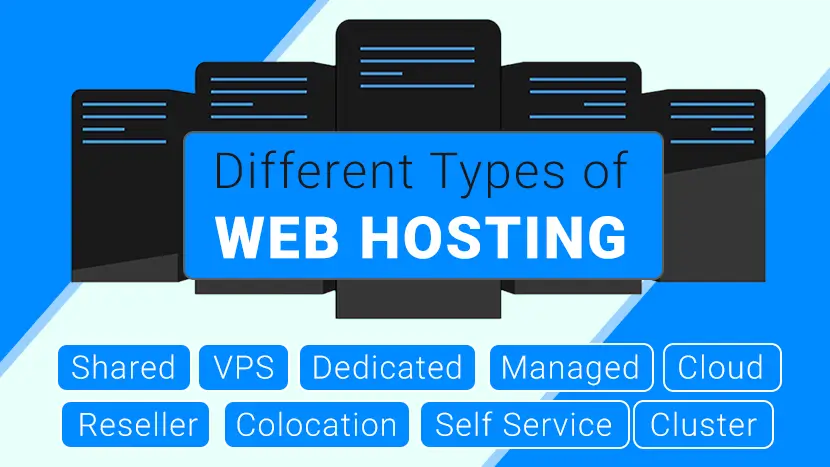
There are different types of web hosting services. So, it can be very difficult to figure out which type of web hosting you need or choose.
In the article, I hope to teach you everything you need to know about web hosting. There are many kinds of web hosting. I can easily see how people get confused so quickly. I will cover the following:
- Shared Hosting — Shared hosting is the most cost-effective plan for entry-level websites.
- VPS Hosting — VPS hosting is for websites that have outgrown shared hosting.
- WordPress Hosting — WordPress hosting optimized for WordPress sites.
- Dedicated Hosting — Dedicated hosting is Enterprise-level servers for large websites.
- Cloud Hosting — Cloud hosting is best for websites that are growing rapidly.
- Reseller Hosting — Reseller hosting is for agencies, web developers, and web designers.
- Managed Hosting — Managed hosting is an IT hosting model in which the client leases servers or cloud computing resources.
- Colocation Hosting — Colocation hosting is where you rent space for your IT hardware at a 3rd party provider’s data center facility.
- Self Service Hosting — Self hosting is a form of running your own website or application by setting up a server and network yourself.
- Cluster Hosting — A Cluster hosting is a host that is configured to take over the role of another host server within a cluster.
Shared Hosting
Shared hosting is a type of web hosting where a single physical server hosts multiple sites. Many users utilize the resources on a single server, which keeps the costs low. Users each get a section of a server in which they can host their website files. Shared servers can host hundreds of users. Each customer using the shared hosting platform’s server has access to features like databases, monthly traffic, disk space, email accounts, FTP accounts and other add-ons offered by the host. System resources are shared on-demand by customers on the server, and each gets a percentage of everything from RAM and CPU, and other elements such as the single MySQL server, Apache server, and mail server.
VPS Hosting
VPS is short for a Virtual Private Server. VPS hosting is one of the most popular hosting services you can choose for your website. It uses virtualization technology to provide you with dedicated (private) resources on a server with multiple users.
It’s a more secure and stable solution than shared hosting where you don’t get a dedicated server space. However, it’s smaller-scale and cheaper than renting an entire server.
VPS hosting is usually chosen by website owners who have medium-level traffic that exceeds the limits of shared hosting plans but still don’t need the resources of a dedicated server.
WordPress Hosting
WordPress hosting is just hosting that has been optimized to better meet WordPress’ performance and security needs. It also typically includes one-click WordPress installs to make it easy to get started with WordPress. And some WordPress hosts will even automatically update your WordPress software as needed.
Dedicated Hosting
Dedicated hosting is a term used to describe web hosting packages that provide a dedicated server with dedicated resources to a single client. Dedicated hosting plans are ideal for WordPress websites with a very large number of visitors. Many WordPress hosting service providers offer Dedicated Hosting plans along with shared and VPS hosting plans.
Cloud Hosting
Cloud hosting is a type of web hosting which uses multiple different servers to balance the load and maximize uptime. Instead of using a single server, your website can tap into a “cluster” that uses resources from a centralized pool. This means that even if one server fails, another kicks in to keep everything running.
Visualize the cloud as a web of different computers which are all interconnected. As more machines are hooked up to the network, more resources are added to the overall cloud.
With cloud hosting, you get a part of the so-called cloud cluster. As opposed to traditional web hosting, where you get a certain amount of space from a single server.
The main benefits of cloud hosting include a major focus on uptime, isolated resources, easy scaling, and a dedicated IP address.
Reseller Hosting
Reseller web hosting is an option that involves one company (a hosting provider) renting hard drive space and bandwidth to another company (small-midsize business), who then rents the space to third parties (entrepreneurs-small business). Simply put, reseller hosting is the ability to provide hosting to your own clients as if you yourself were the web hosting company. This is typical for aspiring entrepreneurs who want to start their own web hosting firm or for current web developers and designers who desire to add additional services to their brand.
Managed Hosting
Managed dedicated hosting is an IT service model where a customer leases dedicated hardware from a managed hosting services provider. This solution includes servers, storage, and networking hardware. Because you aren’t sharing these resources with anyone else, it’s referred to as a single-tenant solution.
When you choose managed dedicated hosting, you get to choose your operating system while your service provider handles the administration, management, and support of your solution. And because you’re not sharing any of these resources with another tenant, you have access to the full performance capabilities of the hardware you’re leasing.
Colocation Hosting
Colocation hosting is a type of service a data center offers, in which it leases space and provides housing for servers. The clients own the servers and claim full authority over the hardware and software. However, the storage facility is responsible for maintaining a secure server environment.
Colocation services are not the same as cloud services. Colocation clients own hardware and lease space, with cloud services they do not have their hardware but lease it from the provider.
Colocation hosting should not be confused with managed (dedicated) services, as the second implies the data center also assumes management and maintenance control over the servers. With colocation hosting, the clients are the one who is responsible for supplying, maintaining, and managing their servers.
Self Service Hosting
Self-service web hosting is done completely on your own. This is the most advanced web hosting. You need to have a place to rent that stores your server. Then you’re responsible for the cooling, power, bandwidth, hardware, system administrator, backups, etc.
Cluster Hosting
Cluster hosting is sometimes confused with Cloud or Grid hosting. It is simply a group of servers that operate together and act as one “mega” server. The big difference between cluster hosting and cloud hosting is cluster hosting is over a smaller area. For instance, there could be a cluster of servers along the eastern coast of the United States.
Cluster hosts are typically billed on an hourly or monthly rate.
List of Popular Web Hosting Service Providers:
Read More : You can explore here 30+ Best Web Hosting Providers
Video - Best Web Hosting For Small Business
Affordable Website Hosting for your domainIf you found this article helpful, we encourage you to share it on your social media platforms—because sharing is caring! For more information about article submissions on our website, feel free to reach out to us via email.
Send an emailWritten by RGB Web Tech
Latest Technology Trends
Latest technology trends shaping the future, including AI advancements, blockchain innovation, 5G connectivity, IoT integration, and sustainable tech solutions. Explore breakthroughs in quantum computing, cybersecurity, augmented reality, and edge computing. Stay ahead with insights into transformative technologies driving innovation across industries and revolutionizing how we live, work, and connect.
19 Best Front End Framework for Web Development
Last updated on January 19, 2025 by RGB Web Tech
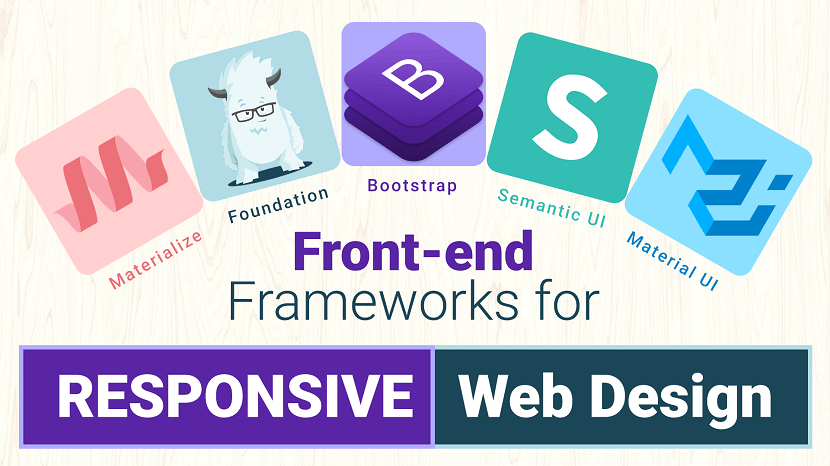
Front-end frameworks for responsive web design have become essentially important for the websites. There has already been too much buzz about the ongoing practice of using a responsive framework while initiating web designing. Because of the effectiveness of these frameworks, they are becoming more popular among the developers. Responsive frameworks are far better than the non-responsive ones. Additionally, they are effective and help in the development of user-centric applications.
Responsive web design front-end frameworks include CSS and HTML5 tags and thus they are the best choice to create exceptional website designs. There are several best front-end frameworks available to use to create exceptional websites. Here is a brief on some of the most renowned frameworks used popularly by developers.
1. Twitter Bootstrap
This list would be woefully incomplete without the inclusion of the wildly popular frontend framework, Bootstrap. Created by Twitter developers and initially released in 2011, it's the most used open source framework in the world.
Like any effective frontend framework, Bootstrap includes CSS, HTML and JavaScript, or JS, components. It adheres to responsive web design standards, allowing you to develop responsive sites of all complexities and sizes.
Because it is updated continually, Bootstrap typically includes the latest and best features. For example, it added themes that met Google's material design guidelines shortly after they were published, and it was also upgraded to use Sass as a CSS preprocessor.
Pros:
- Massive community support.
- Widest variety of themes.
- Best browser capability.
- Has both a fluid and fixed pattern grid system.
- More development tools available.
- Many popular websites are built on this framework.
- Superiority in mobile support.
- Most of the celebrated custom web development companies prefer this tool.
Cons:
- Not as lightweight when compared to others. Out-of-the-box file size of 276 KB due to an excessive number of rarely used styles.
- Difficult to use jQuery plugins.
- Websites are easily recognizable.
- The excessive number of HTML classes and DOM elements can be messy and confusing.
Ideal for: Beginners and those who prefer a robust front-end framework.
2. Foundation
Created by web design company Zurb, Foundation is a highly advanced, enterprise-grade frontend framework that is ideal for developing nimble, responsive websites. Used on sites like Facebook, eBay, and Mozilla, it is also fairly complex and may not be suitable for newbies.
This features-rich framework supports GPU acceleration for smooth, lightning fast animations and Fastclick.js for fast rendering on mobile devices. It runs on the Sass preprocessor and includes the Foundation-developed data interchange attribute, which lets you load lightweight HTML sections for mobile and "heavier" HTML sections for larger screens. For a comparison between Foundation and Bootstrap, read our complete article, Bootstrap vs Foundation.
Pros:
- Offers finest of the customization abilities.
- Possess a robust grid system.
- Provides rapid development of code.
- Easy to use templates available for download.
- Offers services for sites as well as emails.
- Design-it-yourself approach.
- Lightweight.
Cons:
- More complex when trying to customize.
- Not a great framework for beginners.
- Less popular in comparison to Bootstrap.
Ideal for:Developers who have decent amounts of experience and who are primarily concerned with developing fast, attractive, responsive websites.
3. Semantic UI
A relative newcomer on the scene, Semantic-UI stands out in several ways and is poised to become one of the most popular front-end frameworks out there.
This framework's main claim to fame is its simplicity. Because it uses natural language, the code is self-explanatory. Even those with very little coding experience will feel fairly at home working with this framework.
Another notable feature of Semantic-UI is that it is integrated with a dizzying array of third-party libraries. So much so, that you probably won't need to use any others. Therefore, the development process is a bit easier and more streamlined.
Pros:
- Semantic class names make for a low barrier of entry, so even beginners can hit the ground running.
- Small file sizes and minimal load times because you can load only the components that you need; each has its own JS file and style sheet.
- Versatile elements make for easy customization.
Cons:
- Very large packages when compared to Foundation and Bootstrap.
- Those with more complex design and development needs may find this framework lacking.
Ideal for: Beginners and those who want a lightweight, nimble framework.
4. Material UI
If you're looking for a front-end framework that makes it easy to adhere to Google's material design guidelines, you can't go wrong with Material UI. It is by far the most elaborate framework to implement these guidelines thus far, but there is one caveat: It isn't meant to be a starting point for a brand-new web design project.
Loaded with ready-to-use CSS and material design-compliant components, Material UI uses a CSS-in-JS solution. This unlocks many great features including theme nesting, dynamic styles, self-support, etc.
Pros:
- The easiest way to meet Google's material design guidelines when using a framework.
- Highly customizable.
Cons:
- Not intended to serve as a starting point for from-scratch web design projects.
- Need a decent understanding of React to use effectively.
Ideal for: Developers who understand and have experience with React and who need an easy way to adhere to material design guidelines.
5. Materialize
The Materialize responsive front-end development framework also implements Google's material design specifications and is loaded with ready-to-use buttons, icons, cards, forms, and other components. It is offered in both a standard version and in one that runs on Sass.
Materialize includes a convenient IZ column grid feature that can be used for website layouts. It is also loaded with CSS that's ready to use out of the box for material design shadows, typography, colors, and other features.
Additional features include ripple-effect animation, drag-out mobile menus, Sass mixins, and more.
Pros:
- Huge selection of components.
- Responsive support ensures that websites are supported across all devices.
Cons:
- The large file size makes this a bulky framework to work with.
- No support for Flexbox model.
Ideal for: Less experienced developers who need guidance regarding Google's material design specifications.
6. UIKit
UIKit is a highly modular front-end framework that stands out among most front-end development frameworks for many reasons. Chief among them is the fact that it includes both Less and Sass CSS preprocessors.
Loaded with an array of nimble, responsive components with consistent naming conventions, UIKit has become one of the most popular front-end frameworks out there.
It's more than 30 extendable, modular components can be combined for even more versatility. It includes navigation components like side navigation bars; elements like HTML forms and tables; JavaScript components like off-canvas bars and modal dialogs; common elements like buttons, badges, and overlays; and layout components, including a fluid, completely responsive grid system.
Pros:
- Highly customizable.
- Exceptionally modular, so you can add components to the style sheet without negatively impacting overall style.
- Create advanced user interfaces using components like nestable.
Cons:
- Very few resources out there due to the relative newness.
Ideal for: Fairly experienced developers due to the current lack of available resources. Otherwise, it is great for simple and complex projects alike.
7. Pure
Created by the Yahoo development team, Pure comes with a lightweight array of CSS modules that can be used in just about any project. Using Pure, you can easily create responsive buttons, menus, grids, tables, and other features. Because it is purely CSS based, however, it does not support JavaScript or jQuery plugins.
When minified and compressed with Gzip, Pure clocks in at just 4.5 KB, making it one of the lightest and nimblest front-end development frameworks out there. As a result, it is terrific for mobile website development, and many developers rely on it for precisely that.
Pros:
- Extremely lightweight, ensuring fast loading times even on mobile devices.
- A flexible array of CSS modules can be used on just about any web design and development project.
Cons:
- CSS only - does not include jQuery or JS plugins.
Ideal for: Developers who are focusing on creating responsive, fast mobile websites.
8. CreateJS
CreateJS is a suite of open-source JavaScript libraries and tools for creating rich, interactive HTML5 content. It consists of 5 modular JavaScript libraries. It will help you with implementing animation effects, supporting HTML5 audio on your website, and much more.
Adobe, Microsoft, and AOL sponsor this project.
Pros:
- It is helpful for rich, interactive HTML5 content.
Cons:
- You have basic knowledge of JavaScrip.
Ideal for: It is ideal for creating animation effects and HTML5 Audios on your website.
9. HTML5 Boilerplate
In 2010, HTML5 Boilerplate became one of the first, and subsequently, most popular open-source front-end web development tools for getting HTML5 websites and web apps up and running in no time. It’s a compilation web development solution that enables our websites to support modern web browsers.
Included in HTML5 Boilerplate is a mobile-friendly HTML template, placeholder icons, CSS resets for normalizing/standardizing your stylesheet property values, standard media queries for popular viewing screens, an HTML5shiv for non-modern web browsers, and more.
Pros:
- It is an open-source front-end web development tool.
- Mobile-friendly HTML template.
Cons:
- It required basic knowledge of HTML/HTML5 and CSS/CSS3.
Ideal for: It is ideal for designing responsive websites.
10. Milligram
Milligram is another extremely lightweight framework similar to Skeleton. When Gzipped, it comes out to just 2 KB in size and is used to provide developers with a simplistic and convenient starting point.
Milligram’s grid system is different than most because of its use of the CSS Flexible Box Layout Module standard. It also includes a few key components for getting you started including typography, buttons, forms, lists, tables, blockquotes, etc.
Pros:
- Very lightweight, only 2 KB when Gzipped.
- Uses CSS Flexbox as the grid system.
Cons:
- Few resources available due to the relative newness.
- Minimal styling components available compared to other larger frameworks.
Ideal for: Developers who are creating a small project that doesn't require any styling components and want to use a CSS Flexbox grid system.
11. Susy
Some would argue that Susy isn't a Front-end Framework in the truest sense of the term because it is focused on solving complex layout needs. Many classify Susy as a grid maker more than anything, but it can be an indispensable tool for those who have specialized layout needs.
Susy arms you with mixins that can be used to create grids. The framework does all of the calculations for you, saving a lot of time and effort.
With Susy, you can create any kind of grid layout imaginable. If you have been looking for a way to do this, Susy may be the answer.
Pros:
- Superior flexibility, so you can create any kind of grid layout that you need.
- Automatically performs all calculations.
Cons:
- Does not cover all aspects of website design, so you still need another framework solution.
- No pre-built grids.
Ideal for: Anyone who has unique or specialized layout requirements.
12. Zebra
Zebra is a rich UI open-source framework that leverages HTML5 canvas as the backbone of its rendering abilities.
Zebra says that using it “isn’t rocket science” and that you can get started in 5 minutes.
13. Siimple
Flexible, aesthetically built and a concise front-end CSS framework to accomplish clean web pages. Siimple is beautiful and mostly used for building web pages that are flat and clean. Working on these simple things sometimes proves to be exceptionally well for the development of user-centric websites. This framework is certainly minimal, having a few lines of codes that can also be zipped down to 6KB in total size. This framework is suitable for newbies who are just starting with their website designing and require a framework to experiment freely. Siimple helps such developers to create minimal and clean web designs.
14. Less Framework
Less Framework is a modern Front-end framework for building responsive designs. Similar to Skeleton (discussed above), Less Framework focuses on being just a plain and simple layout grid framework.
It has 4 pre-built layouts: Default, Tablet, Mobile, and Wide Mobile.
15. Montage HTML5 Framework
Being an HTML5 framework, Montage is great to kick start modern web page development. Montage has got the elements that help in the creation of scalable and feature-rich websites. These exceptional elements also help to maintain the HTML5 applications for a range of devices whether a desktop or a smartphone. Montage is amazing in its ways. It has got reusable components along with HTML templates in addition to the declarative component model, declarative data binding, and much more than it.
16. SproutCore
SproutCore is a front-end framework for building HTML5 apps rapidly.
It follows the MVC architecture pattern and promises its users the ability to craft native-like user experiences for the Web.
17. Cascade
Cascade is a great relief to the developers as it offers both semantic and non-semantic grid layouts along with base templates, navigational elements, table designs. Cascade has got a universal approach and thus it is easy for designers to include several elements in their design. With Cascade in use, designers, as well as developers, have got the option of creating high-performance web pages for a variety of browsers right from the older ones to the new browsers. Cascade can be used by developers to choose and work on the components most important for a particular project.
18. Skeleton
Skeleton is a lightweight responsive boilerplate that contains only 400 lines of code. This framework is meant to include only the minimum requirements to get you started on the development of a web project. It is not meant to be all-inclusive such as other frameworks as mentioned above.
Skeleton is also responsive, based on a 12-column grid system, and includes the bare essentials such as buttons, lists, tables, forms, etc.
Pros:
- Extremely lightweight.
- Greater simplicity and useful for smaller projects.
Cons:
- It does not include a wide selection of utility/styling components such as larger frameworks do.
Ideal for:Someone who is creating a smaller project that doesn't require all of the style components of a larger framework.
19. HTML KickStart
One of the newest kids on the block, HTML5 KickStart is a lean and mean package of HTML, CSS, and JavaScript files that promises to save UI developers hours of work.
At about 300KB, HTML KickStart packs quite a punch: UI components like stylish buttons and navigation bars, scalable icons (using Font Awesome), a responsive grid layout, a touch-enabled slideshow component and so on.
FAQs - Front-end frameworks
1. Which is the Best CSS Framework?
Answer : That depends on the website you’re looking to build. The most popular CSS framework, however, is Bootstrap.
2. What is a CSS Framework?
Answer : A CSS framework is a library of CSS stylesheets with pre-done code to help you design websites faster.
3. Why Do CSS Frameworks Use Preprocessors?
Answer : CSS frameworks use preprocessors to automate tasks.
4. Which Files Do You Need for CSS Frameworks?
Answer : You need CSS files from respective frameworks and sometimes JavaScript and HTML files.
Conclusion
There are plenty of Front-end frameworks, but we have chosen the best Front-end frameworks that matter in 2023. Out of these 19, we cannot say which one is best, as each has its own set of features. By choosing the right Front-end frameworks for your needs, all the complicated and time-consuming styling is taken care of, and you can focus on writing business logic.
If you’re just starting out with CSS and UI, go for Pure, or Skeleton. However, to build more complex elements, you’ll need a more inclusive framework like Bootstrap, Foundation, Material UI etc. read our complete article, Bootstrap vs Foundation.
If you found this article helpful, we encourage you to share it on your social media platforms—because sharing is caring! For more information about article submissions on our website, feel free to reach out to us via email.
Send an emailWritten by RGB Web Tech
Latest Technology Trends
Latest technology trends shaping the future, including AI advancements, blockchain innovation, 5G connectivity, IoT integration, and sustainable tech solutions. Explore breakthroughs in quantum computing, cybersecurity, augmented reality, and edge computing. Stay ahead with insights into transformative technologies driving innovation across industries and revolutionizing how we live, work, and connect.
Bootstrap Front End Framework for Web Design
Last updated on January 19, 2025 by RGB Web Tech
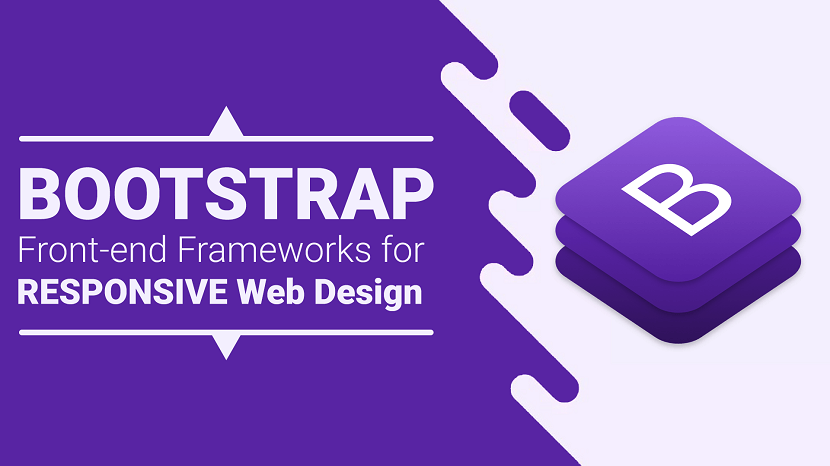
Bootstrap is a free and open-source CSS framework directed at responsive, mobile-first front-end web development. It contains CSS- and (optionally) JavaScript-based design templates for typography, forms, buttons, navigation, and other interface components.
Highlights:
- Author: Mark Otto, Jacob Thornton
- Developer's: Bootstrap Core Team
- Initial release: August 19, 2011
- Written in: HTML, CSS, Less (v3), Sass (v4) and JavaScript
- Platform: Web platform
- Open-source: Yes
- Website: https://getbootstrap.com
- Alexa Rank: 2,108
Bootstrap 4 Alpha 6 Features:
1. Rewritten grid system in flexbox: They improved the grid system with three major changes. Here, one can disable the grid classes by the SASS variable. You can add a grid customization section to the documents. You will see also witness simplified grid classes. These changes are available in both standard and flexbox grids.
2. Flexbox by default: Along with flexbox being the default system. There are flexbox grids, also available, apart from standard ones. And new flexbox alignment utility classes at hand for distributing items as well.
3. IE9 support: Bootstrap CSS has released this long-awaited update of IE9 support.
4. Forms: With development to Alpha 4, there are significant changes in forms. There are necessary improvements in sizing, alignment, and component layout. The ‘fresh form validation and help text options are ready. And the documentation for forms is simplified too.
5. Automatic equal-width grid columns: Breakpoint-specific column classes can be employed for columns with equal width.
6. Updated and improved Navbar: Earlier there were certain styles for nav components that could not be set by variables. This update takes care of that and also adds some new features to it.
7. Auto margins for easy spacing: They improved the auto margins for easy spacing.
8. Change in system fonts: Helvetica/Arial font was old system fonts. They are replaced with a system font stack of modern, and strong fonts. This is done for companies like Apple, Google, Mac, to target the latest devices. Although, there is no such update available for Linux users.
Pros:
- Massive community support.
- Widest variety of themes.
- Best browser capability.
- Has both a fluid and fixed pattern grid system.
- More development tools available.
- Many popular websites are built on this framework.
- Superiority in mobile support.
- Most of the celebrated custom web development companies prefer this tool.
Cons:
- Not as lightweight when compared to others. Out-of-the-box file size of 276 KB due to an excessive number of rarely used styles.
- Difficult to use jQuery plugins.
- Websites are easily recognizable.
- The excessive number of HTML classes and DOM elements can be messy and confusing
Popular Brands Using Bootstrap:
- Lyft
- Vogue
- Riot Design
- Newsweek
Ideal for: Beginners and those who prefer a robust front-end framework.
Bootstrap Alternatives: If you want to explore more responsive Front-end Frameworks for your upcoming projects than you can Visit Here.
Bootstrap Alternatives: If you want to explore bootstrap alternatives. Visit Here
Bootstrap, originally named Twitter Blueprint, was developed by Mark Otto and Jacob Thornton at Twitter as a framework to encourage consistency across internal tools. Before Bootstrap, various libraries were used for interface development, which led to inconsistencies and a high maintenance burden.
After a few months of development by a small group, many developers at Twitter began to contribute to the project as a part of Hack Week, a hackathon-style week for the Twitter development team. It was renamed from Twitter Blueprint to Bootstrap and released as an open-source project on August 19, 2011. It has continued to be maintained by Mark Otto, Jacob Thornton, and a small group of core developers, as well as a large community of contributors.
Bootstrap 2
On January 31, 2012, Bootstrap 2 was released, which added built-in support for Glyphicons, several new components, as well as changes to many of the existing components. This version supports responsive web design, meaning the layout of web pages adjusts dynamically, taking into account the characteristics of the device used (whether desktop, tablet, or mobile phone).
Bootstrap 3
The next major version, Bootstrap 3, was released on August 19, 2013. It redesigned components to use flat design and a mobile-first approach.
Bootstrap 4
Mark Otto announced Bootstrap 4 on October 29, 2014. The first alpha version of Bootstrap 4 was released on August 19, 2015. The first beta version was released on 10 August 2017. Mark suspended work on Bootstrap 3 on September 6, 2016, to free up time to work on Bootstrap 4. Bootstrap 4 was finalized on January 18, 2018.
Significant changes include:
- Major rewrite of the code.
- Replacing Less with Sass.
- Addition of Reboot, a collection of element-specific CSS changes in a single file, based on Normalize.
- Dropping support for IE8, IE9,[contradictory] and iOS 6.
- CSS Flexible Box support.
- Adding navigation customization options.
- Adding responsive spacing and sizing utilities.
- Switching from the pixels unit in CSS to root ems.
- Increasing global font size from 14px to 16px.
- Dropping the panel, thumbnail, pager, and well components.
- Dropping the Glyphicons icon font.
- Huge number[quantify] of utility classes.
- Improved form styling, buttons, drop-down menus, media objects, and image classes.
- Bootstrap 4 supports the latest versions of Google Chrome, Firefox, Internet Explorer, Opera, and Safari (except on Windows). It additionally supports back to IE9 [contradictory] and the latest Firefox Extended Support Release (ESR).
Bootstrap 5
Bootstrap 5 is a updated version of bootstrap4 and Bootstrap 5 alpha was officially released on June 16, 2020 after several months of refining. With all of the major changes in this version, the Boostrap 5 development team informed the users that the current version is still in alpha version thus, breaking changes will continue to occur until the first beta is released so it’s better to always check the open issues and pull requests on their official GitHub repository for open questions and feedback.
Summary of the most important changes:
- jQuery was removed
- Switch to Vanilla JavaScript
- Drop Internet Explorer 10 and 11 support
- Improved grid system
- Improved documentation
- Improved modularity
- Improved forms
- New responsive font
- New utilities & helpers
- Easier customization & theming
- Lighter package
- New API available
Bootstrap Alternatives: If you want to explore more responsive Front-end Frameworks for your upcoming projects than you can Visit Here.
If you found this article helpful, we encourage you to share it on your social media platforms—because sharing is caring! For more information about article submissions on our website, feel free to reach out to us via email.
Send an emailWritten by RGB Web Tech
Latest Technology Trends
Latest technology trends shaping the future, including AI advancements, blockchain innovation, 5G connectivity, IoT integration, and sustainable tech solutions. Explore breakthroughs in quantum computing, cybersecurity, augmented reality, and edge computing. Stay ahead with insights into transformative technologies driving innovation across industries and revolutionizing how we live, work, and connect.
Foundation Front-End Frameworks for Web Deisgn
Last updated on January 19, 2025 by RGB Web Tech
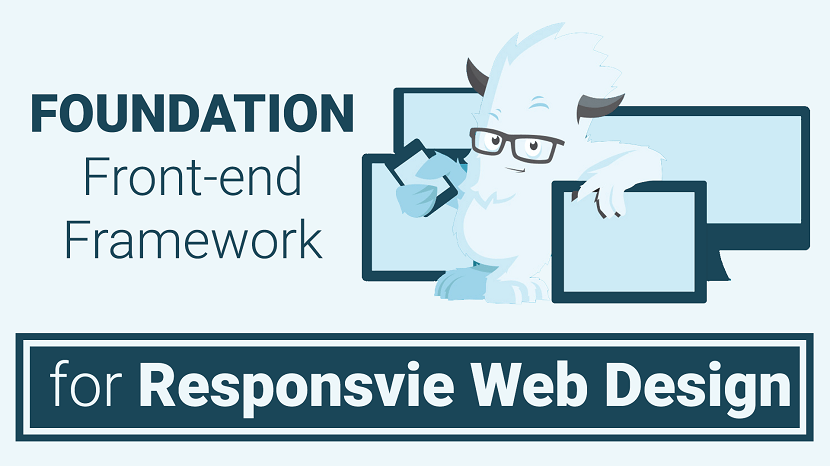
Foundation is a CSS framework designed by ZURB in September 2011. It has a slightly more advanced interface compared to other frameworks. Foundation is compatible on multiple browsers and hand held devices. The responsive menu is one of its greatest assets. The menu is incredible when it comes to functionality and can also be easily styled using CSS. This responsive framework allows designers and developers to create elegant websites with more of a design-it-yourself approach. It has responsive grid ( HTML & CSS) UI components, templates, and code snippets, including typography, forms, buttons, navigation and other interface elements, as well as optional functionality provided by JavaScript extensions.
Highlights
- Developer's: ZURB
- Initial release: September 2011
- Written in: HTML, CSS, Sass and JavaScript
- Open source: Yes
- Website: get.foundation
- Alexa Rank: 36,606
Foundation 6.4 Features:
1. Includes XY grids: The latest version of Foundation includes a strong default grid system namely XY grids. This makes you control the layouts displayed both horizontally and vertically.
2. Flexbox by default: Although there is a feature available which allows the fall back to float-mode, Flexbox is what they recommend.
3. Smooth scrolling: This feature can be used to create “smooth scroll” behavior for any link available inside the page.
4. Shifted to ES2016 JavaScript: Foundation moved its javascript architecture to ES2016 module-based architecture. If one does not have a module bundler. The drop-in compiled JS files in dist/js will provide backward compatibility.
5. Easier prototyping: The process of prototyping and production often confuses people. With this feature, Foundation offers a better way and a “prototype mode” to speed up the prototyping function.
Pros:
- Offers finest of the customization abilities.
- Possess a robust grid system.
- Provides rapid development of code.
- Easy to use templates available for download.
- Offers services for sites as well as emails.
- Design-it-yourself approach.
- Lightweight.
Cons:
- More complex when trying to customize.
- Not a great framework for beginners.
- Less popular in comparison to Bootstrap.
Popular brands using Foundation
- Adobe
- Amazon
- Ebay
- Pixar Projection
- Washington Post
- Herschel Supply
Ideal for: Developers who have decent amounts of experience and who are primarily concerned with developing fast, attractive, responsive websites.
Foundation Alternatives: If you want to explore more responsive Front-end Frameworks for your upcoming projects than you can Visit Here.
Foundation emerged as a ZURB project to develop front-end code faster and better. In October 2011, ZURB released Foundation 2.0 as open source under the MIT License. ZURB released Foundation 3.0 in June 2012, 4.0 in February 2013, 5.0 in November 2013, and 6.0 in November 2015. The team started working on the next version of Foundation for Sites 7 which most likely will drop support for older browsers and implement newer technologies like flexbox or maybe calculated grid system.
Foundation for Emails, formerly known as ZURB Ink, was released in September 2013.
Foundation for Apps was released in December 2014.
Foundation was designed for and tested on numerous browsers and devices. It is a mobile first responsive framework built with Sass/SCSS giving designers best practices for rapid development. The framework includes most common patterns needed to rapidly prototype a responsive site. Through the use of Sass mixins, Foundation components are easily styled and simple to extend.
Since version 2.0 it also supports responsive design.This means the graphic design of web pages adjusts dynamically, taking into account the characteristics of the device used (PC, tablet, mobile phone). Additionally, since 4.0 it has taken a mobile-first approach, designing and developing for mobile devices first, and enhancing the web pages and applications for larger screens.
Foundation is open source and available on GitHub. Developers are encouraged to participate in the project and make their own contributions to the platform.
1. Grid system and responsive design: Foundation comes standard with a 940 pixel wide, flexible grid layout. The toolkit is fully responsive to make use of different resolutions and types of devices: mobile phones, portrait and landscape format, tablets and PCs with a low and high resolution (widescreen). This adjusts the width of the columns automatically.
2. Understanding CSS stylesheet : Foundation provides a set of stylesheets that provide basic style definitions for all key HTML components. These provide a browser and system-wide uniform, modern appearance for formatting text, tables and form elements.
3. Reusable components : In addition to the regular HTML elements, Foundation contains other commonly used interface elements. These include buttons with advanced features (for example, grouping of buttons or buttons with drop-down option, make and navigation lists, horizontal and vertical tabs, navigation, breadcrumb navigation, pagination, etc.), labels, advanced typographic capabilities, and formatting for messages such as warnings.
4. JavaScript components and plug-ins : The JavaScript components of Foundation 4 were moved from jQuery Javascript library to Zepto, on a presumption that the physically smaller, but API-compatible alternative to JQuery would prove faster for the user. However, Foundation 5 moved back to the newer release JQuery-2. "jQuery 2.x has the same API as jQuery 1.x, but does not support Internet Explorer 6, 7, or 8." The official Zurb blog explains, and the unsigned writer claims that the switch back was due to issues of compatibility with customized efforts; and that performance was found to be not as good, on use testing with the newer jQuery-2.
Foundation jQuery components provide general user-interface elements and branded extensions. The list includes dialog, tooltips, carousels, alerts, clearing, cookies, dropdown, forms, joyride, magellan, orbit, placeholder, reveal, section, topbar, flex video, and many others. Additional jQuery plug-ins can be installed into the Foundation framework to provide advanced functionality in any UI area, including animation and "off-canvas" elements like slide-in menus.
Foundation Alternatives: If you want to explore more responsive Front-end Frameworks for your upcoming projects than you can Visit Here.
If you found this article helpful, we encourage you to share it on your social media platforms—because sharing is caring! For more information about article submissions on our website, feel free to reach out to us via email.
Send an emailWritten by RGB Web Tech
Latest Technology Trends
Latest technology trends shaping the future, including AI advancements, blockchain innovation, 5G connectivity, IoT integration, and sustainable tech solutions. Explore breakthroughs in quantum computing, cybersecurity, augmented reality, and edge computing. Stay ahead with insights into transformative technologies driving innovation across industries and revolutionizing how we live, work, and connect.
Comparison Bootstrap Between Foundation
Last updated on January 19, 2025 by RGB Web Tech
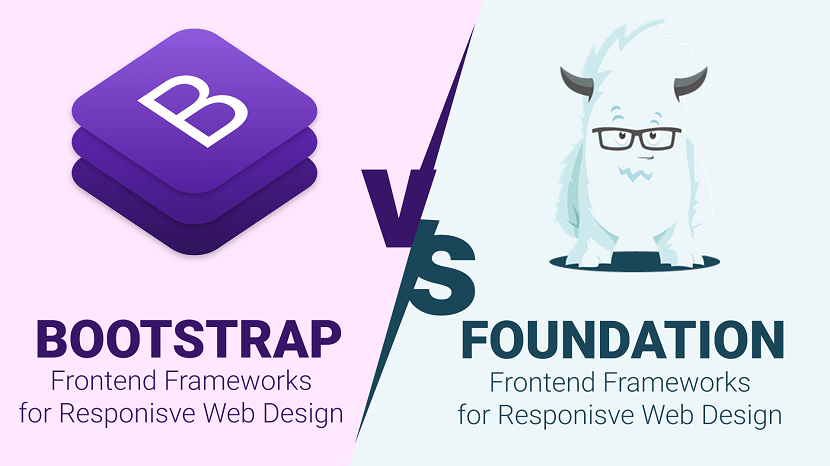
When it comes to being a developer and designer you usually always reach a crossroads of which CSS framework should you use? There are so many Front-end frameworks, but two of the most commonly mentioned ones are Bootstrap and Foundation.
Here is a comparison between Bootstrap and Foundation:
| Parameters | Bootstrap | Foundation |
|---|---|---|
| Current Version | V 4.0 alpha 6 | V 6.4 |
| Preprocessors | Less & Sass | Sass |
| Grid system | Flexbox-based | Floated (flexbox in latest version) |
| Customization | Basic GUI customizer | Basic GUI customizer |
| Community | 112k + (stars on Github) | 25.8k + (stars on Github) |
| Browser support | Chrome (Mac, Windows, iOS, and Android), Safari (Mac and iOS only), Firefox (Mac and Windows), Opera (Mac and Windows) IE9+ | Chrome (Mac, Windows, iOS, and Android), Safari (Mac and iOS only), Firefox (Mac and Windows), Opera (Mac and Windows), IE9+ |
| Design | Customizable; a variety of designs. | Not that appealing |
| Normalization/ Reset | reboot.css | normalize.css |
| Inline forms | Yes | No |
| License | MIT | MIT |
| Website | getbootstrap.com | get.foundation |
Front-end Frameworks List: If you want to explore more responsive Front-end Frameworks for your upcoming projects than you can Visit Here.
Conclusion: In order to make a conclusion which framework is better, you have to decide which one suits your requirements. In order to decide you must go through the features that each has to offer. With the given features currently listed, you must overlook that Foundation is quickly evolving and new updates are released frequently. Simply put, Foundation offers a slightly more complex, but a do it yourself style approach that will create something more unique and custom. Whereas Bootstrap allows for easy creation of simple yet elegant websites, with very little knowledge of CSS and JavaScript. Any CSS framework you chose will drastically simplify the web development process and provide the necessary foundations to build an amazing website.
If you found this article helpful, we encourage you to share it on your social media platforms—because sharing is caring! For more information about article submissions on our website, feel free to reach out to us via email.
Send an emailWritten by RGB Web Tech
Latest Technology Trends
Latest technology trends shaping the future, including AI advancements, blockchain innovation, 5G connectivity, IoT integration, and sustainable tech solutions. Explore breakthroughs in quantum computing, cybersecurity, augmented reality, and edge computing. Stay ahead with insights into transformative technologies driving innovation across industries and revolutionizing how we live, work, and connect.
What is the best CSS Framework
Last updated on January 19, 2025 by RGB Web Tech
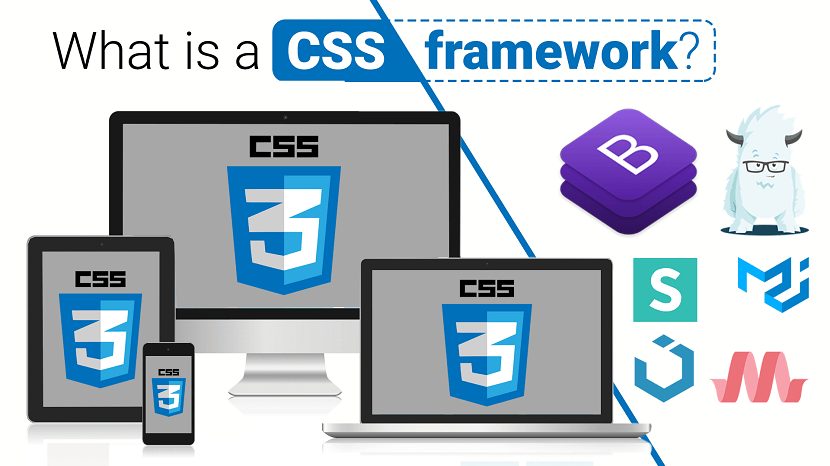
When it comes to being a developer and designer you usually always reach a crossroads of which CSS framework should you use? There are many out there to choose from, but two of the most commonly mentioned ones are Bootstrap and Foundation. In this post, we will be comparing the two CSS frameworks, Bootstrap vs Foundation. Read more below about how using a framework can help speed up and streamline your development and design process.
What is a CSS framework?
Building a website or app from scratch can take a lot of time and development. A CSS framework is commonly used by developers and designers as a tool to speed up the process. A CSS framework, also sometimes referred to as a frontend framework, is essentially a package that is made up of predefined HTML, CSS, and JS which can be used when starting to build out a project. This way you don't have to code from a blank slate every time you need to create a website or web application. In this post, we are specifically focusing on frontend frameworks which usually have to deal with what the visitor actually sees.
A CSS framework usually consists of the following components:
- HTML code which helps make up the structure of the pages.
- Typography styles.
- CSS to visually change how elements appear (a standard set of easy to use classes).
- JavaScript to change dynamic elements such as drop downs, expanding menus, etc.
- Responsive media queries.
- Cross-browser compatibility fixes.
Front-end Frameworks List: If you want to explore more responsive Front-end Frameworks for your upcoming projects than you can Visit Here.
If you found this article helpful, we encourage you to share it on your social media platforms—because sharing is caring! For more information about article submissions on our website, feel free to reach out to us via email.
Send an emailWritten by RGB Web Tech
Latest Technology Trends
Latest technology trends shaping the future, including AI advancements, blockchain innovation, 5G connectivity, IoT integration, and sustainable tech solutions. Explore breakthroughs in quantum computing, cybersecurity, augmented reality, and edge computing. Stay ahead with insights into transformative technologies driving innovation across industries and revolutionizing how we live, work, and connect.
Advantages and Disadvantages of Front-End Frameworks
Last updated on January 19, 2025 by RGB Web Tech
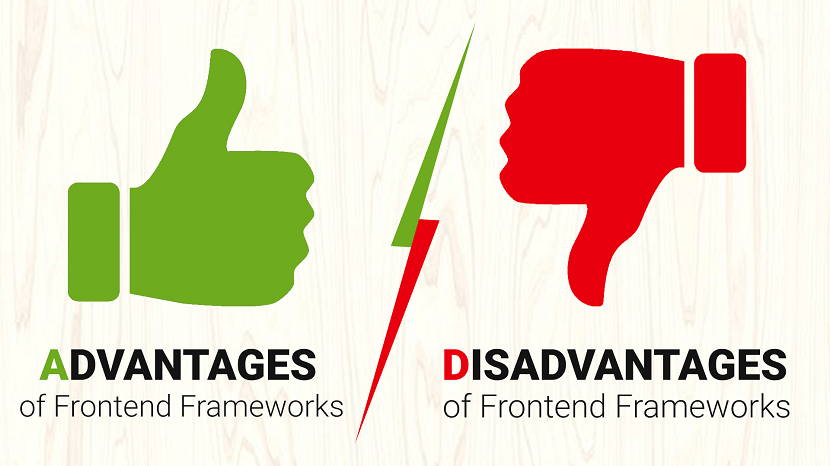
As developers, we often find ourselves looking for ways to be more efficient. For many of us, this means turning to front-end frameworks. Whether it is robust, full-featured frameworks like Bootstrap or Foundation or more foundational frameworks such as Skeleton or Pure, developers are turning to these tools to get a jumpstart on web projects.
Advantages of Using a Front-end Framework
First, let’s take a look at a few Advantages of using a front-end framework.
- Easy and quick to get started.
- They are great for prototyping.
- You can gain momentum by “getting something on the page”.
- They are handy when you are against tight deadlines.
- They provide a solid foundation for responsive design.
- Components of the UI have a base style to be extended (forms, buttons, navbar, etc.)
- The base styles persist throughout.
- They provide a consistent UI design for developers who lack design skills, which is great for things like intranet sites or documentation.
- They provide a base development for non-developers to get something up quick for prototyping or mockups.
Good looking UI, even out-of-the-box
- Components of the UI have a base style to be extended (forms, buttons, menus, etc.)
- The base styles persist throughout.
- They provide a consistent UI design for developers who lack design skills, which is great for things like intranet sites or documentation.
- They provide a base development for non-developers to get something up quick for prototyping or mockups.
Code is reliable and tested
- Code is widely used, especially open source.
- Cross-browser compatibility is built-in, so you know where it will work.
Help is readily available
- Front-end frameworks are widely used, so answers to common problems are easy to find.
- The documentation is usually thorough.
- Free and professional themes and templates may be available.
Disadvantages of Using a Front-end Framework
While development frameworks have been gaining in popularity over the past few years, not all frameworks are created equal and often a front-end framework is not the right tool for the job. Here are a few disadvantages I have found to using them:
They can be too opinionated
Although they are easy to get started, they can require more time down the road to add features and customizations. You might find yourself fighting the base styles with overrides (wasting all that precious time you saved) to get the desired results. This can also lead you to write code that does not evolve gracefully as the project needs change.
Note: Some of these risks can be mitigated by selecting a framework which is more flexible or closely resembles your project. I would advise testing out different frameworks, so you have a better understanding of the advantages and limitations of these tools when a new project comes along.
You’re not learning how to code
It is easy to fall into the trap of only learning the framework and not learning how to develop. You often miss out on valuable experience with the underlying technology. If you are not already an expert, it is important to understand the code which powers the framework. This knowledge will make life a lot easier when you run into complex challenges and will make you a better developer overall.
Updates can introduce issues
- Updating may introduce conflicts with your code.
- When it comes to updates, at the mercy of the framework developers. Sure, you can choose not to update, but you then risk falling behind.
Technical debt
- Developers coming onto the project will need to understand the framework in order to contribute.
- “One-size-fits-all” frameworks tend to have a larger footprint and can add unnecessary bloat to your project.
Front-end Frameworks List: If you want to explore more responsive Front-end Frameworks for your upcoming projects than you can Visit Here.
Conclusion: As with most development decisions, the choice to use a framework and which framework to use should be made based on the requirements of a specific project. What may be perfect for a small marketing website, may not be so great for building a highly-customized web portal. With new frameworks popping up frequently, but as developers, it’s still important to be diligent in selecting frameworks that suit our needs and the needs of our clients.
If you found this article helpful, we encourage you to share it on your social media platforms—because sharing is caring! For more information about article submissions on our website, feel free to reach out to us via email.
Send an emailWritten by RGB Web Tech
Latest Technology Trends
Latest technology trends shaping the future, including AI advancements, blockchain innovation, 5G connectivity, IoT integration, and sustainable tech solutions. Explore breakthroughs in quantum computing, cybersecurity, augmented reality, and edge computing. Stay ahead with insights into transformative technologies driving innovation across industries and revolutionizing how we live, work, and connect.
Milesweb Hosting : As Trusted As They Say ? Find Out Here in Review
Last updated on January 19, 2025 by RGB Web Tech

Getting online reputation is as important to get up your brand identity as good as possible which impacts your business. Many people look for hosting their website in well-reputed hosting company that offers them the services they expect from them in budget friendly pricing. However, there are huge differences in brands and it’s essential to pick a web host that suits your needs in order to have a successful online business. It’s always nice to get more than you paid for in terms of features and service you expect from hosting provider. There are many web hosting that we can look for but we need to get out the best out of many hosting provider. Few things like speed of the website, server location, security, pricing factor, Uptime guarantee. Select a web hosts that have great features with speed and price.
A good web host that provides the more features but not proper support service is not worth than to get host with them.
Whereas, MilesWeb is a very good web host for newbie bloggers, affiliate marketers, small-medium scale businesses offering excellent 24x7 support.
Check out that why MilesWeb would be best for you.
1. You can get a web host that’s based in India.
MilesWeb it’s an ideal for you to host your site as your audience might enjoy faster speeds. also they are best hosting provider in India. You might also prefer the audience accordingly to target them.
2. You can get a global brand that covers India
With global brands usually come better global speeds. If your target audience is global than choose hosting that offers server location with your target location. MilesWeb gives you both the option as their servers are present in India, UK, USA, Australia, Canada and Singapore .You get good experience with performance and overall service they also offer the best reseller hosting in India. which is highly trusted in terms of services and exposure.
MilesWeb Pros:
- Generous discounts and offers for the initial billing cycle.
- Excellent Uptime of 99.95%.
- Supports a variety of payment methods.
- Extremely Cheap.
- Various payments option.
- Support In local Language.
- Free Domain and Free Migration.
- Cheap Managed Hosting.
MilesWeb Cons:
- No free domain in Tyro plan.
- No discount coupons for domain name registrations.
What they offer ( FEATURES )
- Free SSL certificate
- Unmetered Bandwidth and Storage
- SSD Storage
- 99.95% uptime guarantee
- 30 Day Money-back guarantee
- 24/7/365 support
- Global Datacenter
MilesWeb Unlimited Web Hosting Features
1) Free Domain
With MilesWeb Swift and Turbo plan you get free domain name and unlimited features for your site as mentioned in their hosting plans.

2) Free SSL
We also really like how they provide a free SSL certificate which I would liked to talked about not every web host does that I would like to see more such as free domain privacy. MilesWeb offers free SSL with all its hosting plans so you don’t have to worry about the security of your website.
3) SSD storage
SSD storage delivers super-fast performance adding a boost to the page loading speed. As compared to traditional HDD, the SSDs are much faster and better.
4) Free Site Builder
Building your site is easy when you buy a web hosting plan from MilesWeb. Just drag and drop images and content using the site builder and your website will be ready in minutes.
5) cPanel
With the help of a graphic user interface managing your website will be hassle-free. With the help of cPanel you can create FTP accounts, email accounts, databases add domains, etc.
CustomerReview
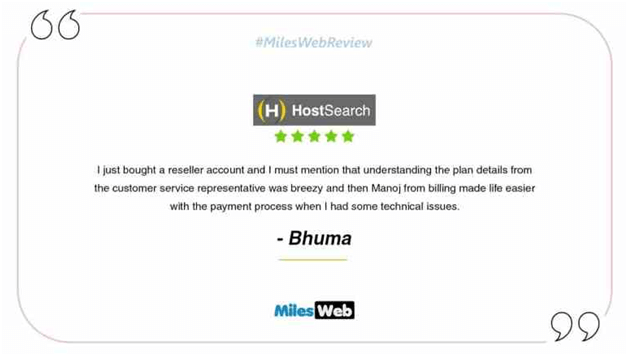

6) Email
Access your emails through IMAP/ POP3 with webmail support at anytime, anywhere. With MilesWeb you also get unlimited Email Accounts with the unlimited hosting plan.
7) One-click install
With just a single-click, these apps can be installed in a jiffy. With just OneClick Installer you get free apps like WordPress, Joomla, Drupal, Cubecar, etc easily.
8) Free migration
Migrating your site to the MilesWeb server is not a concern anymore. They have expert technical team who handles the issue and helps you to migrate your site easily. They don’t charge for the migration process its completely free of cost.

Uptime
Uptime determines the time that the server your site runs on stays working in Uptime your site is visible to the customer.MilesWeb offers 99.95% Uptime which is best in the industry.
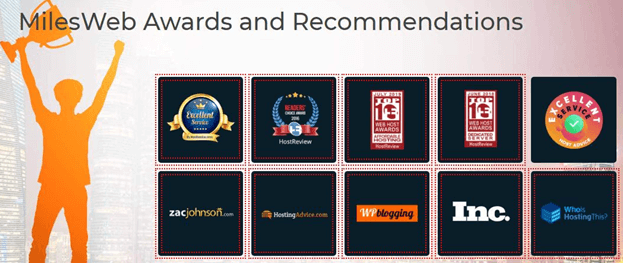
24*7 Customer Support
Customer Support is one of those aspects of a service that is important for any hosting provider and that makes difference in hosting. MilesWeb Customer Support is best as they are available 24x7 for you. Another thing I want to clarify is about the speed and well not this isn’t the biggest section of the review because most of the good web host providers have pretty good stability and offers excellent performance.
What are the types of web hosting?
This answer will be different for everyone. It depends on the type of website you have, the resources you need, your budget, and traffic.
We gave our top recommendation for each category in this guide, so that’s the best place for you to start your search.
Once you know what you need, you can narrow your options. To figure out what category you fall in, here’s a quick recap of the different hosting types.
Final Verdict
However, if price is your priority then MilesWeb hosting will suit your needs just fine, especially if you’re targeting the local Indian demographic. They’ve got very fast local pings, but you’ll be giving up features and helpful customer support.
I bet MilesWeb is extremely fast and I can verify that in my testimony web sites using this web host that is extremely true it’s a very fast web host and the uptime is also good as well.
Alternatives - Web Hosting Providers
If you want to explore more web hosting plans, here is some web hosting services provider companies as below:
Read More : You can explore here 30+ Best Web Hosting and Domain name Providers 2023
Video - Best Web Hosting For Small Business
Affordable Website Hosting for your domainIf you found this article helpful, we encourage you to share it on your social media platforms—because sharing is caring! For more information about article submissions on our website, feel free to reach out to us via email.
Send an emailWritten by RGB Web Tech
Latest Technology Trends
Latest technology trends shaping the future, including AI advancements, blockchain innovation, 5G connectivity, IoT integration, and sustainable tech solutions. Explore breakthroughs in quantum computing, cybersecurity, augmented reality, and edge computing. Stay ahead with insights into transformative technologies driving innovation across industries and revolutionizing how we live, work, and connect.
Domainracer Unlimited Hosting Review
Last updated on January 19, 2025 by RGB Web Tech

DomainRacer is a decent hosting supplier in the industry, offering a full scope of hosting services. They are one of the quickest developing Web Hosting suppliers in the market at the present time.
DomainRacer gives cheap unlimited web hosting solutions to a wide range of sites, whether the website is newly created or well established.
DomainRacer is an India-based site hosting supplier. It boldly claims to be the "worldwide leader in giving the cheapest web hosting services". Sure, yet I can't discover anything on the web which can deny this claim.
It offers most cost saving shared hosting plans, dedicated server plans, Reseller hosting plans, Linux virtual private servers (VPS), and even WordPress hosting, so there's a better than average scope of alternatives. However, does it have the correct alternatives for you? Is it "the best," like it intensely guarantees?
Let’s check out this DomainRacer Hosting Review!
What they offered...
DomainRacer offers complete variety of services to fulfil the entire website hosting need required for any kind of business. Their hosting services come with the attractive features like 99.9% uptime, Quick support, highest speed and many more.
If you are hunting for the best affordable hosting plans then DomainRacer is the best choice for you as per DomainRacer hosting review domain. They offered the services as mentioned below:
- Domain Name Registration.
- Shared Web Hosting.
- VPS Hosting
- Dedicated Server
- Reseller Hosting
- Affiliate Program
DomainRacer Web Hosting Highlights
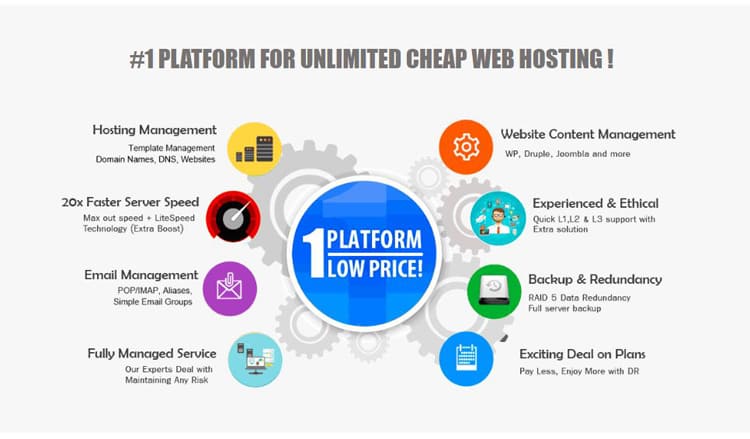
At the point when it comes time to choose your web hosting, don't invest a lot of energy with price and get overpowered with the a wide range of features they bring to the table.
I am not simply going to talk about their advantages and disadvantages. And furthermore, I am going to test their hosting whether by DomainRacer login hosting review and domain price is actually a decent web hosting supplier or not?
Much of the time, a minimal effort shared hosting plan and affiliate hosting review is all that could possibly be needed for most of locales on the web today. Rather, ensure the web have you are taking a gander at is genuine, has a single click installation, affordable plans, latest features and incredible client assistance.
DomainRacer Hosting Speed Test
Those up to date know that DomainRacer Hosting pays attention to their speed very. They've contributed a great deal to make their servers speedy and quick, and they have reaction time to show it.
In the event that you've never known about their Turbo Servers, they're exceptionally changed to give us huge speed helps. At the point when joined with their Turbo Cache, the servers can load web pages up to multiple times speedier than standard servers.
To deal with customer demands everywhere throughout the globe, DomainRacer Hosting has set up 7 server centres – USA, UK, India, France, Germany, Indonesia and Canada. So we can pick the best server area to suit our necessities.
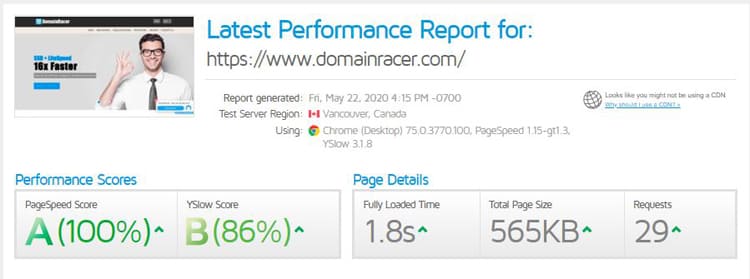
We have checked the speed of the DomainRacer and it is just amazing and loads website in just 1.8s which is really fast as compared to others. They give SSD space to optimise speed and boost performance.
Domainracer Unlimited Hosting Review
Domainracer Unlimited Hosting ReviewMultiple Data Centres for Faster Speed
At the point when somebody hits your site just because, you need to ensure it loads as quick as could reasonably be expected. To improve the website performance and loading time of your site, it's ideal to have server's area nearest to the individual getting to your site.
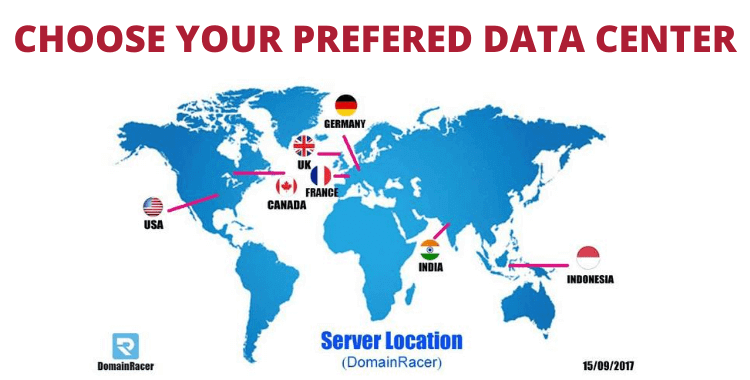
DomainRacer offers the flexibility to choose the data center nearer to your target audience is located. The data centres of DomainRacer are spread worldwide in countries like UK, US, Canada, France, Germany, Indonesia and India.
Some web hosting solutions just have one data center area, which is incredible — however it is smarter to have servers situated all through the world. This is something like DomainRacer as of now has set up with their various server areas.
Cheapest Hosting Plans
Finding the best combination of all the required features, support and price of plans is also an important factor. DomainRacer is constantly working on providing the quality of services at lowest cost and offer a great website experience to customers.
Their hosting plans are included with the lot more exciting features and the basic shared hosting plan started from only ₹ 59/mo. Prices go higher with the additional added benefits.
Below you will see the affordable shared hosting packages of DomainRacer and their features offered.
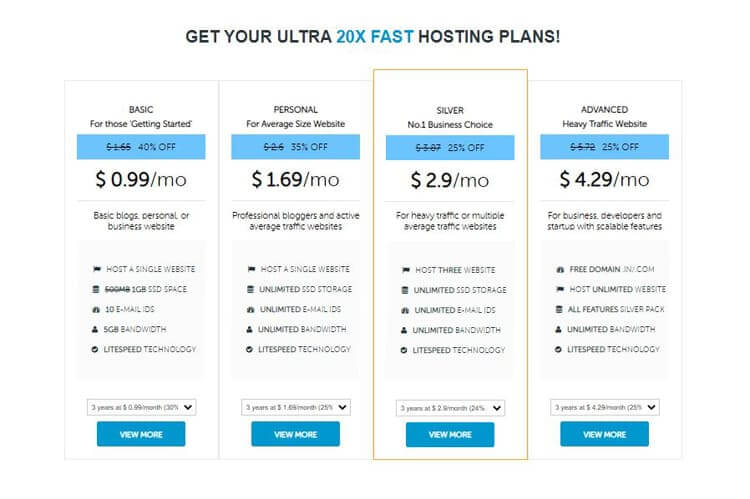
As I have checked all the hosting plans of them like shared hosting, VPS hosting, dedicated server and reseller hosting. After analysis and comparison with the other hosting provider in the industry I realised that DomainRacer offers the lowest cost plans in the industry with awesome features added.
DomainRacer reseller hosting review cPanel plans if you wish to start own web hosting company. They offer the best benefits to generate maximum profit margin by your business.
You can select the best cheap Linux web hosting plan for your business whether it is a start-up or well established business. DomainRacer have variety of plans according to your business size and your requirement.
Latest SSD Storage for Great Website Performance
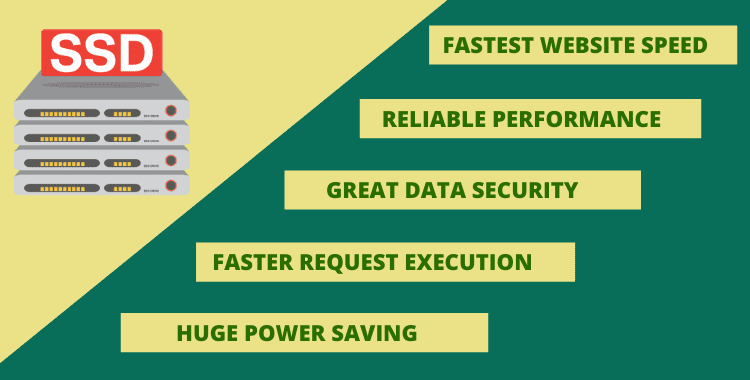
DomainRacer provide the SSD storage hosting which gives the way much better performance than the HDD storage hosting. SDD utilise the flash memory and tends to heat up less that’s why they process data at faster rate than HDD as it consume less energy.
SSD storage plays a very important role in improving the speed and the website performance. This is what makes DomainRacer provide the fastest hosting services in low cost.
Responsive Customer Support
Client support or technical support is the foundation of the organization. The organization is engaged at giving a nonstop client help, to measure any sort of question.
To make a reliable situation, DomainRacer have made a variety of services with driving industry features and furthermore 24/7 instant support around the year, guaranteeing appropriate working of your site by hosting review account.
A few people incline toward email or live chat or telephone support. With DomainRacer, all clients have full support access via call, email, live chat, ticket and WhatsApp chat — while additionally being accessible all day, every day.
The expert support team members always ensure that the problem being solved early and everything about customer’s website is running smoothly. Customer satisfaction is their first priority. They have got many appreciations for their exceptionally great customer support which makes them stand out in crowd.
Top Notch Security
Regardless of whether you have an individual website that you use essentially to blog once in a while or a worldwide, large scale business, security is of most extreme significance. Security is likely the part of web email hosting comparison that is generally critical to everybody, and on the off chance that it isn't, it ought to be.

Absence of security can be destroying to a business if these issues bring about loss of revenue or data fraud. Hence, it is critical to comprehend what parts of security you should search for and how to decide whether your host gives security enough.
Fortunately DomainRacer website hosting review economy knows that there is an interest for powerful security and they are tuning in to the requests of their clients. They offer many security tools to provide customers a tight security to save them from any loss with the tools like DDos Protection, Spam protection, Firewall, Imunify360, imunifyAV+ and free SSL Certificate.
There are two interesting points. In the first place, you should be certain your web host is dealing with their servers to give a protected domain. Next, they ought to give the fundamental devices to guarantee you can make sure about your site and its usefulness.
99.99% Sever Uptime
Uptime is the most significant piece of hosting your site. This ought to be the primary thing you use to weigh the quality of a potential hosting supplier.
If the hosting supplier has solid uptime rates like WordPress DomainRacer hosting review features, at that point it's a decent sign that their servers perform well. So on the off chance that you pick a supplier dependent on this metric, at that point you can expect that your site will keep awake and running almost constantly.
In case you're in the market for a spending plan agreeable host that flaunts strong uptime no matter how you look at it, at that point consider DomainRacer. Their uptime ensure is 99.9%, in addition to its sponsored up in the terms of service.
Get Unlimited Bandwidth
Proceeding a few years, web hosting with boundless bandwidth was only a desire. Yet, today upgrades in server innovation have made this conceivable. DomainRacer offers you the super-quick web connectivity with SSD storage and unlimited bandwidth of simultaneous clients at fast speed, regardless of whether they are stacked with substantial information.
Boundless hosting plans of DomainRacer, which normally highlight vast plate space for record storage and boundless bandwidth to withstand traffic to your site, are a famous decision for dynamic sites. At the point when request builds, you don't need to stress over your site totally smashing.
Free SSL Certificate
"HTTPS" has become the image of a secured site. Additionally, the search engines will in general give more inclination to the domains with SSL protection. DomainRacer offers a free SSL declaration with all its Linux hosting plans for boundless domains.
SSL authentications empower secure information move between the server and the client's program.
Furthermore, HTTPS is considered as a positioning sign and gives a little SEO lift to your site.
These days, individuals incline toward purchasing from HTTPS-empowered sites rather than non-secure sites.
Try not to stress!
DomainRacer web services offers free Let's Encrypt SSL Certificate to ensure your site safety. Business hosting review sites or web based business stores may consider purchasing premium SSL Certificate from outsider organizations for an extra layer of security.
Free Website Builder
Website Builder causes you; construct your site without any problem. You will discover a ton of free templates to construct your site. It makes your site building process simpler.
You will get a free website builder with DomainRacer and you should simply choose your template, include pictures and content and distribute. There is definitely no requirement for coding knowledge and specialized foundation.
It likewise incorporates a one-click script auto-installer and free website builder with the goal that you can bring your business online quickly.
Is It Worth To Buy DomainRacer Hosting?
Yes! Highly Recommended
DomainRacer is proved to be the cheapest hosting provider which will be best for all those who want to save money with great quality. They offer e everything that we needed in the hosting provider like fastest speed with powerful servers, uptime guarantee, high level security, cheapest hosting plans, free website builder and many more.
DomainRacer offers the best hosting solutions-easy to handle and operate with, fast and equipped with industry standard software, and guaranteed uptime. DomainRacer has numerous different advantages and is a profoundly preferred web hosting server in the present situation.
Alternatives - Web Hosting Providers
If you want to explore more web hosting plans, here is some web hosting services provider companies as below:
Read More : You can explore here 30+ Best Web Hosting and Domain name Providers 2023
Video - Best Web Hosting For Small Business
Affordable Website Hosting for your domainIf you found this article helpful, we encourage you to share it on your social media platforms—because sharing is caring! For more information about article submissions on our website, feel free to reach out to us via email.
Send an emailWritten by RGB Web Tech
Latest Technology Trends
Latest technology trends shaping the future, including AI advancements, blockchain innovation, 5G connectivity, IoT integration, and sustainable tech solutions. Explore breakthroughs in quantum computing, cybersecurity, augmented reality, and edge computing. Stay ahead with insights into transformative technologies driving innovation across industries and revolutionizing how we live, work, and connect.
Adobe Dreamweaver HTML Editor
Last updated on January 19, 2025 by RGB Web Tech

Adobe Dreamweaver is a proprietary web development tool from Adobe Inc. It was created by Macromedia in 1997 and developed by them until Macromedia was acquired by Adobe Systems in 2005.
Adobe Dreamweaver is available for the macOS and Windows operating systems.
Following Adobe's acquisition of the Macromedia product suite, releases of Dreamweaver subsequent to version 8.0 have been more compliant with W3C standards. Recent versions have improved support for Web technologies such as CSS, JavaScript, and various server-side scripting languages and frameworks including ASP (ASP JavaScript, ASP VBScript, ASP.NET C#, ASP.NET VB), ColdFusion, Scriptlet, and PHP.
Highlights:
- Developer(s) - Adobe Inc. (2005–present)
- Macromedia - (before 2005)
- Initial release - December 1997; 22 years ago
- Stable release - 2020 (20.1) / February 2020; 5 months ago
- Written in - C++
- Operating system - Windows 10 version 1703 and above, macOS 10.12 Sierra and above
- Type - HTML editor, programming tool, integrated development environment (IDE)
- License - Trialware software as a service
- Website - https://www.adobe.com/products/dreamweaver.html
Key Features:
1. Fast, flexible coding: Create, code, and manage dynamic websites easily with a smart, simplified coding engine. Access code hints to quickly learn and edit HTML, CSS, and other web standards. And use visual aids to reduce errors and speed up site development.
2. Set up to site up in fewer steps: Get your sites up and running faster with starter templates that you can customize to build HTML emails, About pages, blogs, e-commerce pages, newsletters, and portfolios. And because Dreamweaver is part of Creative Cloud, you can quickly bring in assets from your Libraries and Adobe Stock to enhance your sites.
3. Dynamic display on every device: Build responsive websites that adapt to fit any screen size. Preview your sites and edits in real time to make sure your pages look and work the way you want before you publish.
4. Seamless Live View editing: Edit text and image properties and add classes directly in Live View with one click — then preview changes instantly. No need to switch to a separate edit mode.
5. Multi-monitor support for Windows: Now you can expand your workspace by displaying your pages on multiple monitors.
6. Redesigned, modern UI: A streamlined and clutter-free interface lets you customize your workspace to show only the tools you need to code.
7. Git support: Collaboration is easy with Git support. Manage all your source code within Dreamweaver and perform all common operations right from the Git panel.
Alternatives to Adobe Dreamweaver
- Visual Studio Code HTML Editor
- Notepad++ HTML Editor
- Bubble WYSIWYG Editor
- Sublime Text HTML Editor
- Atom HTML Editor
- CKEditor WYSIWYG Editor
- TinyMCE WYSIWYG Editor
- NetBeans HTML Editor
- Komodo Edit HTML Editor
- Froala WYSIWYG Editor
- Brackets HTML Editor
- CoffeeCup HTML Editor
- Editor.js WYSIWYG Editor
- Phase 5 HTML Editor
- Kompozer WYSIWYG Editor
- UltraEdit HTML Editor
- BareBones Edit HTML Editor
- TextMate HTML Editor
- Setka WYSIWYG Editor
- Aptana Studio HTML Editor
- CotEditor HTML Editor
- Bluefish HTML Editor
- NoteTab HTML Editor
If you want to explore more about Text Editor or WYSIWYG Editor, We recommend you to go through our detailed article of HTML Editors.
If you found this article helpful, we encourage you to share it on your social media platforms—because sharing is caring! For more information about article submissions on our website, feel free to reach out to us via email.
Send an emailWritten by RGB Web Tech
Latest Technology Trends
Latest technology trends shaping the future, including AI advancements, blockchain innovation, 5G connectivity, IoT integration, and sustainable tech solutions. Explore breakthroughs in quantum computing, cybersecurity, augmented reality, and edge computing. Stay ahead with insights into transformative technologies driving innovation across industries and revolutionizing how we live, work, and connect.
24 Best HTML and CSS Editor
Last updated on January 19, 2025 by RGB Web Tech

We all make mistakes, and that also applies to write code. But whether you’re just starting or are a seasoned vet, making an error in your code can cause you a real headache. As we use all kinds of tools to help us with simple tasks, such as spellcheck for writing, an HTML (HyperText Markup Language) editor is no different. HTML editors have a lot of features behind them, and we will be covering that and much more when we look at the list of the best HTML editors.
There are two types of HTML editors available:
Since we discussed what is an HTML Editor and when to use one, we can finally sink our teeth into the actual editors themselves and pick the best HTML Editor.
We all have different tastes, and when it comes to choosing a platform for our work, where we will spend a lot of time on, it’s important to pick one that best suits us. Each editor has the same basic features. However, some provide more visual representation than others, more additional packages to install, and so on.
The list of the Best HTML Editors is based on popularity, features, design and alexa rank:
1. Adobe Dreamweaver CC HTML Editor

Adobe Dreamweaver is a proprietary web development tool from Adobe Inc. It was created by Macromedia in 1997 and developed by them until Macromedia was acquired by Adobe Systems in 2005.
Adobe Dreamweaver is available for the macOS and Windows operating systems.
Following Adobe's acquisition of the Macromedia product suite, releases of Dreamweaver subsequent to version 8.0 have been more compliant with W3C standards. Recent versions have improved support for Web technologies such as CSS, JavaScript, and various server-side scripting languages and frameworks including ASP (ASP JavaScript, ASP VBScript, ASP.NET C#, ASP.NET VB), ColdFusion, Scriptlet, and PHP.
Highlights:
- Alexa Rank - 53
- Developer(s) - Adobe Inc. (2005–present)
- Macromedia - (before 2005)
- Initial release - December 1997; 22 years ago
- Stable release - 2020 (20.1) / February 2020; 5 months ago
- Written in - C++
- Operating system - Windows 10 version 1703 and above, macOS 10.12 Sierra and above
- Type - HTML editor, programming tool, integrated development environment (IDE)
- License - Trialware software as a service
- Website - https://www.adobe.com/products/dreamweaver.html
2. Visual Studio Code HTML Editor

Visual Studio Code is a free source-code editor made by Microsoft for Windows, Linux and macOS. Features include support for debugging, syntax highlighting, intelligent code completion, snippets, code refactoring, and embedded Git. Users can change the theme, keyboard shortcuts, preferences, and install extensions that add additional functionality.
Visual Studio Code's source code comes from Microsoft's free and open-source software VSCode project released under the permissive Expat License, but the compiled binaries are freeware for any use.
Highlights:
- Alexa Rank - 973
- Developer(s) - Microsoft
- Initial release - April 29, 2015
- Stable release - July 23, 2020
- Written in - TypeScript, JavaScript, CSS
- Operating system - Windows 7 or later, OS X 10.9 or later, Linux
- Type - Source code editor, debugger
- License - Source code for Expat License & Binaries for Freeware
- Website - https://code.visualstudio.com
3. Notepad++ HTML Editor

Notepad++ is a free HTML editor that was developed for Windows-based machines. Linux users can also use it via Wine. This editor is distributed as free software and its repository is also available in GitHub. Like other community projects, third-party plugins are supported.
Notepad++ distinguishes its development environment for its simplicity. Notepad++ is super lightweight; there’s even a mobile version if you fancy it. Here are some highlights:
Highlights:
- Alexa Rank - 5991
- Developer(s) - Don Ho
- Initial release - 24 November 2003
- Stable release - July 16, 2020
- Written in - C++
- Operating system - Microsoft Windows
- Type - Source Code Editor
- License - GPLv2
- Website - https://notepad-plus-plus.org/downloads/
4. Bubble WYSIWYG Editor

Bubble is ideal for creating and launching fully-functional web applications in a fraction of the time it would take to build them from scratch. Its robust point-and-click editor allows you to build and customize your web applications and workflows — whether they’re simple prototypes, sophisticated SaaS products, or entire marketplaces.
Bubble has a user-friendly interface that makes building and customizing applications simple for those who aren't tech savvy. Users can also choose to incorporate logic into workflow programs so they are under specific conditions.
Lastly, Bubble integrates readily with any service that displays the REST API. These integrations include Facebook, Google Analytics, SQL, and many payments applications.
Highlights:
- Alexa Rank - 7,745
- Developer(s) - Bubble Group
- Website - https://bubble.io/
5. Sublime Text HTML Editor

Sublime is another excellent free HTML editor. Developed by a Sydney-based company, this software falls under the category of freemium. Freemium means that you can use Sublime for free, but you have to buy a license to enjoy the full features.
Sublime offers great support to ensure that the program is constantly updated. Users can add plugins made by the community or build their own. We think using the free version of Sublime is more than adequate. However, if you feel like you need more features, you can get the license at a later point.
Highlights:
- Alexa Rank - 8559
- Developer(s) - Jon Skinner
- Initial release - January 18, 2008
- Stable release - October 1, 2019
- Written in - C++, Python
- Operating system - Linux 32/64-bit, macOS 10.6 or later (version 2), 10.7 or later (version 3), Microsoft Windows 32/64-bit
- License - Proprietary
- Website - https://www.sublimetext.com
6. Atom HTML Editor

Atom is an HTML editor that came out in 2014 and gained tremendous momentum since. Atom is a free, open-source code editor, and it was developed by the GitHub team. Atom uses a free software license for its package and it is maintained by the GitHub community. It aims to offer a premium feel to the editor while keeping it completely free. As well as the flexibility to customize the software itself.
As for the tagline, they boast as a hackable text editor for the 21st century. It means that developers can contribute to edit, extend, change, and share the program source code as well as create their packages to improve Atom.
Highlights:
- Alexa Rank - 9586
- Developer(s) - GitHub (subsidiary of Microsoft)
- Initial release - 26 February 2014
- Stable release - 14 July 2020
- Written in - Electron (back-end), CoffeeScript / JavaScript / Less / HTML (front-end/UI)
- Operating system - macOS 10.9 or later, Windows 7 and later, and Linux
- Type - Source code editor
- License - Binaries for Freeware and Source code for MIT License (free software)
- Website - https://atom.io
7. CKEditor WYSIWYG Editor

CKEditor is a browser-based rich text editor. It's extensible with a plugin-based architecture that makes it possible to bring necessary content processing features to the web.
On the market for almost 15 years, CKEditor earns its place on this list because of its tenure as one of the most reputable editors with wide-ranging features and legacy software compatibility.
According to users, ease of setup is one of its best qualities. CKEditor’s other benefits include fast loading (which saves development time) and the ability to modify projects on the fly without manually editing and uploading them to your server.
Highlights:
- Alexa Rank - 10,670
- Developer(s) - CKSource
- Stable release CKEditor 4 - July 17, 2020
- Stable release CKEditor 5 - July 24, 2020
- Written in - JavaScript
- Type - HTML editor, online rich-text editor
- Website - https://ckeditor.com/
8. TinyMCE WYSIWYG Editor

TinyMCE is the rich text editor behind many products including Evernote, Atlassian, and Medium.
According to its developers, the goal of TinyMCE is to help other developers build beautiful web content solutions. It's easy to integrate and can be deployed in cloud-based, self-hosted, or hybrid environments. The setup makes it possible to incorporate frameworks such as Angular, React, and Vue.
TinyMCE gives you full control of your design with functions for creating and editing tables, establishing font families, searching and replacing fonts, and changing font size.
Highlights:
- Alexa Rank - 14,686
- Developer(s) - Tiny Technologies Inc.
- Stable release - July 2, 2019
- Written in - JavaScript
- Operating system - Cross-platform
- Type - HTML editor
- License - LGPL
- Website - www.tiny.cloud
9. NetBeans HTML Editor

NetBeans is an integrated development environment (IDE) for Java. NetBeans allows applications to be developed from a set of modular software components called modules. NetBeans runs on Windows, macOS, Linux and Solaris. In addition to Java development, it has extensions for other languages like PHP, C, C++, HTML5, and JavaScript. Applications based on NetBeans, including the NetBeans IDE, can be extended by third party developers.
Highlights:
- Alexa Rank - 21,764
- Developer(s) - Apache Software Foundation Oracle Corporation
- Stable release - June 4, 2020
- Written in - Java
- Operating system - Windows, macOS, Linux, Solaris; feature-limited OS independent version available
- Type - IDE
- License - Apache License 2.0 (previously CDDL or GPLv2 with classpath exception)
- Website -https://netbeans.org/
10. Komodo Edit HTML Editor

Komodo Edit is a great editor if you’re looking for something powerful, yet simple. It is a free and fast HTML editor for numerous platforms such as macOS X, Windows, and Linux. It supports multiple languages such as HTML5, PHP, Perl, Ruby on Rails, Python, CSS3, JavaScript. It offers syntax highlight and code coloring options.
Highlights:
- Alexa Rank - 22,933
- Developer(s) - ActiveState
- Initial release - November 2007
- Stable release - June 21, 2018
- Written in - C++, C, XUL, Perl, Python, JavaScript, Tcl
- Operating system - macOS X, Windows, and Linux
- Type - Text editor, IDE
- License - Mozilla Public License 1.1
- Website - https://www.activestate.com/products/komodo-edit/
11. Froala WYSIWYG Editor

Froala is a lightweight WYSIWYG HTML editor written in JavaScript with built-in rich text capabilities and rapid extension. It has a clean design and is known to be easy to set up. The learning curve to master the use of this tool isn't steep, making it appealing to users who want to start working on their projects quickly.
Among development teams, Froala is a top pick because of its unique, real-time collaborative editing feature. Thanks to detailed documentation, powerful framework plugins, and many examples, Froala seamlessly integrates with existing technological infrastructure.
Also, the rich text editor — which initializes in 40 milliseconds — provides a great editing experience on any application.
Highlights:
- Alexa Rank - 29,854
- Developer(s) - Froala Labs
- Stable release - January 13, 2020
- Written in - JavaScript
- Type - HTML editor, online rich-text editor
- License - 3 licenses: Basic License (up to 3 domains), Pro License (unlimited domains), and Enterprise License (unlimited domains).
- Website - https://froala.com/
12. Brackets HTML Editor

Brackets is a source code editor with a primary focus on web development. Created by Adobe Systems, it is free and open-source software licensed under the MIT License, and is currently maintained on GitHub by Adobe and other open-source developers. It is written in JavaScript, HTML and CSS. Brackets is cross-platform, available for macOS, Windows, and most Linux distributions. The main purpose of Brackets is its live HTML, CSS and JavaScript editing functionality.
Highlights:
- Alexa Rank - 38,659
- Developer(s) - Adobe Systems
- Initial release - 4 November 2014
- Stable release - April 5, 2020
- Written in - JavaScript, HTML, CSS
- Operating system - macOS, Windows and Linux
- Type - Source code editor
- License - MIT License
- Website - http://brackets.io/
13. CoffeeCup HTML Editor

CoffeeCup Software is an American computer software development company based in Atlanta, Georgia, United States founded in 1996. The name comes from the company's origins in an internet cafe owned by its founder.
The company currently creates software applications for creating, designing, and editing responsive websites and a number of online services for webmasters. The company's third product, CoffeeCup Direct FTP, was the first FTP program to incorporate text editing functionality directly into the interface in a "split screen" fashion.
Highlights:
- Alexa Rank - 46,438
- Developer(s) - CoffeeCup Software
- Initial release - August 1996
- Stable release - June 5, 2012
- Operating system - Windows XP, Windows Vista, Windows 7
- Type - HTML editor
- License - Freemium trialware
- Website - https://www.coffeecup.com/
14. Editor.js WYSIWYG Editor

Editor.js is an open-source editor. It allows you to edit blocks of content that you can move around and reorder (it works in a similar way to WordPress's Gutenberg editor). When you click on a block, it shows the specific options available for that particular block. Similarly, when clicking on text content, options for text formatting and inline styles appear.
Editor.js is designed to be extensible and pluggable, thanks to its Application Programming Interface (API). It also returns clean data in the JSON output format.
Highlights:
- Alexa Rank - 86,163
- Developer - Editor.js
- Operating system - Windows
- Type - HTML Editor
- Website - https://editorjs.io/
15. Phase 5 HTML Editor

Phase 5 is an impressive German HTML editor. It is freeware but only for Schools and Home users. If you run a big organization or a Company then you are required to buy the license key to run the program. Phase 5 is compatible with Windows only. Phase 5 HTML editors support different languages such as HTML, PHP, Java, JavaScript, Pearl, and VBScript. It has a crisp and clear Menu arrangement. Integrated file management makes the switching between different documents easy. Phase 5 has a tidy interface to work with.
Highlights:
- Alexa Rank - 3,534,141
- Developer(s) - Ulli Meybohm
- Operating system - Windows
- License - Freeware
- Website - https://www.phase5.info/
16. Kompozer WYSIWYG Editor

KompoZer is a discontinued open source WYSIWYG HTML editor based on the Nvu editor, which was itself derived from the composer component of the Mozilla Application Suite. KompoZer was forked as a community-driven project with development coordinated through Sourceforge.
KompoZer's WYSIWYG editing capabilities are one of the main attractions of the software. In addition, KompoZer allows direct code editing as well as a split code-graphic view.
Highlights:
- Developer(s) - Fabien Cazenave
- Initial release - 30 August 2007
- Stable release - 11 March 2010
- Type - HTML editor
- License - MPL/GPL/LGPL tri-license
- Website - https://sourceforge.net/projects/kompozer/
17. UltraEdit HTML Editor

UltraEdit is a commercial text editor for Microsoft Windows, Linux and OS X created in 1994 by the founder of IDM Computer Solutions Inc., Ian D. Mead. The editor contains tools for programmers, including macros, configurable syntax highlighting, code folding, file type conversions, project management, regular expressions for search-and-replace, a column-edit mode, remote editing of files via FTP, interfaces for APIs or command lines of choice, and more. Files can be browsed and edited in tabs, and it also supports Unicode and hex editing mode.
Highlights:
- Alexa Rank - 105,725
- Developer(s) - IDM Computer Solutions, Inc
- Operating system - Windows, Linux, macOS
- Type - Text editor
- License - Trialware
- Website - https://www.ultraedit.com/
18. BareBones Edit HTML Editor
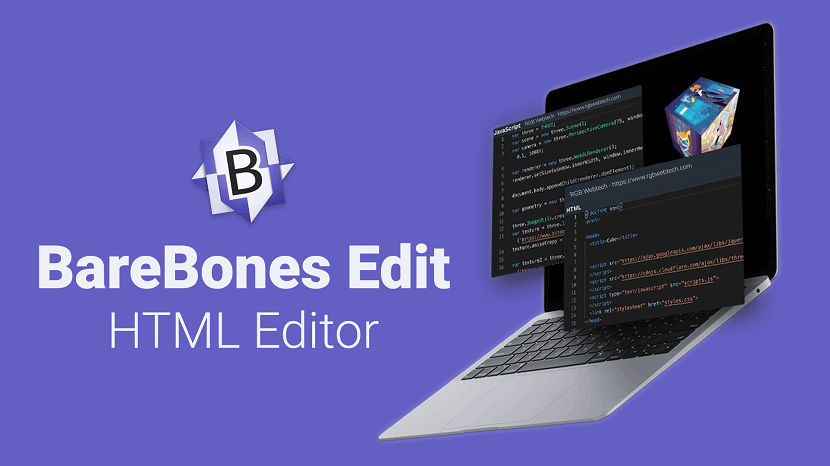
Bare Bones Edit Software is a private North Chelmsford, Massachusetts, United States software company developing software tools for the Apple Macintosh platform. The company developed the BBEdit text editor, marketed under the registered trademark "It doesn't suck", and has been mentioned as a "top-tier Mac developer" by Mac OS X journalist John Siracusa.
The company was founded in May 1993, and incorporated under the Commonwealth of Massachusetts in June 1994.
Highlights:
- Alexa Rank - 189,031
- Developer(s) - Bare Bones
- Operating system - macOS
- License - Freeware
- Website - http://www.barebones.com/
19. TextMate HTML Editor

TextMate for Mac brings Apple's approach to operating systems into the world of text editors. By bridging UNIX underpinnings and GUI, TextMate cherry-picks the best of both worlds to the benefit of expert scripters and novice users alike.
Whether you are a programmer or a designer, the production of code and markup is hard work. Without an editor dedicated to the task, it is also often cumbersome, overwhelming, and repetitive. Especially when you are dealing with a lot of files at once — like most projects do. The tool puts you back in control, reduces the mental overhead, and turns manual work into something the computer does.
Created by a closet UNIX geek who was lured to the Mac platform by its ease of use and elegance, TextMate for macOS has been referred to as the culmination of Emacs and macOS and has resulted in countless requests for both a Windows and Linux port, but the app remains exclusive for the Mac, and that is how we like it!
TextMate for Mac is not an IDE but by using its powerful snippets, macros, and unique scoping system, it can often provide features that even a language specific IDE lacks. It has enough project management features to keep most users happy but is otherwise kept lightweight with a clean and minimalistic GUI.
Highlights:
- Alexa Rank - 207,506
- Developer(s) - Allan Odgaard (MacroMates), Ciarán Walsh
- Initial release - 5 October 2004
- Stable release - 28 December 2019
- Operating system - macOS
- Type - Source code editor
- Website - https://macromates.com/
20. Setka WYSIWYG Editor

Setka Editor is a content editing platform with a no-code WYSIWYG editor and a channel-agnostic framework. This allows remote teams of any size to collaborate on content design projects and implement decisions quickly.
Setka is designed to help development teams efficiently deliver delightful and engaging content experiences with their content layouts and strong support.
Highlights:
- Alexa Rank - 269,415
- Developer(s) - Setka
- Operating system - WYSIWYG
- Website - https://setka.io/
21. Aptana Studio HTML Editor

Aptana Studio is an open-source integrated development environment (IDE) for building web applications. Based on Eclipse, it supports JavaScript, HTML, DOM and CSS with code-completion, outlining, JavaScript debugging, error and warning notifications and integrated documentation. Additional plugins allow Aptana Studio to support Ruby on Rails, PHP, Python, Perl, Adobe AIR, Apple iPhone and Nokia WRT (Web Runtime). Aptana Studio is available as a standalone on Windows, Mac OS X and Linux, or as a plugin for Eclipse.
Highlights:
- Alexa Rank - 355,640
- Developer(s) - Aptana Inc.
- Stable release - November 19, 2014
- Written in - Java, JavaScript
- Operating system - Cross-platform
- Type - Web Development / IDE
- License - Dual License (Aptana Public License, v1.0, GNU General Public License)
- Website - http://www.aptana.com/
22. CotEditor HTML Editor

CotEditor is exactly made for macOS. It looks and behaves just as macOS applications should. It launches so quickly that you can write your text immediately when you want to. It is developed as an open-source project that allows anyone to contribute.
Highlights:
- Alexa Rank - 613,879
- Developer(s) - Mineko Imanishi
- Operating system - macOS
- Website - https://coteditor.com/
23. Bluefish HTML Editor

Bluefish is a powerful editor targeted towards programmers and web developers, with many options to write websites, scripts and programming code. Bluefish supports many programming and markup languages. See features for an extensive overview, take a look at the screenshots, or download it right away. Bluefish is an open source development project, released under the GNU GPL licence.
Bluefish is a multi-platform application that runs on most desktop operating systems including Linux, FreeBSD, MacOS-X, Windows, OpenBSD and Solaris.
Highlights:
- Alexa Rank - 617,644
- Developer(s) - Bluefish Dev Team
- Stable release - January 24, 2020
- Written in - C
- Operating system - Cross-platform (POSIX)
- Type - Text editor
- License - GPL
- Website - http://bluefish.openoffice.nl/index.html
24. NoteTab HTML Editor

NoteTab is a freeware/commercial, multi-file, full-screen text editor for MS Windows. It was developed by Eric Fookes of Fookes Software, Switzerland. The program's name refers to the fact that it was one of the earliest text-editors to use a Tabbed Document Interface.
Highlights:
- Alexa Rank - 1,055,075
- Developer(s) - Eric Fookes
- Stable release - 4 November 2014
- Operating system - Windows
- Type - Text editor
- License - freeware/commercial depending on version
- Website - https://www.notetab.com/
Conclusion:
Getting a helping hand to write code faster and more efficiently is becoming a must, now more than ever. Whether you just started coding or you’re a seasoned vet, we believe that an HTML editor can become anyone’s best friend. Features aside, picking the best HTML editor that suits you might be hard. We encourage you to experiment with different editors and choose one that fits your style and workflow best.
We would also note that unless you need 24/7 support and manage code for a huge company, you will probably be fine with a free editor.
If you want to explore more about Text Editor or WYSIWYG Editor, We recommend you to go through our detailed article of HTML Editors.
If you found this article helpful, we encourage you to share it on your social media platforms—because sharing is caring! For more information about article submissions on our website, feel free to reach out to us via email.
Send an emailWritten by RGB Web Tech
Latest Technology Trends
Latest technology trends shaping the future, including AI advancements, blockchain innovation, 5G connectivity, IoT integration, and sustainable tech solutions. Explore breakthroughs in quantum computing, cybersecurity, augmented reality, and edge computing. Stay ahead with insights into transformative technologies driving innovation across industries and revolutionizing how we live, work, and connect.
40+ Best Website Monitoring Tools
Last updated on January 19, 2025 by RGB Web Tech
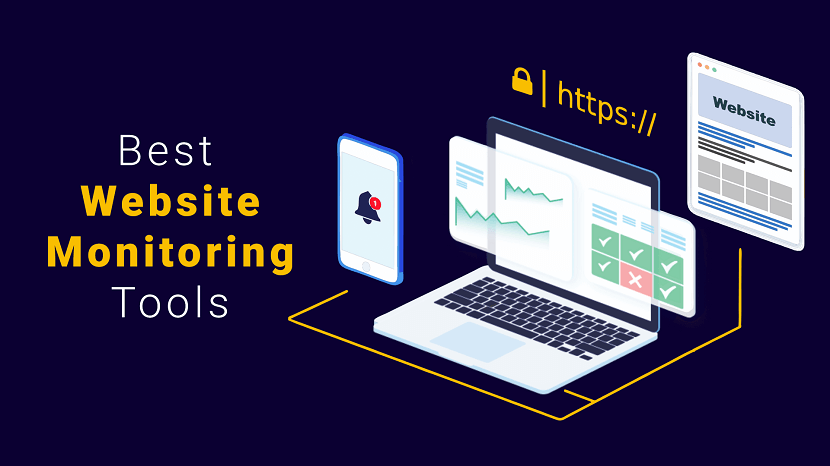
Website monitoring is the process of testing and verifying that end-users can interact with a website or web application as expected. Website monitoring is often used by businesses to ensure website uptime, performance, and functionality is as expected.
The website’s availability is a critical part of a business; we can’t stare at the monitor all the time.
Setting up a command center and monitoring team is feasible for a large organization to monitor their web applications uptime but not for small-medium businesses, non-profit organizations, or personal bloggers. Your website can go down for various reasons, including database down or hack.
Another common reason for website down can be a hosting provider, and that’s why you should always host your site with a reliable hosting provider. Any website owner or administrator needs to ensure proper alerting is in place, so you get notified when the website is not available.
I’ve listed the following tools, which will help you get notified in case your web URL goes down. Most of them offer a FREE plan, so pick the one you like.
However, if you are looking for an in-house solution, then you can try a PHP Server Monitor open source.
1. Datadog
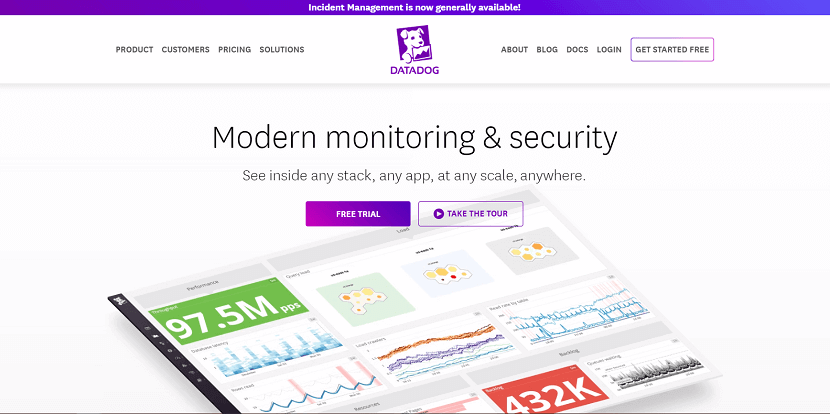
Datadog lets you proactively monitor your API endpoints and send alerts based on predefined parameters. You’ll be able to break down network timings that will eventually help you get to the root cause of your issues faster.
You can incorporate Datadog tests straight in your CI pipeline to ensure early problem detection allowing you to evaluate the state of your production environment after each deployment and minimize downtime by eliminating errors before your users ever see them.
All your critical transactions can be monitored with Datadog Synthetics without writing a single line of code with the web recorder. En user screenshots and step-by-step waterfall visualizations are paired with an intelligent system that identifies elements even after you make changes to the UI which results in a lot fewer broken tests.
Key features:
- Performs uptime and response time monitoring from several locations around the world.
- Enables user-journey modeling to check for load errors, programming mistakes, and poor website design.
- Enables website tests to be compiled through browser recording.
- Uses AI methods to vary user journeys during test runs.
- Tests are run through actual browsers for real-life user experience modeling.
2. New Relic
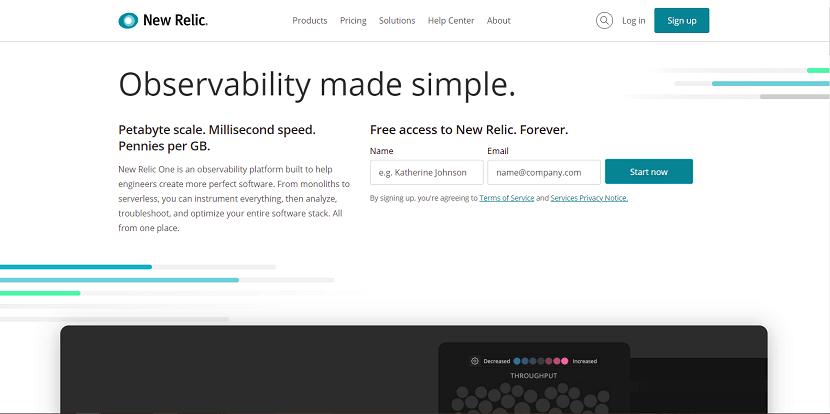
New Relic is a cloud-based software that helps users to track their website and application performances. Their technology is delivered in a software as a service (SaaS) model. The company is mostly known for its application performance monitoring (APM) abilities, but it also offers other services like infrastructure, browser, and synthetics monitoring, which you can combine with APM.
New Relic is a strong monitoring tool, but it can be difficult to navigate between different services and how they work together, especially compared to other monitoring companies like StatusCake or Montastic. However, you can check out and try their services for free for 14 days without any commitment.
Key features:
- Full Support for Google’s Core Web Vitals
- Custom dashboards
- Advanced alerting systems
- Integration with your favorite ticketing system
3. SolarWinds

SolarWinds has been at the forefront of the monitoring space for years and in this time they’ve developed a large number of services to help their customers better understand what’s going on behind the curtains but that experience comes at a great(er) cost.
Web performance monitoring is just part of their impressive software ecosystem, and as it stands today, is one of the most complete solutions for DevOps in the world. While nobody can deny their experience or the value that their app brings to customers, the price tag can still be a tough pill to swallow, especially when you look at smaller competitors that charge a fraction of the price for, what it seems, a very similar product.
Their Web performance monitoring tool offers detailed load-time metrics from multiple locations across the world that record all browser-based transactions while providing key insights into what happens under the hood of your website.
Key features:
- Pre Configured alerts and dashboards that speed up the setup process.
- Synthetic monitoring solutions
- A neat mobile application is available for free
4. Uptime Robot
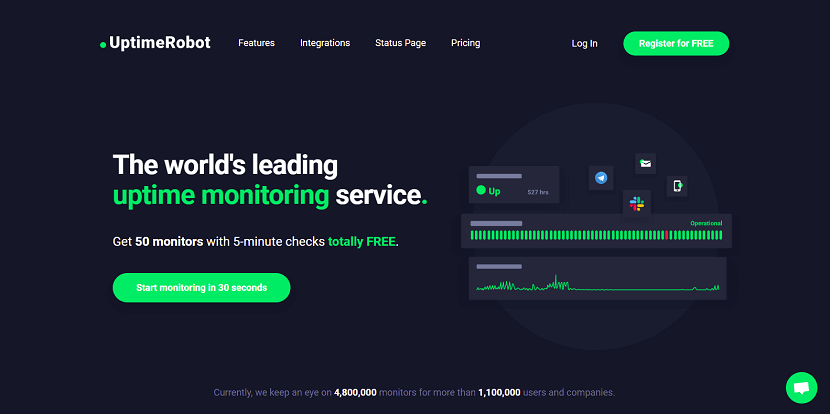
Uptime Robot is a good tool available at no cost to you, even though some users complain about the limited features, such as no manual alert testing. You also won’t get page speed insights like with some paid website monitoring tools.
Key features:
- Advanced notifications will let you set certain prerequisites for your alerts. Eg: x errors in y minutes
- Simple setup process
- Heartbeat monitoring for intranet and cron jobs
- SMS and email notifications are available
5. Freshping
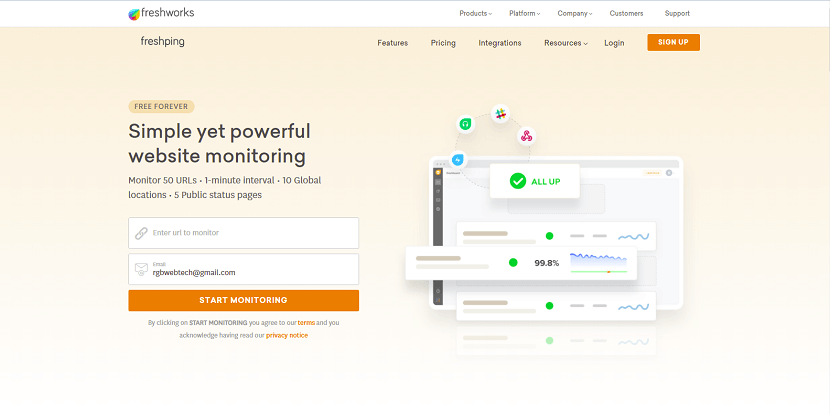
Freshping by Freshworks lets you monitor 50 URLs from 10 locations worldwide with one minute of internal in FREE.
Key features.
- Multi-channel notification
- Status page to announce real-time incident status to your users and customers
- Multi-user login
- Integrate with other services like Slack, Twilio, Freshdesk, Zaiper, etc. to get notified
Under the FREE plan, monitoring data is available for six months.
6. Pingdom
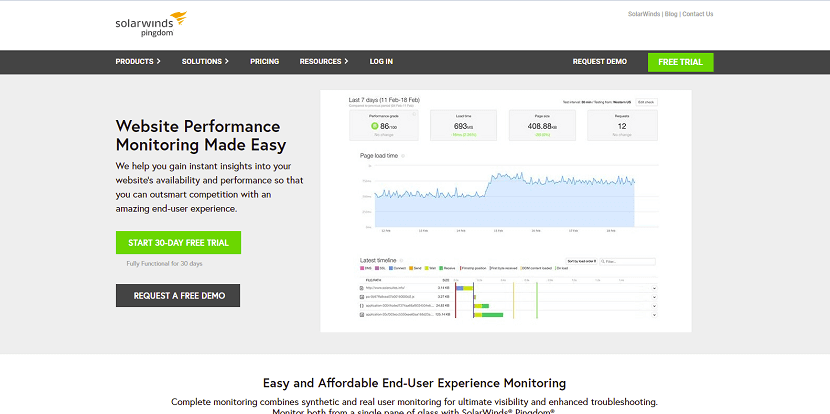
There are more options for choosing your monitoring frequency (up to 30,000 uptime checks) for more expensive pricing. Pingdom also offers an Enterprise plan which offers from 500,000 to 5 million pageviews a month. Moreover, there is a 30-day trial to check out their services.
If people can’t access your website at certain points throughout the day, then you’re losing sales and search engine rankings. Unfortunately, you can’t manually monitor your site’s uptime at all hours, and that’s where Pingdom’s tools come in handy.
Although Pingdom offers some free tools, such as a website speed test, where it shines is in its premium features. Pingdom can help you analyze your website’s uptime and performance by testing your site from servers across the world and alerting you if there’s an issue.
Pingdom also helps you improve user experience by delivering feedback from real users and analyzing performance factors such as website speed. They’ll also help you pinpoint any causes of problems to help you resolve them quickly.
Overall, it’s a powerful, reliable tool for smaller businesses on a budget, but some users complain that it puts little emphasis on mobile traffic, has unreliable SMS capabilities, and lacks monitoring servers in Asia-Pacific. We also use Pingdom to monitor the best hosting providers.
Key features:
- Detailed interfaces with user-friendly features
- Instantaneous alerting system
- Real user monitoring and synthetic monitoring
- The mobile application makes up for the somewhat complicated setup
- SMS and email notifications are available
7. Site24x7
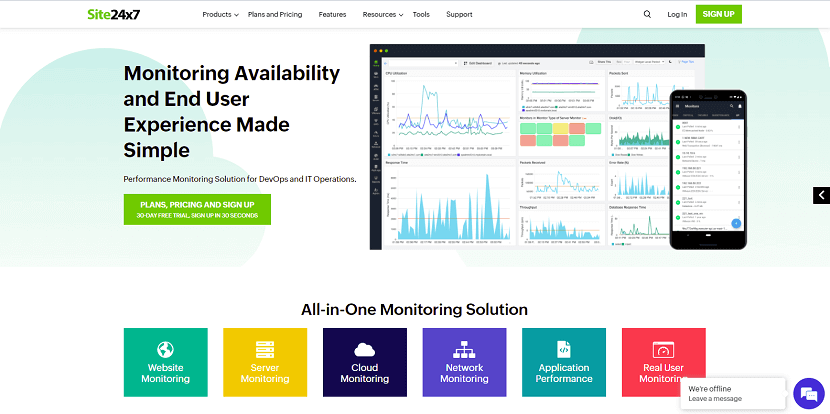
Site24x7 is a U.S.-based company, founded in 2006. The company provides performance monitoring solutions targeted at DevOps and IT professionals. You can use the service to monitor your websites, APIs, servers, and much more.
Key features:
- Performance monitoring: Comprehensive performance monitoring from 90 global locations, checking internet services, internal network performance, web page components, and more.
- Real User Monitoring (RUM): Real-time tracking will tell you everything you need to know about your users’ experience on your site. Detailed reports will allow you to analyze your visitors’ behavior and spot any pertinent issues.
- Public status pages: This feature allows you to notify your customers of any downtime. They are sure to appreciate your business transparency.
8. Uptrends
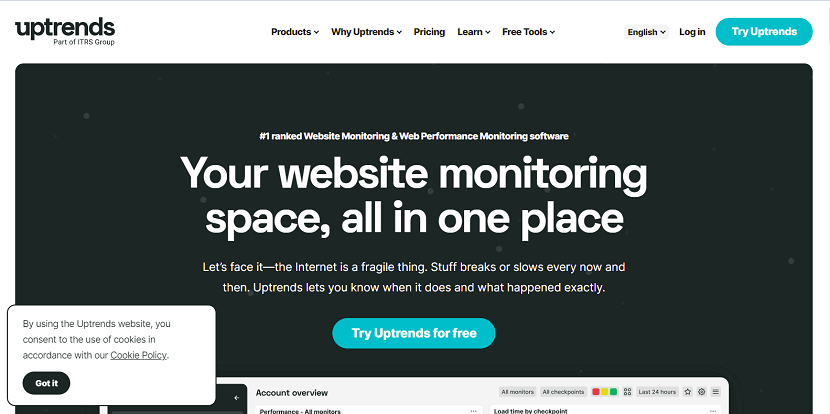
Founded in 2007, Uptrends provides a variety of monitoring services, from standard website monitoring to real user monitoring. The company’s impressive client list includes big names like Microsoft, HP, Virgin, and Zendesk.
While the paid plans offer an extensive list of advanced features, you can find several free tools on the company’s website, including a free-forever website monitoring tool that will monitor your site from locations all over the world.
The free version will send you an email alert whenever there’s a problem – but not before your site has been tested from two different checkpoints, to prevent false alarms. You also get detailed data reports which you can export to PDF or Excel.
Key features:
- Multi-browser monitoring: Uptrends offers “real browser monitoring,” which hits your website with the three major browsers to recreate your users’ experience. The Full Page Check feature hits every webpage and element on your website, and it’s got 200 worldwide checkpoints for true global performance monitoring.
- Private checkpoints: In addition to the company’s 200+ checkpoints around the world, you can also get your private checkpoint which can run behind your firewall and monitor your business’ intranet and internal applications.
- Transaction recorder: Record and monitor all transactions on your website and get detailed information on shopping processes, website functions, and load times. Analyze your results with a series of powerful tools.
9. Dynatrace
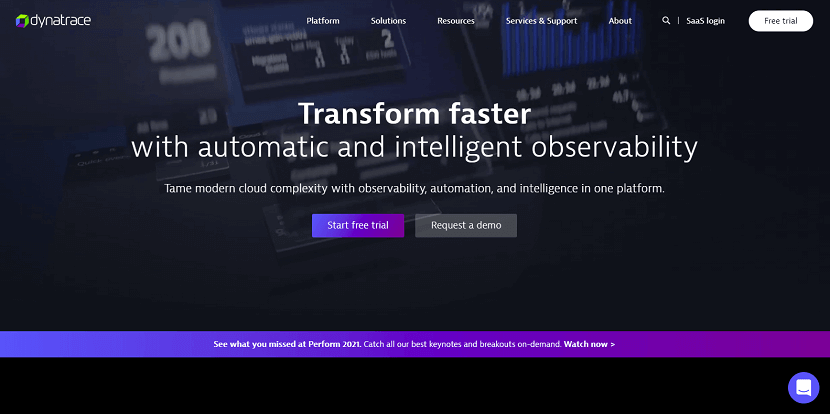
Dynatrace monitors the availability and performance of your internal resources with monitors from private elocution making it easy for you to understand how your users experience your website and apps by measuring and recording key metrics.
Dynatrace offers three types of synthetic monitors The first one is a single-URL browser monitor that acts as a simulated user visiting your app or website and can be configured to work from any of their available locations with a frequency of 5 or more minutes. The second one is Browser click paths that are similar to the single-URL act as a user but follow a path throughout your application. The third version is the HTTP monitor that is a simple HTTP request that can be customized and ran at various intervals.
Key features:
- Flexibility to utilize real-user monitoring, synthetic monitoring, and session replay
- Built with privacy and security in mind to meet your GDPR requirements
- Real-user monitoring for mobile, hybrid, and single-page applications with common analytics
10. Smartbear
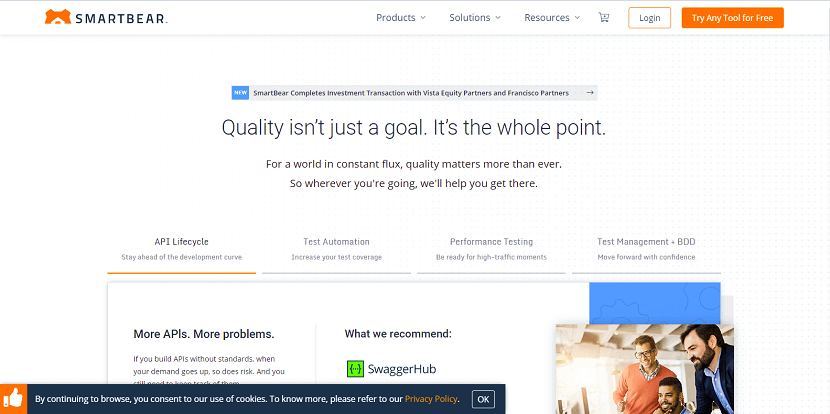
Smartbear is amongst the most comprehensive tools for large-scale enterprises that wish to monitor almost every aspect of their online presence. Besides keeping a very close eye on your web application through a wide variety of tools that range from run-of-the-mill uptime and alerting solutions to some innovative monitoring options, Smartbear also checks up on your mobile applications, API status, and database health.
Last but not least, Smartbear has an impressive 340 testing nodes around the world, which is at least double what most competitors have. Keep in mind that Smartbear does not have a real user monitoring product so if you are looking for that particular feature, you’ll have to look elsewhere.
Key features:
- Lots of third party integrations
- An extensive list of resources and support material
- Robust Reporting & Analytics
11. Host-tracker
Simple by design, Host-tracker is intended for site admins that want to monitor their servers’ availability as well as the transactions between server and client. It mainly focuses on key metrics like page errors, database connection problems, and network issues.
The pricing schema is simple enough, composed of three separate tiers, each with its own unique set of features and capabilities. It’s worth mentioning that at first glance the price for their basic tier seems high compared to the other products mentioned here but I believe that the packed features of the more expensive tiers make up for this.
One thing Host-tracker is missing compared to the other options listed in this list is the ability to monitor real users. It’s not a big deal if what you are trying to do is focus on the server’s resources but for websites that deal with a lot of users like online publications or e-commerce stores, RUM is going to be crucial to providing the best experience possible for your users.
There’s no free tier but every signup comes with a free, no credit card required, a 30-day trial where you can test all the features of the product, risk-free.
Key features:
- Performance monitoring: HostTracker breaks down its performance measurements into DNS lookup time, connect time, “first-byte” time, and download time. This enables a granular view that makes it easy to spot specific bottlenecks.
- Uptime monitoring: HostTracker’s “availability check” feature is similarly detailed and can be configured to check not only the website and server availability but also applications connected to your website as well as your database connections.
- Alerts: Highly customizable alerts via your choice of email, voice message, SMS, Skype, Google Hangouts, or Viber. You can also set conditions and assignments for alerts to ensure that each team member gets only the appropriate ones.
- Auto-pause Google Ads: HostTracker can automatically pause your AdWords campaign if your website is unavailable, and start it when the site is back up.
12. Versionista
Versionista is a simple yet powerful tool for monitoring web pages of static and dynamic websites. You can monitor web pages as well as documents like PDFs, like Visualping. What sets it apart is you can set filters to skip irrelevant content changes and manage and track changes in SEO to stay competitive in SERPs.
While creating a monitor, you can customize frequency, JavaScript support, proxy address, and more. What I like is it shows color code comparison to highlight changes and supports sending change alerts and detailed emails. Moreover, Versionista supports team collaboration, allowing admins to manage users and users to collaborate between them to support team projects.
Key features:
- It automatically crawls and monitors your website.
- This cloud-based tool provides summaries in email.
- You can collaborate with your organization team.
- Versionista manages the team's workflow.
- You can avoid irrelevant content using filters.
- It provides color-coded comparisons that show additions and deletions.
13. Distill
Distill is a featureful tool for monitoring web page changes. What makes it unique is its support for cloud as well as local monitors, unlike the above tools. Also, it supports automating steps like logging in, exporting data, using custom proxies, tracking changes in documents like PDF, and managing versions.
Key features:
- You can select items to track visually.
- It allows you to configure notification settings and account details from your single dashboard.
- You can see the version history.
- Track changes from any browser and you get updates on any device or channel.
- You can import or export data in CSV or JSON files.
- It allows you to track changes in PDFs.
- You can manage the version history of all changes.
14. Uptime
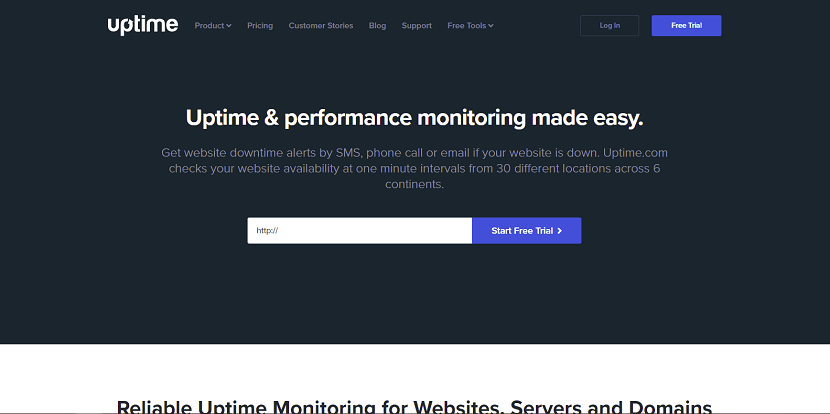
Featuring SSL monitoring, 24/7 support, malware scanning, and a large number of third-party integrations, Uptime is a great website monitoring tool that focuses on reliability and ease of use.
Uptime monitors your website availability at one-minute intervals across 6 continents. If anything goes wrong you’ll be notified via either SMS, phone call, email, or any number of custom integrations that they support.
Uptime has a RUM tool that helps you deliver the best user experience by tracking users across different devices, locations, and connection types. The data collected will be displayed in easy-to-understand dashboards that will provide actionable data on how to fix the performance issues of your site.
While there is no free tier, Uptime does offer you a risk-free, 21-day trial across all their packages that should give you a taste of everything it has to offer.
Key features:
- Simple to use UI
- Websites scanned with Google Safe Browsing & Yandex Safe Browsing.
- Detailed Uptime Reports
- Receive alerts via email, SMS, Twitter, web-hooks, or push notifications.
- Website uptime: Track uptime, response time, and performance from multiple locations worldwide.
- Server health: Detect bottlenecks before they arise.
- Network performance: Monitor multi-site networks, and receive notifications of any failures.
- Custom metrics: Customize your unique monitoring needs.
Monitis.com advertises that by using its service, you can improve uptime, eliminate hassles, optimize user experience, and grow your client base. Plus, it’s available in English, Portuguese, Spanish and German languages.
Overall, it’s a great tool packed with numerous features and you can try it out free for 15 days.
Key features:
- A mobile application is available
- Available in English, Portuguese, Spanish and German languages
- Simple granular control over how much you pay/mo
- 20% discount for annual payments
16. StatusCake
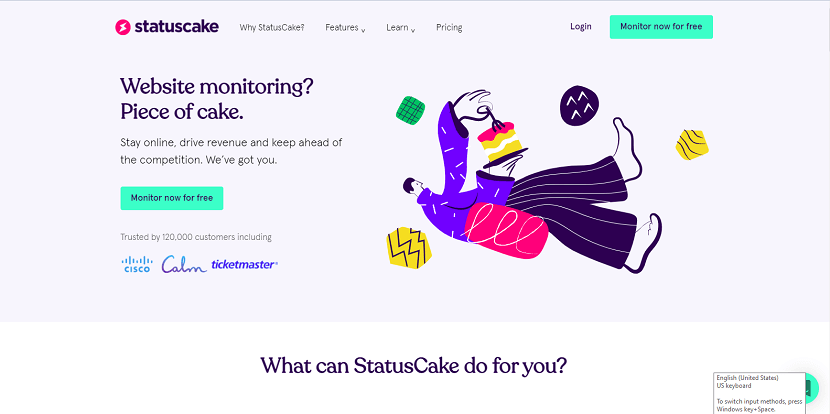
StatusCake also has a “Superior Plan” for 20.41$/mo and it includes 100 monitors with 15-minutes testing intervals. If you sign up with their paid plans yearly, you’ll get two months free (for life!).
You can sign up with their free plan (no credit card needed) and start testing your site’s uptime and speed immediately.
StatusCake will check on your site every 5 minutes and alerts you if there’s any downtime via email or integrations with a third-party app like Zapier. StatusCake also helps with root cause analysis, so you’ll know why the problem was caused. Moreover, with their free plan, you’ll get to test website page load time (1 test every 24 hours).
Key features:
- Page speed test (free plan includes 1 test every 24 hours)
- Global test locations (they have 48 locations in 28 countries)
- Domain monitoring (only with paid plans)
- Server monitoring (only with paid plans)
- SSL certificate monitoring (only with paid plans)
17. Sematext
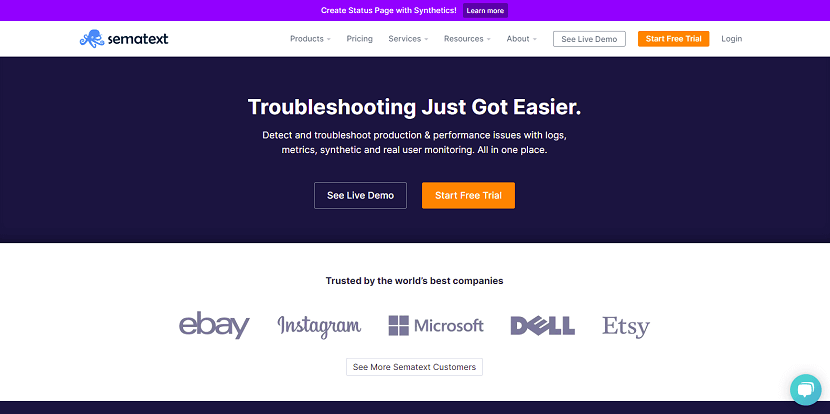
Sematext Cloud is an all-in-one log management and monitoring solution that provides end-to-end visibility and observability. When it comes to website monitoring, we offer Sematext Experience, our real user monitoring (RUM) solution, and Synthetics, our synthetic monitoring tool.
With the launch of Sematext Experience and Synthetics, Sematext became the go-to tool for developers looking to get insight into their infrastructure while still keeping an eye out on the user experience metrics.
With Sematext Experience, you’ll get a report on the experience and satisfaction of your users while providing key pieces of information as to how your website or application is performing in different locations, devices, or different connection speeds.
On the other side of the spectrum, you’ll be able to set up Synthetic Monitoring to create a complex system of monitors for all your resources in just a few clicks. The monitors will ping your resources from several locations all across the globe and report back stats like website speed, error rates, third APIs responses, SSL certificate expiry, and many other mission-critical metrics. You can even use it to benchmark against competitors and identify areas you should optimize to improve website performance.
Getting started with Sematext is quite easy and intuitive thanks to the simple setup wizard that every new user gets to see.
Every plan has a risk-free, 14-day trial that does not require any credit card to be added. We also offer granular control over what you pay for as every product is individually priced. This way you can pay only for the products and features he needs.
Key features:
- A unified location for all your logs, metrics, and events
- Identify resources & requests with the biggest negative impact on your website performance
- Real-time alerts and debugging solutions
- Support for all major frameworks
- Very well documented features
18. UPTIMIA
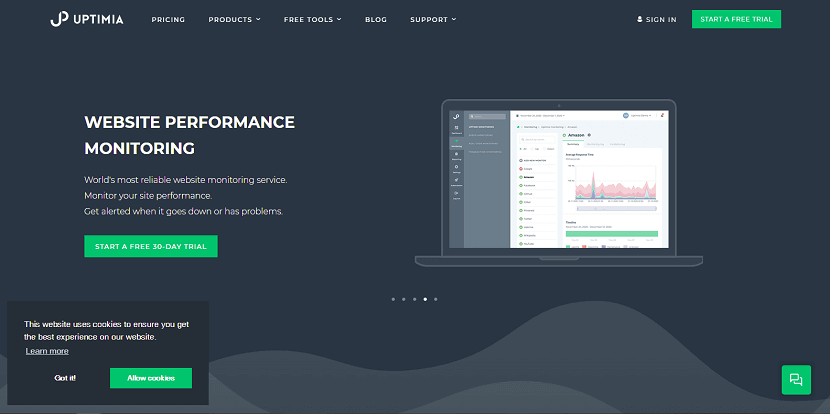
UPTIMIA is a relatively new player in the market, but it’s already shown impressive growth, landing clients such as Pepsi, Akami, and Nokia. The company offers monitoring services for small businesses and large enterprises, including uptime and speed monitoring as well as transaction monitoring and real user monitoring.
The company offers a free-forever plan which allows you to monitor one website in five-minute intervals. The free plan includes uptime monitoring only.
Key features:
- Uptime monitoring: Monitors your website from 170+ global locations at intervals as low as 30 seconds.
- Performance monitoring: Includes monitoring load times with real browsers as well as real user monitoring (RUM), which can measure your website’s performance according to individual visits.
- Custom-branded reports: You can use your company’s logo and color scheme for the daily reports, making Uptimia a good choice if you’re part of an agency managing websites for your clients.
19. Cronitor
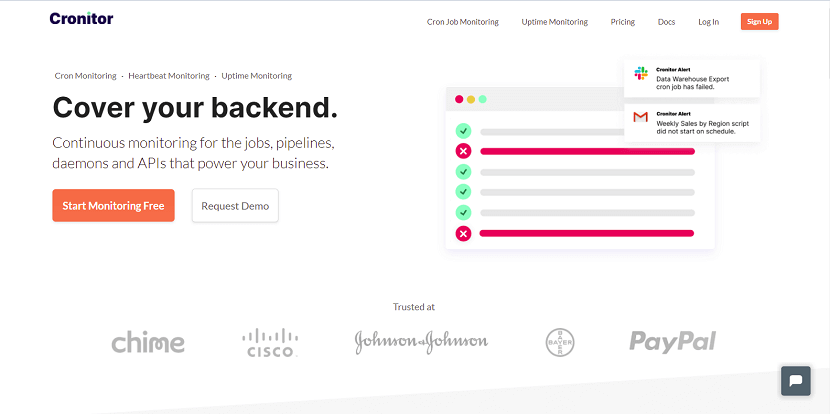
Cronitor is a modern uptime monitoring service with advanced features and a clean, approachable design that anybody can use. With 12 global monitoring locations and checks that run as frequently as every 30 seconds, you can trust you’ll be alerted quickly when your website or API is down.
Key features:
- Custom request headers, cookies, and more.
- Page content assertions.
- Real browser testing for JavaScript apps.
- Global monitoring with custom test locations.
- Instant alerts through Email, SMS, Slack, PagerDuty, OpsGenie, and more.
20. Checkly
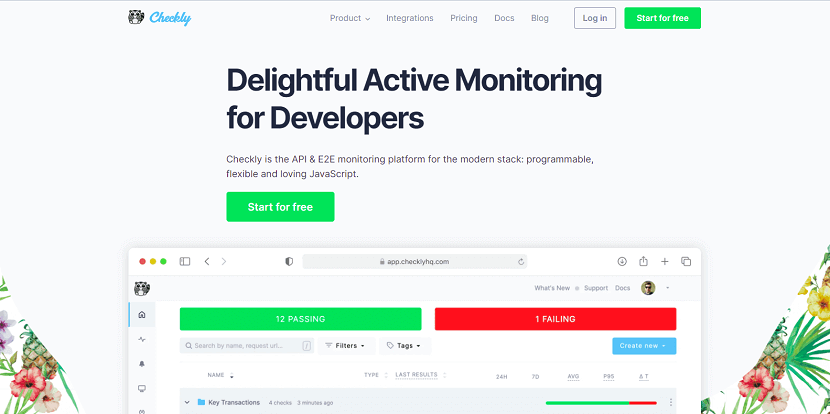
Checkly uses Puppeteer and Playwright frameworks to simulate users’ interactions with your website or application within a Chrome browser. While you can write the test scripts yourself, Checkly does offer a Headless Recorder browser extension to aid you. Once you’re done with the code you can run it every 10 minutes.
The alerting system is very versatile and allows you to get an alert whenever one or multiple parameters are met. The alert can go out to your Email, Slack, Pagerduty, or SMS.
Tests are run from one of six locations in America, eight locations in Europe and Africa, and six other locations from Asia. Getting feedback from different locations across the globe will paint a clearer picture of how your users are experiencing your website and allow you to make crucial decisions that improve performance.
Key features:
- CI/CD integration
- Screenshot for every transaction
- Tests are run from real browsers
- No coding needed
21. Better Uptime
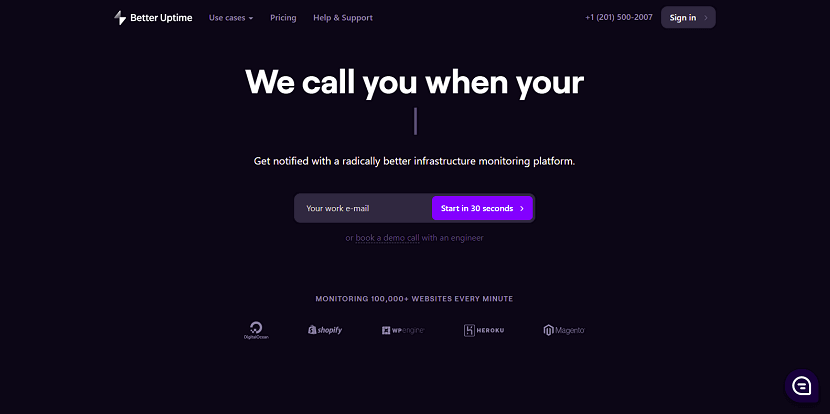
Better Uptime is a modern monitoring service that combines uptime monitoring, incident management, and status pages into a single beautifully designed product.
The setup takes 3 minutes and after that, you get a call whenever your website goes down.
Key features:
- Unlimited phone call alerts
- HTTP(s), Ping, SSL & TLD expiration, Cron jobs checks
- Easy on-call scheduling
- Screenshots & error logs of incidents
- Slack, Teams, Heroku, AWS, and 100+ other integrations
22. Calibreapp
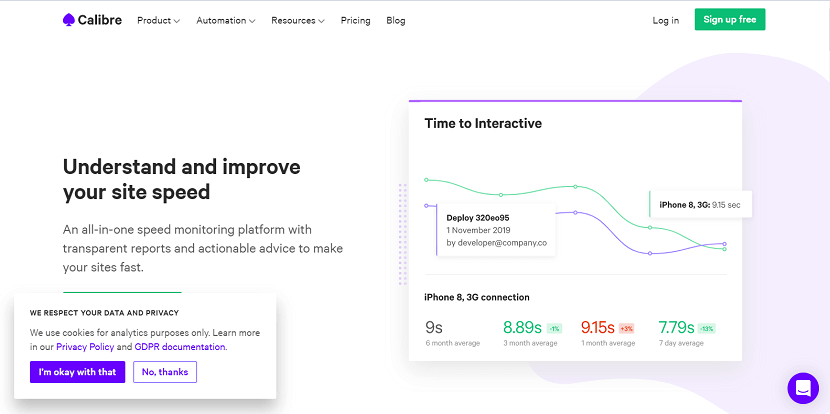
Calibreapp helps you deliver stellar experiences to your users regardless of their location, platform, or connection speed by simulating real-world conditions. It allows you to understand the impact of third-party code on your systems, automate tests for performance, and get notified the second your users experience an issue.
Calibreapp provides powerful performance reporting that provides a clear overview of your entire system allowing you to stay on top of any issues that might occur. The automatic insights reports that are being sent out save hours and hours of work that would be spent building traditional reports out of dashboards.
Key features:
- Core Web Vitals support
- Testing authenticated pages
- Google Lighthouse built-in
- Insights Email Report
23. Visualping
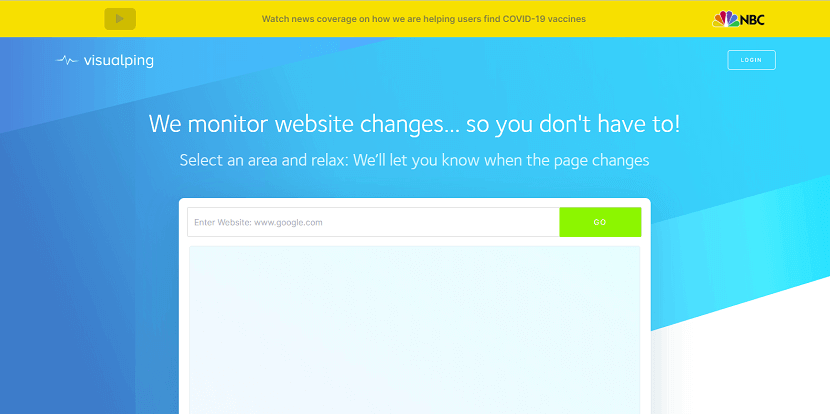
Visualping is among the best web page monitoring platforms available, which offers intuitive features fitted for both beginners as well as advanced users. What I liked the most about Visualping is it shows its monitoring form interface right on its homepage, allowing you to effortlessly start monitoring web pages.
Visualping claims it is used by more than 1.5 million users worldwide performing 5 billion checks. Its features include performing checks from every 5 minutes to every week, checking for documents like PDFs, choosing screen configurations, configuring proxy settings, and alert options. Also, these features are all packed under a clean and neat interface, making it super easy to monitor changes.
Key features:
- It offers access to public API as well as custom development work.
- You can review changes in images and basic account settings.
- Automatically alerts website users when any changes are made on the website.
- The browser extension allows you to monitor websites directly from the website.
- It provides intelligent alerts.
24. PageCrawl
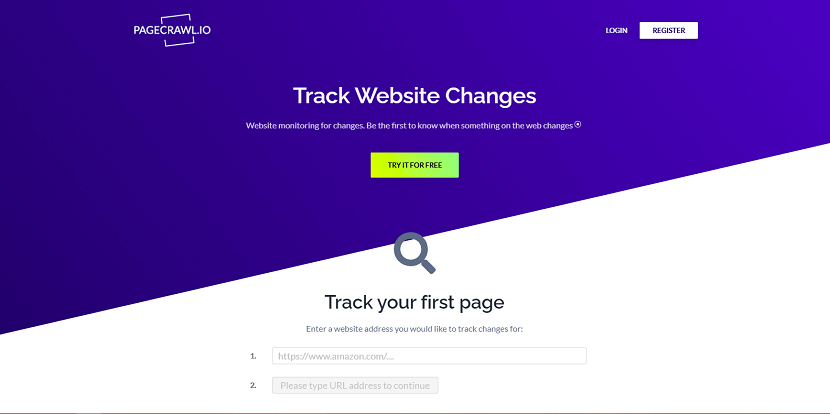
PageCrawl is another robust tool for monitoring web page changes. What I find interesting is PageCrawl.io supports tracking multiple elements on a page. You can share a tracked page with friends or team members, visualize results as charts, send notifications to email or Slack, export data, and do a lot more.
Key features:
- You can capture the full web page selected element image of your website.
- It provides proxy support to bypass IP bans.
- PageCrawl feature automatically updates tracked pages in Google Sheets.
- You can easily analyze changes in timeline charts.
- It enables you to share and track pages with your colleagues or friends.
- This application provides easy to use page element selector.
- You can export web page change to an excel spreadsheet.
25. Fluxguard
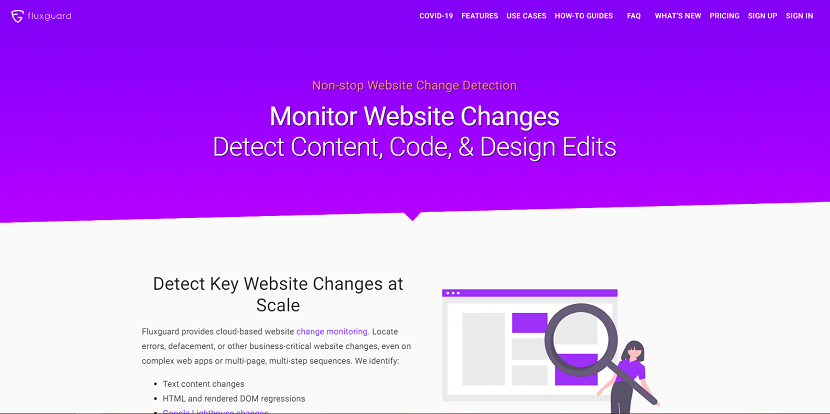
Fluxguard is another featureful tool for monitoring web page changes. One of its unique features is Google Lighthouse Audits, allowing you to check your site’s SEO. You can automate steps like submitting forms, add filters for alerts, use proxy networks, and receive alerts through Slack and webhooks.
Key features:
- It automates business-critical website change audits: from a single page to multiple steps.
- Multiple web change visualizations: visual, HTML, text, network, Google lighthouse.
- Fluxguard creates point-in-time archives of entire websites and their changes.
- It provides change reports via SMS, Webhooks, Email, API, and more.
- You can quickly toggle between screenshots, HTML code, and extracted text.
- Fluxguard captures all network activity, console logs, web storage, cookies, and more.
26. OnWebChange
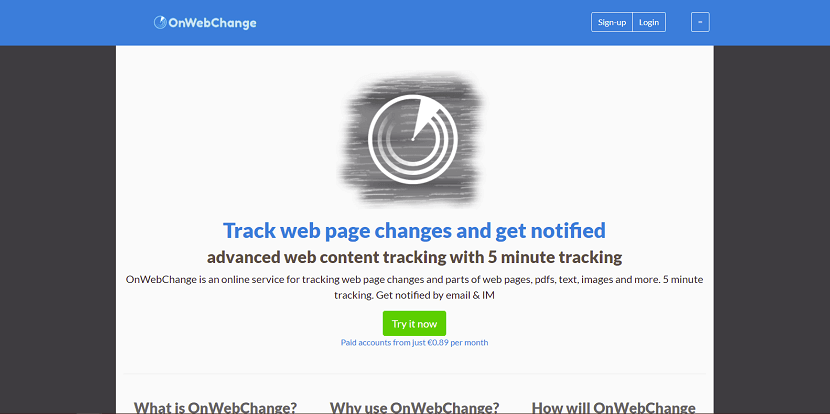
If you want to track exact information, OnWebChange can do it as simply as possible. Though it is not as powerful as Wachete some of its features even outstand the latter.
What got me stuck is its public tracker feature that lets you place a button on your site that helps your visitors track any page on your website.
Additionally, you use its ‘Change Report’ feature to share a public tracker with friends and coworkers and help you track changes conjointly. OnWebChange tracks change for various types of content like images, documents, PDFs, etc.
Another surprising feature is it creates an RSS feed to help you track the changes, unlike that of Wachete.
It allows three trackers for free and features multi-language support and a powerful change detection system with lots of customizable options. It can send mobile or email notifications in a single or digested form per your preference. Moreover, it sends emails to multiple persons, creates an email distribution list, and even notifies URL ‘Callback’, surprisingly.
Key features:
- Track changes to any plain text files and online files.
- It checks changes every 5 minutes, 24x7 hours, and 365 days.
- You do not require to download any files or browser plugins.
- Share notifications with family, customers, and friends.
- You can track changes to any specific part of the public web page.
- Track changes to online files (PDFs, images, etc.) and any plain text files.
- Receive notification directly to your mobile.
- This online tool allows you to filter out the content you want.
27. ChangeTower
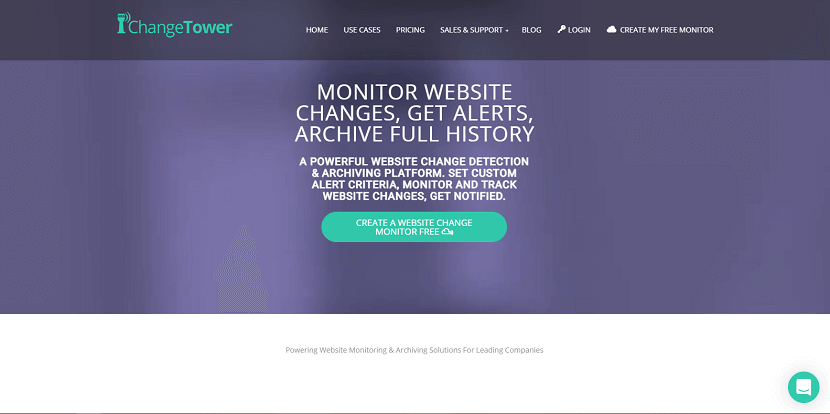
Using ChangeTower, you can monitor three addresses for free. It is a cloud-based, easily accessible tool that is capable of monitoring visual changes. You can track code updates, keywords and code changes, and visual changes made on a webpage.
What I like is that one can also check a site’s availability and receive alerts on configured conditions. ChangeTower can notify you, or your team using real-time email notifications and allows you to see notifications stream and check out detections.
Also, you can check the changed data of three months in for free, and even export it to a spreadsheet.
Another interesting feature is it sends you a detailed report of content, snapshot, and HTML changes, helping you to easily understand the changes.
Key features:
- It provides keyword alerts.
- This tool provides notification for only significant changes in keywords and phrases.
- It alerts when your website page goes down and comes back online.
- You can monitor HTML code.
- It allows you to store time-based code snapshots.
- Notify changes to the team via email.
28. Wachete
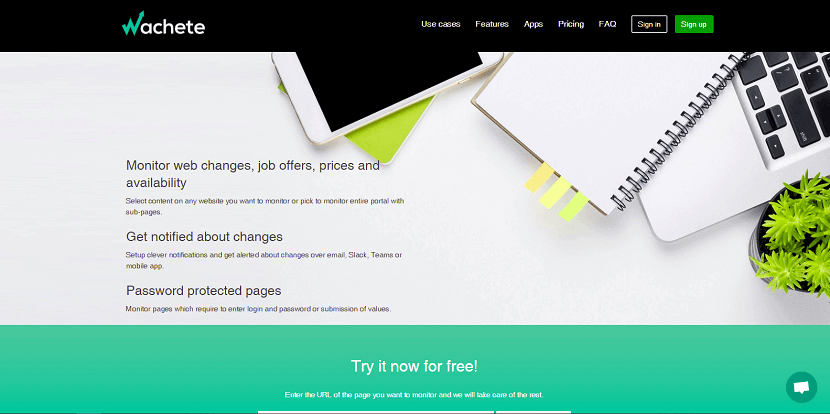
Wachete has a lot more to offer than other content monitoring tools on this list. What makes it stand out is its ability to monitor password-protected pages as well as dynamic and JavaScript pages.
Moreover, you can track changes on pages that require a click or an input and monitor configured pages from different locations and more.
It collects and stores web content along with change history for up to six months, allowing you to track old pages or changes when required.
You can freely monitor five pages, which suffices everyday users who wish to track product prices and job offers. You can also track the availability of a site, and download all the data as a spreadsheet.
What I like most is its set of REST APIs as well as its feature to create an RSS feed from the content of a page, like a feed of your wishlist products.
Key features:
- It helps you to monitor pages that are password protected.
- You can monitor web pages, including crawled subpages.
- Collect changes, web content, history up to 12 months.
- You can create an RSS feed from the content of any web page.
- Monitor updates of text in MS Word, PDF, XLSX file, JSON, and DOCX.
- It provides a REST infrastructure for 3rd party partners.
- You can monitor dynamic pages.
29. Sken
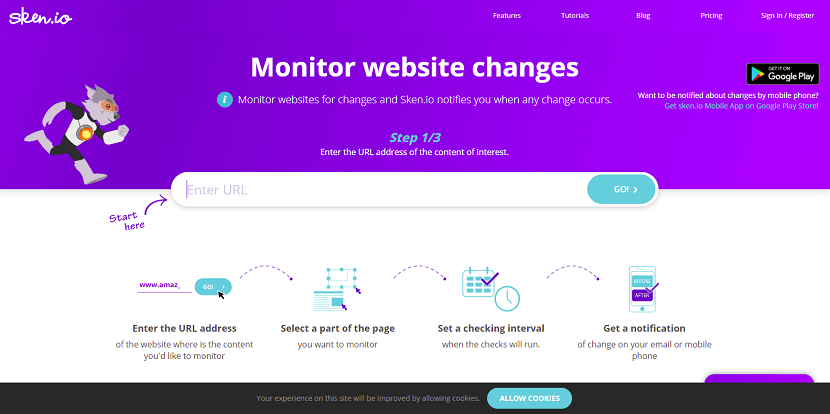
Sken is one of the robust platforms out there for monitoring changes. It boasts of offering a perfect rendering engine for web pages, allowing better change detection and webpage screenshots. It features a popup blocker, time scheduler, and a chart preview tool for visualizing changes visually.
Key features:
- With chroma extension, you can get change details in just a few clicks.
- Data stored in the cloud can be fully synchronized with chrome extension and mobile application.
- It provides a fully customizable scheduler to find change when you want.
- You can delete an element that hides or blocks your content.
- It shows a preview in the chart.
- Get notification in your mobile application.
30. DeepWebMonitor
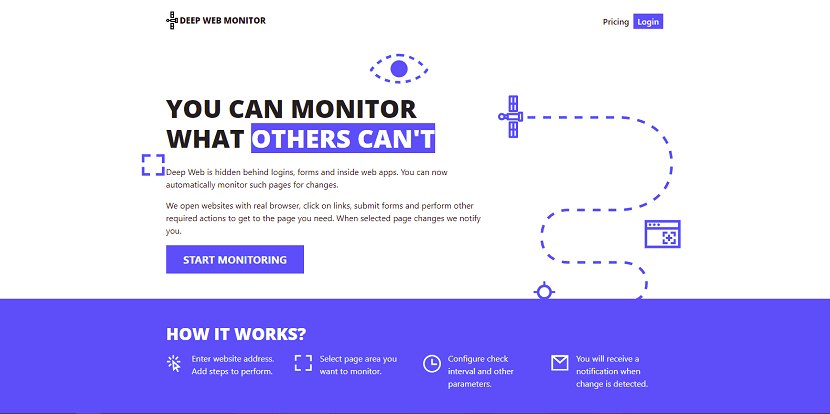
DeepWebMonitor is a web page change monitoring tool, which boasts of helping you to “monitor what others can’t“. Though it focuses on different terminology named deep web, it does similar to other tools. You can track changes, check at fixed intervals, receive notifications for detected changes, and more.
31. Trackly
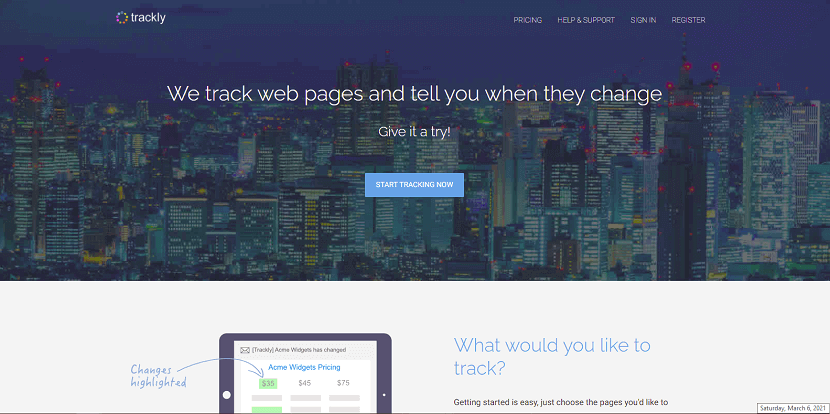
32. Pagescreen

33. WebSite-Watcher
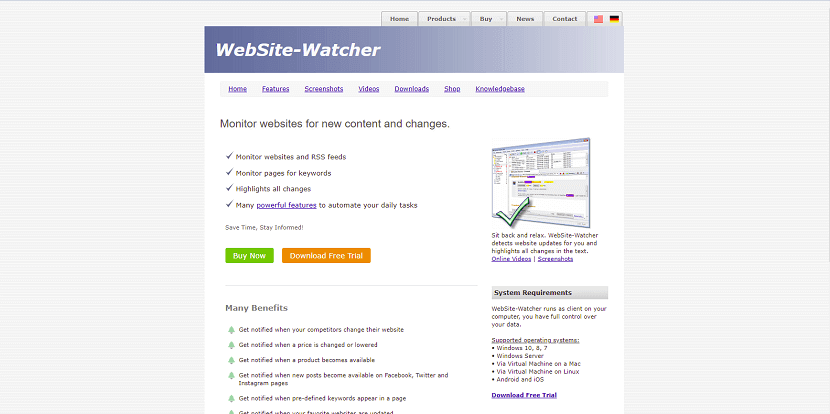
34. HetrixTools
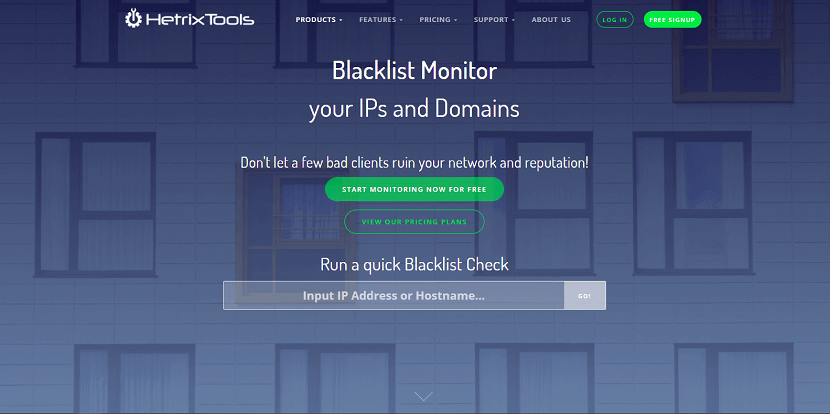
35. Dotcom-Monitor
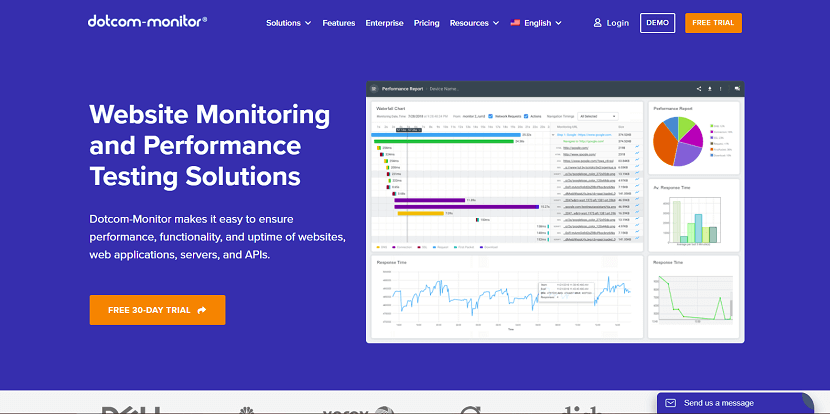
36. Montastic
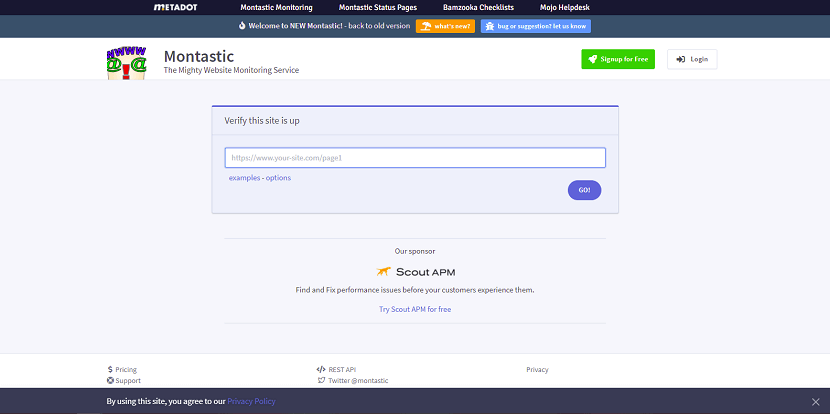
37. AlertBot
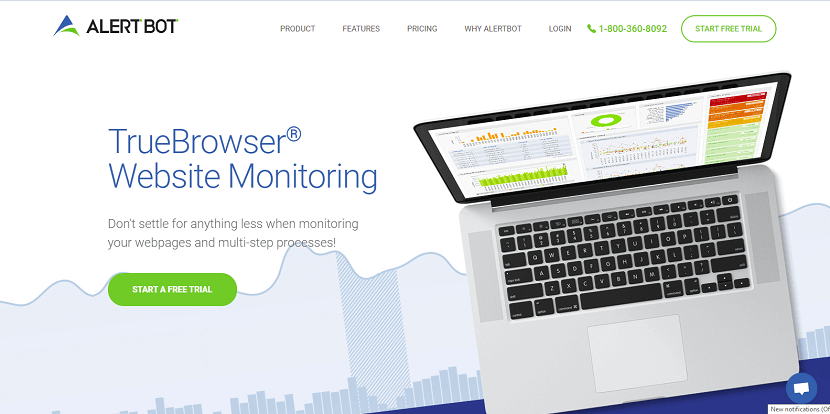
38. Happy Apps
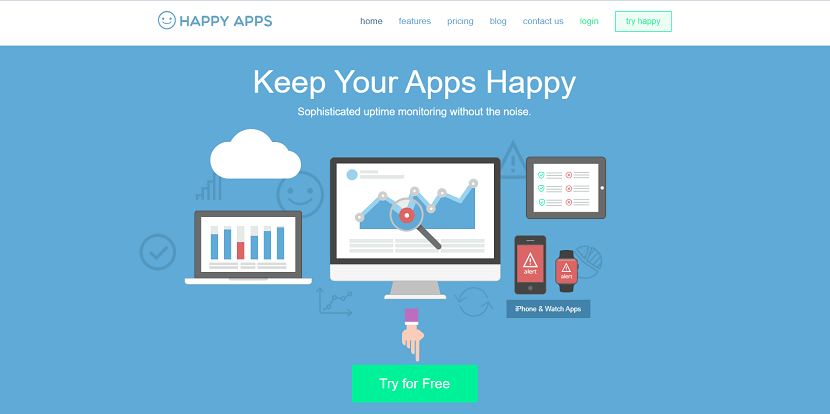
39. WebGazer
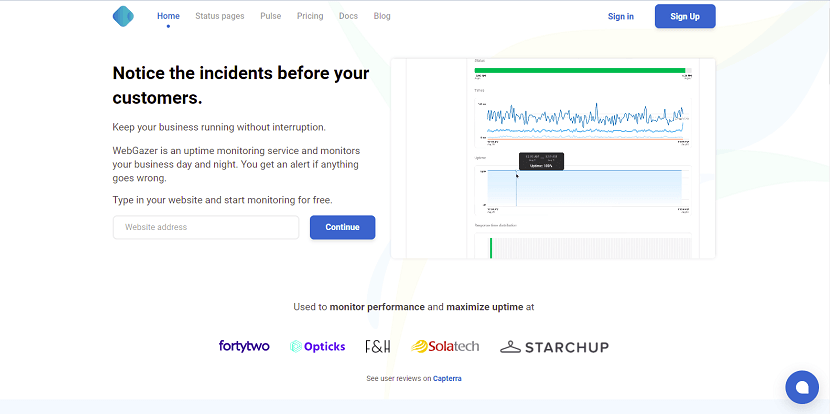
40. Are My Sites Up?
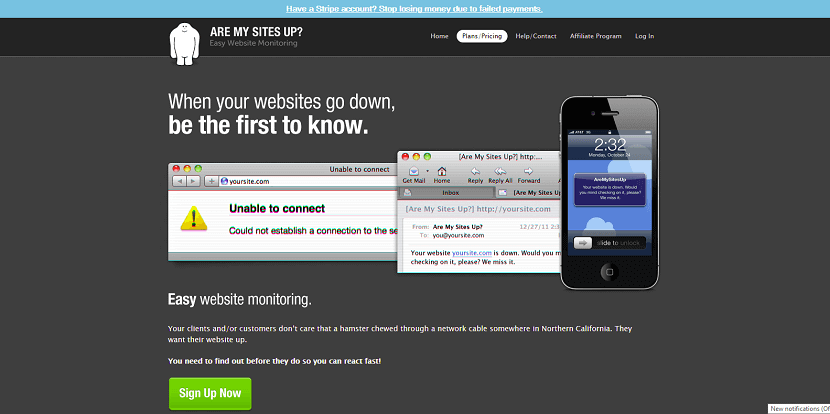
What’s the Verdict? Which One Should We Pick?
There’s no way to say which website monitoring service is better than the others because it all depends on what your goals are with your website.
From our experience, the best free options would probably be StatusCake and Uptime Robot. They have enough flexibility/features and can monitor your site at 5-minute intervals. So if you’re just testing the waters and aren’t sure if you really need one, go ahead and try them out.
The most bang for the buck you’d probably get from DotCom-Monitor, but we love the Pingdom user interface more, so it’s completely up to you.
One thing is for sure – Premium website monitoring tools will offer more features and reliable data to help you improve your site. If you’re serious about website monitoring, establish a budget so you can take advantage of these tools.
We’re not saying that the free tools are bad, though. In fact, they’re great if you don’t need all the bells and whistles. You can start with one of the free tools mentioned here, and if you feel you need a look at the “bigger picture,” consider a premium plan for monitoring your site performance.
45 Best Website Monitoring Tools | Free Online Website Monitoring Tools
45 Best Website Monitoring Tools | Free Online Website Monitoring ToolsIf you found this article helpful, we encourage you to share it on your social media platforms—because sharing is caring! For more information about article submissions on our website, feel free to reach out to us via email.
Send an emailWritten by RGB Web Tech
Latest Technology Trends
Latest technology trends shaping the future, including AI advancements, blockchain innovation, 5G connectivity, IoT integration, and sustainable tech solutions. Explore breakthroughs in quantum computing, cybersecurity, augmented reality, and edge computing. Stay ahead with insights into transformative technologies driving innovation across industries and revolutionizing how we live, work, and connect.
Bluehost Web Hosting Plans Review
Last updated on January 19, 2025 by RGB Web Tech
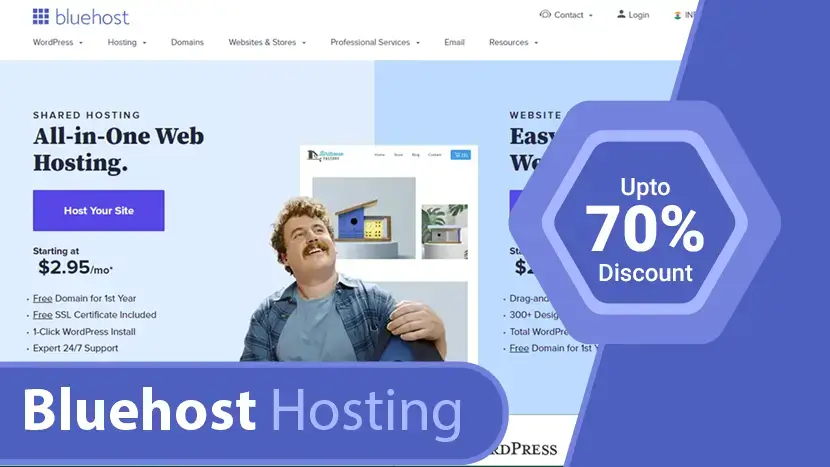
Bluehost started in 1996 and steadily grew to become one of the largest web hosting companies in the world. It now powers more than 2 million websites from all over the world.
Bluehost has a long-standing relationship with the WordPress community. They have been an official WordPress.org recommended web host since 2006.
They pride themselves in their 24/7 customer support, great hosting infrastructure, and support for the free open source software like WordPress.
On top of that, they are offering RGB Web Tech users an exclusive 63% off discount, a Free Domain, Free SSL, and a free Site Builder with templates.
Top Features
- Unlimited Websites
- Unmetered SSD Storage
- Unmetered Bandwidth
- 100+ Free WordPress Themes
- Free Domain for 1 Year
- Free Staging Environment
WordPress Website Builder
- Quick-Start AI Powered Templates
- Drag-n-Drop Builder
- Mobile-Responsive Themes
- Automatic Site Optimization
- 100+ Free Stock Image Library
Performance, Security, & Marketing
- SSL Certificate Protection
- Automatic Daily Malware Scan
- Speed Boosting CDN
- Website Stats Dashboard
- Email Marketing Tool
- WordPress Website Migration
- Free Bluehost SEO Tools
- Microsoft Office Email - Free 30 Days
- Domain Privacy
- Daily Website Backup
Bluehost Review Summary
- Performance grade - A+
- Average load time - 1.48 ms
- Average response time - 1.26 ms
- Free domain - Yes
- Free SSL - Yes
- 1-click WordPress - Yes
- Support - Phone / Live Chat / Knowledge base
Bottom line: In our Bluehost review, we found them to be reliable, fast, and affordable with friendly 24/7 customer support.
That’s why we’ve chosen to recommend Bluehost as one of the best WordPress hosting companies.
Now let’s dive into our detailed Bluehost hosting review so that you can decide for yourself.
In this comprehensive Bluehost review, we’ll put their promises to test with a rigorous and through analysis using industry standard benchmarking tools.
Following are the areas we’ll look into:
1. Speed: How fast will your website load with Bluehost? We will test their speed and server response time to assess that.
2. Performance: How does Bluehost perform under traffic spikes? We’ll test that by performing the stress test and see how well it performs under traffic.
3. Reliability: Will your website be available 24/7/365 without any downtime?
4. Customer Support: Can you count on Bluehost’s customer support when you immediately need help with your website?
5. Features: Do they offer all the features that you’ll need to build your website?
6. Pricing: Do they have the best pricing in the industry? Are there any Bluehost deals that can save you money?
This is our complete Bluehost review and we’ll be doing an in-depth analysis of Bluehost pros and cons. If you don’t want to read the full review, here is the quick scorecard of Bluehost with our verdict right below it.
Pros and Cons of Bluehost
All best web hosting services have their pros and cons. Some you can live with, and some you cannot ignore.
Here are the pros and cons of Bluehost that we learned.
Pros
First, let’s take a look at the advantages that make Bluehost the top choice.
1. Pricing: Their hosting plans are well within the reach of most users, particularly those who are just starting out.
2. Reliability: They power a large number of websites with minimum downtime.
3. No hidden charges: There are no hidden fees when signing up for your account.
4. Free domain: You get a free domain name for the first year when you sign up.
5. Free CDN + SSL: For each website, you get a free SSL certificate and free Cloudflare CDN to block malware and improve security.
6. Money Back Guarantee: They offer a 30 day money back guarantee on all plans.
Cons
As we mentioned earlier, there are always downsides with every hosting company. The following are some disadvantages of choosing Bluehost as your host.
1. Higher Domain Renewal Price: Their free domain renewal price is higher than average.
2. Upselling Addons: They have an aggressive upsell process during signup. But you can easily uncheck SiteLock and all other addons if you don’t need them.
Bluehost Hosting Plans and Features
Bluehost offers a variety of hosting plans for all budgets and sizes. Let’s take a look at Bluehost hosting plans and their features.
1. Shared Hosting:Shared hosting is the perfect way to start a new website with low traffic volume. In a shared hosting environment, your website shares server resources with other websites.
2. Cloud Hosting: A more reliable upgrade to the shared hosting plan. It allows you to utilize multiple cloud servers, allowing your website to automatically switch to a different server in case of a hardware failure or high traffic.
3. WordPress Hosting: Their WordPress plans are designed specifically for WordPress powered websites. It is optimized to run WordPress and can even protect your WordPress site against common threats.
4. VPS (Virtual Private Server) Hosting: An upgrade to shared WordPress hosting, VPS hosting allows you to virtual dedicated resources in a shared environment.
5. Dedicated Hosting Server: A dedicated hosting server for your website, means you will have all the resources of the dedicated server to yourself. The downside is that you will have to manage the server on your own.
All Bluehost hosting plans allow you to install WordPress with 1-click.
All plans come with an easy-to-use hosting control panel where you can manage your hosting, create databases, etc.
Bluehost has a custom control panel that improves ease of use for beginners. It also uses a customized version of the cPanel hosting dashboard for more advanced options.
Breakdown of Bluehost’s Shared Hosting Plans
Bluehost offers a shared hosting package suitable for starter websites. Their shared plan is available at four different levels.
Let’s take a look at Bluehost pricing and what’s included in each plan.
1. Basic: The basic plan only allows you to host one website. It hosts one domain and 25 subdomains, 50GB SSD storage, 5 email accounts of 100 MB disk space for each account. For the first term you’ll pay $2.75 per month. When you renew the account, you’ll have to pay $8.99 per month.
2. Plus: The Plus plan includes unlimited websites with unlimited storage space and unmetered bandwidth. You’ll also get unlimited email accounts. The price for the first term starts from $4.95 per month. When you renew the account, you’ll have to pay $11.99 per month.
3. Choice Plus: The Choice Plus plan includes all features of the plus plan. You will also get free domain privacy, and automated daily backups powered by CodeGuard as extras worth over $80/year. The price for the first term is $5.45 per month. When renewing, you’ll have to pay $16.99 per month.
4. Pro: The Pro plan starts from $13.95 per month for the first term after that you’ll pay $23.99 per month. It includes all features of above plans + dedicated IP address.
If you are just starting your website, then you can select any of these plans. You can easily upgrade your hosting plan as your website grows.
Bluehost Customer Support and Service
We all need help every now and then. It is really important that you choose a web hosting company that offers help and support when you need it.
Bluehost maintains a huge library of articles, step by step guides, and video tutorials as part of their extensive knowledge base. This is a huge help for beginners and most common issues can be quickly resolved by a simple search.
However, sometimes you may need to talk to an individual to get more help.
Bluehost offers a 24/7 support system where you can talk to their support team representatives using live chat or phone support. This is really helpful when you need quick help from technical support staff and you know they are just one-click away.
One thing that is missing is the ticket based support system. Bluehost recently decided to eliminate ticket-based support to focus on a personal approach of live chat support and phone-based support.
However, some users may still miss the ticket-based support system which is particularly good if your issue cannot be resolved in one live chat or phone session.
FAQs - Bluehost Web Hosting
In this detailed Bluehost review we have tried to cover all the aspects of their hosting services. The following are some of the most frequently asked questions about Bluehost that we hear from our users.
1. Can I make an online store using WooCommerce on Bluehost?
Answer : Yes, you can. In fact, Bluehost is one of the best WooCommerce hosting service providers. Their starter plan is perfect to start an online store.However, keep in mind that you’ll need to upgrade as your store starts getting more traffic. Hopefully, by that time you’ll be making enough money to justify the upgrade costs.
2. Is Bluehost good for beginners?
Answer : Yes. Bluehost is the most beginner-friendly WordPress hosting company on the market. They automatically install WordPress for you when you sign up. They also have an easy to use control panel which allows you to manage your hosting account by yourself.There is plenty of help available with detailed guides, video tutorials, and articles. You also have 24/7 access to their expert support via live chat and phone.
3. Can Bluehost handle high traffic?
Answer : Their shared hosting plans are suitable for starter websites and small businesses. In our stress test, their shared hosting plan was able to handle 100 virtual users without any slowdown.These plans can handle reasonable and sudden traffic spikes. However, they are still quite limited in server resources. If you are expecting high traffic then you’ll need to upgrade your hosting plan.
4. Why use Bluehost for WordPress?
Answer : Bluehost is one of the largest hosting companies in the world and an officially recommended WordPress hosting provider. They have been supporting the WordPress community for a very long time and know WordPress very well.Their platform is highly optimized for WordPress websites and engineered to run WordPress at peak performance. They also have WordPress engineers in their team so you know your website is in safe hands.
5. Do I need a credit card to sign up with Bluehost?
Answer : Bluehost accepts credit cards but you can choose to show more payment options during checkout and select PayPal as your payment method if you wish.
6. Is Bluehost better than GoDaddy?
Answer : Bluehost is better than GoDaddy because we believe Bluehost support is better. My Sites dashboard and overall onboarding experience is a lot more beginner friendly. Not to mention, Bluehost offers better pricing for small businesses.
7. How does Bluehost compare with SiteGround and HostGator?
Answer : When comparing Bluehost with SiteGround and HostGator, there are several pros and cons you should be aware of.Bluehost offers more value for the price when compared to SiteGround. Their plans start at $2.75 per month and include a free domain, whereas SiteGround plans start at $4.99 and do not include any free domain.On the other hand, the SiteGround platform comes with better speed and security features. For more details, see our comparison of Bluehost vs SiteGround vs WP Engine.In terms of Bluehost vs HostGator, they’re pretty similar when it comes to hosting CPU resources, functionality, site migration tools, pricing, and more. Bluehost is also more comparable with shared hosting providers like Inmotion hosting or Dreamhost. We find Bluehost user experience to be slightly better as they’ve invested heavily in their WordPress website builder platform.
8. Where are Bluehost servers located?
Answer : Bluehost operates its own in-house data center located in Utah, US. It is a massive 50,000 square feet facility that serves as their primary data center.
9. What Bluehost plan should I get?
Answer : If you are just starting out a brand new website, blog, or online store, then we recommend starting with their basic plan. It is good enough for a starter website and you can always upgrade later.Ready to start your website with Bluehost? Click here to select your Bluehost plan.
10. What are the types of web hosting?
Answer : This answer will be different for everyone. It depends on the type of website you have, the resources you need, your budget, and traffic.We gave our top recommendation for each category in this guide, so that’s the best place for you to start your search.Once you know what you need, you can narrow your options. To figure out what category you fall in, here’s a quick recap of the different hosting types.
Conclusion: Is Bluehost the Right Choice for You?
After reading this review, you might be wondering if Bluehost is the right choice for your website?
Bluehost is often ranked #1 web hosting provider by many websites. They offer a wide range of hosting options with tons of features that help you easily build your website.
All their hosting plans include expert 24/7 customer support from knowledgeable staff.
Most importantly, they offer affordable starter plans that fit any budget requirement.
If you are just starting out, then you cannot go wrong signing up for a Bluehost shared hosting plan. It’s easy on your pocket and comes with all the right tools. As your site grows you can easily upgrade your hosting plan accordingly.
Ready to start your website with Bluehost? Click here to select your Bluehost plan.
Alternatives - Web Hosting Providers
If you want to explore more web hosting plans, here is some web hosting services provider companies as below:
Read More : You can explore here 30+ Best Web Hosting and Domain name Providers 2023
Video - Best Web Hosting For Small Business
Affordable Website Hosting for your domainIf you found this article helpful, we encourage you to share it on your social media platforms—because sharing is caring! For more information about article submissions on our website, feel free to reach out to us via email.
Send an emailWritten by RGB Web Tech
Latest Technology Trends
Latest technology trends shaping the future, including AI advancements, blockchain innovation, 5G connectivity, IoT integration, and sustainable tech solutions. Explore breakthroughs in quantum computing, cybersecurity, augmented reality, and edge computing. Stay ahead with insights into transformative technologies driving innovation across industries and revolutionizing how we live, work, and connect.
Accu Web Hosting Review
Last updated on January 19, 2025 by RGB Web Tech
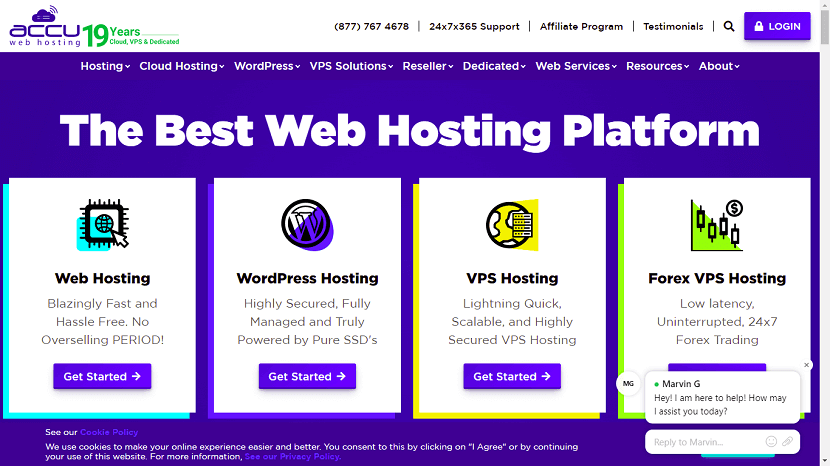
AccuWebHosting was founded in 2000 as a Windows hosting company. AccuWebHosting was founded to fulfill the demand for flexible web hosts that could adapt to every customer’s needs. It added new services over time, greatly expanding its service offering.
It still places a strong emphasis upon Windows-based plans today, and scores extremely well in our Windows hosting review. It also provides a broad area of services and has more plans than most providers.
AccuWebHosting adheres to a friendly, hands-on approach to customer support. AccuWeb has a high rate of customer satisfaction, and this policy is working well.
It also provides a lot of information about its plans. This is refreshing considering that most hosts only highlight the best features and keep all other details hidden from potential customers.
It certainly makes a positive impression. To see how it works, I gave the provider a try.
Top Features
- Unlimited Domains (Sites) in 1 Account
- 50 GB Pure SSD Storage - Raid10 Setup
- 1 TB Monthly Bandwidth
- 1000 Email Accounts
- Free SSL
- Control Panel: cPanel
- LiteSpeed with LSCache Plugin
- Free Website Migration
- Dedicated IP (Addon)
- Unlimited mySQL Databases
- PHP Support
- HTTP/2 Support
- Perl Support
- Free Domain Name Registration
- Free Website Builder - 400+ templates
- Anti-Spam Cloud Service (Optional)
- Instant Account Activation
- 30 Days Money Back Guarantee
- Works On Any Platform
- Purchase Addon
PROS and CONS of AccuWebHosting
Pros
1. Incredible Uptime : While AccuWebHosting offers a 99.99% uptime guarantee to its customers, it goes ahead to deliver 100% satisfaction, which tells you that the web host is laser-focused on offering nothing short of top-notch performance to users.
2. Super-quick Loading Speed :Experts say that cheap isn’t necessarily low quality. AccuWebHosting is a classic example of that: It charges low prices but delivers terrific loading speeds of about 285 ms.
A quick examination of site loading speeds reveals that sites hosted on AccuWebHosting deliver results pretty fast, with the slowest site taking 485 ms to load fully. Uptime.com returned results in the 280-290 ms range, which is very acceptable.
This means that no matter the hosting plan you opt for in AccuWebHosting, visitors to your website won’t need to keep waiting for a simple homepage to load results. Simply put, sluggish speeds are unheard of when it comes to AccuWebHosting.
3. Responsive Customer Support : We mentioned a while ago that the quality or rather responsiveness of customer support is one of the most essential factors that you should consider when choosing the right hosting solution.
The professional customer support representatives at AccuWebHosting will quickly respond to your ticket within a few seconds, especially if you use the live chat platform to submit your ticket.
If you purchase a VPS or dedicated hosting plan, hosting experts will accord you 24/7 server management. Additionally, you can consult the Frequently Asked Questions (FAQs), knowledge base, and AccuWebHosting community, at least if you don’t want to use the live chat and email ticketing routes.
4. Easy, Navigable User Interface : AccuWebHosting’s control panel is impressive. The panel is not only intuitive and easy to navigate but also colorful and information-rich. In fact, a user doesn’t have to consult hosting experts there because bits of useful information are available throughout the panel. Even app installation is pretty straightforward, and you will love it.
5. Cheap Prices, Best Value : AccuWebHosting is very affordable, though not as cheap as compared to some of its competitors like BlueHost. To be fair, the web host’s offerings are competitively priced bearing in mind all the tools that come with their plans. Even their most basic shared hosting plans come with lots of cloud storage space and bandwidth, which is what you need to fully accommodate all the aspects of your website.
If you want to get started with WordPress hosting, AccuWebHosting will offer you a nice plan for only $4.49 per month. Other plans are a bit affordable, too. It’s not easy to find a disadvantage with the company’s hosting plans, but as usual, there’s no one-size-fits-all when it comes to web hosting solutions. That said, make sure to take advantage of the web host’s 30-day money-back guarantee in case you are not pleased with what you get.
Cons
- Affordable, though not as cheap as compared to some of its competitors.
- Don’t have unlimited email accounts for Windows hosting plans.
- No monthly payment option for shared hosting plans.
FAQs - AccuWebHosting Review
1. What is AccuWebHosting?
Answer : AccuWebHosting is a web hosting service that offers great customer support, an easy-to-manage control panel, and pretty good security tools all for a relatively low price point.
2. Is AccuWebHosting free?
Answer : AccuWebHosting offers free Cloudflare and hosting services for students plan. Any current or incoming student at a known university is eligible for free hosting.
3. Is AccuWebHosting safe?
Answer : AccuWebHosting offers decent security options even for its cheapest plans, as well as reliable hosting services.
4. Is AccuWebHosting good for WordPress sites?
Answer : AccuWebHosting is good for WordPress sites, because this provider offers fully managed WordPress hosting. It's powerful, secure, and fast. The cheapest plan starts at $2.99/month.
5. Does AccuWebHosting offer Windows VPS?
Answer : Yes, AccuWebHosting offers Windows VPS – the cheapest plan costs $10/month. Even the cheapest plan has great security features, as well as a 99.9% uptime guarantee.
Conclusion
So, it’s time to conclude this AccuWebHosting review. What can I say?
I think AccuWebHosting is having a great offering with solid performance, features and support. The downside is that they use cPanel, which I think is not the most user-friendly. Personally, I also had a kind of cumbersome on-boarding experience.
So, if you’re looking for an inexpensive host for a couple of WordPress websites, that has data-centres in 5 continents and offers email and don’t mind using cPanel, AccuWebHosting is the way to go!
Alternatives - Web Hosting Providers
If you want to explore more web hosting plans, here is some web hosting services provider companies as below:
Read More : You can explore here 30+ Best Web Hosting and Domain name Providers 2023
Video - Best Web Hosting For Small Business
Affordable Website Hosting for your domainIf you found this article helpful, we encourage you to share it on your social media platforms—because sharing is caring! For more information about article submissions on our website, feel free to reach out to us via email.
Send an emailWritten by RGB Web Tech
Latest Technology Trends
Latest technology trends shaping the future, including AI advancements, blockchain innovation, 5G connectivity, IoT integration, and sustainable tech solutions. Explore breakthroughs in quantum computing, cybersecurity, augmented reality, and edge computing. Stay ahead with insights into transformative technologies driving innovation across industries and revolutionizing how we live, work, and connect.
GoDaddy Web Hosting Review
Last updated on January 19, 2025 by RGB Web Tech

GoDaddy Inc. is an American publicly traded Internet domain registrar and web hosting company. Its headquarters is in Scottsdale, Arizona, and incorporated in Delaware.
The Best Website Hosting providers will not be complete without mentioning GoDaddy, which is also known for their affordable website hosting plans. At only $1 per month, you will get not only website hosting but even free domain registration. They have global data centers, which can assure that speed will not be an issue. Plus, they are also guaranteeing 99.9% uptime. The cheapest plan also comes with unmetered bandwidth, 100 GB of storage, and a free domain when you sign up for the annual plan.
GoDaddy Hosting Features
GoDaddy’s platform is optimized for WordPress, with high-performance features like load-balanced servers. WordPress Hosting from GoDaddy uses servers modified to ensure WordPress websites run smoothly.
Their WordPress search engine optimization (SEO) plugin reviews pages and automatically handles basic SEO needs so search engines can easily find their client’s website. This service includes a security feature that finds and removes malware before it does damage available in their Ultimate and E-commerce hosting plans.
1. Easy-to-use Control Panel : Includes industry-standard cPanel to install apps, manage backups and security.
2. 1-click install of over 150 Free Apps : Provides access to over 150 free apps to create CMS sites (WordPress, Joomla), forums and blogs through Installatron.
3. 24/7 Network Security : Offers peace of mind, knowing network security and DDoS protection is monitored around the clock.
4. Resources on-demand : If you require more power for your site, seamlessly increase your CPU/RAM, I/O, and storage with a 1-click purchase.
5. Global Data Centers : Gives faster page loads and a better visitor experience with nearby, state-of-the-art data centers in North America, Europe, or Asia-Pacific.
6. 1-click Domain Name Setup : GoDaddy registered domain links your site to your domain name.
Pros and Cons of GoDaddy Web Hosting
There’s no question GoDaddy is one of the biggest names out there as far as how recognizable it is. It also houses the most domains globally, with over 17 million domain names on its roster.
Still, there are pros and cons to choosing GoDaddy as your web hosting provider. Here are the more prominent ones to take into account.
Pros
1. 24/7 Support : GoDaddy ensures it’s always within reach if you ever need a hand or run into trouble with your site. You can either reach them by phone or use its handy chat support option.
2. Lots of Storage : When you look through and compare GoDaddy’s hosting plans, it’s generous with its unmetered bandwidth feature for all tiers.
3. Affordable .com Domain : GoDaddy offers you the chance to snag a domain for only 99 cents for the first year, which can save you money as you begin.
4. Unlimited Site Hosting : Most GoDaddy plans let you host an unlimited number of websites except for its cheapest Economy plan.
5. Convenience : Since you can manage your domain and website in one place, GoDaddy offers convenience in managing both from one dashboard.
Cons
1. Constant Upsells : GoDaddy is notorious when it comes to its upsells through every step of the checkout process. While it does honor the prices for each tier if that’s all you’re going for, it’s quick to suggest add-ons and extra features you might not need.
2. Expensive Renewal Rate : This is one of the reasons why I think GoDaddy is great for beginner sites that just want to get their foot in the door with hosting. Once that initial year is up, GoDaddy’s renewal rates can start to get costly for what you get.
3. Charges for Add-ons : Other hosting providers throw in free first-year domain registration, for example, or include free SSL certification as part of its plans. GoDaddy does not always include these features depending on the plan you choose and can charge extra for them.
4. Inconsistent Customer Support : Support for GoDaddy isn’t always top-notch as convenience and reliability are concerned. There is always the possibility of long wait times to be connected to the right person.
FAQs - GoDaddy Hosting Review
1. Who owns GoDaddy?
Answer : GoDaddy was founded by Bob Parsons. About 70 percent of GoDaddy was sold to a private equity consortium several years ago, and the company has since gone public on NASDAQ with the stock ticker GDDY.
2. Where are GoDaddy servers located?
Answer : GoDaddy owns a massive 320,000 square feet data center that is located in Phoenix Arizona. The company also has data centers in Los Angeles, Chicago and Ashburn, Virginia, along with international facilities in Amsterdam and Singapore.
3. Does unlimited hosting mean what I think it means?
Answer : Yes and no. Shared plans do come with unlimited storage, but you are limited to 250,000 files/folders (and each email counts as a file). Furthermore, there are certain “soft” caps on other resources — if your usage exceeds these caps, GoDaddy may throttle the resources available to your website and, in extreme cases, may even prevent your use of the resources, leading to site downtime.
4. What kind of customer support do I get?
Answer : How do I contact GoDaddy’s support? You get first class 24/7 customer support via phone, live chat.
5. What are GoDaddy’s nameservers?
Answer : If your domain name is registered someplace else (for example with Namecheap) then you need to update the domain’s nameservers. You will find the correct NS values in your control panel. For example, GoDaddy’s default DNS nameservers look like: ns01.domaincontrol.com and ns02.domaincontrol.com. Their premium DNS nameservers look like: pdns01.domaincontrol.com and pdns02.domaincontrol.com.
6. How do I request a refund?
Answer : You can contact GoDaddy using live chat (Live chat can be launched via the “Chat with us” button on their website) or phone. To request a refund go to the “Contact Us”, select your country and perform a toll-free phone call.
7. What if I decide to cancel my hosting package with GoDaddy?
Answer : GoDaddy offers a money-back guarantee however it is related to the length of your web hosting plan. So do read the fine prints. However, you do qualify for a 45-day money-return guarantee if you have selected their annual plan.
8. What features does GoDaddy's website builder offer?
Answer : First of all, you’ll find many free templates to start customizing your website with. You’ll also find a nice library of 8,700 free photos. Another feature you can add to your website is a shopping cart. If you’re really short on time, GoDaddy’s Website Builder offers you pre-built websites with pre-written words and pictures. It just takes a mere 5 minutes to perform a tweak and you’re good to go.
9. What is GoDaddy’s cheapest hosting plan?
Answer : GoDaddy’s cheapest hosting plan is $2.99 per month and it comes with unlimited bandwidth and 100 GB storage and a free domain (for the first year) is included with the purchase.
10. Can I automatically install WordPress/automate WordPress installation?
Answer : WordPress installation is manual (though easy), but GoDaddy provides you with a WordPress managing tool suite, which automatizes your WordPress site backups and software updates. GoDaddy also enhances the performance of your WordPress website and offers you 24/7/365 specialized tech support. Managed WordPress plans come with the WordPress core pre-installed.
11. Which GoDaddy plan is best for WordPress sites?
Answer : The best plan for self-hosted WordPress users depends on the total number of sites hosted. Although the Developer plan is the most expensive one, it’s meant for people who own 5 websites and have up to 800,000 monthly visitors. On the other hand, the Ultimate plan can handle one or two WordPress sites, and 400,000 monthly visitors. It also includes malware protection.GoDaddy also offers managed WordPress options, which include bonuses like WordPress installed by default, staging areas, and dedicated phone support lines (no live chat, though).
Alternatives - Web Hosting Providers
If you want to explore more web hosting plans, here is some web hosting services provider companies as below:
Read More : You can explore here 30+ Best Web Hosting and Domain name Providers 2023
Video - Best Web Hosting For Small Business
Affordable Website Hosting for your domainIf you found this article helpful, we encourage you to share it on your social media platforms—because sharing is caring! For more information about article submissions on our website, feel free to reach out to us via email.
Send an emailWritten by RGB Web Tech
Latest Technology Trends
Latest technology trends shaping the future, including AI advancements, blockchain innovation, 5G connectivity, IoT integration, and sustainable tech solutions. Explore breakthroughs in quantum computing, cybersecurity, augmented reality, and edge computing. Stay ahead with insights into transformative technologies driving innovation across industries and revolutionizing how we live, work, and connect.
Hostinger Web Hosting Review
Last updated on January 19, 2025 by RGB Web Tech
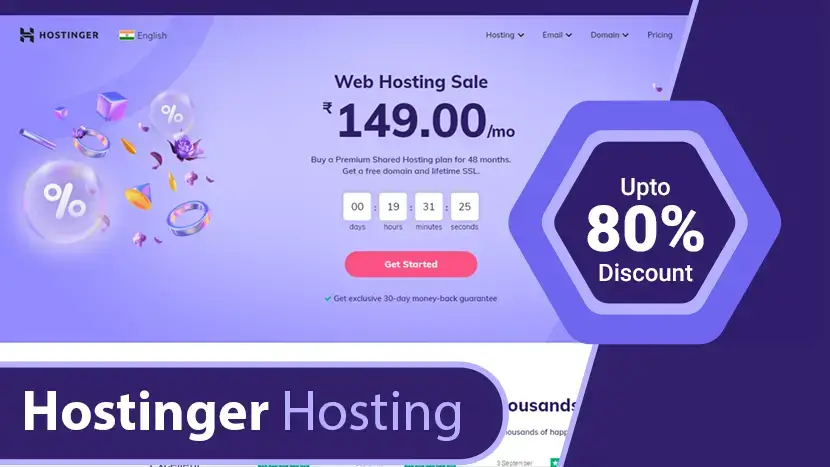
Hostinger is known for its inexpensive shared, cloud, and VPS hosting. All of their plans come with a 30-day money-back guarantee and a free website builder. Do these low-cost plans scrimp on features? Let’s take a closer look at Hostinger’s server speeds, performance, ease-of-use, and customer service.
Hostinger may be best known for its deeply discounted hosting. These Hostinger hosting plans are incredibly cheap compared to industry averages. All plans come with a 30-day free trial.
Hostinger provides free SSL certificates on all plans except for the entry-level Single Shared Hosting plan. SSL certificates are a must for all sites. Browsers may mark your site as ‘unsafe’ if you do not have an SSL certificate. Many hosting companies charge extra for SSL certificates.
Features
- Free Domain (₹679.00 value)
- Free SSL (₹855.00 value)
- Free Email
- 200 GB SSD Storage
- ~100000 Visits Monthly
- 30 Days Money Back Guarantee
- Daily Backups (₹660.00 value)
- Free CDN (₹545.00 value)
- Cloudflare Protected Nameservers
- 24/7/365 Support
- 99.9% Uptime Guarantee
- Unlimited Bandwidth
- Managed WordPress
- Unlimited Databases
- DNS Management
- 100 Websites
- 100 Subdomains
- Unlimited FTP Account
- Unlimited Cronjobs
What Are the Pros and Cons of Hostinger?
Pros
- Comprehensive knowledge base.
- User-friendly control panel.
- Competitive Pricing.
- Multiple Data Centers.
- Excellent onboarding.
- Free nightly backups.
- 30-day money-back guarantee.
- Free SSL & Domain name on entry-level plan
Cons
- Inconsistent website speed.
- Refund exceptions.
- Limited Support.
How is Hostinger’s Performance and Uptime?
Hostinger provides good server response speeds. Over the period from April 2019 through June 2019, our tests showed an average response of 509 ms.
Hostinger uses various technologies to boost site loading speeds, including:
1. SSDs: Solid-state drives are faster and more reliable than HDDs (hard-disk drives).
2. HTTP/2 and HTTP/3 (Quic): This is a network protocol that increases speed.
3. PHP 7: Most modern dynamic websites (like those built with WordPress) use the PHP language. PHP 7 provides greater speed and reliability.
4. Litespeed: Litespeed is a brand of web servers known for its speed.
5. GZIP compression: This is a form of file compression used to increase speed.
Uptime refers to the amount of time that servers are up and working correctly from the host’s end. A high uptime indicates that a host is stable, well-built, and can fend off network threats.
Hostinger provides a 99.9% uptime guarantee.
How Does Hostinger Keep Your Site Secure?
Hostinger’s SSL security guarantees lifetime security. Their web hosting plan offers a free SSL certificate to provide a safe online environment as it offers the highest level of encryption and immediate access results. Their servers have advanced security modules (such as mod_security, Suhosin PHP hardening, PHP open_basedir protection, and others) that give the highest security level available today.
Their free SSL certificate will ensure the safety of their client’s data including their clients’ target audience. Hostinger’s SSL for WordPress will also protect their clients’ blogs or e-commerce shops, ensuring the safety and reliability of every online transaction. The encryption, which protects their client’s data from theft and any other malignant act, is the strongest form of encryption in the open market and follows the SSL protocol – a guaranteed security service of Hostinger.
Hostinger’s Cloudflare is a CDN (Content Delivery Network) that not only speeds up your website’s loading speed but also protects it from intrusions and DDoS attacks. All of their hosting plans fully support Cloudflare that establishes a secure connection for sensitive data protecting their clients’ websites. This security service requires an additional fee before setting up.
Does Hostinger Handle Site Backups?
Hostinger provides daily backups with the majority of their hosting plans – the only plans that have weekly backups are their Shared Single and Premium hosting plans.
Their hPanel contains backup features that allow you to backup your files and data You can download both the website files and the database when backing up your site manually. In your hPanel, backups can be made by accessing your Backups option under the Files section. Click on Select near Generate new backup section, give it some time, your new Files and Databases backups will be made.
How is Hostinger’s Help and Support?
Hostinger provides 24/7 support. You have 2 main options.
Hostinger knowledge base – Consists of hundreds of tutorials and solutions to common issues. It’s easy to search, and from what I see, the answers are all easy to understand.
Live chat support – Available 24/7, every day of the year.
Hostinger is also active on social media and usually responds to messages and posts within a few hours.
FAQs - Hostinger Web Hosting
1. Which Company Owns Hostinger?
Answer : Established in 2004, Hostinger now has over 29 million users, collectively with its subsidiaries in 178 countries. Hostinger is the parent company of 000Webhost, Niagahoster and Weblink.
2. Which Languages Does Hostinger Support Team Speak?
Answer : Their customer support provides support in English for all locales. Additional languages they speak are Lithuanian, Portuguese and Brazilian Portuguese, Indonesian and Malaysian, Spanish, Russian, Ukrainian, French, Arabic, Thai, Vietnamese and Chinese.
3. What Kind of Support Do I Get With Hostinger?
Answer : Hostinger offers 24/7/365 support via live chat.
4. Where are Hostinger’s Servers Located?
Answer : Their servers are located all around the world. They have datacenters in Europe (the Netherlands, Lithuania, the United Kingdom), Asia (Singapore), North America (the USA).
5. What is Hostinger's Cheapest Hosting Plan?
Answer : Hostinger cheapest plan is their Single shared hosting package, which costs $1.39 per month.
6. Does Hostinger Have a cPanel?
Answer : Hostinger does not provide the classic cPanel to manage domain and hosting accounts. It has its own control panel, which is known as hPanel.
7. What are the types of web hosting?
Answer : This answer will be different for everyone. It depends on the type of website you have, the resources you need, your budget, and traffic.We gave our top recommendation for each category in this guide, so that’s the best place for you to start your search.Once you know what you need, you can narrow your options. To figure out what category you fall in, here’s a quick recap of the different hosting types
Conclusion
Hostinger is a user-friendly, secure, reliable, and affordable hosting option, especially if you are just starting out with your website.
Alternatives - Web Hosting Providers
If you want to explore more web hosting plans, here is some web hosting services provider companies as below:
Read More : You can explore here 30+ Best Web Hosting and Domain name Providers 2023
Video - Best Web Hosting For Small Business
Affordable Website Hosting for your domainIf you found this article helpful, we encourage you to share it on your social media platforms—because sharing is caring! For more information about article submissions on our website, feel free to reach out to us via email.
Send an emailWritten by RGB Web Tech
Latest Technology Trends
Latest technology trends shaping the future, including AI advancements, blockchain innovation, 5G connectivity, IoT integration, and sustainable tech solutions. Explore breakthroughs in quantum computing, cybersecurity, augmented reality, and edge computing. Stay ahead with insights into transformative technologies driving innovation across industries and revolutionizing how we live, work, and connect.
HostGator Web Hosting Review ( Web Hosting Plans for All Business)
Last updated on January 19, 2025 by RGB Web Tech

Given that HostGator has a lot to like and very few things to dislike, you should definitely try the company if you own a website or plan to build one.
If the web host does not make a good fit for your website, the 45-day money-back guarantee allows you to walk away without losing your money.
Having been around for more than a decade, HostGator is one of the most trusted and recognized web hosts. It excels in several areas including customer support, hosting flexibility, uptime, shared hosting, plus so much more.
This excellence in several aspects of web hosting coupled with the company’s experience, array of features, and performance makes HostGator a smart choice for any website owner.
Regardless of where you are in the website-building cycle, HostGator has something for you.
You can begin building your website using their drag-and-drop Website Builder. If you’re at the other end of the spectrum, you can enlist the help of HostGator’s dedicated Migrations Team to transfer your website and configure it for optimal performance on their platform – for free.
Features
- 1-Click WordPress Installation
- Free SSL Certificate
- Unmetered Disk Space & Bandwidth
- Easy-To-Use cPanel
- E-commerce Ready
- Drag & Drop Templates
- 24/7/365 Technical Support
- 45 days Money-Back Guarantee
What Are the Pros and Cons of HostGator?
So, is HostGator the right web host for you?
Well, given the fact that HostGator gives you a simple way to build and manage your site, provides you with all the resources you’ll need to deliver high-level services on your site, offers several feature-packed hosting packages, and brings a ton of experience to the table, it can be an ideal web host for anyone with a website.
What Are the Pros of HostGator?
HostGator offers several benefits including:
- Reliable uptime and fast response times.
- Affordable hosting plans.
- Plenty of room for growth.
- No restriction on bandwidth, disk space, and emails.
- Rock-solid security.
- Free Weebly site builder.
- A great control panel with a ton of features ranging from a web-based file manager to more advanced features such as cron jobs, image manager, error logs, and apache handlers.
- The option of cloud hosting.
- Flexible email management.
- Free shared or private SSL certificate on all hosting packages.
- Generous 45-day money-back guarantee that gives customers peace of mind.
Extensive Knowledge Base
Additionally, HostGator has a large knowledgebase with answers to practically any question you could have ranging from the simplest to the most advanced. So, when the customer support team takes too long to answer, you can seek out the solution to your problem from this knowledgebase.
What are the Cons of HostGator?
As for the negatives of the company, you’ll only have to deal with the issue of weekly backups, slow customer response times (according to some of the host’s users), an advanced cPanel that requires some getting used to, and no one-stop WordPress import.
Be aware that HostGator is not HIPAA-compliant. If you need such compliance to explore Atlantic.net, a web host that exceeds HIPAA guidelines and is fully compliant. If you serve Canada, explore Canadian Web Hosting, which is fully compliant with Canada’s health and privacy data regulations.
These are cons you can work around and still get to enjoy the immense web hosting quality of HostGator.
What Makes HostGator Stand Out?
Further making HostGator a good catch is the fact that the web host throws in a few extra features with their various hosting plans. For instance, each hosting plan comes with several freebies.
You get a free website builder and website building tools, unlimited bandwidth and disk space, over 4,000 website templates, free domain transfers, and unlimited MySQL databases.
HostGator are Generous with Valuable Extras
Other extras that you can look forward to with HostGator include:
1. $150 worth of Google Adwords or Bing/Yahoo advertising credits.
2. Free site transfers when you want to move your website from another host to HostGator. And the best part is that your website can be upgraded during the transfer at no cost. However, the said migration has to be done within 30 days from the day you sign up.
3. A free domain name for the first term when you transfer and set up a new account.
4. 1-click installs available for all major open-source projects such as WordPress, Magento, and Joomla.
5. A 45-day money-back guarantee for all HostGator hosting plans. Most web hosting companies only give you a 30-day window to cancel your account and get your money back.
6. A getting-started email with links to all of the resources you will need to build your website and get it up and running.
What Perks Are On the Table?
HostGator offers a range of plans. If you’re struggling to make a decision on which plan to choose, consider these features, which we’ll discuss below:
1. You manage your account using cPanel, the industry-standard interface.
2. To keep your account secure, you get a free Secure Sockets Layer (SSL) certificate.
3. If you want to increase security and malware scanning, you will have to buy SiteLock.
4. Even the entry-level shared hosting plan comes with support for unlimited email accounts.
5. Monthly billing options are available.
6. One-click installs, even from the basic plan.
7. Access to the website builder – at a cost.
8. A Content Delivery Network (CDN) keeps your site fast.
9. Multiple support options including live chat.
With all the other web hosting providers that are available, why choose HostGator? Well, the truth is that no single web host is perfect. So, whether you’re a novice webmaster or are looking to change web hosts, here’s a quick look at the good and the bad of HostGator to help you make the right decision.
FAQs - HostGator Web Hosting
Anything else you’d like to know about HostGator? We have created a group of frequently asked questions to cover any instant queries you have.
1. Who owns HostGator?
Answer : HostGator is owned by Endurance International Group (EIG). EIG owns a large slice of the web hosting industry, for example, EIG owns Arvixe, A Small Orange, Bluehost, iPage, HostGator.
2. What kind of support do I get?
Answer : You get 24/7/365 support via phone, live chat, emails, and a comprehensive database of knowledge. There are 500+ tutorials to help you with almost anything related to HostGator. There are also more than 680 helpful articles on their website.
3. What languages does HostGator support speak?
Answer : HostGator’s customer service is only provided in English.
4. How long has HostGator been in business?
Answer : Founded in 2002, HostGator is an established and reputable web hosting company that has been in business for over a decade. After being sold off in 2012, HostGator became a subsidiary of Endurance International Group (EIG).
5. Why should I choose HostGator?
Answer : With more than 8 million hosted domains, HostGator is among the top 30+ largest web hosting companies. HostGator is worth considering because of its top-notch customer support service, state-of-the-art data centers, and comprehensive web hosting packages. Millions of website owners choose them for these reasons.
6. What are HostGator nameservers?
Answer : There are two places where you will be able to find Hostgator name servers. You can find them in your welcome email or find them listed inside of your cPanel control panel. Your nameservers will have the following syntax: xx.hostgator.com – xx.hostgator.com.
7. What if I decide to cancel my hosting with HostGator?
8. Will I be billed monthly or yearly when using a HostGator account?
Answer : Customers get to choose their preferred billing cycle when signing up with HostGator. You can choose to be billed monthly, after 6 months, annually, biannually, or once every 3 years. The longer terms come with discounts that amount to significant savings over time.
9. Are there any hidden charges?
Answer : There are no hidden fees associated with any of HostGator’s hosting packages. A billing summary is usually included on the order page where you can easily remove add-ons that you do not want. New monthly subscribers should keep in mind though that the introductory prices for the first month are usually discounted and automatically renew at the regular rate.
10. What forms of payment does HostGator accept?
Answer : HostGator is very flexible when it comes to payments. They accept payments via PayPal, MasterCard, Visa, American Express, Discover, wire transfers, personal checks, cash, and money orders.
11. What types of hosting packages are there?
Answer : There are three shared hosting plans: Hatchling, Baby, and Business. There is also a range of VPS and Dedicated server packages. HostGator also offers cloud hosting and fully managed WordPress hosting for your WordPress websites and blogs.
12. Does HostGator offer Linux or Windows servers?
Answer : Unlike most web hosts that focus on Linux hosting only, HostGator offers the choice of Windows-based servers as well. Plesk is the default control panel on Windows servers while those who prefer Linux get to use cPanel.
13. Can I purchase a domain name with HostGator?
Answer : Yes, HostGator can be your domain registrar whether you decide to purchase hosting from them or not. They also offer dozens of extensions as well as Top-Level and country code Domains.
14. What are the best alternatives to HostGator?
Answer : HostGator is an affordable and good entry-level web hosting provider, and they’re one of the world’s most popular web hosting companies. However, if you are looking for alternatives to HostGator you should check out Bluehost, SiteGround, DreamHost, and A2 Hosting.
15. What is HostGator’s cheapest web hosting plan?
Answer : HostGator’s cheapest plan is 32.95. They offer a free trial with a 45-day money guarantee. In other words, you get your money back, no questions asked, if you decide to cancel within the first 45 days.
16. How do I transfer my website to HostGator?
Answer : HostGator makes it easy to transfer your website to your HostGator hosting account. They can transfer website files, databases, scripts, and one free domain registration transfer. HostGator provides free transfers for new accounts within 30 days of sign-up, and to newly upgraded accounts.
17. How do I install WordPress in HostGator?
Answer : WordPress is one of the most popular blogging platforms around. The first step to install WordPress is to log in to your cPanel account, the second step is to go to the MOJO Marketplace and go through the Quick Install process.
18. What are the types of web hosting?
Answer : This answer will be different for everyone. It depends on the type of website you have, the resources you need, your budget, and traffic.We gave our top recommendation for each category in this guide, so that’s the best place for you to start your search.Once you know what you need, you can narrow your options. To figure out what category you fall in, here’s a quick recap of the different hosting types.
Alternatives - Web Hosting Providers
If you want to explore more web hosting plans, here is some web hosting services provider companies as below:
Read More : You can explore here 30+ Best Web Hosting and Domain name Providers 2023
Video - Best Web Hosting For Small Business
Affordable Website Hosting for your domainIf you found this article helpful, we encourage you to share it on your social media platforms—because sharing is caring! For more information about article submissions on our website, feel free to reach out to us via email.
Send an emailWritten by RGB Web Tech
Latest Technology Trends
Latest technology trends shaping the future, including AI advancements, blockchain innovation, 5G connectivity, IoT integration, and sustainable tech solutions. Explore breakthroughs in quantum computing, cybersecurity, augmented reality, and edge computing. Stay ahead with insights into transformative technologies driving innovation across industries and revolutionizing how we live, work, and connect.
Inmotion Web Hosting Review
Last updated on January 19, 2025 by RGB Web Tech
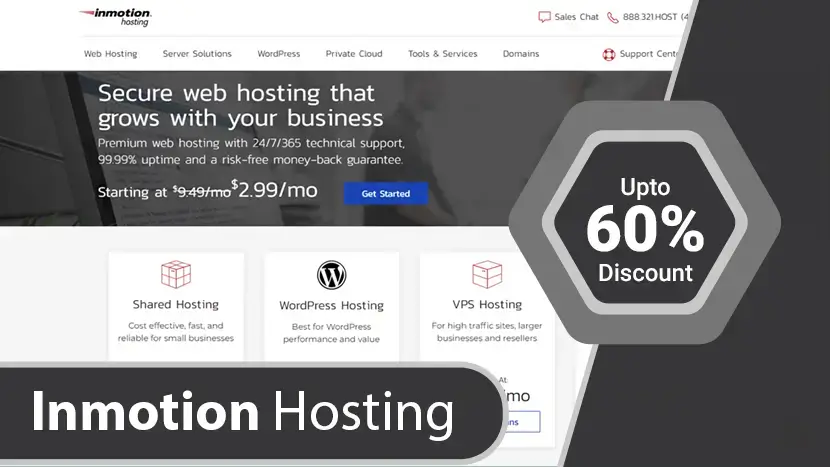
- Exclusive Sale - Upto 60% OFF
- Starting at
$9.99.00$3.49/month*
Inmotion Hosting
While InMotion lacks Windows-based servers, this web host still offers some of the best Linux hosting solutions that money can buy. You also get to enjoy features such as 99.9% uptime, unlimited emails, and free SSDs on all servers, just to mention a few.
The lengthy 90-day money-back guarantee that InMotion provides shows how confident they are with their services. Overall, this company has solid web hosting services and comes highly recommended over many competing services.
Inmotion offers several benefits, depending on your needs. There are very few negatives said about this hosting provider in reviews. However, be safe and do your homework before making a hosting provider decision.
Feature:
- FREE SSD Drives : Included with all hosting plans
- FREE Domain : New Or Existing Transfer
- 90-Day Guarantee : Truly Industry Leading
- Data Backups : One-Click Restore and Backup
- FREE 1-Click Installer : Install Over 400 Applications
- Code in More Languages : PostgreSQL, Ruby, PHP
- Secure IMAP Email : Access Email from any Device
- Max Speed Zone : Choose your Data Center
- SSH Access : Work Easier & Faster
- Google Apps Integration : Easy to use 3 Step Wizard
What Are the Pros and Cons of InMotion Hosting?
Is InMotion Hosting any good? The truth is, there’s no perfect web hosting company.
Therefore, it is important to have full knowledge of the strengths and weaknesses of any particular web host that you’re considering. With that in mind, here’s a quick list of the pros and cons to expect from InMotion hosting services.
Pros
- Generous 90-day money-back guarantee, which only comes second to Dreamhost’s 97-day money-back guarantee.
- A wide range of services including shared, VPS, dedicated, reseller, and managed WordPress hosting.
- Dependable uptime.
- All plans include servers with Solid State Drives (SSDs) and unlimited emails.
- Secure hosting solutions.
- Free site transfers and backups.
- Comprehensive, US-based customer support.
- Impressive knowledgebase.
- cPanel is included in the management dashboard, which means you don’t need to worry about multiple logins and passwords.
Cons
- Priority support is only available with the higher plans.
- Account activation isn’t instant.
- No support for Windows-based servers.
What Makes InMotion Hosting Stand Out?
InMotion was founded in 2001 and currently has two datacenters. It’s one of the biggest hosting providers in the world and has clearly established itself as a go-to host.
“IMH” is a premium web host that offers:
- Fast, Reliable Hosting: All NVMe SSD drives deliver faster uptime and reliable service to ensure that visitors have a positive experience on the customer’s website.
- Free 1-Click Installer: Customers can easily install over 400 applications including WordPress. This makes installing many of the most popular applications fast and easy.
- Free SSL:SSL or Secure Sockets Layer ensures that the connection between the viewer and the hosted website is safe by using an encryption protocol. A website must have an SSL or be penalized by Google’s search engine algorithm.
- cPanel Management: Industry Standard hosting management panel provided so that new customers will be able to use a simple and familiar management tool.
- Free 1-Click Installer: Customers can easily install over 400 applications including WordPress. This makes installing many of the most popular applications fast and easy.
- Fully Managed Hosting: Customers don’t have to worry about the details of their server management. This saves time and worries for our Shared Hosting subscribers.
- UltraStack: UltraStack is our proprietary PHP optimized stack and consists of the Apache HTTP Server, Nginx, PHP-FPM, MySQL, and Redis. Overall UltraStack is a combination of hardware and software that enables more advanced server-side caching.
They have been awarded top-rated CNET hosting company 13 years running and are given an A+ service rating by the Better Business Bureau. InMotion’s cheapest web hosting plan is 399.99 per month.
Frequently Asked Questions About InMotion Hosting
Although there are many other web hosting companies to pick from, InMotion is regarded as one the best in the industry for three reasons: They offer excellent customer support, a stable network, and scalable hosting plans that grow with your business.
1. Who owns InMotion Hosting?
InMotion Hosting is a privately held company, established in 2001 and they have offices located in Los Angeles, CA, and Virginia Beach, VA.
2. How many websites can I host with InMotion Hosting?
The number of allowed “addon” websites you can host on one account depends on which plan you got. For Launch plans, you can host 2 websites, for Power plans, you can have up to 6 websites and with the Pro plan, you can host an unlimited number of websites.
3. How can I transfer my website to InMotion Hosting?
InMotion offers free website transfers (applies to 3 or fewer cPanel accounts, databases, and websites). If you have more than 3 accounts, websites or databases they can still transfer your website for you but they will charge you $10 per item transferred.
4. Does InMotion Hosting offer automatic site backup?
InMotion runs remote backups every 24-36 hours on all VPS, shared, and reseller accounts with 10GB of data or less. Larger sites can still be backed up upon special request.
5. What kind of support do I get?
How to contact InMotion Hosting? You can get in touch via phone, email, and chat support. Customer support is available 24 hours a day, 7 days a week, 365 days a year. What languages does InMotion Hosting support speak? InMotion Hosting’s customer service is only provided in English.
6. What are InMotion Hosting name servers?
If your domain name is registered with someone else than InMotion (e.g. GoDaddy or Namecheap) you need to set the domain name’s nameservers to ns.inmotionhosting.com (IP address 74.124.210.242) and ns2.inmotionhosting.com (IP address 70.39.150.2).
7. What is the InMotion Hosting money-back policy?
If you’re not happy with the services provided, InMotion promises to give you a full refund, no questions asked. Business Class plans have a 90-day money-back guarantee.
On the other hand, monthly contracts and Value Class packages come with a 1 month (30-day) money-back guarantee. Keep in mind that if you subscribed to a free domain name when signing up, InMotion will make a deduction from your refund. This goes to ensure that you retain ownership of the domain.
8. When can I upgrade my hosting plan?
If you’ve outgrown your current hosting plan, InMotion allows you to upgrade servers at any time. Any payments already made will be credited to your upgraded hosting account.
9. What payment methods does InMotion Hosting support?
When paying for an InMotion hosting account, you can choose one of several payment methods. InMotion accepts payments via American Express, Visa, MasterCard, and Discover. Although the company does not accept cash, they allow customers to make payments via money order or check.
10. How many email accounts do I get with InMotion Hosting?
InMotion’s business class hosting packages come with unlimited email accounts and unlimited storage for those email accounts.
11. How do I install WordPress on InMotion Hosting?
WordPress is a very popular and free open-source software for running blogs and websites. There are three methods to install WordPress on InMotion, either install WP using Softaculous (a one-click script installer) or you can manually install WordPress on your server. The third and simplest method is to sign up with an InMotion WordPress hosting plan, which has WordPress pre-installed for you on checkout.
12. Which site builder does InMotion Hosting provide?
InMotion offers the BoldGrid site builder, which comes with dozens of responsive designs and modern themes. This powerful website builder creates websites with drag and drop tools. It’s perfect for beginners who have little to no experience in web development.
13. What operating system is installed on InMotion Hosting servers?
All InMotion servers are Linux-based. The Linux version installed is CentOS. Unfortunately, InMotion currently does not offer Windows-based servers.
14. Does InMotion Hosting support ASP.NET?
Unfortunately, ASP and .NET are not supported on the hosting provider’s Linux server. You will need to get Windows hosting from another hosting provider if you wish to use Microsoft server-side scripting. However, there are a number of other types of hosting supported including shared hosting, VPS hosting and WordPress hosting.
15. Does InMotion Hosting Support domains?
Yes, InMotion Hosting supports domain names. You can purchase a domain name for your website through the Inmotion Hosting website. Alternatively, if you already own a domain name from another provider then it is possible to transfer your domain name to InMotion Hosting.
16. Does Inmotion Hosting support PayPal?
Paypal can be used for bill items over $50, as long as they are not month-to-month plans. Customers who wish to pay using PayPal should contact the company’s billing department. In turn. InMotion Hosting will then send you a Paypal payment request to complete the transaction.
17. How Do I Get Started as a Reseller?
All you have to do is sign up for a reseller account to start your own small web hosting business.
There are three main reseller-hosting plans that you can procure from InMotion Hosting. All of the plans include the following features:
- White Label Hosting.
- Managed Reseller Hosting.
- Multi-Layer Defense.
- Enom account that allows you to be a Domain Reseller.
- Industry-leading WHMCS billing software.
18. Does InMotion Hosting Have Additional Bonuses or Extras?
Most web hosting companies go out of their way to provide added value in a bid to win over customers, and InMotion Hosting is no exception.
Upon signing up for a hosting account with this web host, you can expect extra bonuses such as:
- 90-day money-back guarantees on all 6 months long shared, VPS, and reseller hosting packages.
- 30-day money-back guarantees on all month-to-month, dedicated, VPS, reseller, and shared hosting plans.
- Easy integration of Google Apps.
- Free site transfers.
- Free e-commerce, website builder, and add-ons.
- $150 worth of (Google, Yahoo, Bing, Yellow Pages) advertising credits.
19. What are the types of web hosting?
This answer will be different for everyone. It depends on the type of website you have, the resources you need, your budget, and traffic.
We gave our top recommendation for each category in this guide, so that’s the best place for you to start your search.
Once you know what you need, you can narrow your options. To figure out what category you fall in, here’s a quick recap of the different hosting types.
Alternatives - Web Hosting Providers
If you want to explore more web hosting plans, here is some web hosting services provider companies as below:
Read More : You can explore here 30+ Best Web Hosting and Domain name Providers 2023
Video - Best Web Hosting For Small Business
Affordable Website Hosting for your domainIf you found this article helpful, we encourage you to share it on your social media platforms—because sharing is caring! For more information about article submissions on our website, feel free to reach out to us via email.
Send an emailWritten by RGB Web Tech
Latest Technology Trends
Latest technology trends shaping the future, including AI advancements, blockchain innovation, 5G connectivity, IoT integration, and sustainable tech solutions. Explore breakthroughs in quantum computing, cybersecurity, augmented reality, and edge computing. Stay ahead with insights into transformative technologies driving innovation across industries and revolutionizing how we live, work, and connect.
ResellerClub Web Hosting Review
Last updated on January 19, 2025 by RGB Web Tech
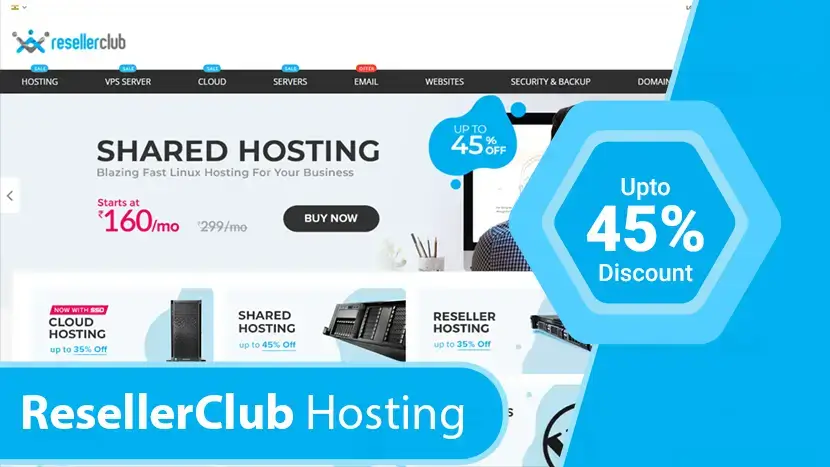
ResellerClub has affordable plans for entrepreneurs who want to build reseller hosting businesses. Despite this focus, anyone can sign up for ResellerClub’s wide range of packages which includes shared hosting.
Get a discount of up to 50% on your ResellerClub hosting when you click any of the special links in this review.
Features
- FREE domain registration
- FREE SSL Certificate
- FREE email address
- FREE 1-Click Installer
- Free Website Migrations
- Lightning Fast Websites (Super-quick page loads)
- Free cPanel (Linux Web Hosting Management simplified)
- FREE 24/7 support
- 30-day money back guarantee
Pros & Cons of ResellerClub
So, is hosting from iPower any good?
Pros
- Money-back guarantee with most products.
- Professional, live support with all tiers of service.
- All plans are built for reselling.
- Prices are competitive for its shared, reseller, and VPS plans.
- In-house datacenters with top-notch security.
Cons
- Limited feature set.
- Some features require signing up to see.
- Secure sockets layer (SSL) certificates cost extra.
- Windows hosting plans are fairly limited.
- Dedicated servers are expensive.
Don’t just take our word for it. ResellerClub scores 4.5 out of 5 stars overall, based on real reviews from over 70 actual customers.
Is ResellerClub Right for You?
Looking for something specific? Jump to our most popular sections:
1. Expert Review : read our thorough analysis by hosting expert, David Delony.
2. Customer Reviews : see what ResellerClub customers have to say.
3. Hosting Plans : compare ResellerClub hosting plans and prices.
4. FAQs : find the answers to the most asked questions about ResellerClub
ResellerClub is a web hosting provider based in India. As the name suggests, its focus is on reseller hosting.
Below, we take a closer look at its white-label reseller plans along with shared, VPS, and other services.
FAQs - ResellerClub Web Hosting
1. Where are ResellerClub’s data centers?
Answer : ResellerClub offers data centers in their native India plus the US, the UK, Turkey, and Hong Kong. The US servers are located in a Data Foundry datacenter in Austin, Texas. The company doesn’t specify exactly where their other data centers are located.
2. Is ResellerClub’s version of cPanel stock or custom?
Answer : The cPanel control panel is a tool that allows you to manage everything related to your web hosting account, including account/billing management, checking on your resource allocation and use, spinning up new email accounts, transferring website files, and more. Some hosts customize the cPanel for their customers, but ResellerHost includes the stock version in its hosting plans.
3. What security features does Reseller Club offer?
Answer : On their shared plans, they offer hotlink protection, “leech protection,” and ClamAV antivirus. In addition to hosting websites on servers located in datacenters protected against human and elemental threats, ResellerHost offers automatic data backup tools, malware detection, and removal tools, and SSL certificates to protect your data transfers to/from your visitors.
4. Which ResellerClub plans are not included in the money-back guarantee?
Answer : There are no money-back guarantees on dedicated servers. All other types of hosting plans come with a 30-day money back guarantee.
5. Do any ResellerClub plans come with a free domain?
Answer : Unlike many other web hosting providers, ResellerClub doesn’t include free domain names with its hosting packages.
6. What are the types of web hosting?
Answer : This answer will be different for everyone. It depends on the type of website you have, the resources you need, your budget, and traffic.We gave our top recommendation for each category in this guide, so that’s the best place for you to start your search.Once you know what you need, you can narrow your options. To figure out what category you fall in, here’s a quick recap of the different hosting types.
Alternatives - Web Hosting Providers
If you want to explore more web hosting plans, here is some web hosting services provider companies as below:
Read More : You can explore here 30+ Best Web Hosting and Domain name Providers 2023
Video - Best Web Hosting For Small Business
Affordable Website Hosting for your domainIf you found this article helpful, we encourage you to share it on your social media platforms—because sharing is caring! For more information about article submissions on our website, feel free to reach out to us via email.
Send an emailWritten by RGB Web Tech
Latest Technology Trends
Latest technology trends shaping the future, including AI advancements, blockchain innovation, 5G connectivity, IoT integration, and sustainable tech solutions. Explore breakthroughs in quantum computing, cybersecurity, augmented reality, and edge computing. Stay ahead with insights into transformative technologies driving innovation across industries and revolutionizing how we live, work, and connect.
iPage Web Hosting Review
Last updated on January 19, 2025 by RGB Web Tech
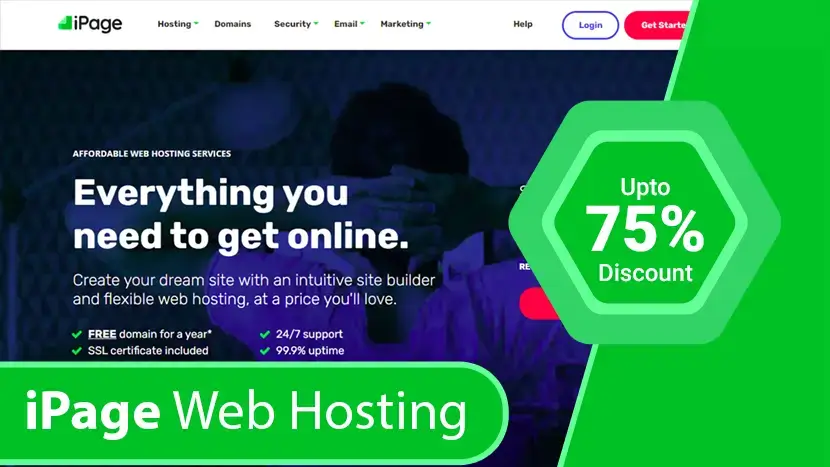
iPage is a full-service domain and web hosting provider targeting smaller businesses that want to jump into the e-commerce arena. It is owned by Endurance International Group, a conglomerate that owns top internet firms like Bluehost, HostGator, and Hostinger.
In addition to offering users unlimited disk space, a free domain name, and an unlimited number of email addresses, iPage has numerous features that help you quickly and easily develop your site. You can choose from hundreds of pre-built website templates and themes. You can opt to use their mobile-optimized website builder.
Another feature appealing to small business owners is the ability to quickly implement e-commerce add-ons, such as shopping carts and PayPal integration. iPage integrates well with any of the commonly used Content Management Systems (CMS), such as WordPress, Drupal, and Magento.
Contacting iPage’s customer service team is easy using their online ticketing system or 24/7 chat and phone availability. If you’re not satisfied with the services you receive, iPage offers a 30-day money-back guarantee.
Featured Included With iPage Hosting Plan
iPage web hosting contains many features that set the hosting provider apart from competitors. Below is an outline
- Free domain name
- Unlimited Emails
- Unlimited disk space
- 100% powered by wind energy
- Free site-building tools including templates
- Daily malware and spam scans
- Scalable bandwidth
- Unlimited domains
- Unlimited MySQL databases.
- Easy installation of apps such as b2evolution and WordPress.
- 99.99% uptime guarantee.
What Are the Pros and Cons of iPage?
So is web hosting from iPage any good?
Pros
- Really cheap pricing.
- Host unlimited sites on your one account.
- 30-day money-back guarantee.
- Instant activation of your account once it’s paid for and registered.
- Unlimited storage, bandwidth, and MySQL databases.
- Unlimited domains.
- Free site building tools to help even the newest of members.
- Free shopping cart and online store.
- 99.9% uptime guarantee.
Cons
- After the initial term, the renewal price is higher than that of many competitors.
- Statistics aren’t broken down into individual sites.
- When you log in, sometimes there is upselling.
- Domain price is higher than usual after the first year.
- Site building functionality is limited unless you upgrade to one of the more expensive plans.
How Does iPage Keep Your Site Secure?
Security is one of the biggest considerations for your business when choosing a hosting provider. Below is a list of some of the security features offered by iPage.
- 24/7 monitoring so problems can be detected and fixed fast.
- Nightly backups and restores.
- Access to website error logs.
- Power supply backups.
- State of the art encryption.
- Firewall
- Human monitoring of threats
FAQs - iPage Web Hosting
1. Why should I choose iPage over other web hosts?
Answer : iPage is reputable for operating eco-friendly data centers that use 100% wind energy and their award-winning 24/7 customer support team. These are two of the most compelling reasons to make them your preferred web host of choice.
2. What hosting packages does iPage offer?
Answer : Currently, iPage only offers shared, VPS, dedicated, and WordPress hosting services. There are variously-priced plans to choose from in each category, allowing subscribers to upgrade servers as their websites grow.
3. Does iPage have a refund policy?
Answer : iPage offers a 30-day risk-free trial period that allows you to cancel your subscription and claim a full refund within the first month after signing up. For cancellations done after the trial period, you’ll only get a refund for the number of months you didn’t use.For example, if you subscribed for a whole year and only hosted your website at iPage for 2 months, you’ll get a refund only for the 10 months you didn’t use it. Keep in mind, though, that there will be an additional deduction from the refund if you registered for a free domain.To cancel your account, you will need to get in touch with iPage via live chat or phone. You are responsible for all fees and charges up until your cancellation is effective (unless you are still within the 30-day period where iPage offers a money-back guarantee)Once your cancellation is effective, all of your existing content will be deleted. Be sure to have backups for everything before canceling!
4. Which control panel does iPage provide?
Answer : iPage offers a customized version of cPanel referred to as vDeck. This control panel is very flexible, intuitive and shares many similarities with cPanel.The upsides to using the vDeck Control Panel include a consistent user interface (as well as the ability to customize your UI with custom themes), fully extensible using supported modules, and features that make it easier to manage multiple websites simultaneously.Though it has a steeper learning curve than cPanel, vDeck is a great option for the more professional website owner, such as a business owner.
5. Is it possible to transfer my existing website to iPage?
Answer : Fortunately, iPage not only offers detailed tutorials on how to move an existing domain along with actual website files to their servers, but they also have experts who can help you with the website transfer process – however at a small fee.
6. How long is the billing cycle when using iPage web hosting services?
Answer : When it comes to purchasing iPage web hosting services, you can either choose the monthly, annual, biannual, or 3-year billing cycle. Upfront payments for 1, 2, or 3 years offer the biggest discounts compared to the monthly subscription.
7. How do I pay for iPage Web Hosting?
Answer : iPage is a solid entry-level web host that offers affordable web hosting. Good alternatives to iPage include Bluehost, Hostinger, InMotion, and A2 Hosting.
8. Does iPage support PHP?
Answer : iPage lets you run CGI scripts written in Perl, PHP, and shell scripts. This means that you can add interactive and dynamic content to your Web page. For example, you can add a WWWBoard to let your users interact, run a poll or track your visitors’ habits.
9. Does iPage use cPanel?
Answer : iPage does not support the cPanel control panel software. Instead, customers are given the popular vDeck software as a method to manage their accounts and other website services. vDeck is a popular competitor to cPanel and some users prefer to use it over rivals control panels.
10. Does iPage support WordPress?
Answer : iPage provides everything you need to run the WordPress content management system (CMS). At the time of writing, the company provides a free domain name along with unlimited storage and unlimited bandwidth to customers who signup for their WP Starter and WP Essential accounts.
11. What are the types of web hosting?
Answer : This answer will be different for everyone. It depends on the type of website you have, the resources you need, your budget, and traffic.We gave our top recommendation for each category in this guide, so that’s the best place for you to start your search.Once you know what you need, you can narrow your options. To figure out what category you fall in, here’s a quick recap of the different hosting types.
Alternatives - Web Hosting Providers
If you want to explore more web hosting plans, here is some web hosting services provider companies as below:
Read More : You can explore here 30+ Best Web Hosting and Domain name Providers 2023
Video - Best Web Hosting For Small Business
Affordable Website Hosting for your domainIf you found this article helpful, we encourage you to share it on your social media platforms—because sharing is caring! For more information about article submissions on our website, feel free to reach out to us via email.
Send an emailWritten by RGB Web Tech
Latest Technology Trends
Latest technology trends shaping the future, including AI advancements, blockchain innovation, 5G connectivity, IoT integration, and sustainable tech solutions. Explore breakthroughs in quantum computing, cybersecurity, augmented reality, and edge computing. Stay ahead with insights into transformative technologies driving innovation across industries and revolutionizing how we live, work, and connect.
DreamHost Web Hosting Review
Last updated on January 19, 2025 by RGB Web Tech
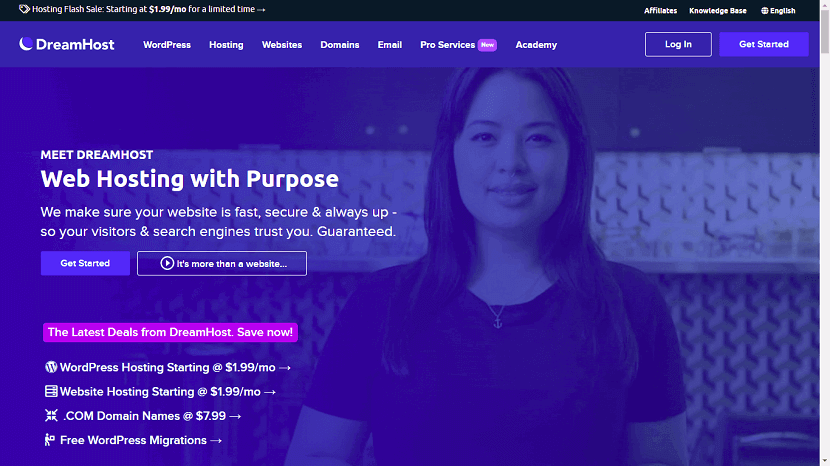
Dreamhost prides itself on being an award-winning WordPress host. Considering that Dreamhost hosts over 1.5 million sites for 400,000+ members and they’re one of only four web hosts that WordPress itself endorses, they have good reason to be proud.
Their unique relationship with WordPress, thanks to over 750,000 one-click installations, should put Dreamhost on your hosting shortlist if you’re starting a small site.
If you want to move beyond blogging, Dreamhost has features that will appeal to developers. They can launch cloud servers in 30 seconds and they support apps like Ruby on Rails, MongoDB, and Redis.
Dreamhost is also an OpenStack Foundation Gold Member. Their commitment to Open Source comes in the form of financial backing, coding contributions, and community leadership.
DreamHost Hosting Plan Features
- 100% uptime guarantee for all plans.
- SSDs (solid-state drives) on shared and VPS plans for increased speed and reliability.
- Choose unlimited domain names from over 275 extensions.
- 24/7/365 support.
- Unlimited bandwidth.
- Unlimited storage of data.
- Unlimited number of email addresses.
- Cloud storage for easier access and security.
- 1-click install for popular web apps like WordPress, Joomla! and others.
- Over 750,000 WordPress installations.
- Easy to use proprietary control panel.
- Free SSL Certificate
What Are the Pros and Cons of Dreamhost?
Pros
- 97-day money-back guarantee.
- 100% uptime guarantee.
- Unlimited data storage and bandwidth.
- Unlimited sites can be hosted on the same account.
- Unlimited MySQL databases.
- Free Domain with Whois Privacy.
- Unlimited sub-domains.
- One-click installation of software.
- “Remixer” website builder is included for free with our shared hosting plans. It would have to be added as a separate service on any other hosting plan.
- Outstanding 24/7/365 customer support.
- Supports most scripts including CGI, Perl, PHP 7, and Python.
Cons
- Some hosting features within the dashboard cost extra.
- Although it’s free on shared plans, the “Remixer” website builder must be added as a separate service on any other hosting plan.
- Call-backs from support staff cost extra on some plans.
- Costs aren’t as low as many competitors.
- The control panel can be hard to navigate due to having too many options.
- Dreamhost’s site doesn’t have all the answers that are freely available on the websites of other hosting providers.
What Makes DreamHost Stand Out?
Dreamhost is built for WordPress. They have been hosting WordPress websites and blogs for 20 years now providing services for over 1.5 million websites. DreamHost offers aspiring website owners a great starting place. Their shared hosting has a user-friendly interface and flexible options to fit a beginner’s needs. They offer round-the-clock support, regular updates, and valuable resources.
Optimized for performance and preconfigured for easy maintenance, DreamHost’s services ensure that every website is up and running fast and are specially designed for ideal WordPress operations. DreamHost offers a variety of platform-specific packages that make managing a WordPress site stress-free.
Dreamhost is an employee-owned company that focuses on the unique need of its users to find success online. DreamHost jump started in their green hosting journey as they make a conscious effort to reduce their impact on the environment with optimized facilities and policies that put respect for natural resources at the core of what we do.
Does DreamHost Handle Site Backups?
DreamPress, their managed WordPress hosting solution, makes it easy to protect and restore your site with automated and on-demand backups. DreamHost helps you make changes with confidence as they automatically create a daily backup of your site, and you can also create an additional manual backup once per day.
DreamHost stores backups for up to two weeks (automatic or manual). If needed, you can restore a backup within your panel. DreamHost offers a regular, reliable backup to protect your website investment from unexpected disasters. You can get additional ‘Backup & Restore’ features for free with any of their DreamPress plans.
How Is DreamHost’s Help and Support?
Although support is offered 24/7/365, you can’t actually ring the DreamHost support team. However, for a fee, they offer to ring you.
Other customer support options include:
- Live chat (mainly available when there are not many support staff handling the tickets). Chat is a permanent option for customers who pay a monthly call-back fee.
- An active forum.
- Support via Twitter.
- Many of the team are WordPress experts for people needing that specific knowledge.
Frequently Asked Questions About DreamHost
1. What payment options does DreamHost offer?
Answer : DreamHost accepts a variety of payment options through your panel: PayPal, Credit/Debit Card (Visa, MasterCard, American Express, Discover, and Diners Club), Checking Account, Check or Money Order, Gift Certificate.
2. What are DreamHost nameservers?
Answer : To use your domain name (not registered at DreamHost) you need to point it to their name servers. You need to change your name servers at your domain name registrar to ns1.dreamhost.com (64.90.62.230) ns2.dreamhost.com (208.97.182.10) ns3.dreamhost.com (66.33.205.230)
3. How can I contact DreamHost?
Answer : There are several ways to contact DreamHost if you need support. Email (support tickets), phone (callbacks available for a nominal monthly fee) and live chat. What languages do DreamHost support staff speak? Their customer service is only provided in English.
4. Where are DreamHost servers located?
Answer : Their headquarters and data center is located in Los Angeles, California, in the United States.
5. What is DreamHost’s cheapest hosting plan?
Answer : Their cheapest plan is 20.00. DreamHost offers a 97 days money guarantee. In other words. You get a refund if you decide to cancel your hosting with DreamHost within the first 97 days.
6. Can I register domains with DreamHost?
Answer : DreamHost lets you register domain names. Whois privacy is also available for a yearly cost. You also get one free domain name registration for one year with all of their hosting plans.
7. How do I install WordPress on DreamHost?
Answer : DreamHost offers managed WordPress hosting, called DreamPress. However, WP can be easily installed on any hosting plan using their built-in WordPress “one-click installation” which can be accessed from within your control panel.
8. Which DreamHost plan is best for WordPress?
Answer : DreamHost offers tailored WP hosting, their managed platform is made for hosting WordPress websites. DreamPress is optimized for WordPress sites and blogs.
9. What are the types of web hosting?
Answer : This answer will be different for everyone. It depends on the type of website you have, the resources you need, your budget, and traffic. We gave our top recommendation for each category in this guide, so that’s the best place for you to start your search. Once you know what you need, you can narrow your options. To figure out what category you fall in, here’s a quick recap of the different hosting types.
Alternatives - Web Hosting Providers
If you want to explore more web hosting plans, here is some web hosting services provider companies as below:
Read More : You can explore here 30+ Best Web Hosting and Domain name Providers 2023
Video - Best Web Hosting For Small Business
Affordable Website Hosting for your domainIf you found this article helpful, we encourage you to share it on your social media platforms—because sharing is caring! For more information about article submissions on our website, feel free to reach out to us via email.
Send an emailWritten by RGB Web Tech
Latest Technology Trends
Latest technology trends shaping the future, including AI advancements, blockchain innovation, 5G connectivity, IoT integration, and sustainable tech solutions. Explore breakthroughs in quantum computing, cybersecurity, augmented reality, and edge computing. Stay ahead with insights into transformative technologies driving innovation across industries and revolutionizing how we live, work, and connect.
A2 Hosting Web Hosting Review
Last updated on January 19, 2025 by RGB Web Tech
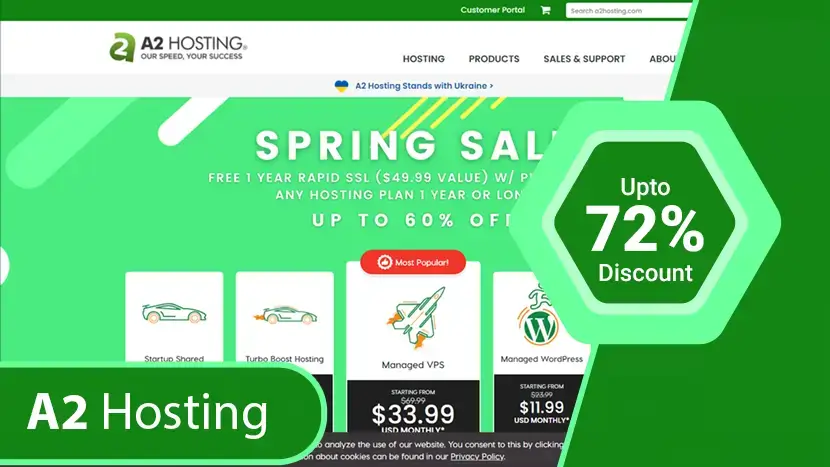
A2 Hosting offers plenty of diversity in the types of plans and the various inclusions available. Plans can be used for a huge variety of purposes and you can manage your own site or have the A2H gurus do it for you. It’s already optimized for WordPress users when you open your account.
While you may pay a bit more for hosting and the additional benefits and features, you’re getting high-quality, premium hosting that has 99.9% uptime and genuine 24/7/365 support from people on the phone if you have problems of any sort.
Features
- Unlimited SSD Space & Transfer
- Free & Easy Site Migration
- Free Automatic Backups
- Anytime Money Back Guarantee
- Speed Optimized WordPress
- 99.9% Uptime Commitment
- 24/7/365 Guru Crew Support
- Free SSL Certificate
- Up To 20X Faster Web Hosting
What Are the Pros and Cons of A2 Hosting?
There are lots of pros and cons to weigh up when considering A2 Hosting as your new web host. So, is it the right choice for your hosting needs? Before you decide, consider the pros and cons.
Pros
- 24/7/365 high-quality, English-speaking, expert support staff available via phone, email, and live chat.
- Choose a server location from Europe, the USA, or Asia.
- Unmanaged and managed plans with plenty of options.
- Free SSDs included.
- Shopper Approved reviews reveal that 96% of the reviews posted on their site certainly would suggest friends and family use A2H.
- Ideal for users of WordPress and loads pages six times faster.
- High-speed load performance. Compared to several hosting providers, A2 Hosting performs at high speed. There may sometimes be unresponsive pages, but they don’t happen often. Lags and load delays are also present but they’re almost unnoticeable.
- Reseller hosting options for hosting startups and expert website designers.
- Installation of programs can be done automatically, quickly and securely.
- 10 GB Quadruple redundancy network offers good peace of mind.
- A2H is 100% carbon neutral.
Cons
- Mod_perl, Plexum, HTMLDoc, PDFLib, MS SQL or ColdFusion are not supported.
- They only have two data centers. If your target audience is located in neither North America nor Europe, you would want to find and choose another nearer service provider.
- Limited hosting plans for Windows hosting.
- Slightly more expensive than other hosting plans (but prices are still competitive)
FAQs - A2 Hosting Review1. Who owns A2 Hosting?
Answer : A2 Hosting is a privately held company and its headquarters is in Ann Arbor, Michigan, in the United States. A2H was founded by Bryan Muthig in 2003 and he is also their current CEO.
2. What are A2 Hosting name servers?
Answer : If you already have a domain with a different registrar you must change the name server (DNS) settings for the domain to point to A2 Hosting. At your domain registrar use ns1.a2hosting.com, ns2.a2hosting.com, ns3.a2hosting.com, and ns4.a2hosting.com.
3. What kind of support do I get?
Answer : A2 Hosting offers 24/7/365 support via phone, email, and live chat. They keep their 24/7 promise. If you ring them at 4 am in the morning someone will actually answer the phone (you may be asked to leave a message if they’re inundated with calls but you will get a call back as quickly as possible).
4. What languages does A2 Hosting support speak?
Answer : All of the A2 Hosting support staff speak fluent English.
5. Where are A2 Hosting servers located?
Answer :A2 Hosting owns all of its web servers and monitors them 24/7/365. Their primary data center is located in Michigan (United States), with additional data centers in Amsterdam (Netherlands) and Singapore.
6. What is A2 Hosting cheapest hosting plan?
Answer : A2 Hosting cheapest shared hosting plan is 5.00. A2 Hosting offers a 30-day money guarantee.If A2H isn’t ideal for your needs, you’ll receive a full refund within 30 days or a pro-rata refund on the unused services if you cancel after 30 days.
7. What extras do I get with A2 Hosting?
Answer : When buying hosting with A2 Hosting you get a free Website Magazine subscription. You also get $50 Bing/Yahoo Ad Credits. Plus you get your site listed in Google in 24 hours with Attracta, and you get a free iContact email marketing trial. Last but not least you get discounts on purchasing WordPress themes from TeslaThemes.
8. Can I install WordPress?
Answer : A2 Hosting gives you the option of either having WordPress auto-installed and configured with your order. Once you have purchased your hosting account, you’ll receive an email with the login information. The other option is to use the Softaculous 1-click WordPress installer that comes with your cPanel control panel.
9. Will A2 Hosting help me migrate my website?
Answer : A2 Hosting offers free site migration. If you use cPanel with your current host, they will migrate your site for you, for free. If your current site is not on cPanel you should contact their support team for website transfer assistance.
10. Extra Features from A2 Hosting
Answer : You receive some interesting freebies which are worth noting. These are:1. A free Website magazine subscription.2. $50 Bing/Yahoo Ad Credits,3. Your site listed in Google in 24 hours with AttractaAdditionally, you get a free iContact email marketing trial. You get discounts on WordPress themes from TeslaThemes.
11. Green Web Hosting, Strong Infrastructure, and Backups
Answer : Because A2 Hosting doesn’t want to be seen as “just another hosting company,” you also gain access to their green hosting, a quadruple redundant network, and regular backup services.A2 Hosting also offers additional features to add further value to their hosting plans, including increased support and several support options.
12. What are the types of web hosting?
Answer : This answer will be different for everyone. It depends on the type of website you have, the resources you need, your budget, and traffic. We gave our top recommendation for each category in this guide, so that’s the best place for you to start your search.Once you know what you need, you can narrow your options. To figure out what category you fall in, here’s a quick recap of the different hosting types.
1. Who owns A2 Hosting?
Answer : A2 Hosting is a privately held company and its headquarters is in Ann Arbor, Michigan, in the United States. A2H was founded by Bryan Muthig in 2003 and he is also their current CEO.
2. What are A2 Hosting name servers?
Answer : If you already have a domain with a different registrar you must change the name server (DNS) settings for the domain to point to A2 Hosting. At your domain registrar use ns1.a2hosting.com, ns2.a2hosting.com, ns3.a2hosting.com, and ns4.a2hosting.com.
3. What kind of support do I get?
Answer : A2 Hosting offers 24/7/365 support via phone, email, and live chat. They keep their 24/7 promise. If you ring them at 4 am in the morning someone will actually answer the phone (you may be asked to leave a message if they’re inundated with calls but you will get a call back as quickly as possible).
4. What languages does A2 Hosting support speak?
Answer : All of the A2 Hosting support staff speak fluent English.
5. Where are A2 Hosting servers located?
Answer :A2 Hosting owns all of its web servers and monitors them 24/7/365. Their primary data center is located in Michigan (United States), with additional data centers in Amsterdam (Netherlands) and Singapore.
6. What is A2 Hosting cheapest hosting plan?
Answer : A2 Hosting cheapest shared hosting plan is 5.00. A2 Hosting offers a 30-day money guarantee.If A2H isn’t ideal for your needs, you’ll receive a full refund within 30 days or a pro-rata refund on the unused services if you cancel after 30 days.
7. What extras do I get with A2 Hosting?
Answer : When buying hosting with A2 Hosting you get a free Website Magazine subscription. You also get $50 Bing/Yahoo Ad Credits. Plus you get your site listed in Google in 24 hours with Attracta, and you get a free iContact email marketing trial. Last but not least you get discounts on purchasing WordPress themes from TeslaThemes.
8. Can I install WordPress?
Answer : A2 Hosting gives you the option of either having WordPress auto-installed and configured with your order. Once you have purchased your hosting account, you’ll receive an email with the login information. The other option is to use the Softaculous 1-click WordPress installer that comes with your cPanel control panel.
9. Will A2 Hosting help me migrate my website?
Answer : A2 Hosting offers free site migration. If you use cPanel with your current host, they will migrate your site for you, for free. If your current site is not on cPanel you should contact their support team for website transfer assistance.
10. Extra Features from A2 Hosting
Answer : You receive some interesting freebies which are worth noting. These are:1. A free Website magazine subscription.2. $50 Bing/Yahoo Ad Credits,3. Your site listed in Google in 24 hours with AttractaAdditionally, you get a free iContact email marketing trial. You get discounts on WordPress themes from TeslaThemes.
11. Green Web Hosting, Strong Infrastructure, and Backups
Answer : Because A2 Hosting doesn’t want to be seen as “just another hosting company,” you also gain access to their green hosting, a quadruple redundant network, and regular backup services.A2 Hosting also offers additional features to add further value to their hosting plans, including increased support and several support options.
12. What are the types of web hosting?
Answer : This answer will be different for everyone. It depends on the type of website you have, the resources you need, your budget, and traffic. We gave our top recommendation for each category in this guide, so that’s the best place for you to start your search.Once you know what you need, you can narrow your options. To figure out what category you fall in, here’s a quick recap of the different hosting types.
Alternatives - Web Hosting Providers
If you want to explore more web hosting plans, here is some web hosting services provider companies as below:
Read More : You can explore here 30+ Best Web Hosting and Domain name Providers 2023
Video - Best Web Hosting For Small Business
Affordable Website Hosting for your domainIf you found this article helpful, we encourage you to share it on your social media platforms—because sharing is caring! For more information about article submissions on our website, feel free to reach out to us via email.
Send an emailWritten by RGB Web Tech
Latest Technology Trends
Latest technology trends shaping the future, including AI advancements, blockchain innovation, 5G connectivity, IoT integration, and sustainable tech solutions. Explore breakthroughs in quantum computing, cybersecurity, augmented reality, and edge computing. Stay ahead with insights into transformative technologies driving innovation across industries and revolutionizing how we live, work, and connect.
HostPapa Web Hosting Review - A Quick Overview
Last updated on January 19, 2025 by RGB Web Tech
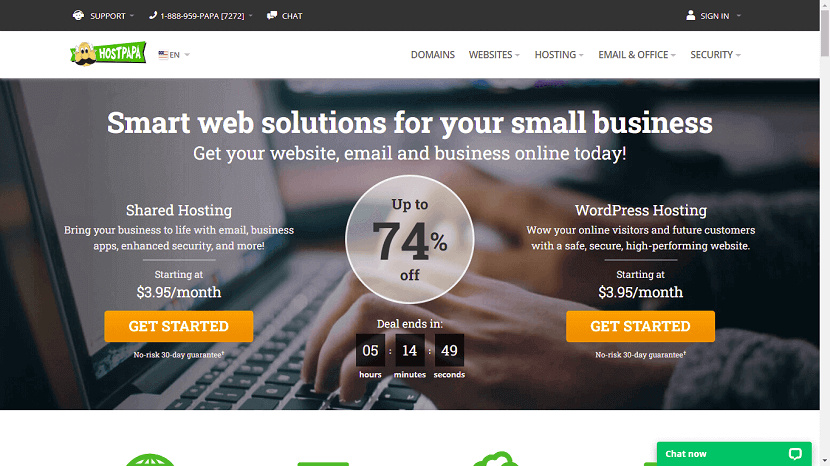
Quality hosting requires speed, security, and a solid interface. HostPapa does it right by providing an incredible customer service/technical support team, numerous resources for completing your own hosting homework, and the security and uptime guarantee that you need.
HostPapa has a strong set of shared, WordPress, reseller, and VPS hosting plans for every sized business. That’s why we want to take a deeper dive into HostPapa’s infrastructure. You’ll learn about what the company has to offer, how it keeps its plan prices low, and how to navigate its dashboard. Let’s get to it.
Feature
- Free Domain Registration
- Free Website Transfer
- Free Cloudfare CDN
- Free one-on-one Training Session
- Free let's Encrypt SSL
- Softaculous with 400+ FREE Apps
- Easy to Use cPanel ( Control Panel )
- Starter Website Builder
- 1-click installs for WordPress, Magento, Drupal, Joomla etc.
- CloudLinux Servers
- Unmetered bandwidth
- 27/7 Support
- 99.9% Uptime
- 30 Day Money Back Guarantee - No risk*
What are the Pros and Cons of HostPapa?
Here’s a wrap on the positives of HostPapa plus a few potential cons.
Pros
- Highly Secured Data Centers.
- 24-Hour Support and 99.9% uptime guarantee.
- Higher-end plans have easy integration with Hostpapa’s online store builder and applications like Facebook.
- Support offered in multiple languages and access to live chat.
- Hostpapa’s cPanel is easy to navigate with a search bar at the top so you can quickly find different functions.
Cons
- You must pay upfront for the hosting package (and site builder). This could be expensive for small businesses.
- It’s not a standalone product so you’ll have to pay for extra features.
How Does HostPapa Keep Your Site Secure?
HostPapa provides its clients with the strongest levels of data encryption available. These security features are packed with:
- State-of-the-art data encryption : HostPapa SSL uses up to 256-bit data encryption to convert data into virtually impenetrable code that is safe from hackers and identity thieves.
- Your SSL certificate in minutes : When you need an SSL certificate, you need it fast. HostPapa will validate your domain registration, and your GlobalSign Secure SSL certificate can be issued within minutes.+
- Over 99% browser compatibility : A GlobalSign SSL certificate is compatible with over 99% of web browsers, ensuring encryption will work for just about every browser used to view your site.
- Automated installation : If your website is hosted with HostPapa, your new SSL certificate will be automatically installed after you complete the validation process.
Frequently Asked Questions About HostPapa
1. Which hosting plan should I choose: Starter, Business, or Business Pro?
The plan you choose will depend on your specific hosting needs. All plans offer unlimited bandwidth.
The Starter plan only includes hosting for two websites, so you won’t want to choose that plan if you’re going to have more than two websites.
The basic Business plan allows you to host unlimited domains and have unlimited email accounts.
The Business Pro plan has all the same features, plus a few advanced ones. It also includes features like domain privacy, SiteLock Website Protection, SSL certificate, and Automated Website Backup at no extra charge.
2. Can I choose month-to-month billing?
No, you must pay for a minimum of 12 months.
3. What other billing cycles do they offer?
You can choose to pay for 12 months, 24 months, or 36 months at a time. The longer the billing cycle you choose, the greater your discount, which will be applied to your monthly rate.
4. What types of payment do they accept?
You can pay via credit card (Visa, Mastercard, Discover) or PayPal.
5. Is there a money-back guarantee?
Yes, HostPapa offers a 30-day money-back guarantee.Within the first 30 days of signing up, you can cancel and get a refund for any hosting fees.
However, domain registration fees are not refundable.
After 30 days, you can cancel anytime, but you won’t receive a refund if you’ve paid ahead.
6. What is domain privacy?
Whenever anyone registers a domain, their information is publicly displayed in the WHOIS domain registry database. This information includes your name, address, phone number, and email address.When you purchase domain privacy for a yearly fee, your domain registrar’s company information will be displayed instead of your own personal information.
What are the types of web hosting?
This answer will be different for everyone. It depends on the type of website you have, the resources you need, your budget, and traffic.
We gave our top recommendation for each category in this guide, so that’s the best place for you to start your search.
Once you know what you need, you can narrow your options. To figure out what category you fall in, here’s a quick recap of the different hosting types and who they are for:
- Shared Hosting — Shared hosting is the most cost-effective plan for entry-level websites.
- VPS Hosting — VPS hosting is for websites that have outgrown shared hosting.
- WordPress Hosting — WordPress hosting optimized for WordPress sites.
- Dedicated Hosting — Dedicated hosting is Enterprise-level servers for large websites.
- Cloud Hosting — Cloud hosting is best for websites that are growing rapidly.
- Reseller Hosting — Reseller hosting is for agencies, web developers, and web designers.
- Managed Hosting — Managed hosting is an IT hosting model in which the client leases servers or cloud computing resources.
- Colocation Hosting — Colocation hosting is where you rent space for your IT hardware at a 3rd party provider’s data center facility.
- Self Service Hosting — Self hosting is a form of running your own website or application by setting up a server and network yourself.
- Cluster Hosting — A cluster hosting is a host that is configured to take over the role of another host server within a cluster.
Alternatives - Web Hosting Providers
If you want to explore more web hosting plans, here is some web hosting services provider companies as below:
Read More : You can explore here 30+ Best Web Hosting and Domain name Providers 2023
Video - Best Web Hosting For Small Business
Affordable Website Hosting for your domainIf you found this article helpful, we encourage you to share it on your social media platforms—because sharing is caring! For more information about article submissions on our website, feel free to reach out to us via email.
Send an emailWritten by RGB Web Tech
Latest Technology Trends
Latest technology trends shaping the future, including AI advancements, blockchain innovation, 5G connectivity, IoT integration, and sustainable tech solutions. Explore breakthroughs in quantum computing, cybersecurity, augmented reality, and edge computing. Stay ahead with insights into transformative technologies driving innovation across industries and revolutionizing how we live, work, and connect.
InterServer Web Hosting Review - Features, Pros & Cons
Last updated on January 19, 2025 by RGB Web Tech
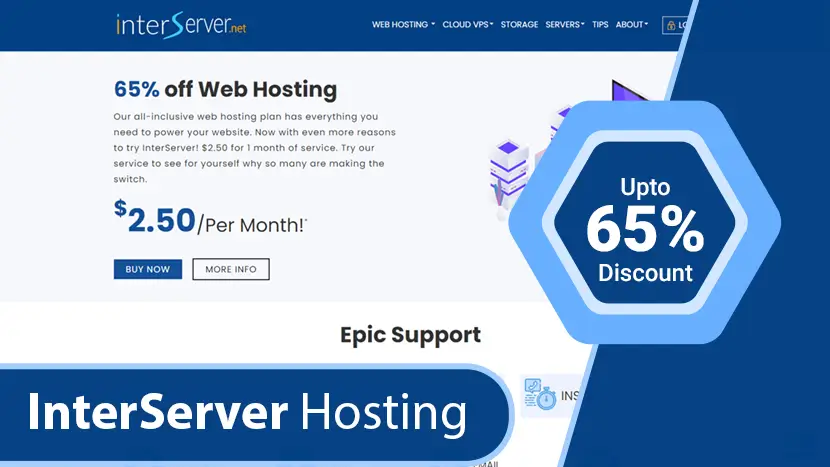
Namecheap is best known as a domain name registrar, but they also offer cheap web hosting. Before you sign up with them you should read our Namecheap hosting review and find out if their hosting is any good, or if they should stick with domain names. Visit Namecheap.com Most people know of Namecheap as a domain registration and management service, but they also offer web hosting services. Founded in 2000, Namecheap began by offering value-priced domains and excellent customer service. Today, they have over 3 million clients and manage over 11 million domains.
In addition to domains and full web hosting packages, Namecheap sells SSL certificates, privacy protection services, and more. Because Namecheap thinks that an Internet presence for all is a necessity, they provide affordable access to everything you need to run a website. Namecheap’s hosting plans offer fast, reliable service with a 100% uptime guarantee. If you need to build a new site, you can easily do so using one of Namecheap’s many site-building apps. If you have an existing website, Namecheap will move it for you for free. In addition to a solid knowledge base, you can consult if you need help, Namecheap offers 24/7 chat support.
Feature
- Unmetered bandwidth
- Free website builder
- Domain name and privacy protection
- Free automatic SSL installation
- Free Supersonic CDN
- 30-day money-back guarantee
- Free in <24 hours website migration
What are the Pros and Cons of Namecheap?
Is web hosting from Namecheap any good? There are lots of pros and cons to weigh up when considering buying hosting from Namecheap.
Pros
- A well-known brand that has been around for 20 years.
- Cheap domain names.
- Support is of good quality.
- Reliable hosting services.
- The design and interface are very user-friendly.
- Free and fast migration from other hosting providers.
- Backups on a daily basis.
- Choose the largest shared plan and backup twice per day and also weekly.
- Quick registration and setup process.
- Lots of TLDs available with varying extensions.
- No upsells when you sign up.
Cons
- Setting up SSL certificates is difficult and often needs help.
- Some aspects of the dashboard are hard to find.
- No phone support.
Frequently Asked Questions About Namecheap
1. How do I pay for Namecheap hosting?
Namecheap accepts American Express, Mastercard, Visa, PayPal, bitcoin and Dwolla.
2. How do I choose my data center location?
When you order shared or reseller hosting, you’ll see a drop-down list where you can select the location. Right now, there are two choices: UK or US. You can’t select a specific city. All VPS plans are provisioned from its US data centers in Atlanta, GA or Phoenix, AZ. All of its dedicated server plans are set up in Phoenix.
3. What is Supermicro server hardware?
On Namecheap’s dedicated server plans, you’ll notice it advertises Supermicro hardware. These servers are rack mounted units that are designed to offer exceptional uptime and low power draw, which can help them run cooler.
4. Will I get root access with my dedicated server?
Yes, if you select a self-managed. Root access is not available on fully managed dedicated hosting plans.
5. How long does it take to set up my hosting account?
If you buy shared or reseller hosting, it will be automatically activated, and available to use more or less instantly. VPS and dedicated plans are a little different. Namecheap says it may need to contact customers to verify their identity. If this happens, provide the information as quickly as possible to avoid delays. If Namecheap doesn’t need to verify you, it says dedicated hosting accounts will be provisioned the same day, with many being ready within 4 hours. VPS hosting will be activated automatically within 2 hours, unless you’ve ordered full management, which may add a couple of hours onto the setup time.
6. What is the Namecheap uptime guarantee?
Namecheap promises 100% uptime on shared hosting accounts, and most dedicated server accounts. If it fails to achieve this, you will receive a credit on your account.
7. Should I choose WhoisGuard?
WhoisGuard hides your personal information from the global Whois database. This option is only available on some types of domains, so you may not see it in your cart. WhoisGuard may help to prevent spam, and it makes it more difficult for people to figure out who owns a domain. If you plan to sell your domain name later, you may wish to leave your contact information visible. Additionally, businesses should not generally hide their contact information, as it can make them look shady.
8. Should I choose PremiumDNS?
PremiumDNS is a Namecheap service that guarantees 100% uptime for your DNS information. This essentially means that your website is guaranteed to resolve. Your DNS is served from 17 different locations around the world, and the service also includes DNS DDoS protection. In general, only business users need worry about PremiumDNS. It’s inexpensive, but unless your site is mission critical, it may be unnecessary. Consider how important DNS uptime is for your website before you subscribe.
9. What are the types of web hosting?
This answer will be different for everyone. It depends on the type of website you have, the resources you need, your budget, and traffic.
We gave our top recommendation for each category in this guide, so that’s the best place for you to start your search.
Once you know what you need, you can narrow your options. To figure out what category you fall in, here’s a quick recap of the different hosting types and who they are for:
- Shared Hosting — Shared hosting is the most cost-effective plan for entry-level websites.
- VPS Hosting — VPS hosting is for websites that have outgrown shared hosting.
- WordPress Hosting — WordPress hosting optimized for WordPress sites.
- Dedicated Hosting — Dedicated hosting is Enterprise-level servers for large websites.
- Cloud Hosting — Cloud hosting is best for websites that are growing rapidly.
- Reseller Hosting — Reseller hosting is for agencies, web developers, and web designers.
- Managed Hosting — Managed hosting is an IT hosting model in which the client leases servers or cloud computing resources.
- Colocation Hosting — Colocation hosting is where you rent space for your IT hardware at a 3rd party provider’s data center facility.
- Self Service Hosting — Self hosting is a form of running your own website or application by setting up a server and network yourself.
- Cluster Hosting — A cluster hosting is a host that is configured to take over the role of another host server within a cluster.
Alternatives - Web Hosting Providers
If you want to explore more web hosting plans, here is some web hosting services provider companies as below:
Read More : You can explore here 30+ Best Web Hosting and Domain name Providers 2023
Video - Best Web Hosting For Small Business
Affordable Website Hosting for your domainIf you found this article helpful, we encourage you to share it on your social media platforms—because sharing is caring! For more information about article submissions on our website, feel free to reach out to us via email.
Send an emailWritten by RGB Web Tech
Latest Technology Trends
Latest technology trends shaping the future, including AI advancements, blockchain innovation, 5G connectivity, IoT integration, and sustainable tech solutions. Explore breakthroughs in quantum computing, cybersecurity, augmented reality, and edge computing. Stay ahead with insights into transformative technologies driving innovation across industries and revolutionizing how we live, work, and connect.
Namecheap Web Hosting Review
Last updated on January 19, 2025 by RGB Web Tech
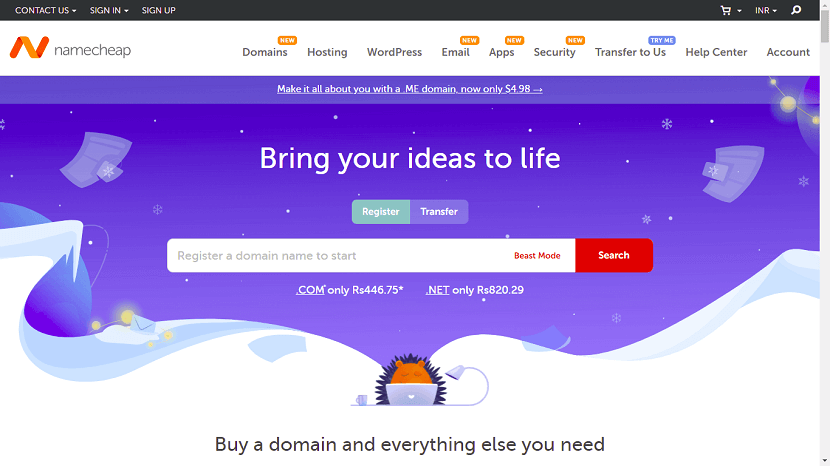
Namecheap is a leading domains, hosting and websites’ service company helping businesses worldwide to setup their online presence and reach their online success. Namecheap make it possible for anyone to create a winning web presence by providing easy domain name registration, affordable hosting plans, and all the best apps.
Namecheap will direct and point business owners to website security and privacy products from the most trusted brands around and their award-winning customer service team is available 24/7 with friendly advice to help you get your site up and running in no time.
Top Features
- Unmetered bandwidth
- Free website builder
- Domain name and privacy protection
- Free automatic SSL installation
- Free Supersonic CDN
- 30-day money-back guarantee
- Free in <24 hours website migration
Type of Web Hosting
To figure out what category you fall in, here’s a quick recap of the different hosting types and who they are for:
- Shared Hosting — Shared hosting is the most cost-effective plan for entry-level websites.
- VPS Hosting — VPS hosting is for websites that have outgrown shared hosting.
- WordPress Hosting — WordPress hosting optimized for WordPress sites.
- Dedicated Hosting — Dedicated hosting is Enterprise-level servers for large websites.
- Cloud Hosting — Cloud hosting is best for websites that are growing rapidly.
- Reseller Hosting — Reseller hosting is for agencies, web developers, and web designers.
- Managed Hosting — Managed hosting is an IT hosting model in which the client leases servers or cloud computing resources.
- Colocation Hosting — Colocation hosting is where you rent space for your IT hardware at a 3rd party provider’s data center facility.
- Self Service Hosting — Self hosting is a form of running your own website or application by setting up a server and network yourself.
- Cluster Hosting — A cluster hosting is a host that is configured to take over the role of another host server within a cluster.
Alternatives - Web Hosting Providers
If you want to explore more web hosting plans, here is some web hosting services provider companies as below:
Read More : You can explore here 30+ Best Web Hosting and Domain name Providers 2023
Video - Best Web Hosting For Small Business
Affordable Website Hosting for your domainIf you found this article helpful, we encourage you to share it on your social media platforms—because sharing is caring! For more information about article submissions on our website, feel free to reach out to us via email.
Send an emailWritten by RGB Web Tech
Latest Technology Trends
Latest technology trends shaping the future, including AI advancements, blockchain innovation, 5G connectivity, IoT integration, and sustainable tech solutions. Explore breakthroughs in quantum computing, cybersecurity, augmented reality, and edge computing. Stay ahead with insights into transformative technologies driving innovation across industries and revolutionizing how we live, work, and connect.
tsoHost Web Hosting Review
Last updated on January 19, 2025 by RGB Web Tech
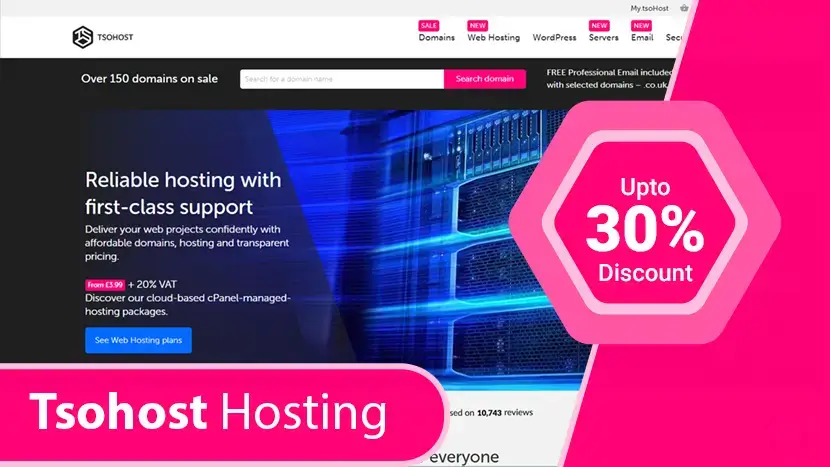
Tsohost was founded more than 15 years ago in the UK and they take pride in their aim to make web hosting simple, scalable and secure, and all at affordable prices. In 2009, they launched an innovative backup system which secures all customer data on a daily basis, making themselves pioneers in the industry. At present, they are considered to be one of the largest hosting providers in the country.
Features
- 16 vCPU
- 32 GB RAM
- 800 GBNVMe SSD Storage
- 3 Additional IPs
- Unlimited Bandwidth
- 1Basic migration
- 1eCommerce migration
- 99.9% Uptime SLA
Why choose Tsohost?
In online reviews, our customers wax lyrical about the speed of our web hosting solutions and the capability of our support team. Lip service is also paid to how flexible tsoHost’s hosting plans are, and how secure our solutions are. This is in no small part due to the fact that our main data center is based in the UK.
Fanfare is also made about the following nuggets of tsoHost’s web hosting services.
- Stellar Security: Your hosting solution is secured with our advanced firewalls and multiple enhanced levels of security.
- 30 day money-back guarantee: We’re sure you’ll love your hosting solution, which is why we’ll give your money back if you don’t.
- Superior customer service: You receive expert 24/7 support. All of our team goes through intensive training to ensure they’re at the top of the industry.
- We keep things simple: We know you’re busy running your business. That’s why we like to keep things simple – so you can focus on what matters.
- Built for performance: You can be sure to receive industry leading performance. Our data center ensures top performance thanks to its bespoke 150-meter dark fiber network ring, multi-homed Border Gateway Protocol network, and cooling infrastructure.
Frequently Asked Questions About TsoHost
Here are a few common questions asked about TsoHost.
1. Who owns TsoHost?
In short, TsoHost is owned by Paragon, which is owned by Host Europe Group (HEG) which is owned by GoDaddy. Here’s more detail:
- TsoHost is owned by Paragon Internet Group, Ltd.
- Paragon was acquired by Host Europe Group (HEG) in 2015, and now operates as a subsidiary of HEG.
- GoDaddy EMEA acquired HEG in December 2016 for $1.79 billion. (At the time of acquisition, HEG was owned by the international private equity firm Cinven, which acquired the business in August 2013.)
2. How do I choose between Linux and Windows, and what is TsoHost’s “Hybrid” mode?
- Linux : Linux is recommended if you’re using PHP-based applications. Common examples include Drupal, WordPress, Magento, Joomla, Yii, and CodeIgniter.
- Windows : Choose Windows if you will run ASP/.NET based software. Examples include Sitecore, DotNetNuke, Umbraco, and Kentico. Running PHP through Windows, while possible, is suboptimal.
- Hybrid : TsoHost’s Hybrid mode will enable you to run PHP and ASP simultaneously. Your PHP code will run through their Linux cluster. Your ASP code will run through their Windows cluster.
This means you can run PHP and ASP code on the same sites, and from a single dashboard. TsoHost adds: “The bias determines whether code other than PHP/ASP (i.e. raw HTML) is run through Windows or Linux.
3. How do I find out about status issues with TsoHost?
Visit their Status Center. In the left-hand margin you’ll see categories to search for current status of service. You will also find a list of incidents and announcements of any upcoming scheduled maintenance. To report an incident you can raise a new support ticket or call them at their U.K. number. If you’ve detected what you believe to be a security vulnerability, use the TsoHost Report Security Issue form.
4. Is TsoHost good?
In addition to reading reviews, here are some ways to determine this for yourself.
- Read customer reviews : The TsoHost website states that they have “an average customer rating of 4.9 out of 5 stars, based on a total of 678 reviews.” Browse the web for other sources of customer reviews.
- Browse the TsoHost site for testimonials from customers. If you are a small business owner, you may want to contact one or more individuals featured in the videos to get an updated (current, 2018) assessment from them of TsoHost’s performance.
- Consider your geographic location. Realize that TsoHost phone support operates on U.K. time. Does that work for you?
5. What are the types of web hosting?
This answer will be different for everyone. It depends on the type of website you have, the resources you need, your budget, and traffic.
We gave our top recommendation for each category in this guide, so that’s the best place for you to start your search.
Once you know what you need, you can narrow your options. To figure out what category you fall in, here’s a quick recap of the different hosting types and who they are for:
- Shared Hosting — Shared hosting is the most cost-effective plan for entry-level websites.
- VPS Hosting — VPS hosting is for websites that have outgrown shared hosting.
- WordPress Hosting — WordPress hosting optimized for WordPress sites.
- Dedicated Hosting — Dedicated hosting is Enterprise-level servers for large websites.
- Cloud Hosting — Cloud hosting is best for websites that are growing rapidly.
- Reseller Hosting — Reseller hosting is for agencies, web developers, and web designers.
- Managed Hosting — Managed hosting is an IT hosting model in which the client leases servers or cloud computing resources.
- Colocation Hosting — Colocation hosting is where you rent space for your IT hardware at a 3rd party provider’s data center facility.
- Self Service Hosting — Self hosting is a form of running your own website or application by setting up a server and network yourself.
- Cluster Hosting — A cluster hosting is a host that is configured to take over the role of another host server within a cluster.
Alternatives - Web Hosting Providers
If you want to explore more web hosting plans, here is some web hosting services provider companies as below:
Read More : You can explore here 30+ Best Web Hosting and Domain name Providers 2023
Video - Best Web Hosting For Small Business
Affordable Website Hosting for your domainIf you found this article helpful, we encourage you to share it on your social media platforms—because sharing is caring! For more information about article submissions on our website, feel free to reach out to us via email.
Send an emailWritten by RGB Web Tech
Latest Technology Trends
Latest technology trends shaping the future, including AI advancements, blockchain innovation, 5G connectivity, IoT integration, and sustainable tech solutions. Explore breakthroughs in quantum computing, cybersecurity, augmented reality, and edge computing. Stay ahead with insights into transformative technologies driving innovation across industries and revolutionizing how we live, work, and connect.
TurnKey Internet Web Hosting Review
Last updated on January 19, 2025 by RGB Web Tech
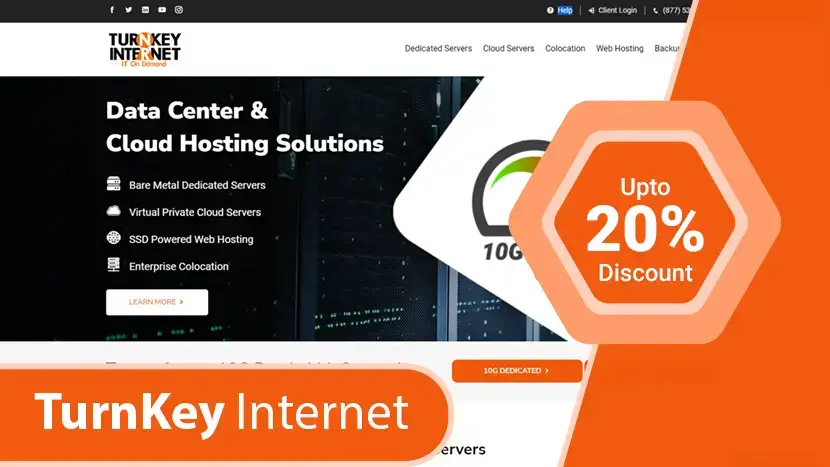
TurnKey Internet offers cloud hosting solutions that leverage state-of-the-art data centers and award-winning staff to take care of your business IT needs. They provide the servers, the network, the infrastructure, and the expert staff to ensure that you can focus on what you do best - running your business.
Features
- 2 x Intel Xeon X5650 CPUs @ 2.66 GHz
- 24 Cores (12 Physical + 12 Hyper-Threading)
- 240 GB SSD
- 64 GB RAM
- Gigabit Network Port
- 10 TB Bandwidth
- IPv4: 1 Usable Address (/30)
- IPv6: /64 Subnet
- RAID 0/1/5/10 Available
FAQs of TurnKey Internet
1. How much does TurnKey Internet cost?
TurnKey Internet offers plans from $2 to $30. The price depends on which type of hosting plan you choose. You can see the updated pricing table (updated weekly) below.
2. Which TurnKey Internet plan should I get?
My recommendation is to start with a cheaper plan. You can always upgrade later on. TurnKey Internet can help you with the migration to a more expensive plan. The increase in visitors many times takes longer than expected and you shouldn’t pay a lot of money until the need arises. Of course, your needs may vary, and you can consult with a hosting expert from TurnKey Internet here.
3. How good is TurnKey Internet’s customer support?
TurnKey Internet is not ranked as one of our top web hosts. But that can also be a result of TurnKey Internet being a small, under the radar, hosting provider. There are advantages to a small hosting company – as a customer, you are more important to them. You can also check out our comparison of the most popular web hosting services here.
4. What are the types of web hosting?
This answer will be different for everyone. It depends on the type of website you have, the resources you need, your budget, and traffic.
We gave our top recommendation for each category in this guide, so that’s the best place for you to start your search.
Once you know what you need, you can narrow your options. To figure out what category you fall in, here’s a quick recap of the different hosting types and who they are for:
- Shared Hosting — Shared hosting is the most cost-effective plan for entry-level websites.
- VPS Hosting — VPS hosting is for websites that have outgrown shared hosting.
- WordPress Hosting — WordPress hosting optimized for WordPress sites.
- Dedicated Hosting — Dedicated hosting is Enterprise-level servers for large websites.
- Cloud Hosting — Cloud hosting is best for websites that are growing rapidly.
- Reseller Hosting — Reseller hosting is for agencies, web developers, and web designers.
- Managed Hosting — Managed hosting is an IT hosting model in which the client leases servers or cloud computing resources.
- Colocation Hosting — Colocation hosting is where you rent space for your IT hardware at a 3rd party provider’s data center facility.
- Self Service Hosting — Self hosting is a form of running your own website or application by setting up a server and network yourself.
- Cluster Hosting — A cluster hosting is a host that is configured to take over the role of another host server within a cluster.
Alternatives - Web Hosting Providers
If you want to explore more web hosting plans, here is some web hosting services provider companies as below:
Read More : You can explore here 30+ Best Web Hosting and Domain name Providers 2023
Video - Best Web Hosting For Small Business
Affordable Website Hosting for your domainIf you found this article helpful, we encourage you to share it on your social media platforms—because sharing is caring! For more information about article submissions on our website, feel free to reach out to us via email.
Send an emailWritten by RGB Web Tech
Latest Technology Trends
Latest technology trends shaping the future, including AI advancements, blockchain innovation, 5G connectivity, IoT integration, and sustainable tech solutions. Explore breakthroughs in quantum computing, cybersecurity, augmented reality, and edge computing. Stay ahead with insights into transformative technologies driving innovation across industries and revolutionizing how we live, work, and connect.
WebHostingPad Web Hosting Review
Last updated on January 19, 2025 by RGB Web Tech
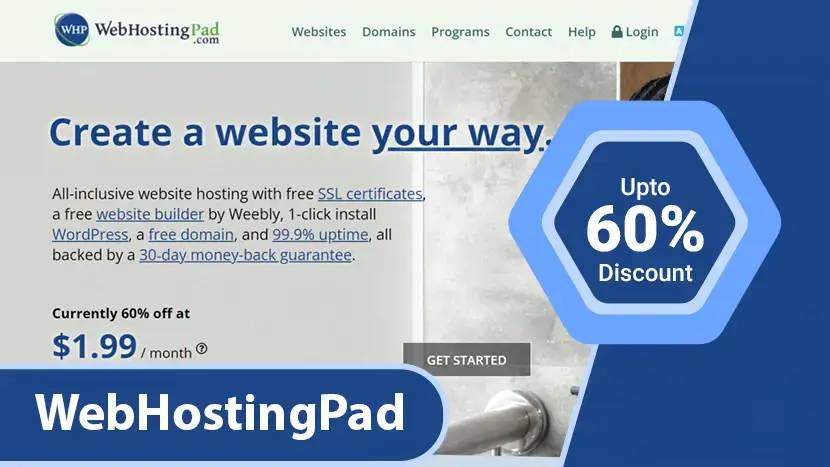
WebHostingPad has been in business since 2005 and since its inception has worked on the principle of putting the clients’ needs first. Their aim is to offer the best hosting service with an efficient support staff helping you along the way.
Feature
- Free Domain Name*
- Free Trusted SSL & SiteLock Lite
- Free 1-Click WordPress
- Optimized High-Power Servers
- Automated & Anytime Site Backups
Know more about WebHostingPad
- FREE Domain Name: Claim your own unique domain name free for the first year with any WebHostingPad hosting plan.
- FREE Website Builder: Design a professional and responsive website in minutes with one of our free no-code builders.
- Free SSL Encryption: Build customer trust and encrypt private data with free SSL Certificates on every hosting plan.
- eCommerce Ready: Choose from popular eCommerce storefronts, add products and prices, and start selling online.
- Free Analytics Tools: All of our plans come with free tools to help you track, analyze, and improve your website's performance.
- Professional Email: Create unlimited email addresses @ your domain with free spam filtering, auto-responders, and more.
- 1-Click WordPress: Start using WordPress to design, update, and market your website with only a click. Available on all plans.
- Scalable Plan Structure: Our hosting plans are designed to support you as you grow, from just‑starting‑out to success stories.
- Money Back Guarantee: If WebHostingPad doesn't meet your needs within the first 30 days, we'll give you your money back.
Frequently Asked Questions About WebHostingPad
Have some more questions? Read on!
1. Does WebHostingPad offer support options?
Yes, thankfully, WebHostingPad offers a number of support options which you can use in the event that something isn’t quite right with your hosting service. The support team can be contacted by live chat, email, or telephone in the event that something isn’t quite right with your service.
2. Does WebHostingPad offer specialist hosting options?
Yes, WebHostingPad offers specific and specialist hosting for Weebly and WordPress users. Both of these packages are designed with the specific services mentioned in mind. If you believe that these may benefit your specific needs then you should choose the packages in question, otherwise, you may want to stick with the regular packages.
3. What are the types of web hosting?
This answer will be different for everyone. It depends on the type of website you have, the resources you need, your budget, and traffic.
We gave our top recommendation for each category in this guide, so that’s the best place for you to start your search.
Once you know what you need, you can narrow your options. To figure out what category you fall in, here’s a quick recap of the different hosting types and who they are for:
- Shared Hosting — Shared hosting is the most cost-effective plan for entry-level websites.
- VPS Hosting — VPS hosting is for websites that have outgrown shared hosting.
- WordPress Hosting — WordPress hosting optimized for WordPress sites.
- Dedicated Hosting — Dedicated hosting is Enterprise-level servers for large websites.
- Cloud Hosting — Cloud hosting is best for websites that are growing rapidly.
- Reseller Hosting — Reseller hosting is for agencies, web developers, and web designers.
- Managed Hosting — Managed hosting is an IT hosting model in which the client leases servers or cloud computing resources.
- Colocation Hosting — Colocation hosting is where you rent space for your IT hardware at a 3rd party provider’s data center facility.
- Self Service Hosting — Self hosting is a form of running your own website or application by setting up a server and network yourself.
- Cluster Hosting — A cluster hosting is a host that is configured to take over the role of another host server within a cluster.
Alternatives - Web Hosting Providers
If you want to explore more web hosting plans, here is some web hosting services provider companies as below:
Read More : You can explore here 30+ Best Web Hosting and Domain name Providers 2023
Video - Best Web Hosting For Small Business
Affordable Website Hosting for your domainIf you found this article helpful, we encourage you to share it on your social media platforms—because sharing is caring! For more information about article submissions on our website, feel free to reach out to us via email.
Send an emailWritten by RGB Web Tech
Latest Technology Trends
Latest technology trends shaping the future, including AI advancements, blockchain innovation, 5G connectivity, IoT integration, and sustainable tech solutions. Explore breakthroughs in quantum computing, cybersecurity, augmented reality, and edge computing. Stay ahead with insights into transformative technologies driving innovation across industries and revolutionizing how we live, work, and connect.
eUKhost Web Hosting Review
Last updated on January 19, 2025 by RGB Web Tech
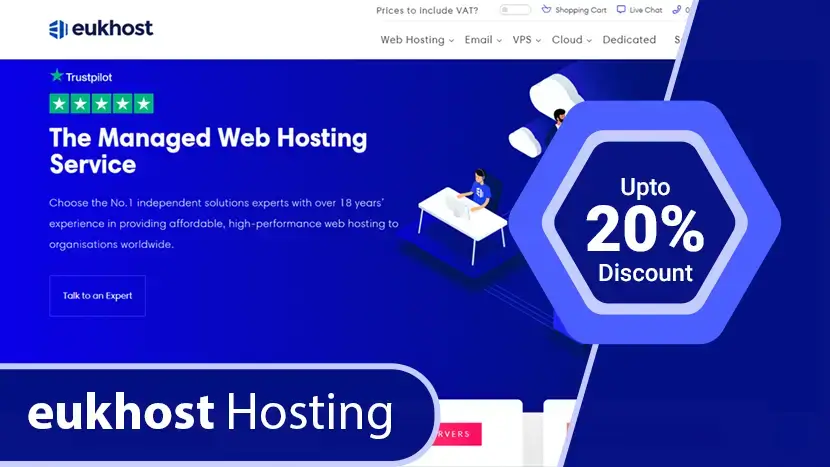
eUKhost is a web hosting provider from the UK. Launched in 2001, it was one of the first such companies in Europe to offer fully automated web hosting solutions. Since then, eUKhost has grown and widened its range of hosting-related services aimed both at hobbyist bloggers and small to mid-sized businesses. They claim to host over 150,000 domains and have more than 35,000 seemingly cheery customers across the globe.
Feature
- 24/7 technical support
- Daily backups included
- 30-day money-back guarantee
- Free domain with annual accounts
- Unlimited websites with cPanel plans

FAQs on eUKhost
1. What extras do I get with eUKhost?
As a eUKhost customer, you will have MySQL Databases, unlimited email addresses, and websites, a free domain, free daily backup, free SSL from Let encrypt.
2. Can I buy a domain through eUKhost?
Yes. You actually will have a free domain in any plan with an annual subscription.
3. Can I Upgrade My eUKhost Plan at Any Time?
Yes, you can upgrade your plan at any time by paying the price difference if needed.
4. Is eUKhost Good for Beginners?
Yes, there is a good set of features for beginners and affordable pricing. It also has an intuitive dashboard interface, which is useful for newbies.
5. Is the customer support multilingual?
Unfortunately, no. Despite the worldwide clients, eUKhost has a website and the support only in English
6. What are the types of web hosting?
This answer will be different for everyone. It depends on the type of website you have, the resources you need, your budget, and traffic.
We gave our top recommendation for each category in this guide, so that’s the best place for you to start your search.
Once you know what you need, you can narrow your options. To figure out what category you fall in, here’s a quick recap of the different hosting types and who they are for:
- Shared Hosting — Shared hosting is the most cost-effective plan for entry-level websites.
- VPS Hosting — VPS hosting is for websites that have outgrown shared hosting.
- WordPress Hosting — WordPress hosting optimized for WordPress sites.
- Dedicated Hosting — Dedicated hosting is Enterprise-level servers for large websites.
- Cloud Hosting — Cloud hosting is best for websites that are growing rapidly.
- Reseller Hosting — Reseller hosting is for agencies, web developers, and web designers.
- Managed Hosting — Managed hosting is an IT hosting model in which the client leases servers or cloud computing resources.
- Colocation Hosting — Colocation hosting is where you rent space for your IT hardware at a 3rd party provider’s data center facility.
- Self Service Hosting — Self hosting is a form of running your own website or application by setting up a server and network yourself.
- Cluster Hosting — A cluster hosting is a host that is configured to take over the role of another host server within a cluster.
Alternatives - Web Hosting Providers
If you want to explore more web hosting plans, here is some web hosting services provider companies as below:
Read More : You can explore here 30+ Best Web Hosting and Domain name Providers 2023
Video - Best Web Hosting For Small Business
Affordable Website Hosting for your domainIf you found this article helpful, we encourage you to share it on your social media platforms—because sharing is caring! For more information about article submissions on our website, feel free to reach out to us via email.
Send an emailWritten by RGB Web Tech
Latest Technology Trends
Latest technology trends shaping the future, including AI advancements, blockchain innovation, 5G connectivity, IoT integration, and sustainable tech solutions. Explore breakthroughs in quantum computing, cybersecurity, augmented reality, and edge computing. Stay ahead with insights into transformative technologies driving innovation across industries and revolutionizing how we live, work, and connect.
What is Linux web hosting?
Last updated on January 19, 2025 by RGB Web Tech

Linux hosting is an open source operating system where web hosting services occur with the use of a Linux-based server.
Linux web hosting can be accessed by an organization or individual, and it’s generally one of the cheapest types of hosting services for small businesses.
It's user friendly and generally offers a high level of security, with many hosting companies sharing their hosting tools according to each customer’s requirements.
Linux web hosting allows its users to share between multiple servers, and the source code can be used, modified, and redistributed freely in both commercial and non-commercial capacities.
Users of Linux often rely on cPanel to manage web development tasks and some web hosting providers include cPanel in its packages despite it being a third party application.
Advantages of Linux Hosting
- Linux hosting provides flexibility and use of open source technologies such as Apache, PHP, and MySQL.
- This hosting service is one of the most reasonable and affordable options.
- Over the years, Linux has earned a reputation for stability and safety.
- The security settings on the Linux server are highly efficient and advanced when compared to a Windows platform.
- In the current technology world, versatility is highly desirable because it ensures relevance in an ever-changing playing field. Linux hosting is versatile because it is compatible with various databases.
Disadvantages of Linux Hosting
- Linux web hosting lacks compatibility with several of the primary Windows-based scripting applications and technology.
- Certain programming languages such as ASP and its extensions are not suitable on Linux operating systems.
- Linux servers are not useful for porting of websites that have been scripted or designed for a Windows environment or background.
Web Hosting on Linux
When you are planning to create a website, a web hosting package should offer various features. Some of the necessities to consider are bandwidth, domain, and affordability. Domains are necessary for hosting a professional internet site. As the site develops and grows, bandwidth becomes necessary as more information and functions increase. The market has many different companies that offer Linux and Windows hosting packages. Linux web hosting is the more practical and affordable choice because it is not restrictive and is more adaptable.
However, internet marketing requires a proper analysis of the needs of the business for the present and future. You can opt for a cost-effective Linux hosting package, make sure that it contains all the functionality required currently and in future. Additional features such as software and web-mail are important for websites as they develop and grow.
Differences Between Linux and Windows Web Hosting
As previously stated, the Linux hosting system has multiple features such as good performance, adaptability, cost effectiveness, security, stability and so on. Likewise, the Windows web hosting has its own features and strengths that are better suited for specific files and websites.
The main difference between the two is the type of files and functionalities that is used. A website needing PHP, Perl, WordPress, MySQL, SSH and applications that require specific Apache modules run better and more quickly on Linux-based web hosting because it is specifically designed for this type of data. On the other hand, a Windows platform is ideal to host ASP Classic, Microsoft Access, ASP.NET, Microsoft SQL Server, C# or Visual Basic Development.
The price is another big difference. Because Linux web hosting is more reasonably priced, it is the more popular option among web hosting providers. The Linux web hosting platform also has more features than Windows, making it many web designer’s preferred choice.
Additionally, the two web hosting services have the following different servers and control panels:
- cPanel and Web Host Manager (WHM) are used on Linux-based hosting such as VPS, Linux Reseller and Linux Dedicated Servers.
- Plesk can be used for Windows Shared and Dedicated Servers.
Both systems need, use and store files. While Linux file names are case sensitive, Windows files are not. For example, home.html and Home.html are names of two different files on a Linux server, whereas, on a Windows server, whether it is home.html, Home.html or HOME.HTML, all files are considered the same.
While Linux hosting is considered more secure, both Linux and Windows operating systems are safe. The security is mainly reliant on the setup and administration of the server. Hosted servers typically are maintained with the current security and performance patches.
Ultimately, the decision to pick one web hosting service over the other often boils down to which one offers the best necessary capabilities specific to the user. The user interface on a Linux hosting account is the same as that on a Windows account. However, users are sometimes apprehensive about using a web host system that is different from the system of the home computer as they feel it may cause usability issues. It is a misconception that using a web host system that is different than a home computer can cause usability issues. Linux websites needs specially written code to run that is usually not related to the applications operating on a home computer. HTML files are used and read by both platforms and regular websites function with the same level of performance.
Linux web hosting services have various good attributes and performance capabilities and each website or designer has its own specific needs and techniques where one or the other platform can be more suitable. In order to understand whether Linux web hosting is best for you, or to gain better knowledge and insights specific to your business needs, Flying Cow Design can provide information and guide you in a step-by-step manner to better assess how to make the right decisions for your business.
List of Linux Web Hosting Service Providers:
Read More : You can explore here 30+ Best Web Hosting Providers 2023
Video - Best Web Hosting For Small Business
Affordable Website Hosting for your domainIf you found this article helpful, we encourage you to share it on your social media platforms—because sharing is caring! For more information about article submissions on our website, feel free to reach out to us via email.
Send an emailWritten by RGB Web Tech
Latest Technology Trends
Latest technology trends shaping the future, including AI advancements, blockchain innovation, 5G connectivity, IoT integration, and sustainable tech solutions. Explore breakthroughs in quantum computing, cybersecurity, augmented reality, and edge computing. Stay ahead with insights into transformative technologies driving innovation across industries and revolutionizing how we live, work, and connect.
What is Windows Web Hosting?
Last updated on January 19, 2025 by RGB Web Tech
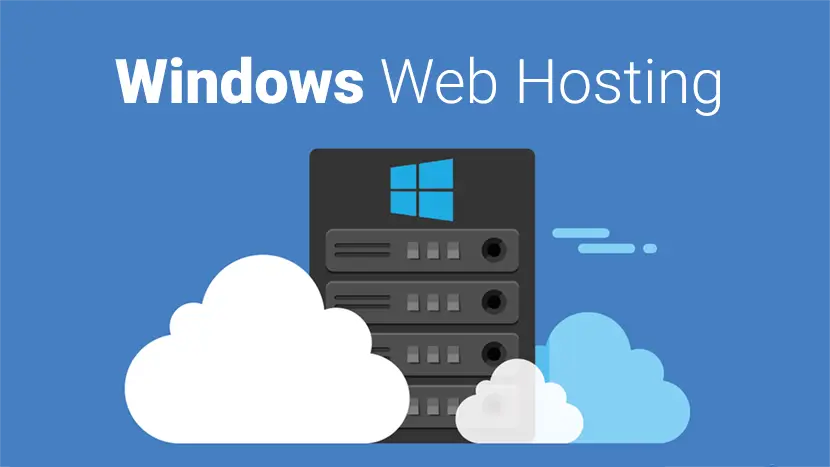
The necessity of having a dynamic website with visually attractive elements has now become an essential factor for many individuals. Windows web hosting is one of the most popular and feature-rich services offered by hosting companies that meet these needs markedly.
Generally speaking, there are two main options available for web hosting: Windows and Linux. Windows hosting with its dynamic technology can help you stay ahead of the competition with eye-catching pages that run smoothly.
What Is Windows Hosting Meaning?
It is typically a web hosting server that runs by the Windows OS or its other variants. Your website pages can efficiently have access to web development features of Windows when you use a hosting service of this kind.
The popularity of Windows as an operating system around the world has paved the way for windows hosting meaning to become hugely favorable among website owners. Currently, more than 75% of the desktop operating system’s global market belongs to Windows. Microsoft is continually researching this product, and we can see the improvements it makes on Windows every year not only in the technical aspects but also in support of various scripts.
Advantages of Windows Web Hosting Hosting
When you are looking for a hosting solution, you will come across numerous options. Windows hosting holds a prominent place among them. If you are looking for a feature-rich hosting solution, you may take a look at this type of hosting. However, it is better to evaluate its pros and cons before you proceed.
1. A Microsoft-Friendly Option
Many websites and businesses rely on different products and tools of Microsoft like FrontPage and ASP to function properly. The same conditions apply to Microsoft Exchange for efficient management of emails and Microsoft SharePoint for better collaboration between team members.
These products offer excellent quality and have proved to be the best option in their category. For instance, ASP is much easier to use than other server-side services and integrates perfectly with many other languages as well.
Therefore, windows shared hosting counts as a perfect solution for this purpose that provides you with enough capabilities to build dynamic and interactive websites. Moreover, many tech professionals are accustomed to maintaining and updating windows and its programs. This familiarity with Windows OS makes it easy for them to work with the server interface, too.
2. Powerful and Simple
Windows hosting services are often based on Windows Server OS. This operating system enables you to manage your server and scale it without any concerns about its security.
Additionally, these windows website hosting packages come with the user-friendly Plesk control panel that makes it much easier for you to update your website and make changes where needed. The intuitive interface of Plesk, with its great focus on commercial websites, lets you manage multiple sites conveniently. Plus, it’s completely compatible with the most popular content management systems, including WordPress and Joomla.
Above all, all the Microsoft products are developed in a way to support one another. This advantage has attracted developers towards creating various applications in complete compatibility with Windows. Similarly, open-source tools like MySQL and PHP run efficiently on this hosting platform, and this feature isn’t available on Linux to this extent.
3. A Reasonable Solution
It used to be a costly service due to the high price of Microsoft licenses. However, these days you can find affordable plans as low as $10 a month from different service providers. Although Windows hosting packages are costlier than Linux, compared to the features you receive in return for the budget, you can rest assured that your money is spent well.
4. It Runs on Windows Operating System
Most of us are familiar with Windows operating system which windows shared hosting runs on it. Hence, you don’t have to go through the struggle of getting used to it. In other words, you don’t have to go through a lengthy learning curve while you are trying to work with this hosting solution. You will find specific features, which you can use according to your preferences. On these plans, you will discover the Plesk control panel. This delivers an intuitive experience than cPanel, which you can find in Linux hosting.
5. It Is Compatible With Other Windows Tools
One of the main reasons why people go for this type of hosting is the presence of numerous familiar tools. This makes life easy for them when managing the hosting plan. For example, if your website is developed with ASP.NET, Windows hosting would be a great solution available to consider. On the other hand, you will notice how compatible your hosting plan with Microsoft SQL is. You might even be able to use Microsoft Exchange as the email server.
6. It Comes With a Plesk Control Panel
As mentioned earlier, hosting windows server comes with a Plesk control panel. You can access straightforward controls on this control panel. Hence, managing your hosting plan will never be a challenging thing. If you want to make any changes or updates to your website, you can easily do them. You will even be able to manage multiple domains and websites in your hosting solution without a problem.
Disadvantages of Windows Hosting
1. It Is Not Secure as Linux Hosting
When you make a cross-comparison between the security of Windows hosting and Linux hosting, you will notice some significant differences. In other words, Linux hosting is more secure. Windows hosting solutions are highly vulnerable to numerous attacks, including ransomware attacks. However, Linux hosting is more confident, and you will keep peace of mind. Since security is a significant concern, you must be mindful of this fact as you pick a hosting solution.
2. It Is Expensive
You will have to spend more money to get this type of hosting when compared to Linux hosting. However, this varies depending on the hosting solutions provider. For example, if you look at Hostgator, you will notice that Linux hosting plans start at $2.75 per month, whereas Windows hosting plans start at $4.76 per month. You will be able to save money in the long run by going ahead with Linux hosting.
3. It Is Less Stable
Linux servers are well-known for their dependability. They seldom need to be restarted and can perform many tasks at once. On the other hand, Windows servers have difficulty running many programs and processes simultaneously without crashing. Like any other web technology, Windows servers have improved over time and are anticipated to continue to do so. However, they aren’t relatively as constant in their performance as Linux servers.
However, this is another area where selecting the appropriate web hosting company may make a significant impact. When a Windows hosting business offers a 99.9% uptime guarantee, it means they’ve taken all the necessary steps to keep their Windows servers running as smoothly as possible. A competent web hosting company can assist overcome the gap in server stability between Windows and Linux hosting by paying attention to maintenance and planning.
Who Should Choose Windows Web Hosting Server?
Windows hosting, compared to its Linux counterpart, has many areas with exceptional strength that makes it a perfect match for a hosting service. It’s essential for some web programming languages and scripts such as ASP, Visual Basic, and C# to work seamlessly.
Additionally, it supports commonly-used databases like SQL and MS Access so that you won’t have any difficulty managing your database.
Frequently Asked Questions
Does Windows Hosting Support WordPress?
One of the common questions among users is “can you host WordPress on a Windows server?“. Microsoft provides a set of tools and a robust platform that is capable of hosting WordPress. One of the most important things about Microsoft’s web platform is its interface. The Microsoft Windows server family provides several roles which can take control of complicated IT tasks.
Does Windows Hosting Support PHP?
The answer is yes. Most shared hosting services of windows support PHP by default. If PHP is not enabled on your host, you should ask your hosting provider to activate it for you.
Conclusion
We know what is windows web hosting. Windows shared hosting is an excellent option for a broad range of requirements. Although you will need to pay more money compared to the Linux solution, the efficiency and advantages of windows web hosting will outweigh its costs. So if you want high functionality and integration with popular applications, don’t hesitate to go for this service.
List of Windows Hosting Service Providers:
Read More : You can explore here 30+ Best Web Hosting Providers 2023
Video - Best Web Hosting For Small Business
Affordable Website Hosting for your domainIf you found this article helpful, we encourage you to share it on your social media platforms—because sharing is caring! For more information about article submissions on our website, feel free to reach out to us via email.
Send an emailWritten by RGB Web Tech
Latest Technology Trends
Latest technology trends shaping the future, including AI advancements, blockchain innovation, 5G connectivity, IoT integration, and sustainable tech solutions. Explore breakthroughs in quantum computing, cybersecurity, augmented reality, and edge computing. Stay ahead with insights into transformative technologies driving innovation across industries and revolutionizing how we live, work, and connect.
What is Shared Web Hosting?
Last updated on January 19, 2025 by RGB Web Tech

Deciding on the hosting service for a website can be tough. Hosting service providers offer different packages and plans, which can leave you confused about which one to choose. To hit the right note, you should gain information about different types of hosting plans and pick the correct one based on your needs.
Shared web hosting can be a good choice when your website is still in its infancy and has not been expanded to require specific resources and access. But in most cases, there is a day when shared hosting will no longer meet the needs of your website. The advantages of shared hosting and also disadvantages of shared hosting can make them a viable choice or a troublesome limitation depending on your circumstances and needs. In the remainder of this article,
Here we discuss what is shared hosting that comes as a popular choice for many users launching their first website. In the following paragraphs, we will examine shared hosting pros and cons to determine the strengths and weaknesses of this type of hosting.
What Is Shared Hosting Meaning?
Shared hosting means are the most affordable option to use for running a website. As a shared web hosting definition, multiple sites share a single server when they run on shared hosting. That’s the reason why these services come at a lower price compared to the dedicated ones.
In most cases, the user doesn’t know other users who share the server. But, all users have access to the platform of the server to see the databases, find out about email accounts, and access other provided features. The allowed capacities are limited by the service provider, which is often described in the details of the package you buy.
Generally speaking, a shared hosting server is proper for a personal weblog, startups, local businesses, or other small websites that don’t need very high bandwidth or professional settings. Websites with high volume should go for VPS or other dedicated options available on the market. Owners of these sites can take advantage of more in-depth controls and more stable performance if they choose plans with higher prices than the shared hosting. In the past article, we have mentioned the advantages of shared hosting.
How Does Shared Hosting Work?
Shared hosting plans are cheap and affordable. Before you go ahead with it, you will come across the need to figure out what is shared web hosting and how it works. Shared hosting is where you will be provided with hosting space in a server, which hosts multiple other websites. It can even contain hundreds or thousands of websites. The server resources, including processing speed, RAM, and hard drive space, are shared between all the websites hosted. Due to the same reason, the performance of your website hosted on the shared hosting server can be affected by another website’s performance on the same server. This is something that you will need to be mindful of.
Advantages of Shared Hosting
Now you have answers to the question of what is shared hosting. There are some drawbacks and benefits of shared web hosting that you must know before deciding whether or not to use this kind of web hosting. In the following, we are going to mention some of the benefits first:
1. Cost-Effective: One of the advantages of shared hosting is being cheap; shared hosting services are the cheapest type of hosting services you can supply. In this type of service, the resources of a server are divided into several hundred or even several thousand websites. As a result, the cost per user is significantly reduced. The pricing plans you find for these services fall somewhere between $2.5 to $10 per month.
2. Simple User Interface: One of the main benefits of shared hosting is a simple user interface. Shared hosting is generally managed by control panels. This means that when you purchase the service, you are provided with a web interface with the ability to make changes, upload, create a site and add domains, and more. Due to the simple user interface in these types of management panels, you no longer need to have high knowledge of Linux or Windows servers and can use your service without paying attention to the details. The control panels provided on these services are generally Plesk, Cpanel or Solidcp.
3. Security : As with other shared hosting services, security is of particular importance. If there is a security problem with these types of services, this deficiency can cause problems for a large number of services running on that server or all of them. For this reason, companies offering these types of services are particularly sensitive to their security checks and even to the limitations of protecting users, so you don’t have to worry about security. Periodic server updates, data backups, restrictions on service changes, and the inability to use some protocols are security issues that generally apply to these services.
4. Support : One of the main shared hosting benefits is that it does not require server management. As mentioned above, server-side security issues are controlled by the provider on an ongoing basis in shared services. But security reviews are not the only things that need to be done to make a service sustainable. Hosting networks are generally complex systems, and because of this complexity, the possibility of disruption or a technical difficulty is very high. Investigating and resolving such cases can, in many cases, require increased knowledge and hours, or even days. It is up to the server to monitor and resolve such problems in shared services.
Technical support is another strength and benefit of shared web hosting that can, in many cases, make your work easier and return valuable hours to you. Generally, quality hosting services provide relatively extensive technical support. The technical teams prevent the services from being interrupted by a 24-hour review and investigation of the services and will resolve the interruptions as soon as possible. More importantly, you can contact your hosting service support experts at any time in different ways to investigate and troubleshoot any issues that may arise on these services.
5. Scalable : Scalability is among the important advantages of shared hosting. Since new and small sites don’t see much traffic, shared hosting works best for them. This feature allows them to remain within limits established by many users drawing from a shared server’s finite resources. In fact, shared hosting solutions are not just for personal website owners and casual bloggers. It can handle up to 100,000 visitors a month, translating to roughly over 3000 visitors daily. When a website gets to a certain level of monthly traffic, it may need to upgrade to a different rank of shared hosting or switch to another hosting entirely.
In sum, shared hosting services may require you to hire a server administrator to maintain the service. This type of support and management of service is generally not provided on virtual servers or will be significantly limited.
6. You Can Host Multiple Domains : You can have multiple domains under the user directory while using a shared hosting plan. The hosting provider will deliver a convenient interface, which you can use to manage all the websites. This interface can help you to overcome complexity in managing multiple websites.
7. It’s Professionally Managed : The maintenance cost associated with shared hosting is low. In fact, you will be able to manage the website as well professionally. All you have to do is seek the assistance of a professional team and hand over the job to them.
8. It Can Host Dynamic Websites: Dynamic websites are the websites that change dynamically based on how a user is browsing. Quora, Facebook, and Twitter are perfect examples of such dynamic websites. They are usually based on content management systems. You can easily host a dynamic website within your shared hosting plan.
Disadvantages of Shared Hosting
We have mentioned some benefits of shared hosting. There are also some factors that explain why shared hosting is bad for some businesses:
1. Resource Constraint : In shared hosting, the resources provided to your site are limited, and the overall server resources are shared among all users; this is one of the leading shared hosting drawbacks. Resource constraints become more critical when your site expands and needs more resources to operate. Lack of resources can severely impact your site’s performance, slow down the site, or interrupt loading. If the site in question uses more resources than what is specified by the server, access to the service may be restricted by the provider rules.
2. Lack of Full Access : One of the main Disadvantages of Shared Hosting is a lack of access. As mentioned earlier, shared hosting services have limitations on the amount and type of user access to server settings. This could be due to security issues or the impact of changes to other users’ services. If you need to make any changes to the server for any reason, you should discuss this with the server to make these changes if possible. In many cases, such changes cannot be made to these services. In fact, you do not have much authority for changes in shared services.
3. Influenceable : Shared services generally have a lot of investigations to control the quality of service. Different websites operate typically in the range of resources provided to them, using the Isolated Application Pool, which essentially prevents over-consumption on one website and affects it on other websites. However, there are other problems that if happen to other websites, can negatively impact your website.
For example, sending spam by a website can place the IP of the email service in the RBLs (which collect the IP of the spam senders). Since IP is shared in these services, this can also affect sending emails by your domain, and your sent emails are known to be spam.
4. Less Stable : Technologies such as cloud hosting, load balancing, and redundancy have greatly increased the ability of servers to provide more stable services. However, shared services are still less stable than dedicated services. The issues mentioned in previous sections are among the reasons that influence the sustainability of shared services. If your website requires a very high level of service sustainability, even the best-shared services may not meet your needs.
5. Insufficient Support: Insufficient support is one of the big shared hosting cons. Shared hosting companies often assert to provide easy support, but this support might not be enough. In other words, if the website meets head-on a problem, they might not be able to help you with that. If your problem goes under, they will just restart it for you.
If you ask why it continues going under, they might be unaware. And in the end, you might soon find out that you are talking to someone who is not a professional WordPress pro, but instead someone who is a newcomer and is reading from a prepared FAQ. If you have bigger problems, you have to call an expert help from outside, which could cost a lot for you.
6. More Vulnerable Against Security Issues : Another disadvantage of shared hosting is vulnerability to Security Issues and because of which you should just stay away from it. If a hacker hacks any website on a server, then other websites also face the potential threat. And if the main server itself gets hacked, then every website on the server threats Simultaneously. So, if you should try to work without mistakes, your website is at risk in a shared hosting environment.
7. Extra Payment For SSL Certificates : In general, you have no problem with the initial cost of shared hosting, because it is not high, but when you want to add a feature, you have to spend more. that is one of the main shared hosting disadvantages. One of these features is SSL certificates. Many shared hosting companies don’t prepare SSL certificates for free, and this causes your website to show a “Not Secure” warning.
However, these certificates are actually available for free. But, you still result up paying for them on shared hosting. So the cost of SSL Certificates becomes one of the biggest shared hosting disadvantages because you have to add up the cost of buying it from shared hosting.
Who Should Buy a Shared Hosting Server?
Overall, for those who are starting a website from the ground up, there is no alternative to shared hosting. It’s by far the best choice for this group of users. Also, shared hosting is the right fit for those who can’t invest much in their hosting and need to keep their costs down. Beginner users with little experience regarding website management who choose Joomla and WordPress cms as their CMS could also benefit from this service extensively. Furthermore, in the beginning, it’s hard to predict how much space and requirements a website needs precisely. To this end, shared hosting is a proper flexible solution that allows you to manage the unknowns easier.
Things To Consider When Choosing a Shared Hosting Plan
Upon understanding what is shared website hosting and the benefits of shared web hosting, you will need to explore the factors that can contribute towards the best results out of your shared hosting plan. Here are some important tips that you need to consider as you try to obtain your shared hosting plan.
1. Uptime : One of the very first things you should do as of now is to take a look at the uptime. If the shared hosting plan is leading you to continuous downtimes, you will end up with struggles. This is why you should be mindful of the uptime. You can then make your website available for visitors at all times.
2. Speed : Next, you should be mindful of safety. No person would like to wait for more than 3 seconds for a page of your website to load. While keeping this in mind, you should pay extra attention to the speed of the website.
3. Security : Shared hosting can be risky as your server will be shared with numerous other entities. This is why you should be mindful of the security of the website. Then you will be able to keep it away from threats.
4. Resources : There should be enough resources available for you to host the website. This is something that you should double-check and see. If not, you will run into struggles because of a lack of resources.
5. Easy to use dashboard : You never expect to go through any struggles when using the web hosting account. This is why you should check and see whether an easy-to-use dashboard is available or not.
6. Support : Last but not least, you need to make sure that proper support is available to you. Then you can get answers to all the questions you have promptly.
When we not use Shared Hosting
Your site is facilitated on a standard server with numerous different sites with shared Hosting. Subsequently, the server is arranged to permit well-known structures, for example, WordPress, to run effectively with traditional settings. To use a custom website system that isn’t introduced on the server or improve server assets for webpage explicit undertakings, it is likely best to use a web hosting or devoted hosting program. These projects require much more information and framework the executive’s experience, yet they permit you to alter the server precisely to your necessities.
Introducing WordPress or utilizing essential coding, for example, HTML or CSS, doesn’t need root access and is effectively finished with the underlying arrangement of a joint facilitating account. Email, essential security strategies, such as ModSecurity, Sucuri, and SSL testaments, likewise don’t need root access and can be applied rapidly without broad information.
Except if you want root admittance to introduce programming or unique settings, shared Hosting is the best spot to begin. Nonetheless, on the off chance that you wish to teach particular programming or set up another server to set up and run your site, consider Hosting a VPS or committed server.
Why Start with Shared Hosting?
Shared Hosting is the least complicated type of web Hosting to begin. Progressed server settings expect you to oversee server assets and upgrade server settings yourself. In a joint program, this is dealt with for you! Likewise, you can pick a joint undertaking with the support that your business needs—that way, you just get compensation for what you use. Assuming you at any point expected to change to a VPS or devoted hosting program, you can undoubtedly overhaul your application to something with more control.
In addition to shared Hosting, it is natural to have numerous destinations simultaneously. cPanel, Softaculous, and other engineer devices simplify the same goals, send off new locales, and attempt new things. You can undoubtedly test on different destinations without influencing your center business. Most independent ventures need a little data site to assist them with building mindfulness and cultivating leads while beginning a site.
Likewise, while sending off a site, traffic will probably be low until the site positions in web indexes. Utilizing a standard Hosting plan at this phase of development will assist you with setting aside cash while distinguishing your image, constructing an internet-based presence, and fostering an SEO technique.
Shared Hosting turns out best for primary, centered sites. Online journals, one-page pages, or destinations that sell a little assortment of items or administrations can all function admirably in shared Hosting. WordPress and other well-known substances the executives programming are frequently excellent for shared Hosting when a site has standard, predictable traffic. Some web-based business stages can, without much of a stretch, sudden spike in demand for shared Hosting, even with a wide assortment of items; however, a few scenes perform better compared to other people.
Frequently Asked Questions
Is Shared Hosting Good?
Shared hosting is a suitable option for small businesses that require small websites. Since every website doesn’t need to use its quota, then it works for most of the small businesses. It is really affordable for such organizations and also profitable for web hosting companies.
Is Shared Hosting Secure?
The answer is yes! Shared hosting has the same amount of security risks as other kinds of hosting. If hackers get the chance to hack your website, they can redirect your users to unwanted pages, display unwanted content and spam the customers.
What Is the Purpose of Shared Hosting?
If you are wondering what does shared hosting mean, we should say that it is a kind of web hosting capable of hosting multiple websites on a single server. In this way, several websites can host their website files and utilize the resources together. As a result, the cost for shared hosting plans is much more reasonable than the other kinds of plans.
If you are interested to compare wordpress hosting vs web hosting , this article can help you!
Is Shared Hosting Slow?
One of the most important shared hosting drawbacks is its speed. The performance of your website highly depends on the activity of other websites which are hosted on the same plan and also by the server infrastructure itself.
How Much Traffic Can Shared Hosting Handle?
Good shared hosting is capable of handling about 1.5–2k traffic per hour. It actually depends on how website owners optimize their website pages. With the average size of 700kb to 1.3 MB of website pages, we can say that shared hosting can handle 7–12 k daily traffic without any problem. But for more traffic, users may experience some slow loading issues.
If you are interested in comparing vps vs vds , this article can help you!
Conclusion
In this article, we have mentioned some of the pros and cons of shared hosting that can affect your business. It is important to choose the right kind of Web Hosting service for your website to attract more users to visit your site and also rank higher in SERP. We hope that this article can help you have a better understanding of shared hosting limitations, pros, and cons!
List of Shared Hosting Service Providers
Read More : You can explore here 30+ Best Web Hosting Providers 2023
Video - Best Web Hosting For Small Business
Affordable Website Hosting for your domainIf you found this article helpful, we encourage you to share it on your social media platforms—because sharing is caring! For more information about article submissions on our website, feel free to reach out to us via email.
Send an emailWritten by RGB Web Tech
Latest Technology Trends
Latest technology trends shaping the future, including AI advancements, blockchain innovation, 5G connectivity, IoT integration, and sustainable tech solutions. Explore breakthroughs in quantum computing, cybersecurity, augmented reality, and edge computing. Stay ahead with insights into transformative technologies driving innovation across industries and revolutionizing how we live, work, and connect.
What is VPS Hosting? - Virtual Private Server
Last updated on January 19, 2025 by RGB Web Tech

A VPS ( Virtual Private Server ) is a virtual machine sold as a service by an Internet hosting service. The virtual dedicated server (VDS) also has a similar meaning.
A virtual private server runs its own copy of an operating system (OS), and customers may have superuser-level access to that operating system instance, so they can install almost any software that runs on that OS. For many purposes it is functionally equivalent to a dedicated physical server and, being software-defined, can be created and configured much more easily. A virtual server costs much less than an equivalent physical server. However, as virtual servers share the underlying physical hardware with other VPSes, performance may be lower, depending on the workload of any other executing virtual machines.
How does VPS work?
If you’re familiar with VMware or Virtualbox, you’ll be familiar with how VPS hosting works. These programs let you run what are known as virtualized operating systems from one machine. For example, your computer might be running OS X, but you could run different systems such as Linux or Windows XP without having to reconfigure or restart your computer.
VPS web hosting environments work in the same way as a virtualized operating system in the sense that one server will run numerous, one of a kind virtualized OS’s on a single server -since each virtualized system behaves as though it is a dedicated server. Virtualization is possible through a hypervisor. A hypervisor is computer hardware, software or firmware that creates and runs virtual machines (VM) by separating the underlying physical hardware from a computer’s operating system and applications. The computer system on which the hypervisor runs is known as a host machine, and each VM is called a guest machine.
The hypervisor provides each guest machine (each website using the VPS) with a virtual operating system and takes care of managing and executing guest operating systems. This process makes the most effective use of computer resources such as network bandwidth, memory space and processor cycles. For this reason, a hypervisor also goes by the name of a virtual machine monitor (VMM).
VPS hosting relies on a hypervisor to take resources from the physical server and provide each website with access to an emulated server (the VM). These physical servers are often held in a data center and divided equally between several virtual compartments (known as server virtualization). Each compartment is rented out, and server software is set-up on them separately so that each unit is capable of functioning as an independent unit. Each individual VPS is called a container, and the server each container is held within is known as a node.
With VPS, you benefit from many of the advantages of a dedicated server for a significantly lower cost. It offers more privileges within the OS and allows users to install any type of software capable of running on that OS. Each virtual server’s software is installed separately, enabling independent functionality for all users.
Defined amounts of CPU time and memory are shared throughout all the accounts sharing the server space. So, despite the fact that there might be far bigger websites than yours on another VPS compartment powered by the same server, that doesn’t matter. You are guaranteed the system resources you are paying for.
VPS is a step up for most users, but you'll also benefit by knowing a bit more about the technology. When your website is stored on a VPS, you are solely responsible for setting up, maintaining and running the server yourself. Handling an internet server is not an easy task! It involves taking care of security patches, server configuration, software updates, and so on. Unless you have the degree of technical skills required, it is going to tricky, and for this reason, there are two versions of VPS hosting – managed VPS and unmanaged VPS.
There are different types of VPS Hosting
Unmanaged VPS
With unmanaged VPS, your web hosting takes over installing the operating system, and you as the site owner take over managing various aspects of the server such as:
- Installing software, your control panel and taking care of software updates.
- Monitoring for security threats, installing security patches and fixing error messages.
- In the event of an outage or hardware failure you won’t get much if any support from your host.
- Configuring and maintaining your server including any upgrades you might want to see.
- You take over the responsibility of setting up your sites backup services.
This is recommended for site owners who have a technical background.
Managed VPS
Site owners with less technical acumen or a smaller staff can benefit from managed VPS. With managed VPS hosting, IT professionals lighten your load by keeping your server running correctly and taking care of your virtual server. Here’s what you should expect from a web hosting provider:
- Initial server setup : When you launch your site with a VPS there are a few steps to take in order to set the server up including installing your control panel, server software and installing any applications and your operating system. A managed host will take care of this.
- Updates : Similarly, all applications and OS updates, and ongoing fine tuning of the server will be handled for you.
- Security Patches : Security patches for your OS and core server software are installed and updated, on your behalf.
- Monitoring : Monitors for early warning signs of hardware failure and malicious attack.
- Automated Backups : In the event anything goes wrong with your site, you can retrieve it back to an earlier version.
Check with your VPS hosting provider to see what levels of management they offer. Some have greater flexibility, like Namecheap; we offer Self-Managed, Managed, Fully Managed and Emergency Assistance.
The tradeoffs between managed and unmanaged hosting are cost vs flexibility. While unmanaged services are, naturally, far cheaper than managed plans, there’s a snag - you need to have the tech know-how to run and maintain a server, or be prepared to hire someone to keep it running smoothly and safe from potential attacks.
What are the benefits of VPS Hosting?
The main merits of VPS servers is that they give you the freedom of having your own virtual machine just like you would from a more expensive, dedicated server with performance that can allow you to handle moderate traffic with the occasional heavy spike.
- Customization : Since you have your own OS, with a VPS, you can customize it to your needs. For example, if you have your own instances of server applications from PHP, to MySQL, or Apache, you can customize them so that the server fits your needs.
- Control : Offers the ability to oversee a hosting environment. Also, if you plan to install applications that need you to perform a system restart to finalize the installation, you can do this without affecting anyone else, at any time. Even though you share a VPS server with others, yours can be restarted without disrupting others.
- Cheaper : More affordable than a dedicated server.
- Dedicated resources : With a VPS Server, you have a predefined amount of RAM available to you whenever you need it. In contrast to shared web hosting, where there could be others sharing your server that could eat up the RAM when you want it most!
- Scalable : Another great thing about VPS is that you can purchase the resources you think you will need, and if that’s insufficient, you can simply increase its size.
Virtual Private Server Pros and Cons
VPS hosting can be an ideal solution for you if that’s the service you really need. Below, you can read the pros and cons of running a virtual private server.
Pros
- It’s faster and more reliable than a shared hosting server.
- As server resources such as memory or processing power are guaranteed, there’s zero to minimal fluctuation in available resources.
- Issues and traffic surges of other server users don’t affect your site.
- You get superuser (root) access to your server.
- You have better privacy, as your files and databases are locked from other server users.
- It’s an easy-to-scale service. As your website grows, you can easily upgrade your server resources (RAM, CPU, disk space, bandwidth, etc.).
Cons
- It’s more expensive than shared hosting.
- It requires more technical knowledge to setup your VPS, though there are a lot of tutorials available online.
- Server management is more technically demanding than shared or cloud plans.
- Improperly configured servers may lead to security vulnerabilities.
Do I need VPS hosting?
There are use cases for every type of hosting, so who exactly is VPS hosting for? You should consider VPS hosting if:
- Your business is expanding beyond the constraints of shared hosting.
- You are expecting a substantial increase in site traffic within the next few months. For example, your site is geared toward a new marketing effort or promotional campaign, or if you’re expanding into other markets.
- You might have enough bandwidth to handle a single website, but two, three? If you plan on hosting several websites in the near future you’re going to need more resources. Similarly, if your current shared hosting account is eating through the resources and your host is asking you to consider upgrading, it’s time to consider VPS.
- Your website needs better privacy and performance compared to what’s available with shared hosting.
- You want full control over the server, things like custom configurations, root access and installations unavailable with shared hosting.
Conclusion
VPS style hosting is the best way to keep up the success of any site going through rapid growth and expansion. It’s the next best plan that can afford some form of scalability. With VPS, not only will you enjoy a tremendous amount of storage and bandwidth (that’s entirely yours), it’s a cost effective solution to meeting the demands of a busy site. Of course we’ve mentioned dedicated hosting, which for most will be a vast amount of resources you may not need, and you’ll pay significantly more for it.
When deciding between the type of VPS, consider how hands on you want to be, or whether you are able to employ someone else to do the heavy lifting for you. If you like the sound of running your own server, go for unmanaged VPS, if on the other hand you’d like some help with server maintenance, automated backups and software updates, opt for the managed version. When it comes to choosing a VPS host.
Namecheap has the most optimized VPS hosting plans, we provide three types of VPS management: self-managed, managed (which includes root access) where we provide assistance with the additional configuration of core services to meet the specific requirements of each site. We can also help to optimize the server performance. We offer constant monitoring of all services on the server to prevent any of them from being down, and the ability to take immediate actions to resolve the issue in the case sudden downtime occurs. Our fully managed service plans (when root access is granted to Namecheap) includes all the features of the managed option including extras such as priority support and weekly backups.
List of VPS (Virtual Private Server) Service Providers:
Read More : You can explore here 30+ Best Web Hosting Providers 2023
Video - Best Web Hosting For Small Business
Affordable Website Hosting for your domainIf you found this article helpful, we encourage you to share it on your social media platforms—because sharing is caring! For more information about article submissions on our website, feel free to reach out to us via email.
Send an emailWritten by RGB Web Tech
Latest Technology Trends
Latest technology trends shaping the future, including AI advancements, blockchain innovation, 5G connectivity, IoT integration, and sustainable tech solutions. Explore breakthroughs in quantum computing, cybersecurity, augmented reality, and edge computing. Stay ahead with insights into transformative technologies driving innovation across industries and revolutionizing how we live, work, and connect.
Best WordPress Hosting - Fast & Secure
Last updated on January 19, 2025 by RGB Web Tech
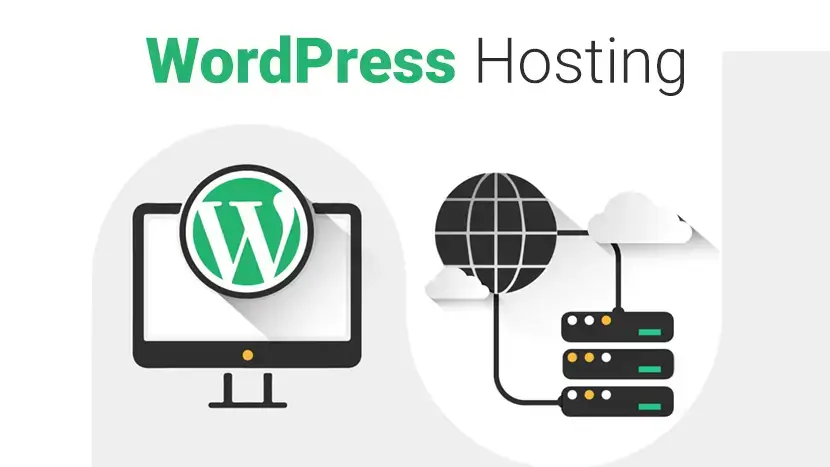
In this post, we’re going to tackle head-on the confusion that seems to keep coming up in the world of hosting with the terms WordPress hosting vs Web Hosting.
Using some form of web hosting is essential if you want to take your business online. Picking the right host can boost your site’s SEO, increase your sales, and provide tools and packages to help your business. But what is the difference between WordPress hosting and web hosting, and which is the better option?
WordPress hosting and web hosting are two very different types of hosting and are not to be confused. There are a few key differences between the two, and each has its own advantages, plans, and providers. Here’s a guide to WordPress hosting vs. web hosting and how to differentiate and choose between the two.
What is WordPress hosting?

In a nutshell, WordPress hosting is a form of web hosting optimized to run WordPress sites.
By using a WordPress host, you’ll receive lots of tools and services that are specifically tailored to WordPress sites. These may vary depending on what WP hosting service you opt for, but often include features such as one-click-install, automatic software updates, and a team of support staff who specialize in WordPress to provide you with customized support.
What is web hosting?
Web hosting is a much more general term and describes the process of an individual or organization buying a spot online to make their website accessible on the Internet.
A web host works by allocating space on a server to store the files associated with your website and by providing internet connectivity for your site. This allows your website to go live on the Internet and appear in search results.
Web hosting is very much an umbrella term, and there are lots of different types of web hosting, as well as different providers and features. If you plan on creating a website for your business, you’ll need to use some form of web hosting because you won’t be able to get your site online without a host.
What’s the difference between web hosting and WordPress hosting?
The key difference between web hosting and WordPress hosting is that web hosting is a much broader, overarching service, while WordPress hosting refers to a specific niche tailored to WordPress installs.
Web hosting is a more generalized service and refers to any hosting service that stores a site’s files on a server to make the site live on the Internet. A web host will cater to a wide range of site builders, and the websites stored on one of their servers may be operating on thousands of different platforms.
WordPress hosting, on the other hand, is a specific niche in web hosting. WordPress hosting can also use shared servers to host multiple websites at once but, unlike web hosting, every website on a shared server will be a WordPress site. A WordPress host caters specifically to WordPress installs and offers customized solutions, services, and support optimized for WordPress performance.
How to choose the best hosting option for your business
With over 338,561 web hosting service providers available worldwide, it can be difficult to choose the right one for your business – especially if you’re still deliberating between WordPress hosting vs. web hosting.
Both options have their advantages and are available from a wide range of providers in a variety of plans. To choose the best option for your business, keep in mind the key things a business needs in a web hosting service:
- Dedicated 24/7 customer service
- Supported domain name management
- Basic security features
- Uptime guarantee
- Server accessibility
WordPress Quick Overview
WordPress powers 35% of all websites on the Internet right now – and with a 4% annual growth, this is set to rise. WordPress is a hugely popular site builder and is used by businesses such as eBay, The New York Times, and Sony to create and power their websites.
According to research, WordPress is the most used CMS, and more than 1.1 million new domains are registered every six months. If you’re looking to create a business website or migrate your existing one, WordPress is a leading site builder – and it’s a noteworthy hosting option, too.
WordPress is an easy-to-use, simple, and fully customizable hosting option, and using a WordPress hosting service alongside your WP site will optimize your site’s performance and results.
WordPress hosting benefits
1. Improved Security : WordPress hosts offer servers equipped against WordPress-specific threats alongside a dedicated team who will stay on top of security issues and ensure your site is safe and secure.
2. Fast set-up and Performance : The website set-up process is made incredibly quick using pre-configured web technologies and the WordPress servers ensure fast loading times and quick uptime from the moment your site’s live.
3. Better Plugin Function : You won’t need to use as many plugins with a managed WP hosting service, because performance, security, and caching will all be optimized by the host. And for the plugins you do want or need, WP hosted sites are optimized to work with the most popular of them, which can be automatically updated.
4. Easy-to-add SSL Certificates : Most managed WordPress hosting plans allow you to add an SSL certificate to your site in a couple of clicks, at no extra charge.
5. Automatic Updates : Your website will receive automatic updates and upgrades, and security packages can be added to every website on a server at once.
6. Tailored Support : When using a WordPress hosting service, you’ll be able to access dedicated customer support services, experts in resolving WordPress issues.
Who should use WordPress hosting?
If you built your website using WordPress, you’ll benefit hugely from using WordPress hosting. WP hosting integrates perfectly with websites built with WordPress and will improve your site’s functioning, security, and offer automatic updates. You don’t have to use WordPress Hosting if you have a WordPress website, but combining the two creates the ultimate package.
Those looking for a managed hosting plan would benefit from WordPress hosting, too. WordPress hosts often offer managed services, where your site is run and maintained for you by WP experts. This is a great option for those with limited time or experience with running a website.
Web Hosting and WordPress Hosting Plans
Whether you choose to use WordPress hosting or web hosting, you’ll have to choose a hosting plan. Shared hosting, VPS hosting, Dedicated server hosting, and Cloud hosting are popular services offered by both WordPress hosts and web hosts.
WordPress hosts also offer some additional managed hosting services that can help with the running of your site.
Here are six of the most popular hosting plans available:
1. Shared Hosting : When you use a shared hosting plan, your website will share a server with other clients. This is a cheaper option and is easy to set up, making it ideal for those who are creating a starter website or who don’t have much site traffic.
2. Virtual Private Servers : A VPS plan is similar to shared hosting; you will share your server with other users, but you will be more isolated and have your own allotted space. This plan is ideal for those operating on a lower budget and who want a higher level of control and customization.
3. Dedicated Server : If you have a high-traffic website and need optimized performance and fast loading speeds, a dedicated server is a good choice. Dedicated servers offer you total customization, improved reliability, and the chance to scale your business up; but they are a high investment option.
4. Cloud Hosting : This is a relatively new type of hosting, where your website is hosted on a cloud infrastructure rather than stored on a physical server. This hosting plan has lots to offer to those looking for scalability and stability at a cheaper price, but pricing isn’t always fixed, so if your site experiences an increase in traffic, you might see an unexpected rise in costs.
5. Managed WordPress Hosting : Lots of WordPress hosting providers offer a managed service, where the host manages and runs all the technical aspects of your WordPress site for you. Managed Hosting plans can be run across any of the hosting plans listed above, and offer optimum security, performance, and configuration.
6. Optimized WordPress Hosting : If you’re looking for a hosting plan that offers pre-installed features and technologies to optimize your site, Optimized WordPress Hosting is a great choice. Optimized WordPress Hosting is a complete package plan and comes with pre-installed WordPress hosting, WordPress optimized servers, built-in WordPress security, and WordPress expert support.
Which plan you choose will depend on your budget, the amount of traffic your site receives, and how much help you want from your host in the running of your site.
List of WordPress Web Hosting Service Providers:
Read More : You can explore here 30+ Best Web Hosting Providers 2023
Video - Best Web Hosting For Small Business
Affordable Website Hosting for your domainIf you found this article helpful, we encourage you to share it on your social media platforms—because sharing is caring! For more information about article submissions on our website, feel free to reach out to us via email.
Send an emailWritten by RGB Web Tech
Latest Technology Trends
Latest technology trends shaping the future, including AI advancements, blockchain innovation, 5G connectivity, IoT integration, and sustainable tech solutions. Explore breakthroughs in quantum computing, cybersecurity, augmented reality, and edge computing. Stay ahead with insights into transformative technologies driving innovation across industries and revolutionizing how we live, work, and connect.
What is Dedicated Web Hosting?
Last updated on January 19, 2025 by RGB Web Tech

Dedicated hosting is a term used to describe web hosting packages that provide a dedicated server with dedicated resources to a single client. Dedicated hosting plans are ideal for WordPress websites with a very large number of visitors. Many WordPress hosting service providers offer Dedicated Hosting plans along with shared and VPS hosting plans.
For example, in a shared hosting plan, a client is sharing a computer with many other clients. In the case of a VPS hosting plan the clients are sharing a machine but not the resources with other clients on the same computer. However, on dedicated hosting plans a client leases a whole server with all of its resources. Web hosting companies offer different packages of dedicated hosting plans. Prices of these plans are based on the clients choice of hardware and resource allocation.
Dedicated hosting plans are ideal for large organizations or websites with much higher traffic. The clients get full control of the server which allows them to configure it to meet their own needs. The dedicated plans also come in managed and unmanaged forms where the hosting center can manage the server for the client in case of any problems. Dedicated Managed servers are generally more expensive. The pricing is also influenced by the amount of resources needed such as bandwidth, storage space, and amount of RAM, amongst other things. Additional expenses for dedicated servers also include the software packages needed to run the server. Such software can include licensing for Windows, if desired, cPanel, if desired, and other paid software. Free alternatives to most of the paid software packages are available but are not generally preferred due to issues with stability of the software. The main exception to the preference for paid vs free software is the widespread use of Linux over Microsoft or other paid OS on servers.
Advantages and Disadvantages of Dedicated Web Hosting
Whenever making decisions about web hosting, it can be helpful to make a list of advantages and disadvantages of a given option.
Advantages of Dedicated Web Hosting
- Full control of the server: Dedicated servers allow you to control everything about the device. This means you can choose any operating system, content management system, database type, and much more. You can also decide if and when to perform upgrades or other changes, which give you better control of uptime.
- Ability to customize your server: When signing up for a dedicated server, the hosting company typically lets you choose from several different server makes and models. This allows you to get the exact configuration you’re seeking. Some hosting companies even let you order a custom-built server that will be housed in their data center.
- Most powerful option: As you would expect when you can use all of the system resources of a server, your website or websites can handle huge amounts of traffic without a problem on a dedicated server.
Disadvantages of Dedicated Server Hosting
- Expensive: This is going to be the most expensive option available.
- You are responsible: Unless you also pay for management services, you’re responsible for things like updates and configuration settings. This means you need to have a good understanding of how web hosting hardware and software works to avoid any problems.
- Commitment: Some web hosting companies require you to commit to a set amount of time that you have the server. Since the hosting company has to buy the server up front, they often don’t allow you to cancel ― without a penalty ― right away.
Conclusion on what is a dedicated server
If your website is struggling to keep up with an increase in traffic, it may be time to migrate your website to a dedicated server. This is essentially a server that only hosts your site, and not only can it improve your site’s performance, but also enhance your page loading times and help you optimize security.
List of Dedicated Web Server Service Providers:
Read More : You can explore here 30+ Best Web Hosting Providers 2023
Video - Best Web Hosting For Small Business
Affordable Website Hosting for your domainIf you found this article helpful, we encourage you to share it on your social media platforms—because sharing is caring! For more information about article submissions on our website, feel free to reach out to us via email.
Send an emailWritten by RGB Web Tech
Latest Technology Trends
Latest technology trends shaping the future, including AI advancements, blockchain innovation, 5G connectivity, IoT integration, and sustainable tech solutions. Explore breakthroughs in quantum computing, cybersecurity, augmented reality, and edge computing. Stay ahead with insights into transformative technologies driving innovation across industries and revolutionizing how we live, work, and connect.
What is Cloud Web Hosting?
Last updated on January 19, 2025 by RGB Web Tech
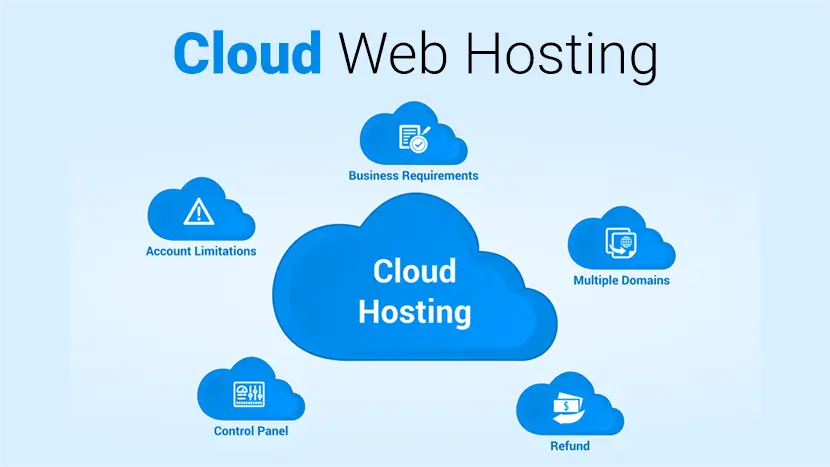
Cloud hosting is a type of web hosting which uses multiple different servers to balance the load and maximize uptime. Instead of using a single server, your website can tap into a “cluster” that uses resources from a centralized pool. This means that even if one server fails, another kicks in to keep everything running.
Visualize the cloud as a web of different computers which are all interconnected. As more machines are hooked up to the network, more resources are added to the overall cloud.
With cloud hosting, you get a part of the so-called cloud cluster. As opposed to traditional web hosting, where you get a certain amount of space from a single server.
Advantages of Cloud Hosting
There are many advantages of using cloud hosting over shared, VPS, or Dedicated hosting.
- Cost-Effective : One of the biggest reasons why businesses are switching to cloud hosting is because it is more cost-effective than the technology that runs on-premise. With traditional hosting, companies would have to spend money on disks or other storage devices and an IT team to look after these devices. But, with cloud hosting, you simply need to pay the vendor from which you are buying the resources. This saves resources, money, and time for the company. We can all agree on how important that is.
- Easy to Implement : When hosting on the cloud, businesses get to hold on to the same business processes and applications without dealing with the backend features. Since it is managed via the Internet, cloud infrastructure is easily accessible for companies.
- Scalability and Flexibility : A cloud server requires payment for only the used resources. A company does not always stay the same; it has the possibility to expand and shrink. Cloud hosting is also easily scalable which makes it easier for companies to add or remove resources according to their needs. The system grows with the company without extra burden on the company.
- Backup and Disaster Recovery : With every company, there is a risk of data and even financial loss. It is necessary that a company have a disaster recovery program. With cloud hosting, disaster recovery is rarely needed since data backups are automatic. This redundancy in data storage makes the possibility of losing data highly unlikely.
- Accessibility : With the Internet, it is so much easier to access data that is stored on web-based applications from anywhere. Having information that is stored in the cloud makes it much easier for that data to be accessed from anywhere and at any time regardless of the machine. This easy accessibility is one of the biggest advantages of cloud hosting.
Disadvantages of Cloud Hosting
Bandwidth Issue : Cloud hosting depends fully on the Internet. This means that a company needs to always have the Internet that it can rely on and is consistent. The Internet also has to have a fast connection and good bandwidth for the company to be able to take full benefit of the service. If you live in an area that does not have access to a good Internet connection, cloud hosting might turn out to be less fruitful for you.
Limited Control : The servers that host the cloud services are managed by the service providers. The providers are also the ones who own these servers. This makes it difficult for companies using these services to have the type of control that they want over their infrastructure.
Privacy: One of the biggest issues of Cloud hosting could be security issues that can arise if a person without some kind of technical knowledge is trying to use the service. You need technical assistance to benefit from the service. Another reason for security issues could arise from using a service that requires companies to share resources.
Vulnerable to Attacks: The biggest problem when using a web-based application or any kind of web-based service is that the Internet is filled with people who are looking to profit off of someone else’s loss. It is not unusual for a web-based service to get hacked or have a data breach.
When using a cloud hosting service, it is important to note that there are several other companies using the same service from the same vendor as you. This can result in information theft either via hackers or via a company that is in competition with your company. Even though security measures are applied in the cloud, the risk of attacks is something to consider before using this type of service.
Downtime : One of the biggest potential downsides to using a Cloud hosting service is downtime. The service providers, the vendors, can also face technical difficulties on their side. This could be power loss or faulty internet connections, maintenance of data centers causing them to go out of service for some time.
Conclusion : Just like with everything else, cloud hosting might not be the best option for every business. With the growing use of the Internet for almost everything, it is probably best to stay up to date with current technologies so that you are not left behind on progress. It is important to note that the advantages outweigh the disadvantages of cloud hosting but it might not be a necessity for everyone.
List of Cloud Based Web Hosting Service Providers:
Read More : You can explore here 30+ Best Web Hosting Providers 2023
Video - Best Web Hosting For Small Business
Affordable Website Hosting for your domainIf you found this article helpful, we encourage you to share it on your social media platforms—because sharing is caring! For more information about article submissions on our website, feel free to reach out to us via email.
Send an emailWritten by RGB Web Tech
Latest Technology Trends
Latest technology trends shaping the future, including AI advancements, blockchain innovation, 5G connectivity, IoT integration, and sustainable tech solutions. Explore breakthroughs in quantum computing, cybersecurity, augmented reality, and edge computing. Stay ahead with insights into transformative technologies driving innovation across industries and revolutionizing how we live, work, and connect.
What is Reseller Hosting? And How Does It Work?
Last updated on January 19, 2025 by RGB Web Tech

Reseller web hosting is an option that involves one company (a hosting provider) renting hard drive space and bandwidth to another company (small-midsize business), who then rents the space to third parties (entrepreneurs-small business). Simply put, reseller hosting is the ability to provide hosting to your own clients as if you yourself were the web hosting company.
This is typical for aspiring entrepreneurs who want to start their own web hosting firm or for current web developers and designers who desire to add additional services to their brand.
Advantages of Reseller Hosting
1. Cost : Plans for reseller hosting are fairly cheap. This is why they’re a good option for people looking to get into the web hosting business. Additionally, it simplifies things because you don’t have to purchase the technology, infrastructure, and equipment usually needed to become a web hosting service provider.
2. Focus on the Business : When you choose reseller hosting you can focus on the business aspects rather than the technical aspects of running a web hosting business. This is because all of the tasks related to updates, server maintenance, connectivity, security and so forth, are the responsibility of the web hosting service you’ve rented or purchased from.
3. Room to Expand : If you have a website that gets a lot of traffic, has a lot of pages or your business has several sites, reseller hosting will provide you with a larger number of features and space. For instance, you can run different parts of your sites from different URLs and different servers without having to purchase additional hosting plans.
4. Additional Features : In comparison to basic hosting plans, reseller hosting has a greater number of features. The control panel for the website will also be more powerful, enabling you to manage your site more effectively. Furthermore, a lot of companies will offer unlimited SSL certificates as well as features such as Cpanel.
5. Build Your Brand : Although you’re selling the resources of another web hosting service provider, reseller hosting lets you build your own identity and brand. Essentially, this means that clients won’t know that you’re renting from another web hosting company.
6. Income Opportunities : It’s possible to make additional profit from reseller hosting by selling add-ons such as SSL Certificates, Dedicated Hosting, VPS Hosting, Dedicated IP, domain name registrations, etc.
Disadvantages of Reseller Hosting
1. You’re Dependent on the Original Web Hosting Company : The quality of the original web hosting company will determine the success of your business. This means that if their server regularly goes down or if there are a lot of technical issues, your business will be affected.
2. You’ll Need to Dedicate Time to Customer Service : If you’re providing a web hosting service, even if it's reseller hosting, you’re still responsible for answering questions from clients. If you don’t take the time to answer these questions correctly, it could ruin your business.
3. High Level of Difficulty : Unless you’re an expert at running a website you’re going to find the features and control panels of reseller hosting difficult.
4. Changing Providers will Affect Your Clients : If you decide to change your web hosting provider you have to shift all the data from your clients. This can be incredibly difficult so it’s recommended that you have a dedicated server or Virtual Private Server (VPS). Having a dedicated server or VPS will make it easier to change providers but it does make things more expensive.
5. Limited Access to the Server : You are going to have to go through your web hosting service provider for most things because reseller hosting only offers limited access to the server.
How Do You Make Money as a Reseller?
Nobody is going to pretend you’re going to get rich with reseller hosting but you can make extra income from it. You also gain an income from those clients attracted by the complete packages a web designer can offer that includes site setup and hosting in one.
Essentially, if you offer full managed hosting to your customers, you can charge a premium as compared to standard hosting, where you would charge let’s say $50/month to each client, but handle all their technical needs and maintenance, such as upgrades of core CMS, plugins, backups, security, etc.
Your residential income depends on the wholesale price you pay to the host and the maximum your market can sustain. As mentioned, some hosts charge a monthly maintenance fee for reseller hosting accounts but many don’t. It pays to research the market, what’s on offer and at what price before you settle on one provider.
Most reseller accounts are scalable so you can start small when you first launch your offering and scale up only when you need to. This is a cost-effective way to do business and keeps your costs down as much as possible.
How to Choose the Best Reseller Hosting?
If you have your business plan in order then the main task left to you is to choose the best reseller hosting for your needs. When you’re considering a web hosting service that has reseller plans make sure to check for the following:
- Does the reseller have a solid reputation for reseller hosting?
- Does the hosting service have a plan that meets your budget and hosting needs?
- Do they have a good software interface to manage your reseller account?
- If you’re not satisfied, do they have a money-back guarantee?
- Do you have access to technical support? What kinds of support services? Phone/email/chat?
- If your business grows and requires an upgrade, will they provide an upgrade path for your hosting service?
Choosing a service is often a matter of personal preference and perspective, but this checklist should help lead you to a reseller host that will provide the solution you need.
FAQs - Reseller Hosting
1. What is reseller hosting?
Answer :Reseller web hosting is an option that involves one company (a hosting provider) renting hard drive space and bandwidth to another company (small-midsize business), who then rents the space to third parties (entrepreneurs-small business). Simply put, reseller hosting is the ability to provide hosting to your own clients as if you yourself were the web hosting company. This is typical for aspiring entrepreneurs who want to start their own web hosting firm or for current web developers and designers who desire to add additional services to their brand.
2. How does reseller hosting work?
Answer : Here are the (perhaps over-simplified) steps to establishing a reseller business: 1. Research and select a hosting company. 2. Purchase the reseller package that meets the goals of your business. 3. Know and understand your target market to locate your new customers. 4. Create your own branded hosting packages. 5. Decide your price. 6. Sell hosting packages to your clients. 7. Earn profit
3. What’s included in a reseller package?
Answer : Below are some of the common features often included in Reseller packages: 1. Disc Space 2. Bandwidth 3. Domain Hosting 4. Ability to brand your own web hosting company with the hosting provider company unknown to your client (also known as “white label”) 5. Latest cPanel control panel. 6. Manage your own plans and configure different accounts based on your needs. 7. Pass on features to your own clients such as email, control panel, additional scripts and monitoring tools. 8. Premium support (usually 24/7) offered by hosting providers.
4. Will my clients know it’s me…or my hosting company?
Answer : They will believe it’s you! You see, you can run your own hosting business under your banner and brand without your clients knowing who your actual upstream hosting provider is. This gives you total control in promoting your business with your name written all over it!
5. Do I need to be a hosting expert to succeed at this?
Answer : Nope. Your provider will handle all the backend, “dirty” work, so you can focus on building your business. Server hardware, connectivity, network infrastructure, hardware setup and maintenance, security and updates for your servers are all addressed by your web hosting provider. It’s a good idea to check into these things as you do your research to ensure that you’ll receive the best tech support if certain issues arise…and they likely will.
6. If my business grows, can I upgrade at any time?
Answer : Absolutely…you can upgrade your reseller hosting account at any moment to expand with the demands of your business.
7. How do I get started?
Answer : To get started, you simply follow the steps outlined in FAQ-2. The foundation to your success will lie in choosing a good reseller web hosting provider that not only meets the objectives of your business, but can provide you with consistent, reliable service and support because it's your name that is on the line when dealing with your customers. Choose wisely…which leads to the final FAQ…
8. How do I choose the best hosting provider?
Answer : It’s important to know that you can offer your own customers the best possible web hosting experience prior to building your clientele. Here are just some qualities to keep in mind when searching for your reseller web hosting service: 1. Easy to use cPanel 2. At least 1 site builder 3. Satisfaction guarantee 4. Private nameservers 5. Brandable client panel 6. 24/7/365 impeccable support 7. A 99.999% uptime guarantee 8. Fully managed services
Conclusion
In sum, reseller hosting can be lucrative if you’re looking to get into the web hosting business or if you’re a developer or designer. However, it is a lot of work and is certainly not for everyone. Make sure you research web hosting service providers to ensure they can offer your site optimal performance and make sure you’re comfortable with advanced website controls.
List of Reseller Web Hosting Service Providers:
Read More : You can explore here 30+ Best Web Hosting Providers 2023
Video - Best Web Hosting For Small Business
Affordable Website Hosting for your domainIf you found this article helpful, we encourage you to share it on your social media platforms—because sharing is caring! For more information about article submissions on our website, feel free to reach out to us via email.
Send an emailWritten by RGB Web Tech
Latest Technology Trends
Latest technology trends shaping the future, including AI advancements, blockchain innovation, 5G connectivity, IoT integration, and sustainable tech solutions. Explore breakthroughs in quantum computing, cybersecurity, augmented reality, and edge computing. Stay ahead with insights into transformative technologies driving innovation across industries and revolutionizing how we live, work, and connect.
What is Managed Web Hosting?
Last updated on January 19, 2025 by RGB Web Tech

Managed dedicated hosting is an IT service model where a customer leases dedicated hardware from a managed hosting services provider. This solution includes servers, storage, and networking hardware. Because you aren’t sharing these resources with anyone else, it’s referred to as a single-tenant solution.
When you choose managed dedicated hosting, you get to choose your operating system while your service provider handles the administration, management, and support of your solution. And because you’re not sharing any of these resources with another tenant, you have access to the full performance capabilities of the hardware you’re leasing.
Managed Web Hosting Pros & cons
Pros:
- Time-saving (managing and maintenance is taken care of so you can focus on your core business).
- Cost-saving (no expensive upgrading hardware, no IT staff to run and maintain the server needed, no own servers, therefore no risks of damages).
- Reduced risk (technical support of highly specialized technicians always available).
- Reliable (managed hosting service level agreement guarantee that your site is continuously available and monitors all important operations).
- Flexible and fast solutions (e.g., scalability).
- Technology is always up-to-date (a professionally managed hosting company provides you access to the latest technology).
Cons:
- No own server storage and network.
- Control is given away to the hosting provider; therefore, a highly professional and reliable company has to be chosen.
Unmanaged Web Hosting Pros & cons
Pros:
- Own servers.
- Fully and autonomous control over processes and operations
Cons:
- Time-consuming (you have to manage and maintain your networks, storage, servers, updates, etc.).
- Can be costly (specialized IT staff for running and maintaining the server has to be employed, defect hardware has to be renewed).
- Support depends on the working of team members.
- Scalability is not given or complicated.
- Usage of the latest technology depends on the budget.
Summed up, the benefits of managed web hosting are quite obvious.*
Conclusion
Managed hosting services are recommended for your e-commerce shop. While unmanaged hosting was a popular solution in the past, day to day, managed hosting services are providing individual solutions easily and comfortably.
By outsourcing your hosting to a reliable hosting provider, you are making the right choice.
Managed hosting ensures you get the latest technology combined with the professional support of highly specialized experts.
Having such a powerful hosting solution working for you in the background enables you to concentrate on your main business like never before.
List of Managed Hosting Service Providers:
Read More : You can explore here 30+ Best Web Hosting Providers 2023
Video - Best Web Hosting For Small Business
Affordable Website Hosting for your domainIf you found this article helpful, we encourage you to share it on your social media platforms—because sharing is caring! For more information about article submissions on our website, feel free to reach out to us via email.
Send an emailWritten by RGB Web Tech
Latest Technology Trends
Latest technology trends shaping the future, including AI advancements, blockchain innovation, 5G connectivity, IoT integration, and sustainable tech solutions. Explore breakthroughs in quantum computing, cybersecurity, augmented reality, and edge computing. Stay ahead with insights into transformative technologies driving innovation across industries and revolutionizing how we live, work, and connect.
What is Colocation Hosting?
Last updated on January 19, 2025 by RGB Web Tech

Colocation hosting is a type of service a data center offers, in which it leases space and provides housing for servers. The clients own the servers and claim full authority over the hardware and software. However, the storage facility is responsible for maintaining a secure server environment.
Colocation services are not the same as cloud services. Colocation clients own hardware and lease space, with cloud services they do not have their hardware but lease it from the provider.
Colocation hosting should not be confused with managed (dedicated) services, as the second implies the data center also assumes management and maintenance control over the servers. With colocation hosting, the clients are the one who is responsible for supplying, maintaining, and managing their servers.
Pros of Colocation hosting
- Greater amount of bandwidth at considerably lower cost.
- Colocation hosting is flexible, efficient and secure than hosting your own server.
- Better outage protection- it might be difficult to tackle data center downtimes at your enterprise during long duration power loss. But a colocation provider will facilitate power generators and backup power to deal with such situations.
- Using and upgrading – You own the server machinery and are free to upgrade it anytime you wish, and use or install any software tools without relying on the provider. Perfect room temperatures for your servers.
- Use your service provider for additional services if you are short-staffed in your IT team, or during major upgrades or activities
Cons of Colocation hosting
- Colocation hosting needs a higher start-up cost than if renting servers from hosting companies.
- Finding the right colocation provider in terms of proximity, pricing, and services.
- Have to purchase equipment and updates on your own.
- Budgeting becomes confusing with fluctuating monthly rents due to bandwidth.
- Restrictions on maintenance with regards to time or resources.
Conclusion
Colocation hosting provides numerous benefits to the clients to expand and gain a competitive edge over their competitors. However, it has some drawbacks too. Therefore, careful analysis is required before opting for a colocation facility. We hope that now you are aware of every aspect of What is colocation web hosting, including the pros and cons.
List of Colocation Hosting Service Providers:
Read More : You can explore here 30+ Best Web Hosting Providers 2023
Video - Best Web Hosting For Small Business
Affordable Website Hosting for your domainIf you found this article helpful, we encourage you to share it on your social media platforms—because sharing is caring! For more information about article submissions on our website, feel free to reach out to us via email.
Send an emailWritten by RGB Web Tech
Latest Technology Trends
Latest technology trends shaping the future, including AI advancements, blockchain innovation, 5G connectivity, IoT integration, and sustainable tech solutions. Explore breakthroughs in quantum computing, cybersecurity, augmented reality, and edge computing. Stay ahead with insights into transformative technologies driving innovation across industries and revolutionizing how we live, work, and connect.
What is Self Service Hosting?
Last updated on January 19, 2025 by RGB Web Tech
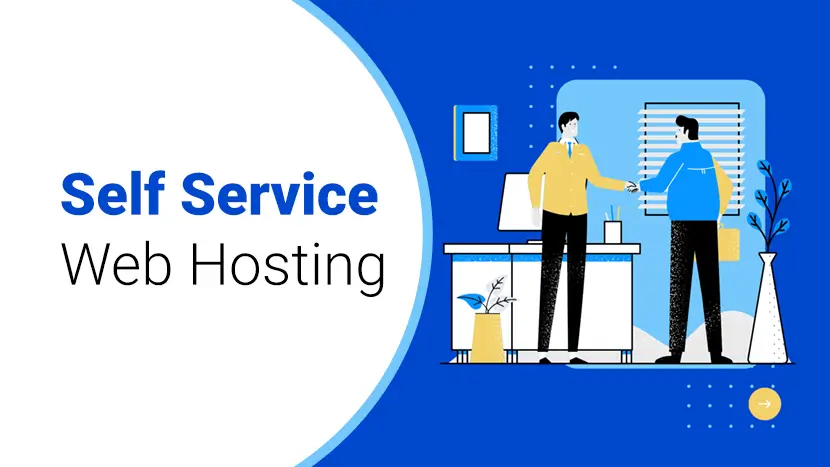
Self-service web hosting is done completely on your own. This is the most advanced web hosting. You need to have a place to rent that stores your server. Then you’re responsible for the cooling, power, bandwidth, hardware, system administrator, backups, etc.
The advantages of self-hosting Service:
- Customize Your Domain Name
- Rankings
- Full Control of Your Website
- Better Technical Support
- Live Chat Option
- More Reliable Back-up
The disadvantages of self-hosting Service:
- Ever-increasing price point
- Changing and toggling platforms can be expensive
- Some time Feature are limited
- Slower, less reliable playback
List of Self Service Web Hosting Service Providers
Read More : You can explore here 30+ Best Web Hosting Providers 2023
Video - Best Web Hosting For Small Business
Affordable Website Hosting for your domainIf you found this article helpful, we encourage you to share it on your social media platforms—because sharing is caring! For more information about article submissions on our website, feel free to reach out to us via email.
Send an emailWritten by RGB Web Tech
Latest Technology Trends
Latest technology trends shaping the future, including AI advancements, blockchain innovation, 5G connectivity, IoT integration, and sustainable tech solutions. Explore breakthroughs in quantum computing, cybersecurity, augmented reality, and edge computing. Stay ahead with insights into transformative technologies driving innovation across industries and revolutionizing how we live, work, and connect.
What is Cluster Web Hosting?
Last updated on January 19, 2025 by RGB Web Tech

Cluster hosting is sometimes confused with Cloud or Grid hosting. It is simply a group of servers that operate together and act as one “mega” server. The big difference between cluster hosting and cloud hosting is cluster hosting is over a smaller area. For instance, there could be a cluster of servers along the eastern coast of the United States.
Cluster host is typically billed on an hourly or monthly rate.
Advantages of Clustering Servers
- Clustering servers is completely a scalable solution. You can add resources to the cluster afterwards.
- If a server in the cluster needs any maintenance, you can do it by stopping it while handling the load over to other servers.
- Among high availability options, clustering takes a special place since it is reliable and easy to configure. In case of a server having a problem providing the services furthermore, other servers in the cluster can take the load.
Disadvantages of Clustering Servers
- Cost is high. Since the cluster needs good hardware and a design, it will be costly compared to a non-clustered server management design. Being not cost effective is a main disadvantage of this particular design.
- Since clustering needs more servers and hardware to establish one, monitoring and maintenance is hard. Thus increase the infrastructure.
List of Cluster Hosting Service Providers:
Read More : You can explore here 30+ Best Web Hosting Providers 2023
Video - Best Web Hosting For Small Business
Affordable Website Hosting for your domainIf you found this article helpful, we encourage you to share it on your social media platforms—because sharing is caring! For more information about article submissions on our website, feel free to reach out to us via email.
Send an emailWritten by RGB Web Tech
Latest Technology Trends
Latest technology trends shaping the future, including AI advancements, blockchain innovation, 5G connectivity, IoT integration, and sustainable tech solutions. Explore breakthroughs in quantum computing, cybersecurity, augmented reality, and edge computing. Stay ahead with insights into transformative technologies driving innovation across industries and revolutionizing how we live, work, and connect.
Best Domain Name Provider
Last updated on January 19, 2025 by RGB Web Tech
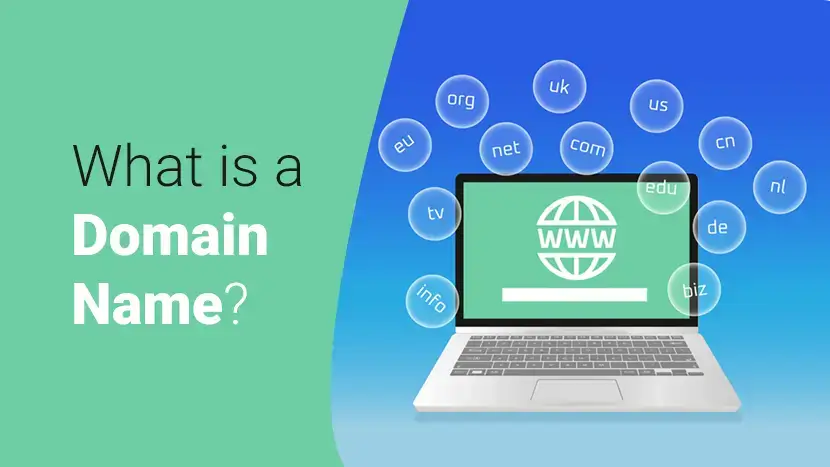
Choosing a domain name is an important decision for any website owner. If you’re wondering what domain names mean, you’re not alone. The following information will shed some light on the subject matter.
Definition of Domain Name
A domain name is used to recognize one or more IP addresses. Domain names are used in URLs to recognize Web pages. For instance, in the URL https://www.rgbwebtech.com, the domain name is rgbwebtech.com.
Since the Web is supported by IP addresses, every Web server must have a Domain Name System or DNS server. A DNS server translates domain names into IP addresses.
Each domain name that exists has a suffix that displays which ‘top level domain’ it belongs to. What is a domain name suffix? Here are a few examples:
- .com – Commercial business
- .gov – Government agencies
- .org – Non-profit organizations
- .net – Network organizations
- .mil – Military agencies
- .edu – Education facilities
- .ca – Canada
- .uk – Europe
- .th – Thailand
Best Domain Name Providers
If you want to explore more domain name plans, here is some domain name services provider companies as below:
Read More : You can explore here 30+ Best Web Hosting and Domain name Providers 2023
Registering a Domain Name
It is a simple process to register your domain name. Simply choose a web hosting site, choose your domain name, and pay the registration fee. However, it is not as simple if the domain name you have chosen is already taken. All reputable domain registration websites use WHOIS to determine eligible domain names. WHOIS can also show you the owner of the domain name you have chosen which is not available.
Choose a domain registration website which offers more than purchasing your domain name. Do your research on prices and services offered. You will need services to host your website as well. Otherwise, no one will find your domain. You will also benefit if you choose a domain registration website which offers services such as fixing your domain and how to help your website gain traffic.
Your web hosting plan does not necessarily have to be purchased through the same site as the domain registration. However, the convenience of having all your services under one roof is beneficial and cost-effective for most e-commerce website owners.
Choosing a Domain Name
Choosing a domain name is not always the easiest part of creating a successful website. You need a domain name that is creative, brand worthy, and easy to remember. However, the one you choose for your business might not be available. While this can be frustrating, there are ways to make it easier.
Domain Name Generators
Using a reputable domain name generator reduces the amount of time you spend trying to find an available domain name. Domain name generators use an algorithm to filter through thousands and thousands of available names and suffixes.
When your chosen domain name is not available, you can use suggestions that will add prefixes or suffixes, abbreviations or other variations of that domain name. Most domain name generators provide available suggestions.
Tips for Choosing a Domain Name
The following tips will help you in narrowing down your options.
1. Brandable: While a generic domain name is convenient and easier than sifting through thousands of options, a creative domain name is brandable. Customers will remember it when they think of your products and services building your brand in the process.
2. Get Creative: Google, Yahoo, and Pepsi are all made up words, which through marketing strategies has worked well for their companies. Use a thesaurus when you have trouble coming up with words that mean the same as your keywords. A catchy domain name that is easy to say and spell will stick with targeted customers.
3. Short and Easy to Type: Use words customers can easily spell. Do not use the slang version as it will cause misspelled domain names, lead to the wrong IP address, and loss of customers to the competition.
4. Use keywords :Keywords in your domain name that describe your business make it easy for customers to remember. Search engines also like keywords in the domain name.
5. Do not use hyphens or numbers : Often numerical numbers get written out, and hyphens are misplaced or not used at all. If another domain name is similar to yours, you will lose this customer to the competition.
6. Use .com : You may have noticed there are multiple top-level domain (TLD) extensions available to use. However, using .com, which is the most recognized and thought of TLD, will ensure customers get to your website.
7. Protect Your Domain Name : It is a good marketing strategy to buy as many variations of your domain name as possible. All variations are then forwarded to your top-level domain name which you will use for your website and all marketing purposes. Typo squatters trying to steal customers will use variations of your domain to trick customers into thinking their website is yours, the one they were looking for.
8. Long-term thinking : The top-level domain name you choose is tied to your brand and your business for life, like a marriage. If you decide to change it in the future, you are going to be starting from scratch again. It will cost you in branding, SEO marketing, and possibly the loss of customers.
Also, in long-term thinking, consider the niche you have chosen. Are you comfortable staying within that niche, or do you have dreams of expanding to different niches? This is a business-making decision that needs to be made in the beginning. You will have a hard time expanding to different niches with the same domain name and could lose the chance of loyal customers following you on your business adventures.
1. Now What : What do you do after choosing your domain name? What if you are not ready to use it yet? No worries, you will not lose the domain name you have finally chosen to purchase.
2. Park it : If you are not ready to create a website or use the new domain name for your new email address, you will not lose the domain name. Your domain registration provider or web hosting service has options for you to park it until you are ready.
3. Use it for email : Having your new domain name means you can now send and receive emails using it. It will be personalized, unique and more professional than a Yahoo, Hotmail, or another temporary account. Get a webmail, e-mail package or buy a web hosting package which usually includes e-mail for your new domain.
4. Create a new website : Build it yourself or use a professional web design service. Tell the world what you have to offer or what is important to you.
5. Sell It : Domain names can make great investments. Build a single ‘For Sale’ page and point your domain at that. Many such websites have been created just for brokering domain names.
What are the benefits of a domain name?
There are so many websites in the world already, does having a custom domain name still make a difference? On a basic level, domain names affect how easily your potential customers can find you on search engines, and what a visitor’s first impression of your service will be. The short answer, then, is yes: domain names are important.
What are the tangible benefits to having a domain name?
Domain names can benefit your business by helping you to:
- Reach your target market
- Maintain brand ownership
- Be memorable (get found easily by customers)
- Build an online presence
- Set expectations
- Develop credibility
- Boost your SEO
- Compete with other businesses
- Grow and expand
Benefits of Domain Names: For the Business
1. Connect with your market : A bespoke, high quality domain name enables you to speak directly to your specific corner of the market by setting more precise expectations regarding what your business has to offer. This saves you – and your customers – time and enables you to connect with them clearly and quickly.
2. Control your brand : If you don’t secure your preferred business domain name, you run the risk of somebody else purchasing it and losing control of your brand. Even if you’re not sure you’ll want to use it, buying a domain name for your business benefits you by ensuring that no one else can secure your name and potentially siphon you customers (or even maliciously damage your reputation). For example, if you’re the proprietor of Holly’s Handbags, you’ll want to have a domain as similar to Hollyshandbags.com as possible.
3. Be remembered and get found online : A domain name helps you stand out and be memorable. Having a site with a ‘.blog’ before your name doesn’t exactly help customers find you in a quick search and makes it hard to remember your business’s URL. Buying a domain name can help you solve this problem and ensure your clients remember you and can find you whenever they need.
4. Online presence, Identity and branding : Your site’s name allows you to communicate something to your visitor about what your services are and what your core message is. Used correctly, a name can contribute to your overall reputation and branding – and we all know that a good reputation means more customers and sales. A good domain name basically helps you set up a vision for your business’s identity, and secure better online visibility.
5. Add a layer of credibility and professionalism to your business : Having a personal domain name is a good sign that your company is trustworthy, and should be taken seriously.
6. Increase your site’s SEO : This is all about how your website appears to (and on) search engines. Having a relevant domain name that directly links to your service or product and the words people commonly use to search for these is sure to impact on your website’s ranking.
Of course, there are a myriad of factors that can affect how a site ranks on search engines like Google. That said, a good domain name can definitely bolster your site’s ranking on search engines and help drive more traffic to it.
7. Develop a competitive edge : A personal domain name puts you on a more even playing field in comparison to big companies, helping you compete alongside every one of your competitors – even if they’re much bigger.
To put it bluntly, every well-known business has an independent domain name these days. As such, a unique domain name is just part of the process of starting a business in 2023. It can form a big part of your growth, and might even be the first step to your business’s long success.
Benefits of Domain Names: For the Consumer
1. You may be wondering: what are the benefits of an independent domain name from the consumer’s perspective? When it comes to the consumer, the advantages of having a domain name largely boil down to expectations and finding the relevant services quickly.
2. They know what to expect : For a potential customer, an accurate domain name is how it helps you to understand the kind of business you’re dealing with and what to expect from it. For instance, if you spotted a website called ‘onlyorchids.com’, but you were actually looking to buy a bouquet of roses for your mother, you’d immediately know from the domain name that the flowers on offer from this business weren’t for you.
3. Save time : Domain names help weed out irrelevant results on a search engine, helping potential customers find the exact services they’re looking for more quickly and cutting down on unnecessary searching time. The end result? Consumers are able to get a better sense of all the relevant businesses offering a particular service through a quick search.
All in all, the benefits of domain names for your consumers can’t be overlooked. Whilst your site’s name only represents one part of creating a business, domain names do play a role in helping consumers connect to the services they’re looking for quickly and with ease. They set expectations, helping consumers identify exactly what a business is offering and whether it is for them.
FAQs - Registering a Domain Name
1. What is a domain name?
Answer : A domain name enables your customers to access your website through the world wide web.
2. Why do I need a domain name?
Answer : A domain name serves as a distinct identity on the word wide web. If you would like to promote yourself, take your business online, etc. a domain name is a must.
3. Is there a character limit for a domain name?
Answer : Yes, the minimum character limit for a domain name is one and maximum 63 characters.
4. How do I protect the contact information associated with my domain name?
Answer : Domain Privacy Protection hides the domain registrant's personal information from the public WHOIS database.
5. Is Privacy Protection worth it?
Answer : The contact information for all domain owners is available in the WHOIS directory. You can protect your personal information by opting for Domain Privacy Protection. We hide your information from public view.
6. Besides a domain name, what else do I need to have a website?
Answer : Apart from purchasing a domain name, you need to develop your website, blog. There are several options to host your website. For eg., Content Management System (a.k.a. CMS) such as WordPress, Magento, Drupal, Joomla or hire a developer to code your website. You can also have a look at the various web hosting plans.
7. How do I restore a deleted domain from the redemption grace period?
Answer : If a domain name is not renewed within the Renewal Grace Period, it would be queued for deletion at the end of the Renewal Grace Period and subsequently Deleted.
8. What are some tips when choosing a name?
Answer : Search for a domain name that's easy for people to remember and spell. This approach can help establish your brand and credibility. Unless your brand name is already well established, purposeful misspellings will just confuse potential clients and website visitors.
9. How do I choose a domain that stands out?
Answer : Every domain is unique, just like every physical address or telephone number. But you want a domain that really sets you apart and reflects your brand, style or personality – the type of domain name that clients will be sure to remember.
10. What if I need help choosing the right domain?
Answer : If you're still feeling stumped in your domain name search, you can reach out to our amazing support team, who are always on standby to talk to you and help you with your domain name registration.
Conclusion
These were the top domain name registrants in India. The aim of this blog was to give you an idea regarding where to purchase domain names. While purchasing, always remember that the right domain name brings in more credibility and traffic to your business. To conclude, a domain name builds your brand hence do not delay purchasing a domain and always use the right site to make the purchase.
We can now conclude that the overall best Domain Registrars are Bluehost, Hostinger, ScalaHosting etc.
Video - Best Web Hosting and Domain Name Provider
Affordable Website Hosting for your domainIf you found this article helpful, we encourage you to share it on your social media platforms—because sharing is caring! For more information about article submissions on our website, feel free to reach out to us via email.
Send an emailWritten by RGB Web Tech
Latest Technology Trends
Latest technology trends shaping the future, including AI advancements, blockchain innovation, 5G connectivity, IoT integration, and sustainable tech solutions. Explore breakthroughs in quantum computing, cybersecurity, augmented reality, and edge computing. Stay ahead with insights into transformative technologies driving innovation across industries and revolutionizing how we live, work, and connect.
What is an SSL certificate? - Secure Sockets Layer
Last updated on January 19, 2025 by RGB Web Tech

An SSL certificate is a digital certificate that authenticates a website's identity and enables an encrypted connection. SSL stands for Secure Sockets Layer, a security protocol that creates an encrypted link between a web server and a web browser.
Companies and organizations need to add SSL certificates to their websites to secure online transactions and keep customer information private and secure.
In short: SSL keeps internet connections secure and prevents criminals from reading or modifying information transferred between two systems. When you see a padlock icon next to the URL in the address bar, that means SSL protects the website you are visiting.
Since its inception about 25 years ago, there have been several versions of SSL protocol, all of which at some point ran into security troubles. A revamped and renamed version followed — TLS (Transport Layer Security), which is still in use today. However, the initials SSL stuck, so the new version of the protocol is still usually called by the old name.
Comprehensive security and protection for your domain and server
In the modern, connected world, security is a growing concern. Protection of online personal data and privacy from hackers and identity thieves is more important today than ever before. The need for online security, data encryption and protection has increased to the extent that search engines have started penalizing websites that don’t provide secure browsing. In an era where your website can be accessed from just about any internet-enabled device – including mobile phones, tablets, web-enabled home appliances, smart-watches and other smart wearables, you cannot afford to not offer a secure environment to your website visitors.
When a Secure Sockets Layer (SSL) Certificate is installed on your website, it creates a secure browsing environment through the HTTPS protocol. It provides security for sensitive information related to usernames and passwords, credit card and bank information. Search engines like SSL certs and reward websites by increasing their ranking position. Customers tend to trust secure https websites more, so when your website shows up as secure in search engines, searchers are more likely to click on your listing. In turn, this will improve your website traffic and conversion rates. Data is kept safe between web servers, and customers do not need to worry about their information being intercepted. Without an SSL certificate, data sent to the server without encryption can be easily intercepted by hackers or criminals and used for harmful purposes.
How does an SSL Certificate work?
SSL Certificates use a secure transaction called a public key cryptography. This cryptography uses two keys, one is public, and one is private. The public key is used to encrypt messages or information sent over your server. When there is a request for information from a browser, the private key is used to unlock the encrypted message or information as it passes from your server to the browser. The information cannot be accessed anywhere in between the website and server without the private key. A website where the SSL certificate is installed correctly will show its domain name starting with HTTPS instead of HTTP.
SSL Certificates must be obtained from a trusted Certificate Authority with Root Certificates. To have a trusted Certificate, the end user should have the Root Certificate on their machine. If the Root Certificate is not present, the end user will receive error messages. This can cause the end user to bounce off your entrusted website and find a company which is trusted.
How to Install a SSL Certificate?
Flying Cow Design’s engineering team will install the SSL Certificate onto your server. This will ensure a secure connection with all website browsers and your website server. Once your SSL Certificate is successfully installed, you will notice your website address changes from HTTP to HTTPS; meaning it is secure. You and your customers will notice a padlock or ‘green’ address bar, indicating it is a secure website. You can also purchase SSL certificates from us. Check prices below.
How do SSL certificates work?
SSL works by ensuring that any data transferred between users and websites, or between two systems, remains impossible to read. It uses encryption algorithms to scramble data in transit, which prevents hackers from reading it as it is sent over the connection. This data includes potentially sensitive information such as names, addresses, credit card numbers, or other financial details.
The process works like this:
- A browser or server attempts to connect to a website (i.e., a web server) secured with SSL.
- The browser or server requests that the web server identifies itself.
- The web server sends the browser or server a copy of its SSL certificate in response.
- The browser or server checks to see whether it trusts the SSL certificate. If it does, it signals this to the web server.
- The web server then returns a digitally signed acknowledgement to start an SSL encrypted session.
- Encrypted data is shared between the browser or server and the webserver.
This process is sometimes referred to as an "SSL handshake." While it sounds like a lengthy process, it takes place in milliseconds.
When a website is secured by an SSL certificate, the acronym HTTPS (which stands for HyperText Transfer Protocol Secure) appears in the URL. Without an SSL certificate, only the letters HTTP – i.e., without the S for Secure – will appear. A padlock icon will also display in the URL address bar. This signals trust and provides reassurance to those visiting the website.
To view an SSL certificate's details, you can click on the padlock symbol located within the browser bar. Details typically included within SSL certificates include:
- The domain name that the certificate was issued for
- Which person, organization, or device it was issued to
- Which Certificate Authority issued it
- The Certificate Authority's digital signature
- Associated subdomains
- Issue date of the certificate
- The expiry date of the certificate
- The public key (the private key is not revealed)
Why you need an SSL certificate
Websites need SSL certificates to keep user data secure, verify ownership of the website, prevent attackers from creating a fake version of the site, and convey trust to users.
If a website is asking users to sign in, enter personal details such as their credit card numbers, or view confidential information such as health benefits or financial information, then it is essential to keep the data confidential. SSL certificates help keep online interactions private and assure users that the website is authentic and safe to share private information with.
More relevant to businesses is the fact that an SSL certificate is required for an HTTPS web address. HTTPS is the secure form of HTTP, which means that HTTPS websites have their traffic encrypted by SSL. Most browsers tag HTTP sites – those without SSL certificates – as "not secure." This sends a clear signal to users that the site may not be trustworthy – incentivizing businesses who have not done so to migrate to HTTPS.
An SSL certificate helps to secure information such as:
- Login credentials
- Credit card transactions or bank account information
- Personally identifiable information — such as full name, address, date of birth, or telephone number
- Legal documents and contracts
- Medical records
- Proprietary information
Types of SSL certificate
There are different types of SSL certificates with different validation levels. The six main types are:
- Extended Validation certificates (EV SSL)
- Organization Validated certificates (OV SSL)
- Domain Validated certificates (DV SSL)
- Wildcard SSL certificates
- Multi-Domain SSL certificates (MDC)
- Unified Communications Certificates (UCC)
Extended Validation certificates (EV SSL)
This is the highest-ranking and most expensive type of SSL certificate. It tends to be used for high profile websites which collect data and involve online payments. When installed, this SSL certificate displays the padlock, HTTPS, name of the business, and the country on the browser address bar. Displaying the website owner's information in the address bar helps distinguish the site from malicious sites. To set up an EV SSL certificate, the website owner must go through a standardized identity verification process to confirm they are authorized legally to the exclusive rights to the domain.
Organization Validated certificates (OV SSL)
This version of SSL certificate has a similar assurance similar level to the EV SSL certificate since to obtain one; the website owner needs to complete a substantial validation process. This type of certificate also displays the website owner's information in the address bar to distinguish from malicious sites. OV SSL certificates tend to be the second most expensive (after EV SSLs), and their primary purpose is to encrypt the user's sensitive information during transactions. Commercial or public-facing websites must install an OV SSL certificate to ensure that any customer information shared remains confidential.
Domain Validated certificates (DV SSL)
The validation process to obtain this SSL certificate type is minimal, and as a result, Domain Validation SSL certificates provide lower assurance and minimal encryption. They tend to be used for blogs or informational websites – i.e., which do not involve data collection or online payments. This SSL certificate type is one of the least expensive and quickest to obtain. The validation process only requires website owners to prove domain ownership by responding to an email or phone call. The browser address bar only displays HTTPS and a padlock with no business name displayed.
Wildcard SSL certificates
Wildcard SSL certificates allow you to secure a base domain and unlimited sub-domains on a single certificate. If you have multiple sub-domains to secure, then a Wildcard SSL certificate purchase is much less expensive than buying individual SSL certificates for each of them. Wildcard SSL certificates have an asterisk * as part of the common name, where the asterisk represents any valid sub-domains that have the same base domain. For example, a single Wildcard certificate for *website can be used to secure:
- Payments.yourdomain.com
- Login.yourdomain.com
- Mail.yourdomain.com
- Download.yourdomain.com
- anything.yourdomain.com
Multi-Domain SSL Certificate (MDC)
A Multi-Domain certificate can be used to secure many domains and/or sub-domain names. This includes the combination of completely unique domains and subdomains with different TLDs (Top-Level Domains) except for local/internal ones.
For example:
- www.example.com
- Example.org
- Mail.this-domain.net
- Example.anything.com.au
- Checkout.example.com
- secure.example.org
Multi-Domain certificates do not support sub-domains by default. If you need to secure both www.example.com and example.com with one Multi-Domain certificate, then both hostnames should be specified when obtaining the certificate.
Unified Communications Certificate (UCC)
Unified Communications Certificates (UCC) are also considered Multi-Domain SSL certificates. UCCs were initially designed to secure Microsoft Exchange and Live Communications servers. Today, any website owner can use these certificates to allow multiple domain names to be secured on a single certificate. UCC Certificates are organizationally validated and display a padlock on a browser. UCCs can be used as EV SSL certificates to give website visitors the highest assurance through the green address bar.
It is essential to be familiar with the different types of SSL certificates to obtain the right type of certificate for your website.
How to obtain an SSL certificate
SSL certificates can be obtained directly from a Certificate Authority (CA). Certificate Authorities – sometimes also referred to as Certification Authorities – issue millions of SSL certificates each year. They play a critical role in how the internet operates and how transparent, trusted interactions can occur online.
The cost of an SSL certificate can range from free to hundreds of dollars, depending on the level of security you require. Once you decide on the type of certificate you require, you can then look for Certificate Issuers, which offer SSLs at the level you require.
Obtaining your SSL involves the following steps:
- Prepare by getting your server set up and ensuring your WHOIS record is updated and matches what you are submitting to the Certificate Authority (it needs to show the correct company name and address, etc.)
- Generating a Certificate Signing Request (CSR) on your server. This is an action your hosting company can assist with.
- Submitting this to the Certificate Authority to validate your domain and company details
- Installing the certificate they provide once the process is complete.
Once obtained, you need to configure the certificate on your web host or on your own servers if you host the website yourself.
How quickly you receive your certificate depends on what type of certificate you get and which certificate provider you procure it from. Each level of validation takes a different length of time to complete. A simple Domain Validation SSL certificate can be issued within minutes of being ordered, whereas Extended Validation can take as long as a full week.
Can an SSL certificate be used on multiple servers?
It is possible to use one SSL certificate for multiple domains on the same server. Depending on the vendor, you can also use one SSL certificate on multiple servers. This is because of Multi-Domain SSL certificates, which we discussed above.
As the name implies, Multi-Domain SSL Certificates work with multiple domains. The number is left up to the specific issuing Certificate Authority. A Multi-Domain SSL Certificate is different from a Single Domain SSL Certificate, which – again, as the name implies – is designed to secure a single domain.
To make matters confusing, you may hear Multi-Domain SSL Certificates, also referred to as SAN certificates. SAN stands for Subject Alternative Name. Every multi-domain certificate has additional fields (i.e., SANs), which you can use to list additional domains that you want to cover under one certificate.
Unified Communications Certificates (UCCs) and Wildcard SSL Certificates also allow for multi-domains and, in the latter case, an unlimited number of subdomains.
What happens when an SSL certificate expires?
SSL certificates do expire; they don't last forever. The Certificate Authority/Browser Forum, which serves as the de facto regulatory body for the SSL industry, states that SSL certificates should have a lifespan of no more than 27 months. This essentially means two years plus you can carry over up to three months if you renew with time remaining on your previous SSL certificate.
SSL certificates expire because, as with any form of authentication, information needs to be periodically re-validated to check it is still accurate. Things change on the internet, as companies and also websites are bought and sold. As they change hands, the information relevant to SSL certificates also changes. The purpose of the expiry period is to ensure that the information used to authenticate servers and organizations is as up-to-date and accurate as possible.
Previously, SSL certificates could be issued for as long as five years, which was subsequently reduced to three and most recently to two years plus a potential extra three months. In 2020, Google, Apple, and Mozilla announced they would enforce one-year SSL certificates, despite this proposal being voted down by the Certificate Authority Browser Forum. This took effect from September 2020. It is possible that in the future, the length of validity will reduce still further.
When an SSL certificate expires, it makes the site in question unreachable. When a user's browser arrives at a website, it checks the SSL certificate's validity within milliseconds (as part of the SSL handshake). If the SSL certificate has expired, visitors will receive a message to the effect of — "This site is not secure. Potential risk ahead".
While users do have the option to proceed, it is not advisable to do so, given the cybersecurity risks involved, including the possibility of malware. This will significantly impact bounce rates for website owners, as users rapidly click off the homepage and go elsewhere.
Keeping on top of when SSL certificates expire presents a challenge for larger businesses. While smaller and medium-sized businesses (SMEs) may have one or only a few certificates to manage, enterprise-level organizations that potentially transact across markets – with numerous websites and networks – will have many more. At this level, allowing an SSL certificate to expire is usually the result of oversight rather than incompetence. The best way for larger businesses to stay on top of when their SSL certificates expire is by using a certificate management platform. There are various products on the market, which you can find using an online search. These allow enterprises to see and manage digital certificates across their entire infrastructure. If you do use one of these platforms, it is important to log in regularly so you can be aware of when renewals are due.
If you allow a certificate to expire, the certificate becomes invalid, and you will no longer be able to run secure transactions on your website. The Certification Authority (CA) will prompt you to renew your SSL certificate before the expiration date.
Whichever Certificate Authority or SSL service you use to obtain your SSL certificates from will send you expiration notifications at set intervals, usually starting at 90 days out. Try to ensure that these reminders are being sent to an email distribution list — rather than a single individual, who may have left the company or moved to another role by the time the reminder is sent. Think about which stakeholders in your company are on this distribution list to ensure the right people see the reminders at the right time.
How to tell if a site has an SSL certificate
The easiest way to see if a site has an SSL certificate is by looking at the address bar in your browser:
- If the URL begins with HTTPS instead of HTTP, that means the site is secured using an SSL certificate.
- Secure sites show a closed padlock emblem, which you can click on to see security details – the most trustworthy sites will have green padlocks or address bars.
- Browsers also show warning signs when a connection is not secure — such as a red padlock, a padlock which is not closed, a line going through the website's address, or a warning triangle on top of the padlock emblem.
How to ensure your online session is safe
Only submit your personal data and online payment details to websites with EV or OV certificates. DV certificates are not suitable for eCommerce websites. You can tell if a site has an EV or OV certificate by looking at the address bar. For an EV SSL, the organization's name will be visible in the address bar itself. For an OV SSL, you can see the organization's name's details by clicking on the padlock icon. For a DV SSL, only the padlock icon is visible.
Read the website's privacy policy. This enables you to see how your data will be used. Legitimate companies will be transparent about how they collect your data and what they do with it.
Look out for trust signals or indicators on websites. As well as SSL certificates, these include reputable logos or badges which show the website meets specific security standards. Other signs that can help you determine if a site is real or not include checking for a physical address and telephone number, checking their returns or refunds policy, and making sure prices are believable and not too good to be true.
Stay alert to phishing scams. Sometimes cyber attackers create websites that mimic existing websites to trick people into purchasing something or logging in to their phishing site. It is possible for a phishing site to obtain an SSL certificate and therefore encrypt all the traffic that flows between you and it. A growing proportion of phishing scams occur on HTTPS sites — deceiving users who feel reassured by the padlock icon's presence.
To avoid these kinds of attacks:
- Always examine the domain of the site you are on and ensure it is spelled correctly. The URL of a fake site might differ by only one character – e.g., amaz0n.com instead of amazon.com. If in doubt, type the domain directly into your browser to make sure you are connecting to the website you intend to visit.
- Never enter logins, passwords, banking credentials, or any other personal information on the site unless you are sure of its authenticity.
- Always consider what a particular site is offering, whether it looks suspicious, and whether you really need to register on it.
- Make sure your devices are well protected: Kaspersky Internet Security checks URLs against an extensive database of phishing sites, and it detects scams regardless of how "safe" the resource looks.
Cybersecurity risks continue to evolve but understanding the types of SSL certificates to look out for and how to distinguish a safe site from a potentially dangerous one will help internet users avoid scams and protect their personal data from cybercriminals.
SSL Certificate Providers
If you want to explore SSL Certificate plans, here is some SSL Certificate services provider companies as below:
Read More : You can explore here 30+ Best Web Hosting Providers 2023
Video - Best Web Hosting For Small Business
Affordable Website Hosting for your domainIf you found this article helpful, we encourage you to share it on your social media platforms—because sharing is caring! For more information about article submissions on our website, feel free to reach out to us via email.
Send an emailWritten by RGB Web Tech
Latest Technology Trends
Latest technology trends shaping the future, including AI advancements, blockchain innovation, 5G connectivity, IoT integration, and sustainable tech solutions. Explore breakthroughs in quantum computing, cybersecurity, augmented reality, and edge computing. Stay ahead with insights into transformative technologies driving innovation across industries and revolutionizing how we live, work, and connect.
Wildcard SSL Certificates - Multi-Domain Security
Last updated on January 19, 2025 by RGB Web Tech
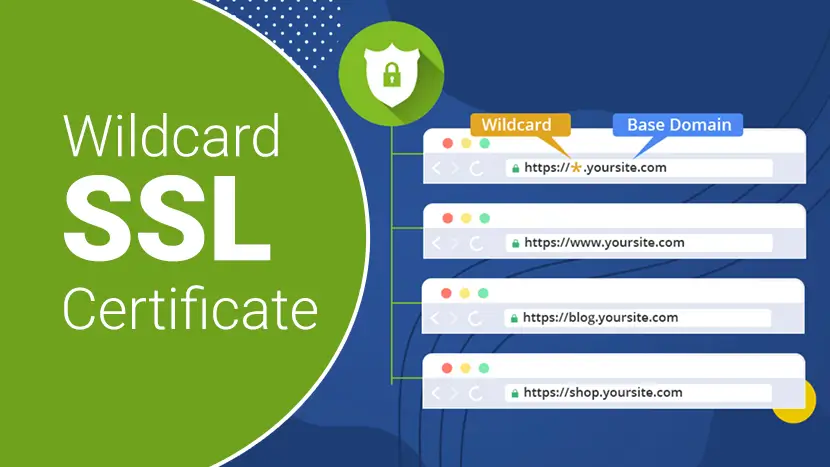
Wildcard SSL certificates are a must-have if you are managing multiple subdomains on the same primary domain. The protection of a single certificate provides security for various subdomains across multiple web servers saving you time and money. With secure browsing becoming increasingly important for search engines, investing in wildcard SSL certificates is becoming increasingly important for businesses with multiple subdomains.
What is a wildcard SSL certificate?
The wildcard SSL certificate is an online resource for multi-domain security, allowing you to secure your main domain along with an unlimited number of subdomains associated with it. When purchasing the wildcard SSL certificate, place an asterisk (*) in front of the domain name like *thisismywebsite.com. The asterisk allows you to own all rights to other first-level subdomains that could be associated with it, such as mail.thisismywebsite.com, products.thisismywebsite.com, and secure.thisismywebsite.com regardless of whether the subdomains are hosted on the same web server or spread across multiple servers.
This extended validation makes it incredibly easy to keep your website protected and secure. Additionally, certifying your website this way means you will not have to purchase individual SSL certificates for each sub domain of your site. When visitors see the certificate authority, they will know any information they put on your website will be secure. It also ensures that you would not be behind your competition on SEO compliance with search engines almost mandating https security through SSL certificates.
How Wildcard SSL Certificate work
Wildcard SSL certificates are also called multi-domain certificates. They use the same validation method as regular SSL certificates. The only difference is that this type of SSL certificate covers multiple domains allowing you to secure more than just one domain.
Wildcard SSL Certificate Features
Below are some of the features of our multi-domain SSL certificates:
- They secure an unlimited number of subdomains on a primary domain.
- We offer a simple purchase and installation process. We also offer assisted installation.
- Subdomains can be on the same web server or spread across multiple servers.
- Our certificates are issued in minutes after domain validation.
- Cross-browser compatibility and support.
- Supports most popular content management systems including WordPress, Drupal, Joomla, etc.
- Seamless HTTPS browsing to facilitate secure browsing mandated by most search engines.
- Ideal for B2B brochureware websites, e-commerce websites and more.
- We offer 256-bit SSL encryption with our SSL certificates
- An easy to use console to manage your SSL certificates.
Wildcard SSL Certificate Benefits
The idea of using a multi-domain wildcard SSL certificate to secure all your secondary domains is certainly intriguing. Here is a quick rundown of a few benefits you will have:
- You can choose the appropriate encryption strength, 40 to 256 bits, for your website, thus giving you the flexibility you need to keep your website running smoothly.
- Wildcard SSL certificates are issued in a short amount of time, meaning your website sub-domains will be secured and protected quickly.
- This SSL certificate comes with a privacy and security guarantee. This is no ordinary benefit, especially if you want to secure a secondary domain for emailing purposes. Your clients want to ensure their messages are kept private and seeing a Wildcard SSL certificate will assure them of their encrypted privacy.
- Finally, these certificates allow you to recertify your website (and any new secondary domain names) within the lifespan of the original certificate. It is just another way you can guarantee that your online space will be protected and authenticated without the hassle of needing to buy new SSL certificates.
- You can rest easy knowing your website is protected by vulnerability scanning making it virtually hacker proof.
A vital part of any website
No matter what you use your website for, be it to sell your products or to simply blog your opinions, a Wildcard SSL certificate will keep your users (and your information) exactly where it belongs: on your website.
Wildcard SSL Certificates Providers
Read More : You can explore here 30+ Best Web Hosting Providers 2023
Video - Best Web Hosting For Small Business
Affordable Website Hosting for your domainIf you found this article helpful, we encourage you to share it on your social media platforms—because sharing is caring! For more information about article submissions on our website, feel free to reach out to us via email.
Send an emailWritten by RGB Web Tech
Latest Technology Trends
Latest technology trends shaping the future, including AI advancements, blockchain innovation, 5G connectivity, IoT integration, and sustainable tech solutions. Explore breakthroughs in quantum computing, cybersecurity, augmented reality, and edge computing. Stay ahead with insights into transformative technologies driving innovation across industries and revolutionizing how we live, work, and connect.
What is FTP? - File Transfer Protocol
Last updated on January 19, 2025 by RGB Web Tech
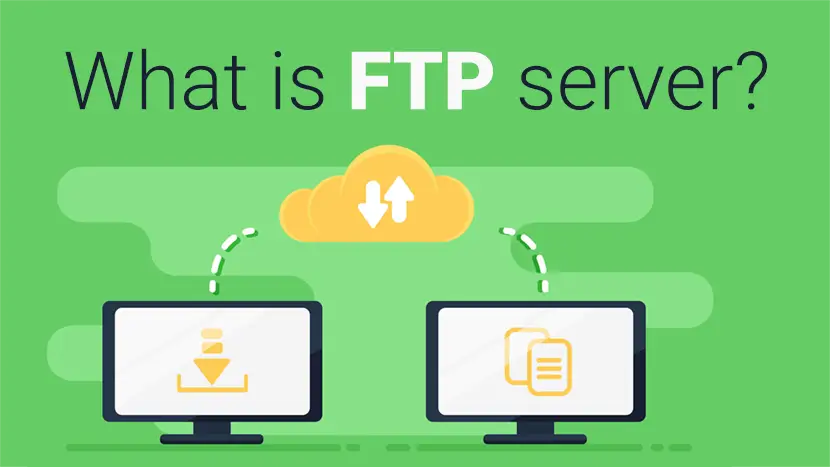
FTP stands for File Transfer Protocol. It is a client program for transferring files from one computer to another computer. If you are developing a website, you can create web pages using some type of web page editor and then send the files to the server where your web site will be hosted. All of this is done through a system called File Transfer Protocol (FTP).
Where do you Find an FTP Program?
You can search the internet for FTP client companies that offer a free download of the FTP system, or they may offer the download on a trial basis, usually thirty or sixty days. If you are already working with a web hosting company, or a web site management hosting service which may be helping you develop your web site, they may have some suggestions as to which FTP client companies offer the greatest value.
Set Up Procedure
Once you have downloaded the FTP program on your computer, and have established an account with a home page hosting provider that uses the file transfer protocol system, you are ready to begin the set up procedure. After you open the FTP client, you need to fill in some boxes, such as Profile Name, which would be the name of your web site. The next box would be Host Name, which is the name of your hosting provider, who has the server where your web site is located. It will then ask for your User ID and password. Use the same User ID and password that you used when you initially signed on with your hosting provider. After you successfully sign in and all settings are in place, click OK. You will then be connected to the host server. When files show up on your computer screen, you know you are on the right track.
Transferring Files
How you set up the files that you want to transfer is entirely up to you, but to keep things straight as to which ones have, or have not been transferred, set up your own system and follow it the same way every time. It will save you time and headaches. You can now transfer files from your computer to the hosting server by double clicking, or clicking on the arrow on your computer screen. To transfer files from your hosting server to your computer is the same process, but in reverse. Renaming files, deleting files or creating new folders using the FTP client software is just as easy as doing it with a flash drive or other storage device.
Check it out.
Sign out of your FTP system program, and look at your web site. Verify that everything you input or changed on your web site is where it should be, and looks as it should. If everything is in place, you successfully transferred files from your computer to your website.
Top Web Hosting Providers
If you want to explore more web hosting plans, here is some web hosting services provider companies as below:
Read More : You can explore here 30+ Best Web Hosting Providers 2023
Video - Best Web Hosting For Small Business
Affordable Website Hosting for your domainIf you found this article helpful, we encourage you to share it on your social media platforms—because sharing is caring! For more information about article submissions on our website, feel free to reach out to us via email.
Send an emailWritten by RGB Web Tech
Latest Technology Trends
Latest technology trends shaping the future, including AI advancements, blockchain innovation, 5G connectivity, IoT integration, and sustainable tech solutions. Explore breakthroughs in quantum computing, cybersecurity, augmented reality, and edge computing. Stay ahead with insights into transformative technologies driving innovation across industries and revolutionizing how we live, work, and connect.
What does dot com stand for?
Last updated on January 19, 2025 by RGB Web Tech

In order to understand the meaning of .com, you must learn a few basics. First understand that the .com comes at the end of the webmaster’s domain name, or URL. What .com stands for is a website that has some type of “commercial” intent. These sites are considered to be top level domain addresses.
When did .Com become Established on the Internet?
The Internet was launched in 1989. At this time, .com was used for commercial sites. Businesses that were establishing themselves on the Internet often listed themselves as .com, and were recognized as reputable businesses.
However, just because a business has the ending of .com does not mean that the business is licensed. There are many storefronts on the Internet that are merely net businesses, and a license is not required in order to conduct business on the net.
What Does .com Stand for Today?
Today, .com still stands for “commercial”. However, .com is no different from other domain addresses available such as .net, .org and so on. Today, anyone can get a .com domain address, which is quite simple to do, and is not in the least, expensive. In fact, getting a domain address is one of the most affordable pieces of property, considering the great power of the Internet to earn a lucrative living.
How Do I get a .Com Domain Address?
In order to get a .com domain address, you must first consider your brand or service and then choose a domain name. Domain names are most often chosen by the webmaster, or site owner, but they can also be purchased. There are many domain name businesses that have a variety of relevant domain names for specific niches, which can be purchased. Ballistic Domains is a good example of a company that sells domain names.
Many site owners wish to choose their own domain name as it is less expensive. When you are considering choosing your domain name, it is important to have the most relevant name to your brand or service, or make it the name of the business. For instance, Nike is Nike.com. Something that is very easy to remember, as you are searching for the actual brand name to conduct your business.
When you have chosen your domain name, the next step is to get it registered. There are various sites online that allow you to submit and register your domain name. This is the easiest of the steps and takes only a few minutes.
It is also essential to find out if your domain name is available. If the name is available, you will have the choice to purchase it for a year or longer. Domain names are purchased for a specific period of time. The process is simply accessing a site and submitting your choice of domain name ending in .com, .biz, .mobi etc and selecting the length of time you wish to register it for.
Best Domain Name Providers
If you want to explore domain name plans, here is some domain name services provider companies as below:
Read More : You can explore here 30+ Best Web Hosting Providers 2023
Video - Best Web Hosting For Small Business
Affordable Website Hosting for your domainIf you found this article helpful, we encourage you to share it on your social media platforms—because sharing is caring! For more information about article submissions on our website, feel free to reach out to us via email.
Send an emailWritten by RGB Web Tech
Latest Technology Trends
Latest technology trends shaping the future, including AI advancements, blockchain innovation, 5G connectivity, IoT integration, and sustainable tech solutions. Explore breakthroughs in quantum computing, cybersecurity, augmented reality, and edge computing. Stay ahead with insights into transformative technologies driving innovation across industries and revolutionizing how we live, work, and connect.
The Advantages of VPS Hosting for Your E-Commerce Start-Up
Last updated on January 19, 2025 by RGB Web Tech

Your e-commerce business is ready to go to the next level, but you aren't sure if you should continue with your shared hosting account or upgrade to a Virtual Private Server (VPS). This is not a decision to be taken lightly because the website is the heart of any e-commerce operation. Here are some compelling reasons why VPS is the best choice.
Shared Hosting Limitations
Many shared hosting providers claim that you will have unlimited resources and the ability to run dozens of programs that can be installed with a single click using software such as Fantastico. They will promise you the moon to sign you up.
However, make sure to read the fine print. There is no such thing as "unlimited" disk space, bandwidth, or CPU usage. When your e-commerce business grows, and your website runs several scripts to offer all that incredible functionality to customers, your hosting will hit a wall.
Avoid a Shared SSL Certificate
Some shared hosting providers lower their costs, and your prices, by offering a shared SSL certificate. SSL ("secure sockets layer") is a protocol that creates a secure connection between the client and server. So imagine the uncertainty your customers will feel when they see a warning message that the SSL certificate does not match your domain name. It is likely that this will drive off your customers.
For this reason, shared hosting should be considered for an e-commerce website only in two situations:
You are setting up a fully functional prototype website as a precursor to your actual hosted site.
You are setting up a niche website where customers already have a relationship with you and are not likely to get put off by slow speeds and shared SSL certificates.
VPS: A Happy Beginning for E-Commerce
No one wants to spend more money than necessary, but a business can really suffer if it's trying to run on limited resources. Although the initial outlay may be slightly larger, it is vital to get the server choice right the first time. Make sure to select a provider that will be able to support the business for at least a year, to avoid having to switch to a new hosting provider midstream.
However, that does not mean that you must choose dedicated hosting (or colocation) right away. Dedicated hosting tends to be too expensive for most self-funded e-commerce startups. The good news is that VPS comes in as a happy compromise. Initial costs can be as low as $15-$20 per month.
How Does VPS Work?
VPS involves a shared server that is "split" into several virtual servers by use of virtualization software. These servers are imaginary (since they are all just one server, not several), but they are strictly defined and managed by the virtualization software. Based on the hardware setup you purchase, the virtual computer will be allocated with the specified number of CPU's, RAM, disk space, and bandwidth. Many hosts allow for automatic expansion beyond these resources while others enforce them strictly.
Benefits of VPS
All the advantages of a VPS over shared hosting arise from the fact that the resources are isolated and pre-allocated. Here are some of the key benefits:
Isolation from the Activity of Others on the Same Host
If another user on your host's services is misbehaving, this will have little to no impact on your VPS service. If another user's activities crash their server, it won't crash yours. In fact, only their virtual machine crashes. This has no impact on the physical server on which the virtual machines are run.
Guaranteed Speed
No matter what anyone else is doing on another VPS hosted on the same machine, you are guaranteed your speed. If you have two CPU's allocated to you, then you will always have those two CPU's available to your operations. The amount of RAM you have paid for in a VPS setting will always be available to your operations, regardless of what else is happening on the physical machine.
If you have used shared hosting before, you know that its speed varies based on the time of day and the amount of traffic on the websites of other users. Your resources are being distributed on a first-come-first-served basis. This never happens on VPS services. Your resources are dedicated to your e-commerce website.
Guaranteed Stability
While shared hosting is notorious for hiccups, VPS does not experience any such interruptions. Again, this is due to the virtualization software, which divides the resources, making a dedicated machine with dedicated resources for your e-commerce site.
Guaranteed Space
Many shared hosting providers that claim to provide unlimited disk space shield themselves in some kind of "fair use" clause. In other words, the resources must be fairly shared between all users of that server. That translates to limited disk space. With VPS hosting, you never have to worry about that. You have an agreed upon disk space that is paid for monthly and is reserved exclusively for you. It sits there, either used or unused, but paid for and allocated to you.
Root Access
If you are technically strong, you might need root access to install some programs. You will never get root access in shared hosting. Root access begins at the VPS level of hosting. Make sure to read the manual or talk to your hosting provider if you think you might need root access.
VPS is the way to go for a serious e-commerce startup. Shared hosting is an adequate environment for testing. When it comes to taking the plunge, however, budget for a VPS plan. It is much cheaper than dedicated hosting while being much more robust than shared hosting.
List of Popular Web Hosting Service Providers
Read More : You can explore here 30+ Best Web Hosting Providers 2023
Video - Best Web Hosting For Small Business
Affordable Website Hosting for your domainIf you found this article helpful, we encourage you to share it on your social media platforms—because sharing is caring! For more information about article submissions on our website, feel free to reach out to us via email.
Send an emailWritten by RGB Web Tech
Latest Technology Trends
Latest technology trends shaping the future, including AI advancements, blockchain innovation, 5G connectivity, IoT integration, and sustainable tech solutions. Explore breakthroughs in quantum computing, cybersecurity, augmented reality, and edge computing. Stay ahead with insights into transformative technologies driving innovation across industries and revolutionizing how we live, work, and connect.
6 Types of Website Design for your Website or Blog
Last updated on January 19, 2025 by RGB Web Tech

With 94% of first impressions relying on website design, you must create a beautifully crafted website for your business or blog. But when you get started with web design service or looking for a web design package, you may not know what approach to take with your website. What types of web design are best for your business or blog?
Luckily for you, we have got all the answers. Keep reading to learn about six types of web design and the pros and cons of each:
- One Page Website
- Responsive Website
- Static Website
- Dynamic Layout
- Liquid Website
- Adaptive Website
Plus, we will cover the different types of websites you can create, so you can determine which one is best for your business! Need some marketing inspiration?
Subscribe to our email newsletter for more updates!
6 Types of Web Design for your Website or Blog
Ready to build your website but are not sure which web design format is best? Here are six of the most common web design layouts for your business and the pros and cons of each.
1. One Page Website
We will cover on our list of types of web design as a one page layout website. As the name implies, a one page layout website uses only a single page that users scroll down to find information about your products or services. With this design layout, you can have a “Navigation Menu” with links to specific points of your page.
Pros of Single Page Website:
- Easy to create.
- Can help you create a clean and simple website.
Cons of Single Page Website:
- Can not be used for businesses that sell products online.
- Can not be used for companies that need multiple pages.
- Can deter people away if the single page is too long and requires too much scrolling.
2. Responsive Website
Next on our list of types of website layouts is responsive design layout website. This layout format is the most popular type, as it allows your site to accommodate all devices and fill the browser size perfectly. Responsive design is built with a mobile first approach.
You create your mobile layout first, and then you expand your website for bigger browser sizes. So instead of trying to trim down your website and make it smaller, you start small and build it bigger.
Pros of Responsive Website:
- Get a website that’s built for mobile users.
- Delivers a seamless experience on all devices.
- Do not have to build a separate mobile site.
Cons of Responsive Website:
- Takes more time to build and develop.
3. Static Website
Most basic type of website design is a static page layout website. With this layout, you build a website with pre-set page dimensions. It has a permanent width. Static layouts stick to these dimensions, regardless of the browser or device type.
Static layouts have phased out with the rise of mobile usage. Since these sites do not adapt to devices, they do not provide a positive user experience on smartphones or tablets. While static layouts are still an option, you typically do not want to use them unless you are creating a completely separate mobile version of your site.
Pros of Static Website:
- Easy to set up.
Cons of Static Website:
- Not responsive to devices or browsers.
- Requires creating a separate mobile site (more work).
4. Dynamic Website
When you look at a list of the types of web design, you will see that the dynamic website layout is an option. Dynamic website layouts are great for people who do not have extensive HTML knowledge. These websites can deliver different content to website visitors, even if two separate people look at the same page.
With a dynamic website vs. static website, you build a database of information and features. Then, when a user requests a page, the web coding automatically works to put the components together from your database to form the webpage.
Pros of Dynamic Website:
- Interactivity with users.
- Increased functionality for users.
- Less coding skills required.
Cons of dynamic Website:
- Can be more complex to set up with different functionalities.
- Tend to load slower because of all the different elements and page compositions.
5. Liquid Website
Next on this list of types of website design is liquid design layout website. This layout, also known as Fluid Design, uses flexible units rather than the fixed units static layouts use. Since the units are flexible, the page will always fill the width with the device’s screen, regardless of what device it is.
Because user experience is critical to your site driving and engaging traffic, liquid layouts have also started to phase out as a viable option for businesses. While you can still use this layout, you risk delivering a poor user experience from your site stretching too far or squishing information together on the page.
Pros of Liquid Website:
- Easier to set up than responsive design
- No information gets cut off on pages
Cons of Liquid Website:
- If a browser is really wide, information gets stretched to fit the screen and can look unappealing
- If a browser is smaller, information gets smooshed together to fit the screen, making it difficult to read and browse
6. Adaptive Website
One web design format you can use for your site is adaptive website layout. As the name implies, this website uses CSS queries to adjust the website’s size to detect the size of the browser. Adaptive websites will automatically alter the website’s layout to provide the best user experience for visitors.
With adaptive website layouts, there are set parameters for how a website will adjust. For example, a set parameter may look like this: “If the browser is 500 pixels wide, set the main content container for 400 pixels wide.” For example, if you have a website with a two-column layout, the adaptive layout would change into a single-column design on a small browser screen.
Pros of Adaptive Website:
- Easy to set up.
- Takes less development time than responsive layouts.
- Can adjust your website according to each browser size.
Cons of Adaptive Website:
- Device widths in between set points can cause your site to have too much space or not enough space.
- Is not fully responsive.
Types of website layouts
Here is a list of different website layouts and which sites benefit the most from them:
1. F-shape layout
The f-shape layout creates a website design that follows the general viewing pattern of the site's visitors. Scientific studies have found that website users often view and move their eyes across a web page creating an F or E shape. Webpages that design their layout to match those instinctive eye movements can help capture visitors' attention more naturally. These types of layouts are most common for websites that display a lot of options for users to choose from, such as news websites and search engines, allowing users to scan the options quickly and make a decision.
2. Z-shape layout
The z-shape layout is very similar to the f-shape layout, except it targets a different group of individuals. Scientific studies have shown that individuals from western cultures use a z shape with their eyes more often than an f shape to navigate the pages of different websites. Z-shape layouts are often most effective for websites that have a singular goal, such as having consumers sign up for a service or purchase a product. Creating a button that navigates users to the next step of company interaction and placing it along the z-shape path can help increase customer outreach and revenue.
3. Grid of cards layout
A grid of cards layout displays information in a grid system that users or website visitors can easily manipulate by adjusting the size of the browser window or screen. Some of the most common sites that use a grid of cards layout are video streaming websites that display image previews for their different video options. They display each of the previews as cards in a grid system, and the number of visible video options changes based on the size of the screen.
A grid layout is great for websites, like video streaming services, that display a lot of options and information of equal value, which can help users find what they're looking for more easily.
4. Boxes layout
The boxes layout uses one larger box as a website's header, which displays an image and two smaller boxes underneath that provide additional images or information for users. Each box gives the user important or engaging information about the company's or website's purpose and links the user to other dynamic web pages they can explore to find more helpful information. Because the boxes can prominently display images, artists often use this layout to show their portfolio and businesses use it to display featured products.
5. Split screen layout
A split screen layout divides a website into two sections that users can choose to explore. This layout works well for companies and organizations that have two pieces of content that are equally important to their business and consumers. For example, a clothing company that sells women's and men's clothing might use the split screen layout to advertise their products. Having both options on the front webpage can allow users to pick which one they're looking for quickly and continue exploring the site.
6. Fixed sidebar layout
The fixed sidebar layout places a stationary menu of options for users on the left or right side of the webpage. This sidebar menu provides visitors with quick and helpful navigation choices, allowing them to explore the website more easily. The fixed sidebar layout often works best with websites that have a limited number of webpages to choose from, such as businesses that sell one major product. For example, if a company that sold watches used a fixed sidebar, some of their menu options could include: about us, online store and contact us.
7. Magazine layout
The magazine layout uses a design that resembles printed publications. This design displays a lot of information to visitors by using a system of columns and grids to help individuals navigate the webpage more easily. The magazine layout is often used by publication companies to resemble how their product might look in its printed form, which can help create a fun and engaging format for users, motivating them to continue reading and exploring.
8. Asymmetrical layout
Asymmetrical layouts ensure that the webpage promotes an uneven design, meaning one half of the page is often larger than the other. Companies and organizations often use this layout to create an aesthetically pleasing web page while directing users to a certain area of the site.
For example, a business might use the larger section of the website to display an image or company slogan, while using the smaller side to encourage users to fill out their contact information to learn about special sales and promotions. The smaller section often attracts the visitor's attention, encouraging them to engage with the website or company. Because of its ability to entice users, the asymmetrical layout is often used on a website's homepage.
Featured image layout
The featured image layout places a prominent and large image at the top of the webpage to attract users. Most often, the featured image is a picture of a popular product that a company or business is selling. Companies that sell aesthetically pleasing products often use this type of layout to immediately attract visitors' attention and encourage them to make a purchase. For example, a company that sells computers might use a featured image layout to display their computers' design and style.
10. Curated visuals layout
The curated visuals layout uses illustrated images to promote a product or service. Companies and organizations often use this layout to display a certain emotion they want users to feel when they use the webpage. This type of advertising strategy can help consumers feel motivated to interact with the company and possibly purchase their goods and services. Most often, businesses or companies with a complicated service that's difficult to sell might use curated visuals to help ease the experience and relay necessary information to users.
Types of websites
4 Types of websites you can create
In addition to narrowing down your list of types of website layouts to the best one, you also must determine what kind of website you need to create for your business. Every business has different needs, which means your site type may differ from others.
Here are four types of websites you can create for your business:
1. Business websites
First on our list is the type of website you can create as a business website. A business website is a standard site. It contains information about your company and the services you offer. If you do not sell products online, you may also build a business site just to showcase what you offer.
These sites are simple and serve as a hub for people to learn about your business. You can use this website type if you are not selling products on your website. For a business website, you can use any of the types of web design listed above. You will want to choose the ones that help you deliver the best experience for your audience.
2. Blog
Second on our list is the type of website you can create as a blog. Blogs are websites that share helpful information with readers about topics in their industry. While a blog may not be your company’s primary website, you may consider creating a blog site if you are doing content marketing.
Content marketing is a crucial strategy for helping your business grow online and build trust with your audience. You may consider having a separate blog website, or integrating it into your core website to help you take advantage of the benefits of content marketing.
This website type can use any type of web design format, except for one page layout website.
The best types of web design layouts for this website type are adaptive and responsive.
3. Ecommerce websites
Another type of website you can create for your business is an ecommerce website. This website type is best for your business if you want to sell products on your site. Ecommerce sites are built to host product pages, add products to a cart, and complete transactions.
If you’re looking to sell products, this website type is best for your business.
In terms of the best types of web design for an ecommerce website, responsive and adaptive are most suitable for an ecommerce site.
4. Membership websites
The last type of website you can create is a membership website. With this website type, you have a paywall for people to enter. Only people who have a membership can enter your site and see your products.
A1truejobs.com is a membership website example. You must create an account and pay the membership fee and become a member of the site.
If you want to use this website type, you can use two types of web design layouts: adaptive or responsive.
Need help figuring out which type of web design is best for you?
With so many types of web design available, it’s challenging to know which type is best for your business. If you’re feeling overwhelmed with building the best website, RGB Web Tech can help you to create a beautiful web design for your business or blog.
Our team experts can help you craft a beautifully designed website that delivers the best experience for your audience. Ready to build your dream website? Contact us online or call us today at +91-9878585860 to speak with a strategist about our web design services and affordable web design packages
If you found this article helpful, we encourage you to share it on your social media platforms—because sharing is caring! For more information about article submissions on our website, feel free to reach out to us via email.
Send an emailWritten by RGB Web Tech
Latest Technology Trends
Latest technology trends shaping the future, including AI advancements, blockchain innovation, 5G connectivity, IoT integration, and sustainable tech solutions. Explore breakthroughs in quantum computing, cybersecurity, augmented reality, and edge computing. Stay ahead with insights into transformative technologies driving innovation across industries and revolutionizing how we live, work, and connect.
3 Main Types of Web Development
Last updated on January 19, 2025 by RGB Web Tech
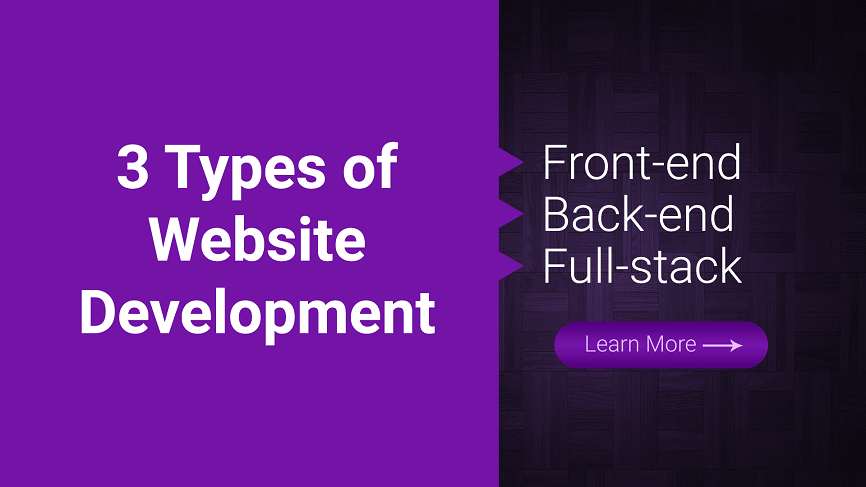
Web development is simply associated with building a website. It can range from a plain static HTML website or a full-blown complex web-based application. It is mainly about programming to create web pages or applications that can run in any web browser.
Do you know how many websites are on the world wide web as of now?
The answer is 1.8 billion websites are on the WWW as of now.
As you are reading this blog, the number might have sharply increased, and it consistently will.
In this competitive era of web development, understanding each web development type, its technology, and the factors influencing website development cost is crucial.
What are the Different Types of Web Development?
Prior to understanding the web development process, it is crucial to understand the three main types of web development. Let us discuss the types and their related technologies. This will help you to understand how each web development type plays an essential role in building web solutions.
- Front-end Web Development
- Back end Web Development
- Full-stack Web Development
1. Front-end Web Development
Front-end web development is known as client-side web development. It is a procedure of designing the user interface of the website with front-end technologies like HTML, CSS, and JavaScript.
The aim of developing the front end of the website is to allow website visitors to read the web content effortlessly. To motivate you to build a clean and beautiful website interface, the front-end developers / web designers need to write efficient and clean code. Front-end web design cost will be dependent on the size of web project and complexity of web project or you can request a quote.
Which are the languages used in Front-End Development?
1. HTML
HTML ( HyperText Markup Language ) is the standard markup language for documents designed to be displayed in a web browser. It can be assisted by technologies such as Cascading Style Sheets and scripting languages such as JavaScript.
- Web designers use HTML to design the structure and layout of the website.
- Design highly interactive pages.
- Most of the static pages are designed using HTML
2. CSS
CSS ( Cascading Style Sheets ) is a style sheet language used for describing the presentation of a document written in a markup language such as HTML or XML. CSS is a cornerstone technology of the World Wide Web, alongside HTML and JavaScript.
- The web designer uses CSS that will enhance website layout and presentation.
- CSS helps to design a webpage using HTML code.
- CSS is widely used by designers and developers to style a website.
3. JavaScript
JavaScript, often abbreviated to JS, is a programming language that is one of the core technologies of the World Wide Web, alongside HTML and CSS. As of 2022, 98% of websites use JavaScript on the client side for webpage behavior, often incorporating third-party libraries.
- To make your website interactive, for example, when searching a query on Google or clicking on a button to change the page, there is JavaScript working behind.
- To enhance user engagement, implementing JavaScript on your website is crucial. For example, when you open Gmail and click on inbox, rather than loading the entire page, a smooth transition will happen and the page will load.
2. Back-end Web Development
Back-end development is also known as server-side web development. The responsibilities of back-end developers are writing code and building the logical parts of the entire website. It mainly focuses on back-end logic, databases, servers, and APIs.
In the web project, the logical part relies on the backend, you may not see the technology used behind developing a website. However, back-end web development is a crucial part of a website. Back-end web development cost will be dependent on the size of web project and complexity of web project or you can request a quote
Which are the languages used in Back-End Development?
1. PHP
PHP is an open-source, server-side programming language that can be used to create websites, applications, customer relationship management systems and more. It is a widely-used general-purpose language that can be embedded into HTML.
- Widely known language to manage dynamic content, session tracking, databases, eCommerce websites.
- Integrated with popular databases like MySQL, PostgreSQL, and Oracle
2. Python
Python is a computer programming language often used to build websites and software, automate tasks, and conduct data analysis. Python is a general-purpose language, meaning it can be used to create a variety of different programs and is not specialized for any specific problems.
- Developers find Python easier to learn and code.
- Ability to create a framework that is used by any website.
- Pinterest and Instagram are powered by Python.
3. Java
Developers use Java to construct applications in laptops, data centers, game consoles, scientific supercomputers, cell phones, and other devices. Java is the world's third most popular programming language, after Python and C – according to the TIOBE index, which evaluates programming language popularity.
- Java is used to build websites, games, apps, and software.
- According to Oracle, Java is used by 6 million developers, and it is powering 5.5 billion devices.
4. Dot NET
.NET is a free, cross-platform, open source developer platform for building many different types of applications. With . NET, you can use multiple languages, editors, and libraries to build for web, mobile, desktop, games, IoT, and more.
- It is a framework, which is used for building software applications using various languages like C#, VB.Net, C++, and F#
5. SQL
SQL is used to communicate with a database. According to ANSI (American National Standards Institute), it is the standard language for relational database management systems. SQL statements are used to perform tasks such as update data on a database, or retrieve data from a database.
- SQL database query language helps to compute large amounts of data.
- Helps to collect data from across databases and utilizes it accordingly to your target audience.
6. AngularJS
AngularJS is a platform and framework for building single-page client applications using HTML and TypeScript. Angular is written in TypeScript. It implements core and optional functionality as a set of TypeScript libraries that you import into your applications.
- It is a type script-based, open-source website development framework.
- Using Angular, you can easily develop web applications.
7. Scala
Scala is used in Data processing, distributed computing, and web development. It powers the data engineering infrastructure of many companies.
8. Perl
Perl is a high-level, interpreted, general-purpose programming language originally developed for text manipulation. It borrows many features from C and Shell script and is used for system administration, networking, and other applications that involve user interfaces.
9. Ruby on Rails
Ruby on Rails is used in all types of industries to build web apps and services. This includes applications like marketing websites, CMSs, eCommerce sites, and custom web applications. It's a popular web framework for startups because its ease of use makes for quick application development with small teams.
10. Rust
Rust is a low-level programming language with direct access to hardware and memory, which makes it a great solution for embedded and bare-metal development. You can use Rust to write operation systems or microcontroller applications.
11. Node JS
Node JS is primarily used for non-blocking, event-driven servers, due to its single-threaded nature. It's used for traditional web sites and back-end API services, but was designed with real-time, push-based architectures in mind.
12. React JS
React JS is a JavaScript library developed by Facebook which, among other things, was used to build Instagram. Its aim is to allow developers to easily create fast user interfaces for websites and applications alike. The main concept of React JS is a virtual DOM.
13. Vue JS
Vue JS is a progressive framework for JavaScript used to build web interfaces and one-page applications. Not just for web interfaces, Vue. js is also used both for desktop and mobile app development with Electron framework.
14. Objective C
Objective-C is the primary programming language used when writing software for OS X and iOS. It's a superset of the C programming language and provides object-oriented capabilities and a dynamic runtime.
15. C#
C# (pronounced "See Sharp") is a modern, object-oriented, and type-safe programming language. C# enables developers to build many types of secure and robust applications that run in dot NET. C# has its roots in the C family of languages and will be immediately familiar to C, C++, Java, and JavaScript programmers.
16. C++
C++ is a fast and strongly-typed programming language which makes it an ideal choice for developing operating systems. Mac OS X has large amounts written in C++. Most of the software from Microsoft like Windows, Microsoft Office, IDE Visual Studio, and Internet Explorer are also written in C++
17. Browser DevTools
Browser DevTools is a set of web development tools that appears next to a rendered web page in the browser. DevTools provides a powerful way to inspect and debug web pages and web apps. You can even edit source files and create website projects, all within the DevTools environment.
18. API
APIs are needed to bring applications together in order to perform a designed function built around sharing data and executing pre-defined processes. They work as the middleman, allowing developers to build new programmatic interactions between the various applications people and businesses use on a daily basis.
19. Git or GitHub
Git or GitHub is a DevOps tool used for source code management. It is a free and open-source version control system used to handle small to very large projects efficiently. Git or GitHub is used to track changes in the source code, enabling multiple developers to work together on non-linear development.
3. Full-stack Web Development
Full-stack web development means the development of both front end and back end. The full-stack web developer should have knowledge of web design, web development, database, and website debugging.
A full-stack developer has the expertise to develop client and server-side web applications and should have database management skills also. Full-stack web developers are well versed in redesigning, building, and speeding up an entire website design and development phase.
Additionally, the responsibilities of full-stack web developers are to search for the web development trends like blockchain, deep learning, and multi-cloud depending upon the projects.
4 Factors to Consider While Choosing a Web Development Language
Along with web development trends, there are essential factors front-end developers and back-end developers should consider while choosing the web development language.
Here are the 4 important factors to consider prior to choosing the web development language.
1. Performance of the Language
Using the language performance benchmark, you get to know how fast the particular web development language will perform. The result might not be exact, but it will give an idea about whether to use a particular language or not.
2. The Deployment Time
The size of the code matters. Because when you plan to deploy your project in a web server / live environment, the optimized and less coded apps will take less time for deployment.
3. Targeted Platform
If you are planning to develop a program for Windows and Linux platforms, then you should develop a program using Java. Because by installing Java Virtual Machine (JVM), your Java program will run on any machine.
4. Easier to Develop and Maintain
The language you choose should be easier to develop and maintain. HTML, Python, Java, and PHP are likely to be easier to maintain. Additionally, web developers are likely to be open to learning these languages.
If you found this article helpful, we encourage you to share it on your social media platforms—because sharing is caring! For more information about article submissions on our website, feel free to reach out to us via email.
Send an emailWritten by RGB Web Tech
Latest Technology Trends
Latest technology trends shaping the future, including AI advancements, blockchain innovation, 5G connectivity, IoT integration, and sustainable tech solutions. Explore breakthroughs in quantum computing, cybersecurity, augmented reality, and edge computing. Stay ahead with insights into transformative technologies driving innovation across industries and revolutionizing how we live, work, and connect.
What is On Page SEO? How to Optimize Web Page
Last updated on January 19, 2025 by RGB Web Tech
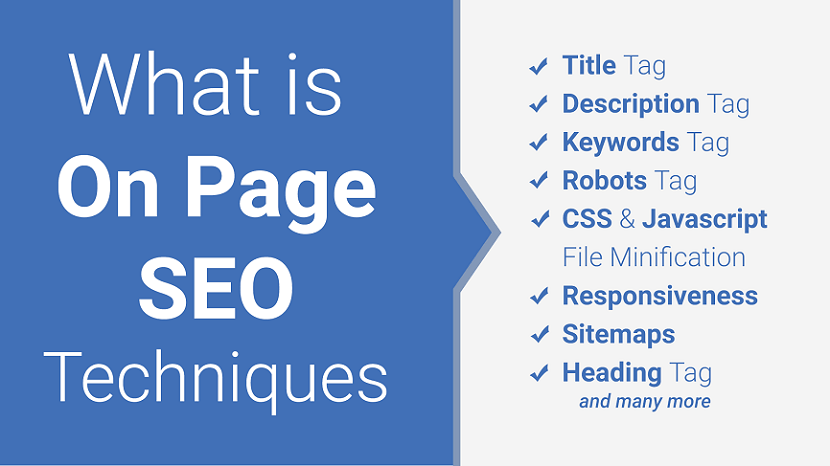
On Page SEO involves the actions that you take on your web pages to gain higher page rank through search engine results. The main technique of On Page SEO is creating high-quality content that online visitors will find useful. On top of it, adding meta tags will enable google bots to identify your content for ranking. Also, make sure to use HTML tags for headings and other elements so that there are no duplicate pages or broken links.
In addition, choose images that are not too large, and add alt tags to all of them. These are some of the On Page SEO techniques. The agency you hire will provide you more details.
If you want your site to rank on Google and increase your brand's organic traffic, you’ll need to look at Off Page SEO, Technical SEO and Local SEO also.
But before you starting SEO also learn techniques of SEO ( White Hat SEO, Black Hat SEO, Gray Hat SEO and Negative SEO )
On Page SEO Techniques
- Meta Title
- Meta Description
- Meta Keywords
- Favicon Icon
- Social Meta Tag
- Meta Robots Tag
- CSS & Javascript File Minification
- Mobile Friendliness / Responsiveness
- Sitemaps Updates (XML, Text, HTML)
- Content Optimization
- SEO-Friendly URLs
- Heading Tag Optimization
- Image Optimization
- Image Alt Text Optimization
- Anchor Title Optimization
- Internal Links optimization
- Use Social Sharing Buttons
- Call to Actions
- Conversion Form
1. Meta Title
A meta title (also called title tag) is an element in the head section of an HTML document that defines the title of each page of a website. It is retrieved by web browsers and also used by search engines such as Google to display a webpage in search results (SERPs). Often the meta title is mistakenly categorized as a meta tag. However, this is not correct since it is a unique HTML element.
Meta Title Examples
Characteristics of a good Meta Title
Below we have summarized the most important points to consider when optimizing your meta titles:
- Optimal length between 55 and 65 characters (maximum 70)
- Combine important keywords to a meaningful sentence
- Most important keyword should come first
- Avoid word repetitions and spelling errors
- Provide a concise and understandable description of the page content
- Use a call-to-action if necessary
- Use individual titles for each page of a website
2. Meta Description
A meta description is an HTML element that provides a brief summary of a web page. A page’s meta description tag is displayed as part of the search snippet in a search engine results page (SERP) and is meant to give the user an idea of the content that exists within the page and how it relates to their search query.
Meta Description Examples
Characteristics of a good meta description
Based on the research we did on this topic, as well as our own experience, we came up with this list of elements you need to write a good meta description:
- Keep it up to 155 characters
- Use active voice and make it actionable
- Include a call-to-action
- Use your focus keyword
- Show specifications, where possible
- Make sure it matches the content of the page
- Make it unique
3. Meta Keywords
Meta keywords are meta tags that you can use to give search engines more information about a page’s content. They’re found in a webpage’s HTML source code, and are not visible to visitors.
Meta Keywords Examples
Do you still need to use meta keywords?
Google hasn’t used the meta keywords tag to help rank web pages for at least a decade. We know this because Matt Cutts, Google’s former Head of the Webspam Team, released a video in 2009 where he said - we don’t use the keywords meta tag in our search ranking.
However, it’s important to remember that there’s more to SEO than Google, so there are a couple of reasons why you might still want to use the keywords meta tag.
- It may still be used by Yandex
- It’s used for some internal site searches
- Create an internal tagging system
4. Favicon Icon
A favicon is a small 16×16 pixel icon that serves as branding for your website. Its main purpose is to help visitors locate your page easier when they have multiple tabs open. Due to their tiny size, favicons work best as simple images or one-to-three characters of text. Favicons are not to be confused with logos but are sometimes the same. Due to its small size and resolution, the favicon may need to be an even smaller size or part of a company’s original logo.
What sizes are needed for a Favicon on each Browser?
As stated above, 16px is generally recommended because it can be used across all browsers, but if you would like to create a favicon for every possible use, then follow the guide below:
- 16px: For general use in all browsers, could be displayed in the address bar, tabs or bookmarks views
- 24px: Pinned Site in Internet Explorer 9
- 32px: New tab page in Internet Explorer, taskbar button in Windows 7+ and Safari ”Read Later” sidebar
- 57px: Standard iOS home screen (iPod Touch, iPhone first generation to 3G)
- 72px: iPad home screen icon
- 96px: Favicon used by the Google TV platform
- 114px: iPhone 4+ home screen icon (twice the standard size for the retina display)
- 128px: Chrome Web Store
- 195px: Opera Speed Dial
5. Social Meta Tag
When sharing an article link, you want your post to look nicely when published on social media. You’d like it to contain a quality image, correct name, description, and URL. Facebook, Twitter and other social media platforms get these parameters from your website. You can control what they pull from the post by including social media meta tags (for example open graph tags) in the html code of your posts.
If the Facebook meta tags (Open Graph meta tags) are present, you determine what’s being displayed in the Facebook post. If you do not include these Open Graph (og) meta properties, Facebook will still display the information about your blog post but probably not in the way you’d want it to. This works analogically with Twitter meta tags, too.
Facebook Social Tag Example
Twitter Social Tag Example
6. Robots Meta Tag
A robots meta tag, also known as robots tags, is a piece of HTML code that's placed in the
section of a web page and is used to control how search engines crawl and index the URL.This is what a robots meta tag looks like in the source code of a page:
Robots tags are page-specific and allow you to instruct search engines on how you want them to handle the page and whether or not to include it in the index.
Indexation-controlling parameters:
- Noindex: Tells a search engine not to index a page.
- Index: Tells a search engine to index a page. Note that you don’t need to add this meta tag; it’s the default.
- Follow: Even if the page isn’t indexed, the crawler should follow all the links on a page and pass equity to the linked pages.
- Nofollow: Tells a crawler not to follow any links on a page or pass along any link equity.
- Noimageindex: Tells a crawler not to index any images on a page.
- None: Equivalent to using both the noindex and nofollow tags simultaneously.
- Noarchive: Search engines should not show a cached link to this page on a SERP.
- Nocache: Same as noarchive, but only used by Internet Explorer and Firefox.
- Nosnippet: Tells a search engine not to show a snippet of this page (i.e. meta description) of this page on a SERP.
- Noodp/noydir [OBSOLETE]: Prevents search engines from using a page’s DMOZ description as the SERP snippet for this page. However, DMOZ was retired in early 2017, making this tag obsolete.
- Unavailable_after: Search engines should no longer index this page after a particular date.
7. CSS & Javascript File Minification
CSS & Javascript minification is the process of removing unneeded code from CSS & Javascript source files, with the goal of reducing file size without changing how the CSS & Javascript file executes in the browser. By stripping unnecessary data from the CSS & Javascript code, minification helps the browser download and process these files faster, increasing page performance and improving user experience.
You can minifier CSS & JavaScript here
- Free Formatter - https://www.freeformatter.com
8. Mobile Friendliness/Responsiveness
Mobile is changing the world. Today, everyone has smartphones with them, constantly communicating and looking for information. In many countries, the number of smartphones has surpassed the number of personal computers; having a mobile-friendly website has become a critical part of having an online presence.
The web is being accessed more and more on mobile devices. Designing your websites to be mobile friendly ensures that your pages perform well on all devices.
You can test here mobile friendliness
9. Sitemaps Updates (XML, Text, HTML)
A sitemap helps search engines discover URLs on your site, but it doesn't guarantee that all the items in your sitemap will be crawled and indexed. However, in most cases, your site will benefit from having a sitemap.
It is also essential to know there are two different types of sitemaps.
- XML sitemaps
- HTML sitemaps
You can Generator Sitemaps for your website here
- XML-Sitemaps - https://www.xml-sitemaps.com
- Small SEO Tools - https://smallseotools.com/xml-sitemap-generator/
10. Content Optimization
Content optimization is the practice of ensuring that your content has the best possible chance of achieving its intended goal, whether that’s to rank in a search engine or to turn leads into conversions.
You can implement a number of basic, time-tested methods to achieve these goals, but it’s not just about performing technical tasks and ticking boxes. Significant marketing and editorial elements to web content optimization need to be covered, too.
Let’s say that you’ve written a great top-of-the-funnel (TOFU) blog that’s related to your core product, and you want to get as many eyes on it as possible. Two to three months after publishing, you check the performance of the post only to find that nobody has seen it.
Why? Well, maybe:
- The keywords you have used have little to no search volume
- You haven’t covered the topic in any real level of detail
- You haven’t used a coherent heading structure, so Google’s bots have had a hard time making sense of your article
- Your title tag doesn’t accurately reflect what the article is about
11. SEO-Friendly URLs
SEO friendly URLs are URLs that are designed to meet the needs of users and searchers. Specifically, URLs optimized for SEO tend to be short and keyword-rich.
Along with your title tag, link anchor text, and the content itself, search engines use your webpage’s URL to understand what your content is all about.
Best practices for creating SEO-friendly URLs.
- Describe your Content
- Include Keywords in URLs
- Use Hyphens to Separate Words
- Use Lowercase Letters in URLs
- Keep URLs Short
- Use Static URLs
- Be Careful with Subdomains
- Limit Folders in URL Structure
12. Heading Tag Optimization
Header tags are HTML tags that tell a browser what styling it should use to display a piece of text on a webpage.
If we looked up the HTML for the heading above, it’d look something like this:
What is a Header Tag?
Like headings in print content, header tags are used to title or introduce the content below them. HTML header tags follow a hierarchy, from h1 to h6.
- H1 tags are used to denote the most important text, such as the main theme or title of a content.
- H2 and H3 tags are commonly used as subheadings.
- Finally, H4, H5, and H6 tags may be used to provide further structure within those subsections.
13. Image Optimization
The majority of a website’s data is typically comprise of images. Website image optimization refines images so as to lighten pages, reduce load times and lessen the burden of network resources, including data usage in the case of mobile data plans.
Image optimization can also increase your search engine optimization (SEO) rankings, as search engines factor in page load speed when ranking sites. The result is significant load savings, an improved user experience and increased site visibility.
Image Optimization Methods
- Image Compression
- Vector Images
- Image Caching
14. Image Alt Text Optimization
Adding images to your posts and product pages encourages people to read them, and well-chosen images can also back up your message and get you a good ranking in image search results. But you should always remember to provide your images with good alt attributes. Because alt text strengthens the message of your pages with search engine spiders and it improves the accessibility of your website.
This is a complete HTML image tag:
Bad Image Alt Text
Good Image Alt Text
Image Alt Text Best Practices
Ultimately, image alt text needs to be specific but also representative of the topic of the webpage it's supporting. Get the idea so far? Here are a few important keys to writing effective image alt text:
- Describe the image, and be specific: Use both the image's subject and context to guide you.
- Add context that relates to the topic of the page : If the image doesn't feature a recognizable place or person, then add context based on the content of the page. For example, the alt text for a stock image of a person typing on a computer could be "Woman optimizing WordPress website for SEO" or "Woman researching free blogging platforms," depending on the topic of the webpage.
- Keep your alt text to fewer than 125 characters : Screen-reading tools typically stop reading alt text at this point, cutting off long-winded alt text at awkward moments when verbalizing this description for the visually impaired.
- Don't start with an alt text of picture : Do not write an alt text of image, write alt text article specific.
- Use your keywords, but sparingly : Only include your article's target keyword if it's easily included in your alt text. If not, consider semantic keywords, or just the most important terms within a longtail keyword. For example, if your article's head keyword is "how to generate leads," you might use "lead generation" in your alt text, since "how to" might be difficult to include in image alt text naturally.
- Don't cram your keyword into every single image's alt text : If your blog post contains a series of body images, include your keyword in at least one of those images. Identify the image you think is most representative of your topic, and assign it your keyword. Stick to more aesthetic descriptions in the surrounding media.
- Review for spelling errors : Misspelled words in image alt text could hurt the user experience or confuse search engines crawling your site. You should review alt text like you would any other content on the page.
15. Anchor Title Optimization
Anchor text is the clickable text that appears in a hyperlink.
It's designed to stand out from the rest of the text so that users know it can be clicked on. So it should have a different color than regular text. (Often, it’s blue.) Other stylistic elements, like an underline, can be added.
Anchor text should indicate to users what kind of page they’ll be taken to if they click the link.
These are most common types of anchor text you can use on your site:
- Branded
- Brand + Keyword
- Exact Match
- Partial Match Keywords
- Related Keywords
- Naked Link
- Generic
16. Internal Links optimization
An internal link is any link from one page on your website to another page on your website. Both your users and search engines use links to find content on your website. Your users use links to navigate through your site and to find the content they want to find. Search engines also use links to navigate your site. They won’t see a page if there are no links to it.
It’s crucial for your site’s SEO to evaluate and improve internal linking strategy regularly. It’s one of the ways to improve the fitness of your website. By adding the right internal links, you make sure Google understands:
- The relevance of pages
- The relationship between pages
- The value of pages
17. Use Social Sharing Buttons
Social share buttons give customers the ability to display their ecommerce purchases on Facebook, Twitter, Pinterest or other platforms. The majority of online shoppers also use at least one form of social media, so these buttons create free promotion for an online store. Include this feature on individual product pages to call attention to particular items. Social share buttons also add convenience for users who want to post a particular product by removing the extra steps of copying, pasting and posting to a separate website.
18. Call to Actions
A call-to-action, also known as a CTA, is a clickable button or link on your site or in your email, or on your ad. You want people to click your CTA. You call them to action. Typically, these actions look like this:
- Download
- Submit
- Subscribe
- Sign up
- Purchase
19. Conversion Form
Form conversion is when a website visitor completes and successfully submits an online form from a homepage, landing page, or any other page on a website. Form conversion is a micro-conversion, which leads to a macro-conversion such as a newsletter sign-up or a purchase.
Why is form conversion important?
Creating straightforward, easy-to-complete forms is key to a successful conversion rate optimization (CRO) strategy, and form submissions are usually the final hurdle in the conversion process.
It’s easy to overlook the value of a well-designed form. It’s not nearly as exciting as choosing bold imagery or writing persuasive copy, but it’s just as important to the user experience.
If a visitor starts to fill out your form, you’ve already sold them on the idea of converting—you’ve successfully countered their objections, and they’re willing to give you their personal information. Having to enter their data (name, email address, phone number, credit card info, etc.) requires trust and effort though, so if the form isn’t straightforward and easy to fill out, your visitor might move on to the next website.
FAQs - On Page SEO
1. What is On Page SEO?
On Page SEO (also known as on-site SEO) refers to the practice of optimizing web pages to improve a website's search engine rankings and earn organic traffic. In addition to publishing relevant, high-quality content, On Page SEO includes optimizing your headlines, HTML tags (title, meta, and header), and images.
2. What are the benefits of On Page SEO?
On Page SEO helps search engines analyze your website and the content connected to it so that it can identify if a searcher's query is relevant to your site. Google is constantly updating their algorithm so that it can better understand a searcher's intent and deliver search results that meet that user's needs.
3. Is On Page SEO different from technical SEO?
On Page SEO optimizes at the page level, while technical SEO deals with sitewide issues such as crawlability, overall site speed, information architecture, sitewide internal linking, etc.
Final Thoughts
Now that you have a better idea of On Page SEO signals, make sure you keep them in mind with every page you create.
Using the On Page SEO Checker, you can also find plenty of On Page Optimization ideas for potential quick wins.
That being said, the most important part of any SEO strategy is patience. Great results take time, effort, and some trial and error to get right.
On Page SEO may seem overwhelming, but our digital marketing service and experts are here to help you with anything you need to know more about Off Page SEO, Technical SEO and Local SEO.
If you found this article helpful, we encourage you to share it on your social media platforms—because sharing is caring! For more information about article submissions on our website, feel free to reach out to us via email.
Send an emailWritten by RGB Web Tech
Latest Technology Trends
Latest technology trends shaping the future, including AI advancements, blockchain innovation, 5G connectivity, IoT integration, and sustainable tech solutions. Explore breakthroughs in quantum computing, cybersecurity, augmented reality, and edge computing. Stay ahead with insights into transformative technologies driving innovation across industries and revolutionizing how we live, work, and connect.
What is Off Page SEO? How can you take Advantage of it
Last updated on January 19, 2025 by RGB Web Tech
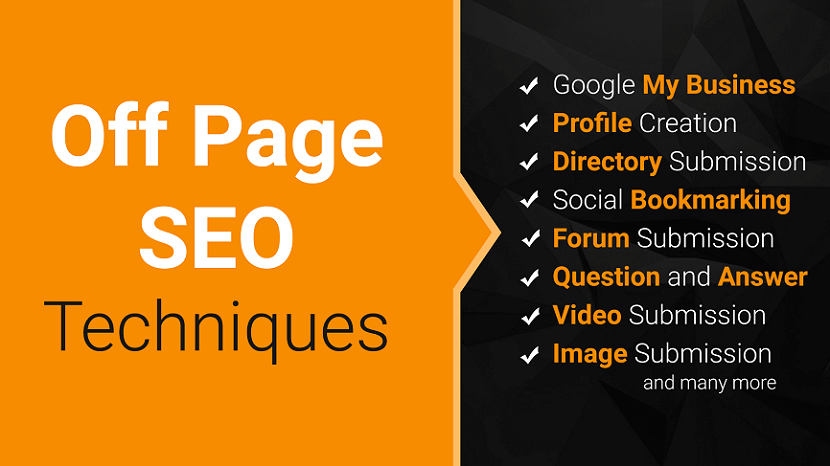
Off Page SEO is one of the essential parts of a successful SEO strategy. We’ll share what it is, how it works, and how to use it to increase your site’s visibility.
If you want your site to rank on Google and increase your brand's organic traffic, you’ll need to look at On Page SEO, Technical SEO and Local SEO also.
But before you starting SEO also learn techniques of SEO ( White Hat SEO, Black Hat SEO, Gray Hat SEO and Negative SEO )
What is Off Page SEO?
Off Page SEO refers to all SEO tactics that do not involve updating or publishing content to your website.
In the past, many used “Off Page SEO” and “Link Building” interchangeably, but in reality, there are many Off Page SEO tactics you can use, including:
- Brand Building
- Citation Building
- Content Marketing
- Social Media, and more
These tactics help both search engines and users better understand your website and increase your site’s authority, trust, and relevance.
Think of it like this:
- Your website=On Page SEO
- Another site or platform=Off Page SEO
Why is Off Page SEO important?
Think about Off Page SEO as building your site’s domain authority. Without this, your site might struggle to outrank websites with higher authority.
Higher authority websites tend to rank better than those with low or no authority because search engines consider them more credible, relevant, and trustworthy.
You want to signal that many people trust, share, and reference your site to search engines. Links are one way to show that, but you can not focus on link building alone. There are many other Off Page SEO Techniques you can use—let’s take a look at a few.
Top 20 Off Page SEO Techniques to increase Ranking and Domain Authority
Below are the tested and proven off page SEO techniques that can be implemented for all the niches to increase the website ranking and domain authority.
- Social Bookmarking
- Directory Submission
- Article Submission
- Classified Submission
- Social Networking
- Forum Submission
- Press Release
- Search Engine Submission
- Video Submission
- Story Submission
- Image Submission
- RSS Feed Submission
- Web 2.0 Submission
- Digital Portfolio Submission
- Blog Commenting
- Blog Submission
- Infographic Submission
- PDF Submission
- Government Backlink
- SEO News
- Wiki Submission
- Ping Submission
- Profile Creation Sites
- Creating Shareable Content
- Influencer Outreach
- Local Citation
- Convert Brand Mention
- Use Google My Business
- Question and Answer
1. Creating Shareable Content
Amazing content is always the KING in search engine optimization. Creating amazing and shareable content is a smart way to generate more and more natural backlinks to our website or blog. Research often and keep your content always fresh and updated.
Here’s what we’ll be talking about:
- Find Out What’s Trending
- Engage With Your Community
- Tie in Pop Culture
- Use Lists
- Write Long-Form Content
- Interviews With Influencers
- Include Images
- Include Social Sharing Buttons
- Write Killer Headlines
- Create Outstanding Content
2. Influencer Outreach
If you have created any kind of share-worthy content, don’t hesitate to reach out to relevant influencers and ask them to share. Tell them to check your blog and ask for linkbacks from their blog. Make sure you get the links from completely relevant domains.
Here are some tips for Influencer Outreach
- Prior to Influencer Outreach, Research Top Candidates
- Establish Connections with Your Potential Influencers
- Contact Them About a Campaign
- Be Clear About Your Expectations
- Make the Partnership Mutually Beneficial
- Create Great Content
- Think Long Term: Nurture Your Relationships
3. Contribute as Guest Author
There are a number of good and quality blogs that are open for guest posts from various authors. Write an amazing research piece and reach them with the content for the guest posts. Don’t focus on the number of links but rather focus only on quality links. Also, don’t keep posting multiple times on the same guest blog site.
How to Attract Guest Authors to Your Site
- Make Sure You are Consistently Producing New and Quality Content
- Create Mutual Social Connections
- Make Yourself Known Amongst That Writer’s Circles
- Have a Clear Set of “Write For Us” Guidelines on Your Site
- Bring Up Any Way You Might be Connected
- Show That You Really Know and Love the Author’s Work
- Offer Metrics About Your Website or Where You Plan to Take it in the Coming Months
- Vet the backlinks
- Create a replacement page
- Do outreach
- Ranking higher for local search queries (maybe)
- Helping people discover your business online
- Structured citations
- Unstructured citations
- Get listed with the data aggregators
- Submit to other core sites
- Submit to popular industry and local sites
- Pursue unstructured citations
- Have a proper description with 250 characters.
- Make sure your primary is available in the first paragraph along with your city name.
- Regularly update the posts or gallery or products or offers.
- Keep watching your reviews and reply to them instantly.
- Upload real photos under proper categories.
- Keep sharing the great content
- Update the site regularly
- Build a backlink for a published article
- Versions of URLs with and without "www"
- URLs with and without "index.html" at the end
- Variants of URLs with "HTTP" and "HTTPS" protocols
- Uppercase and lowercase letters in URLs
- Organization Schema Markup
- Person Market Schema Markup
- Local Business Schema Markup
- Product & Offer Schema Markup
- Breadcrumbs Markup
- Article Schema Markup
- Video Schema Markup
- Event Schema Markup
- Recipe Schema Markup
- Rating/Review Schema Markup
- XML sitemaps
- HTML sitemaps
- XML-Sitemaps - https://www.xml-sitemaps.com
- Small SEO Tools - https://smallseotools.com/xml-sitemap-generator/
- 1xx: Informational : It means the request has been received and the process is continuing.
- 2xx: Success : It means the action was successfully received, understood, and accepted.
- 3xx: Redirection : It means further action must be taken in order to complete the request.
- 4xx: Client Error : It means the request contains incorrect syntax or cannot be fulfilled.
- 5xx: Server Error : It means the server failed to fulfill an apparently valid request.
- PageSpeed Insights - https://pagespeed.web.dev
- GTmetrix - https://gtmetrix.com
- Use a Content Delivery Network (CDN)
- Move your website to a better host
- Optimize the size of images on your website
- Reduce the number of plugins
- Minimize the number of JavaScript and CSS files
- Use website caching
- Implement Gzip Compression
- Database optimization in CMS
- Reduce the use of web fonts
- Detect 404 errors
- Reduce redirects
- Use prefetching techniques
- Serverside redirects
- Client-Side redirects
- Largest Contentful Paint (LCP): measures loading performance. To provide a good user experience, LCP should occur within 2.5 seconds of when the page first starts loading.
- First Input Delay (FID): measures interactivity. To provide a good user experience, pages should have a FID of 100 milliseconds or less.
- Cumulative Layout Shift (CLS): measures visual stability. To provide a good user experience, pages should maintain a CLS of 0.1. or less.
- Help Improve Rankings in Search Engines
- Validation Helps Teach Best Practices
- Improved Website User Experience
- Make Website Browsers Friendly
- Multiple Device Accessibility
- Validation Help for Easy Coding and Maintenance
- Validation as a Debugging Tool
- HTML Validator - https://validator.w3.org
- CSS Validator - https://jigsaw.w3.org/css-validator/
- Verify site ownership.
- Make sure Google can find and read your pages.
- Review mobile usability errors Google found on your site.
- Consider submitting a sitemap to the Search Console.
- Monitor your site's performance.
- Track Online Traffic
- Understand User Behavior
- Offline to Online Tracking
- Data Reports and Customization
- Improve Online Advertising with Marketing Analytics
- Improve Search Engine Optimization and Content Marketing
- Google Analytics Conversion Tracking
- Find your Target Audience
- Google Analytics Cost
- Google Analytics Improves Websites
- Getting Started is Easy
- New Ideas for Business
- eCommerce Performance
- Increase your agility : Efficiently add and update your own website tags to better understand conversions, site analytics, and more.
- Integrate easily : Tag Manager supports and integrates with all Google and third-party tags.
- Put your mind at ease : Error checking, security features, and speedy tag loading ensure that all your tags work.
- Collaborate across your team : Improve collaboration across your business. Features like workspaces, granular access controls, and support for multi-environment testing mean that marketing and IT can work together efficiently.
- Monitor your site’s performance and see what keywords you rank for.
- See how Bing crawls and indexes your site.
- Submit your website / new pages to be crawled.
- Remove any content you do not want to be indexed.
- Disavow links.
- Monitor and resolve potential malware or spam issues.
- Use a strong color for all CTA (call-to-action) buttons
- Place CTAs above the fold
- Use urgency (e.g., time-limited offers) to drive sales
- Always display testimonials
- Use fewer form fields on your forms
- Create and verify a Google My Business page.
- Use Google Posts within your account.
- Encourage your customers to share reviews online.
- Respond authentically to reviews, specifying location. For example, “We appreciate your feedback on [product/service] in [city, state]. We value your input and look forward to working with you again. Thank you from the [full company name] team.”
- Sponsorships or Partnerships
- Guest Blog Posting
- Scholarships
- No hiding text behind an image.
- No keeping text off-screen using CSS.
- No using a font size of 0.
- No making one little character, like a period, a link.
- You could publish a guest post from someone who includes hidden content.
- Your commenting system could be insufficiently rigorous and, as a result, fail to pick up on hidden content.
- Your website could get hacked, and the hackers could put up hidden content. This is also known as parasite hosting.
- An authorized user could accidentally put up hidden content because they copied and pasted text with CSS styling from a different source.
- Bridge pages.
- Portal pages.
- Jump pages.
- Gateway pages.
- Entry pages.
- Read aloud to visually impaired users by screen readers.
- What gets displayed if an image file cannot be loaded.
- Helpful to search engines trying to understand images.
- Using a 301 redirect to redirect all of the link power to your current domain to improve its authority.
- Going to a site like Wayback Machine, finding archives of the old content, and republishing it on the site to resurrect it back to how it was before the domain expired. This can give you an instantly successful website with targeted traffic.
- Buying a link placement on an existing article that’s indexed in Google.
- Buying a guest post opportunity that includes a link back to your website.
- Trading links with another site owner (i.e. I link to you and you link to me).
- Trading a product or service in exchange for a link on someone’s site.
- To target similar types of search queries without having to write new content. The most common example is with local SEO keywords where multiple pages are created for each local city. Every page has duplicate content except the city name is swapped out for the city being targeted. This strategy will allow the appropriate page to rank for the target phrase while the other pages get suppressed.
- Copying content from another website and posting it on a strong domain can sometimes outrank the original source of the content so the target site can steal the traffic.
- Duplicate content can be used to flood the search engine with multiple copies of the same text in hopes that one of them will stick and rank high for the target keywords.
- By scraping content from other websites and combining it into one page on your site. Article spinning can also be used here to make the content unique and undetectable for plagiarism.
- By using artificial intelligence (AI) and machine learning to automatically write content for your site. AI content creation tools use natural language generation (NLG) to write the content without any human involvement.
- Locating text behind an image.
- Using CSS to position the text off-screen.
- Setting the font size to 0.
- Hacking your website
- Building hundreds or thousands of spammy links to your website
- Copying your content and distributing it all over the internet
- Pointing links to your website using keywords like Viagra, poker online, and many others
- Creating fake social profiles and ruining your reputation online
- Removing the best backlinks your website has
- Using a strong administrator’s password
- Employing two-step authentication when available
- Maintaining an up-to-date website
- Installing security plugins (If you’re a HubSpot user, read about the tools built-in security here)
- Establishing an automatic backup system
- Search: This is the action people take to locate answers to their questions or to find products or services that suit their needs.
- Search Engine: Websites such as Google or Bing where users conduct searches.
- Search Engine Optimization: The strategies implemented to ensure that search engines link these searches to your website.
- Title Tags: Each page should have a unique title that includes the main keywords for the page. The title tag should be concise and informative, accurately reflecting the content of the page.
- Meta Descriptions: Although not a ranking factor itself, a well-crafted meta description can improve the click-through rate from search engine results. It should provide a brief summary of the page’s content and include relevant keywords.
- Headings and Content Formatting: Using headings (H1, H2, H3) to organize content is crucial for readability and SEO. The primary keyword should ideally be included in the H1 tag. Other headings can help structure the content and utilize secondary keyword phrases.
- URL Structure: URLs should be concise, include keywords, and be easy for a human to understand. A well-structured URL gives both users and search engines an idea of what the destination page is about.
- Keyword Optimization: Including relevant keywords in your content helps search engines understand what the page is about. However, keywords should be used naturally and not over-stuffed, as this can lead to penalties.
- Content Quality: The content of a page is crucial to its success. Google has continually emphasized the importance of high-quality, substantive, original content that satisfies the search intent of users.
- Images and Alt Text: Using images can make a page more engaging and informative. Alt text (alternative text) for images is used by screen readers and search engines to understand the content of pictures. It’s also useful for SEO when it includes relevant keywords.
- Mobile-Friendliness: With mobile devices accounting for a significant portion of web traffic, your site needs to be responsive and easy to navigate on smartphones and tablets.
- Page Performance: Websites that load faster provide a better user experience. Google considers page speed as a ranking factor, so optimizing your site’s speed is important.
- Internal Linking: Linking to other pages on your site helps search engines crawl your site more effectively and helps improve rankings for your other pages. It’s also useful for users, as it makes navigation easier.
- Backlinks: The cornerstone of off-page SEO is building backlinks, which are links from other websites to your website. These can be achieved through natural links from external sites that link to yours without any action on your part, manually built links generated through deliberate link-building activities, and self-created links through adding a backlink in an online directory, forum, blog comment signature, or a press release with optimized anchor text.
- Domain Authority: Sites with higher domain authority are seen as more reputable and trustworthy, and links from these sites are more beneficial. Tools like Moz’s Domain Authority and Ahrefs’ Domain Rating help assess this metric.
- Social Media Marketing: While social media links don't directly impact search rankings, social media platforms can amplify the visibility of your content and increase your brand presence. This can lead to more people viewing your content and potentially linking back to it.
- Guest Blogging:Writing articles or posts for other relevant blogs can drive traffic back to your site through backlinks. This not only helps in creating more outreach but also enhances your reputation as an expert in your field.
- Influencer Outreach: Collaborating with influencers to promote your content can lead to natural backlinks, as their followers and other interested parties are likely to link to your content if it is valuable.
- Content Marketing: Publishing high-quality, valuable content is vital not just for on-page SEO but also for off-page tactics. Great content is more likely to be shared and referenced by other websites, blogs, and social media users.
- Forum Participation: Engaging in industry forums can help establish your expertise. By contributing to discussions and providing helpful answers, you can attract interest in your profile and website.
- Local SEO: For businesses with a physical location, off-page SEO includes managing local listings and citations in business directories like Google My Business, Yelp, and others. Accurate and consistent information across these platforms can improve your local search visibility.
- Brand Mentions: Google considers both linked and unlinked mentions of your brand. Getting your name out there through press releases, articles, or other content can influence your site’s search rankings.
- Reviews: Positive reviews, especially on authoritative platforms like Google My Business and Yelp, can enhance your business’s credibility and influence its search rankings.
- Site Speed: Enhancing how quickly your site loads is crucial as it affects user experience and search engine rankings. Techniques include optimizing images, reducing server response times, and leveraging browser caching.
- Mobile-Friendliness: With mobile-first indexing, Google predominantly uses the mobile version of the content for indexing and ranking. A mobile-friendly site is essential, and responsive design is the recommended approach to accommodate all device types and screen sizes.
- Crawlability: Search engines use web crawlers to understand the content of your site. Ensuring that these crawlers can access and interpret your site content without issues is critical. This includes proper use of robots.txt files to guide crawlers, creating and maintaining XML sitemaps, and avoiding deep nesting of pages.
- Security: Implementing HTTPS provides a secure connection by encrypting data between the user and the site, which is a factor Google uses for ranking.
- Structured Data: Using schema markup (structured data) helps search engines understand the content of your site and can enhance how your site appears in SERPs with rich snippets. These can include ratings, prices for products, or event information.
- Indexation: Ensuring that the pages you want are being indexed properly without duplication. Tools like Google Search Console can be used to monitor index status and optimize visibility.
- Canonical URLs: Use canonical tags to tell search engines which version of a page is the master or preferred version to address duplicate content issues.
- 404 Errors and Redirects: Properly managing 404 errors and setting up 301 redirects for pages that have moved permanently helps preserve link equity and improves user experience.
- Site Architecture: A well-organized site structure helps users and search engines find content on your site more easily. This involves a logical hierarchy for your content and ensuring that no important pages are more than a few clicks away from the homepage.
- Hreflang Tags: For sites that have content in multiple languages or regional variants, hreflang tags help search engines understand which version of the content is relevant to users in a specific region or language setting.
- Google My Business (GMB) Optimization: Setting up and optimizing your Google My Business profile is essential. This includes accurate and detailed business information such as your name, address, phone number, and business hours. Regularly updating the profile with posts, offers, and events can also help increase visibility.
- Local Keywords: Utilizing keywords that reflect local searches. This includes city or neighborhood names where the business is located. The content on your website should include these local keywords to improve local search rankings.
- Citations and Local Listings: Ensuring your business is listed on local directories and citation sites such as Yelp, YellowPages, and Bing Places. Consistency in business listings (name, address, and phone number) across these platforms is crucial for local SEO success.
- Reviews and Ratings: Encouraging customers to leave positive reviews on your Google My Business profile and other review sites. Responding to reviews, whether positive or negative, can also improve credibility and attract more local customers.
- Localized Content: Creating content that speaks to local news, events, or activities relevant to your business and area. This helps attract local customers and signals to search engines that your business is actively participating in the local community.
- On-Page SEO for Local Keywords: Besides integrating local keywords into the content, it’s important to optimize the title tags, meta descriptions, and header tags of your website with local SEO in mind.
- Mobile Optimization: With the increase in mobile searches, ensuring your website is mobile-friendly is essential, especially for local SEO, as many local searches are performed on the go.
- Backlinks from Local Sources: Gaining backlinks from well-regarded local sources (like local newspapers, blogs, and business associations) can significantly boost local search rankings.
- Structured Data Markup: Using schema markup to provide search engines with specific information about your local business, such as the type of business, operating hours, and location. This can enhance your search listings with rich snippets that attract more clicks.
- Local Maps Optimization: Ensuring your business appears correctly on map services like Google Maps. Accurate location data and a clear, precise map pin can help customers find your business more easily.
- Keyword Research: Identifying the right keywords that your target audience is using to search for products or services like yours. This research informs the themes and topics of your content, helping ensure it meets the search intent of users.
- Content Quality: Producing high-quality content that is informative, engaging, and provides value to the reader. Search engines favor content that effectively satisfies user intent, keeping users engaged and on your site for longer periods.
- Content Freshness: Regularly updating existing content and adding new content to keep your website dynamic and informative. Fresh content is a signal to search engines that your site is current and relevant.
- Use of Keywords: Integrating targeted keywords naturally within your content, including in the title, headings, body text, and meta descriptions. The key is to use keywords thoughtfully and avoid over-optimization, which can lead to penalties from search engines.
- Content Structure: Organizing content using headings (H1, H2, H3) to make it easier to read and navigate. Proper use of headings helps search engines understand the structure and hierarchy of the content, improving indexing.
- Meta Descriptions and Title Tags: Crafting compelling meta descriptions and title tags that include relevant keywords. These elements can influence click-through rates from search results, drawing more traffic to your site.
- Image SEO: Including images with optimized file names and alt text descriptions can contribute to SEO efforts. Alt text helps search engines understand the image content and can improve accessibility.
- Internal Linking: Using internal links to connect content within your site helps search engines crawl the site more effectively and can keep visitors engaged longer by encouraging them to explore further.
- Content Length: While quality is more important than quantity, longer content can often provide more depth, increase engagement, and improve SEO performance. However, the length should be appropriate to the topic and user expectations.
- Readability and User Engagement: Ensuring the content is readable and engaging for the audience. This includes using simple language, short paragraphs, and visual elements to break up text, which can enhance user experience and retention.
- Responsive Design: Ensuring that your website is responsive, meaning it automatically adjusts to fit the screen size of the device being used. This is important because it improves usability, making it easier for mobile users to read and navigate your site.
- Mobile-First Indexing: Google predominantly uses the mobile version of the content for indexing and ranking since the majority of users now access Google search through mobile devices. This makes it crucial to prioritize the mobile version of your site in your SEO efforts.
- Page Speed: Mobile users often rely on mobile data, which can be slower than wired or WiFi connections, so page speed becomes even more crucial. Optimizing images, minifying code, leveraging browser caching, and reducing redirects can help increase mobile page speed.
- Touchscreen Navigation: Ensuring that your site is easily navigable with a touchscreen. This includes making buttons and links large enough to be clicked easily without zooming and spacing them adequately to prevent accidental clicks.
- User Experience (UX): Providing a good user experience is vital. This includes clear and readable fonts, accessible menus, and avoiding intrusive pop-ups and excessive interstitials that can frustrate users and lead to high bounce rates.
- Local SEO: Since mobile searches are often performed on the go, local SEO becomes even more important. Ensure that your business is listed in local directories, and use local keywords in your SEO strategy.
- Viewport Configuration: Setting the viewport (which controls how a webpage is displayed on a device) correctly ensures that your site can be viewed properly across different devices.
- Content Accessibility: All content on your site should be accessible on mobile devices, which means avoiding software like Flash, which isn’t supported on mobile.
- Mobile-Friendly Test Tools: Utilizing tools like Google's Mobile-Friendly Test can provide insights into how well your site works on mobile devices and highlight areas that need improvement.
- Avoiding Mobile-Specific Errors: These can include unplayable content, faulty redirects, or blocked JavaScript, CSS, and image files. Ensuring that mobile users have access to all necessary resources and content is crucial for good SEO.
- Keyword Research: Conducting detailed keyword research tailored to eCommerce, focusing on product-specific keywords, category-specific keywords, and transactional keywords that indicate a readiness to buy.
- Site Structure: Designing an intuitive site structure that makes it easy for users to navigate and for search engines to crawl. Ideally, a user should be able to reach any product in three clicks or less from the homepage.
- On-Page SEO for Product Pages: Optimizing product pages with high-quality images, detailed and unique descriptions, product-specific metadata, and structured data (such as schema markup for prices, availability, and reviews).
- Optimized Category Pages: These pages should not only include category-specific keywords but also be designed to facilitate user navigation and improve product discoverability.
- Technical SEO: Ensuring that the website loads quickly, is secure (uses HTTPS), and is mobile-friendly, since many users shop on their mobile devices.
- Content Marketing: Creating valuable content that targets potential customers at various stages of the customer journey, from awareness to decision-making, which can include blogs, buying guides, and reviews.
- User Experience (UX): Providing an excellent user experience by having a fast, easy-to-navigate site with minimal friction in the checkout process and clear calls to action.
- Link Building: Acquiring high-quality backlinks from reputable sources to enhance domain authority. This can be achieved through collaborations, influencer marketing, and guest blogging on relevant sites.
- Social Signals: Leveraging social media platforms to boost product visibility and engagement, which indirectly supports SEO efforts by generating traffic and increasing brand recognition.
- Customer Reviews: Encouraging customer reviews, which can boost SEO through fresh, unique content and improve trust and conversion rates.
- Avoiding Duplicate Content: Especially common in eCommerce sites where product descriptions are often repeated across multiple pages or products. Utilizing canonical tags can help manage duplicate content issues.
- Local SEO: For eCommerce businesses with physical stores, integrating local SEO practices by including local keywords, creating a Google My Business profile, and gathering local reviews.
- Relevant Images: Use images that are relevant to the content of the page. Relevant images enhance the user experience and reinforce the textual content for better understanding and retention.
- File Names: Choose descriptive, keyword-rich file names for your images. Instead of naming an image "IMG_123.jpg," use meaningful names like "homemade-chocolate-chip-cookies.jpg" that describe the image and include a target keyword.
- Alt Text: Alt text (alternative text) is used within an HTML code to describe the appearance and function of an image on a page. Alt text helps search engines understand the image content, which is crucial for SEO. It's also vital for accessibility, helping screen readers interpret the image for people with visual impairments.
- Image Compression: Optimize image file sizes to reduce load times without compromising quality. Tools like Adobe Photoshop, TinyPNG, or JPEGmini can reduce file size, enhancing page speed—a factor in Google's ranking algorithms.
- Image Format: Choose the right file format for your images. JPEG is good for most photos due to its balance of quality and file size. PNG is preferable for graphics with fewer than 16 colors or when you need transparency. WebP is a modern format that provides superior compression and quality characteristics compared to JPEG and PNG.
- Responsive Images: Ensure images display well on all devices, especially on mobile. Using responsive image techniques, such as the HTML srcset attribute, allows different image versions to load depending on the user's screen size and device capabilities.
- Structured Data: Using structured data (schema markup) can help to provide search engines with more information about the images and how they relate to other content. For example, if you have a recipe site, using structured data can link images directly to recipes.
- Sitemaps: Include images in your XML sitemaps or create a dedicated image sitemap. This makes it easier for search engines to crawl and index your images, potentially increasing their visibility in image search results.
- Accessibility: Ensure that your images do not obstruct site accessibility. Use CSS styling to position images and make sure they are integrated seamlessly with the design for users on all types of devices.
- SEO-Friendly Image Hosting: Host your images on a server that quickly delivers images to users. Slow-loading images can hurt your SEO and user experience.
- Keyword Research: Just like traditional SEO, video SEO requires targeted keyword research. Identify keywords relevant to your video content that potential viewers are likely to use during their search queries.
- Video Titles and Descriptions: Optimize your video titles and descriptions with relevant keywords. The title should be catchy, informative, and include main keywords. The description should provide a detailed overview of the video content, including long-tail keywords, without keyword stuffing.
- Video Hosting Platform: Decide where to host your video based on your goals. Hosting on your own site can increase traffic to your site and is good for exclusive content. Using popular platforms like YouTube or Vimeo can enhance visibility and reach due to their large built-in audiences and high domain authority.
- Thumbnail Image: A compelling thumbnail can significantly increase click-through rates. The thumbnail should be visually appealing and relevant to the content of the video.
- Video Transcripts: Adding a text transcript of your video content can greatly improve indexability and accessibility. Transcripts act as page text and are beneficial for SEO as they're crawlable by search engines.
- Video Sitemaps: Create a video sitemap and submit it to search engines. A video sitemap includes important metadata about your video content such as the video title, description, play page URL, thumbnail, and video file URL, which helps search engines understand and index your video content more effectively.
- Engagement Metrics: Encourage viewer engagement by asking for likes, comments, and shares. High engagement rates are a positive indicator to search engines regarding the quality of your content.
- Embedding and Sharing Options: Enable embedding and sharing options to increase the likelihood of your video being shared and linked to. More embeds and links can lead to higher rankings in search engines.
- Social Media Promotion: Promote your videos on social media platforms to increase visibility. More shares and traffic can lead to higher rankings both on traditional search engines and within video platforms like YouTube.
- Accessibility Features: Including features like captions and audio descriptions can make your videos more accessible to a wider audience, including those who are deaf or hard of hearing, which can also improve your SEO.
- Loading Time and Mobile Optimization: Ensure your videos load quickly and are optimized for mobile viewing. This affects user experience and can impact search rankings, especially on mobile devices.
- Watch Time: For platforms like YouTube, watch time is a critical ranking factor. Create engaging and valuable content that compels viewers to watch through to the end.
- Quality Content: Creating content that is original, relevant, useful, and well-written. The goal is to provide value to the user, not just to rank well in search engines.
- Keyword Usage: Using keywords naturally and strategically, without overstuffing. This involves placing them where they make the most sense in terms of context and readability.
- Backlinking: Gaining links from reputable and relevant websites. Unlike Black Hat SEO, White Hat SEO focuses on quality over quantity and on getting backlinks through legitimate ways like guest blogging, content marketing, and natural partnerships.
- Mobile Optimization: Ensuring the website is mobile-friendly, considering that a significant amount of searches are done via mobile devices. This includes responsive design and fast loading times.
- Site Architecture: Structuring a website clearly and logically. A well-organized site helps search engines index your content more effectively and improves user experience.
- Meta Information: Proper use of meta titles, descriptions, and tags that accurately describe page content and encourage higher click-through rates.
- User Experience (UX): Focusing on making the site user-friendly, which includes having a clear navigation, engaging design, and accessible content.
- Keyword Stuffing: Overloading webpages with keywords in an unnatural way to manipulate a site's ranking. This often results in a poor user experience.
- Cloaking: Showing different content to search engines than to users. This technique tries to deceive search engines to rank content for particular keywords that are not actually relevant to the user's actual content.
- Doorway Pages: These are low-quality pages that are overloaded with keywords and are designed only to attract search traffic and then redirect visitors to a different webpage.
- Hidden Text and Links: Implementing text or links that are invisible to visitors but visible to search engine crawlers. These are often used to manipulate the relevancy of content in search results.
- Link Farms: Participating in communities where large numbers of pages are created to hyperlink to each other, solely to increase the number of inbound links to a site. This can artificially increase a site's ranking.
- Content Automation: Using software to generate content automatically, often without regard to quality or relevance. This can include scraping content from other sites and publishing it as new.
- Malicious Behavior: Including malware, phishing, or other malicious techniques to redirect or deceive users.
- Article Spinning: Using software to rewrite content so it appears unique, although it's essentially the same content, often with a slight decrease in quality. This is done to avoid duplicate content penalties and create more content faster.
- Link Exchanges: While link building is a legitimate practice, excessive reciprocal links or partner pages exclusively for the sake of cross-linking can be considered manipulative.
- Buying Expired Domains: Some practitioners buy expired domains that have built up authority and either use them to create link networks or redirect the traffic to their primary website.
- Cloaking with a Twist: Slightly altering the technique of cloaking, such as showing search engines a character-level variation of content that isn't exactly what the user sees.
- Dubious Redirects: Redirecting a high-ranking page to another page to transfer the SEO benefits in a way that isn't entirely transparent.
- Paying for Reviews: Encouraging reviews with incentives or paying for them outright, which can sometimes blur the line between genuine user reviews and sponsored content.
- Using Clickbait: Employing sensationalist headlines that aren’t completely aligned with the content on the page to boost click-through rates.
- Link Farms: Creating or purchasing large numbers of spammy links and directing them to a competitor's website in an attempt to trigger a Google penalty for unnatural links.
- Scraping Content: Copying content from a target website and distributing it across the internet. This can dilute the uniqueness of the content and potentially lead to penalties or decreased rankings due to duplicate content issues.
- Creating Fake Social Profiles: Misrepresenting the target company on social media to create a bad reputation or spread false information.
- Forceful Crawling: Causing heavy server loads by intentionally sending very high volumes of automated requests to a website, making it slow or even temporarily inaccessible.
- Removing Backlinks: Contacting websites that link to a competitor’s site and requesting the removal of those links, often by pretending to be the competitor themselves.
- Posting Negative Reviews: Flooding review sites with negative feedback and reviews to harm a business’s reputation and search engine standing.
- Hacking the Site: Gaining unauthorized access to modify or deface the website, insert malicious code, or negatively affect its SEO performance directly.
- Increased Website Traffic: SEO helps to improve the ranking of your website on search engines. Websites that appear on the first page of search engine results tend to get significantly more traffic. This increased visibility means more visitors, which can translate into more sales and leads.
- Cost-Effectiveness: Compared to other forms of online marketing, such as Pay-Per-Click advertising, social media marketing, or purchasing leads for an email marketing program, SEO provides a relatively good return on investment. While PPC may drive more revenue and social media may be more important for your image, organic SEO in many ways remains a bedrock of your online presence.
- Improved User Experience: SEO involves optimizing the user experience of your website. A well-optimized site is more likely to have clear navigation and relevant, engaging content that meets the needs of users. Search engines like Google prioritize websites that provide a good user experience.
- Brand Credibility and Trust: Ranking higher in search results can also improve the credibility of your business. Users tend to trust the first listings in Google as reputable companies; the further back you are in rankings, the more skeptical users might be about your site.
- Higher Conversion Rates: SEO-optimized websites load faster, are easy to read and navigate, and will display properly in almost all types of devices, including mobile and tablets. Websites that are easy to read and navigate are more likely to grab and hold attention from your readers or visitors – i.e., they’re more likely to become your loyal customers, subscribers, and returning visitors.
- Long-Term Marketing Strategy: While the impacts of a good SEO strategy may take time to manifest, they can be long-lasting. With ongoing effort, the results of SEO can be sustained, unlike advertising which stops the moment you stop paying.
- Competitive Advantage: By investing in your SEO strategy, you can move ahead of your competitors in search engine rankings. This can help you gain market share by being more visible and accessible than your competitors.
- Local SEO Increases Engagement, Traffic & Conversions: Local optimization focuses on specific towns, cities, regions, and even states, to establish a viable medium for a brand's messaging on a local level. SEO pros do this by optimizing the brand’s website and its content, including local citations and backlinks, as well as local listings relevant to the location and business sector a brand belongs to.
- The products and services you offer
- How your competition is performing and how you are positioned relative to that
- Your buyer persona
- Searching for generic and "long tail" keywords using specialized tools
- Combing through and cleaning the keyword list
- Budget and maximum bid.
- Ad groups: Unless you are selling a very specific product or service, you will have different groups of related keywords. The idea is to structure the keywords within specific ad groups to achieve the best results.
- Designing and optimizing landing pages: Ideally, you should have a landing page for each product or service and for each target.
- Ad creation: When setting up the campaign, we advise setting up different creatives so that you can compare the results with one another.
- Keywords: a keyword is a set of terms entered by a user in a search engine. It can be a single word, several words, or even a whole phrase, for example: "buy dumbbells for home exercise". Keywords let Google know which ads are relevant to a particular user at a particular time.
- Match Types: match types determine to what extent the term entered by the user in the search engine matches the keyword. In Google Ads, from the broadest to the strictest, you'll find: broad match, phrase match, and exact match. You can also set negative matches (searches for which you do NOT want your ads to be shown).
- Ads: the advertising displayed on Google's search engine is mainly based on text ads consisting of a title, visible URL, description, and extensions.
- CPC (cost per click): the price you pay for each click on your ads, which in turn depends on the level of quality and bids set.
- Negative keyword matching is stricter (you can only place negative keywords with phrase matching).
- Bing sets a minimum amount for maximum bids.
- Bing's location options allow you to specify a radius within a city or zip code.
- You can schedule ads to show in 15-minute increments throughout the day, or to appear only at certain times.
- Bing has image-specific and stock-specific extensions.
- You can set up different time zones within a single campaign.
- Filter reports based on search partners and discard those you are not interested in.
- Search Ads: The most classic SEM format, which shows ads in the search engine when users enter a specific keyword.
- Display Ads: These ads are placed at the top, bottom, side of a website, or in the middle of content and can be used for remarketing.
- Sponsored Ads in different formats: Image, carousel, and native video ads.
- Mail Ads: These ads are integrated within inboxes and through banners.
- Improve your brand’s visibility on social media platforms
- Get more engagement for your posts
- Get your audience telling you what they want
- Post at the right time
- Polish your bios
- Optimize your links with UTMs
- Make sure your images are the right size
- Post the right amount
- Review your social media strategy
- Always keep your audience top of mind
- Optimize your accounts for search
- Create consistency with your username
- Write catchy headlines and captions
- Add tags to your posts
- Basic improvements on an individual post level, e.g. asking an engaging question in a post caption or picking a more thumb-stopping visual
- High-level improvements, e.g. redefining your brand’s tone of voice on social media
- In any case, social media optimization should be based on performance analysis, audience and competitor research and/or insights gathered through social listening.
- Think of SMO as an opportunity for you to analyze and adjust what you’ve been doing on social media to make it better.
- Strengthen your online presence.
- Connect and engage with your audience on a deeper level.
- Increase brand awareness on social media.
- Improve reach on social media.
- Improve the quality of your leads from social media.
- Sell more of your products and services through social channels
- Who you are
- What your business does
- What you do
- The topics that interest you
- Your brand’s tone (more on this below!)
- How someone can get in touch with you
- On Instagram, post between 3-7 times per week.
- On Facebook, post between 1 and 2 times a day.
- On Twitter, post between 1 and 5 Tweets a day.
- On LinkedIn, post between 1 and 5 times a day.
- Are you hitting your goals and objectives?
- Do your social media goals still align with your overarching marketing strategy?
- Are you posting the right types of content? For example, images, videos, text-only, or a mixture of all three? (Hint, you want to aim for all three!)
- Are your posts resonating with your audience?
- Content : Content is whatever you post on social media. It can be a Facebook status update, a video on Instagram, a Tweet, and so on. Content comes in many different forms, and you need to tailor it to each platform. What’s even more important than content, though, is context.
- Context : Gary Vaynerchuk said, “Content is king, but context is God.” For instance, you might have a great joke, but if you place it somewhere inside a 3,000-word blog post, very few people are likely to see it. On Twitter, however, that same joke as a tweet might crush it. Plus, anyone can get in on the fun. When looking at the most retweeted, funniest Tweets ever, we can see even the CIA sees the value in using social media to create some positive buzz.The opposite is also true. Packaging your entire blog post into one tweet is hardly possible, so try a good call to action with some relevant hashtags instead. And that brings us to hashtags.
- Hashtags : By now, you probably know that hashtags are a very common tool that people use to add meta information on almost all social media channels. Twitter, Facebook, Instagram, and Pinterest all use hashtags to let you describe the topic of your content or mark it as part of current trends.They make your content easy for users to discover and therefore more likely that they’ll share it.
- Shares : Shares are the currency of the social media world. When people engage and interact with your content, that’s good. But when they share it, that is the time to celebrate. A great social media tool to measure shares and the overall impact of content is BuzzSumo. The more shares, the more people love your content. Shares are the best form of engagement that people can have.
- Engagement : This is a general term referring to how people interact with the content that you produce. It can be a like, a reaction, a comment, or a share. All of these are good, but the shares are where it’s at. Now that we’ve covered some social media definitions, let’s take a look at the core pillars of social media.
- Create Valuable Content
- Drive Engagement
- Increase Conversions
- Know your audience: You need to know the demographic of your audience in order to connect with them.
- Focus on quality: The quality of content is just as important as the quantity.
- Consider your brand: Keeping in line with your brand values is crucial.
- Pick up on New Trends
- Identify New Streams of Income
- Gain Industry Insights
- Find Influencers in Your Niche
- Understand user behavior
- Refine your strategy
- Find which platform works best for your brand
- Discover the best times to post
- Analyze your competitors
- Organic: Content that picks up views naturally and you don’t pay for.
- Paid: Content that an organization sponsors and therefore costs money to post.
- Earned: Content that has been given freely in the form of shares, likes, and comments.
- Create content: This includes posts and videos.
- Promote content: Create posts that are promoted/sponsored.
- Engage with people: Get active in groups related to your industry, interact with influencers in your industry, etc.
- Grow a following: Get people in your industry to follow your brand by creating and sharing content that appeals to them.
- Get downloads: Offer PDFs, white papers, PowerPoints, videos, podcasts, etc. on your social channels and profiles.
- Ensure you focus your content on a specific niche or demographic.
- Build quality connections with influencers, brands, and customers you can build relationships with.
- Add value with your content and comments
- Content Marketing / Content Creating
- Advertising / Sponsorship
- Influencer Marketing
- Social Media Management / Community Management
- Paid Media
- Building Your Following
- Contributing to Forums
- Reviews
- Building Customer Trust
- Increasing Sales
- Optimizing your marketing campaigns to trigger positive reactions and boost ROI.
- How much total improvement can this project offer?
- How valuable will this improvement be?
- How complicated or difficult will it be to implement this improvement?
- Hypothesis: Redesigning desktop CTAs would improve the user experience, which in turn would lead to an increase in desktop content lead conversions.
- Primary metric: Form submission CVR
- Secondary metric: Content leads CVR
- Hypothesis: By redesigning forms, the user experience will improve and increase user clarity. In turn, form submission CVR would increase.
- Primary metric: Form submission CVR.
- Use the three formulas to start the CRO conversation.
- Experiment with CRO strategies to discover what works for your business.
- Leverage the PIE framework to help prioritize your strategy.
- People spend over half of the time they spend with digital media on mobile.
- Smartphone users spend 90% of their screen-on time using mobile apps.
- Over 85% of consumers prefer native apps over mobile cross websites.
- Revenue from mobile apps is set to cross $693 billion in 2021.
- The average consumer has over 30 apps installed on their device.
- An average user spends about 35 hours per month using mobile apps.
- Native Apps
- Cross-Platform Apps
- Hybrid Apps
- Progressive Web Apps
- React Native
- Flutter
- Xamarin
- Swiftic
- Ionic
- Apache Cordova
- jQuery Mobile
- Native Scripts
- Sencha Ext JS
- Onsen UI
- The targeted platform.
- Elasticity of the language.
- The time to produce.
- Performance, support, and community.
- The purpose of building the app.
- Efficiencies of the programmer.
- JavaScript
- Kotlin
- C++
- C#
- Python
- PHP
- Swift
- Objective C
- JAVA
- HTML 5
- Ruby
- Rust
- Lua
- Action Script
- SQL
- Dart
- Monitor the performance of your mobile application. Keep an eye on loading types, if there are any lags, or if there are any responsiveness issues. This will help you stay ready with your analytics report. Analyze your retention rates, churn rates, and try to understand usage patterns.
- Keeping your user interface updated is also one of the ways to maintain your mobile application. Customers align themselves with changing styles, trends, habits, and other essential features of the apps that need constant updating. If you keep your app interface the same, your customers might gradually start preferring other competing apps with similar features.
- Ensure that your app supports the latest software updates and hardware updates. A new version of the mobile operating system is released every year. Think about how many mobile devices can be upgraded to the latest version of that OS, and thus your app?
- Fixing bugs can win customers. No software application is ever published with proper testing. However, bugs are an integral part of mobile app development. Fixing bugs can display your faith and dedication towards your users and also towards your mobile phones.
- Regularly add new features to your app. You can do this by observing how users are interacting with your app. With the help of insights received, you can discover what’s working for your user, and what isn’t.
- Fast performance due to simple code specific to device and OS.
- Better use of OS and device specific functionalities.
- Interactive UI/UX.
- Lesser compatibility issues and faster to configure.
- Building OS specific apps can be time-consuming
- OS specific programming languages like swift and java are hard to learn.
- Longer release cycles to ensure stability.
- Requires separate codebase to add new features.
- Reduced business cost.
- No installation needed.
- Better reach as it can be accessed from anywhere.
- Always up-to-date.
- Web apps fail to work when you are offline.
- Limited number of functionalities as compared to Native apps.
- It takes a longer time to develop.
- Security risk.
- Easy to build
- Shareable code makes it cheaper than a native app
- Easy to push new features since it uses a single code base.
- Can work offline.
- Shorter time to market, as the app can be deployed for multiple OSs.
- Complex apps with many functions will slow down the app.
- More expensive than web apps
- Less interactive than native apps
- Apps cannot perform OS specific tasks
- They use very little data – An app which takes close to 10 MBs as a native app, can be reduced to about 500KB when made a PWA.
- PWAs get updated like web-pages. They automatically get updated every time you use them.
- There is no need for installation as PWAs are simple web-pages. Users choose to ‘install’ when they like it.
- You can easily share PWAs by simply sending its URL.
- There are limitations to using all the Hardware and Operating Systems features.
- PWAs can pose a few hardware integration problems.
- Full support is not available in default browsers of some of the manufacturer’s.
- It cannot use the latest hardware advancements (like fingerprint scanner).
- Key re-engagement features are limited to Android, such as add to home screen, notifications etc.
- Native applications are built using the tools and SDKs offered by platform owners like Apple and Google. These apps run natively on the platform of your choice.
- Native apps offer the best runtime performance.
- Directly use the platform’s data through platform-specific SDKs.
- The cost of building and maintaining different codes for each platform is high.
- Features have to be implemented differently based on the platform’s SDK tools.
- Best runtime performance
- Direct access to device APIs
- Higher costs when building and maintaining your app
- Multiple code-bases for each platform
- Cross-platform mobile applications can be written on various programming languages and then compiled for each platform separately.
- Single code base for multiple platforms.
- A unified user experience can be offered even for different platforms.
- Since native libraries are not available, the dependency is on third-party open-source libraries.
- The code is not written natively. Thus, it has to be complied with and bridged. Which can be bugging.
- Single code base for multiple platforms
- Easy to build and maintain your app
- Dependents on bridges and libraries for native device features
- Performance limitations due to bridging
- Hybrid Applications are built using the latest web technologies like JavaScript, CSS, HTML, and then bundled as mobile applications for the required platforms. Hybrid Apps are different from Cross-Platform Apps in the sense that they work using web containers using browser runtime.
- Codebase is shared between web and mobile apps.
- Web development tools can be used to build mobile applications.
- The performance is not native, as essentially, they are built using technologies for web development.
- Little or no support for native devices.
- Shared code base between web and mobile apps
- Using web development skill set for building mobile apps
- Lower performance compared to native apps
- Limited support for native device features
- Progressive Web Apps don’t require native or cross-platform development. They skip the app store installations and also traditional app delivery channels. They work inside the browser, whether it be mobile or desktop. A link is added to the mobile in the form of an app icon. These are basically web applications that also run on mobile.
- Apps run on the web, as well as mobile.
- No need to install the app. Runs through a browser on URL using the network connection.
- Little or no support for native devices. Runs using browser’s capabilities.
- If the network connection is not available, interactivity is lost to a great extent.
- Same app is available both for web and mobile
- No installation required, accessible through a URL
- Limited support for native device features
- App capabilities depend on the browser in use
- Easy to connect with all SQL and no-SQL databases.
- Flexible conflict resolution and large data storage capacity.
- Enterprise-class data protection and complete administrative control.
- Tightly integrated analytics & charting features.
- Easily add drag-and-drop editor and scheduling to cross-platform apps
- Built-in Cupertino (iOS-flavor) widgets.
- Supports both iOS and Android platforms.
- Can develop high-performance apps.
- Rich motion APIs
- The rapid building, deploying, and operating of enterprise-grade applications.
- Can be used for low-code and no-code platforms.
- Build on unrivaled cloud architecture.
- Best functionalities and exceptional customer support
- Produce only fewer bugs and faster time.
- Best backend infrastructure.
- Component store with UI controls, cross-platform libraries, and third-party libraries.
- Allows application Indexing and Deep Linking
- The setup is simple and easy to implement.
- Helps to engage more players.
- Offers a positive player experience.
- Doesn’t interrupt the gameplay while introducing rewarded gameplay.
- Ionic is a free and open-source project.
- Fast and powerful development platform.
- Have complete control over app building.
- Can build native and progressive web applications.
- Easily handles all the UI components.
- A developer can build an app for all app stores with a single code base
- Low-code requirement.
- Compatible with third-party plugins.
- Declarative API for predictive UI.
- Supports both iOS and Android.
- Has the ability to manage millions of data.
- Flexible layout system and data representation.
- Code can be translated with the help of the mobile app development tool.
- Rationalized configuration system.
- Best support with the animations and touch events
- Compatible on all the platforms.
- Works effectively on JavaScript, HTML5,and CSS3.
- Easy to integrate various libraries to enhance app development.
- Can extend the functionality of the app with a plug-in architecture.
- Strong backend and easy to develop an app.
- Native user interface without WebViews.
- Full direct access to Android and iOS APIs.
- Cross-platform mobile app.
- Good backend support.
- Hundreds of NativeScript plugins are available.
- Provides three complete real-world app implementations.
- Helps to publish apps on the App Store.
- Easy to create a customized app with loyalty programs.
- Attract customers with eye-catching push notifications.
- Implement features to contact via call or email.
- Guarantee app brings results for the business users.
- Third-party integration.
- App Objective: Why do you want to build a mobile app? Is it really needed in your businesses? Is your idea appropriate or a great fit, according to your company’s/target audience needs? Do you have enough resources to promote it?
- Target Audience: Who is your target audience? Who are the potential users?
- App USP: What are the important features? What is the core appeal of your app? Why should your audience use your app? How will you differentiate?
- Competitor Analysis: Who are your competitors? Do they have a similar application? If yes, is your idea of solving the problem in a better way than them?
- App Investment: Any app development will require money, effort, and time from you. Are you ready?
- App Marketing: When and how will you promote your application? What is your promotional strategy for the first 500 users?
- It helps you to maintain a better understanding of your customers
- Get a clear idea about your competitors
- Helps you assess your product carefully before launch
- Helps you define how you can reach the audience?
- Identify the business opportunities
- Get a chance to discover the feature list and demands of the users
- Set a Mobile Frame : It is better to select a frame that has the dimensions of the actual device that you design. Firstly, the frame should act as a natural constraint, it will avert you from adding too many elements to one screen. Secondly, a frame should be generating an illusion of actual frame design.We would like to recommend starting with a mid-screen size device. For example, as an iOS app development company, we use the XS framework of the iPhone.
- Use Design Patterns: Familiarity is the most important aspect of UX design. When users see familiar User Interface elements in a new product, they can rely on their past experience when interacting with this new product. Both iOS and Android have native design patterns that can simplify the design processes of developing a familiar experience for the designers. Design patterns can act as a reusable content block; it is possible to use to resolve common issues.
- Ensure Your Content Scales WellWill your screen design look good on an iPhone XS? That’s great! But will also look great in all the screen sizes. If your screen design looks great on a medium-size phone screen like iPhone XS, it doesn’t mean that the iPhone 5 and iPhone XS Max users will have the same experience. While it is fine to start with middle screen size when wireframing, it is also important to check how your content looks on the different screen sizes and adjust it according to the size.
- InVision: InVision brings screens to life in a Prototype, mirror Studio files, and more. It’s all available in real-time, from anywhere.
- UXPin: UXPin Mirror makes previewing your prototypes on real devices fast and easy. It takes*- a few taps to ensure mobile prototypes look and perform the way you intended by viewing them in real-time on actual devices.
- Balsamiq: Balsamiq Wireframes allows you to create, edit, and share sketch-quality wireframes, all within Drive and the G Suite apps (Docs, Sheets, Slides).
- Fluid UI: The Fluid UI Player is the free companion app for Fluid UI. Install the Player to view fantastic full-screen mockups built with your FluidUI.com account. Simply scan the QR code accessible in the FluidUI.com project preview – iterating app designs has never been easier or faster.
- Proto.io: Proto.io creates fully-interactive high-fidelity prototypes that look and work correctly as your app should. No coding required.
- JustinMind: The Justinmind app is a prototype viewer for Justinmind prototypes that can work offline. Prototypes are imported from your Justinmind account and viewed locally.
- Prott: Prott is a prototyping tool that takes your ideas from the first sketch to an interactive prototype that works like a real app in seconds. With an intuitive UI and collaboration capabilities, Prott is the ideal design and communication tool for those interested in working better together, anytime, anywhere.
- Figma: Figma Mirror allows you to view your designs from the Figma desktop app live across all of your Android devices.
- Creating a new product/service
- Redesigning the existing product/service
- Adding new features to an existing product/service
- Understand: Dig into the design problem
- Define: Define the key strategy and focus
- Diverge: Rapidly develop as many solutions as possible
- Decide: Choose the best ideas so far
- Prototype: Build something quick and dirty
- Get user feedback: learn what works & what doesn’t
- Native App: With the support of development language and tools developers can develop an application in specific platforms like Android, iOS.
- Cross-Platform App / Hybrid App: Single mobile application built on HTML5 and can be run on multiple platforms. They’re downloaded from all the app stores like native applications.
- HTML5 Web App: It is actually optimized mobile websites that appear to be like a native application and run on the mobile browser. This web application is platform-independent and lags to have a superior user experience and functionality. Most useful to be built for cases where either the application is not allowed by respective app stores or end users are not expected to be motivated to download the app.
- Back-End/Server Technology: Database and server-side objects become imperative for supporting functions of your mobile app by connecting to a network. Configurations and changes could be needed to support the desired mobile app functionality if you are using an existing backend platform. The server-side objects developed during this stage must be configured and tested with the other components of the app.
- Application Programming Interface : : An API is a set of practices, protocols, and tools for developing software applications. It specifies how software components interact. Additionally, this programming interface is used when programming GUI components.
- Mobile App Front-End: The front-end called “client-side” programming is what your app users interact with. It implements the required structure, design, animation and behavior that you can see on the screen when you open up the websites, web applications, or mobile apps.
- Business functionality: It is usable for the purpose of Net banking, social networks, education, ordering and delivery goods, tickets, the game industry, etc.
- Target audience: entrepreneurs, companies, students etc.
- Distribution channels: App Store, Google Play, direct delivery, etc.
- Satisfaction
- Efficiency
- Effectiveness
- OS Configuration
- Browser Configuration
- Database Configuration
- Device Configuration
- Network Configuration
- Load Testing
- Stress Testing
- Stability Testing
- Volume Testing
- Concurrency testing
- To manage functionality testing: Selendroid, Appium, Robotium, Ranorex.
- For the purpose of usability testing: User Zoom, Reflector, Loop.
- For app interface testing: FitNesse, Jubula, iMacros, LoadUI, Coded UI.
- For compatibility testing: BrowserStack, Browsera, CrossBrowserTesting, Litmus, Ghostlab, Rational ClearCase.
- For performance testing: NeoLoad, Apteligent, New Relic.
- For security testing: Retina CS Community, OWASP Zed Attack Proxy, Veracode, Google Nogotofail, and SQL Map.
- Create an iOS profile & distribution certificate
- For your app create an iTunes Connect record
- Archive & upload your mobile app by Xcode
- Configure your mobile app’s metadata and other details in the iTunes Connect record
- Submit your application for review
- Check on the app status
- Get your mobile app information ready
- Upload the APK or mobile app bundle files for your application
- Set your mobile app’s content rating
- Set app’s pricing and
- Set a distribution plan
- Publish your application
- The targeted platform.
- Elasticity of the language.
- The time to produce.
- Performance, support, and community.
- The purpose of building the app.
- Efficiencies of the programmer.
- JavaScript
- Kotlin
- C++
- C#
- Python
- PHP
- Swift
- Objective C
- JAVA
- HTML 5
- Ruby
- Rust
- Lua
- Action Script
- SQL
- Dart
- A lightweight, platform-independent, and prototype-based language.
- Supports dynamic typing and object-oriented programming.
- Can validate user input and client-side calculations.
- Has built-in date and time functions.
- Versatile and Flexible language and can used in many ways through Node.js
- Faster on the client-side browsing and doesn't need to be compiled.
- Straightforward to work with and easy to control.
- No set standard and plenty of room for variation.
- Is vulnerable and can be exploited for malicious purposes in some cases.
- You can encounter some browser support issues in some cases.
- Server-side scripts always provide the same output and client-side is a bit unpredictable.
- An open-source programming language.
- Reduces startup time for Android apps.
- Has a clean and compact syntax.
- Supports operator overloading.
- Clean, concise, and perceptive syntax increases team efficiency.
- Interoperable and versatile and can easily overrule the shortcomings of JAVA.
- Has full support from Google and IDE’s installation packages including Android and SDK toolkit.
- Generates compact, simple, and cleaner code as compared to JAVA.
- Still a new language in the market is so hard to learn, so think before you choose it.
- Sometimes it gets slower.
- There are limited resources for learning.
- A portable, high-level, and object oriented programming language.
- Simple and easy to understand.
- Includes built-in libraries to provide various functions to the programmers.
- A compiler-based language that improves the speed of program execution.
- Fast and stable and has a vast pool of ready-to-use in-built libraries and compilers.
- If you know C++ you can quickly learn JAVA, C, C#.
- No garbage collector is running in the background.
- You can take full control, and the app can run on any platform and take advantage of any hardware.
- Complex syntax, small standard library.
- Most complicated programming language to master.
- Cannot support garbage collection or dynamic memory allocation.
- The object orientation is quite essential as compared to other languages.
- A modern, structured, and scalable programming language.
- Has a function-rich library for programmers.
- Ensures security of a program with type safe code.
- Is interoperable and updateable.
- Fast, easy-to-use, and quick to deploy
- Generic, strong typing, functional, imperative, declarative, component-oriented, and object-oriented disciplines.
- Simple, modern, and general-purpose language
- Most preferred programming language
- Intricate and complex language for fresh learners
- Case-sensitive language and creates confusion even if there is a slight miss-match between even alphabets
- Ensures rapid application development.
- Can “glue” existing scripts with each other.
- Has readable and clean code as it uses indentation.
- Can help create GUIs using one of the many standard libraries.
- Fast, easy-to-use, quick to deploy, easy to learn, and excellent at readability.
- High-level programming language used for analyzing, computing scientific and numeric data, and for software development.
- An interactive language used to build scalable apps and supports GUI applications.
- Supports multiple systems and platforms.
- Has huge-set of frameworks which make programming flexible.
- Slow execution time.
- Not that great with modern mobile application development.
- Not a great choice with memory-intensive tasks.
- Has some drawbacks with data access.
- An open-source, interpreted, and loosely typed language.
- Logs real-time access by the users.
- Can generate error messages with predefined reporting constraints.
- Is compatible with all databases and almost all local servers.
- Easy to learn, is platform-independent, and exceptionally compatible with smooth integration
- Is excellent with content-heavy apps and loads quickly even with a slow internet connection
- In-built security features to protect from complex security threats
- Great language for learners, which can then help them learn complex program development quickly
- The open-source nature of the language is readily available for all to see and thus bugs can be found quickly to exploit its weakness
- Not suitable for large applications
- Not modular and is difficult to maintain
- The framework needs better error handling.
- Has a free-standing IDE called Xcode.
- Is type safe and catches minor errors during compilation.
- Has native error handling functionality.
- Has in-built memory management techniques like automatic reference counting (ARC).
- Can execute on Cocoa and Cocoa Touch platforms
- Requires less, little maintenance, and avoids some of the bugs of Objective C.
- Projects are easier to scale
- Powerful, intuitive, and easy-to-learn programming language
- Writing Swift code is interactive and fun; the syntax is expressive yet concise.
- Has multiple features for seamless and safe design yet produces lightning-fast software
- Still at a nascent stage and can be considered quite young for development of heavy apps
- Considered an unstable language as its new in the market and needs regular updates
- Supports both static and dynamic typing.
- Message syntax is just like our natural language, thanks to Smalltalk.
- Has an automatic garbage collector.
- Easy to introspect objects.
- Easy-to-learn and used by most of the developers
- A lot of legacy codes are included to support the nest coding style
- Does not support any latest features which are then overcome by Swift
- Requires extended coding which is time-consuming
- A robust, server-side programming language.
- Is compiled and interpreted.
- Is independent of platforms and environments, meaning architectural neutral.
- Ensures security of programs with access modifiers and virtual machine sandbox.
- Popular for code reusability and portability
- JAVA codes can run in multiple environments, virtual machines, browsers, and different platforms
- Safeguards developers against issues inherent in native code, memory leaks, etc.
- Flexible, versatile, portable, and platform-independent programming language
- Explicit interface, simplified, and machine-independent language
- Some bugs may occur while running JAVA in a virtual machine – JVM
- Poorly written class libraries and complex syntax in some cases
- Complex implementations due to poor garbage collection
- Supports vector graphics, enhancing the use of Adobe Flash while creating websites.
- Includes predefined tags to display header and footer information, photos, captions, and other similar elements.
- Has eliminated using the “type” attribute for scripts and links.
- Supports multiple tags and media elements to display content.
- Compatible with all the browsers and new features and standards already emerge
- In-built capability to support rich media formats like audio and video
- Loads faster using local storage or cache
- Has CANVAS elements used for embedding applications based on geolocations, dynamic graphics, offline/ online games, and animations
- A vast amount of coding required for each platform
- Does not support old version or systems causing a backward compatibility issue
- It takes a longer time to develop a mobile app as each platform requires its coding
- In case of customization or adding features, HTML5 adjusts the code, and the tools of iOS and Android goes behind the official SDK
- Supports dynamic and duck typing.
- Has a flexible and compact syntax.
- Features an extensive library of in-built functions and modules.
- Implements exception handling and operator overloading.
- Supports dynamic typing to make changes on the go without affecting the overall result
- Allows duck typing that focuses on operations rather than class objects
- Easy-to maintain, smooth performance, and intuitive code quality, garbage-collected, and concise
- Easy to learn and execute for beginners
- Considered as slow language and is not that popular for the development of web apps or mobile apps.
- The shortage of flexibility and the boot time of the framework is quite long.
- Slow runtime speed and low performance
- Development and updates for bug fixes are slow
- Is memory-safe and manages resources with RAII (Resource Acquisition Is Initialization).
- Can extend Rust with the help of procedural macros.
- Uses a foreign function interface (FFI) to call code from Rust to C and vice versa.
- Implements pattern matching to improve the program’s flow.
- Errors are caught while compiling the code
- Developers are encouraged to write optimized and high-performance code
- Supports functional and imperative procedural paradigm
- Safe, concurrent, and practical language
- Low-level language suited for embedded systems
- Installation on Windows is not straightforward
- Does not have in-built libraries as compared to other languages
- Difficult to learn and execute for beginners
- A steep learning curve
- Slow to compile
- An extensible and adaptable programming language.
- Is lightweight and cross-platform.
- Ensures fast execution of programs as it compiles interpreted bytecode.
- Has dynamic data types and freeform syntax.
- One of the fastest languages which use the least amount of runtime memory
- The smallest memory footprint for bundling and is helpful for error handling
- Lua C API is very well documented and can be easily integrated with C
- Reduces API and lower learning curve
- Though the documentation has improved, it is still a bit sketchy overall
- Not adequately documented with the least amount of code comments
- Not easy to learn and execute for beginners
- Poor garbage collection capacity
- An event-based language in which events trigger actions.
- Allows developers to create onscreen environments.
- Protects code with obfuscators that transform code in a way that’s difficult for humans to understand.
- Has both an open-source compiler and an open-source virtual machine.
- ActionScript versions 1.0 and 2.0 can run on the same machine
- Supports custom classes like external text files structured in a particular way
- Is popular among developers using Adobe Flash Player or Adobe Air
- For data-based applications and basic robotics – ActionScript is the most suitable language.
- To program with the latest version of ActionScript – Flash player nine or, the higher release is required
- Need to keep things simple as it would be difficult to demonstrate complex content
- Is rich in data definition and manipulation commands (DDL and DML).
- Provides vertical scalability to databases.
- Encrypts data to ensure security and authentication.
- Is vendor-independent, making it easy to migrate from one vendor to another.
- Powerful and one of the most popular query languages
- Optimized for a large number of table rows and supports many different database choices
- Can handle a large number of transactions in a single query
- Fast for retrieving data, search and querying of data from multiple tables
- High availability and consistency of data
- Difficulty in interfacing, complex to add a few lines of code in between
- A predefined and inflexible data model
- Can be difficult to convert data from objects into database tables
- Vertically scalable. It can only run on one server, so if speed increases, hardware needs to be upgraded.
- Lack of partition tolerance
- Supports iterative changes and “hot reload” to track results on the go.
- Is type safe and allows both static and dynamic typing.
- Provides a feature-rich library that simplifies core programming tasks.
- Has both just-in-time (JOT) and ahead-of-time (AOT) compilers.
- Accelerates app development on multiple platforms.
- Emphasizes productive and high-quality development.
- Has separate compilers for both native and web platform app development.
- Is easy to learn and has a familiar syntax (of C).
- A detailed description of features and support from a friendly community.
- Programs run fast and are stable.
- Does not give much importance to the backend.
- Lack of generic and domain packages.
- Is yet to provide native support to bring Dart on browsers.
- 5G assures fast data, a high connection density, and bandwidth efficiency.
- This new model will be 100 times more rapid than 4G.
- Streaming media apps will benefit from better resolution, lower latency, and higher throughput.
- Data transfer among devices will be much quicker and much more dynamic.
- With 5G, mobile app developers can develop innovative features without impacting the speed of their mobile apps.
- Mobile banking would be safer and quicker by efficiently executing biometric information for recognition.
- By 2024, the number o f 5G subscribers is expected to hit 1,900 million.
- According to Statista; Liftoff, By 2025, 20% of the global population would be part of a 5G network.
- There is no intermediary in the app installation process
- Autonomy in the app update process
- Uninterrupted digital path with occasional or non-existent integration
- Loading times are kept to a minimum
- Higher levels of user growth and conversion
- Quick loading time
- Excellent performance in adverse network issues
- App-like functions
- Automatic updates
- Analyze data and generate reports
- Equipment interpretations, videos, and so on
- Open/close, turn on/off
- Suite of design tools: Includes several eye-catching effects, such as 3D and Keith Haring brushes
- Content-aware fill: Focus on your message without the distractions
- Timesaving features: Streamlines the workflow with batch operations and automation scripts
- Complimentary mobile apps with a subscription plan
- Extensive library of stock images, templates, fonts, videos, and icons
- Excellent integration with other Adobe programs
- Support for multiple file formats, including JPG and PNG
- Expensive pricing plans
- Resource-demanding
- Steep learning curve
- Adobe Sensei AI: Match the colors from a photograph with auto-extracting
- Extensive library: Adobe Stock templates, including 90 million images and icons and thousands of fonts
- Creative Cloud: Manage your projects anywhere
- Data merge: Infographic data stays current with the stats
- Social media: Tutorials to get the most out of your marketing
- Integration with other editing tools in the Adobe family.
- True-to-its-roots interface.
- Start from scratch or choose a template.
- Wide range of vector design tools
- Resource-heavy
- Expensive subscription plans
- High learning curve
- Collection of creative tools: Hundreds of freebies to enhance your work, including shapes, fonts, and colors
- Small business-friendly: Gives a lot of latitude for small teams, with unlimited cloud storage and drafts for free
- Excellent features in pricing plans
- Private plugins at organization-level plan
- Cross-platform at the free tier
- No shared fonts at lower-price tiers
- No extra security features until organization level
- Uncluttered interface: Gets you up and running quickly without the distractions
- Mobile design: Makes it easy to create mobile interfaces
- Guest collaboration: Adds the ability to create temporary project access with freelancers
- Ease to use for beginners
- Excellent support documentation
- Strong community support
- Mac only
- No version comparison feature
- Expensive subscription model for its limitations and only one install
- Color management: Supports a variety of formats, including ICC, CMYK, and RGB
- Timesaving tools: Consistent branding in your workspace
- Real-time changes: Preview edits and blends on the fly
- One-time purchase: No subscription fees
- Unlimited artboards
- Less resource-demanding
- Affordably priced
- Raster and vector workspaces in one program
- Excellent customer service
- Confusing documentation
- No cloud services
- Editing tools: 200 customizable brushes
- Color management: Intuitive selection of complementary colors and ColorDrop tool for fill
- Finishing filters: Unifying image management for creating the perfect look
- One-time purchase: No in-app purchases
- Extensive tutorial library
- Intuitive user interface
- Apple Pencil support
- Import Photoshop brushes
- No free version
- Steep learning curve
- Powerful digital editing tools: Includes HDR merge, raw editing, and layer editing
- One-time purchase: No subscription plans or in-app purchases
- Optional overlay packs: Offers additional editing tools free with registration
- Affordably priced
- Lightweight
- 90-day free trial
- Customizable brushes
- No templates
- No keyword tagging feature
- Drag-and-drop design: User-friendly interface to start creating right away
- Collaboration tools: Makes it easy to share projects with team folders and real-time collaboration
- Social media integration: Can create posts that go straight to popular platforms
- Easy to learn
- Free version available
- Wizard for on-the-fly creation
- Rich collection of resources and tutorials
- Limited free stuff, with in-app purchases
- Uneditable downloads
- Outstanding compatibility: Works on all platforms, supporting many devices, such as Apple Pencil and touch-enabled devices
- Customizable features: Includes dark theme and support for 14 languages
- Excellent user support: Includes comprehensive documentation and helpful tool tips
- Extensive free-use options: Comes with premade design assets, fonts, and POD templates
- Free version available
- Intuitive interface
- Autosave
- Zoom up to 25,600%
- Social media support
- No real-time collaboration
- No Google Drive integration with the free plan
- Paragraph style setup: Allows users to create a house style to ensure consistent branding
- Adobe Creative Cloud integration: Taps into the rich resource library of images, templates, fonts, and more
- Ebook creation: Offers a user-friendly setup guide and templates for creating professional-looking ebooks
- Excellent for image-heavy presentations
- Easy collaboration
- Layering functionality
- Pricey
- Doesn’t play as nicely with other Adobe products
- Large file sizes
- Drag-and-drop interface: Easy to use without a lot of editing or image design experience
- library: Includes professional-looking templates with collage options and market-driven ones, such as ads in a variety of sizes, flyers, and business cards
- Social media content: Choose from Facebook event covers, Pinterest pins, and LinkedIn company posts, among others
- Affordably priced
- Social media integration
- Version options for skill level and needs
- Not intuitive
- No TIFF or BMP support
- Limited number of templates
- Lots of goodies: Provides access even at the free level to its images and templates
- Decent options for marketing: Create coupons, logos, brochures, gift certificates, social media ads, and more
- Free level for individual creation
- Mobile apps
- Animated templates available
- Easy to master
- Hard to organize recent template selections
- Difficult to migrate from other software
- Multiple language support: Available in 30 languages
- Paper print functionality: Print graph paper, lined paper, or even sheet music
- Advanced features: Includes animated GIFs, internet face search, and batch rename
- Works with RAW images
- Easy to use
- Batch editing
- Infrequent updates with the free version
- Dated UI in PhotoScape version
- Real-time editing: Using a shared URL makes collaboration seamless
- Auto-sync: Saves across all platforms
- Rich collection of resources and tutorials
- Free forever
- Blur-free graphics without pixels
- No import functionality
- No media library
- Internet connection required
- Excellent compatibility: Covers all the bases, including touch-enabled devices
- Artist created: Built for artists by artists, with a UI that isn’t Photoshop-like
- Optimized for drawing
- Free to use
- Customizable workspace
- Audio import support
- Dated UI
- Lack of tech support
- Useful text tools: Provides support for line spacing, multi-lines, and letter spacing
- Drawing tools: Offers a lineup of helpful tools, such as Bézier curves, calligraphy tool, and Node selection
- Command-line export support
- Built-in XML editor
- SVG file support
- Cross-platform
- Not intuitive
- Hard to navigate on small screens
- Powerful suite of tools: Offers several useful tools for photo editing, such as a channel mixer and its perspective clone tool
- Multiple drawing options: Works with 2D from scratch or templates
- No bloat
- Frequent updates,
- Tons of support
- Steep learning curve
- Clunky CMYK image support
- What is the Main purpose of graphic design?
- What are the Elements of Graphic Design?
- What are the Principles of Graphic Design?
- What are the tools of graphic design?
- What are the Types of Graphic Design?
- Common graphic design jobs
- What does a graphic designer do?
- FAQs
- Conclusion
- Line: Lines are used to create shapes, divide spaces, and guide the viewer's eye. They can be straight, curved, thick, thin, solid, or dashed.
- Shape: Shapes are created by lines and can be geometric (circles, squares, triangles) or organic (freeform, natural shapes). They help to structure the design and can convey different meanings.
- Color: Color influences mood and perception. It is used to attract attention, create harmony, and convey emotions. Color theory involves understanding the relationships between colors and how they interact.
- Texture: Texture refers to the surface quality of an element. It can be visual (simulated) or tactile (physical). Texture adds depth and interest to a design.
- Space: Space refers to the area around and between elements in a design. Positive space is the space occupied by elements, while negative space (or white space) is the empty space around them. Proper use of space creates balance and clarity.
- Form: Form adds depth and dimension to a design. It is often achieved through shading, perspective, and the use of light and shadow to create the illusion of three-dimensionality.
- Typography: Typography is the art of arranging type to make written language legible, readable, and visually appealing. It involves selecting fonts, adjusting spacing, and designing the overall text layout. Check out free fonts to create awesome designs!
- Balance: Balance is the distribution of visual weight in a design. It can be symmetrical (evenly distributed) or asymmetrical (uneven but still balanced). Balance creates stability and structure.
- Contrast: Contrast involves the difference between elements, such as color, shape, size, and texture. High contrast draws attention and emphasizes important elements, while low contrast creates a harmonious and subtle design.
- Hierarchy: Hierarchy is the arrangement of elements to show their order of importance. It guides the viewer's eye through the design, ensuring that the most important information is noticed first.
- Alignment: Alignment refers to the placement of elements in relation to each other. Proper alignment creates a cohesive and organized look, making the design more visually appealing and easier to navigate.
- Repetition: Repetition involves using the same or similar elements throughout the design to create consistency and unity. It helps to reinforce the overall message and makes the design more cohesive.
- Balance: Balance involves distributing elements evenly within a design to create a sense of stability. It can be symmetrical (equal distribution) or asymmetrical (different but balanced elements).
- Contrast: Contrast is the difference between elements, such as color, size, shape, and texture. It helps to create visual interest, highlight important areas, and distinguish elements from one another.
- Emphasis: Emphasis is about creating a focal point in the design to draw attention to the most important elements. This can be achieved through contrast, color, size, and placement.
- Movement: Movement guides the viewer's eye through the design in a deliberate path. It can be achieved through lines, shapes, and positioning of elements, ensuring that the viewer's attention flows smoothly from one part of the design to another.
- Repetition: Repetition involves using the same or similar elements consistently throughout the design. It creates unity, reinforces concepts, and helps to establish a visual rhythm.
- Proportion: Proportion refers to the relative size and scale of elements within a design. It ensures that elements are appropriately sized in relation to each other, creating a sense of harmony and balance.
- Alignment: Alignment is the arrangement of elements to create a clean, organized, and cohesive look. Proper alignment ensures that elements are visually connected and related to each other.
- Unity: Unity is the harmony between all elements in a design, making them appear as a cohesive whole. It ensures that all parts of the design work together and support the overall message.
- Variety: Variety involves incorporating different elements and styles to create interest and avoid monotony. It can be achieved through contrasting colors, shapes, textures, and sizes.
- Hierarchy: Hierarchy is the organization of elements to show their order of importance. It guides the viewer's eye from the most important information to less critical details, helping to communicate the message effectively.
- Photoshop: For photo editing, image manipulation, and digital painting.
- Illustrator: For vector graphics, illustrations, and logo design.
- InDesign: For layout design, such as magazines, brochures, and books.
- Visual Identity Graphic Design: This type involves creating brand elements such as logos, color schemes, typography, and brand guidelines to establish a cohesive visual identity for a company or organization.
- Marketing & Advertising Graphic Design: Designers in this field create visuals for promotional materials like flyers, brochures, posters, banners, social media ads, and email campaigns to attract and engage customers.
- User Interface (UI) Graphic Design: UI designers focus on the visual aspects of user interfaces for websites, apps, and software, ensuring an attractive and intuitive user experience.
- Publication Graphic Design: This includes designing layouts and covers for printed and digital publications such as books, magazines, newspapers, and e-books, focusing on typography, imagery, and overall layout.
- Packaging Graphic Design: Designers in this area create the visual aspects of product packaging, including the shape, graphics, colors, and typography, to protect the product and attract customers.
- Motion Graphic Design: This involves creating animated graphics for videos, television, websites, and other multimedia platforms. It includes elements like animation, visual effects, and cinematic techniques.
- Environmental Graphic Design: This type merges graphic design, architecture, and interior design to create visually engaging environments. Examples include signage, wayfinding systems, exhibition designs, and themed environments.
- Art and Illustration for Graphic Design: This specialization involves creating original artwork for various contexts, such as posters, t-shirts, album covers, book illustrations, and digital art.
- Web Design: Web designers create the layout, visual design, and interactive elements of websites, focusing on aesthetics, usability, and the overall user experience.
- Information Graphic Design (Infographics): Designers create visual representations of data and information, making complex data more accessible and easier to understand through charts, diagrams, and maps.
- Typography: Typography designers specialize in creating and arranging type to make text readable, appealing, and effective in communication. They work on designing typefaces, fonts, and other text-based elements.
- Corporate Design: This involves designing corporate identity materials like business cards, letterheads, envelopes, and other stationery that represent a company's brand.
- Graphic Designer: Creates visual content for various media, including print, digital, and social media. They work on projects such as logos, brochures, advertisements, and websites.
- Art Director: Oversees the visual style and creative direction of projects. They manage design teams and ensure that the overall visual presentation aligns with the client's or organization's goals.
- Creative Director: Responsible for the overall creative vision of a project or campaign. They lead the creative team, make high-level creative decisions, and coordinate with clients or stakeholders.
- UI/UX Designer: Focuses on designing user interfaces (UI) and user experiences (UX) for websites, apps, and software. They ensure that products are visually appealing, intuitive, and user-friendly.
- Web Designer: Specializes in creating the visual design and layout of websites. They work on elements like graphics, color schemes, typography, and overall site structure to ensure an engaging user experience.
- Motion Graphic Designer: Creates animated graphics and visual effects for videos, films, television, and online media. They use animation software to bring static designs to life.
- Brand Identity Designer: Develops visual elements that represent a brand's identity, including logos, color palettes, typography, and brand guidelines. They ensure consistency across all brand materials.
- Illustrator: Produces original artwork for various applications, such as books, magazines, advertisements, and digital media. They create detailed illustrations and visual concepts.
- Packaging Designer: Designs the visual and structural aspects of product packaging. They create packaging that is both functional and visually appealing to attract customers and protect the product.
- Publication Designer: Works on the layout and design of printed and digital publications, such as books, magazines, newspapers, and e-books. They focus on typography, imagery, and overall page design.
- Environmental Graphic Designer: Merges graphic design with architecture and interior design to create visually engaging environments. This includes designing signage, wayfinding systems, and exhibition displays.
- Infographic Designer: Specializes in creating visual representations of data and information. They design charts, diagrams, and maps to make complex information more accessible and understandable.
- Freelance Graphic Designer: Works independently, offering design services to various clients on a project-by-project basis. They may work in multiple areas of graphic design depending on their skills and client needs.
- Marketing Designer: Creates visual content for marketing campaigns, including social media graphics, email templates, advertisements, and promotional materials. They work closely with marketing teams to ensure consistent messaging.
- Visual Designer: Focuses on the overall aesthetics of a project, working on both web and print designs. They ensure that the visual elements align with the brand's identity and communication goals.
- Understanding Project Requirements: Collaborating with clients, marketing teams, or other stakeholders to understand the project's goals, target audience, and specific requirements.
- Concept Development: Brainstorming and developing creative concepts that align with the project’s objectives. This often involves sketching ideas, creating mood boards, and exploring different design approaches.
- Creating Visual Content: Using design software to create graphics, layouts, and illustrations. This can include logos, brochures, advertisements, websites, social media graphics, packaging, and more.
- Selecting Colors, Fonts, and Images: Choosing appropriate color schemes, typography, and imagery that enhance the overall design and ensure brand consistency.
- Layout and Composition: Arranging text, images, and other design elements in a way that is visually appealing and easy to read. This involves understanding principles of balance, contrast, alignment, and hierarchy.
- Prototyping and Mockups: Creating prototypes or mockups of designs to present to clients or stakeholders for feedback. This can include digital mockups for websites and apps or physical mockups for print materials.
- Revising and Refining Designs: Making revisions based on feedback from clients or stakeholders. This iterative process ensures that the final design meets all requirements and expectations.
- Preparing Final Files: Ensuring that all design files are properly formatted and ready for production, whether for print or digital use. This includes exporting files in the correct resolution and format.
- Collaborating with Other Professionals: Working with other creative professionals such as photographers, illustrators, web developers, and printers to bring the design to life.
- Keeping Up with Design Trends: Staying informed about current design trends, tools, and technologies to ensure that their work remains fresh and relevant.
- Project Management: Managing multiple projects simultaneously, meeting deadlines, and ensuring that all aspects of the project stay on track.
- Red: aggressive, urgent, passionate
- Orange: energetic, playful, affordable
- Yellow: friendly, happy, attentive
- Green: growing, prosperous, natural
- Blue: trustworthy, inviting, calming
- Purple: luxurious, royal, sensual
- Black: sophisticated, edgy, mysterious
- White: clean, innocent, healthy
- Gray: formal, gloomy, traditional
- Pink: youthful, feminine, romantic
- Brown: rustic, stable, manly
- Black: 51% of respondents associated black with sadness
- White: 43% of people associated white with relief
- Red: 68% associated red with love
- Blue: 35% linked blue to feelings of relief
- Green: 39% linked green to contentment
- Yellow: 52% felt that yellow means joy
- Purple: 25% reported they associated purple with pleasure
- Brown: 36% linked brown to disgust
- Orange: 44% associated orange with joy
- Pink: 50% linked pink with love
- Red is used to stimulate the body and mind and to increase circulation.
- Yellow is thought to stimulate the nerves and purify the body.
- Orange is used to heal the lungs and to increase energy levels.
- Blue is believed to soothe illnesses and treat pain.
- Indigo shades are thought to alleviate skin problems.
- While-colored pills are associated with greater pain relief., while red pills are associated with having greater stimulant properties.
- Red causes people to react with greater speed and force, something that might be helpful during athletic activities according to researchers.
- Black-uniformed players are more likely to receive penalties in competitive sporting events.
- White: As many of our readers have suggested, the color white can feel fresh and clean. The color is often used to evoke a sense of youth and modernity.
- Black: Our readers often describe black as a "powerful" color, which might be the reason why black is the most popular color for luxury vehicles. People often describe the color as sexy, powerful, and mysterious.
- Silver: It's the third most popular vehicle color and is linked to a sense of innovation and modernity. High-tech products are often silver, so the color is often seen as new, modern, and cutting-edge.
- Red: Red is a bold, attention-getting color, so preferring this type of car might mean you want to project an image of power, action, and confidence.
- Blue: People often describe blue as the color of stability and safety. Driving a blue car or SUV might indicate that you are dependable and trustworthy.
- Yellow: According to the experts, driving a yellow vehicle might mean you are a happy person in general and perhaps a bit more willing than the average person to take risks.
- Gray: The experts suggest that people who drive gray cars don't want to stand out and instead prefer something more subtle.
- Logo: One of your most important color choices. The colors of your logo are forever associated with your brand and grow stronger in influence with repeated viewings.
- Website: Your website’s prominent background colors affect atmosphere and user experience.
- In-store decor: In the same vein, the colors of the walls, floor, and general decor of a brick-and-mortar store (including employee uniforms) affect the atmosphere and shopping experience.
- Product packaging: As mentioned above, certain colors can help you stand out and grab attention, especially by contrasting with competitor colors.
- Advertisements: Likewise, colors in your advertisements can help them get noticed while simultaneously encouraging the right brand reputation.
- Promotional materials: Mugs, brochures, t-shirts, pens, keychains, even business cards — All promotional materials are opportunities to enhance your branding, especially on items people see and use every day.
- Support interactive multimedia, voice, video.
- High speed, high capacity and low cost per bit (Speeds of up to 20 Mbps or more.)
- Global and scalable mobile networks.
- Ad hoc and multi-hop networks.
- Speed of up to 2 Mbps
- Increased bandwidth and data transfer rates
- Send/receive large email messages
- Large capacities and broadband capabilities
- Data speeds of up to 64 kbps
- Use of digital signals instead of analog
- Enabled services such as SMS and MMS (Multimedia Message)
- Provided better quality voice calls
- It used a bandwidth of 30 to 200 KHz
- Mobile Friendly: Your website can be viewed properly on any mobile device and looks correct on all phones and tablets.
- Responsive: Your website responds to screen size, browser choice and displays properly no matter what those are.
- No more than 7 items in your main menu (this does not include the dropdown portions).
- Users should be able to access any point of the site from any other area within 3 clicks or less. It’s better to strive for two clicks, though.
- Be as descriptive as possible with your labels and links.
- Keep your navigation bar fixed.
- Optimizing Images
- Reducing Plugins
- Cleaning Up Framework & Themes
- Use a CDN (Content Delivery Network)
- Optimize the Homepage
- Consider the Best Hosting Platform
- Use Redirects as Little as Possible
- Complicated Animations
- Long, Muddled Content
- Stocky Web Images
- Over-Utilized Colors
- Next Generation
- Flexible
- Robust
- Scalable
- Easy to Use
- Cutting Edge
- Groundbreaking
- Innovative
- Click here for more information.
- Download our sample xxxx.
- Sign up for a webinar.
- Watch the video.
- See all marketing services.
- See pricing.
- Red: passion, anger, love, confidence
- Orange: youthfulness, cheer, warmth, hunger
- Yellow: sunshine, happiness, energy, optimism
- Green: nature, fertility, balance, cleanliness
- Blue: water, tranquility, trust, power
- Purple: nobility, power, elegance, wisdom
- White: peace, balance, purity, simplicity, winter
- Gray: neutral, sophistication, balance, wisdom
- Black: exclusivity, modern, power, sophistication, mystery
- Brown: earth, stability, tradition, nature
- Pink: love, romance, femininity, baby girls, humanistic
- Turquoise: tranquility, clarity, compassion, healing
- Good design is innovative
- Good design makes a product useful
- Good design is aesthetic
- Good design makes a product understandable
- Good design is unobtrusive
- Good design is honest
- Good design is long-lasting
- Good design is thorough down to the last detail
- Good design is environmentally friendly
- Good design is as little design as possible
- Assemble elements that are identical or share a function.
- Establish major and minor areas in the design to prevent monotony and boredom.
- Ensure size variations are subtle (unless the objective is emphasis.) Avoid separating the composition into halves, quarters, and thirds. Try to keep a sense of balance.
- Size and scale: The larger an element is the more likely a viewer is to see it. By making something smaller you can reduce its importance and put the emphasis elsewhere.
- Colour and contrast: A splash of colour makes a big difference. Use bright colours to make certain elements or information pop.
- Fonts: Use different typefaces and stylisations like italics and bold to draw the eye and move text higher or lower on the hierarchy.
- White space: White space enables you to give an element breathing room and make a central element stand out.
- Random rhythm: Repeating elements without any regular interval.
- Regular rhythm: When the elements are of a similar size and length and spread out over predictable intervals.
- Flowing rhythm: Natural patterns where the intervals are organic (like a tiger’s stripes or a bunch of flowers in a garden.)
- Progressive rhythm: A gradual change or sequence of elements that change over a series of clear steps (like a colour gradient for example.)
- Visual unity. An extension of “harmony”, is about elements working together, like colour schemes, the use of complementary styles, and in some cases, the repetition of colours and elements to achieve consistency. An example would be using the same colours for all the buttons on a webpage to keep the design cohesive.
- Conceptual unity. Is when you combine elements for the user’s convenience; it’s about blending form and function in a natural way. An example of this is how you can double-tap on Instagram to “Like” an image—it reduces friction and requires less action from the user.
- An auto-installer with more than 400 different apps, including WordPress
- Free subdomains
- 5 GB disk space
- Unlimited bandwidth
- 400 MySQL databases
- Knowledge base support
- Wix.com subdomain
- Beautiful templates
- 500 MB disk space
- 500 MB bandwidth
- Global content delivery network
- Free SSL and security monitoring
- Knowledge base and customer support
- Decent load times
- Five subdomains
- 1 GB disk space
- 50 GB monthly transfers
- One MySQL database
- 24/7 support via ticket system and knowledge base
- One website
- 300 MB disk space
- 3 GB of bandwidth
- One MySQL database
- Community forum
- One website
- Unlimited storage
- Extensive support documentation
- One website
- Three subdomains
- 1 GB disk space
- 5 GB bandwidth
- MySQL database
- 24/7 live chat
- Five websites
- 250 MB disk space
- 6 GB bandwidth
- One MySQL database
- FAQ and ticket support system
- 1.5 GB disk space
- Unmetered traffic
- MySQL databases
- Free email support
- Free templates
- Allow 500 requests/month
- Allow 100MB data and storage/month
- Free SSL
- Provide 4000 requests/hour
- The server processes 512MN of RAM
- Storage capacity 512MB
- Unlimited static sites
- Support import/export Github function.
- Support to edit domains
- Provide services https
- 3GB of storage
- Unlimited websites
- Automatically deploy on Git
- 250 minutes to build and 50GB of bandwidth
- Free SSL
- Automatically built from Git
- Deployed on the global edge network
- Bandwidth: 100GB/Month
- Number of websites: Unlimited
- Restorable to any version
- Provides a free CLI.
- 100GB/month for bandwidth and storage
- Lightning-fast CDN
- Can custom domain with full SSL functionality
- Automatically deploy on Git
- Provides 404.html page functionality
- Unlimited websites and APIs
- Can custom domain
- Easy to deploy via CLI
- Unlimited websites.
- Improve website performance with Edge Network
- Unlimited websites and APIs
- Can custom domain with full SSL functionality
- Provides Serverless Functions
- 100GB bandwidth/month
- Automatically optimize images (1000 images for the free version)
- 10 GB of storage
- 360MB Bandwidth/day
- You can edit your website’s domain name
- Allows multiple pages to be added to the same project
- SSL support.
- 1 GB disk space
- Free subdomains
- MySQL database
- Free tech support and community forums
- How does Shopify work?
- Pros and cons of Shopify
- What can you sell on Shopify?
- What is Shopify POS (Point of Sale)?
- Alternatives of Shopify
- FAQ - Shopify Online Store
- Final Verdict Shopify
- User-friendly interface:Shopify is known for its intuitive and easy-to-use interface, making it accessible for beginners with no coding experience.
- Extensive customization options: It offers a wide range of customizable themes and templates, allowing businesses to create unique and visually appealing online stores.
- Robust features:Shopify provides a comprehensive set of features, including inventory management, secure payment options, order fulfillment, and customer support tools, enabling businesses to efficiently run their operations.
- App ecosystem: The Shopify App Store offers a vast selection of apps and integrations to enhance the functionality of your store, allowing you to add features and integrate with third-party tools.
- Reliable and secure:Shopify takes care of hosting, security, and updates, ensuring that your online store is reliable, secure, and PCI compliant.
- Mobile-responsive design:Shopify themes are optimized for mobile devices, providing a seamless shopping experience for customers on smartphones and tablets.
- Scalability:Shopify can accommodate businesses of all sizes, from small startups to enterprise-level operations, providing scalability and flexibility as your business grows.
- Excellent customer support:Shopify offers 24/7 customer support through various channels, including live chat, email, and phone, ensuring that assistance is available when you need it.
- Transaction fees:Shopify charges transaction fees for every sale made through a third-party payment gateway, which can add up and impact profitability, although using Shopify Payments eliminates these fees.
- Cost: While Shopify offers various pricing plans, some businesses may find the subscription fees and additional costs for themes and apps to be relatively higher compared to other eCommerce platforms.
- Customization limitations: While Shopify provides a range of customization options, businesses with more complex or specific design requirements may find certain limitations in modifying the themes and templates.
- Learning curve for advanced features: While the basic setup is user-friendly, some advanced features may require technical knowledge or additional learning to utilize effectively.
- Migration challenges: If you already have an existing eCommerce platform and want to migrate to Shopify, the process may involve some complexities, especially when it comes to transferring data and preserving SEO rankings.
- Create business accounts on popular social media platforms like Facebook, Instagram, Twitter, and LinkedIn.
- Regularly post engaging content related to your products, industry, and brand.
- Use high-quality images, videos, and compelling captions to grab attention.
- Engage with your audience by responding to comments, messages, and mentions.
- Collaborate with influencers or micro-influencers in your niche to reach their followers.
- Run targeted paid advertising campaigns on social media platforms to reach a wider audience.
- Start a blog on your Shopify store and publish informative, valuable, and engaging content related to your products or industry.
- Optimize your blog posts for search engines by incorporating relevant keywords.
- Share your blog posts on social media and encourage readers to visit your store.
- Consider guest posting on relevant industry websites or collaborating with other bloggers to expand your reach.
- Build an email list by offering incentives such as discounts, free guides, or exclusive content in exchange for email addresses.
- Send regular newsletters to your subscribers with updates, promotions, and new product announcements.
- Personalize your emails based on customer preferences, purchase history, and behavior.
- Use automated email sequences for abandoned cart reminders, customer follow-ups, and post-purchase emails.
- Identify influencers or bloggers in your niche who have a significant following and align with your brand.
- Reach out to them and propose collaborations, such as product reviews, sponsored posts, or giveaways.
- Offer them free products or commissions on sales generated through their unique referral codes or affiliate links.
- Optimize your Shopify store for search engines to improve organic visibility.
- Conduct keyword research to identify relevant and high-volume search terms related to your products.
- Incorporate these keywords in your product titles, descriptions, meta tags, and URLs.
- Generate high-quality backlinks by reaching out to industry blogs or websites for guest posting or collaborations.
- Consider using platforms like Google Ads or Facebook Ads to run targeted advertising campaigns.
- Set a budget, define your target audience, and create compelling ad copies and visuals.
- Monitor the performance of your ads and optimize them based on key metrics such as click-through rate (CTR) and conversion rate.
- Identify complementary businesses or brands with a similar target audience and explore partnership opportunities.
- Cross-promote each other's products or run joint marketing campaigns.
- Participate in local events, trade shows, or online marketplaces to gain exposure and connect with potential customers.
- Encourage satisfied customers to leave reviews on your Shopify store or popular review platforms.
- Offer incentives or loyalty programs for customers who refer their friends or family members to your store.
- Cost for SentryPC
- Features of SentryPC
- How to Setup SentryPC
- Pros and Cons of SentryPC
- FAQs for SentryPC
- Conclusion
- Single License - Manage 1 device
- $69.95 / year - $29.95 each additional license
- 50 Licenses - Manage up to 50 devices
- $1,495.00 / year - ($29.90 per license)
- 100 Licenses - Manage up to 100 devices
- $2,495.00 / year - ($24.95 per license)
- 250 Licenses - Manage up to 250 devices
- $4,995.00 / year - ($19.98 per license)
- 500 Licenses - Manage up to 500 devices
- $7,495.00 / year - ($14.99 per license)
- 1,000 Licenses - Manage up to 1,000 devices
- $9,995.00 / year - ($9.99 per license)
- Increased Productivity:SentryPC provides real-time monitoring and tracking of employee activities, helping to identify time-wasting behaviors, minimize distractions, and optimize productivity levels.
- Security Enhancement: The software allows you to monitor file access, detect unauthorized activities, and prevent data breaches or intellectual property theft, thus enhancing overall security.
- Policy Enforcement: SentryPC enables you to enforce company policies by monitoring and controlling employee internet usage, restricting access to certain websites or applications, and promoting responsible digital behavior.
- Compliance and Audit Support: The comprehensive monitoring and logging features of SentryPC help organizations maintain compliance with regulatory requirements and facilitate audits by providing detailed activity logs.
- Remote Monitoring: SentryPC allows supervisors or managers to remotely monitor employee activities, making it convenient for distributed or remote teams.
- Insights and Analytics: The software generates reports and analytics, providing valuable insights into employee productivity, usage patterns, and trends. This data can inform decision-making, identify areas for improvement, and facilitate performance evaluations.
- Privacy Concerns: Implementing employee monitoring software like SentryPC raises concerns about employee privacy. It is important to inform employees about the monitoring practices, obtain necessary consents, and ensure compliance with applicable privacy laws.
- Trust and Morale Impact: Continuous monitoring may negatively impact employee trust and morale if not communicated and implemented transparently. Employees may perceive it as intrusive or a lack of trust from the employer.
- Potential for Misuse: If not used responsibly, employee monitoring software can be misused by employers to engage in unfair practices or invade employee privacy. Clear policies and guidelines should be established to prevent misuse.
- Technical Limitations: Depending on the specific system configurations and network environments, certain technical limitations may arise, such as compatibility issues, false positives, or limitations in tracking certain activities.
- Cost: Implementing employee monitoring software like SentryPC incurs costs for purchasing licenses, training, maintenance, and ongoing subscription fees. Organizations need to evaluate the cost-effectiveness of the software based on their specific needs and budget.
- Limited Effectiveness for Remote Workers: While SentryPC supports remote monitoring, it may have limitations when monitoring employees working outside the office, such as on personal devices or through personal internet connections.
- Top 10 eCommerce Website Builder
- Key Features and Benefit of eCommerce Website Builder
- Pros and Cons of eCommerce Website Builder
- Paid V/S Free eCommerce Website Builder
- FAQs
- Conclusion
- User-friendly: Website builders are designed to be intuitive and user-friendly, making it easier for individuals with little to no technical skills to create and manage their online stores.
- Cost-effective: Compared to hiring a professional web developer or agency, using an eCommerce website builder is often more affordable. Many builders offer cost-effective plans and eliminate the need for extensive custom coding.
- Quick setup: Website builders provide pre-designed templates and drag-and-drop functionality, allowing you to quickly set up your online store without starting from scratch. This can save you significant time and effort.
- Customization options: eCommerce website builders typically offer a range of customizable templates and design options, allowing you to create a unique and branded store that suits your business needs.
- Integrated features: Builders often come with built-in features like inventory management, order tracking, payment gateways, and shipping integrations. These features streamline the management of your online store and provide a cohesive experience for your customers.
- Updates and maintenance: Website builders usually handle updates, security patches, and maintenance, so you don't have to worry about technical aspects or backend management.
- Limited customization: While website builders offer customization options, they may have limitations compared to custom-coded websites. You might face restrictions in modifying certain design elements or adding complex functionality.
- Template-based designs: Since website builders provide templates, your store's design might not be completely unique. There is a chance that other websites may use the same template, affecting your store's visual distinctiveness.
- Scalability limitations: Some website builders may have scalability limitations as your business grows. If your store experiences significant growth or requires advanced functionality, you might eventually need to migrate to a more scalable platform.
- Dependency on the builder: When using a website builder, you are dependent on the platform's infrastructure and availability. If the provider experiences downtime or discontinues its services, it could impact your store's uptime and accessibility.
- Subscription costs: While website builders offer cost-effective solutions, ongoing subscription costs can accumulate over time. Additionally, some advanced features or integrations may require higher-priced plans or additional fees.
- Less flexibility: If you have specific, unique requirements for your online store, website builders may not always provide the flexibility to fulfill them. Custom coding or advanced development might be necessary, which may not be easily achievable within the builder's framework.
- Advanced features: Paid website builders typically offer more advanced features, integrations, and customization options compared to free options. This can be beneficial if you have specific requirements for your online store.
- Professional support: Paid website builders often provide dedicated customer support, which can be invaluable if you encounter technical issues or need assistance with your online store. They usually offer faster response times and more comprehensive support compared to free platforms.
- Enhanced security: Paid builders often prioritize security measures and provide SSL certificates, data encryption, and regular backups to protect your store and customer data. This can give you peace of mind and help establish trust with your customers.
- Scalability: Paid website builders generally offer scalability, allowing you to handle increased traffic and product catalogs as your business grows. They provide the infrastructure and resources to accommodate higher demand.
- Custom domain: Many paid website builders allow you to use a custom domain name, which helps create a professional and branded online presence.
- Cost: The primary drawback of a paid website builder is the cost. You need to factor in the ongoing subscription fees and any additional costs for premium features, themes, or integrations. This might be a concern, especially for businesses with tight budgets.
- Learning curve: While paid website builders aim to be user-friendly, some platforms may have a steeper learning curve compared to free options. You may need to invest time in understanding the platform and its features.
- Cost savings: Free website builders eliminate the upfront costs associated with building an online store. This makes them an attractive option for budget-conscious businesses or those starting out with limited resources.
- Quick setup: Free website builders usually provide ready-made templates and drag-and-drop functionality, allowing you to quickly set up your online store without much technical knowledge or coding.
- Basic functionality: If you have simple eCommerce needs, a free website builder can often provide the essential features required to get your store up and running. This includes product listings, payment options, and basic inventory management.
- Limited features: Free website builders typically have limitations in terms of available features, customization options, and integrations. Advanced functionality and specialized features may be absent or available only with paid upgrades.
- Branding and advertisements: Some free website builders may display their branding or advertisements on your website, which can detract from your store's professionalism and brand image.
- Support limitations: Free platforms usually offer limited customer support, which means you may have to rely on community forums or self-help resources for troubleshooting or assistance.
- Custom domain restrictions: Free website builders often provide a subdomain for your store (e.g., yourstore.freewebsitebuilder.com) instead of a custom domain, which may impact the perception of your business.
- Business Operations Management: (BOM) is a multi-faceted discipline that sits at the heart of any successful enterprise. At its core, BOM is concerned with ensuring that a business's day-to-day activities run smoothly and efficiently, driving both productivity and profitability.
- Definition and Objectives: BOM refers to the administration of business practices to optimize efficiency within an organization. Its primary objective is to transform resources, such as labor and raw materials, into goods and services as efficiently as possible to maximize profit.
- Process Management: This focuses on improving both production and business processes by analyzing, redesigning, and streamlining work flow. It ensures that business activities are as efficient and effective as possible.
- Supply Chain Management: This entails managing and overseeing the entire network of processes involved in production and distribution. It aims to reduce overhead, streamline operations, and expedite production flow.
- Quality Control: A systematic approach to ensuring products or services meet set quality standards. This can involve routine testing, process evaluations, and feedback mechanisms.
- Inventory Management: A balancing act of keeping enough stock on hand to meet demand without overstocking which ties up resources. It’s crucial for ensuring products are delivered in a timely manner and resources are allocated efficiently.
- Driving Efficiency and Productivity: At its essence, BOM strives for efficiency – doing tasks right – and effectiveness – doing the right tasks. By continually refining processes, optimizing the supply chain, ensuring quality, and managing inventory proficiently, BOM not only reduces wastage and costs but also positions a business for sustainable growth and success.
- Improved Audience Engagement: AI Slides intuitively understands the essence of your content. By converting raw text to visually appealing presentations, it captures the audience's attention more effectively than traditional slides, ensuring your message resonates. Also for improving engagement people are using AI dubbing platforms for increasing their content reach.
- Efficient Resource Allocation: Time, effort, and money – these are the pillars of any successful marketing campaign. AI Slides streamline the process, enabling marketers to transform extensive research or content into engaging slides within moments. This efficiency means resources can be redirected to other crucial aspects of the campaign.
- Higher Conversion Rates and ROI: An engaged audience is more likely to convert. By tailoring presentations to audience preferences and insights, AI Slides enhance the probability of turning a viewer into a customer, thereby boosting ROI.
- Seamless Integration with AI-powered Tools: AI Slides don't operate in isolation. They can be effortlessly integrated with other AI-driven marketing tools, ensuring a holistic and enhanced user experience.
- High-Quality Images and Descriptions : Invest in professional product images and write compelling, unique product descriptions. Detailed and informative content not only helps your potential customers but also appeals to search engines.
- User-Friendly URLs: Optimize your URLs with the product name and relevant keywords. This practice not only improves SEO but also makes it easier for users to navigate your site.
- Mobile Optimization : In a mobile-first world, your site must be responsive and mobile-friendly. Google rewards mobile-optimized sites with higher rankings, and in competitive markets, every advantage counts.
- Customer Reviews: Encourage and showcase customer reviews on your product pages. Not only do reviews instill trust, but they also provide fresh, user-generated content that search engines love.
- Blog Posts: Develop a blog section on your e-commerce site where you can publish relevant articles, guides, and how-tos. These not only drive organic traffic but also establish your site as an authority in your niche.
- Video Content: Don't neglect the power of video. Craft product demonstrations, reviews, and tutorials. Google often displays videos in search results, giving you an edge over text-only competitors.
- Infographics: Visual content, like infographics, is highly shareable and tends to generate backlinks. Use them to convey complex information in an easily digestible format.
- Guest Posting: Author high-quality guest posts on authoritative industry websites to earn backlinks. This not only boosts your site's authority but also broadens your reach.
- Influencer Collaborations: Partner with influencers in your niche for product reviews or mentions. Their endorsement can significantly impact your SEO efforts.
- Broken Link Building: Identify broken links on reputable websites and offer your content as a replacement. This approach can result in valuable, high-authority backlinks.
- Site Speed: Optimize your site's speed to reduce bounce rates and improve user experience.
- Schema Markup: Implement schema markup to enhance the appearance of your site's search results, increasing click-through rates.
- XML Sitemaps: Create XML sitemaps to guide search engines through your site efficiently, ensuring all pages are indexed.
- Keyword Research: Keyword research involves identifying the words and phrases that potential customers use when searching for products or services. his is the foundation of SEO, as it helps you tailor your content to match user intent.
- On-Page SEO: On-page SEO focuses on optimizing the content and structure of your website.
- Optimizing Website Content: Creating high-quality, relevant content is key. Use keywords strategically, but avoid keyword stuffing. Your content should provide value and answer the user's questions.
- Meta Tags and Descriptions: Meta tags, including titles and descriptions, play a significant role in SEO. They provide a brief summary of your page's content and should entice users to click.
- Image Optimization: Optimize images by using descriptive filenames, alt tags, and compressing files for faster loading times.
- URL Structure: A clear and organized URL structure not only helps search engines but also improves user experience.
- Off-Page SEO: Off-page SEO involves factors that impact your site's authority and reputation beyond your website.
- Backlinks and Their Significance: Backlinks, or links from other websites to yours, are a strong signal of your site's authority. Acquiring high-quality backlinks should be a priority.
- Guest Posting: Writing guest posts on authoritative websites within your niche can help establish your brand's authority and drive traffic back to your site.
- Social Media Presence: Active and engaging social media profiles can boost your online presence and help with SEO indirectly.
- Technical SEO: Technical SEO focuses on optimizing the technical aspects of your website.
- Site Speed and Mobile-Friendliness: Faster-loading sites rank higher. Ensure your website is mobile-responsive for a better user experience.
- XML Sitemaps: XML sitemaps help search engines understand your site's structure and index it more efficiently.
- Structured Data Markup: Structured data can improve how search engines display information about your site in SERPs.
- Local SEO: For startups with a physical presence, local SEO is vital.
- Importance for Startups: Local SEO helps potential customers in your area find you quickly.
- Google My Business: Claiming and optimizing your Google My Business profile can enhance local search results.
- Content Creation and Marketing: Quality content is the backbone of SEO.
- High-Quality, Relevant Content: Content should be informative, engaging, and tailored to your target audience.
- Blogging and Content Marketing: Regular blogging and content promotion can attract more visitors to your site.
- Video Content: Video content is becoming increasingly important for SEO. Consider incorporating video into your strategy.
- Monitoring and Analytics: Understanding how your SEO efforts are performing is crucial.
- Google Analytics: Use Google Analytics to track site traffic, user behavior, and more.
- Tracking SEO Performance: Monitor your keyword rankings, backlinks, and other SEO metrics.
- SEO Tools for Startups: Startups often have limited budgets. Fortunately, there are budget-friendly SEO tools available.
- Building an SEO Strategy: A well-defined strategy is the cornerstone of successful SEO.
- Setting Goals: Identify clear and achievable goals for your SEO efforts.
- Creating a Content Calendar: Plan your content in advance to maintain consistency.
- Competitive Analysis: Analyze your competitors to identify opportunities and threats.
- Common SEO Mistakes to Avoid: Mistakes can hinder your SEO progress.
- Keyword Stuffing: Overloading your content with keywords can have a negative impact on rankings.
- Neglecting Mobile Optimization: A poor mobile experience can drive away users and harm your SEO.
- Ignoring Local SEO: If you have a physical location, local SEO is essential.
- Staying Updated with Algorithm Changes: Search engine algorithms are constantly evolving.
- Google Updates and Their Impact: Stay informed about Google's algorithm updates and adapt your strategy as needed.
- The Role of User Experience: A seamless user experience is a ranking factor.
- Site Navigation and Usability: Intuitive navigation and user-friendly design improve the user experience.
- Reducing Bounce Rates: Engage visitors to reduce bounce rates and improve your SEO.
- Open your video editing software.
- Create a new project.
- Import the video clips you want to merge. This is usually done through a 'File Import' menu, where you can click on 'Add' or 'Open'.
- Drag and drop your video clips onto the timeline in the order you want them to appear.
- You can trim the clips by clicking and dragging the ends or using a specific tool to remove unnecessary parts.
- Select the transition option on your video editing software's menu.
- Choose a transition type from the available options.
- Drag and drop the chosen transition between two clips on the timeline.
- Adjust the duration of the transition if necessary.
- Regularly preview your video to make sure everything flows smoothly and looks the way you want it to.
- Make any necessary adjustments.
- Once you are satisfied with your video, export it.
- Select the 'Export' or 'Render' option in the program’s interface.
- Choose the desired video format and quality settings. Common formats include MP4, AVI, and MOV.
- Save the final video file to your computer or device or share it online.
- Ensure all your clips are in a compatible format and resolution before starting.
- Save your project frequently to avoid losing progress.
- Take your time with the editing process to ensure the best possible outcome.
- Content marketing: Content marketing refers to the type of digital marketing in which something is promoted or advertised via online content. This type of marketing is quite popular and ubiquitous. The content used for this can involve everything from blogs and messages to newsletters and testimonials.
- Email marketing: As the name indicates, this type of digital marketing involves the sending of emails to specific recipients in order to educate them about a certain brand or product. Email marketing is quite possibly the oldest type of digital marketing, and it is generally known to provide steady – even if little – results.
- Social media marketing: Social media marketing – often abbreviated as SMM – is the type of digital marketing that involves brands and businesses taking to their social profiles to share content with their customers, educate them, and provide them help in other ways to grow the brand’s popularity.
- AI can firstly be used in research and content planning. This is typically the first stage of the content creation process. There are AI assistants and research tools available online that can help in this purpose.
- AI can also help in the writing process itself. There are many content generators available on the Internet that can provide high-quality content at the click of a button.
- But, for many people, using AI in this total manner can be somewhat unoriginal. They can prefer to write content themselves and take help from AI when it comes to the optimization stage. There are many different tools that can be used in the optimization stage, such as paraphrasing tools (for improving content flow and fluency, grammar checkers, etc.
- Perplexity Check : An NLP technique to predict the AI content, if the perplexity score lies below the threshold level, the content is human-written and vice versa.
- N-Gram Analysis : It breaks down the content into a sequence of N-words, lowers the diversity of N-grams, more the chances that the text is AI-written.
- Burstiness Check : It measures the variation in sentence length and structure. High burstiness reflects that the content is AI-written.
- User-friendly
- Efficient, fast and accurate (90% accuracy)
- Operates on a combination of various AI and NLP techniques
- Works against the top 4 paraphrasing tools
- No word limit for content detection
- Most accurate than the rest of the AI content detectors available online
- Integrates with iOS, Chrome, Mac and Windows
- Designed for students, content and book writers, social media managers, etc.
- Does not provide the %age of human and AI written content
- Easiest to use
- Fast, authentic and accurate
- Features the most advanced GPT-4 technology
- Absolutely secure and safe to use
- Designed for both professionals and non-professionals
- Also offers an AI bypasser to remove the AI-generated content
- It doesn’t always provide the accurate results
- AI content detection in 30+ languages
- Two users allowed
- API Access
- Detection of AI content generated by Chatgpt and Bard
- 99% accuracy guaranteed
- User-friendly
- Free for basic AI content detection
- Offers Chrome extension
- Identify the Chatgpt and Bard-generated content
- Proficient in identifying human writing style and pattern
- Fast, reliable and accurate
- Offers multilingual AI content detection
- The API response is slow
- Generative AI systems pose unique challenges in software testing due to their unpredictability.
- A comprehensive QA strategy is necessary to validate and ensure the quality of these AI systems.
- Ethical considerations and bias detection are crucial aspects of testing generative AI.
- An SEO checklist serves as a comprehensive blueprint, outlining the essential steps required to enhance your online presence.
- It encapsulates a systematic approach, ensuring that no crucial aspect of optimization is overlooked.
- By adhering to this structured checklist, you create a roadmap for success, reducing the chances of missing key optimization opportunities.
- Time is of the essence in the fast-paced digital realm. An SEO checklist streamlines your optimization efforts, providing a clear path to follow.
- This not only saves time but also allows you to channel your energy and resources more effectively.
- Rather than navigating through a myriad of tasks haphazardly, you can focus on strategic actions that contribute significantly to your brand's marketing goals.
- Building and executing a successful SEO strategy requires a disciplined and process-oriented approach.
- An SEO checklist instils order into the optimization process, emphasising the importance of following a set sequence of tasks.
- By adhering to a structured process, you can systematically address key elements, from keyword research to on-page optimization, ultimately working towards an improved ranking in SERP.
- SEO is more than a checklist; it's a smart work strategy that propels your digital presence ahead of competitors.
- By understanding search engine algorithms, staying updated on industry trends, and employing effective optimization techniques, you gain a competitive edge.
- Smart SEO practices enable your brand to be visible to potential customers when they actively search for related products or services.
- One of the fundamental aspects of SEO is content optimization.
- Beyond just keywords, SEO encourages the creation of content that adds meaningful information for customers.
- This not only enhances the user experience but also aligns with search engine algorithms that prioritise valuable, relevant content.
- SEO isn't confined to your website alone; it extends its influence into your advertising endeavours.
- By aligning your ad campaigns with high-ranking keywords, you ensure that your promotional efforts resonate with your target audience.
- This synergy between SEO and advertising creates a more cohesive and effective digital marketing strategy.
- Speed is a competitive advantage in the hectic digital world. By simplifying various aspects of your internet presence, SEO speeds up procedures.
- Your audience will encounter your digital assets more quickly and easily if you have an optimised SEO plan in place.
- This includes content indexing and website loading speeds.
- SEO isn't just about attracting any traffic; it's about attracting the right traffic.
- By targeting specific keywords and optimising content, SEO directs quality traffic to your website—users genuinely interested in what you have to offer.
- Compared to traditional advertising, SEO is a cost-effective strategy with a high return on investment.
- It focuses on organic traffic, reducing the reliance on paid methods and ensuring a sustainable and economical approach to digital marketing.
- Search engine algorithms are ever-evolving, and SEO is the compass that guides you through these changes.
- Staying updated and adapting your strategies to align with evolving algorithms ensures that your digital presence remains resilient.
- SEO is not a shot in the dark; it's a data-driven process. By leveraging analytics and insights, SEO empowers you to make informed decisions.
- This data-driven approach ensures that every optimization effort is backed by measurable results.
- Without an SEO checklist, your website's performance in search engine rankings becomes a mystery.
- The absence of a systematic approach to optimization means crucial metrics are not monitored, making it challenging to track your site's standing in the competitive realm of search engine results.
- This lack of visibility can result in missed opportunities for improvement and growth.
- Rankings on search engines are dynamic, influenced by various factors such as algorithm updates, competitor activities, and industry trends.
- Without a checklist, you lack a structured plan to adapt and respond to these changes effectively.
- This leaves you unable to chase rankings strategically, making it difficult to optimize your content and website for improved visibility and relevance.
- Without a proactive SEO strategy, businesses find themselves grappling with stagnant income streams as their online presence fails to adapt to evolving search engine algorithms and user behaviors.
- A lack of visibility on search engine results pages (SERPs) directly hinders the potential for customer acquisition, leading to a plateau in revenue growth.
- A staggering statistic that underscores the importance of SEO in driving organic traffic.
- Without a well-optimized website, businesses risk falling into the vast majority of pages that receive little to no visibility.
- This lack of visibility directly translates to missed opportunities for customer acquisition and brand exposure.
- The majority of users are inclined to explore options presented on the first page of search results.
- Without effective SEO practices, businesses find themselves relegated to the less-visible pages, significantly reducing the chances of attracting organic traffic.
- This limitation in visibility can prove detrimental to brand discovery and customer engagement.
- Paid advertising alone is insufficient for sustained online success.
- Organic results, driven by SEO efforts, command the attention of the majority of users.
- Businesses without a solid SEO foundation miss out on the opportunity to capture the trust and engagement that organic results often enjoy.
- For businesses relying on local customers, local SEO is indispensable.
- Without optimizing for local searches, enterprises risk losing a substantial portion of potential foot traffic.
- This statistic emphasizes the real-world impact of SEO on driving physical store visits and conversions.
- It can help them easily find out the errors in the assignments and write-ups submitted by their students.
- It can help them teach students the errors they typically make and how to correct them
- It is free to use, and it does not require any signing up.
- It has a fairly accurate working. You can trust it to find out the major errors in your text.
- It provides suggestions and brief explanations for all the errors that it points out. This makes it easier for the users to not only correct the errors but also understand and avoid them in the future.
- It provides a feature to “Resolve All.” This feature essentially fixes all the errors in the text without requiring you to go to each one and choose the right suggestion.
- It can be used for free. There is a premium membership option available, but it is not necessary.
- It supports a number of different file-importing methods. You can drag and drop your image to the tool. There is an option to fetch images from Dropbox as well as from your local storage. You can also add an image link, and the tool will fetch it automatically for you.
- It allows you to download the output text to your local storage. Once the text from the image has been extracted, you can save it to your device by clicking on the download button.
- It can be used for free (with limits on the number of words you can input).
- It provides accurate results with details of the sources from where the content is taken from.
- Provides a downloadable plagiarism report.
- It lets you add a URL to exclude a page from being included in the plagiarism check
- What is ITIL Certification?
- Myth 1: ITIL is Only for Large Organisations
- Myth 2: ITIL is Too Rigorous and Inflexible
- Myth 3: ITIL is All About Documentation
- Myth 4: ITIL is Just a Buzzword; It Doesn't Deliver Results
- Myth 5: ITIL is Only for IT Professionals
- Myth 6: ITIL is a One-Time Implementation
- Myth 7: ITIL is Too Expensive
- Myth 8: ITIL Implementation Requires a Complete Overhaul
- Conclusion
- Optimize Image File Names: Use descriptive filenames that include relevant keywords related to the image content. For example, instead of "IMG_1234.jpg," use "red-rose-bouquet.jpg."
- Utilize Alt Text: Add concise and descriptive alt text to describe the image content accurately. Alt text helps search engines understand the context of images and improves accessibility for users with disabilities.
- Compress Images: Reduce image file sizes by compressing them without compromising quality. Smaller file sizes improve page loading speed, which is crucial for both user experience and SEO.
- Choose the Right Image Format: Use appropriate image formats such as JPEG, PNG, or WebP based on the content and purpose of the image. WebP offers better compression and quality compared to JPEG and PNG.
- Optimize Image Size: Resize images to match the dimensions required on your website. Avoid using oversized images that slow down page loading times.
- Implement Responsive Images: Use responsive design techniques to ensure images adapt to different screen sizes and devices, providing an optimal viewing experience for users on various devices.
- Include Captions and Descriptions: Add captions and descriptive text near images to provide additional context and improve user engagement. Search engines may also use this information to understand the image content better.
- Utilize Structured Data Markup: Implement schema markup for images to provide search engines with more information about the image, such as the subject, location, or author. This helps search engines display rich snippets in search results.
- Image Sitemap: Create an image sitemap and submit it to search engines to ensure all images on your website are indexed properly.
- Optimize Thumbnail Images: If your website uses thumbnail images, ensure they are optimized for both SEO and user experience. Use descriptive filenames and alt text for thumbnails as well.
- Keyword Research: Identify relevant keywords related to your video content using tools like Google Keyword Planner, SEMrush, or Ahrefs. Use these keywords strategically in your video titles, descriptions, and tags.
- Optimize Video Titles and Descriptions: Craft compelling titles that accurately reflect the content of your video and include primary keywords. Write detailed and keyword-rich descriptions that provide context and encourage viewers to watch.
- Create Engaging Thumbnails: Design visually appealing thumbnails that accurately represent your video's content and entice viewers to click. Test different thumbnail designs to see which ones perform best.
- Transcriptions and Closed Captions: Provide transcriptions or closed captions for your videos to improve accessibility and make your content more searchable. Search engines can crawl the text within your videos, enhancing their visibility in search results.
- Optimize Video Metadata: Use relevant tags and categories to categorize your videos appropriately. This helps search engines understand the content of your videos and improves their chances of ranking for relevant search queries.
- Improve Video Loading Speed: Optimize your videos for faster loading times to enhance user experience and reduce bounce rates. Compress video files, leverage browser caching, and utilize content delivery networks (CDNs) to improve performance.
- Promote Video Across Multiple Channels: Share your videos on social media platforms, embed them on your website or blog, and include them in email newsletters to reach a wider audience and drive traffic back to your video content.
- Encourage User Engagement: Encourage viewers to like, comment, share, and subscribe to your channel. Engaging with your audience signals to search engines that your content is valuable and can improve its ranking in search results.
- Monitor and Analyze Performance: Use analytics tools like YouTube Analytics or Google Analytics to track the performance of your videos. Monitor metrics such as views, watch time, audience retention, and conversion rates to identify areas for improvement and refine your Video SEO strategy.
- Engage in thorough client discovery to personalize the proposal.
- Utilize an organized proposal outline that communicates value.
- Ensure your document is comprehensive and easy to understand.
- Simultaneous Monitoring: Developers can open multiple tabs or windows to monitor various parts of their project, from server logs to ongoing processes, all within the same terminal window.
- Quick Switching: With features like tabbed browsing and split views, switching between different tasks requires minimal effort and no loss of context.
- Batch Commands: They can execute multiple commands in sequence with a single script. This can include updating software, running tests, or setting up environments.
- Scheduled Tasks: Scripts can be set to run at specific times, ensuring that routine maintenance or backups are performed without manual intervention.
- Identification & Authentication: Before allowing any interaction, access control systems verify the identity of users attempting to gain entry.
- Authorization Levels: Once verified, different levels of access are granted based on predefined roles. For instance, an editor might have rights to add content but not to change the website configuration.
- Monitoring & Reporting: Access logs and tracking actions ensure that every activity is recorded - vital for both security audits and regulatory compliance.
- Multi-Factor Authentication (MFA): Adding an extra layer of security by requiring multiple forms of verification drastically reduces the risk of unauthorized access. This can include anything from an email or SMS confirmation code to full-blown biometrics - and alongside aspects like having an SSL certificate, it should be a bare minimum for modern sites.
- Role-Based Access Control (RBAC): This feature allows more granular control over who can do what within your site by assigning permissions based on the user's role in the organization. So if someone doesn’t have a reason to have access to the inner workings of your site, they won’t get it.
- Time and Location Restrictions: Limiting access based on time or geographical location can prevent attacks that rely on exploiting users from specific regions or during off-hours.
- Domain: Your domain name is the address of your website, such as "(link unavailable)". This virtual equivalent of a physical address directs visitors to your online doorstep.
- Hosting: Your hosting service is the virtual building where your website lives. It stores and serves your website's files, ensuring it is accessible to visitors. With Elementor, you can choose hosting providers like SiteGround or WP Engine to host your website.
- Website: Your website is a collection of web pages containing your content, images, and other media. It's the virtual equivalent of a physical storefront, showcasing your handmade crafts and providing a way for customers to purchase them. With Elementor, you can design and build your website using a drag-and-drop interface without writing code.
- Register a domain name (e.g. (link unavailable))
- Sign up for a hosting service (e.g. SiteGround)
- Use Elementor to design and build your website, uploading your content and images to your hosting service.
- Components of a Domain: Second-Level Domain (SLD): This is the unique part of your domain, often representing your brand or content (e.g., "example" in www.example.com).
- Top-Level Domain (TLD): The extension that follows the SLD (e.g., ".com," ".org," ".net"). TLDs serve different purposes and can be country-specific (like ".uk" for the United Kingdom).
- Shared Hosting: Affordable and suitable for small websites. Multiple sites share server resources.
- VPS Hosting (Virtual Private Server): More control and resources. Your site runs in a virtual environment.
- Dedicated Hosting: An entire server dedicated to your site. Ideal for high-traffic or resource-intensive sites.
- Cloud Hosting: Scalable and flexible. Your site's files are distributed across multiple servers.
- Design: How your site looks and feels. Includes layout, colors, fonts, and images.
- Content: Text, images, videos, and interactive elements convey your message.
- Functionality: Features like contact forms, e-commerce, blogs, and user accounts.
- Choose a memorable and easy-to-spell name: Your domain name should be easy to remember and spell.
- Keep it short and straightforward: A shorter domain name is easier to remember and type.
- Use a relevant extension: Choose a domain extension pertinent to your business or industry (e.g., .com, .net, .io).
- Avoid numbers and hyphens: Numbers and hyphens can be complex to remember and type.
- Check availability: Ensure the domain name is available and needs to be taken.
- Consider branding: Choose a domain name that reflects your brand and is consistent with your brand identity.
- Choose a reliable and secure host: Look for a host with a good reputation, strong security measures, and reliable uptime.
- Consider scalability: Choose a host that can grow with your website and offer scalable plans.
- Check storage and bandwidth: Ensure the host offers enough storage and bandwidth for your website.
- Look for good customer support: Choose a host with 24/7 customer support and a good reputation for helping customers.
- Check for compatibility: Ensure the host is compatible with your website's software and technology.
- Consider pricing: Choose a host that offers competitive pricing and a good value for your money.
- Choose a responsive design: Choose a responsive website design that works well on all devices.
- Please keep it simple and easy to navigate: A simple and easy-to-navigate website is better for users and search engines.
- Use high-quality content: Use high-quality content that is relevant and useful to your audience.
- Optimize for search engines: Optimize your website for search engines with SEO techniques like keywords, meta tags, and backlinks.
- Make it secure: Ensure your website is secure with an SSL certificate and robust security measures.
- Keep it up-to-date: Keep your website up-to-date with fresh content, updates, and maintenance.
- Dedicated Resources: Unlike shared hosting, where resources are distributed among multiple websites, managed cloud VPS hosting allocates dedicated resources to your site. This means your website operates independently, unaffected by the performance fluctuations of neighboring sites. Whether it’s CPU power, RAM, or storage, your resources remain steadfastly yours.
- Scalability: The beauty of managed cloud VPS lies in its scalability. As your website grows, so can your hosting environment. Need more resources? Simply scale up without downtime. Elementor seamlessly adapts to this dynamic environment, ensuring your site remains responsive even during traffic spikes.
- Lightning-Fast Loading Speeds: Visitors are impatient. A slow-loading website can drive them away. With managed cloud VPS, your site enjoys lightning-fast loading times. Combine this with Elementor’s efficient code and optimized design elements, and your pages become a joy to explore—regardless of device or connection speed.
- Redundancy and Uptime: Managed cloud VPS hosting boasts redundancy across multiple servers. If one server experiences issues, your site automatically switches to another—ensuring minimal downtime. Elementor’s compatibility with this setup ensures uninterrupted access for your audience.
- Security and Reliability: Security breaches can cripple a website. Managed cloud VPS takes security seriously, implementing robust firewalls, regular backups, and proactive monitoring. Elementor’s clean code and adherence to best practices further fortify your site against vulnerabilities.
- Regular Malware Scans: Managed cloud VPS providers diligently scan your website for malware. This proactive approach ensures that any malicious code or suspicious activity is swiftly detected and neutralized. Elementor’s compatibility with this security measure means your site remains pristine and unyielding against cyber threats.
- Firewalls: Imagine a protective shield around your website—firewalls do just that. Managed cloud VPS hosting deploys robust firewalls that filter incoming traffic, allowing only legitimate requests while blocking potential threats. Elementor’s secure coding practices align seamlessly with this defense mechanism, creating an impenetrable barrier.
- DDoS Protection: Distributed Denial of Service (DDoS) attacks can cripple a website by overwhelming it with traffic. Managed cloud VPS hosting providers implement sophisticated DDoS protection mechanisms. Elementor’s lightweight code ensures that even during an attack, your site maintains its resilience.
- Elementor’s Secure Coding Practices: Under the hood, Elementor adheres to industry best practices for secure coding. This means that vulnerabilities are minimized, reducing the risk of exploitation. Regular updates further fortify your website against emerging threats.
- WordPress Compatibility: Elementor, as the leading website builder for WordPress, is purpose-built to thrive within the WordPress ecosystem. Whether you’re a seasoned WordPress user or a newcomer, Elementor seamlessly integrates with your existing WordPress site. No convoluted setups or compatibility hiccups—just a smooth transition.
- Effortless Installation: Picture this: You’ve chosen managed cloud VPS hosting for its performance and reliability. Now, installing Elementor is a breeze. A few clicks, and it’s part of your toolkit. No wrestling with conflicting plugins or troubleshooting—just pure efficiency.
- Technical Harmony: Managed cloud VPS hosting and Elementor dance in technical harmony. The robust infrastructure of VPS hosting complements Elementor’s design prowess. Your website’s performance, security, and scalability align seamlessly, creating an optimal user experience.
- No Headaches: Compatibility issues? Not here. Elementor’s codebase is designed to play nice with managed cloud VPS servers. Say goodbye to sleepless nights spent deciphering cryptic error messages. Instead, focus on what matters: crafting a stunning website.
- Cost-Effective Scaling: With managed cloud VPS hosting, you only pay for the resources you use. This cost-effective model allows you to scale your resources up or down based on actual demand, ensuring you get the most value for your investment.
- Global Reach: Elementor’s global network of servers works in tandem with your managed cloud VPS hosting to deliver content quickly to users around the world. This ensures a consistent experience for your international audience, no matter where they are.
- Proactive Monitoring: Managed cloud VPS hosting includes proactive monitoring, which means potential issues are identified and addressed before they become problems. This ensures your website operates at peak efficiency around the clock.
- Elementor Expert Network: Beyond the extensive documentation and tutorials, Elementor offers access to a network of design and marketing experts. This community can provide specialized assistance and insights to elevate your website to new heights.
- Title tags: Ensure your title tags are descriptive and include the target keywords. They should be under 60 characters.
- Meta descriptions: Write compelling meta descriptions that will accurately describe the page content. Once again, you want to make sure that it includes target keywords.
- Header tags: These are your h1, h2, and h3 header tags. This is designed to structure content so it will be much easier for search engines to understand.
- URL Structure: This allows you to keep the URLs short and descriptive and include any relevant keywords.
- Improved website traffic
- Backlinks to enhance SEO
- Establishing brand awareness & authority
- Lead generation/conversions
- Increasing your audience
- Referral Traffic: Check the number of referral visitors from the host site.
- Session Duration: Track how long these site visitors remain on your website.
- Bounce Rate: Determine the number of people who leave after seeing only one page.
- Quantity of Backlinks: Track the quality of backlinks from guest posts with tools like Moz or Ahrefs.
- Domain Authority (DA): Monitor changes in your domain authority score. A steady increase shows your backlink profile is strengthening.
- Keyword Rankings: Track the rank of your target keywords before and after the campaign. Improvements in keyword rankings suggest your SEO has benefited from the guest posts.
- Mentions on social media: Track mentions of your brand name on social media. Increased mentions and engagements indicate increasing brand awareness.
- Brand name searches: Track searches for your brand name. Tools like Google Trends can show the trends and increases in brand-related search queries.
- Metrics for engagement: Look at the comments, shares, and likes for your guest post. High engagement shows readers like your content, which helps build brand authority.
- Qualitative feedback: Qualitative feedback, such as testimonials and comments, also shows how your brand is being viewed because of your guest posts.
- Conversion rate: Track how many visitors from your guest post register for a newsletter, download a resource, or purchase something.
- Lead quality: Assess the quality of leads generated. Quality leads are more likely to become paying clients.
- Sales metrics: Monitor sales or profit from visitors via your guest posts.
- New followers/subscribers: Track new followers on social media or email list subscribers. An increase shows successful audience expansion.
- Demographics of audience: Analyze the demographic of your new audience. Are you reaching the right audience? If not, make the necessary modifications to your campaign.
- Engagement on content: Measure engagement with your content among your audience. Increased engagement rates indicate that your content is reaching a new audience.
- Functional Testing: Functional testing for APIs entails ensuring that anticipated replies and data formats are provided when a specific request is made. This is accomplished by sending queries to an API and guaranteeing that the appropriate replies are delivered. This testing is necessary to ensure that the new and current functionality work as accurately as intended. For example, validate the status code and response body.
- API Documentation Testing: This sort of testing ensures that the API is simple to use and comprehend and performs as described in the API description. It guarantees that the documentation appropriately represents the API's capabilities and that all features are properly incorporated into the product. API document testing ensures that the API produces the correct data, the parameters and values are correctly defined, and the provided data is in the anticipated format. This is analogous to validating a functional requirement or specification document against application behavior.
- Regression Testing: This sort of testing ensures that modifications made to the API do not result in unexpected errors or regressions. Testing often entails sending queries to an API with a range of test parameters to ensure that the right answer is sent and that any application or database logic behaves as intended. The Regression Test Suite is created, and API automation is deployed. For example, if a defect in the status code is rectified, functional validation for that API endpoint is also performed.
- Fault Tolerance Testing: This sort of testing confirms the system's capacity to respond correctly and quickly when unexpected problems occur. This is done as part of the error-handling scenario validation and how the API responds to inputs or requests that have the potential to harm, such as a denial-of-service attack, input that is too vast or complicated to handle, or logical mistakes. Testing these possible risks is crucial because it provides insight into the API's resilience, ensuring it can accept unanticipated or malicious inputs without crashing.
- Test Your Internet Speed: Use online tools to test your internet speed, and compare it against the recommended speeds for your intended virtual activities.
- Upgrade Your Plan: If your current internet speed falls short, consider upgrading your plan to meet the requirements of your virtual engagement needs.
- Strengthen Your Wi-Fi: Centralize it in your house as much as possible, make sure it is not surrounded by electronics that could cause data loss, and adopt a mesh network for wider coverage. Similarly, optimize your Wi-Fi.
- Wired Connections: For the most stable connection, consider a wired Ethernet connection which often provides faster speeds than Wi-Fi.
- Limit Bandwidth Usage: Be mindful of other devices and applications that might be consuming bandwidth during important virtual interactions.
- Audience Size: If you're addressing a large audience, you'll need a platform that can handle the crowd without technical hitches.
- Interaction Level: Are you looking for a platform that allows audience participation, such as Q&A sessions, or will you be the sole presenter?
- Accessibility: Regardless of the technical skills of the involved parties, it is essential that the platform is user-friendly to guarantee everyone’s ability to follow the discussion; moreover, all potential disabilities should be considered.
- Research and Compare: Compile a shortlist of platforms and compare their features.
- Free Trials: Take advantage of free trials to test platforms. This hands-on experience can reveal a lot about suitability and performance.
- Check Reviews: Look up reviews and user feedback to learn from the experiences of others.
- Tech Support: Consider platforms that offer excellent customer and technical support.
- Integration Capabilities: Ensure the platform integrates well with your existing tools and workflows.
- High-Definition Video and Audio: Clarity is crucial. Look for software that offers HD video and clear audio to avoid miscommunication.
- Screen Sharing Capabilities: Sharing presentations or documents should be seamless, enabling participants to follow along effortlessly.
- Recording Functions: Having the ability to record sessions is invaluable for those who cannot attend in real time or for review purposes.
- User-Friendliness: The software should be intuitive for all users regardless of their technical abilities.
- Scalability: The software should be able to grow with your needs, catering to more participants or additional features as required.
- Polls & Surveys: Gather real-time responses from your audience to gauge their understanding, collect their opinions or keep the interaction lively.
- Whiteboards: Virtual whiteboards can be used to note down ideas or explain concepts in an easily visible and engaging manner.
- Breakout Rooms: Some platforms offer breakout rooms where participants can be divided into smaller groups for focused discussions or group work.
- Quizzes & Games: Infuse fun into your virtual engagements with interactive quizzes and games. These can also be used to check knowledge retention in an educational setting.
- Natural Language Processing: Ensure the chatbot can understand and respond in a conversational manner to yield a human-like interaction.
- Accurate Information: Equip your chatbot with thorough, accurate information so it can provide helpful responses.
- Machine Learning: Over time, the chatbot should learn from interactions to enhance accuracy and offer better value in future engagements.
- Responsiveness: The platform or software you use must adjust to different screen sizes without compromising usability and visual appeal.
- App-Based Engagement: If you regularly host online engagements, consider the viability of an app designed to enhance mobile access and ease of use.
- Data Consumption: Be aware of the data footprint of your virtual engagements. If they use excessive data, this may discourage participation from mobile users.
- Passwords and Encryption: Use robust passwords for your meetings or events, and consider enabling end-to-end encryption if it's available.
- Waiting Rooms: Enable waiting rooms to vet participants before they enter the virtual space.
- Manage Screen Sharing: Restrict screen sharing to only the hosts or designated presenters to prevent uninvited disruptions.
- Frequent Updates: Keep your software and systems updated, as many updates contain security enhancements.
- Closed Captioning and Transcriptions: These allow those with hearing disabilities to fully participate in and benefit from the engagement.
- Screen Reader-Friendly Material: Ensure that any shared documents or slides are compatible with screen readers for visually impaired participants.
- Cultural and Linguistic Considerations: For a global audience, consider the cultural and linguistic diversity. Offering translations, or at least ensuring clarity in expression, can go a long way in ensuring accessibility.
- Attendance and Drop-Off Rates: This helps understand how effective your engagement was in keeping the audience's attention.
- Participant Interactions: Measures the level of interaction during the engagement. Higher interaction often signals higher engagement.
- Feedback from Participants: This allows you to understand how participants felt about the engagement and gather suggestions for improvements.
- Monitor Performance Regularly: Continue tracking your app's performance metrics with the help of performance monitoring tools, such as load times, memory usage, and crash reports. Inbuilt detection and fixing of problems before they finally affect a large user base.
- Optimize Code: Run a leak-free, very well-optimized code. Regular review and refactoring will make your code efficient and decrease the occurrence of crashes.
- Use robust error handling against connectivity issues : This involves retrying network requests with exponential backoff, and always ensuring that an informative error message is presented to the user in such cases of connectivity.
- Test on multiple devices: Test the application rigorously on a sufficient number of devices and operating systems to be aware that device-specific issues are ironed out. This helps render an executable experience under all conditions.
- Higher User Satisfaction
- Higher User Retention Rate
- Reduced Development Cost
- Improved App Performance
- Better brand reputation and loyalty
- Keep it short, intriguing, and relevant: Use action words and focus on the recipient's needs.
- Personalize the subject line: You should include the recipient’s name or specific details about their business.
- Avoid spammy language: Avoid words like "free" or "urgent," which might trigger spam filters.
- "Here's how you can efficiently manage your sales"
- "How to improve your marketing strategy in one month”
- "Quick question about your recent project"
- Clarity and relevance are critical: Be clear about the purpose of your email, and ensure that every sentence adds value for the recipient.
- Optimal length and structure for cold emails: Aim for 50-125 words, focusing on the key message and removing unnecessary details. Start with a personalized greeting and a short introduction, then add a clear value proposition and a concise call to action.
- Mention recent achievements, shared connections, or specific challenges the recipient faces.
- Personalize the subject line with their name, tailor the introduction to their recent activities, and customize the body to address their needs and challenges.
- Send them during business hours, preferably mid-morning or mid-afternoon.
- Avoid Mondays and Fridays.
- Consider the recipient's time zone.
- Be polite and add value in each follow-up.
- Maintain a proper balance between persistence and respect for the recipient's time: Limit follow-ups to 2-3 times and space them out over a couple of weeks.
- It presents the readers with the field of play. Introduce the concern or issue at stake and allude to the offered solution or insights.
- Body: Deliver on the promise of your headline and introduction. Follow the subheadings that you wrote up to break sections and to get to scan-able content.
- Conclusion: Summarize the article, with your spin or take-away.
- Ethos: Establish your authority on the problem by drawing on sources you identify as authoritative or through references from experts.
- Pathos: Appeal to the nature of emotions in the audience by telling stories that will either fulfill the hopes and fears or meet the dreams of those personal histories.
- Logos (Logical): Back up an argument with logics or data to prove a point, for example, by using statistics or case studies.
- Grammarly: Assists you with grammar and style tips.
- Hemingway Editor: Helps you make your writing bold and clear.
- Google Docs is more or less excellent.
- Ann Handley's Book - "Everybody Writes
- "The Copywriter's Handbook" by Robert W. Bly
- E-learning courses offered by providers such as Udemy, Coursera, or Copyblogger
- One of the challenges in operational efficiency is properly managing daily activities.
- The solution is to use a centralized management system that combines housekeeping, maintenance, and booking among other tasks.
- The challenge is guaranteeing a flawless and unforgettable guest experience.
- Using CRM systems will help to customize visitor contacts and services.
- Keeping staff-departmental good communication intact presents a challenge.
- Using combined communication systems that enable real-time data exchange will help.
- List Your Requests. Evaluate current challenges: Find the management problems your business deals with. Clearly state what you hope the new program will help you to accomplish.
- Investigating Possible Fix Solutions. Look for programs that provide the tools required to handle your problems. Verify if the program can expand with your company.
- Review Vendor Experience and Reputation Select a supplier with experience in the hotel sector.
- Choose a solution that fits your particular needs using customizing options.
- Customized software solutions target just your company's needs.
- Enhanced Efficiency: Simplify processes and lower hand labor involved.
- Improved guest pleasure: Provide guest expectations-based tailored services.
- Flexibility: By implementing data centers within Dubai and deploying advanced caching, Bluehost guarantees a 99.95% uptime, ensuring websites hosted in the UAE are always available and performing at their best.
- Easy to use: The cPanel, a custom control panel, is easy to use for beginners as well as tech-savvy individuals. It is offered to customers for easy maintenance of hosting accounts, file transfers, and website installations.
- Customer Support: Bluehost offers 24*7/365 tech support via live chat, ticketing system, and email by skilled professionals willing to help you with any technical issues, assuring smooth operations and optimum downtime.
- Competitive Pricing: Widely known for its affordability, Bluehost provides cost-effective web hosting solutions in Dubai without affecting the quality or performance, making it easier for customers from small to reputable businesses.
- Affordable cost with a range of plans to match changing requirements.
- Easy to use cPanel for seamless website management.
- Guaranteed 99.95% uptime, improved performance, tailored for the Dubai market.
- Responsive support team.
- Easy to use: HostArmada’s user-friendly control panel and seamless configuration process, provide an excellent user experience, simplifying the website management process for newcomers as well as experienced professionals.
- Customer Support: HostArmada provides exceptional customer service, offering 24/7 assistance via live chat, phone, and ticketing systems. They’re always ready to help you with any issues.
- Affordable Pricing: Providing affordable pricing with different hosting plans to fulfill changing needs and assuring value for money in Dubai.
- All-inclusive safety measures for website security.
- High-performance web hosting services with cloud technology.
- SSD storage.
- Unmatched tech support.
- Flexible pricing plans.
- For a few advanced features, premium plans are needed.
- Comparatively new in the hosting market.
- Easy to use: They cater to beginners as well as experienced professionals with their user-friendly control panel, 1-click installations, and scalable web hosting solutions.
- Customer Support: FastComet provides excellent customer assistance 24*7 through live chat, phone, and ticketing systems.
- Affordable Pricing: FastComet’s web hosting packages in the UAE are affordable and offer excellent deals for newcomers as well as large enterprises
- Data centers for minimal latency in Dubai.
- Advanced security features.
- User-friendly website management tools.
- Expert 24/7 customer assistance.
- Premium hosting plans and advanced functionalities can be costly.
- Several customers might find the wide range of options and configurations overpowering.
- In-depth blog posts
- Informative infographics
- Original research and studies
- Engaging videos and podcasts
- Press releases for newsworthy events
- Expert commentary on industry trends
- Participation in interviews or podcasts
- Industry glossaries
- Calculators or interactive tools
- Comprehensive guides or whitepapers
- Natural Link Acquisition: White hat link building focuses on earning links naturally instead of artificially creating them. This organic approach aligns with Google’s guidelines and reduces the risk of penalties.
- Relevance and Context: Ethical link building emphasizes obtaining links from relevant sources within your industry or niche. This contextual relevance is a key factor in Google's assessment of link quality.
- Diversity in Link Profile: White hat techniques naturally result in a diverse link profile, including various types of links from different sources. This diversity is a hallmark of a healthy and natural backlink profile.
- Quality Over Quantity: Instead of focusing on amassing a large number of low-quality links, white hat link building prioritizes acquiring fewer, high-quality links from authoritative sources. This approach is much more valuable in Google's eyes.
- Identifying and disavowing toxic links
- Analyzing the overall quality of your backlink profile
- Identifying opportunities for improvement
- Ahrefs
- SEMrush
- Moz Pro
- Google Search Console
- Following reputable SEO news sources
- Participating in industry forums and discussions
- Attending SEO conferences and webinars
- Time and Resource Constraints: Requires significant time and resources to execute properly
- Measuring ROI: Difficult to accurately measure the return on investment of link-building efforts
- Scaling Efforts: Challenging to scale white hat link building as a website grows larger
- White hat link building focuses on creating valuable content and building genuine relationships.
- Ethical link-building strategies align with Google's guidelines and reduce the risk of penalties.
- Quality and relevance of backlinks are more important than quantity.
- Regular link audits and monitoring are essential for maintaining a healthy link profile.
- White hat techniques may take longer but offer sustainable, long-term SEO benefits.
- Original research and data
- Comprehensive guides or tutorials
- Infographics and visual content
- Expert interviews or roundups
- Thought leadership pieces on industry trends
- Captures customer attention more effectively
- Enhances shopping experience with engaging content
- Allows for actions like entering contests or giving feedback
- Information-rich touchpoints at product displays
- Interactive style recommendations based on customer data
- Loyalty program integration for personalized offers
- Event-driven content updates (sales, holidays)
- Cost efficiency: Reduces the need for manual updates and physical infrastructure.
- Rapid content deployment: Timely changes for timely needs, such as holiday promotions or flash sales.
- Scalability: Easily adaptable to new locations without extensive setup.
- Click-through rates on interactive elements
- Dwell time on displayed content
- Conversion rates from interaction to purchase
- Popularity metrics of different types of showcased products
- Imagine sensors guiding customers to less crowded aisles or dynamically changing offers based on inventory levels detected by smart shelves.
- Similarly, smart dressing rooms equipped with interactive mirrors could suggest complementary accessories based on items brought into the fitting room.
- Inbound links (backlinks): Links from other websites linking to yours. They are used to acquire backlinks and improve your domain authority. There are many ways to increase link acquisition to improve your off-page SEO performance, such as guest posting and using social media.
- Outbound links: Links from your website linking to other websites. For example, you interlinked an article from a reputable news website in your blog article. This aims to increase the E-E-A-T or Experience, Expertise, Authoritativeness, and Trustworthiness of your article for more credibility.
- Internal links: These links are within the website. The purpose of these links is to improve the crawlability of your web pages because they can help search engines discover new pages.
- Authority and trust - Backlinks from high-authority websites are viewed as endorsements. They help build your site’s authority and trustworthiness.
- Traffic - Links from popular websites can drive referral traffic to your site.
- Search engine algorithms (e.g., Google PageRank) - Links are one of the primary factors in Google’s ranking algorithm. A site with high-quality backlinks will likely rank higher in search results.
- Use relevant keywords without over-optimizing.
- Keep it concise and descriptive.
- Ensure it fits naturally within the content.
- Dofollow Links: These links pass down link juice to your website and help improve your website’s authority. The purpose of these links is to enhance your web page’s authority score and increase credibility in the eyes of search engines.
- Nofollow Links: These links will not pass down link juice to your website. Although these links can’t improve your website’s authority, you can still get additional traffic or referral traffic to enhance online visibility.
- Domain Authority (DA): A score that predicts how well a website will rank on search engine result pages (SERPs).
- Page Authority (PA): A score that predicts how well a specific page will rank.
- Guest Blogging - Writing articles for other websites in exchange for a link to your site.
- Infographics and Visual Content - These are highly shareable and can attract many backlinks.
- Video Content like Shorts — Nowadays, people like to watch short-form content. For this reason, you can edit videos like shorts or reels for Facebook, YouTube, Instagram, and TikTok.
- Finding and Reaching Out to Influencers: Build relationships with influencers in your niche to gain backlinks and social shares.
- Building Relationships with Other Websites: Collaborate with other website owners for mutual benefit.
- Social Media and Community Engagement: participation in social media and online communities can naturally lead to backlinks.
- Local Business Directories: Getting listed in local directories can improve local SEO and drive traffic.
- Industry-Specific Listings: These can enhance your site's authority and relevance in your niche.
- Finding broken links on other websites - Identify broken links on relevant websites or webpages and suggest your content as a replacement. You can use tools like Broken Links Checker to help find these broken links effectively.
- Replace Broken Links with New Contents - Offering your content as a replacement helps both parties by fixing a broken link and earning you a backlink.
- Number of backlinks - The total number of links pointing to your website.
- Quality of backlinks (domain authority, relevance) - Focus on the authority and relevance of the linking sites.
- Referral traffic - The amount of traffic coming to your site from backlinks.
- Google Analytics - Tracks and reports website traffic, providing insights into referral traffic from backlinks.
- SEO software tools - Use tools like Ahrefs, SEMrush, and Moz to analyze and monitor your backlink profile
- Buying Links: Google's guidelines prohibit buying links, and doing so can result in penalties. Penalties can affect your reputation and negatively impact your SEO.
- Over-Optimization: To avoid penalties, Ensure your anchor texts are natural and varied. You can diversify your anchor text by interlinking relative phrases or keywords.
- Ignoring Relevance: Focus on acquiring links from sites related to your niche or industry. Remember, links relevant to your brand will be more valuable and effective.
- Tailored Messaging: Automation tools make it possible to send messages that align with each contact's unique interests.
- Improved Engagement: Targeted messages result in higher response rates and more meaningful interactions.
- Efficient Campaigns: Automation simplifies the management and updating of contact segments, saving time and resources.
- Know the Audience: Determine who the blog's readers are. Are they beginners or experts in the field? What topics do they find interesting? Tailor your content to meet their needs and expectations.
- Analyze the Style: Each blog has a unique style. Some may prefer a formal tone, while others are more casual. Match your writing style to that of the target blog to increase your chances of acceptance.
- Original Ideas: Offer a fresh perspective or new information. Avoid topics that have been covered extensively unless you can provide a unique angle.
- Solve a Problem: Identify common problems the blog's readers face and offer solutions. Posts that provide actionable advice are more likely to be accepted.
- Personalize Your Pitch: Address the blog owner by name and mention specific posts you enjoyed. This shows you've done your homework and are genuinely interested in contributing.
- Outline Your Idea: Briefly explain your topic, why it's relevant to the blog's audience, and what readers will learn from it. Include a few bullet points outlining the main points of your article.
- Engaging Introduction: Start with a strong introduction that grabs the reader's attention. Explain what the post is about and why it's important.
- Clear Structure: Organize your content with headings and subheadings to make it easy to read. Use short paragraphs and bullet points to break up the text.
- Valuable Information: Provide useful and actionable advice. Support your points with data, examples, and expert quotes.
- Proofread: Ensure your post is free of grammatical errors and typos. Consider using tools like Grammarly or Hemingway to polish your writing.
- Word Count: Adhere to the blog's preferred word count. Some blogs may have a minimum or maximum length for guest posts.
- Formatting: Follow the blog's formatting requirements, including headings, subheadings, and links.
- Bio and Links: Include a short bio with relevant links if the blog allows it. This is a great way to promote your own site and social media profiles.
- Be Respectful: Always be polite and professional in your communications. Thank the blog owner for considering your pitch and express your appreciation for the opportunity to contribute.
- Follow Up: If you don't hear back after a week or two, send a polite follow-up email. Keep it brief and express your continued interest in contributing.
- Thank the Blog Owner: Send a thank you note to the blog owner and let them know how you plan to promote the post. This shows your appreciation and commitment to the partnership.
- Engage with Readers: Respond to comments on your guest post and engage with readers. This can help build your reputation and encourage readers to visit your site.
- Professional Assistance: Guest blogging services provide professional writers and marketers who can handle the entire process for you. This can save you time and increase your chances of getting your posts accepted.
- Quality Assurance: These services ensure that your content meets the highest standards, improving the likelihood of acceptance by reputable blogs.
- It Enhances Focus and a Sense of Accountability. Whether a solo professional or a team project, most people perform well when conscious of the time element. It makes individuals more focused and mindful of how they spend their time, raising efficiency, especially in tasks that require sustained attention.
- It Improves Time Estimates. As mentioned, one reason people find themselves in time crunch situations is misjudging how long tasks will take. This leads to poor project planning and unintentional buildup of work. Real-time data clearly shows how long teams or individuals spend on particular tasks, allowing for more practical project planning and client deadlines.
- It Improves Project Visibility. Monitoring workflow without micromanaging can be a tough balancing act for project managers. You want to allow people to show their creativity without making it easier for them to slack off. Real-time tracking lets you see how employees spend time without breathing down their necks. You can identify where in the workflow projects were delayed and the causes. They can be personnel issues, insufficient resources, bureaucratic red tape, etc.
- It Improves Team Transparency and Collaboration. Revealing an individual’s task progress increases the sense of obligation on the job, making employees strive not to let their team down. It creates an environment where individuals readily embrace notions such as collaboration and knowledge sharing, pushing individuals to accomplish their part of the task quickly and correctly so they can send the results to those waiting on the next section of the workflow.
- Key Features: Budget-friendly pricing, solid infrastructure, excellent support.
- Target Audience: SME, Startups, Bloggers
- Plan Cost: Starting from $7.60/mo
- Free Domain
- Professional email accounts
- Website Builder
- Unlimited databases
- LiteSpeed + LSCache
- Key Features: Budget-friendly deals, friendly user interface, international data centers.
- Target Audience: Budget people and small businesses
- Plan Cost: Starting from $7.99/mo
- 300 websites
- 200 GB of NVMe storage
- 3 GB RAM
- 2 CPU cores
- Key Features: Good uptime, free domain name with certain packages, cPanel control panel.
- Target Audience: Small businesses, bloggers, and developers.
- Plan Cost: Starting from $3.75/mo
- 10 websites
- 10GB SSD Storage
- Chat support
- Basic email included
- Key Features: High-speed performance, Turbo Boost technology, money-back guarantee.
- Target Audience: Businesses aiming to get high-performance hosting. A@ Hosting offers cloud servers with managed VPS solutions, and their costs are quite expensive.
- Plan Cost: Starting from $49.99/mo
- 8 GB RAM
- 250 GB SSD Storage
- 3 TB Transfer
- 6 Cores
- Free SSL Certificate
- Automation - APIs allow traders to automate tasks such as order placement, portfolio rebalancing, and stop-loss execution. This reduces the need for manual intervention, ensuring efficiency and responsiveness to market changes.
- Faster execution - In volatile markets like cryptocurrency, speed is crucial. APIs provide faster order execution than manual trading, helping traders to capitalize on time-sensitive opportunities.
- Access to real-time data - APIs provide real-time data feeds directly from the exchange, offering up-to-the-minute insights for more informed trading decisions.
- Customizable strategies - Traders can design and implement their algorithms tailored to specific market conditions, maximizing profitability and minimizing risks.
- 24/7 monitoring - With an API, traders can set up systems to monitor markets around the clock, ensuring they do not miss critical market movements even when offline.
- Security vulnerabilities - Using APIs involves sharing sensitive information such as API keys. If these keys are compromised, attackers can gain unauthorized access to accounts, posing a significant financial risk.
- Over-reliance on automation - While automation is an advantage, it can become a liability if poorly coded algorithms execute unintended trades during market volatility.
- Technical failures - Network issues, server downtimes, or bugs in the trading system can lead to missed opportunities or unintended losses.
- Inadequate risk management - Automated systems may overlook market nuances that a human trader might detect, increasing exposure to losses during unforeseen events.
- Compliance risks - Different exchanges enforce varying API usage policies. Non-compliance with these guidelines may lead to account restrictions or penalties.
- Customer Convenience: Most customers turn to search engines for quick, location-based solutions. Without proper optimization, your competitors will rank higher, leaving you out of the equation.
- Cost-Effective Lead Generation: SEO creates a steady stream of organic traffic, reducing reliance on paid ads.
- Credibility and Trust: A strong search ranking signals to potential clients that your business is reputable and trustworthy.
- “Emergency AC repair [city]” during summer.
- “Furnace tune-up before winter” in colder months.
- “Energy-efficient heating systems installation.”
- “How to reduce energy bills with smart HVAC.”
- The most searched HVAC services in your area.
- Times of the year when website traffic peaks.
- Pages or blog posts that are generating the most conversions.
- This data-driven approach ensures that your SEO plan evolves alongside your business.
- Specialized Expertise: SEO agencies bring knowledge of algorithms, trends, and best practices to the table.
- Time Savings: Let professionals focus on growing your online presence while you concentrate on your business.
- Custom Solutions: A good agency will craft a strategy specifically for your HVAC business, taking your goals and audience into account.
- Educational Resources: Create downloadable guides or eBooks about HVAC maintenance to appeal to a national audience.
- Partnerships with Industry Influencers: Collaborate with home improvement or energy-efficiency bloggers to expand your reach.
- Content Diversification: Use videos, infographics, and webinars to address common HVAC concerns and attract a wider audience.
- Identify common customer pain points
- Understand preferred communication channels
- Track resolution times across different touchpoints
- Measure customer satisfaction at each interaction point
- Supports increased interaction volumes during peak seasons.
- Reduces the need for significant infrastructure investments.
- Maintains consistency and quality as businesses grow.
- Ideal for beginners or small businesses.
- These solutions frequently provide pre-made themes, drag and drop interfaces and simple WhatsApp integrations.
- A highly customized chatbot can be made if you have a development team or programming knowledge.
- Popular programming languages for chatbot development include Python and JavaScript along with libraries like Flask or Express.js.
- Use frameworks like Dialogflow Rasa or Botpress to build sophisticated conversational AI chatbots.
- What are your business hours?
- Can I track my order?
- How do I book an appointment?
- Register your business and connect it to your chatbot platform.
- If you’ve built a custom chatbot, host it on a server or cloud platform.
- Verify that your chatbot can send and receive messages smoothly. Test all key functionalities such as responding to user queries and handling edge cases.
- Check Response Accuracy: Ensure the chatbot provides accurate answers to user queries.
- Simulate User Scenarios: Test a wide range of scenarios to identify potential issues.
- Get Input: To get input and make changes, show the chatbot to a select few users or team members.
- Optimize for Speed: Ensure the chatbot responds promptly as delays can frustrate users.
- In your marketing materials, social media email newsletters and website include your WhatsApp number or QR code
- To welcome new users and instruct them on how to utilize the chatbot, write a welcome message.
- Use analytics tools to keep tabs on the chatbot's functionality and measure things like user happiness and message volume resolution rates.
- Update Content: Add new responses as your business evolves or user needs change.
- Track Performance: To pinpoint areas that need work, use analytics and feedback.
- Stay Compliant: Ensure your chatbot complies with whatsapp’s policies and guidelines
- AI-powered text-to-video conversion
- 5000+ customizable templates
- Royalty-free media library
- Automated voiceovers & subtitles
- Multi-language support
- Cloud-based collaboration
- AI-generated avatars
- 120+ languages supported
- Text-to-speech with natural voices
- Custom branding and templates
- Lip-syncing technology
- Easy script-based editing
- AI-powered script-to-video creation
- Auto-captioning & subtitle generation
- Voiceover options with AI narration
- Video summarization feature
- Stock media integration
- Cloud-based editing
- Drag-and-drop interface
- AI-powered slideshow creation
- Pre-designed templates
- Customizable fonts, colors, and styles
- Licensed music library
- High-quality video exports
- AI-based script generation
- Automated scene selection
- Text-to-video conversion
- Custom branding options
- Integration with stock media
- Multi-platform video export
- AI subtitle generator
- Text-to-speech conversion
- Background noise removal
- Video effects and transitions
- Online collaboration tools
- Screen recording feature
- AI-powered video editing
- Smart storytelling algorithms
- Auto music and theme selection
- Business-oriented video templates
- Social media integration
- Cloud storage support
- AI transcription and editing
- Overdub voice cloning
- Screen recording capabilities
- Audio & video editing in one place
- Automatic subtitle generation
- Cloud collaboration features
- AI-generated talking avatars
- Personalized video messaging
- AI voice cloning
- Multi-language support
- Branding & customization options
- Cloud-based video generation
- AI-powered video editing
- Text-to-image and text-to-video AI models
- Background removal & replacement
- Automated motion tracking
- Real-time collaboration
- High-quality video rendering
- Who is this event for? Professionals, students, entrepreneurs, or a general audience?
- Which social media platforms do they use? Business conferences perform well on LinkedIn, while entertainment events thrive on Instagram and TikTok.
- What interests them? Understanding their preferences helps tailor your messaging.
- Event name and tagline: A catchy name with a compelling description.
- Date, time, and location: Clearly mention whether it’s online or in-person.
- Agenda & itinerary: Give a breakdown of what attendees can expect.
- Speaker lineup: Highlight key speakers and their credentials.
- Registration link: Provide a direct link for easy sign-ups.
- Facebook Events: Ideal for social engagement.
- LinkedIn Events: Perfect for professional audiences.
- Eventbrite or Meetup: Good for ticketing and RSVPs.
- Custom landing page: Best for brand consistency and SEO.
- Use relevant keywords, including Social Media Marketing.
- Include meta descriptions.
- Optimize images and videos.
- Teasers & Announcements: Give sneak peeks about speakers, activities, and surprises.
- Behind-the-Scenes Footage: Show preparation highlights.
- Speaker/Performer Introductions: Highlight their achievements.
- Polls & Questions: Engage the audience with interactive posts.
- User-Generated Content: Encourage early registrants to share excitement.
- Countdown Posts: Create urgency with messages like “Only 3 days left!”
- Testimonial Videos: Feature past attendees sharing positive experiences.
- Morning (8 AM - 10 AM): Catch early engagements.
- Lunch Break (12 PM - 2 PM): Reach working professionals.
- Evening (6 PM - 9 PM): Engage when users are most active.
- Demographics: Age, gender, profession, location.
- Behavior & Interests: Engage users based on browsing habits.
- Lookalike Audiences: Reach new users similar to your existing audience.
- Retargeting Ads: Convert users who visited your event page but didn’t register.
- Facebook & Instagram Ads: Best for engagement-based promotions.
- LinkedIn Ads: Effective for B2B events.
- YouTube Ads: Great for video-based promotions.
- Google Display Ads: Ideal for driving website traffic.
- Encourage speakers and sponsors to share your event on their platforms.
- Partner with influencers in your industry to promote the event.
- Offer affiliate links or discount codes for sharing.
- Host joint Instagram or Facebook Lives with partners.
- Tracking event-related conversations.
- Encouraging attendees to share experiences.
- Building a sense of community.
- Include it in every social media post.
- Print it on event materials (banners, tickets, merchandise).
- Run hashtag contests for engagement.
- Urgency-based posts: “Only 24 hours left to register!”
- Limited spots updates: “Only 50 seats left—reserve yours now!”
- Follow-up emails: Send reminders to those who showed interest but haven’t registered yet.
- Event countdown emails: Build excitement with updates on the event schedule.
- Go Live on Instagram, Facebook, or LinkedIn to share key moments.
- Encourage attendees to share posts using the event hashtag.
- Share behind-the-scenes stories on Instagram and Facebook.
- Engage with attendees by responding to comments and resharing their content.
- Post clips of exclusive sessions.
- Highlight event giveaways.
- Share real-time testimonials from attendees.
- Share event highlights: Post photos, videos, and testimonials.
- Ask for feedback: Conduct surveys to improve future events.
- Encourage attendees to stay connected: Direct them to your social media pages and website.
- Announce future events: Use the momentum to promote upcoming projects.
- Offer exclusive content (e-books, recorded sessions, etc.).
- Send thank-you emails with a personalized touch.
- Create a post-event discussion group.
- Generates human-like text for conversations, articles, and creative writing
- Supports multiple languages
- Provides contextual and detailed responses
- Can be used for brainstorming ideas, summarizing content, and answering questions
- Available in free and paid versions (ChatGPT Plus for enhanced performance)
- Generates high-quality blog posts, ad copies, emails, and product descriptions
- Includes over 50+ content templates
- Supports 25+ languages
- Integrates with Surfer SEO for optimized content
- Uses AI models trained on billions of data points
- Creates blog posts, product descriptions, social media posts, and email copies
- Includes a paraphrasing tool and text expander
- Generates AI-driven ad copies
- Provides a chatbot feature similar to ChatGPT
- Supports multiple languages
- Helps in writing marketing copies, blog intros, and sales emails
- Offers AI-powered brainstorming tools
- Includes a long-form content generator
- Provides tone customization options
- Easy-to-use interface with minimal learning curve
- AI-powered grammar and spell checker
- Provides writing style suggestions
- Includes a plagiarism detector
- Offers tone and clarity improvements
- Available as a browser extension, desktop app, and mobile app
- Generates AI-powered content for blogs, ads, and emails
- Supports over 30 languages
- Includes a built-in plagiarism checker
- Offers multiple writing tones and styles
- Budget-friendly with a free version available
- AI-driven content optimization for SEO
- Analyzes top-ranking articles to create better content
- Includes a research and outline generator
- Supports integration with various CMS platforms
- Provides keyword suggestions for better ranking
- AI-powered content creation and SEO optimization
- Includes a keyword planner for better search rankings
- Offers automated blog writing with structured outlines
- Supports multiple content formats
- Provides a collaboration tool for teams
- AI-powered paraphrasing tool
- Provides multiple sentence rewriting modes
- Includes a grammar checker and plagiarism detector
- Offers summarization and citation generation features
- Available as a browser extension and standalone app
- AI-powered writing assistant for novelists and creative writers
- Provides suggestions for character development and storytelling
- Includes a "Show, Not Tell" feature for better writing clarity
- Helps in overcoming writer's block
- Ideal for fiction, poetry, and scriptwriting
- AI-driven content generation
- Ensures precise word count
- Focus on relevance and engagement
- Useful for blogs, articles, and creative writing
- Maintains original content meaning
- Enhances readability and natural tone
- Free credits available for trial use
- Ideal for students, writers, and professionals
- Creates human-like text
- Retains original message and meaning
- Free credits for trial
- Suitable for academic and business content
- AI-powered ad copywriting
- Viral marketing strategies
- Supports website link, image, and document uploads
- Helps brands stand out with impactful messaging
- Ensures 100% human-like text
- Maintains original meaning and quality
- Supports multiple languages
- Free credits available for testing
- Converts text into video format
- AI-generated voiceovers
- Suitable for content creators, marketers, and educators
- Simplifies video content production
- Expert-level CV writing
- ATS optimization
- Upload CV in Word or plain text format
- Improves job application success rate
- Creates SEO-optimized articles
- Generates meta descriptions and headings
- Provides FAQs for better search rankings
- Supports multiple languages
- AI-assisted blog and email writing
- Generates researched content
- Customizable tone and style
- Saves time for content creators
- Professional academic support
- Helps with essays, reports, and research papers
- Ensures proper formatting and citations
- Ideal for university students and researchers
- AI-powered Instagram assistance
- Helps increase followers and engagement
- Provides post ideas and captions
- Suitable for influencers and businesses
- Customizes cover letters for different job applications
- Ensures professionalism and engagement
- Saves time for job seekers
- Improves chances of landing interviews
- Automates content generation, reducing the time spent on writing.
- Helps businesses and content creators produce more content in less time.
- Provides grammar and spelling checks to improve accuracy.
- Enhances readability and structure, making content more engaging.
- Generates fresh ideas and unique content when users experience writer’s block.
- Suggests headlines, introductions, and topic outlines for better content flow.
- AI tools suggest SEO-friendly keywords to improve search rankings.
- Helps structure content for better visibility in search engines like Google.
- Adjusts the tone to match different styles (formal, casual, persuasive, etc.).
- Useful for marketing, academic, and professional content.
- Reduces the need for hiring multiple writers, making it budget-friendly for businesses and startups.
- Some AI writing tools can translate and write in multiple languages, expanding content reach globally.
- Many tools detect plagiarism and ensure originality.
- AI helps eliminate redundant phrases and enhances clarity.
- Supports various formats like blogs, emails, reports, resumes, social media posts, and ad copies.
- Ensures uniformity in brand tone and message across different content pieces.
- High-resolution image generation
- Advanced style transfer and editing capabilities
- Ability to expand images beyond their original boundaries
- Supports detailed prompts for specific customization
- Available via OpenAI's API for integration
- Generates high-resolution, aesthetic artworks
- Customizable artistic styles and textures
- Works via Discord-based commands
- Regular updates and feature enhancements
- Supports various art styles, including surreal and futuristic
- AI-driven image blending and morphing
- Customization of facial features, landscapes, and abstract patterns
- User-friendly interface for easy modifications
- Supports image sharing and collaboration
- Ideal for concept artists and game designers
- AI-based dream-like image generation
- Various pre-set styles and effects
- High-quality image enhancement capabilities
- Online platform with easy-to-use interface
- Community features for sharing and exploring art
- AI-powered real-time image and video editing
- Supports various AI models for different creative tasks
- No coding required for beginners
- Advanced features for professional artists and designers
- Seamless integration with other creative tools
- High-quality, detailed image generation
- Open-source and customizable
- Can be run on local machines without internet dependency
- Supports inpainting and outpainting
- Wide range of style options
- Multiple AI algorithms for diverse artistic styles
- Text-to-image and style transfer options
- User-friendly interface with simple controls
- Community-driven platform for art sharing
- High-resolution downloads available
- Free-to-use AI image generation
- Generates images in seconds from simple text prompts
- Easy-to-use web interface
- Produces multiple variations per request
- No account required for basic usage
- Mobile-friendly AI art creation
- Various artistic styles including anime, fantasy, and surrealism
- Quick and easy text-to-image generation
- Free and premium versions available
- Community sharing and social media integration
- AI-driven realistic and artistic image generation
- Customization options for different art styles
- API access for developers
- Supports high-resolution images
- Offers additional AI tools for text and image editing
- AI-powered photo enhancement and editing
- Supports text-to-image generation
- Easy-to-use online platform
- Various filters and effects for creative enhancement
- High-resolution output with cloud storage options
- Time-Saving : AI image generators can create high-quality images within seconds, eliminating the need for hours of manual design work.
- Cost-Effective : Instead of hiring professional designers or purchasing stock images, businesses and individuals can generate visuals at a lower cost.
- Creativity & Customization : Users can create unique and customized images based on their specific ideas, making it easy to match branding or artistic vision.
- No Design Skills Required : Even without graphic design expertise, users can generate professional-quality images simply by entering a text prompt.
- High-Quality Output : Advanced AI models produce high-resolution, detailed images that can be used for websites, marketing, social media, and more.
- Versatility : AI image generators can create various types of visuals, including portraits, landscapes, concept art, logos, and even fictional characters.
- Enhanced Productivity : Businesses, marketers, and content creators can streamline their workflow by quickly generating images for ads, blogs, and presentations.
- Innovation in Various Industries : AI-generated images are widely used in advertising, gaming, fashion, e-learning, and entertainment, opening new possibilities for innovation.
- AI-powered text generation
- Customizable tone and style
- SEO-friendly suggestions
- Integrations with third-party tools
- Ability to create conversational and engaging content
- Pre-built templates for different social media platforms
- Tone and voice customization
- Integration with popular marketing tools
- AI-driven content optimization
- Supports multiple languages
- AI-generated captions and posts
- Pre-built templates for different industries
- Easy-to-use interface
- Hashtag and keyword suggestions
- Content tone customization
- AI-generated post ideas and captions
- Integration with various marketing tools
- Multiple tone settings (casual, professional, etc.)
- SEO-friendly content creation
- Multilingual support
- AI-generated posts and captions
- Content research and optimization
- SEO-focused writing
- Customizable writing tone
- Multi-platform content creation
- AI-driven social media content
- Multiple content templates
- Tone and style adjustment
- SEO optimization
- Budget-friendly pricing
- AI-generated captions and posts
- Plagiarism-free content
- SEO-friendly content suggestions
- Quick and efficient text generation
- Multi-platform compatibility
- AI-generated social media content
- Automated post scheduling
- Content categorization and organization
- SEO and hashtag suggestions
- Multi-platform posting
- AI-generated social media posts
- Content repurposing from blogs and videos
- Social media analytics and insights
- Multi-platform posting
- Automated scheduling
- AI-powered caption and post generation
- Bulk post scheduling
- Multi-platform publishing
- Hashtag and keyword suggestions
- Analytics and insights
- Ease of Use: A user-friendly interface enhances productivity.
- Platform Compatibility: Ensure the tool supports the social media platforms you use.
- Customization Options: Look for tools that allow content tone and style customization.
- Integration with Marketing Tools: Seamless integration with other marketing tools improves workflow.
- Pricing: Choose a tool that fits your budget while offering necessary features.
- Time-Saving: Automates content creation, reducing effort and time.
- Engagement Optimization: AI analyzes trends to generate posts with higher engagement potential.
- Consistency: Ensures a steady stream of content, keeping social media feeds active.
- SEO and Hashtag Suggestions: Many AI tools provide SEO-friendly hashtags and keywords for better visibility.
- Multilingual Support: Some tools generate content in multiple languages, helping reach global audiences.
- AI-driven logo generation based on user inputs
- Customization options for colors, fonts, and symbols
- High-resolution logo downloads
- Brand kit with business cards, social media assets, and more
- Affordable pricing plans
- Simple, user-friendly interface
- Wide range of templates for different industries
- Customization for colors, fonts, and icons
- Free logo downloads in high resolution
- Ideal for e-commerce and startups
- AI-powered design suggestions
- Extensive customization options
- High-resolution logo files for branding needs
- Integration with Wix website builder
- Affordable pricing for premium features
- AI-powered logo design process
- Extensive design and customization tools
- Brand kit for marketing and social media assets
- Vector files for scalability
- Subscription-based pricing model
- Thousands of logo templates
- Drag-and-drop editing tools
- Extensive font and color options
- Free and premium design elements
- Collaboration tools for teams
- Over a million graphics and icons
- Easy-to-use drag-and-drop editor
- High-resolution logo downloads (premium)
- Free basic logo downloads
- Affordable pricing for commercial use
- AI-driven logo suggestions
- High-quality vector files
- Complete brand identity package
- Customization for fonts, colors, and symbols
- One-time payment pricing model
- AI-powered logo suggestions
- Advanced customization tools
- Full branding package available
- Affordable pricing for premium downloads
- Instant logo previews
- AI-powered design process
- Wide range of templates and styles
- Customization for fonts, icons, and colors
- Affordable logo packages
- Instant download of logo files
- Free logo design tool
- Customizable icons, fonts, and colors
- Vector file downloads (premium)
- Simple drag-and-drop interface
- Ideal for startups and small businesses
- The tool should have an intuitive interface with a step-by-step design process.
- Choose a generator that allows you to modify colors, fonts, and symbols.
- Look for tools that generate high-quality, unique designs based on industry trends.
- Ensure the generator provides high-resolution logos in PNG, SVG, or vector formats.
- Check if the tool offers free downloads or premium options with full ownership rights.
- Some generators offer additional branding tools like business cards, social media kits, and website logos.
- Look for feedback from other users to gauge reliability and quality.
- Cost-Effective – AI logo generators are more affordable than hiring professional designers.
- Time-Saving – Instantly create a logo within minutes instead of waiting days for a designer.
- No Design Skills Required – Perfect for beginners and startups with no graphic design expertise.
- Unlimited Options – AI-powered tools generate multiple variations, giving you more creative choices.
- Customization Flexibility – Easily modify colors, fonts, and icons to match your brand identity.
- Scalability – High-resolution logos can be used across multiple platforms, from websites to print materials.
- 24/7 Availability – AI tools are accessible anytime, unlike designers who follow work schedules.
- Smart templates and design automation
- AI-driven slide organization
- Collaboration and cloud storage
- Custom branding options
- AI-driven slide design
- Rich multimedia library
- Interactive elements and animations
- Collaboration tools
- AI-assisted design recommendations
- Real-time team collaboration
- Multimedia integration
- Cloud storage compatibility
- AI-generated text and visuals
- Customizable themes and templates
- Interactive storytelling features
- Real-time collaboration
- AI-suggested design elements
- Wide range of customizable templates
- Easy integration with Google Slides and PowerPoint
- Free and premium template options
- AI-powered text-to-presentation conversion
- Automated scene selection and design
- Extensive media library
- Custom branding options
- AI-assisted design recommendations
- Interactive and zoomable slide transitions
- Real-time collaboration
- Cloud-based storage and sharing
- AI-powered design assistance
- Integration with Google Workspace
- Real-time collaboration and cloud storage
- Add-ons for AI-generated content
- AI-driven design recommendations
- Smart formatting and layout adjustments
- Integration with Microsoft 365
- Extensive template library
- Time-Saving : AI-driven PowerPoint makers significantly reduce the time required to create professional presentations. With automated design suggestions, pre-built templates, and AI-powered content recommendations, users can create slides in minutes.
- Enhanced Visual Appeal : AI presentation makers provide aesthetically pleasing layouts and themes, ensuring that the slides are visually engaging and easy to understand. They analyze content and suggest optimal fonts, colors, and alignments.
- User-Friendly Experience : Most AI PowerPoint makers feature intuitive drag-and-drop interfaces, making them accessible to both beginners and professionals. AI simplifies complex design tasks, allowing users to focus on content creation.
- Smart Content Generation : Some AI-powered tools can generate text, images, and data visualizations, making them ideal for creating informative and engaging presentations without extensive manual input.
- Collaboration and Accessibility: Many AI presentation tools support real-time collaboration, enabling teams to work together seamlessly. Cloud-based platforms also provide easy access from different devices.
- Choose a tool with an intuitive interface and simple drag-and-drop features.
- Ensure the platform offers customizable templates and design elements.
- Look for tools that support real-time collaboration and cloud-based access.
- Assess the extent of AI-driven automation and smart content generation.
- Check if the tool integrates with other software like Google Drive, Microsoft Office, or cloud storage platforms.
- Compare free and premium versions to find the best value for your needs.
- AI-driven code completion and suggestions
- Supports multiple programming languages
- Provides intelligent code snippets and boilerplate code
- Integrated within Visual Studio Code and other IDEs
- Learns from open-source code repositories
- Deep learning-based code prediction
- Supports multiple programming languages
- Works with various IDEs (VS Code, IntelliJ, PyCharm, etc.)
- On-device and cloud-based AI models
- Enhances code efficiency and accuracy
- Code completion and suggestion engine
- Built-in debugging and optimization
- Supports multiple programming languages
- Cloud-based AI integration
- Suitable for beginners and advanced developers
- Supports over a dozen programming languages
- Can generate entire functions from comments
- Assists with debugging and optimization
- Context-aware code generation
- Used in multiple AI-driven development tools
- AI-driven code completions
- Supports Python, JavaScript, and more
- Works with multiple IDEs
- Context-aware suggestions
- Improves coding speed and accuracy
- AI-enhanced IntelliSense
- Code completion and suggestions
- Supports multiple programming languages
- Trained on high-quality open-source repositories
- Integrated with Visual Studio and VS Code
- AI-based code refactoring
- Improves code readability and efficiency
- Supports Python programming
- Integrated with various IDEs
- Provides real-time suggestions
- AI-driven static code analysis
- Detects security vulnerabilities and bugs
- Supports multiple programming languages
- Works with GitHub, GitLab, and Bitbucket
- Cloud-based analysis for better performance
- Transformer-based code generation
- Supports multiple programming languages
- Natural language to code conversion
- Context-aware code suggestions
- Developed by Salesforce Research
- AI-driven unit test generation
- Code quality analysis
- Supports JavaScript, Python, and more
- Integrated with VS Code and JetBrains IDEs
- Improves software testing efficiency
- Machine Learning (ML): Enables systems to learn from data and improve performance without explicit programming.
- Neural Networks: Mimic the human brain to process information and recognize patterns.
- Natural Language Processing (NLP): Helps machines understand and respond to human language.
- Computer Vision: Allows machines to interpret and analyze visual data.
- Robotics: Incorporates AI into physical machines to perform automated tasks.
- Define the Problem: Identify the specific issue AI will solve.
- Gather and Process Data: Collect relevant data and clean it for accuracy.
- Choose the Right Algorithms: Select machine learning algorithms suitable for the task.
- Train the Model: Feed data into the model and refine it using training techniques.
- Test and Validate: Assess model performance and optimize for better accuracy.
- Deploy the AI System: Integrate AI into real-world applications for practical use.
- Supervised Learning: Uses labeled data to train models, improving accuracy over time.
- Unsupervised Learning: Identifies patterns and relationships in unlabeled data.
- Reinforcement Learning: Machines learn by trial and error to maximize rewards.
- Semi-Supervised Learning: Combines both labeled and unlabeled data for efficient training.
- Simple Reflex Agents: React to specific conditions without memory.
- Model-Based Reflex Agents: Store knowledge of past actions and their effects.
- Goal-Based Agents: Focus on achieving predefined goals.
- Utility-Based Agents: Optimize actions based on utility functions.
- Learning Agents: Improve performance through experience and feedback.
- Choose a Programming Language: Python, R, or Java are commonly used.
- Select an AI Framework: TensorFlow, PyTorch, or Scikit-Learn.
- Prepare a Dataset: Collect and preprocess relevant data.
- Build the Model: Define and train machine learning models.
- Evaluate the Model: Test accuracy and optimize performance.
- Deploy the AI: Integrate it into applications for real-world use.
- Automation of Tasks: Reduces human workload by automating repetitive tasks.
- Increased Efficiency: AI-powered systems perform tasks faster and more accurately.
- Data Processing Capabilities: Analyzes large datasets efficiently.
- Enhanced Decision-Making: Provides insights based on predictive analytics.
- Personalization: AI customizes user experiences in applications like e-commerce and streaming platforms.
- High Development Costs: AI systems require significant investment.
- Job Displacement: Automation may replace certain human jobs.
- Bias in AI Models: Poor data selection can result in biased outcomes.
- Security Risks: AI systems are vulnerable to cyber threats.
- Lack of Creativity: AI lacks human emotions and innovation.
- Education: Obtain a degree in computer science, data science, or AI-related fields.
- Learn Programming: Python, R, and Java are essential for AI development.
- Gain Knowledge in ML and Deep Learning: Study algorithms and frameworks like TensorFlow and PyTorch.
- Work on AI Projects: Build AI models and contribute to open-source projects.
- Get Certifications: Online AI certifications can enhance credibility.
- Apply for AI Jobs: Roles include AI Engineer, Data Scientist, and NLP Specialist.
- Which CMS are you using? For instance, Joomla, Drupal, WordPress, or some custom solution?
- Are you crafting complex infrastructure that is supposed to be operational 24/7?
- How much traffic are you anticipating shortly?
- Will you require server access?
- How many people will need to manage the website?
4. Broken Link Building
Broken link building is a tactic that takes advantage of broken pages on the web. It involves finding a dead page and asking linkers to swap the links to a working page on your site. The idea is that they’ll do this as they don’t want to send visitors to a dead resource.
Broken link building is a four-step process.
- cFind broken pages with backlinks
5. Local Citation
A local citation is any mention of your business’s name, address, and phone number online. Many SEOs believe they’re a key ranking factor for local SEO.
Citations appear in lots of different places: business directories, social networks—anywhere someone might be looking for information about local businesses.
Creating the profiles from top-rated local citation websites like Google My Business, Yelp, G2, Capterra, and Crunchbase and getting the backlinks is the easiest off page SEO technique. Make sure you keep updating these profiles with the latest information about your brand. Try adding the services, images, and videos about your business.
Citations are useful for two main things:
Two types of citations are there
How to build a citation?
6. Convert Brand Mention
There are a lot of tools that can help you to find the unlinked brand mentions. Brand mention means other bloggers talk about your brand name on their website but without the reference link to your website. If you find any such brand mention, that is actually an opportunity for you. You can immediately connect with that brand mention author, say thanks for mentioning your brand and subtly ask for the clickable link.
7. Use Google My Business
Google My Business is another Google product for free. Optimize this platform for the best local SEO ranking. There are a number of places where you can smartly optimize the content and links; from that, we can generate a decent number of social traffic and brand awareness.
Best Tips for Google My Business
8. Strong Internal Linking
Content strategy is a must-have off page SEO technique this year to increase the ranking of the website. Content is nothing but adding the most important articles and news on your website and adding the proper citation links. This type of content strategy can give you an amazing opportunity to have optimized internal linking. Remember proper interlinking strategy will help you to increase the indexing rate of your website. Increasing the crawl rate and indexing rate will directly help you to increase the ranking of your new blogs and website pages
9. Social Media Engagement
A major Off Page SEO technique is social media engagement. If you want to make your business, website or blog popular, engage with people on multiple social media platforms. Social media presence will help grow your business and also help you get more backlinks.
10. Social Bookmarking Sites
Social bookmarking sites are one of the best platforms to promote your website. When you bookmark your webpage or blog post on popular social bookmarking websites, you gain high traffic to your webpage or blog.
11. Forum Submission
Participate in search forums which are related to your website and business and make a connection with that community. Reply to threads, answer people’s questions and give your suggestions and advice. Make use of “Do-Follow” forums.
12. Blog Directory Submission
Directory Submission is constantly working to build quality backlinks. Choose an effective directory and select a proper category. It takes quite some time to deliver good results, but these results stand out over a longer time period.
13. Article Submission
Submit your articles in a high PR article submission directory. You can also give links to your website. Make sure your content is unique and of high quality. Low-quality content and content that has more keyword stuffing might get rejected. Choose the correct category and give a good title to your content.
14. Question and Answer
One of the best ways you can get high traffic is from question and answer websites. Join high PR question and answer sites and search for questions related to your business, blog or website and give clear answers to these questions. Give a link to your website which will help in bringing you more visibility.
15. Video Submission
If you want to make your videos popular, head to popular video submission sites. Give a proper title, description, tags and reference links. It is one of the more popular ways to get quality backlinks because all video submission websites have high PR.
16. Image Submission
Share your photos on popular image submission websites. Before submitting your images please optimize them with the correct URL and title tag. Before submitting your images, check if they have a proper title, description and tags.
17. Infographics Submission
Make creative infographics. These days, infographics are getting popular on the internet. Submit your infographics on infographics submission websites and give reference links to your webpage or blog. The image sizes differ with different websites.
18. Document Sharing
Create attractive documents relating to your business or blog. The documents should have unique content and should be in either pdf or ppt formats. Submit these documents to the document sharing websites.
19. Press Release
A press release is a document that announces a newsworthy story about your brand that the media might want to cover and provides all of the pertinent information a reporter or editor would need. Some outlets will share your news based solely on the press release.
20. Web2.0 Submission
Above all, Web2.0 is just another technique where we can create subdomains in high domain authority websites. For example, medium.com, tumbler, blogger, wordpress etc.,
Best Tips for web2.0:
FAQs - Off Page SEO
1. What is Off Page SEO?
2. Why do you need Off Page SEO?
3. What is the most important part of Off Site SEO?
Final Thoughts
Off Page SEO has its own importance, but don’t forget about the On Page SEO, Technical SEO and Local SEO. No matter how strong your Off Page SEO is, without proper On Page SEO you may not get a higher ranking in SERPs. You need to have a fast loading website, and SEO optimized hosting can help you to achieve that.
And, the list does not end here! There are many more areas to explore by yourself. Keep one thing in mind: the more high authority websites you have referring to you and talking about you, the more chance you have to rank higher.
If you found this article helpful, we encourage you to share it on your social media platforms—because sharing is caring! For more information about article submissions on our website, feel free to reach out to us via email.
Send an emailWritten by RGB Web Tech
Latest Technology Trends
Latest technology trends shaping the future, including AI advancements, blockchain innovation, 5G connectivity, IoT integration, and sustainable tech solutions. Explore breakthroughs in quantum computing, cybersecurity, augmented reality, and edge computing. Stay ahead with insights into transformative technologies driving innovation across industries and revolutionizing how we live, work, and connect.
What is Technical SEO? Best Practices and a Checklist
Last updated on January 19, 2025 by RGB Web Tech
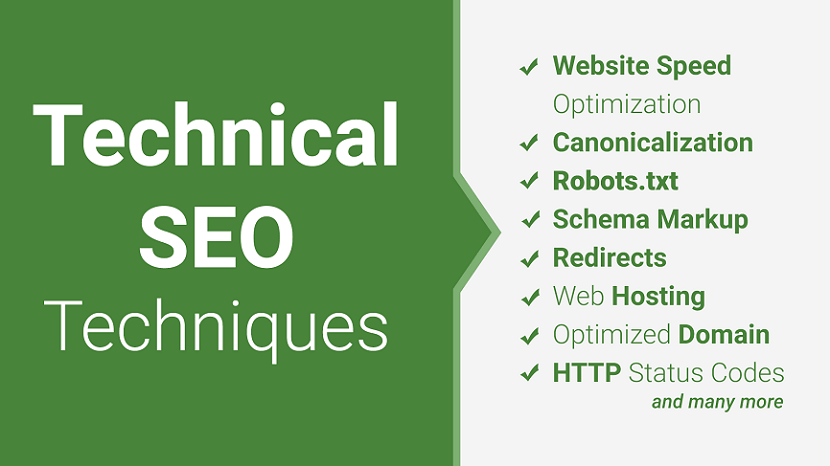
Technical SEO refers to the process of optimizing your website for the crawling and indexing phase. With technical SEO, you can help search engines access, crawl, interpret and index your website without any problems.
It is called “technical” because it has nothing to do with the actual content of the website or with website promotion. The main goal of technical SEO is to optimize the infrastructure of a website.
If you want your site to rank on Google and increase your brand's organic traffic, you’ll need to look at On Page SEO, Off Page SEO and Local SEO also.
But before you starting SEO also learn techniques of SEO ( White Hat SEO, Black Hat SEO, Gray Hat SEO and Negative SEO )
To understand what is the true meaning of technical SEO, let’s start with some basic terminology.
1. Doctype
The HTML document type declaration, also known as DOCTYPE, is the first line of code required in every HTML or XHTML document. The DOCTYPE declaration is an instruction to the web browser about what version of HTML the page is written in. This ensures that the web page is parsed the same way by different web browsers.
In HTML 4.01, the DOCTYPE declaration refers to a document type definition (DTD). A DTD defines the structure and the legal elements of an XML document. Because HTML 4.01 was based on the Standard Generalized Markup Language (SGML), referring to a DTD in the DOCTYPE declaration was necessary.
Additionally, doctypes for HTML 4.01 required the declaration of either strict, transitional, or frameset DTD, each with a different use case as outlined below.
Strict DTD: Used for web pages that exclude attributes and elements that W3C expects to phase out as CSS support grows
Transitional DTD: Used for web pages that include attributes and elements that W3C expects to phase out as CSS support grows
Frameset DTD: Used for web pages with frames
In contrast, the declaration of HTML5 DOCTYPE is much simpler: it no longer requires a reference to DTDs as it is no longer based on SGML. See the examples below for a comparison between HTML 4.01 and HTML5 DOCTYPEs.
Examples:
Doctype syntax for HTML5:
Doctype syntax for strict HTML 4.01:
Doctype syntax for transitional HTML 4.01:
Doctype syntax for frameset HTML 4.01:
2. Canonicalization
A canonical tag is a way of telling search engines that a specific URL represents the master copy of a page. Using the canonical tag prevents problems caused by identical or "duplicate" content appearing on multiple URLs. Practically speaking, the canonical tag tells search engines which version of a URL you want to appear in search results.
Canonicalization Examples
3. Robots.txt
Robots.txt is a text file webmasters create to instruct web robots (typically search engine robots) how to crawl pages on their website. The robots.txt file is part of the the robots exclusion protocol (REP), a group of web standards that regulate how robots crawl the web, access and index content, and serve that content up to users. The REP also includes directives like meta robots, as well as page-, subdirectory-, or site-wide instructions for how search engines should treat links (such as “follow” or “nofollow”).
In practice, robots.txt files indicate whether certain user agents (web-crawling software) can or cannot crawl parts of a website. These crawl instructions are specified by “disallowing” or “allowing” the behavior of certain (or all) user agents.
Basic format:
4. Schema Markup
Schema markup is code that helps search engines to understand your content and better represent it in the search results.
Schema markup powers rich snippets, which often have higher clickthrough rates than ‘regular’ search results. That means more traffic to your site.
However, the primary function of the markup is to help search engines better understand your content.
It’s no coincidence that schema.org, the community behind the markup, was created a year before Google’s Knowledge Graph—a knowledge base of entities and the relationships between them—came to life.
And you guessed it, one of the primary sources for this data is the schema markup.
What are the types of Schema Markups?
There are hundreds of different markup types because there are so many different questions people turn to search engines to answer. But here are the 10 most common schema markups that are used.
5. Sitemaps Updates (XML, Text, HTML)
A sitemap helps search engines discover URLs on your site, but it doesn't guarantee that all the items in your sitemap will be crawled and indexed. However, in most cases, your site will benefit from having a sitemap.
It is also essential to know there are two different types of sitemaps.
You can Generator Sitemaps for your website here
6. HTTP Status Codes
The Status-Code element in a server response, is a 3-digit integer where the first digit of the Status-Code defines the class of response and the last two digits do not have any categorization role. There are 5 values for the first digit:
7. Website Speed Optimization
The term page speed essentially refers to the length of time at which web pages or media content is downloaded from website hosting servers and displayed onto the requesting web browser. Page load time is the duration between clicking the link and displaying the entire content from the web page on the requesting browser.
You can test your website here
Once you have tested the speed of your website, you can start optimizing it. There are a lot of different ways to make your website work faster and we created the list of the most effective ones.
8. Web Hosting
Web hosting is an online service that allows you to publish your website files onto the internet. So, anyone who has access to the internet has access to your website. In practice, it usually refers to the service you get from a web hosting provider like Bluehost.com
9. Optimized Domain
An SEO-optimized domain name is a domain name that introduces your website and tells search engines and users what your website is about, or about the type of products and services it offers, etc. Such domains are more likely to stand out in the search result listings and to get clicked. So, a right domain name helps you target your audience and improve your search engine rankings. You can choose a branding domain or a keyword domain.
10. Redirects
Every page on the web has an address, a URL, which stands for ‘Uniform Resource Locator’. Sometimes, content moves from one URL to another URL. That’s when you need a redirect. A redirect automatically makes a browser go from one URL to another URL.
Types of redirects
11. Core Web Vitals
Core Web Vitals are the subset of Web Vitals that apply to all web pages, should be measured by all site owners, and will be surfaced across all Google tools. Each of the Core Web Vitals represents a distinct facet of the user experience, is measurable in the field, and reflects the real-world experience of a critical user-centric outcome.
The metrics that make up Core Web Vitals will evolve over time. The current set for 2020 focuses on three aspects of the user experience—loading, interactivity, and visual stability—and includes the following metrics (and their respective thresholds):
12. W3C Validation
W3C validation is the process of checking a website's code to determine if it follows the formatting standards. If you fail to validate your website's pages based on W3C standards, your website will most likely suffer from errors or poor traffic owing to poor formatting and readability.
Why Validate a Site on W3C?
How Do You Validate Your Code?
13. Google Search Console
Search Console is a tool from Google that can help anyone with a website to understand how they are performing on Google Search, and what they can do to improve their appearance on search to bring more relevant traffic to their websites.
Search Console provides information on how Google crawls, indexes, and serves websites. This can help website owners to monitor and optimize Search performance.
There is no need to log in to the tool every day. If new issues are found by Google on your site, you'll receive an email from Search Console alerting you. But you might want to check your account around once every month, or when you make changes to the site's content, to make sure the data is stable. Learn more about managing your site with Search Console.
To get started, follow these steps:
14. Google Analytics
Google Analytics is a website traffic analysis application that provides real-time statistics and analysis of user interaction with the website. Google analytics enables website owners to analyze their visitors, with the objective of interpreting and optimizing website’s performance. Google analytics can track all forms of digital media and refer to upstream web destinations, banner and contextual advertisements, e-mail and integrate with other Google products.
Google Analytics Benefits
15. Google Tag Manager
Manage all your website tags without editing code. Google Tag Manager delivers simple, reliable, easily integrated tag management solutions for free.
How tag management solutions can help.
16. Bing Search Console
Bing Webmaster Tools (Bing WMT) is a free Microsoft service that allows webmasters to add their sites to the Bing crawler so they show up in the search engine.
It also helps to monitor and maintain a site’s presence. Bing Webmaster Tools is to the Bing search engine, what Google Search Console is to Google.
How is the search console helpful?
17. Yandex Search Console
Yandex webmaster tools is a free web service provided by Yandex for webmasters to monitor their site’s performance in the Yandex search engine.
You can use it to upload a sitemap, see how much traffic you are getting, get a list of indexed pages, see crawling or indexing errors, site speed problems, etc.
It serves a similar purpose as Google Search Console and Bing & Yahoo Webmaster Tools.
18. Conversion Rate Optimization
Conversion rate optimization (CRO) is the practice of increasing the percentage of users who perform a desired action on a website. Desired actions can include purchasing a product, clicking ‘add to cart’, signing up for a service, filling out a form, or clicking on a link.
Conversion optimization best practices
FAQ - Technical SEO
1. What is Technical SEO?
Technical SEO refers to optimizing your website’s technical elements to ensure that search engines can crawl, index, and render your web pages correctly.
2. Why is Technical SEO important?
Technical SEO is essential because it helps you build a website that search engines can easily understand. If a search engine is able to crawl, index, and render your web pages correctly, it increases your chances of ranking in search results.
Final Thoughts
Technical SEO is not something you can master in a day or two. It requires lots of dedicated research and some trial and error. So keep working and finding Technical SEO errors on your website and resolve them ASAP.
Along with Technical SEO keep working on On Page SEO, Off Page SEO, and Local SEO regularly
If you found this article helpful, we encourage you to share it on your social media platforms—because sharing is caring! For more information about article submissions on our website, feel free to reach out to us via email.
Send an emailWritten by RGB Web Tech
Latest Technology Trends
Latest technology trends shaping the future, including AI advancements, blockchain innovation, 5G connectivity, IoT integration, and sustainable tech solutions. Explore breakthroughs in quantum computing, cybersecurity, augmented reality, and edge computing. Stay ahead with insights into transformative technologies driving innovation across industries and revolutionizing how we live, work, and connect.
What is Local SEO and Why is It Important?
Last updated on January 19, 2025 by RGB Web Tech
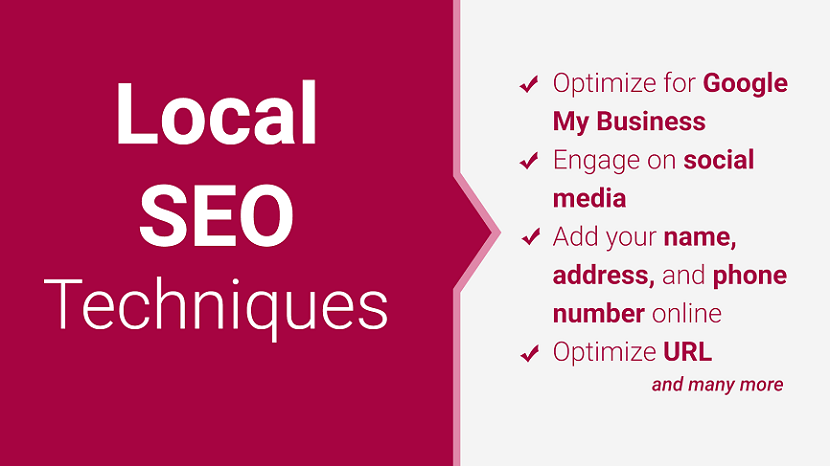
Local search is powerful for small businesses, 46% of all Google searches are looking for local information. If your business is not optimized for local search, you could miss out on potential customers ready to shop in your area. In short, local SEO is critical if you want your business to stay relevant.
If you want your site to rank on Google and increase your brand's organic traffic, you’ll need to look at On Page SEO, Off Page SEO and Technical SEO also.
But before you starting SEO also learn techniques of SEO ( White Hat SEO, Black Hat SEO, Gray Hat SEO and Negative SEO )
To help you optimize your business for local SEO, we've created a comprehensive guide covering local SEO tips and tools.
1. Optimize for Google My Business.
Google My Business has become the RGB Web Tech local search. Since Google supports, verifies, and shares its own content generously, Google My Business is an ideal tool to help your business meet Google's needs.
To ensure you're optimized for Google My Business, you'll want to:
If Google can verify your business as authentic, the search engine could potentially reward your business with a coveted sidebar space in Google's local search.
Don't just do this for SEO, either. By having reviews and keeping your contact information and operating hours up-to-date, you're improving the experience for potential customers to find you. Finding current data is essential to consumers, now more than ever, due to 2020's disruption in consumer shopping behavior and business operation.
2. Engage on social media and add posts to Google My Business
Google considers content shared on social media more important now than ever before.
Now that you've carved out a beautiful Google My Business page, share it on social media, further aligning social and search.
3. Ensure your name, address, and phone number are consistent online
You've got to make it easy for people and search engines to find you, and to do this you have to set up your NAP.
What does NAP mean in local SEO?
The acronym, NAP, stands for the name, address, and phone number (with area code) of a business. Your NAP should be considered crawlable HTML text on your site for Google to display it better according to location-based search results.
Pro Tip: Avoid the common mistake of only including the NAP within an image; images can't be crawled from search engines like HTML text.
The most common location for the NAP is in the footer or header of the site. Additionally, you should include your NAP on a “Contact Us” page, too.
4. Optimize URL, title tags, headers, meta description, and content.
When it comes to content, every new blog post is a new indexed page for your site, a new page on which to target a geographic search phrase, and a new opportunity to get found in the search engine results pages (SERPs).
Every time you write a piece of content, you need to optimize the content for search engines by using high-volume keywords in the URL, title, header, meta description, and body. If you're having trouble coming up with geo-targeted content, consider highlighting customer success stories and case studies.
Pro Tip: The more specifications you add to these assets (especially for each location of your business), the better you’ll be able to optimize “near me” local searches.
5. Add location pages to your website
If you have more than one brick-and-mortar location, create location pages. Location pages provide readers with your name, address, phone number, store hours, unique store descriptions, parking/transit information, promotions, and testimonials from happy customers.
It's also important you avoid duplicating content across multiple location pages. For single-location businesses, create a locally descriptive About Us page. You can even get bonus points if you add a Google Map to your website on your respective location page(s).
6. Create local content
Google continues to get smarter, which means content creators can now write more for users and less to appease search engines. And while writing about general topics will attract a vast crowd, sometimes it's more important to focus and write about local or industry news to attract a local audience.
Be the local authority for your industry by promoting local industry gatherings, news, employees, and other educational content on your blog. Think of top-of-the-funnel content that goes beyond what your business sells.
For example, if you're a local security company and trying to attract businesses new to the area, create a helpful resource to get these businesses well-acquainted with your city. A map of local service providers or a calendar of city-wide events could both provide value for your persona and contain highly relevant on-page local signals.
7. Ensure your website is mobile-friendly
Local and mobile search go hand in hand (61% of all Google searches are performed on mobile).
Some of the most common ways people will use your site in a mobile environment are to look up reviews, find directions to your location, and search for contact information. In fact, "near me" searches on mobile have increased 250% since 2017.
Make it easy for your prospects and customers by making your site mobile-friendly.
8. Get inbound links with relevance and authority
Inbound links are compelling opportunities to boost your local SEO — every inbound link tells Google you're a legitimate company, and inbound links can also raise your domain authority. Here are a few ways to get inbound links:
Start with your network, including the Chamber of Commerce, business improvement districts, licensing bureaus, trade associations, resellers, vendors, manufacturers, and other affiliates.
Consider sponsoring a webinar or meet-up, hosting a community event, promoting something local you love, and building relationships with prominent people and influencers. Additionally, learn to feel comfortable reaching out to partners to see if they can feature you in their partner directory.
Also, being a guest blogger can help attract links. Positively talk to or about other people in your industry, and act as a resource provider for the community. If you're an active participant in community conversations, the buzz around you grows in the form of inbound links, social media growth, and media coverage.
9. Participate in your local community
The more you participate in the local community, the more digital PR you'll receive. Partnering with a nonprofit on a campaign, having a volunteer day in your organization, sponsoring an event (even an online one!), or appearing in the local media as an authority in your industry are all ways to earn press, brand awareness, and inbound links.
For example, given that .edu links are the bee's knees for domain authority, why not earn some links by featuring a scholarship in your geographic region? It should be relevant to your industry, send the right signals to your domain (given the backlinks from schools) and make you feel good, too! Moz built a solid guide on the steps to success for effective scholarship outreach.
FAQs - Local SEO
1. What is local SEO?
Local SEO is the practice of improving your online presence to get more business from local searches. These searches take place on many search engines, but local SEO focuses on optimizing for Google users.
2. Why is local SEO important?
Local SEO is important because many people use search engines to find local businesses. In fact, according to Google 30% of all mobile searches are related to location. 78% of people who search for something nearby on their phones visit the business within a day. 28% of searches for something nearby result in a purchase. In short, customers are searching for your business. If you’re not there, you’re leaving money on the table.
3. How does local SEO work?
Local SEO is a game of two halves because Google shows two types of search results for local searches. These are “map pack” results and organic “blue link” results. You can rank on both of them. 1. Map pack results : The map pack (aka local pack) is a Google SERP feature that shows the top local business listings and a map. It often appears at the very top of Google’s search results for local searches. 2. Organic search results : The “regular” organic search results are the “10 blue links” that we’re all familiar with. They usually appear below the “map pack” results.
4. What is the difference between SEO and local SEO?
Search engine optimization (SEO) encompasses all areas of your website that relate to improving your search visibility, traffic, and conversion. Local SEO is a section of SEO that aims to boost local visibility or awareness of your local establishment worldwide. Local SEO is targeting consumers and clients who are interested in doing business in the local area.
5. How much does local SEO cost
Pricing for Local SEO services can range from $500 to $5000 or more. However, it will depend on what industry you’re in, the competition, and the SEO initiatives. Ultimately, your SEO consultant will be recommending an SEO strategy and a plan that will be presented to you for your approval.
6. What are local SEO citations?
Local citations are any mention of your business’ name, address, phone number and other information on the web. This can happen on websites, social media, or local business directories. It impacts how search engines view your website and can positively affect your local rankings.
7. How do you know if you need local SEO?
You know you need local SEO if you see that you’re not ranking locally or you need more leads and clients. It’s important to know that the ROI from local SEO is higher than other marketing initiatives. With more than 87.3 percent of the US population using the internet, you can be sure that a portion of those are locals looking for your business. So regardless of competition, there’s a lot of opportunities out there that you don’t want your local business to miss out on.
Conclusion
Local SEO is often a digital marketing tool that gets overlooked. Local SEO is just as important as traditional SEO. Ranking in Google Maps and local packs can help boost your foot and online traffic.
These fantastic suggestions, such as website optimization and Google Maps ranking can give you the boost your business needs.
Local SEO may seem overwhelming, but our digital marketing service and experts are here to help you with anything you need to know more about On Page SEO, Off Page SEO and Technical SEO.
If you found this article helpful, we encourage you to share it on your social media platforms—because sharing is caring! For more information about article submissions on our website, feel free to reach out to us via email.
Send an emailWritten by RGB Web Tech
Latest Technology Trends
Latest technology trends shaping the future, including AI advancements, blockchain innovation, 5G connectivity, IoT integration, and sustainable tech solutions. Explore breakthroughs in quantum computing, cybersecurity, augmented reality, and edge computing. Stay ahead with insights into transformative technologies driving innovation across industries and revolutionizing how we live, work, and connect.
Black Hat SEO Techniques That Can Harm an SEO Campaign
Last updated on January 19, 2025 by RGB Web Tech
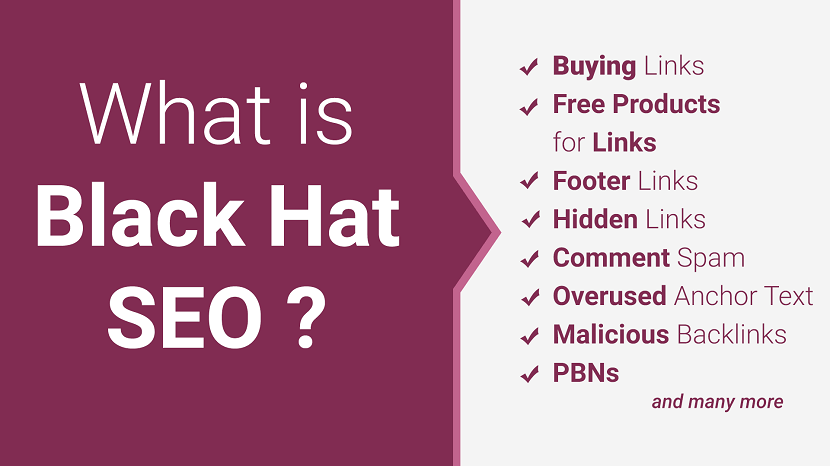
Black hat tactics are heavily penalized by Google, whether done consciously or otherwise. Read about them that can hurt your optimization efforts.
To remain the most popular search engine in the world, Google has to continuously update its algorithm to continue delivering users the most useful results.
To this end, Google also makes available Webmaster Guidelines, so everyone from web developers to SEO professionals knows the rules of the game.
Of course, there are plenty of people who want to win the game without following its rules.
For such people, there’s black hat SEO.
Black hat SEO gets its name from old cowboy movies where the bad guys wear a black hat.
Black hat SEO practitioners know the rules of search engine optimization and use that understanding to take shortcuts that aren’t exactly laid out in Google’s best practices.
This is in juxtaposition to White Hat SEO practitioners who follow Google’s Webmaster Guidelines, promote high-value content, and engage in deep keyword research to win in the SERPS.
Google is good at identifying and penalizing black hat SEO techniques, but that doesn’t stop people from trying them anyway.
Here are black hat practices to avoid because they can land you an algorithmic or manual penalty.
Some of these you may do without intending to, so it’s good to familiarize yourself with black hat SEO to make sure you’re in the clear.
Black Hat Link Techniques
1. Buying Links
A high-quality, relevant link can drive traffic to your domain while also telling Google’s algorithm that you’re a trustworthy source.
A good backlink can also help Google map your website so that it has a better idea of what you’re all about, making it easier to serve you up as a search result.
Buying a link, however, is against Google’s Webmaster Guidelines, and – according to Google – it doesn’t work.
If you’re caught, you could get an automatic and manual penalty that impacts specific pages, or worse, the entire site.
Google tracks links that are likely to have been bought and those that have been earned.
Additionally, the sort of website that sells you a link is the sort of website you wouldn’t want to buy a link from because it is easier than you think for Google to identify unnatural patterns – even for Google’s own properties.
2. Free Products for Links
Whether you’re giving or taking, exchanging free products (or discounts) for links is considered a link scheme by Google.
To not be considered a link scheme, make it a no-follow link, which is a link with a rel=“nofollow” tag.
A no-follow link ensures that the link doesn’t impact the search engine’s ranking algorithm.
3. Footer Links
The footer is prime real estate for a link because footers appear on every page of a website.
If you’ve been adding footer links with commercial anchor text at scale to manipulate results, Google will likely be able to identify those and penalize you for it.
4. Hidden Links
You may think that you can hide a link in your website’s text or by having the link appear as the same color as the background, but Google will notice and penalize you for trying to game the system.
Additionally, if you include enough irrelevant links, you’ll give Google less reason to direct traffic to your target audience since you’ll be diluting your relevance.
Deceptively hidden links are a violation of Google’s guidelines. That means:
5. Comment Spam
You may be able to share a link to your website in the comments section of a website, but you should avoid doing so unless it’s relevant.
Otherwise, you risk being penalized for being a spammer as using comments to build links is essentially not effective.
6. Overused Anchor Text
It may make sense to match your page’s title every time you share a link to it because the title is what your page is about, and consistency could imply relevancy.
But from Google’s perspective, this is also what it would look like if you were lazily spamming.
Instead, you should make your anchor text brief, relevant to the linked-to page, not stuffed with keywords, and unique.
This makes sense given that this is what anchor text would look like if the link were a natural part of its surroundings.
This rule holds for both internal and external links.
7. Malicious Backlinks
Some black hat SEO practitioners will try to use Google’s penalty system to advance their agenda by having websites that you wouldn’t want to associate with link to you to drag down your page rank.
For this reason, Google created a form to help you disavow links.
This way, when you go through your backlinks, you can disentangle yourself from any undesirable domains.
8. PBNs
PBNs are websites that link to each other.
They used to be much more prevalent in the 90s and early 2000s, particularly amongst fan pages for different tv shows, movies, musicians, etc.
They’re not necessarily a bad thing, but webrings are considered a link scheme when they’re designed to manipulate algorithms.
9. Keyword Stuffing
If SEO were only about using keywords, then a block of keywords would be all it takes to rank as number one.
But since Google wants to deliver high-quality results, it looks for content-rich in semantically-linked keywords.
That way, the algorithm is more likely to provide high-quality content instead of content that simply bears the superficial markings of high-quality content.
10. Hidden Content
Like a hidden link, hidden content is content that’s made the same color as the background.
It’s a tactic that intends to include as many keyword phrases, long-tail keywords, and semantically-linked words as possible in a page.
Of course, Google’s algorithm can tell the difference between keywords within the body of a paragraph and keywords hidden in the background.
There are several routes hidden content can take to end up on your site beyond being intentionally put there by the site owner.
Not all hidden content is forbidden, however.
The rule of thumb is that the content is okay so long as the content is visible to both the user and the search engine.
An example may be content that’s only visible to mobile visitors but is hidden to desktop visitors.
11. Article Spinning
Similar to duplicated or plagiarized content, article spinning is a technique that involves re-writing content by substituting synonyms, changing sentence structure, or re-writing text entirely while communicating the same information as the source material.
Article spinning can be done either manually or using technology.
While automated article spinning has advanced to the point where the articles are readable, Google will still penalize you for spun articles.
And for a good reason: spun articles degrade the quality of the internet.
12. Plagiarized or Duplicated Content
Sometimes known as scrapping, duplicating, or plagiarizing content can violate copyright or trademark laws.
Since Google wants to share high-quality domains, plagiarism is grounds for a penalty.
13. Rich Snippets Spam
Rich snippets are snippets with more information. More information can drive more traffic.
But there are many ways that the schema used to generate these snippets can be manipulated. In fact, there is an entire Google support page dedicated to it.
14. Cloaking
Cloaking is an old black hat trick that’s still used to this day: use a flash or animated page to conceal information your visitors that only Google can see in the HTML.
If Google catches you cloaking, you’ll get a penalty.
15. Doorway Pages
Doorway pages are a form of cloaking.
They’re designed to rank for particular keywords but then redirect visitors to other pages.
They’re also known as:
16. Keyword Stuffing in Alt Tags
You might think that alt-tags are a no harm opportunity to use as many keywords as possible, but stuffing in this context can also hurt your site’s rankings.
You’d also be misusing alt tags and, as a result, doing yourself and your site’s visitors a disservice. Alt tags are:
17. Hacked Website
While having an unsecured website can’t technically get you a Penguin or Panda penalty, it could result in the loss of your valuable rankings.
If your website gets attacked or injected with malicious code and Google finds out, they can block your website for people using their search engine.
Not only will this cause you to lose the trust of anybody who visits your site from organic search, but it will cause your website to drop in the rankings just like a Penguin or Panda penalty would.
While it’s true you may receive a notification through Google Analytics that your site has been hacked, it still could mean a real penalty for your website in search results if Google knows your site contains malicious code.
FAQs - Black Hat SEO
1. What is Black Hat SEO?
Black hat SEO is a practice against search engine guidelines, used to get a site ranking higher in search results. These unethical tactics don't solve for the searcher and often end in a penalty from search engines.
2. Does Black Hat SEO Still Work?
Black hat SEO works but for a shorter period of time. Performing black hat SEO will get you penalized, resulting in dropping down the search results or being removed absolutely from the SERPs.
3. What are Black Hat SEO tactics?
The most commonly practiced include - content spamming, keyword stuffing, paid links, redirects, cloaking, misused structured data etc.
4. Why Should I Choose White Hat SEO Instead of Black Hat SEO?
While Black Hat SEO includes duplicated content, irrelevant backlinks, blog comment spam, White Hat SEO helps you build a website containing relevant content, optimized images, natural keyword density, and relevant tags / headings. In sum, the dark path is unreliable, while the light path is a safe port.
Bottom Line
When we talk about SEO, the First thing that comes to our mind is On Page SEO, Off Page SEO, Technical SEO and Local SEO. But in the initial stage, newcomers do not know the techniques of SEO. These techniques ( White Hat SEO, Black Hat SEO, Gray Hat SEO and Negative SEO ) can rank your website in the search engine's first page or first position. But be careful about the wrong techniques. These techniques can also harm your website ranking or permanently ban on search engines. So before you get started using SEO make sure to read all about SEO techniques.
The rewards of the black hat path are short-lived. They’re also unethical because they make the internet worse.
But you can’t do something right without knowing how to do it wrong, which is why every white hat SEO also needs to know about the black hat path.
If you found this article helpful, we encourage you to share it on your social media platforms—because sharing is caring! For more information about article submissions on our website, feel free to reach out to us via email.
Send an emailWritten by RGB Web Tech
Latest Technology Trends
Latest technology trends shaping the future, including AI advancements, blockchain innovation, 5G connectivity, IoT integration, and sustainable tech solutions. Explore breakthroughs in quantum computing, cybersecurity, augmented reality, and edge computing. Stay ahead with insights into transformative technologies driving innovation across industries and revolutionizing how we live, work, and connect.
What is Gray Hat SEO? Is that good for the website?
Last updated on January 19, 2025 by RGB Web Tech
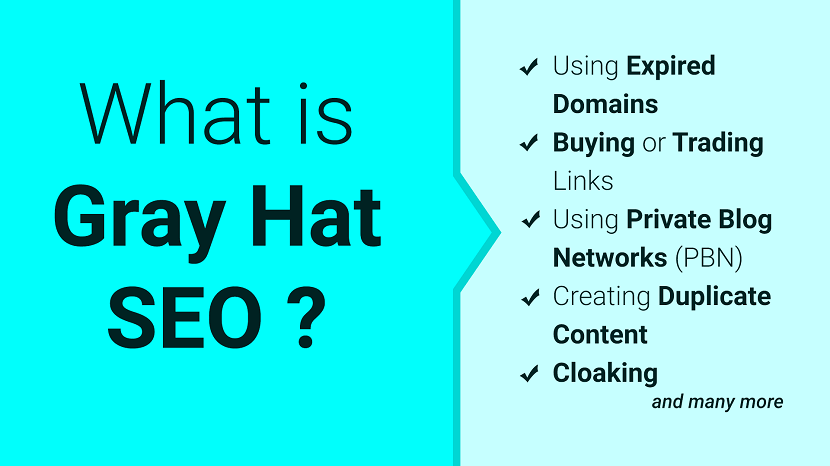
In this guide, we’ll answer the question, “what is gray hat SEO?”
You may have heard of White Hat SEO or Black Hat SEO, but what are gray hat SEO techniques?
Below you’ll find out everything you need to know about this search engine optimization strategy, including what gray hat SEO is, how it differs from white and black hat SEO, and a list of the most popular gray hat activities for increasing search engine rankings and visibility.
Note: Gray hat SEO also goes by the name “grey hat SEO”. The word gray has two spellings: gray and grey. And because this is an SEO-optimized blog post, I’ll switch between the two variations throughout the content to improve the rankings for both keyword phrases. (That’s SEO in action.)
What Is Gray Hat SEO?
Gray hat SEO is an SEO practice that combines white hat and black hat SEO. Gray hat SEO is riskier than white hat SEO because it exploits the search engine guidelines to increase a page’s rankings on the SERPs. Gray hat SEO techniques are black masquerading as white.
That’s the basic definition for what is gray hat SEO. Let’s now get into some of the most popular gray hat search engine optimization strategies being used today.
Gray Hat SEO Techniques
1. Using Expired Domains
This is a common gray hat SEO strategy that borders between black and white SEO.
It refers to buying a domain that the owner has let expire but still has a lot of authority because of the number and quality of backlinks still pointing to the site.
A gray hat SEO method with expired domains can be applied in two ways:
2. Buying or Trading Links
Buying links and trading links are the second most popular gray hat SEO techniques webmasters use to increase authority and rankings for their websites.
However, link schemes like this are technically black hat SEO tactics because they violate Google’s Webmaster guidelines.
This gray hat SEO method comes in four primary forms:
3. Using Private Blog Networks (PBN)
A private blog network (PBN) is a group of websites that you control which are used to build backlinks to a single website to help it rank higher in Google.
The purpose of a PBN for gray hat SEO purposes is to link to one central domain to pass the most link equity to it to improve the authority.
PBN backlinks are actually a black hat SEO strategy, but if you keep it truly private without anyone knowing about it, and you cover your tracks so that Google cannot detect that you own all of the websites, then this technique does fall into gray hat SEO territory.
4. Building Micro-Sites and Blogs
Building a micro-site or blog is a gray hat SEO technique that can improve your search engine rankings without getting penalized.
It’s kind of like a PBN but is much safer because you don’t own the domains that you’re using to link back to your site. They’re also a public network, not private.
Common examples of building microsites for SEO purposes include setting up a blog on multiple web 2.0 and content curations sites with high domain authorities, such as Medium, Weebly, Blogger, Tumblr, Live Journal, etc.
See my post on how to do SEO for a blog for tips on optimizing blog content.
5. Spinning Content
Spinning content is another common gray hat SEO method that can work for getting ranked in Google. However, it’s unethical and not a good practice to follow long-term.
But here’s how it works:
Spinning content is when you take content from another website and then reword it on a sentence-by-sentence basis so that it can’t be recognized by plagiarism software.
Once the content is spun, you post it on your own site so that it can get ranked for the keywords you want to target. Spinning content like this allows you to get around a potential duplicate content penalty, which we’ll cover next.
6. Creating Duplicate Content
Duplicate content is another gray SEO tactic that’s being used in the world of search engine optimization these days.
This technique includes copying and pasting large blocks of content across the same website or various domains.
There are three ways duplicate content is used for SEO:
7. Automating Content
Automating content is when you use software to automate the manual processes required in content creation. The purpose is to feed your blog with a constant stream of content so you have more opportunities to rank higher in Google and to get traffic.
Content automation is done in two ways:
8. Increasing Keyword Density with Hidden Text
Using hidden text is a black hat SEO method that violates Google’s Webmaster guidelines. However, gray hat SEO tries to bend these rules by tricks for hiding keywords from the user but still allows them to be crawled by the search engine.
The most common gray hat SEO techniques for hiding text include:
9. Cloaking
Cloaking is an SEO strategy that presents one set of content or URLs to human users and another set to search engines.
Cloaking is a deceptive gray hat SEO tactic that tricks search engines like Google to get the desired rankings for target keywords while giving users different results than they expect.
10. Submitting Your Site to Web Directories
One of the most overused gray hat SEO techniques is web directory submissions.
Adding your website directories can get you a free backlink to your site, and when done in small numbers, it’s considered a white SEO tactic.
But once you start overusing this strategy to generate tens or hundreds of links to your site, it tips into gray hat SEO territory. Especially if you manipulate the keyword anchor text for the backlink.
11. Creating Multiple Social Media Accounts
Having one social media account for your business on each social network is a white hat SEO method for sharing links and gaining more exposure for your content.
However, if you create multiple social media accounts to artificially inflate the sharing and linking to your website, then that’s a gray hat SEO method.
12. Paying for Positive Reviews
Google is known for rewarding websites with higher rankings that have positive reviews. This is especially true for local SEO.
One way to trick the algorithm in your favor is to pay people to leave a positive review for your listing. You can find an online service provider for positive reviews or entice current customers to review your site for a discount or bonus.
FAQs - Gray Hat SEO
1. What is Gray Hat SEO?
Generally speaking, gray hat SEO is the practice of using techniques that are not strictly against Google's guidelines but perhaps a little outside what would be considered best practice. For example, getting a backlink from an authority site is something that Google encourages.
2. What are some famous Gray hat SEO techniques?
Domain grabbing, Increasing your average length of old content, Web 2.0 for building links, usage of PBN, careful keyword stuffing, social bookmarking sites, Link exchange, web directories, multiple social media accounts, build microsites, are some of the best Gray hat SEO techniques.
3. Is Gray Hat SEO Illegal?
Gray hat SEO is not illegal. There is no law being violated by gray hat SEO techniques. However, gray hat SEO does go against search engine prohibited practices which can get your site banned from the search engine results pages.
4. Gray Hat SEO vs Black Hat SEO
The difference between gray hat SEO vs black hat SEO is that gray hat uses techniques that are not always in direct violation of search engine guidelines. This gray area of search engine optimization is what makes gray hat SEO more tempting than black hat SEO methods.
5. Gray Hat SEO vs White Hat SEO
The difference between gray hat SEO vs white hat SEO is that gray hat SEO is riskier than white hat SEO. A gray hat search engine optimization technique may or may not get your site banned from search engines and their affiliate sites. White hat SEO is 100% safe.
The Bottom Line
When we talk about SEO, the First thing that comes to our mind is On Page SEO, Off Page SEO, Technical SEO and Local SEO. But in the initial stage, newcomers do not know the techniques of SEO. These techniques ( White Hat SEO, Black Hat SEO, Gray Hat SEO and Negative SEO ) can rank your website in the search engine's first page or first position. But be careful about the wrong techniques. These techniques can also harm your website ranking or permanently ban on search engines. So before you get started using SEO make sure to read all about SEO techniques.
I hope you enjoyed this guide on what is gray hat SEO.
In many ways, gray hat SEO techniques are just black hat SEO methods that appear as white. Regardless, many website owners participate in these gray hat SEO tactics to gain more traffic to their sites, so it’s good to understand how these methods work online.
If you found this article helpful, we encourage you to share it on your social media platforms—because sharing is caring! For more information about article submissions on our website, feel free to reach out to us via email.
Send an emailWritten by RGB Web Tech
Latest Technology Trends
Latest technology trends shaping the future, including AI advancements, blockchain innovation, 5G connectivity, IoT integration, and sustainable tech solutions. Explore breakthroughs in quantum computing, cybersecurity, augmented reality, and edge computing. Stay ahead with insights into transformative technologies driving innovation across industries and revolutionizing how we live, work, and connect.
What is Negative SEO & How to Stay Safe
Last updated on January 19, 2025 by RGB Web Tech
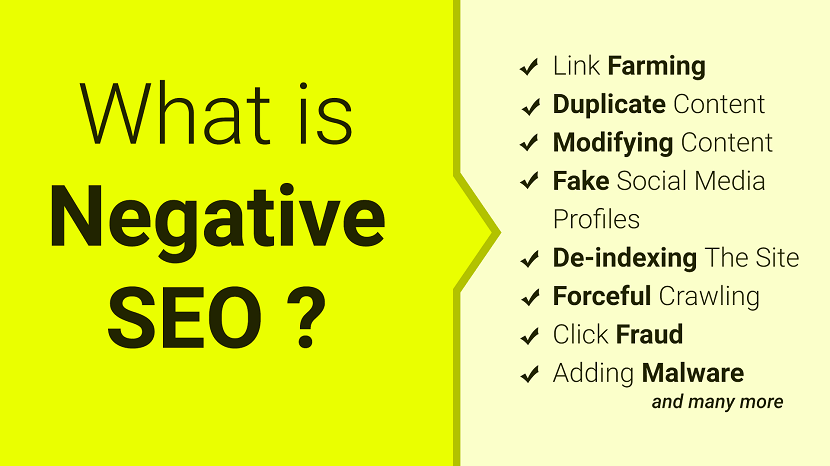
The entire SEO industry experienced a major transformation over the past two years. As a result, many online marketers have dramatically changed their strategies. Ranking high in Google for competitive keywords is not as easy as it was three years ago.
Because Black Hat SEO is harder and harder to execute, and less and less likely to deliver results, a new type of SEO has emerged called “Negative SEO.”
This is a guide that will help you understand what negative SEO is and how you can protect your business from becoming a victim. If you are serious about building your brand online and keeping it safe, this is something you should not ignore.
What is Negative SEO?
Negative SEO refers to the practice of using black hat and unethical techniques to sabotage a competitor’s rankings in search engines. Negative SEO attacks can take a number of different forms:
Type of Negative SEO:
1. Link Farming: Pointing low-quality links to your website from sites created solely for the purpose of housing useless, spammy, unrelated links.
2. Duplicate Content: Copying and pasting your content, and publishing it on multiple sites all over the internet is one of the easiest methods spammers use to penalize your site.
3. Modifying Content: Running invisible scripts from the header or footer templates.
4. Fake Social Media Profiles: Negative reviews published on social media can hurt you. Spammers often choose to attack through social media, creating accounts on Facebook or Twitter with a company’s name, and posting low-quality posts to ruin their reputation.
5. De-indexing The Site: Changing your robots.txt file from the server to remove you from search.
6. Forceful Crawling: Slowing down websites is an easy way for negative SEO practitioners to cause damage. By forcefully crawling the site, taxing the server load, and ultimately crashing the site, negative SEO practitioners can decrease or de-rank your site.
7. Click Fraud: A specially programmed CTR bot looks for the site’s main keywords and branded terms, then clicks on the listing, only to quickly bounce back to the search engine request page. The site gets dropped once Google surmises the site’s owner may be trying to “game the system.”
8. Adding Malware: If malware attacks your site, Google may warn users that “this site may be hacked” before forwarding, causing traffic to plummet.
How To Secure Your Website Against Negative SEO Attacks
Google’s assurances are not enough for the proactive web owner. Fortunately, there are several ways to proactively protect your website.
1. Enable email notification Google Search Console: Now all information and issues pertaining to your website can be kept in the forefront of your mind. Once you see what is going on, you can employ more advanced strategies to prevent negative SEO, including: monitoring website backlinks, disavowing (or removing) suspicious backlinks, and securing your website from malware/hackers.
2. Keep an eye on your backlinks: Online visibility management platforms like SEMrush help you monitor your backlinks through an email summary of changes. Building backlinks to negatively impact websites from low-quality websites is a favored tool of negative SEO practitioners.
3. Closely watch your important backlinks: Again, a tool like SEMrush is invaluable. Mark your most important backlinks and ask to be alerted when they are removed. You can contact the webmasters of the sites and ask to have valuable backlinks restored, so you do not lose search status.
4. Safeguard your website from hackers and malware: With all the high-profile hacks and costly data breaches in the news these days, it’s never been more important to bolster the security of your website against vicious malware attacks. Fortunately, there are easy and affordable steps you can take to do just that, such as:
5. Look out for content thieves and copycats: Copyscape and Grammarly can help you find other copies of your content elsewhere on the Internet if they exist, as well as improve the quality of the writing on your site and avoid accidental plagiarism.
6. Keep an eye on your social media mentions: Play an active role in social media administration through your social page dashboards. HubSpot, Hootsuite, and Social Mention offer social listening tools, so you are alerted whenever your name is mentioned on social media. When mentions are made, be sure you address any concerns directly and promptly to avoid bad publicity from spreading.
7. Speed up your website loading time: Google Analytics Alerts send you emails when your website loading time slows down, so you can identify when and why it’s happening. You may need to enable caching, remove resource-hogging plugins or add-ons, optimize your image sizes, get rid of excess code, or take steps to block spammer activity.
FAQs - Negative SEO
1. What is Negative SEO?
Negative SEO, also sometimes called “Black Hat SEO,” involves the use of malicious tactics on your site to tarnish your reputation with Google and steal search engine rankings for important keywords to be used on a competitor’s site. In the past, negative SEO may have been as simple as hijacking your site with questionable banner ads. However, today’s negative SEO has become much more complex and sophisticated.
2. What are the various types of negative SEO?
Website hacking to modify your files to steal links, Content scraping, Keyword stuffing, Building toxic links to your site in the form of blog directory submission, forum posting, etc. are the various types of negative SEO.
3. What does Google say about Negative SEO?
Obviously, Google wants everyone to play by the rules. The online community of webmasters and marketers were shocked and concerned by Google Webmaster’s admission to the existence of Negative SEO back in 2012. Since then, Google Webmaster Matt Cutts reassures us: “In my experience, there’s a lot of people who talk about negative SEO, but very few people who actually try it. And, fewer still, who actually succeed.” He also went on to say that small businesses shouldn’t worry about being targeted for Negative SEO because it’s a tactic that is only reportedly used in very niche markets of bigger, highly-competitive businesses.
4. Is Google doing anything about Negative SEO?
Of course, Google is doing all sorts of work on the back-end but they can’t explain exactly what happens in each update, though, because the spammers would immediately set to work figuring out ways to exploit the new algorithms. The “link disavow” feature rolled out in October 2012 was Google’s public answer to concern about Negative SEO. This webmaster tool notifies webmasters of manual spam activity or unnatural links, and allows the option to deny backlinks from linking to their site and/or domain. By addressing the problem at the root cause through a simple text file of URL listings, Google makes it easier to keep tabs on fraudulent activity. Yet, the Webmaster Central Blog also wants you to remain confident in their ability to reward the good sites and punish the bad. “The vast majority of sites do not need to use this tool in any way,” they clarified.
The Bottom Line
When we talk about SEO, the First thing that comes to our mind is On Page SEO, Off Page SEO, Technical SEO and Local SEO. But in the initial stage, newcomers do not know the techniques of SEO. These techniques ( White Hat SEO, Black Hat SEO, Gray Hat SEO and Negative SEO ) can rank your website in the search engine's first page or first position. But be careful about the wrong techniques. These techniques can also harm your website ranking or permanently ban on search engines. So before you get started using SEO make sure to read all about SEO techniques.
Negative SEO happens. The best you can do, as a business website owner, is to stay informed on the different ways in which it occurs, remain vigilant, and use the latest tools to protect yourself.
If you found this article helpful, we encourage you to share it on your social media platforms—because sharing is caring! For more information about article submissions on our website, feel free to reach out to us via email.
Send an emailWritten by RGB Web Tech
Latest Technology Trends
Latest technology trends shaping the future, including AI advancements, blockchain innovation, 5G connectivity, IoT integration, and sustainable tech solutions. Explore breakthroughs in quantum computing, cybersecurity, augmented reality, and edge computing. Stay ahead with insights into transformative technologies driving innovation across industries and revolutionizing how we live, work, and connect.
What are Search Engine Optimization Strategies?
Last updated on January 19, 2025 by RGB Web Tech
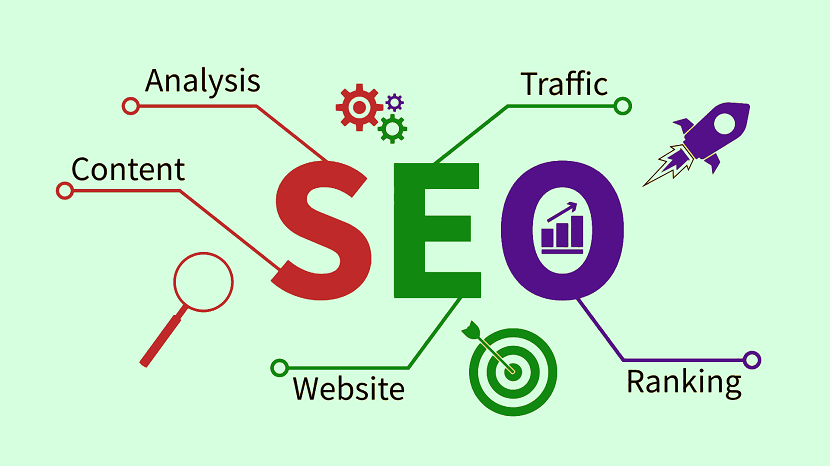
SEO stands for Search Engine Optimization and is the process of improving a website's performance, experience, and authority to gain better visibility in search engines like Google. The goal of SEO is to rank higher in organic (unpaid) search results.
SEO involves various strategies, including optimizing website content and structure, improving meta tags, using strategic keywords, and building backlinks. These tactics help the site appear higher in search engine results pages (SERPs), making it more likely that people will click through to the website. SEO is a critical component of digital marketing.
Contents Overview
What does SEO stand for?
SEO, or Search Engine Optimization, refers to the process of enhancing your website’s visibility in search results. Here’s what that entails:
Types of SEO (Search Engine Optimization)
Search engine optimization (SEO) is a part of internet marketing that aims to increase a website's visibility in organic search results. SEO can be divided into two main types: On Page SEO, Off Page SEO, Technical SEO, Local SEO, Content SEO, Mobile SEO, eCommerce SEO, Image SEO and Video SEO.
1. On Page SEO
On-page SEO refers to the practices used to optimize individual web pages to help them rank higher and earn more relevant traffic in search engines. It involves both the content and the HTML source code of a page (as opposed to off-page SEO which involves links and other external signals). Here are the key elements of on-page SEO:
2. Off Page SEO
Off-page SEO refers to the techniques used to improve the position of a website in the search engine results page (SERPs) that are implemented outside of the actual website. This aspect of SEO focuses on enhancing the perception of a site's popularity, relevance, trustworthiness, and authority. This is achieved through other reputable places on the Internet (pages, sites, people, etc.) linking to or promoting your website, effectively "vouching" for the quality of your content. Here are the key components of off-page SEO:
3. Technical SEO
Technical SEO refers to the process of optimizing the infrastructure of a website to help search engines crawl and index it more effectively. This aspect of SEO focuses on the backend structure and foundation of a site, ensuring that the site meets the technical requirements of modern search engines with the goal of improved organic rankings. Key elements of technical SEO include:
4. Local SEO
local SEO is a branch of search engine optimization that focuses on optimizing a business's presence to attract more business from relevant local searches. These searches take place on Google and other search engines but are specifically aimed at generating local results for users. Local SEO is crucial for businesses that have a physical location or serve a specific geographic area. Here are the key components of local SEO:
5. Content SEO
Content SEO refers to the aspect of SEO focused on creating and structuring content in ways that help improve visibility and rankings in search engine results pages (SERPs). It involves not only producing high-quality, relevant content but also ensuring it is optimized for both search engines and users. Here are the key components of content SEO:
6. Mobile SEO
Mobile SEO refers to the process of optimizing your website to ensure it performs well and provides a good user experience on mobile devices. As mobile traffic surpasses desktop traffic in volume, mobile SEO has become crucial for achieving high search engine rankings and capturing mobile user engagement. Here are the key aspects of mobile SEO:
7. eCommerce SEO
eCommerce SEO is the practice of optimizing online stores to rank higher in search engine results pages (SERPs) and attract more targeted traffic that can convert into sales. It involves a blend of general SEO practices along with strategies specifically tailored for eCommerce platforms. Here are the essential components of eCommerce SEO:
8. Image SEO
Image SEO is the practice of optimizing images to be discovered via search engines' image search features, contributing to the overall SEO performance of a website. It's particularly important for websites that rely heavily on visuals, such as eCommerce sites, art galleries, or recipe blogs. Optimizing images can enhance user experience, reduce page load times, and improve rankings. Here are key strategies for effective image SEO:
9. Video SEO
Video SEO involves optimizing video content to increase its visibility and ranking on search engine results pages as well as within video search engines like YouTube. It is an important aspect for businesses and content creators who use video to communicate with and engage their audience. Effective video SEO can drive more traffic to your website, enhance user engagement, and increase conversions. Here are key strategies for optimizing your video content for search engines:
Type of SEO Techniques
SEO (Search Engine Optimization) involves various techniques to improve the visibility and ranking of websites in search engine results. These techniques can be classified into different types:
1. White Hat SEO
White Hat SEO refers to the use of optimization strategies, techniques, and tactics that focus on a human audience opposed to search engines and completely follow search engine rules and policies. Here are some key aspects of White Hat SEO:
2. Black Hat SEO
Black Hat SEO refers to the use of aggressive SEO strategies, techniques, and tactics that focus primarily on manipulating search engine algorithms to gain higher rankings, rather than serving a human audience. These practices are against search engine guidelines and can result in severe penalties from search engines like Google. Here are some common Black Hat SEO techniques:
3. Gray Hat SEO
Gray Hat SEO is a practice that falls between White Hat and Black Hat SEO. It involves strategies that are not as clearly defined by search engine guidelines but could be considered questionable or might become classified as Black Hat SEO in the future. These techniques are often used by those looking to gain a competitive edge without crossing into outright Black Hat practices, but they still carry risks, including potential penalties if search engines update their algorithms and policies.
Here are some common Gray Hat SEO tactics:
4. Negative SEO
Negative SEO refers to the practice of using Black Hat and unethical techniques to sabotage a competitor’s rankings in search engines. It's a malicious tactic that targets other websites with the intention of causing harm to their search engine credibility and rankings. Here are some of the common methods employed in negative SEO:
Benefits & Importance of SEO (Search Engine Optimization)
SEO (Search Engine Optimization) is crucial for any business or individual seeking to increase their online presence and visibility. Here are some of the key benefits and reasons why SEO is so important:
Frequently Asked Questions (FAQs)
Search Engine Optimization (SEO) is a critical component of digital marketing. Here are some frequently asked questions (FAQs) about SEO that might help you understand it better:
1. What is SEO?
Answer : SEO stands for Search Engine Optimization. It involves optimizing a website or content to improve its visibility and ranking in search engine results pages (SERPs). This is done through various techniques such as optimizing content, improving site structure, and building backlinks.
2. Why is SEO important?
Answer : SEO is important because it helps increase the visibility of a website, attracting more traffic from organic searches. This can lead to increased brand awareness, higher sales, and more engagement.
3. What are the key components of SEO?
Answer : The key components of SEO are On-page SEO, Off-page SEO and Technical SEO
4. How do search engines rank websites?
Answer : Search engines use algorithms to determine the relevance and authority of pages. Factors that influence rankings include the quality and relevance of content, the user experience on the website, the number and quality of backlinks, and technical aspects of the site.
5. Can I do SEO myself?
Answer : Yes, it's possible to do SEO yourself, especially if you have a basic understanding of website management and online marketing. There are many resources available online to learn SEO, from blogs and tutorials to comprehensive guides and courses.
6. How long does it take to see results from SEO?
Answer : SEO is a long-term strategy. Typically, it can take several months to a year to see significant changes in search rankings due to the competitive nature of rankings and the time it takes for search engines to recognize and index changes.
7. Is SEO different from SEM?
Answer :Yes, SEO (Search Engine Optimization) is different from SEM (Search Engine Marketing). SEO focuses on optimizing a website to get traffic from organic search results, while SEM includes tactics like paid advertising (PPC) alongside SEO strategies to increase visibility.
8. How do I know if my SEO efforts are working?
Answer :You can track your SEO progress using tools like Google Analytics and Google Search Console. These tools provide insights into traffic, rankings, and conversions, helping you understand the effectiveness of your SEO strategies.
9. What are some common SEO mistakes to avoid?
Answer : Common mistakes include keyword stuffing, neglecting mobile optimization, using duplicate content, and ignoring meta tags and descriptions. It’s also a mistake to neglect the quality of content while focusing solely on SEO tactics.
10. How does content affect SEO?
Answer :Content significantly affects SEO because it helps to establish relevance and authority. High-quality, relevant content is more likely to be shared and linked to, which boosts SEO. Regularly updated content is also favored by search engines.
Conclusion
SEO, or Search Engine Optimization, is an indispensable strategy in the digital marketing landscape, aimed at enhancing the visibility and ranking of websites in search engine results. By leveraging techniques that span on-page optimization, off-page activities, and technical enhancements, businesses can attract higher organic traffic, improve user engagement, and increase their online authority. While SEO demands patience and consistent effort, the benefits are substantial, offering long-term gains in visibility and competitive advantage. As search algorithms evolve, staying informed and adaptable is crucial, making SEO an ongoing, integral part of any successful digital marketing strategy. Thus, businesses that invest wisely in SEO can expect to not only boost their online presence but also secure a significant edge in the increasingly crowded digital marketplace.
You might also consider exploring our lists of Profile Creation Sites and Directory Submission Sites to build quality backlinks for your SEO.
Additionally, we've put together a Technical SEO Checklist tailored for SEO professionals, which you might find useful.
If you find this article beneficial, please share it on your social media channels. Remember, sharing is caring!
If you found this article helpful, we encourage you to share it on your social media platforms—because sharing is caring! For more information about article submissions on our website, feel free to reach out to us via email.
Send an emailWritten by RGB Web Tech
Latest Technology Trends
Latest technology trends shaping the future, including AI advancements, blockchain innovation, 5G connectivity, IoT integration, and sustainable tech solutions. Explore breakthroughs in quantum computing, cybersecurity, augmented reality, and edge computing. Stay ahead with insights into transformative technologies driving innovation across industries and revolutionizing how we live, work, and connect.
What is Search Engine Marketing?
Last updated on January 19, 2025 by RGB Web Tech
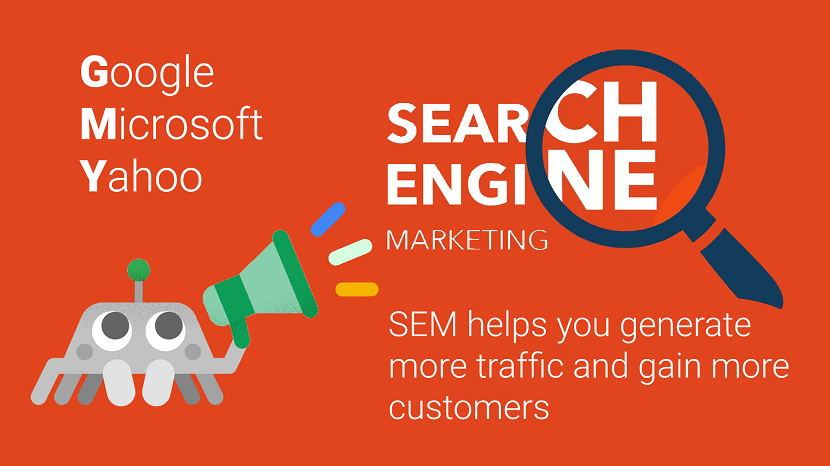
Search engine marketing (SEM) is a type of marketing aimed at promoting a website on search engine results pages. Securing your website a high position in search results, SEM helps you generate more traffic and gain more customers.
What is the difference between SEO and SEM?
It’s difficult to avoid ambiguity while speaking about the differences between SEO and SEM. Pushing your website to the top of the search engine results page (SERP) may include organic promotion and paid advertising, such as PPC ads. SEO has always been viewed as organic promotion, while views on SEM have changed with time.
At first, the term SEM involved both paid and organic strategies. In this case, SEO appears as a part of SEM. However, now marketers use the phrase “search engine marketing” more and more for paid activities only, which makes SEM and SEO two different categories. To avoid confusion, in this article we’ll use the word SEM for paid search advertising only.
Why is SEM important?
Coupled with SEO, SEM helps your business be on the top of search results in Google, Bing, and other search engine players. The first page of search results gets over 71% of all the clicks.
Search engine marketing becomes more and more significant as a traffic generation channel. While click-through rates of organic search results have fallen by 13% in the first quarter of 2019, SEM skyrocketed by 75% in the same span.
Better yet, audiences are loyal to SEM. 75% of people said paid search ads help them find the information they search for, and over 30% clicked on a paid search ad because it directly answered their search query.
Basic SEM Concepts
SEM is a very broad topic that has many different avenues to explore. Below, we've linked some articles to more specific topics within the SEM methodology.
1. SEO and SEM: SEO and SEM are essentials in online marketing strategies, but they are also two abbreviations that lead to a lot of confusion. Which is better for your brand and how can you leverage both to boost traffic and increase conversions?
2. SEM Positioning: SEM positioning is the paid method that's used to quickly gain search engine positioning.
3. SEM Campaign: A SEM campaign represents the entire advertising strategy that generates ads in search engines like Google. A campaign can encompass many different ad groups and keywords in order to increase positioning.
4. SEM on Google: The most popular form of SEM is on Google Ads. To create a SEM campaign on Google, go from the most general to the most concrete. There are many different ways to advertise on Google Ads, with a variety of ad options and structures.
Why Use SEM for Your Business?
There are many reasons to incorporate SEM in your digital marketing strategy. These are just some of the benefits of using Search Engine Marketing for your brand.
1. Bring highly qualified traffic to your page. One of the bases of any digital marketing strategy is to attract the right users to your landing pages. Search engine marketing is very effective in attracting users' attention and generating clicks by allowing users to filter based on the words they seek. This ensures that your traffic is made up of people who are potentially interested in your brand.
2. Make your brand or company known throughout the world. Placing yourself at the top of Google is a great way to get visibility for your brand. To see your page in the first place will allow the user to associate it with the need that they’re looking to solve even if they don't click on the page.
3. Generate conversions. Google Ads offers many ways to measure conversions and thus ensure that your ads are really effective.
4. Get results with a tight budget. Search engine advertising solutions can be adjusted to your budgetary needs at any time. You do not need a large initial investment, so these are suitable for small and medium businesses. If your brand is growing, the sky's the limit!
5. Finally, with Search Engine Marketing Google Ads solutions, you can not only place advertisements in the search engine, but also take advantage of the data and parameters available to place contextual advertising on other websites. The possibilities of personalization are very high. For example, you can target users who have already visited your website, are interested in X type of products, are from a specific city, etc. Combined with your search engine advertising campaigns, these can be powerful tools to grow your brand.
Advantages of SEM
1.Highly measurable. Tools like Google Ads give you highly detailed reports of the evolution of your campaign, so you can always know what is happening with your ads. In addition, you can take advantage of the integration with Analytics to have everything controlled to perfection.
2. Real-time monitoring. The analytics interface allows you to see what is happening at each moment and corrects the course to the moment if you do not get the results you are looking for.
3. Pay per click. With this, you will only pay if you get results. You can control the maximum daily budget that you are willing to invest as well as the maximum cost per click you can pay. This way, you make sure that the campaign is profitable.
4. Speed. Regarding other techniques such as SEO or content marketing, search engine advertising allows you to achieve relatively fast, large-scale results.
5. Within everyone's reach. Since budgetary investment is scalable, this solution works for both large companies and SMEs. They all compete in equal conditions to reach the first positions for keywords.
6. Segmentation. Finally, another positive of this tool is its great segmentation possibilities. By focusing on keywords, you will reach the public that is actively interested in you. You can also filter it by other factors such as location, language, or behavior.
Disadvantages of SEM
1. Higher long-term cost. To be clear, SEM only works while you pay. Although over time you can optimize your campaigns and reduce costs per click, you will have to continue paying for each of the visits you get.
2. High level of competition. Search Engine Marketing has become popular and there are many companies that compete to position themselves for the same keywords. This competition causes costs to rise and sometimes it can be difficult to get a good ROI.
3. It's interruptive. As opposed to other solutions like native advertising, SEM involves "invading" the user's space with content that they didn't seek out. In fact, if the user you are targeting has an ad blocker, they may not see your ads.
SEM Dictionary: Top Terms to Know
To finish, let's review the basic concepts you need to move through the world of search engine advertising. Since we use Google for the vast majority of searches, we are going to base ourselves on the terms that are used in Google Ads.
1. Keywords: keywords are the basis of all search engine marketing. Keywords are the words, groups of words, or phrases that will make your ad appear to users.
2. Text ad: the standard ad type that is shown in search engines. They usually have a title, two lines of text, and a customizable link.
3. Ad Group: Ad groups are ad sets and keywords. These are grouped into campaigns, in which you can define the daily budget and the countries or territories where the ads will appear.
4. Search Network: the part of the search engine where your ads can appear. The simplest thing is to work with text ads on the top and right of the results page but you can also show ads on other sites such as Google Shopping or Google Maps.
5. Impressions: the number of times an ad is shown.
6. Clicks: the number of times an ad has been clicked on.
7. CTR: the percentage of impressions that generate a click.
8. CPC: the average cost per click. You can define a maximum CPC to guarantee that you do not go over budget.
9. Quality level: Score (determined by Google) of a keyword and an ad to determine your CPC. In theory, the higher the quality of an ad, the less you pay for each click.
Today SEM is a necessity. However, it is much more powerful if used in combination with other tools such as SEO. The study of keywords is the fundamental pillar of the search engine strategy. The study of Buyer Personas is also crucial to understanding the audience when looking for certain keywords because it allows for more accurate segmentation.
How to Perform Keyword Research in SEM
When planning an SEM campaign, keyword research should always be one of the first steps. We can say that keywords are like the "bricks" from which the whole SEM account, ads, and even landing pages are structured.
To perform keyword research for SEM campaigns, take note of the following steps.
1. Analysis of the Product or Service (And, if Already Created, of the Landing Page)
Keywords should always be relevant to the product or service you are offering. Therefore, the first step is to draw up a list between two and ten main ideas that summarize the services or products you offer. In addition to studying your own offer, you can also take a look at your competitors' sites.
2. Keyword Research Tools
There are many keyword planning platforms on the market, such as SemRush and Google keyword planner. If you enter the basic ideas defined in the previous section, the tool will provide you with a list of related keywords. To filter the results, you can segment by location and language.
The good thing about these tools is that they can give you a lot of suggestions that you would never have thought of. Of course, there also are times when they offer suggestions that aren't to the original search. And this brings us to the next step...
3. Filtering and Selecting Keywords
Using the keywords as a starting point, you will have to filter manually to discard irrelevant words, group related keywords, and select those that have the highest number of searches and the lowest competition (i.e. that there are not many advertisers bidding for lor the same word).
And that's it! You now have a definitive list of keywords to optimize your SEM campaign. To get the best results, these keywords should be present both on your landing pages and in your ads.
How to Develop a SEM Campaign Step by Step
Strategy and planning are fundamental to guarantee the results of your SEM campaign. Let's take a look at what it takes to launch a successful campaign.
1. Keyword Research
Keywords are the basic foundation on which the entire SEM strategy is structured. To carry out a complete keyword study, you must pay special attention to:
2. Campaign Creation
The time has come to put your entire SEM strategy into place. These are some of the key aspects that you will have to define to launch a campaign in Google Ads or any other tool:
3. Measurement and Optimization
The work doesn't end after launching the campaign; SEM is based on continuous optimization. Therefore, you must periodically monitor the results of your campaigns to be able to swap out keywords, creatives, and any other aspects of the campaign.
To make sure you don't miss anything, you can set up alerts for critical aspects of the account and define a specific review schedule.
Bonus: Take Advantage of SEM to Do SEO
SEM and SEO are two closely related disciplines, as they both seek to rank on Google. Therefore, you can take advantage of the effort invested in SEM to improve your organic positioning.
Keyword research will help you detect keywords that can help you position your page organically, although they may not result in quick conversions. However, the results will help you identify which topics are more interesting for users and can help you to get more traffic and visits.
Most Popular Search Engines for SEM
When we think of search engines, usually the first thing that comes to mind is Google. But the truth is that there are other SEM platforms that can also give us good results. These are the three main solutions for search engine advertising.
1. Google Ads
Google Ads is one of the main search engines. Here are some tips for using it:
2. Microsoft Advertising or Bing Ads
Bing Ads (or Microsoft Advertising) is a very solid alternative to Google Ads, as it reaches a relevant potential audience (almost 10% of the market share) and has very good targeting and configuration options.
In general, it is a very similar tool to Google Ads, but there are some differences that you should be aware of:
3. Yahoo Ads
Yahoo Advertising or Yahoo Ads is Yahoo's advertising solution, which allows you to reach users who perform searches on this search engine.
How a SEM Agency Can Help You
SEM tools, such as Google Ads, are very complex. It's to manage a lot of variables and be aware of the results in real-time in order to be able to continuously optimize the account. Therefore, it is worthwhile delegating this work to a SEM agency, which can carry out tasks such as:
1. SEM campaign design: defining objectives and budget and creating the campaign structure, keywords, and ad groups.
2. Keyword planning and optimization: selecting the right keywords and precise match levels is critical for good SEM results. The agency will perform both initial keyword research and ongoing monitoring of results.
3. Ad creation: with SEM ads, there is very little room to attract potential customers, so it is essential to create well-designed creatives.
4. Campaign monitoring: the agency will perform continuous analysis of the data to be able to make decisions in real-time and achieve the best results.
5. Quality level optimization: this parameter is one of the most important in SEM, since it allows for maximizing results and minimizing costs at the same time. CPC and bid management: through continuous analysis of CPC and the position of the ads, an agency seeks to optimize the bids in order to achieve the highest number of quality clicks at the best cost.
6. Conversion rate optimization: by analyzing and adjusting different aspects of the account, from keywords to landing page design, you ultimately aim to achieve more conversions and increase the profitability of the account
FAQs - SEM ( Search Engine Marketing )
1. What is search engine marketing?
Search engine marketing (SEM) is a digital marketing strategy used to increase the visibility of a website in search engine results pages (SERPs).
2. What is SEM and why is it important?
Search Engine Marketing refers to a variety of techniques and strategies a company can use to generate more visitor traffic from search engine results pages (SERPS) to a website. The goal of SEM is to promote a website's visibility using paid search, contextual advertising, and organic search rankings.
If you found this article helpful, we encourage you to share it on your social media platforms—because sharing is caring! For more information about article submissions on our website, feel free to reach out to us via email.
Send an emailWritten by RGB Web Tech
Latest Technology Trends
Latest technology trends shaping the future, including AI advancements, blockchain innovation, 5G connectivity, IoT integration, and sustainable tech solutions. Explore breakthroughs in quantum computing, cybersecurity, augmented reality, and edge computing. Stay ahead with insights into transformative technologies driving innovation across industries and revolutionizing how we live, work, and connect.
11 Simple Social Media Optimization Tactics for Faster Growth
Last updated on January 19, 2025 by RGB Web Tech
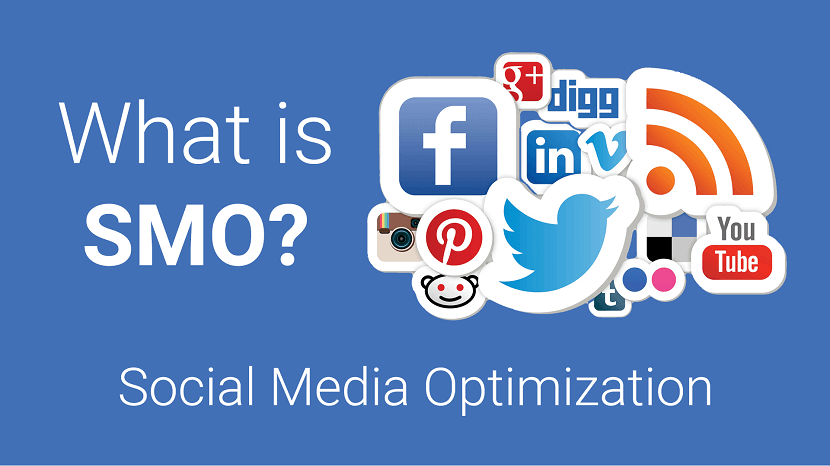
Social Media Optimization (SMO) helps business owners, content creators and social media marketers get the most out of their social media presence.
Understanding how to optimize your social media profiles and posts for maximum returns might sound scary, but we’ve put together a list of simple tactics that don’t involve complicated keyword research or require technical know-how.
Read on to find out how to:
11 Easy Social Media Optimization Tactics
What is social media optimization?
Social media optimization is the process of improving your social posts (or your whole social media strategy) to achieve better results: faster follower growth, higher levels of engagement, more clicks or conversions, etc.
Social media optimization can involve many different techniques and tactics that vary in scope and complexity:
Benefits of social media optimization
Here’s what the right social media optimization tactics can do for your social media efforts:
11 Social Media Optimization Techniques to Start Doing Now
To the untrained eye, a brand’s social media presence might seem effortless, but there’s a lot that goes on behind the scenes to ensure that social media accounts are being used as effectively as possible.
1. Post at the right time
To win big on social media, you need to consistently post content that not only gets your audience excited, but that is also posted at a time when they’re most likely to engage.
Figuring out the most optimal time to post on social media is hard work. But luckily for you, we’ve spent hours researching and analyzing millions of social posts to figure this out. It’s between 10:00 AM on Tuesdays, Wednesdays, and Thursdays.
But don’t forget that this is a general guide. What works for your social media pages and your audience might be different.
Use an online scheduling tool that has the best time to publish features (we might be biased, but Hootsuite is pretty good!) and take advantage of posting your social media content when your audience is most likely to be online and engage with what you’re serving up.
2. Polish your bios
Your social media bio is potentially one of the first things a new visitor or potential lead sees when visiting your profile page. So, it’s essential to have this as polished as possible. Important information to always include:
Check out how Hootsuite nails their bio by ensuring that the message of being a “global leader in social media management” is consistent across social channels.
You might also want to consider including a call to action (CTA) in your bio that encourages visitors to click on a link to your website, an online store, or a key landing page. Feel free to swap out the link in your bio regularly with your most up-to-date, highest-quality content or a key landing page that you need to drive traffic towards.
Pro tip: Use a tool such as One Click Bio to create a link tree, and sneak more than one link into your bio. With a bio link tree, you can easily promote your most-recent content, link to your other social accounts, direct traffic to an online store or landing page, and keep your profile visitors engaged with your business.
3. Optimize your links with UTMs
As we’ve just mentioned above, social media optimization often uses links to direct visitors to a webpage where they can continue their engagement with the brand. Doing this is important to drive traffic to your website, content, or landing pages.
Link optimization is an integral part of understanding how your audience engages with the links you’re sharing. Tracking your customer’s behavior lets you see what posts drive the most traffic from your links and which don’t. You can quickly and easily track behavior by adding UTMs to your social media channels and posts.
Need more info on how to use UTMs on social media? This post has all you need to get started.
4. Make sure your images are the right size
There’s nothing worse than visiting a social profile and the images look terrible, amiright? Your brand’s look is everything, darling. So, make sure that your images look professional, polished, and—most importantly—are the right size.
At the absolute least, ensure that your profile picture is a high-resolution image that isn’t overly cropped, speaks to your brand (preferably a company logo), and clearly represents your business. Oh, and you’ll want your profile images to be consistent across all your social channels, too. Doing this will help your audience with brand recognition.
When in doubt, check out our always-up-to-date cheat sheet to image sizes across networks. Or, bookmark this sheet with basic specs:
5. Post the right amount
You don’t want to bombard your audience with posting non-stop, and you also don’t want to post so little that you fall off their radar. Finding your optimal social media posting schedule is essential to driving more engagement and conversations with your brand.
Here’s how often you should post to the biggest social media networks in 2022, according to experts:
Remember that finding the sweet posting spot might take some time. Experiment and find what cadence works best for you.
6. Review your social media strategy
Take the time to look over your current social media strategy and think about the following areas:
When thinking about the above points, consider how your SMO will positively (or sometimes, negatively) impact them.
To get insider information on your company’s social performance, most platforms have built-in analytics to help you understand if your social strategy is working or not. Tools like Hootsuite Analyze give you additional valuable insights.
If you want to go one step further, you can always A/B test your social media optimization and see whether one tactic vs. other works better.
For example, if you’re an online organic grocery store and want to create more conversation about food waste, what image drives more engagement from your audience? A photo of an overly full landfill producing methane gasses or a photo of a reduced grocery bill?
A quote from a wise old marketing person (okay, it’s me) says, “always be testing,” and SMO is the perfect opportunity to do so.
7. Always keep your audience top of mind
Not all audiences are the same. Spend some time digging into the demographics to optimize your social media content for the right groups.
For example, if you’re targeting an audience in England, you might want to ditch US colloquial language. Similarly, if you’re targeting an audience in America, you might not want your social media copy to sound too British, guv’nor.
8. Optimize your accounts for search
Not all of your posts need to use this tactic because not all of your posts need to be discoverable by a searcher. Sometimes, you’ll be posting on social media just to communicate with your audience. Remember to be strategic. For example, when we share this post, we’ll include the keyword “social media optimization” as a hashtag to help with the post’s discoverability.
You could also speak with your SEO team to find out the most important keywords for your brand and incorporate these into your social posts for an extra boost to your organic performance.
Fitness Goal 4U A Few Fun Moves incorporates hashtags related to wellness in their posts to help searchers and potential new customers discover them on Instagram.
9. Create consistency with your username
Your username across your social media channels speaks volumes about who you are and is an essential piece of the puzzle as to how your brand comes across. Therefore, it’s important to be consistent with your username.
For example, having the username @rgbwebtech on Twitter and /rgbwebtech for Facebook looks a lot better than @webtech and /rgbwebtech123.
10. Write catchy headlines and captions
Not everyone is a writer. Hire a copywriting professional or social media expert to help you craft catchy headlines and captions that achieve your goals. Remember, copy that feels appropriate for Twitter might be utterly different from copy for TikTok. Experiment and test what language and words resonate with your audience the most.
It’s important to maintain your brand voice throughout your posts and captions and find that sweet spot between being conversational and promotional.
11. Add tags to your posts
If your social media post features another brand or a customer, it’s best practice to tag that person in your post. Not only does this earn you massive niceness points, but it also helps create natural conversation and communication on your post.
A golden rule of thumb is that if your post contains user-generated content (UGC), always make sure you tag whomever the original content is from.
Ready to begin optimizing your social media posts and profile? Hootsuite has the tools and insights to help you understand if your optimization efforts are working or not. Sign up today to get started.
FAQs - Social Media Optimization
1. What is meant by Social Media Optimization?
Social media optimization is the process of creating content that easily creates publicity via social networks. The goal is to create past, current and potential customers by amplifying your message on social media sites
2. Is Social Media Marketing and Social Media optimization same?
Social media optimization (SMO) and social media marketing (SMM) are two different things. Social media optimization is a process of making your website social media marketing ready. While social media marketing is a process to market your business on social networks.
Conclusion
Social Media Optimization can be a powerful tip for any organization. It can increase your visibility, enhance relationships, establish two-way communication with customers, provide a forum for feedback, and improve the awareness and reputation of the organization.
Social media optimization can completely change the way you approach your marketing strategies. Next time you plan a marketing strategy, make sure that you include social media optimization in your plan!
Start taking a strategic approach to your social media posting and see the results!
If you found this article helpful, we encourage you to share it on your social media platforms—because sharing is caring! For more information about article submissions on our website, feel free to reach out to us via email.
Send an emailWritten by RGB Web Tech
Latest Technology Trends
Latest technology trends shaping the future, including AI advancements, blockchain innovation, 5G connectivity, IoT integration, and sustainable tech solutions. Explore breakthroughs in quantum computing, cybersecurity, augmented reality, and edge computing. Stay ahead with insights into transformative technologies driving innovation across industries and revolutionizing how we live, work, and connect.
Social Media Marketing for Businesses
Last updated on January 19, 2025 by RGB Web Tech

When you use social media marketing, whether on Facebook, Twitter, Instagram, LinkedIn, or another platform, you’re engaging and interacting with your audience on multiple levels, building their brand awareness and interest to drive leads and sales.
You can create devoted fans of your business through your social media strategy.
What is social media marketing?
Social media marketing is a digital marketing strategy that uses social media to promote your business online.
When you market your business with social media, you use different social media networks, like Facebook or Instagram, to connect, engage, and communicate with your target audience, as well as promote your products or services to drive brand awareness, website traffic, and sales.
It sounds easy enough, but there is more to SMM than meets the eye.
This guide serves as your partner for getting started with social media and learning the basics of social media. Use it to learn how to bring social media and marketing together. Plus, get inspiration from real-life social media marketing campaigns.
Social Media Marketing Guide Definitions
Here are some common terms you need to know when developing your social media marketing strategy.
Core Pillars of Social Media Marketing
There’s no doubt about it: these days, your business needs to be on social media, and you should concentrate at least some of your marketing efforts (and budget) on your social media strategy.
With 4.48 billion people owning social media accounts, there’s a whole world of potential customers that any business can access, simply by logging in and creating brilliant content.
Brands like BooHoo, Depop, and Chipotle excel at social media, and there’s one simple reason: they integrate the core pillars of social media marketing.
There are five main pillars. Let’s talk through them one by one.
1. Strategy
A sound social media marketing strategy is the backbone of your social media presence. Without a strategy, you’re wasting time, unlikely to achieve your goals, and will most likely struggle to reach your target audience.
In case you’re not sure, a content strategy consists of getting the “Right content, to the right people, at the right time.”
In its most basic terms, a content strategy helps you achieve your business goals by enabling you to:
A good social media marketing strategy has clear goals, specific plans to reach those goals, and must be measurable.
Finally, you need to set benchmarks to see how things are going and whether you need to change your approach.
2. Planning and Publish
Social media is a powerful tool, but you can’t just go out there and start publishing content without a plan behind it.
When you’re planning content make sure that you:
When it comes to publishing, there is one golden rule: consistency. A regular publishing schedule keeps people coming back for more.
3. Listening and Engagement
Plan your content and above all, actually engage with your audience.
Your feedback might not always be positive; but, if you don’t make changes, neither will the tone of your responses.
Listening and engagement are all part of a successful digital transformation, especially if you’re going to enhance the overall customer experience.
It’s also worth mentioning that social listening isn’t just about customer experience. It can allow you to:
Need some assistance to get started with social listening? Hootsuite has a free introductory tool for measuring key terms and hashtags.
4. Analytics
The success of any social media marketing campaign depends on analytics for tracking and collecting data. Without this information, you can’t:
Once you have all this, you’ll know with certainty what works and what doesn’t. That way you can spend more time on what does, and waste less. In turn, analytics will inform the decisions that you make for future campaigns—and highly influence the success rate.
Similarly, A/B testing is great for determining what content, design, CTA, etc. work best.
If you’ve been noticing certain types of content receiving double the engagement than other posts, play on that.
For example, if you’re a small business, your followers are most likely going to be family and friends who will love the personal insight and celebratory posts because they care about you and your successes.
Producing high-quality content that your audience isn’t interested in will mean that engagement levels tank. You need to work on making sure your posts appear in people’s feeds before you start feeding through those insightful industry blogs.
5. Advertising
For anyone looking for an audience, social media advertising is worth exploring. With approximately 2.89 billion active monthly users on Facebook alone, that’s an incredible amount of prospects.
The three main types of social media advertising are:
In today's digital age, the demand for captivating online content is at an all-time high, particularly for social media platforms. To meet this demand and create engaging posts and videos, content creators often rely on the expertise of an online video editor. As a powerful tool, an online video editor enables creators to transform their raw footage into visually appealing content that stands out in the crowded social media landscape. With features like trimming, merging, adding transitions, and applying special effects, an online video editor empowers creators to craft professional-looking videos that capture attention and drive engagement.
There are several ways you can advertise on social media. For example, you can:
Additionally, if you aim to enhance your brand recognition, build loyalty, and increase conversion rates, advertising could be the way to go.
Aside from these main pillars, you should also:
Finally, ensure you’re accessible on social media so your customers know they can reach out to you. Don’t just wait for feedback. Invite it!
Different Types of Social Media Marketing
Aside from the likes of Facebook, Twitter, and Instagram, social media marketing takes many different forms, such as:
If you’re serious about growing your brand, don’t just focus on the large sites with a vast audience. Although they’re an obvious place to start, look for different, more creative ways to engage your prospects and develop leads.
Also, while you’re exploring some of these other methods, find which content works best for each channel to optimize your results.
FAQs of Social Media Marketing
1. What is meant by social media marketing?
Social media marketing (SMM) is a form of internet marketing that uses social media apps as a marketing tool. These social media platforms enable brands to connect with their audience to build a brand, increase sales, and drive traffic to a website.
2. What is an example of social media marketing?
Social Media Marketing (SMM) is marketing that targets social platforms like Facebook, Instagram, TikTok for brand promotion, target audience growth, driving website traffic, and increasing sales.
3. What is the role of a social media marketer?
Social media marketers are marketing specialists who use social media platforms to promote a company's offerings. They often use platforms like Facebook, Instagram, Twitter, and TikTok to reach new customers, engage with current ones, and announce new products or services.
Conclusion
It's clear that social media marketing has its advantages, so if your business doesn't already have the appropriate profiles, create them! Fill out your business' information and post some engaging content to begin gaining followers. As mentioned, ask people relevant to your business to "like" and "share" your page to help build your profile. With consistent updating, the right social media marketing strategy will lead to increased traffic, better SEO, higher conversion rates, improved brand loyalty, and much more. There are virtually no reasons not to implement social media into your marketing strategy. Since it is so cost-effective, there is hardly anything to lose. Your competition is most likely already on social media, so don't let them take your potential customers. The sooner you start, the sooner you'll see growth in your business.
If you found this article helpful, we encourage you to share it on your social media platforms—because sharing is caring! For more information about article submissions on our website, feel free to reach out to us via email.
Send an emailWritten by RGB Web Tech
Latest Technology Trends
Latest technology trends shaping the future, including AI advancements, blockchain innovation, 5G connectivity, IoT integration, and sustainable tech solutions. Explore breakthroughs in quantum computing, cybersecurity, augmented reality, and edge computing. Stay ahead with insights into transformative technologies driving innovation across industries and revolutionizing how we live, work, and connect.
What is Reputation Management?
Last updated on January 19, 2025 by RGB Web Tech
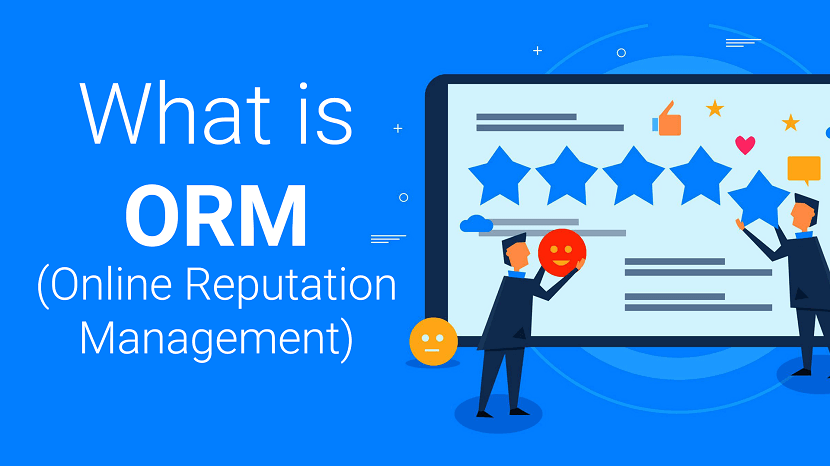
Only a decade ago, things like PR and reputation management seemed like matters of concern for big businesses and celebrity personas. And it seemed like smaller brands had little to care about; their brand perception was a one-way alley with customers having little room for feedback.
After all, they could just choose to ignore the business’s products and services, but their perception had little impact. But we are now living in an era of an active audience, one where people express their opinions about brands and services on several platforms online all the time.
And, with 71% of consumers starting their customer journey with a Google search, no business can afford to show up on the SERPs appearing untrustworthy and disreputable.
To avoid any potential issues, here is an extensive guide on Online Reputation Management for businesses of any size and industry to help digital marketing professionals discover effective ways to manage their brand’s online reputation.
What is Online Reputation Management (ORM)?
Online Reputation Management, or ORM, (not to be confused with online review management) is a multi-faceted concept that is aimed at creating a positive public perception of a brand, business, or person. Reputation management includes monitoring reputation, addressing any content or customer feedback that could damage the brand, and using strategies to prevent and solve problems that could damage an entity's reputation.
How Online Reputation Management Works
In a nutshell, ORM is all about monitoring and managing your brand’s reputation across the web, about ensuring that your business is properly represented and that potential customers are left with a great impression on who you are and what you do.
That said, multiple channels fall within Online Reputation Management, and since it may seem overwhelming at first to embrace all these channels, let’s think about them in terms of the PESO model.
The 12 main benefits of managing your online reputation
Here are the top reasons why it’s worth considering implementing an online reputation management process for your business:
1 Improving brand credibility
Let’s face it – negative comments are bound to come up, regardless of how much effort you invest into keeping your buyers happy. And customers can be merciless – according to PwC, 32% of shoppers would walk away from a brand after just one bad experience.
That said, it all comes down to how you handle a negative brand mention once it shows up. When you manage your online reputation and respond to comments, reviews, and mentions (both positive and negative), you build credibility. There’s no better way to show that you care about your customers than by responding to a negative comment gracefully and making amends, whenever need be.
2 Boosting customer engagement
The more channels your organization monitors and is active on, the higher your chances of boosting your customers’ engagement rates. This is possible by embracing both a proactive and reactive approach to client interactions. By being active online, providing customers with special offers, and responding to their queries and comments swiftly, you can keep them invested in your brand. As a result, they will be less tempted to churn and move to your competitors.
3 Increasing sales
While spontaneous shopping still happens from time to time, most of us do online research prior to buying. In fact, 81% of consumers admit that they surf the Internet gathering information about the product they’re planning to purchase before they do so. Sometimes, one negative review is enough to change our minds and make us lean more towards other products. There is a link between good online reputation and increased sales – the more positive company mentions appear, the higher the chance of closing a sale.
4 Optimizing online marketing to trigger reactions
Monitoring your online reputation can also be a great source of inspiration for your marketing initiatives. In a tool like SentiOne, you can check how your audience reacted to your past content and marketing campaigns. For instance, below is an example of how people reacted to two announcements by mBank, one of the biggest banks in Poland. The first spike, in mid-October 2020, relates to the brand’s support of the All-Poland Women’s Strike, while the second, in January 2021, is a response to the bank’s participation in the country’s biggest charity event, The Great Orchestra of Christmas Charity.
Through tracking your reach and brand mentions, you’ll know which campaigns work and which don’t, what messaging resonates with your customers and leads, and what kind of actions drive negative reactions. Summarizing your findings will help you decide what marketing campaigns to run, which will result in higher ROI.
5 Building trust
Trust is the basis for forming long-lasting relationships with customers, which supports business growth. However, as mentioned earlier in the reputation management definition, responding to brand mentions in your owned media only won’t be enough. Even if you have a good brand reputation today, you can’t take it for granted as there are many threats lurking around the corner. Just imagine what could happen if you failed to notice a major website slamming you in their review!
It’s also necessary to verify the information posted about brands online to make sure it’s consistent and true. This can be certainly achieved by using a tool that tracks and alerts you about mentions from all parts of the web.
6 Showing customers that you care
Monitoring what people say about brands online and responding to both negative and positive comments shows them that you care. Naturally, all of us would like to receive flattering comments only, and these are certainly easier to respond to. However, negative comments can also prove beneficial to a brand long-term. They are a source of invaluable feedback – take into account what customers say and fix the issues. Never ignore disheartening opinions as they might escalate into a social media crisis. Responding to both positive and negative comments will help you build better relationships with customers.
7 Encouraging recommendations
Did you know that 90% of people believe in brand recommendations from friends? Considering the fact that consumers casually talk about brands 90 times per week – online reputation management is definitely something that you should care about. Since people tend to trust other people more than their trust advertising, making sure that you get a continuous flow of word-of-mouth recommendations through effective online reputation management is key.
8 Increasing web traffic
Positive news or opinions – especially those coming from reputable sources – have the potential of becoming viral. With an online reputation management tool, for instance, you’ll be able to spot a top news outlet lauding your service. This will explain any sudden spikes in organic traffic. You can use this to gain further momentum. Display the positive review/brand mention across your online channels to boost your reputation. If done well, this can result in increased conversion.
9 Attracting employees
A positive online reputation not only translates into increased sales but can also attract a lot of interest from potential job seekers. The best candidates are keen on working for companies with a good reputation – and since the war for talent is fierce, it might help companies get the best employees on board.
10 Easier to deal with potential crises
Brands that put in the effort to maintain a good online reputation are overall better equipped to deal with any crisis. Especially if they use an ORM solution that alerts them of any crisis-related terms used in relation to their brand. Also, a gentle stumble will be easier forgiven by customers if a brand has an overall positive reputation.
11 Improving your Brand Health & Customer Satisfaction scores
Online reputation management gives you the chance to react quickly to mentions of your brand. In the case of unflattering reviews on your owned channels, you can make amends quickly and, perhaps, change the customer’s negative opinion into a neutral or positive one. This could have a positive outcome on your customer satisfaction scores like CSAT or NPS.
Respectively, in the case of external channels, ORM will give you a chance to advocate for your brand and quickly put an end to any detrimental rumors.
12 Getting more testimonials for your website
Last, but not least, if you use an online monitoring tool like SentiOne, not only will you be able to identify brand mentions but also filter out the positive ones. You can then reach out to your most delighted fans and ask them for a citation which you can then turn into a testimonial to place on your website. To kickstart your efforts, think of places like Google Play, Apple App Store, and specialized online review platforms.
FAQs - Online Reputation Management1. What does online reputation management mean?
Online reputation management is the process of controlling the online narrative of a person, company, or brand. It consists of reputation protection, monitoring, crisis management, and reputation recovery. 88% of consumers perform online research before making a purchase.
2. Is reputation management illegal?
These tactics are always unethical and, in some cases, illegal. Some black hat reputation management tactics include creating a slew of false accounts to report competitors, developing fake websites for review placements, and developing spam content.
1. What does online reputation management mean?
Online reputation management is the process of controlling the online narrative of a person, company, or brand. It consists of reputation protection, monitoring, crisis management, and reputation recovery. 88% of consumers perform online research before making a purchase.
2. Is reputation management illegal?
These tactics are always unethical and, in some cases, illegal. Some black hat reputation management tactics include creating a slew of false accounts to report competitors, developing fake websites for review placements, and developing spam content.
Final Thoughts - Online Reputation Management
As we’ve mentioned in the online reputation definition provided in this post, there are a variety of actions you need to take to maintain a positive view of your brand online. Regardless of your industry, it is crucial to track, collect, analyze, and manage your brand reputation. If you engage in ORM continuously, there are numerous benefits you can expect, including:
The best way to manage your online reputation is by using an online monitoring tool like SentiOne. You’ll be able to monitor countless online sources including social media, blogs, forums, and portals in real-time. By listening to online conversations and analyzing what customers or leads say about your or your competitors, you’ll be able to identify and respond to any potential PR crisis.
If you found this article helpful, we encourage you to share it on your social media platforms—because sharing is caring! For more information about article submissions on our website, feel free to reach out to us via email.
Send an emailWritten by RGB Web Tech
Latest Technology Trends
Latest technology trends shaping the future, including AI advancements, blockchain innovation, 5G connectivity, IoT integration, and sustainable tech solutions. Explore breakthroughs in quantum computing, cybersecurity, augmented reality, and edge computing. Stay ahead with insights into transformative technologies driving innovation across industries and revolutionizing how we live, work, and connect.
Conversion Rate Optimisation (CRO)
Last updated on January 19, 2025 by RGB Web Tech

Today, most marketing teams are focused on driving traffic toward websites in hopes that this traffic then converts into qualified leads for sales reps to close. But that's only half the battle.
Getting more out of existing traffic and leads (versus entirely new traffic) can propel companies toward long-term, sustainable growth. That's where conversion rate optimization (CRO) comes in. In this guide, you'll learn about the power of CRO, why your business should focus on improving your conversion rate, and how to get started.
Conversion Rate Optimization
Conversion rate optimization, or CRO, is the process of enhancing your website to increase the number of leads you generate. CRO is achieved through content enhancements, split testing, and workflow improvements. Conversion rate optimization results in highly-qualified leads, increased revenue, and lower acquisition costs.
What is a conversion rate?
A conversion rate is the percentage of visitors who complete a desired action, like completing a web form, signing up for a service, or purchasing a product.
A high conversion rate means your website is well-designed, formatted effectively, and appealing to your target audience. A low conversion rate could be the result of a variety of factors related to either website performance or design. Slow load times, a broken form, or copy that doesn’t convey the value of the offer are common reasons for a poor conversion rate.
What is a good conversion rate?
A "good" conversion rate depends on your industry, niche, goals, traffic channel, and audience demographics, among other factors. For example, the average conversion rate of ecommerce sites globally was 2.17% in the third quarter of 2020, which was down from 2.37% the previous year. The ecommerce conversion rate in the US was higher, however, at 2.57%.
The average not only differs by year and by country — it also differs by niche. For example, the average conversion rate of ecommerce sites in the food and beverage sector is 5.5% whereas the average in the hair care sector is 3.5%.
If your conversion rate is lower than you'd like — maybe it's below average in your industry, or lower than your top competitors, or simply underperforming against your own goals — then it's time to optimize.
Conversions can happen all over your website: on your homepage, pricing page, blog, landing pages, and more. To maximize the potential of converting website visitors into paying customers, you should optimize each location.
Before we take a look at the benefits of CRO, let's walk through how to calculate your site's conversion rate. That way, you'll have a better understanding of how much time and resources to invest in a CRO strategy.
How to Calculate Conversion Rate
Conversion rate is calculated by dividing the number of conversions by the number of visitors and multiplying that number by 100 to get a percentage.
As long as you know how you're defining a conversion, then calculating your conversion rate is easy. You just plug in two values and multiply by 100.
Let's say you're defining a conversion as a newsletter opt-in, and you have an opt-in form on every single page of your website. In that case, you'd divide the total number of newsletter form submissions by the total number of website visitors and multiply it by 100. So if you had 500 submissions and 20,000 visitors last quarter, then your conversion rate would be 2.5%.
You can repeat this process for every conversion opportunity on your site. Just make sure to only count the number of visitors on the webpages where the offer is listed. For example, if you want to calculate the conversion rate of your ebook offer, then you'd divide the total number of downloads by the number of people who visited web pages where the ebook offer is listed.
Alternatively, you can calculate your website's overall conversion rate by dividing the total number of conversions for every conversion opportunity on your site by the total number of visitors on your site.
Where to Implement a CRO Strategy
Here are four areas of your website that have the potential to largely benefit from conversion rate optimization.
1. Homepage
Homepages are prime candidates for CRO. In addition to making a first impression on visitors, the homepage is also an opportunity to retain those visitors and guide them further into your website.
You can do this by emphasizing links to product information, offering a free signup button, or even incorporating a chatbot that solicits questions from visitors at any point during their browsing experience.
2. Pricing Page
A website's pricing page can be the make-or-break point for many website visitors. CRO can help a pricing page convert visitors into customers by modifying the pricing intervals (e.g. price-per-year vs. price-per-month), describing the product features associated with each price, including a phone number for visitors to call for a price quote, or adding a simple pop-up form.
Hotjar, for example, added a simple email opt-in popup form on its pricing page and got over 400 new leads in just three weeks.
3. Blog
A blog is a massive conversion opportunity for a website. In addition to publishing thoughtful and helpful content about your industry, a blog can use CRO to convert readers into leads.
This process often includes adding calls-to-action (CTA) throughout an article or inviting readers to learn more about a topic by submitting their email address in exchange for an ebook or industry report.
4. Landing Pages
Since landing pages are inherently designed for people to take an action, it makes sense that they have the highest average conversion rate of all signup forms at 23%. An event landing page, for example, can be optimized with a video of last year's event to encourage visitors to register this year. A landing page that's offering a free resource can be optimized with preview content from that resource to encourage visitors to download it.
Now that you know where you can optimize for conversions, you may be wondering how you know when your business is ready to start the process.
CRO Formulas
The short answer: CRO is important for any business online. That's because, no matter how established or large your company is, you want to convert your website visitors into qualified leads, customers, and brand advocates — and you want to do so in the most effective, impactful, and reliable way.
With conversion rate optimization, you'll get more out of your existing website traffic while ensuring you're targeting qualified leads.
Although this is a straightforward concept, setting a conversion goal isn't as easy as saying, "This page converted 50 people this month, so we want to convert 100 people next month."
Featured resource: 8-Week Conversion Rate Optimization Planner
You don't just want 50 more conversions from a webpage. Instead, you want 50 more conversions for every X amount of people who visit it. (This is your conversion rate — the percentage of people who convert on your website based on how many people have touched it).
To provide a better understanding of where you stand at any point in time in regards to conversion rate, here are three commonly-used formulas your business can use to understand, analyze, and improve.
CRO Calculation 1: Conversion Rate
As we mentioned earlier, to calculate conversion rate, you must divide your number of conversions (or leads generated) by your number of visitors (or web traffic), and then multiply that number by 100 to get the percentage.
Leads Generated ÷ Website Traffic x 100=Conversion Rate %
CRO Calculation 2: Number of Net New Customers
To calculate your number of net new customers, you'll want to divide your net revenue goal by your average sales price.
New Revenue Goal ÷ Average Sales Price=Number of New Customers
CRO Calculation 3: Lead Goal
And lastly, to calculate your lead goal, take your number of new customers and divide it by your lead-to-customer close rate (which is your total number of leads divided by total number of customers) percentage.
Number of New Customers ÷ Lead-to-Customer Close Rate %=Lead Goal
Here's an example of these formulas in action:
If your website has 10,000 visitors per month that generate 100 leads — and subsequently, 10 customers each month — the website visitor-to-lead conversion rate would be 1%.
What if you wanted to generate 20 customers each month?
You could try to get 20,000 visitors to your website and hope that the quality of your traffic doesn't decrease — although, that's a risk you'll likely want to avoid. Rather, you could obtain more leads from your existing traffic by optimizing your conversion rate. This is less risky and is more likely to produce better results for your bottom line.
For instance, if you increase your conversion rate from 1% to 2%, you'd double your leads and your customers. The following table is proof of this — you can see the positive impact that results from increasing your website's conversion rate:
Notice the drastic increases in the number of leads generated and net new customers when you boost your conversion rate.
Not only that, but it's clear that generating more website traffic isn't necessarily the right approach when trying to improve your conversion rate — in fact, this chart shows you that you can grow your business substantially without increasing traffic at all.
Hard to believe?
Think about this way: Pretend you were trying to fill up a leaky bucket. If you pour more water into the bucket, you won't fix the root cause of the issue — instead, you'll end up with a lot of water that's wasted (not to mention, a bucket that will never fill up all the way).
Are you ready to take the first steps toward CRO at your company? Review the strategies below and start experimenting.
Conversion Rate Optimization Strategies
Here are some applicable conversion rate optimization marketing strategies to test and implement at your company.
1. Create text-based CTAs within blog posts.
While it's considered a best practice to include CTAs in a blog post, they sometimes fail to entice visitors to take your desired course of action. Why?
Banner blindness is a real phenomenon related to people becoming accustomed to ignoring banner-like information on websites. This lack of attention coupled with the fact site visitors don't always read all the way to the bottom of a blog post (rather, they "snack” on content), means a different approach is required.
That's where the text-based CTA comes in handy. Here at HubSpot, we ran a test with text-based CTAs — a standalone line of text linked to a landing page and styled as an H3 or an H4 — to see if they would convert more traffic into leads than regular CTAs located at the bottom of a web page.
In HubSpot's limited test of 10 blog posts, regular end-of-post banner CTAs contributed an average of just 6% of leads that the blog posts generated, whereas up to 93% of a post's leads came from the anchor-text CTA alone.
2. Add lead flows on your blog.
A lead flow is another conversion rate optimization element you can include on your site. Lead flows are high-converting pop-ups designed to attract attention and offer value.
You can select from a slide-in box, drop-down banner, or pop-up box, depending on your offer. We experimented with the slide-in box on the HubSpot Blog back in 2016 and it achieved a 192% higher clickthrough rate and 27% more submissions than a regular CTA at the bottom of a blog post.
3. Run tests on your landing pages.
Landing pages are an important part of the modern marketer's toolkit and, as mentioned earlier, integral to conversion rate optimization.
That's because a landing page is where a website visitor becomes a lead or an existing lead engages more deeply with your brand. To optimize a landing page, run A/B tests to identify your best design and content features for audience members.
For instance, with A/B testing you can quickly and easily test different versions of your website copy, content offers, images, form questions, and web pages to determine what your target audience and leads respond to best.
Thanks to A/B testing, China Expat Health was able to increase their lead conversion rate by 79%. One of the most impactful changes was swapping out the headline “Health Insurance in China” for “Save Up to 32% on Your Health Insurance in China,” which immediately conveyed a value proposition to visitors. This proposition was then supported by customer testimonials.
Get everything you need to start effectively A/B Testing your website today.
4. Help leads to immediately become a marketing-qualified lead.
Sometimes visitors want to get right down to business, skip parts of the typical buyer's journey, and immediately speak with a sales rep (rather than be nurtured).
There are specific actions you should encourage these high-intent visitors to complete so they can easily become marketing qualified leads (MQLs) — and they can take action through a combination of thoughtfully designed web pages, compelling and clear copy, and smart CTAs.
For instance, at HubSpot, we discovered that visitors who sign up for product demos convert at higher rates than visitors who sign up for free product trials. So, we optimized our website and conversion paths for people booking demos or meetings with a sales rep.
Admittedly, this depends on your product and sales process, but our best advice is to run a series of tests to find out what generates the most customers. Then, optimize for that process. The key here is to look for ways to remove friction from your sales process.
5. Build workflows to enable your team.
There are a number of automated workflows you can create to enable your team with the help of marketing automation software.
For example, with marketing automation, it's possible to send automatic emails with workflows. Then, leads can book meetings with reps in one click. Meanwhile, reps receive notifications when leads take high-intent actions such as view the pricing page on your website.
Or, if you work in ecommerce, you can send an email to people who abandon their shopping cart as a reminder. According to research from Moosend, abandoned cart emails can be very effective. They have a high open rate of 45%. Of the emails that are opened, 21% are clicked. Half of the people who clicked make a purchase.
Here's an example of an abandoned cart email by the Dollar Shave Club.
6. Add messages to high-converting web pages.
Use live chat software to chat with your website visitors in real-time and offer support and guidance as needed. To increase conversions, add these messaging features to your high-performing web pages — such as your pricing and product pages — so leads get the information they want in real-time.
You can also make your messaging and chat bots action-based. For example, if someone has spent more than a minute on the page, you may want to automatically offer to help and answer any questions they may have (again, a live chat tool, like HubSpot, makes this easy).
7. Optimize high-performing blog posts.
Again, publishing blog articles opens the door to a big opportunity for conversions. Even more so if you already have existing blog content on your site — in fact, at HubSpot, the majority of our monthly blog views and leads come from posts published over a month ago.
To get started optimizing your blog content, identify your posts with the highest levels of web traffic but low conversion rates. (Possible causes of this issue may be related to SEO, the content offer you are promoting, or your CTA.)
In one instance, we at HubSpot added an inbound press release template offer to a blog post about press releases — as a result, we saw conversions for that post increase by 240%.
Additionally, look at your blog posts with high conversion rates. You want to drive more qualified website traffic to those posts and you can do so by optimizing the content for the search engine results page (SERP) or updating it as needed to ensure it's fresh and relevant.
8. Leverage retargeting to re-engage website visitors.
It doesn't matter what your key conversion metric is: The cold, hard truth is that most people on your website don't take the action you want them to. By leveraging retargeting on Facebook and other platforms, you can re-engage people who left your website.
Retargeting works by tracking visitors to your website and serving them online ads as they visit other sites around the web. This is particularly impactful when you retarget people who visited your highest-converting web pages.
The normal inbound rules still apply here — you need well-crafted copy, engaging visuals, and a compelling offer for retargeting to work.
Take United's retargeting campaign for example. Using insights from previous ad campaigns, United focused on reaching people who had viewed their ads and were already considering booking a vacation. To this select audience, they promoted a 15-second video ending in a call-to-action.
If viewers felt inspired enough to book their vacation, all they had to do was click on the CTA to be taken straight to the United website. This proved to be a huge success. In just one month, 52% of conversions attributed to YouTube were click-through conversions directly from the ad.
(If you're a HubSpot customer, take a look at how the AdRoll integration can improve your conversion efforts.)
Now, let's talk about how you can get started with CRO at your company.
How to Get Started with Conversion Rate Optimization (CRO)
Maybe you're wondering, "Where do I start with CRO?”
Enter: PIE framework. Before starting a CRO project, prioritize your efforts by ranking each element on Potential, Importance, and Ease.
Use the PIE framework to answer the following questions for every strategy outlined in the previous section. Then, assign a score between one and 10 (one being the lowest and 10 being the highest) to each strategy.
Once you've assigned a score for each strategy, add up the numbers and divide the total by three — this gives a score that shows what project will have the greatest impact. Then, work on the projects with the highest scores first.
The PIE framework isn't perfect, but it's easy to understand, systematic, and offers a starting point for CRO collaboration and communication among colleagues.
We've covered a lot about conversion rate optimization, but not everything. If you still have questions, then check out the answers to some of the most frequently asked questions below.
What is the purpose of a conversion rate optimization?
The purpose of conversion rate optimization (CRO) is to improve the likelihood of visitors taking a desired action on a webpage.
What is a CRO strategy?
A CRO strategy is designed to convert more of your visitors into paying customers. While each CRO strategy will vary company by company, the general steps will not. You have to identify key metrics and your target audience. Then you have to collect user feedback and other data to decide what you’re going to test. Finally, you’ll run A/B tests to improve different pages and parts of your site for conversion.
What are CRO tools?
CRO tools are designed to simplify or automate the process of optimizing your conversion rate. They might help with lead capture, research, analytics, mouse tracking and heat maps, feedback, or running experiments.
What is a CRO test?
A CRO test involves adding, re-arranging, and redesigning elements on your website in order to maximize your conversions. Different CRO tests might focus on optimizing the copy, design, or placement of your CTAs, or the length of your headlines, among other elements.
CRO Test Examples
Let’s go over two real-life CRO test examples from HubSpot that can help you understand the process.
1. HubSpot Blog CTA Redesign
The CTA Redesign experiment aimed to see if altering CTAs on blog posts would impact submissions.
The test featured three different variations of CTAs, which is an A/B/C test design. The CTA variants also featured conversion paths that occurred on the page, rather than sending users to an offer landing page.
The image below shows two of the variations. Variation B, on the left, shifts content to the left to create a separate column for CTAs. Variation C, on the right, retains the same standard page layout but uses full-width, expanding CTAs.
The results for the primary metric were inconclusive as there were no significant differences in form submission CVR. The second metric (content leads CVR) showed positive trends when compared to CVR before the test was launched. Results from this test show that, in the future, there is value in converting users on blog pages, rather than directing them to a landing page.
2. Content Offer Forms
The purpose of this experiment was to see if altering submission form design affects users.
The test featured four different variations of sign-up forms, which is an A/B/C/D/E design. The image below is the control variant.
Results were significant as variation B and D outperformed the control variables at 96% and 100% confidence, respectively. The image below shows variation B on the left and variation D on the right.
This demonstrates that, in the future, conversions on the blog could increase if winning form submission designs were applied to blog posts.
Begin Using CRO
There are many best practices out there when it comes to CRO but, ultimately, you need to find out what your customers respond to, and what drives results for your business.
Keep these three follow-up actions in mind when getting started with CRO today:
Editor's note: This post was originally published in January 2019 and has been updated for comprehensiveness.
If you found this article helpful, we encourage you to share it on your social media platforms—because sharing is caring! For more information about article submissions on our website, feel free to reach out to us via email.
Send an emailWritten by RGB Web Tech
Latest Technology Trends
Latest technology trends shaping the future, including AI advancements, blockchain innovation, 5G connectivity, IoT integration, and sustainable tech solutions. Explore breakthroughs in quantum computing, cybersecurity, augmented reality, and edge computing. Stay ahead with insights into transformative technologies driving innovation across industries and revolutionizing how we live, work, and connect.
What is Mobile App Development?
Last updated on January 19, 2025 by RGB Web Tech

The mobile app development industry is going through a transformative phase. With the advancement in micro-processing technologies, you will be able to run mobile applications on multiple platforms. For example, apps built for mobiles will run seamlessly on desktops in the coming years. Moreover, mobile apps built with Flutter or React Native will work on Android Phones, iPhones, Macs, as well as PCs. But before we get more in-depth, let’s dig into the mobile app usage statistics to understand how users are spending their time using mobile phones, and what are the opportunities in building your own mobile application.
Mobile App Development Lifecycle
There are over 3.5 billion smartphone users worldwide, so there is no doubt that the industry is healthy and thriving. Stats are growing steadily, without any indications of slowing down. And studies show that an average American checks their phone at least once every twelve minutes, and over 10% of these people check their phone about every four minutes. There are some more statistics to keep in mind.
The statistics are motivating for anyone who wishes to build or develop a mobile app. But before we jump to any conclusions, let’s understand the exact process for mobile app development. Although it sounds very lucrative to build a mobile app to get a piece of the billion-dollar pie, the decision needs thought, strategy and planning. The fact also states that your app will be competing with over 1.5 million applications on the Google Play Store and Apple’s App Store.
What is Mobile App Development?
Mobile app development is a process for building mobile applications that run on mobile devices. These applications can either be pre-installed or downloaded and installed by the user later. They use the network capabilities of the device to work computing resources remotely. Hence, the mobile app development process requires creating software that can be installed on the device, and enabling backend services for data access through APIs, and testing the application on target devices.
To develop scalable mobile apps, you also need to consider screen sizes, hardware requirements, and many other aspects of the app development process. With an increasing number of jobs in the mobile app development industry, it is essential that the process is well defined and understood by entrepreneurs, startups, and especially developers.
Types of Mobile Apps
Mobile App Development Platforms
The two most important mobile app platforms are iOS from Apple Inc. and Android from Google. iOS is Apple’s proprietary mobile operating system built specifically for iPhones. Android, however, runs on mobile devices manufactured by various OEMs, including Google.
While there are many similarities between the two, different software development kits (SDKs) are used for different platforms. Apple uses iOS exclusively for their own devices, while Google has made Android available for other companies that meet specific requirements. Developers have built over 1.5 million applications for both platforms to date.
Which is the best programming language for mobile apps?
There are several programming languages for different sorts of tasks. Choosing the right language for the mobile app is different from choosing one to learn. The right selection yields solutions that are concise, easy to code, easy to scale, easy to debug and fix.
Often people will tell you that there is no choice and that all languages are equal and are developed to fulfill a particular purpose. However, it can be quite confusing, if you are new in the mobile development arena and lack information about programming languages.
So, if you are in a confused mess, the following factors can you help you choose the best language easily:
Here is a top mobile app development languages
Best Practices for Mobile App Deployment
Once the user installs the application, you should work on minimizing uninstalls, delivering the best user experience, keeping up with the competition, and achieving maximum financial benefits in the long run. Regularly maintaining your mobile application to create a sustainable brand image in the minds of the users. Here’s a list of best practices for long-term app development.
FAQs - Mobile App Development
1. What is App Development?
Mobile application development is the process of making software for smartphones and digital assistants, most commonly for Android and iOS. The software can be preinstalled on the device, downloaded from a mobile app store or accessed through a mobile web browser.
2. What is a Native App?
Native apps are developed for specific mobile operating systems such as iOS or Android. Platform-specific language is used to build these apps. For example, (native) Android apps use Java, while iOS apps use Objective – C or Swift.
3. What are cross-platform apps?
Cross-platform mobile development is the creation of software applications that are compatible with multiple mobile operating systems. Originally, the complexity of developing mobile apps was compounded by the difficulty of building out a backend that worked across multiple platforms.
4. What are Hybrid Apps?
Hybrid apps are essentially web apps that have been put in a native app shell. Once they are downloaded from an app store and installed locally, the shell is able to connect to whatever capabilities the mobile platform provides through a browser that's embedded in the app.
5. What is Progressive web Apps?
A progressive web application, commonly known as a progressive web app, is a type of application software delivered through the web, built using common web technologies including HTML, CSS, JavaScript, and WebAssembly.
6. What Are The Best Mobile App Development Platforms?
BuildFire, Flutter, Microsoft Xamarin and Adobe PhoneGap are the best mobile app development platforms.
7. Mobile App Development Platforms
The two most important mobile app platforms are iOS from Apple Inc. and Android from Google. iOS is Apple’s proprietary mobile operating system built specifically for iPhones. Android, however, runs on mobile devices manufactured by various OEMs, including Google.
Conclusion
There’s a lot to unpack with mobile app development. But whether you’re creating cross-platform apps or native apps, you always need to prioritize the user experience.
Your app’s functionality needs to meet its primary use case, and the interactive features must be easy to navigate.
There are tons of different paths to take for app development. The best option for you depends on your budget, goals, timeline, technical skills, and app complexity,
Overall, BuildFire is the best option to consider because the platform is so versatile. BuildFire has a no-code DIY solution that’s great for entrepreneurs. We also offer full-service app development that includes post-launch maintenance and support.
Want to learn more? Request a free consultation to chat with one of our app development experts.
If you found this article helpful, we encourage you to share it on your social media platforms—because sharing is caring! For more information about article submissions on our website, feel free to reach out to us via email.
Send an emailWritten by RGB Web Tech
Latest Technology Trends
Latest technology trends shaping the future, including AI advancements, blockchain innovation, 5G connectivity, IoT integration, and sustainable tech solutions. Explore breakthroughs in quantum computing, cybersecurity, augmented reality, and edge computing. Stay ahead with insights into transformative technologies driving innovation across industries and revolutionizing how we live, work, and connect.
What are the Different Types of Mobile Apps?
Last updated on January 19, 2025 by RGB Web Tech
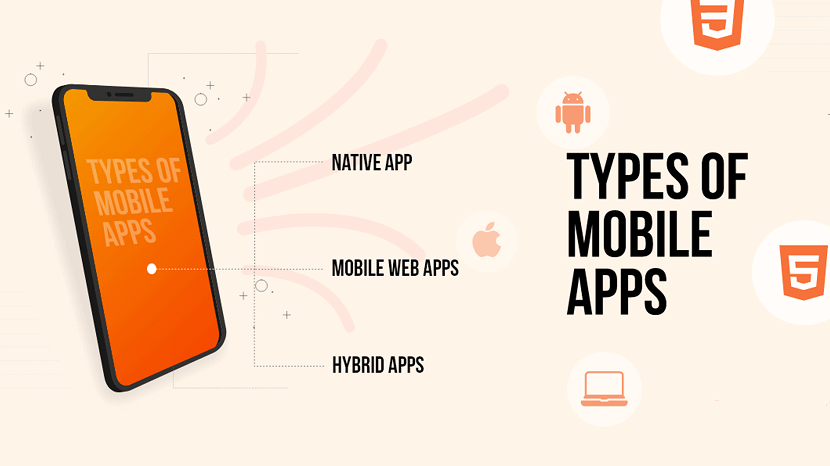
App development today is very different from the past. Historically, low-level coding for native development was the only option. So if you wanted an iOS app for the Apple App Store and an Android App for the Google Play Store, you needed to code two different versions from scratch.
But the barrier to entry for app development today is much lower. App development tools, languages, and platforms are more integrated, and Javascript is used for cross-platform codes.
This makes it much easier for e-commerce companies, existing businesses, and entrepreneurs to develop native apps from scratch.
Here’s a brief overview of the different types of apps and what makes them unique for development:
1. Native Mobile Applications
Native apps are installed directly on a mobile device. These are typically installed through the Apple App Store or Google Play Store. In most cases, native apps can work without any internet connection, and they leverage existing features of the device they’re installed on.
Developing a native app means writing code specifically for the operating system of the device.
Advantages of native apps:
Disadvantages of native apps:
2. Cross-Platform Native Mobile Applications
With a cross-platform app, the same code is used for all platforms. So you can write your code once, and the app can still be installed natively on both iOS and Android devices.
From a user perspective, there is almost no difference between native and cross-platform native apps. From a development standpoint, cross-platform native is more affordable and shortens the development timeline.
Advantages of web apps:
Disadvantages of web apps:
3. Hybrid Mobile Applications
Hybrid and cross-platform are often used interchangeably, although they aren’t exactly the same. Similar to cross-platform, hybrid apps can be written once and work on both platforms.
But hybrid development is a bit more user-friendly compared to cross-platform development. Cross-platform app creation is still highly technical and requires app development skills. Hybrid development is less technical and can be achieved with basic web development knowledge or no-code app builders.
Advantages of hybrid apps:
Disadvantages of Hybrid apps:
4. Progressive Web Application (PWA)
PWAs are apps delivered through the web, as opposed to being natively installed on a user’s device.
Modern technology has made PWAs look and feel extremely similar to a native app experience. You can even send push notifications to users, which get delivered via the web browser. But PWAs will be a bit more limited in what they can achieve using the native features on a device.
Advantages of Progressive web apps:
Disadvantages of progressive apps:
Conclusion
Native, Hybrid, and PWA apps each have their set benefits and flaws. Depending on the requirements of the business, you will need to take a call as to which type of an app you would like to build. The key to using the different types of applications solely depends on the features, requirements and purpose of the app you are building. And each of the App types bring their own advantages to the table. We hope you make the most of the information provided here and test the apps thoroughly before releasing them.
If you found this article helpful, we encourage you to share it on your social media platforms—because sharing is caring! For more information about article submissions on our website, feel free to reach out to us via email.
Send an emailWritten by RGB Web Tech
Latest Technology Trends
Latest technology trends shaping the future, including AI advancements, blockchain innovation, 5G connectivity, IoT integration, and sustainable tech solutions. Explore breakthroughs in quantum computing, cybersecurity, augmented reality, and edge computing. Stay ahead with insights into transformative technologies driving innovation across industries and revolutionizing how we live, work, and connect.
Comparison of App Development
Last updated on January 19, 2025 by RGB Web Tech

App development today is very different from the past. Historically, low-level coding for native development was the only option. So if you wanted an iOS app for the Apple App Store and an Android App for the Google Play Store, you needed to code two different versions from scratch.
But the barrier to entry for app development today is much lower. App development tools, languages, and platforms are more integrated, and Javascript is used for cross-platform codes.
This makes it much easier for e-commerce companies, existing businesses, and entrepreneurs to develop native apps from scratch.
Here’s a Comparison of App Development and what makes them unique for development:
1. Native Apps
Native apps are developed for specific mobile operating systems such as iOS or Android. Platform-specific language is used to build these apps. For example, (native) Android apps use Java, while iOS apps use Objective – C or Swift.
Pro
Con
2. Cross-Platform Apps
Cross-platform mobile development is the creation of software applications that are compatible with multiple mobile operating systems. Originally, the complexity of developing mobile apps was compounded by the difficulty of building out a backend that worked across multiple platforms.
Pro
Con
3. Hybrid Apps
Hybrid apps are essentially web apps that have been put in a native app shell. Once they are downloaded from an app store and installed locally, the shell is able to connect to whatever capabilities the mobile platform provides through a browser that's embedded in the app.
Pro
Con
4. Progressive web Apps
A progressive web application, commonly known as a progressive web app, is a type of application software delivered through the web, built using common web technologies including HTML, CSS, JavaScript, and WebAssembly.
Pro
Con
If you found this article helpful, we encourage you to share it on your social media platforms—because sharing is caring! For more information about article submissions on our website, feel free to reach out to us via email.
Send an emailWritten by RGB Web Tech
Latest Technology Trends
Latest technology trends shaping the future, including AI advancements, blockchain innovation, 5G connectivity, IoT integration, and sustainable tech solutions. Explore breakthroughs in quantum computing, cybersecurity, augmented reality, and edge computing. Stay ahead with insights into transformative technologies driving innovation across industries and revolutionizing how we live, work, and connect.
Best Mobile App Development Frameworks
Last updated on January 19, 2025 by RGB Web Tech

Companies have demonstrated that mobile applications are the best way to grow their customer base. There’s never been a lack of original app concepts. Everything functioned to the benefit of application development businesses.
You don’t need to know any complicated computer languages to create an app. There are various app development frameworks for iOS and Android. All you require is a solid grasp of web-based programming languages such as HTML, CSS, or JavaScript.
A mobile app framework is a software creation platform that includes tools and software, compilers, debugging tools, and programming interfaces, among other things. Thus, a developer creates the application’s source code and the framework and uses various elements to generate the application for the different mobile devices.
Best Mobile App Development Frameworks in 2023
Modern-day mobile app development frameworks provide several built-in benefits, like speed, effectiveness, and a bug-free atmosphere. The framework uses pre-built elements, including compilers, debugging tools, and toolkit, to display the application on the target device using the company’s code.
Using the expertise of a reputable mobile app development company may help the firm create mobile applications which are quick, reactive, and provide excellent user interactions. The use of mobile app development platforms speeds up and simplifies the app creation procedure.
Top Mobile App Development Frameworks in 2023
Below are some Modern mobile app development frameworks. These can be very helpful for both android and iOS users.
1. Alpha Anywhere
It is a complete front & back-end and a low-code application development platform. It is widely used for the rapid development, distribution & deployment of mobile applications on both iOS and Android platforms.
It has unique coding-optional technology, which allows developers to achieve high productivity with complete freedom.
Features
2. Flutter
Flutter is the best UI toolkit that helps to build native applications for the web, mobile, and desktop. It comes with fully customized widgets, which help to create native mobile applications in a very short time. Its layered architecture will ensure the fast rendering of components. Here are the top applications developed using Flutter.
Features
3. Mendix
Mendix is the fastest & easiest low-code app development platform. Therefore, it is widely used by businesses to develop mobile & web apps for high performance.
It accelerates the delivery of enterprise applications, from ideation to deployment and operations. It becomes easy to implement both Agile and DevOps with Mendix.
Moreover, it also offers both no-code and low-code tooling in one single fully integrated platform.
Features
4. Xamarin
Xamarin supplies add-ins to Microsoft Visual Studio that allows developers to develop Android, iOS, and Windows Apps with C# codebase. The reason behind the preference of using Xamarin is that it allows code sharing in multiple platforms, such as cross-platform mobile app development.
Being a cross-platform and open source app building platform, Xamarin is known for offering a development ecosystem with back-end, API, and components. Here are the top applications developed using Xamarin.
It is also supported by various tools, libraries, and programming languages. Moreover, it also has a cloud service, which allows testing on any number of devices.
Features
5.Unity Ads
Unity Ads is an important platform when it comes to integrating video ads into mobile games to increase player engagement. You must have seen the recommendations of seeing a video to get one more life to play the game.
Unity Ads is also known for offering the highest Average Revenue Per User (ARPU) of any global rewarded video ad network. Here are the top applications developed using Unity.
Features
6. Ionic
Ionic comes into the picture when you want to build an interactive hybrid mobile and progressive web apps along with cross-platform applications.
The unique benefit of using this open-source framework is that you can create applications and ship them to deployable locations every time you build.
If you want an easy visual development environment, then you can install Ionic Studio, which is the lightning and powerful version of Ionic. This mobile app development software is widely known as a tool for developing hybrid mobile apps as it is an HTML 5 mobile app development framework. Here are the top apps developed using Ionic.
Features
7. React Native
It is a widely used JavaScript library to create native mobile apps for all devices and platforms. It helps to develop rich apps to give the best user experience.
Moreover, this mobile app development software also allows a developer to create platform-specific versions of various components for native apps with easy use of a single codebase across various multiple platforms. Here are the top applications developed using this platform.
Features
8. Sencha
Sencha Ext JS is an MVC-based JavaScript platform, offering a high level of responsiveness to the application for improving customer satisfaction.
Sencha has merged with Ext JS, and now you can use this for building data-intensive applications for both web and mobile. It is also known for cross-platform mobile development. Here are the top applications developed using Sencha.
Features
9. Adobe PhoneGap
Adobe and Apache both have sponsored Adobe PhoneGap. This platform is widely known for its use in Android development.
The benefit of using PhoneGap is that you can develop a single app that can work on all mobile devices. Moreover, it is an open-source desktop application, and you can link the apps to mobile devices.
Features
10. NativeScript
NativeScript is one of the preferable platforms to create native mobile applications. This helps to reduce the code and load time of native apps on the system.
Moreover, there are many leading companies, such as Puma and SAP, that love using Native Scripts for their web empowerment platform.
Features
11. Swiftic
Swiftic is one of the best platforms for iOS app development services. It offers an easy-to-navigate interface for everyone to build an app. Swiftic offers a lot of profitable app features, such as unlimited push notifications, advanced analytics, and also makes the app attractive to look at.
Swiftic, an iPhone mobile app development software also offers a 30-day money-back guarantee. Along with that, it has a 6-months of success guarantee scheme. So, if you do not get the result within 6 months, then the service will be free for you.
Moreover, Swiftic has seven different templates and UX/navigation styles and comes in different colors, background pictures, and building blocks.
Features
FAQ – Mobile App Development Frameworks
1. Which mobile app development framework should I learn in 2023?
All the above-mentioned mobile applications frameworks (React Native, Flutter, Xamarin, Swiftic, Ionic, Apache Cordova and jQuery Mobile) are essential for any mobile app developer to learn. As of now, changes can take place with time, but the given frameworks are essential.
2. Which is the most used app development framework?
In the software industry, React Native is among the most popular mobile app frameworks. The FB software is an accessible framework that allows you to construct mobile apps for Android and iOS devices.
3. Which are the easy-to-use mobile app development frameworks?
Framework7 is simple to understand and also uses an open-source framework. It enables programmers to create native-looking Android, iOS, and desktop applications utilizing popular online standards like HTML5, JavaScript, or CSS3.
4. Which mobile app development frameworks can be used for cross-platform app development?
React Native, Ionic Framework, Node, Xamarin, NativeScript, Adobe PhoneGap, and Flutter are the best mobile app development frameworks for cross-platform app development.
5. Which frameworks are the best for native app development?
Native Script is an accessible framework that uses Angular, Typescript, JavaScript, and CSS to develop native mobile applications. React Native is the finest JavaScript framework for creating native apps for any platform and operating system. Xamarin is among the most used mobile app development frameworks. Microsoft launched this native framework.
6. Which is the best mobile app development framework?
React Native is among the most commonly utilized mobile applications frameworks, with 42% of programmers globally using it. It was created by Facebook and is built on JavaScript. Using Android and ios platforms, React Native programmers can quickly construct a smartphone application with a native appearance and touch.
7. What technologies or frameworks can be applied to build a mobile application?
Python, Java, Flutter, React Native, Swift, Kotlin, R Programming can be used to develop a mobile application as they are the top mobile app technologies.
8. Which stack is best for Android Mobile App Development?
Java has turned out to be the most widely utilized programming language for creating Android apps. Because it is centered on Android APIs and a large number of built-in Java libraries, it is among the finest choices for developing Android apps.
9. What is a hybrid mobile app framework?
The Hybrid Managed Framework combines the advantages of both Data-Driven as well as Keyword-Driven frameworks. The terms, and the testing dataset, are externalized in this scenario. Test data could be kept in a properties file or perhaps an Excel file, and keywords are kept in a distinct Standard java file.
10. Which framework is best for Mobile App Development?
Flutter is the most popular Android framework out there. It has speedily scaled the list of dominant positions after being recognized as the second most-used framework after React Native. Onsen UI, React Native, NativeScript, Iconic and more are best for mobile app development.
11. How to select the right mobile app framework?
Consider these factors at the time of choosing the right mobile app framework: (1) Platform Feature Support (2) Speed Considerations (3) Cost of Development (4) Security Risk Enhance Efficiency, and After Launch Updates. You should consider these factors at the time of choosing the right app framework for your mobile.
12. Is there any framework for Android development?
Apache Cordova, formerly known as PhoneGap, is a free and open-source Android framework that allows hybrid app development in many basic web-development languages and technologies, like JavaScript, HTML5, and CSS3. It authorizes the construction of multi-platform apps with a single code base, e.g. Appcelerator Titanium.
13. What are the technologies used in iOS mobile app development?
Technologies like UIKit allows you to create a touch-based user interface. Because all iOS apps are based on UIKit, you can’t send an app without this framework. Its interfaces are an integral component and part of the Quartz Core framework.
14. Which programming is best for app development?
Java is best for app development. Java was the official language for Android App Development and it is the most used language. Many of the apps in the Play Store are constructed with Java, and it is also the most reinforced language by Google.
Conclusion
Mobile application development is more accessible than ever. Whether you are a full-stack developer, aspiring engineer, or have decades of experience in the Microsoft ecosystem, you can build great mobile applications that can run on billions of devices today. There may not be a clear winner, each platform has pros and cons, but the important thing is you have a plethora of options. As the old adage goes, "use the right tool for the job". Hopefully you've learned more about native app alternatives and can make an informed decision about developing mobile applications.
If you found this article helpful, we encourage you to share it on your social media platforms—because sharing is caring! For more information about article submissions on our website, feel free to reach out to us via email.
Send an emailWritten by RGB Web Tech
Latest Technology Trends
Latest technology trends shaping the future, including AI advancements, blockchain innovation, 5G connectivity, IoT integration, and sustainable tech solutions. Explore breakthroughs in quantum computing, cybersecurity, augmented reality, and edge computing. Stay ahead with insights into transformative technologies driving innovation across industries and revolutionizing how we live, work, and connect.
The Key Stages of the App Development Process
Last updated on January 19, 2025 by RGB Web Tech

Understanding mobile app development stages at least theoretically helps you set the right expectation for your team, be prepared in advance for certain discussions, and know why this or that phase is critical.
The article is about the stages of mobile app development. And, the most common mobile development platforms are Android and iOS. The process includes the start of the project to the final point when a team releases their product to you. The article will be useful for those who are interested in software projects and want to know more about software development to operate business terms and be on the same wave with managers, engineers in the business world.
Key Stages of App Development Process
Step 1: Confirming On The Idea
Before planning to proceed, you need to answer the following questions to make sure that you are not marrying the wrong idea, and the idea is worth investing time and effort.
Step 2: Market Research
Now is the time to do the most important part of your journey. Market research shows you the real demand or interest of the market; accordingly, you can modify your idea, and the research can give you a clear list of requirements that can help you prioritize the work. Here the question, of course, is how to do market research the right way? Check the step by step market research process here:
Here are some more advantages to doing market research:
Step 3: Build Your App’s Wireframe
Once your idea list is ready, it’s time to put a shape to your idea- Wireframes. You can consider a wireframe as a blueprint of your application. It will display the design of your app and functionality. Also, it will help you understand the look and the work of the application.
Mainly app wireframe gives articulation to the theory for the team to follow. Also, it helps developers as a reference or you can say as a guide book.
If you need suggestions for building your app’s wireframe, here are some steps
A. Map Out The User Flow
In the beginning, the user flow map is essential because these steps are a necessary aspect for your app to achieve a specific goal. I know you want to know all the steps, right? Let’s check them:
If you are looking for help to build your mobile app’s wireframe then check out the trending wireframe tools:
B. Bring Order to The Design Chaos with Design Sprints
During wireframing, you will be confused about whether you are making the right design decisions or not. Maybe one layout of iOS is better than another, or perhaps some xx feature should be added. A Design Sprint is a proven, scientific process of collaborative brainstorming which helps in assessing which features to build first and which ones to eliminate. It helps in saving development time and money by solidifying concepts and building the groundwork for wireframing and designing.
Importance Of Design Sprint
Design sprints are useful in every stage of the project. Let’s explore:
To provide you in-depth knowledge in design sprint we are going to highlight its significant steps, let’s explore them:
Step 4: Platform Choice
Now we are going to help you make the right decision among all the platforms of mobile app development phases. Three options are available in the sector of development:
Step 5: Development
If your mobile app design passes the test of usability, it is time to give a proper structure to your dream project. This process covers the If your mobile app design passes the test of usability, it is time to give a proper structure to your dream project. This process covers the coding part and the actual realization of your application. The mobile app development stages incorporate multiple activities like establishing the appropriate development environment, developing different parts of the code, preliminary testing, and creating the mobile application that can be installed and tested. Android okhttp interceptor can be used centrally during development to rewrite and retry the network calls.
One development project would require programming and configuring the development environment. Usually, there are three aspects of any app- back-end, APIs, and the app front-end. Development is usually done in stages and you can expect your developer to provide interim builds that you will be able to run on your device itself.
Various tutorials are available that can help you to develop your app without experts. Or else you can simply hand over the design to an android app development company or a freelance developer.
Step 6: Test Your App and Improve
Running a code review process during development helps in making sure that there are no major bugs left at the end to solve. Here is our development process aligned with code review as part of everyday code.
Once you have a visually appealing and fully functional application, it’s time to conduct a final test of usability with other colleagues. In this process, you may find bugs that you overlooked, but here you can apply the last tweaks to your product.
Stages Of Mobile Application Testing
Learn about various mobile app testing stages with us. Here goes the list:
a). Documentation testing: At the beginning of the mobile app, documentation testing comes first. Also, it is called the preparatory stage. The mobile app development strategy starts with screen layouts, navigational charts, and other important aspects that are obscure on the design. In this stage, you need to check all the wanted features for wholeness and discrepancy. In this phase, all developers find out all the discrepancies and resolve them before the app development begins.
b). Functional testing: It aids you to test your mobile app responses according to the industry requirements. While you’re performing functional testing for your mobile app, keep the following components in mind.
c). Usability testing:
This part of testing ensures that your app offers convenient browsing to all your customers and generates an intuitive interface that acts according to industry standards. It gives fast and easy-to-use mobile apps that can attract users. Usability of your app is judged by these three criteria:
d). UI (User Interface) testing:
User Interface testing makes sure that your application’s graphical user interface meets all the needed specifications.
e). Compatibility testing:
Compatibility/Configuration testing provides the optimal performance of your mobile app according to the device size, version, screen resolution, hardware, etc. moreover, Compatibility testing takes care of:
f).Performance testing:
Well, performance testing can help you test your mobile application reaction and consistency under a specific workload.
Now we are going to show various types of Performance testing, includes:
g). Security testing:
This testing process validates the security concern of your application. Also, it checks the risks of mobile app hackers, viruses, protection, and unauthorized access to all the sensitive data.
h).Certification testing:
Well, certification testing processes analyze whether your app meets the industry standards, licensing agreements, terms of use, and all the requirements of stores like the Google Play, App Store, and Windows Phone.
Let’s Check Popular Mobile Application Testing Tools:
Step 7: Launch A Beta Version of Your App
A beta version of any application can attract early adopters, which is an important step in taking your mobile app mainstream. Early adopters provide a lot of beneficial feedback about your application’s pros and cons. And their experience and rating can help you to understand the acceptance of the app and the demand as well. This type of word-of-mouth marketing for your mobile app will bolster its reputation, and help the admin to acquire even more users.
Step 8: Launching Your App
You have designed the structure, tested, and developed your application. Now it is time to launch it in the Google Play Store or Apple store.
How Can You Submit Your App in The App Store and Google Play Store?
To provide you an idea about the Apple Store submission processes, we are going to highlight some basic submission processes.
Let’s get an idea about the submission process of the Google Play Store:
Step 9: Post Launch Activity
After launching your mobile app, the next and crucial step is marketing it. If people don’t get to know about your app, then there is no chance of downloading it. To spread your app and convince people to explore it, consider making attractive and informative videos that can show your app’s functionality. And do not forget the potential of social media, use all digital platforms to reach every corner of the world. It will deliver people a glimpse of your app and highlight the key features that can simplify the need for life.
If you found this article helpful, we encourage you to share it on your social media platforms—because sharing is caring! For more information about article submissions on our website, feel free to reach out to us via email.
Send an emailWritten by RGB Web Tech
Latest Technology Trends
Latest technology trends shaping the future, including AI advancements, blockchain innovation, 5G connectivity, IoT integration, and sustainable tech solutions. Explore breakthroughs in quantum computing, cybersecurity, augmented reality, and edge computing. Stay ahead with insights into transformative technologies driving innovation across industries and revolutionizing how we live, work, and connect.
Top Mobile App Development Languages
Last updated on January 19, 2025 by RGB Web Tech

Learning programming languages is a hard nut to crack unless you know the basics.
Every programming language has its building blocks, which help budding programmers learn the language from scratch.
App development languages are no exception. They are, of course, advanced, but the secret to cracking these languages stays the same, you have to learn the basics.
Besides, many mobile app development languages resemble and are even based on languages like C and C++, something you have known for a long time now. Therefore, learning app development languages can be easy and fun if you have mastered these languages.
Which is the best programming language for mobile apps?
There are several programming languages for different sorts of tasks. Choosing the right language for the mobile app is different from choosing one to learn. The right selection yields solutions that are concise, easy to code, easy to scale, easy to debug and fix.
Often people will tell you that there is no choice and that all languages are equal and are developed to fulfill a particular purpose. However, it can be quite confusing, if you are new in the mobile development arena and lack information about programming languages.
So, if you are in a confused mess, the following factors can you help you choose the best language easily:
Here is a top mobile app development languages
Take a minute to think about how many times you use an app in a day? Multiple times, isn’t it? In fact, there is probably an application waiting to be discovered in your app store for every possible human need. Therefore, it is no surprise that the demand for mobile applications has been on a steady rise ever since the smartphone was invented. Also, the reason why you’ll find hundreds of mobile app development companies in your locality.
No one on the surface doubts the future of mobile application development and mobile programming languages. Gone are the days where businesses could ignore mobile users! Having crossed a milestone already, if your business isn’t mobile-ready, you’re in trouble today.
If you are taking the plunge to build your mobile app to get the user’s attention – you need to focus on choosing the right technology, the right programming language, the right UX design tools, and most important of all, one of the top mobile application development companies to create a robust, innovative and user-friendly app for your business needs.
With several mobile programming languages to choose from, you have to consider multiple factors, pros, and cons, as well as the popularity of the language, before making your decision to build the most popular mobile app. Once you’ve chosen the best mobile programming language and built a business app, you step into the marketing stage which demands a suite of best marketing apps to scale up your development efforts.
In this article, we have curated a list of top 16 mobile app programming languages which will help you choose the best quickly and get you started with your mobile app.
1. JavaScript
William Ting’s once said, “JavaScript will stay relevant as long as people use the internet.” JavaScript is best for cross-platform app development, mobile apps used for various platforms, and web browsing. It smoothly runs in other environments, outside of browsers, and can be compiled from a wide array of programming languages. So, my vote for the best programming language is for JavaScript.
Features
Pros
Cons
2. Kotlin
Said to be the advanced version of Java – Kotlin is a statistically typed programming language used for developing modern Android applications. Kotlin has the potential to influence other programming languages such as JAVA to make high-performing and robust apps. Some popular apps built-in Kotlin are Trello, Evernote, Coursera, and many more.
Features
Pros
Cons
3. C++
C++ is considered to be an upstanding choice for mobile app development. It is a general-purpose, object-oriented language with generic and low-level memory manipulation features. Used for Android App and Native app development, C++ is used for developing games, GUI-based applications, real-time mathematical simulations, banking apps, etc. C++ is popular with Cloud computing apps as it can quickly adapt to changing hardware or ecosystems.
Features
Pros
Cons
4. C#
Pronounced as ‘C-sharp’ – this is another object-oriented, general-purpose programming language extensively used for mobile development, majorly for cross-platform and windows app development. C# has everything you want to achieve using other programming languages such as Swift, Objective-C, and JAVA programming languages. If you are planning to develop an interactive and high-performance game app, this is the best language.
Features
Pros
Cons
5. Python
A widely accepted programming language, Python is used for developing web applications, desktop apps, media tools, machine learning, network server, and more. Examples of Python are YouTube, Instagram, and Pinterest. The language provides excellent library support, robust integration, and enhanced control capabilities. If you are a start-up planning to develop your app – Python is the best language!
Features
Pros
Cons
6. PHP
PHP is one of the most recommended programming languages for mobile apps that need database access. It is an open-source language used for server-side scripting, command-line scripting, and coding applications. Widely used for creating eCommerce applications, content-heavy apps, dynamic web applications, and mobile apps. It is a flexible language that can be easily embedded into HTML or HTML5. A few of the popular websites on PHP are Wikipedia, Facebook, and Yahoo.
Features
Pros
Cons
7. Swift
A prospective game-changer in the mobile app development space – Swift is an open-source programming language specifically designed to work with iOS, OS X, and tvOS platforms. The language is flexible, scalable, and can easily adapt a safe programming pattern to add modern features to any app. Swift is expressive and fun to work with a scripting language, along with having the first industrial-quality systems. Examples of apps developed in Swift are Lyft, LinkedIn, Hipmunk, and more.
Features
Pros
Cons
8. Objective C
An extended version of C language, Objective C is a general-purpose, object-oriented programming language with added features like Smalltalk-style messaging. A well-updated and mature programming language, Objective C is mainly used for macOS and iOS app development and operating systems.
>Features
Pros
Cons
9. JAVA
Java is an official Android development – object-oriented programming language. With in-built open-source libraries readily available for users to choose from, JAVA is easy to handle and offers the best documentation and community support. With JAVA’s vibrant spectrum of features, you can develop the best cross-platform apps, Android apps, games, server apps, embedded space, websites, and more.
Features
Pros
Cons
10. HTML 5
Are you planning to build web-fronted apps or location-based apps for mobile devices? Then the fifth version of HyperText Markup Language – HTML 5 is an ideal option for you. It is not a programming language but a markup language that uses tags to structure and present the content on the webpage. The latest updates of HTML 5 highlights exceptional features like media elements, multi-platform functionality for different programs, and quick market deployment. Examples of HTML 5 are Google Docs and Google Drive.
Features
Pros
Cons
11. Ruby
Ruby is a back-end object-oriented scripting language used in the development of web applications, servers, system utilities, and standard libraries. Over the years, Ruby has evolved into a general-purpose, high-level multiple-paradigm, interpreted programming language. It is a functional language that directly executes the instructions rather than compiling the program in machine language. A few of the well-known websites developed using Ruby are Twitter, Bloomberg, Airbnb, and Shopify.
Features
Pros
Cons
12. Rust
Rust has been Stack Overflow’s most loved language for four years in a row. Sponsored by Mozilla, Rust is a system programming language having syntax almost similar to C++. With strong compile-time correctness, fast-performance, intuitiveness, and safe memory, Rust is useful in a time-constrained scenario and to develop applications across different fields. Examples of Rust are Dropbox and Yelp.
Features
Pros
Cons
13. Lua
Lua is a light-weight mobile-first enterprise communication solution. It is a cross-platform multi-paradigm programming language. It powers in-built messaging for businesses and is instant, secure, and keeps developers accountable. It is popular for real-time secure messaging, analytics dashboard, easy file sharing, and two-touch conference calling. If you want to improve the speed, extensibility, portability, and reliability of your apps, Lua is perfect for embedded applications.
Features
Pros
Cons
14. Action Script
ActionScript is a popular programming language for Adobe Flash Player and Adobe AIR runtime environments and is a tool in the tech stack – languages category. It is an object-oriented programming language derived from HyperTalk – the scripting language for HyperCard. Looking to use Adobe Flash Player on your website or software? Lua works great with animations or motions in websites and to develop video games.
Features
Pros
Cons
15. SQL
SQL stands for Structured Query Language used for assessing, communicating, and manipulating the standard database for most applications. SQL is designed to meet specific standards, both ANSI and ISO, and there is extensive support for both on a community and enterprise level. Strength – Relational data model and referential integrity between data, data query, data manipulation, and data access control. With well-defined standards, SQL is widely used in business intelligence tool platforms.
Features
Pros
Cons
16. Dart
DART is a client-optimized and open-source programming language focusing on UI, productivity, and speed. It features asynchronous coding and is used on Flutter to make cross-platform apps easily. Apart from client-side and server-side development, Dart is also popular for Native mobile app development. Google developed Dart to accelerate app development on all the platforms.
Features
Pros
Cons
Conclusion
There are constant evolution’s in the world of programming languages. Some evergreen languages such as JAVA and JavaScript have earned an eternal place in the list, whereas other languages like Kotlin and R have risen at an outstanding pace and have made it to the list of the most popular programming languages.
With a list of questions to ask, factors to consider, and the above-listed pros and cons, we are sure you can make a sensible decision regarding which language to choose. After all, choosing the right mobile programming language will help you develop agile mobile apps that will weather the changes in future business needs.
So, what are you waiting for? Dive into the nitty-gritty of the programming language, choose the best and give your business the most needed mobile application to reach a more substantial mass.
If you found this article helpful, we encourage you to share it on your social media platforms—because sharing is caring! For more information about article submissions on our website, feel free to reach out to us via email.
Send an emailWritten by RGB Web Tech
Latest Technology Trends
Latest technology trends shaping the future, including AI advancements, blockchain innovation, 5G connectivity, IoT integration, and sustainable tech solutions. Explore breakthroughs in quantum computing, cybersecurity, augmented reality, and edge computing. Stay ahead with insights into transformative technologies driving innovation across industries and revolutionizing how we live, work, and connect.
Top 16 Mobile App Development Trends to Follow
Last updated on January 19, 2025 by RGB Web Tech

Mobile app development is where you can nurture your ideas and lead toward innovation. The industry is proliferating and has become briefer, immense, and the hub of endless opportunities. To stand out in this digital world, you should become familiar with varying mobile app development trends.
This is the real-time to bring innovation in your mobile app development approaches to deliver the most satisfactory customer experiences. In this article, we will share all the essential facts you need to look ahead to and assemble an effective strategy to lead the industry.
Building an effective plan is not as simple as you think. To succeed with your marketing strategies and mobile app development, you should stay updated and follow the mobile app development trends to prevail in your marketing approaches and mobile app development. This article will summarize the recent mobile app development trends that you should follow.
What are the top mobile app development trends?
Below are the top 16 mobile app development trends we determined after reality-based analysis. Let's dive into the details of these trends.
1. The incredible 5G technology
5G is the latest internet buzzword. Smartphone manufacturers have started launching 5G devices, which are used as advertising to boost sales. Since the rise in profits implies that people are interested in 5G networks, mobile app developers must integrate 5G into their applications. 5G is enticing for its incredibly fast downloading speed and other aspects.
The best part about 5G is that Opensignal claims that 5G download speeds were between 1.6 and 15.7 times faster than 4G throughout the tests. Because 5G has enhanced data encryption and many connections per sq. km, it will be the best-looking mobile app development trend.
The response time of 5G is less than one millisecond. Compared to the human response time of up to 300 ms., 5G makes itself feel almost instant. Furthermore, augmented reality and virtual reality connected driverless vehicles, the Internet of Things (IoT), and other fields will benefit from 5 G's combo of incredibly low lag, bandwidth efficiency, and massive connectivity.
High speed and lowered lag will certainly reduce battery usage. 5 G's momentum will shift computational capacity to the "edge," eliminating the procedures that suck mobile phone batteries. Gaming and other industries that rely on high internet speed can use 5G to upgrade and develop better mobile apps.
Things we can expect from 5G
Ultimately, 5G technology will enhance mobile apps' speed, smoothness, and performance. This new trend will also generate possibilities for new ideas. All your fantastic ideas for your mobile app will no longer be just that. You can change them into a natural face with 5G technology.
2. Progressive web apps and "Instant" apps
Progressive web apps are a combination between websites and mobile apps. The most significant benefit of web apps is that they require minimal time to build than conventional apps since they are merely websites with a demand for services. They, in contrast, have more functionality than merely seeming to be websites since you can preserve them on your desktop.
During the coronavirus crisis, the significance of these web apps is emphasized, particularly in online business, because of the significant rise in online buying activity. Following the development and start of their progressive web app platforms, many B2B and B2C enterprises have noticed an upsurge in interaction, conversion rate, and revenue.
Progressive Web Apps are much smoother than native software or apps since they don't compel customers to make such tough decisions. Also, users don't see the standard setup procedure. They tap a single button, and a shortcut seems on the desktop or home screen. Web apps take up some space with essential files but far less than native software or apps.
Advantages of PWAs for businesses
Advantages of PWAs for users
3. Wearable Apps
Wearables serve the same purposes as mobile devices but are smaller and lighter, so they are simple to carry. Wearable apps interact with suitable mobile apps to deliver info to their entrepreneurs. A nod ring is a Wi-Fi gadget that permits you to use a ripple of your hand or unique toggles on the device to start programs on your mobile or laptop.
Aira is a combo of wearable glasses that guide blind people in the right direction. This gadget alerts the blind to potential hazards on their path. Mobile Wearable devices can perform the following tasks:
The significance of mobile app integration with wearables
Customers, businesses, and mobile app developers have all been impacted by the development of wearable apps. They are all seeking out new and surfacing potentials. Due to the increasing growth of the wearable market, most users, phones, and earnings are all frequently rising. As a result, the industry needs more skills and expertise to provide consumer apps for handling wearable technology. This is why mobile app development skills are in higher need than ever.
4. Edge computing
Although there are lots of businesses that benefit from the cloud, it is rapidly aging. The dilemma with the cloud is that it is centralized, causing lag, a significant issue for the technologies that 5G assures. Edge computing, on the other hand, is one of the finest approaches for delivering on those assurances. Edge computing is a centralized information systems (IT) structure in which customer data is managed as near the initiating source as feasible at the network's edge.
Edge computing is changing how billions of IoT and other machines generate, store, process, examine, and transfer data. The original aim of edge computing was to decrease the data costs incurred when moving basic information from its origin to a cloud computing infrastructure or the cloud. The emergence of legitimate apps that demand low waiting times, such as autonomous cars, has recently pushed the concept onwards.
Consider systems that supervise a web camcorder that delivers live video from a remote site. While only one gadget can quickly transfer information over a network, trouble comes when the number of machines sends live footage at the same time. Multiply a single video camera sending live footage by thousands of devices. Video quality will not only degrade due to high lag, but bandwidth expenses can be exorbitant.
This is why Edging computing services come into play to resolve this dilemma by supplying a regional source of production and storage for these systems.
5. Beacon technology
Beacon technology is another mobile app development trend in 2022 that you should stay updated and follow. Beacon technology is a Bluetooth gadget that sends a message that other Bluetooth systems, such as mobile phones, can identify. The beacon is not sending out a spontaneous message.
It sends a one-of-a-kind Identification number that informs the listening machine which beacon is adjacent to it. When a mobile app comes into contact with a beacon, it will interpret the beacon information, determine what activity is given to the data, and carry out the activity. From being Apple's moderate Bluetooth tool to a world-renowned innovation across over 400 million deployments, this technology has grown dramatically.
Use of beacon technology
The most common app for beacon technology is closeness advertising. This could be as simple as presenting an app customer notice with a discount code for a product the user is close to or as complicated as showing in-app data with an explanation of a proximity occasion. It can also be complex, like determining a customer's area based on their nearness to a beacon.
When sellers set beacons in their online shop, they all have separate identifiers linked to their unique app. The ID can lead the mobile app to take out any seller's move. Alternatively, it has the potential to collect metrics in order to know how to optimize a dedicated area.
6. Artificial intelligence & machine learning
Before diving into the details of this mobile app development trend, first, you should know about AI & Machine Learning. Artificial intelligence is the phenomenon of developing smart machines. Machine learning is a type of artificial intelligence that helps develop Automation applications.
Machine learning (ML) can potentially decrease the hours spent developing mobile apps drastically. Regardless, AI and machine learning can optimize mobile apps and minimize errors that human coders would have missed.
Current mobile apps include AI elements such as chatbots, but some customize fundamental features of a client request. McDonald's, for instance, is using AI to customize its drive-thru menus set on variables such as the client or climate.
AI and machine learning have been the most popular mobile app development trends for years. But even so, these technological developments raise the standard for mobile app development.
Machine learning is another emerging topic in which we anticipate groundbreaking developments. When ML works w together, it can transform mobile app projects by giving quality data and accurate insights.
Machine learning and artificial intelligence will undoubtedly continue to be significant factors of technological innovations and beyond. While AI medical devices are the beginning for the health sector, we can predict Automation apps on wearable technology and mobiles that regulate an IoT environment shortly.
7. mCommerce
M-commerce is another of the most important mobile app development trends that applies to any commercial trade performed through apps or mobile websites. Mobile commerce can be generally defined as a subgroup of e-commerce or the mobile site of e-commerce.
The mobile commerce division is expanding rapidly, with the % and distribution of online shopping made on mobile year after year. As mobile sales become more handy and more individuals across the globe access mobile phones and tablets, the ability for mobile shopping continues to increase.
Mobile commerce is related to an e-commerce stream on a computer in that the consumer trawls applications, clicks across mobile sites, and tends to make purchase decisions. This is usually performed through dedicated mobile apps. Still, it can also be executed as a social commerce buy, with social media sites such as Twitter, Snapchat, WeChat, Tiktok, and Instagram delivering in-app price quotes.
There are several methods for making an m-commerce acquisition, and mobile wallets are growing more rapidly. Rather than entering credit card information into each app, a user's mobile wallet can be equipped, and the payment can be completed with a simple tap.
8. On-demand mobile apps
On-demand mobile apps are an excellent mobile app development trend that functions as a "3rd person" through whom consumers can employ a product or a service. Uber service is a prime example, where offering in discussion is a journey. These apps accomplish other requirements in various industries such as food, shipping, grocery items, lodging, and more as and when consumers require them.
In 2022, there will be so many on-demand applications, but beyond seem like many of them. Innovations will certainly develop new expectations, and individuals will consider new ways of making their lives easier, which on-demand apps can fill. Luxuries will become necessities as on-demand apps permeate every aspect of life, from home to your career to travel. On-demand apps like Uber and food apps deliver services on demand. Due to several technological advancements, there will be more on-demand mobile apps and offerings.
9. Blockchain
Blockchain is another famous mobile app development trend that is certain to have a significant effect in the years ahead. This dispersed roster method can change how businesses work by establishing a safer, adulterate way of storing data.
While blockchain technology is generally associated with cryptocurrencies like Bitcoin, it has many possibilities for companies of all sizes. This could, for instance, be employed to inspect stock levels, improve production chain operations, or perhaps even start creating secure digital agreements.
As the globe is becoming more fully digital, it is evident that Blockchain will play a significant role in the future of business. As a consequence, now is the moment for organizations to begin examining how they will benefit from this digital enterprise.
This technology has evolved significantly and is currently likely to apply in a variety of fields. It is rapidly expanding and is predicted to generate $20 billion in annual revenues by 2024. Blockchain technology is also attempting to play a significant role in creating mobile apps.
10. Wallet for mobile
Mobile wallet is another one of the best mobile app development trends. But unfortunately, many companies still are uninformed of the actual worth mobile apps can all have for their product and the influence they will have on people's everyday lives. Mobile app development is not a recent idea; however, it has grown in significance because of the way people utilize their mobile phones.
According to Statista, over 6 billion active mobile phone users are now, and this quantity will only grow. This opens up a massive possibility for companies to create mobile apps that add worth to their clients' lives. You can use these mobile apps to safely store their credit card facts and some other account details.
This allows them to make purchases in-app or in individual purchases without being required to input their credit card information every time. This is a full function for customers and decreases the risk of scams.
Digital wallets are predicted to rise in popularity in the years ahead, and companies should capitalize on this trend by creating their mobile wallet software. This will benefit them and enable them to deliver a better user experience.
11. Chatbots
Chatbots are software programs that simulate human discussion. They are commonly used only for customer care or generating leads. Individuals can, nevertheless, be employed for advertising or even profits. Artificially intelligent and natural language processing (NLP) are used by electric chatbots (NLP). This enables them to recognize human discussion and react in a way that simulates human debate.
There are numerous benefactions to employing chatbots in the company. Newbies are available at all times a day, seven days a week. This suggests they can assist you or lead generation even when your human workers are not readily accessible.
Furthermore, chatbots can manage heavy traffic loads. This is perfect for companies with considerable web traffic but lacks the personnel to manage the investigations themselves. Such mobile app development trends can facilitate you in lead eligibility. Chatbots can assist you in determining whether a yield is worth investigating by posing questions and collecting data.
12. P2P apps
P2P apps are another one of the most important mobile app development trends 2022. The new forms of simple digital payments are networked or individual apps. The number of mobile phones and their abilities are rising. Today, the mobile phone is a multi-purpose gadget that allows us to access various functions that make our lives more convenient.
One of the newest recent technologies and solutions is the NFC module. With this development, a mobile phone can be employed as a payment method. Furthermore, concerning the technical side of the situation, an app factor can be recognized. With peer-to-peer mobile apps, money can be exchanged between customers without needing an NFC module.
Peer-to-peer apps are 3rd party apps that allow you to put your bank info and perform transactions. This way, consumers can avoid ATMs and cash withdrawals by conducting all digital transactions. Furthermore, these apps are user-friendly and easy to use.
13. The internet of things (IoT)
A loT, or the Internet of Things, is a system of physical devices, automobiles, and household appliances that can accumulate and send data over the internet. loT is also one of the significant mobile app development trends for entrepreneurs in 2022, or the potential of gadgets to link to and interact with one another. It is expected that there will be almost 29 billion IoT appliances globally by the end of 2022. That's a significant number of new consumers for companies interested in investing in creating an IoT-capable mobile app.
14. Virtual and augmented reality
Businesses are still expected to invest in mobile app development, even after the coronavirus pandemic crisis. The reason is simple mobile apps give companies a significant way to reach their intended customers and enhance customer interaction. Augmented and virtual fact is a famous mobile app development trend. This mobile app development trend involves using technology to deliver customers an interactive experience.
Companies use this technology to allow users to experience how their item would appear the same as in their houses before buying it. Conversely, companies provide customers with an accurate glimpse of a new service using this technology. Industries that employ these innovations can offer an interactive and distinctive experience that will assist them in differentiating themselves from their competitors.
15. Smart hubs
The smart home hub is one of the most widespread mobile app development trends. This is a piece of software that enables communication on a home network. This technology can link up regionally or to the cloud and is helpful for IoT phones that employ Bluetooth systems instead of Wi-Fi. This mobile app development trend collects and interprets known methods of communication from intelligent appliances.
This technology has also helped with the preventative measures to reduce the dispersion of COVID-19, particularly for individuals who must stay in their homes. An intelligent hub is perfect for managing digital phones in a home without having to touch them by allowing the voice-activated feature instead.
16. Biometric identification
App development trends in terms of safety are becoming tighter and more substantial. As a result, biometric technology has become a required privacy protection feature for Payment gateways. This enhanced the security multiple times, enabling quick verification and procedure. Facial recognition software and fingerprint reader are all examples of this new tech. Such types of mobile app development trends can substantially enhance the security of clients' data.
Conclusion
There are numerous apps on Google, and it is challenging for you to stand your app from the industry crowd without following the latest mobile app development trends. These are only a few out of the numerous mobile app development trends. The necessity for mobile apps will rise as the number of mobile users grows. Companies should keep up with developments in order to stay profitable. They can make sure that they build the best mobile apps for their clients by knowing the current mobile app development trends.
This is not an extensive list of mobile app development trends. Anything trendy can emerge unexpectedly at any time. But the trends mentioned above are worth viewing. If you're looking to develop your professional and fantastic mobile app, knock at RGB Web Tech.
If you found this article helpful, we encourage you to share it on your social media platforms—because sharing is caring! For more information about article submissions on our website, feel free to reach out to us via email.
Send an emailWritten by RGB Web Tech
Latest Technology Trends
Latest technology trends shaping the future, including AI advancements, blockchain innovation, 5G connectivity, IoT integration, and sustainable tech solutions. Explore breakthroughs in quantum computing, cybersecurity, augmented reality, and edge computing. Stay ahead with insights into transformative technologies driving innovation across industries and revolutionizing how we live, work, and connect.
Mobile App Monetization Methods
Last updated on January 19, 2025 by RGB Web Tech

Of course, you are not out there for charity. If you have invested this much in your mobile application, you should earn a bit from it. But keep in mind first, earning from the mobile application should not be your only motive of yours and second, no mobile application will not help you earn billions starting from day one. If you use the proper monetization method in your mobile application, you will be able to turn your mobile application into your primary source of income. Let's Explore the monetization methods you can integrate into your mobile applications.
1. In-app Purchases
Offering your users chances to make an in-app purchase is an extraordinary method for monetizing your mobile application. If your mobile application is free to download just like the other 95% of mobile applications that exist on the Google Play Store or Apple App Store, in-app ads offer an unpretentious monetization strategy that can upgrade the user experience. Most gaming applications employ this mode of monetization in their mobile application.
Prior to making in-app purchases available to your target audience base, consider the manners by which you can upgrade the client experience. The best in-app purchase will likewise diminish beat in view of the extra advantages acquired by the users. Considering this, it merits your opportunity to find the right harmony between an extraordinary free application and reasonable advantages through in-app purchases.
2. Freemium Model
Regardless of whether your application is allowed to download, you can monetize your mobile application by offering a freemium model to your users. This empowers you to offer an alternate experience to paying users and those utilising your freemium service.
While setting up a freemium model for your mobile application, you are not restricted to a win big or bust approach. Contingent upon your application's contribution, it could be more astute to set up numerous freemium models with various degrees of significant worth. For instance, you might need to offer free service, an essential subscription, and premium assistance for various sorts of users.
3. Advertising
The most well-known method for monetizing your mobile applications is by running in-app advertisements. This technique offers a significant source of income for applications that need to stay free in the application store. In any case, in the event that you will be running advertisements in your mobile application, you need to gain proficiency with the business' phrasing and how to move toward advertising monetization.
There are three sorts of in-app advertising models that exist; Cost per Thousand Impressions (CPM), Cost per Click (CPC) and Cost per Action (CPA). To keep away from normal traps you additionally need to pose basic inquiries prior to running in-app advertising. For instance, advertisements that do not line up with your business can harm your standing. Slow, wasteful advertisements can destroy the user experience, disappoint your users and neglect to convey pleasant conversion rates for the advertisers. Nonetheless, 78% of purchasers will cheerfully acknowledge mobile advertisements that are applicable to their inclinations, so these traps are avoidable by offering the right formats and working with relevant advertisers.
4. Collaboration
Many individuals out there know this as influencer marketing as well; collaboration with sponsors and associations can be a viable method for the monetization of your mobile application. On the off chance that you have an enormous user base or have made a crowd of people in a specific niche, brands might be keen on utilising your mobile application to associate with their target audience.
Allowing your users to get in touch with the sponsors and entrusted partners can be a mutually advantageous situation. Besides the fact that you can monetize your application, however you are likewise connecting your users to a brand they might view as helpful. For instance, assuming you have a cooking recipe mobile application for vegans, you can work with collaborators that share those qualities — giving users a significant recommendation while creating brand mindfulness.
5. Paid Mobile Applications
The first and foremost monetization method that might prove its worth for your mobile application is paid mobile apps. But keep in mind this monetization method can not be the one for various mobile app ideas. Specifically, if there is already a mobile app that offers the exact same features and functionalities for free. The paid mobile application should offer extraordinary features and functionalities to the users that prove the worth of spending a few bucks on your mobile application. As an example, we can consider PhotoPills and SunSurveyor as an example. They are one of the most beneficial mobile applications for the photographers that present exclusive details such as sunrise, sunset time, moon phases, star positions and so on to the photographers that can help them take the accurate photographs.
If you found this article helpful, we encourage you to share it on your social media platforms—because sharing is caring! For more information about article submissions on our website, feel free to reach out to us via email.
Send an emailWritten by RGB Web Tech
Latest Technology Trends
Latest technology trends shaping the future, including AI advancements, blockchain innovation, 5G connectivity, IoT integration, and sustainable tech solutions. Explore breakthroughs in quantum computing, cybersecurity, augmented reality, and edge computing. Stay ahead with insights into transformative technologies driving innovation across industries and revolutionizing how we live, work, and connect.
Reasons Why Mobile Apps Fails
Last updated on January 19, 2025 by RGB Web Tech

If you are wondering if investing in the mobile application will take you to the top of the Google play store or Apple app store then you are in denial. You should understand the fact that numerous mobile applications not only fail to rank well on the app stores but also lose the entire customer base of the businesses. We are not stating this to boost your second thought but to warn you not to make silly mistakes that can be the reason for your mobile app idea failure. There are certain things that you should not do with your mobile application such as:
1. Inappropriate App Idea
Most of the mobile applications, as we see them today, are reproductions of a couple of famous ones. The users already have an existing mobile app that offers the exact same services and fulfils the exact same user requirements. Users are searching for advancement and the inability to think of something imaginative causes disillusionment and loss of trust. You need to offer a new idea that will attract more users and tackle their issues. If you have a creative thought that is one of a kind, you are prepared to be viable.
The mobile application idea with the sole reason of bringing in cash can be the biggest blunder. Your principal motive ought to continuously/be tackling an issue that exists among the users. The advertisers play a fundamental part in this situation; their review consequences of the market will show the actual user requirements, which thus will be your model of application development.
2. Unclear Familiarity With Target Audience
Even if it sounds like a small step, not having a clear understanding of the target audience can be the down point of your mobile application. You can miss out on your actual user base if you have a vague understanding of the target audience. There are various things you have to keep in mind while figuring out your target audiences such as age, locality, characteristics of the audience and various others. You ought to contemplate making an application that offers easy-to-use mobile app features for each age group.
The user ought to feel associated with your application. If you can not focus on your primary target audience suitably, it will without a doubt portray your thoughts insufficiently; your application won't ever reach the right people, hence the entire app development idea can backfire.
3. Fail to Consider Different Mobile App Platform
If you think there are just two platforms that exist; iOS and android then your mobile app idea will surely fail. Even though you think you are fine with targeting one of these platforms, you should seriously consider the alternate platform and should have strong reasons to ignore one of these platforms. The count of global android users is high but the popularity of the iOS operating system is insane. Along with all these, various app users out there prefer to have a web application for their windows or mac system.
4. Mobile App Features
Mobile app features are one of the ways to win over the hearts of app users. But it can be a turnaround if you fail to offer a significant number of features. Your mobile app should offer all and only necessary features; offering too many or even fewer features can bore the app users and will increase the abandonment rate of the mobile application. While assuming you have been too specific about adding features in your application, it could likewise make an unfriendly difference, that of making your application deficient. The number of mobile app features ought to be chosen after appropriately examining the ease of use of your application alongside the devices in which it will be used.
5. Ignorance of User Experience
During the time spent glorifying the user experience, mobile app developers frequently make it a complex issue for app users. Truly we live in a fast world, where no one has the time and patience to pause for a moment or two and figure out how to use your application, particularly when the world is full of other easy-to-use options accessible around them.
What's more, on the off chance that you anticipate that they should invest such a lot of energy, you are positively putting resources into a fruitless mobile application. For an application to be viable with the users you really want to break down the target audience based on a clear understanding and their consistency with evolving with the trends.
6. Fail To Keep The Essence of App Idea
Will you choose a mobile application that allows the users to communicate through texts only; no emojis, no media sharing nothing else? No, right? That's what you can call the essence of the mobile app. Even though you are focusing on the functionalities of the mobile application, there has to be some features and functionalities that you should have in your mobile application. They help to enhance the interaction of the users with your mobile application. If you have an application that gives no method of communication or feedback to the client, they will unquestionably be less keen on using it.
7. Underestimating The Importance of Backend Support
It particularly applies to the applications intended for the eCommerce market or in any event, gaming applications. For your application to be steady, you will require hearty backend support. With cloud innovation available to you, the time has come to embrace quicker and better methods for support and storage. There have been a few occasions when applications have failed to manage the inflow traffic, subsequently influencing the business an incentive for a more expanded period. One more perspective to consider while searching for a powerful backend is versatility. A versatile backend administration will change as indicated by the traffic inundation over a period.
8. Eliminating The App Marketing Process
This is the most common mistake that app owners usually make - promoting your application after it has been made and sent off. A little promotion never hurts any application. You can genuinely take advantage of social media and even request that your possibilities share reactions and thoughts regarding what they might want to have for the application.
Develop a little bit of excitement about the app launch before the actual launch of the mobile application. It will support making a prepared market for your application, so you won't have to work later to make it noticeable to your main interest group. The mobile app launch event is likewise really smart assuming you make sure your target audience is already discussing your application. However, at that point, ensure that your application offers the features and functionalities that you have created hype about.
9. App Performance Ignorance
Unoptimized applications are dependably a lost situation, and there's not really any opportunity of them winning with the more current influxes of mobile apps flooding the coast consistently, and in the long run, they add to the rundown of reasons behind why some applications don't prevail by any stretch of the imagination. Mobile app performance is a systemic methodology and should be optimised rather than blowing up the entire mobile application.
10. Ignoring The Users’ Feedback
Your mobile application exists because of your users and there is no other explanation for that. Neglecting to perceive their thought process about your application can convert into app failure. As your application is out there in the market for public use, you constantly attempt to offer it to your clients without understanding that you likewise need to focus on the issues that they are confronting. Fixing these issues for them is crucial for keeping the users integrated into your mobile application.
If you found this article helpful, we encourage you to share it on your social media platforms—because sharing is caring! For more information about article submissions on our website, feel free to reach out to us via email.
Send an emailWritten by RGB Web Tech
Latest Technology Trends
Latest technology trends shaping the future, including AI advancements, blockchain innovation, 5G connectivity, IoT integration, and sustainable tech solutions. Explore breakthroughs in quantum computing, cybersecurity, augmented reality, and edge computing. Stay ahead with insights into transformative technologies driving innovation across industries and revolutionizing how we live, work, and connect.
Why is Mobile App Maintenance Important?
Last updated on January 19, 2025 by RGB Web Tech

Once the app development team delivers the final working mobile application to you, it's now your responsibility to maintain your mobile application and keep the user flow kept intact to your mobile application. You must be wondering why you should maintain your mobile application, so, here is an explanation of how mobile app maintenance can help you.
1. Target Audience Base Maintenance
At the point when you stand by listening to the user's feedback, pain points and suggestions and work on them, they feel esteemed. They keep on utilising your application as well. It can be one of the best and established ways of promotion known as mouth publicity. It can help you own a more precise and loyal audience base who will stay faithful to your mobile application.
2. Better Place In The App Stores
If you keep on maintaining your mobile app, you are most likely to get a better place in the app store. The google play store and apple app store take it as an indication of your obligation to users and appreciate the efforts providing better ranking on the platform. This at last results in a higher positioning, higher downloads, and higher application revenue.
3. More Extended Life Of The Mobile App
If your application is impeccable following all the app development trends, it magnifies the chances of being users' preferred choice no matter how competitive the market is. On the other hand, in the event that you have never kept up with or updated your application, it will before long lose its foothold and get deserted.
4. Enhanced Security
Since most mobile applications ask for the personal and financial data of the users, it is the responsibility of the app owner to keep that information safe and secure from any kind of data theft. You can keep your mobile application safe and secure from any kind of malware attack by maintaining them on a regular basis. It will also boost the trust level of your app users and help you get more app downloads.
5. Better Florishmnent of The Business
With the execution of new innovations into the current application functionalities, you can enhance your target audience base. You can remain in front of the people who have never tried to maintain their mobile application ever since its launch. Additionally, you can leave an impression on the clients for longer with such changes. Along these lines, you can carry better blessings to your business with a well-maintained mobile application.
Even if it's good to keep your mobile application well maintained that does not mean you will update your mobile application frequently. It can confuse your users and your mobile app development can fail miserably. There are various other things that can go wrong with your mobile application. Let's explore how small mistakes can affect the mobile application.
If you found this article helpful, we encourage you to share it on your social media platforms—because sharing is caring! For more information about article submissions on our website, feel free to reach out to us via email.
Send an emailWritten by RGB Web Tech
Latest Technology Trends
Latest technology trends shaping the future, including AI advancements, blockchain innovation, 5G connectivity, IoT integration, and sustainable tech solutions. Explore breakthroughs in quantum computing, cybersecurity, augmented reality, and edge computing. Stay ahead with insights into transformative technologies driving innovation across industries and revolutionizing how we live, work, and connect.
Key Steps of Mobile App Development Process
Last updated on January 19, 2025 by RGB Web Tech

As now you have an idea about the languages and frameworks used in mobile app development, it's time we move forward with the mobile app development process. If anyone ever says they can build a mobile application for you by the end of the day; the only thing you will get the next day is yourself repeating the same story, and end up saying "this is how I got scammed by an app developer". The mobile app development process is not as easy as it sounds. The mobile app development process includes every affecting factor starting from finalising the mobile app idea, after-sale support to everything in between. Let's explore every stage of the mobile app development process thoroughly.
1. Requirement Gathering
Every new innovation starts with a thought and mobile apps are no exception. Regardless of whether yours is simply to have a mobile application presence. Before jumping directly to the requirement gathering make sure you have a clear understanding of your app development requirements and you also have a strong reason to develop a mobile application. The requirement-gathering process should consider the demographics, inspirations, behaviour patterns and goals of your end-users and various other things but it should not be limited to this only. You can start with client requirement gathering, learning about their lifecycle and figuring out how your mobile application fulfils their requirements.
Figuring out these aspects from the very beginning will set you on a firm balance, and your clearness will give you and your financial backers, truly necessary certainty. This stage is fundamental in light of the fact that, during this stage, you set out the important foundation for what is to follow straightaway. Do your piece of significant exploration and conceptualising prior to continuing on toward the following stage. Furthermore, one more significant piece of this stage is competitor analysis. A detailed analysis of the competitor analysis will help you figure out the features and functionalities your competitor is missing and what should be your exclusive features.
2. Wireframing
The following stage is to document and wireframe the application, to grasp future functionalities. Even though things are undoubtedly looking up for you right now, really drawing detailed sketches of the visualised product assists you with figuring out the pinpoint of the app idea. Sketching does significantly more than only following your means. It may very well be a strong communication and collaboration tool. At the point when you are finished portraying, wireframing will assist with refining the thoughts and directing all segments of the design in the correct manner. Now, you can focus on a reasonable comprehension of how your proposed highlights and thoughts will look in the actual functional mobile application. You ought to likewise make a guide or a storyboard, to show the connection between each screen and how the clients will explore throughout the application. Search for chances to consolidate your image, and focus on the user experience.
3. Technical Feasibility Assessment
You could have a reasonable understanding of the visuals at this point, yet you likewise need to consider the chance that the back-end frameworks will actually want to help the functionalities of the mobile applications. To know whether the possibility of your application is achievable in fact you want to gain admittance to public data by obtaining public APIs. An application, contingent upon its configuration (cell phone, tablet, wearables, and so forth) as well as a different operating system (iOS, Android, and so on), will have various prerequisites. This process will help you figure out the usefulness of the mobile apps, features to target and eliminate and actual working of the mobile application.
4. Mobile App Prototype
The app prototyping will help you understand the actual working of the mobile application and figure out the workflows and processes of the mobile app. You can build a model that gets the application idea into a client's hands as fast as conceivable to perceive how it functions for the most well-known use case. You can use rough wireframe work for better understanding. This will assist you with checking whether you are in the right direction or not.
5. Mobile App Design
The design process incorporates two primary factors; User Experience(UX) and User Interface (UI). While UX solely focuses on the interaction between design elements, UI focuses on the look and feel of the mobile application. This is a multistep cycle with its various review phases. What you get are plans and visual guides, advising your UX designers regarding the imagined final app design and about how interaction should move, feel and stream. And keep in mind you should create multiple visuals of the screens with different positioning of the buttons, layout navigation, and other visual elements and so on. It will help you get a better and unique mobile app design. Application planning will end up being a multi-step process, and your outcomes ought to be clear visual direction giving a reflection of the end result.
6. Mobile App Development
If you have your final mobile app design ready, the time has come to give a legitimate arrangement to your dream mobile app idea. This interaction covers the coding part and the genuine acknowledgement of your mobile application. The mobile application development stages integrate various functionalities like laying out the proper development cycle, developing various components of the code, primer testing, and making the mobile application that users can install and use at their convenience. A single development project would demand coding, structure development and configuration of the mobile app development ecosystem. Most of the mobile applications out there consist of three segments of the development process which include; Back end development, API integration and Front end development.
7. Mobile App Testing
As the mobile app development progresses, the application goes through a bunch of mobile app testing stages. In the starting stage, the primary usefulness albeit present is not tried, the mobile app will be full of bugs, and non-core mobile app functionalities do not exist as of now. In the subsequent stage, a large part of the mobile app functionalities proposed is consolidated. The application has undeniably gone through light testing and bug fixing, however, a few issues might in any case be available. As of the last stage, the application is delivered to a specific group of people for serious testing. Once your mobile application passes this stage, you can move forward with the beta testing. The group of beta testers will submit the analysis, use and review of your mobile application about the bugs and various other improvements of the mobile application. After the bugs in the subsequent stage are fixed, the application will move to the final stage of the app development process; deployment where it's prepared to be available for market use.
8. Mobile App Deployment
It's time for your mobile application to be out there for your target user audience to use it. You can choose your day when the mobile application is ready to be launched. But keep in mind that different app stores have different sets of rules to follow. You can follow these steps and launch your mobile application. But it does not conclude this as an end. It's a start. Once the users will start using your mobile app, they will leave reviews about the things they like about your mobile app or things they want you to update. Keep track of these small things and take action accordingly.
Even after the deployment of the mobile application, your mobile app will demand regular mobile app maintenance from your end. Ignorance of mobile app maintenance can affect your mobile app, brand image and everything else; just to say your entire business.
If you found this article helpful, we encourage you to share it on your social media platforms—because sharing is caring! For more information about article submissions on our website, feel free to reach out to us via email.
Send an emailWritten by RGB Web Tech
Latest Technology Trends
Latest technology trends shaping the future, including AI advancements, blockchain innovation, 5G connectivity, IoT integration, and sustainable tech solutions. Explore breakthroughs in quantum computing, cybersecurity, augmented reality, and edge computing. Stay ahead with insights into transformative technologies driving innovation across industries and revolutionizing how we live, work, and connect.
Why Mobile App Development is Important for Businesses?
Last updated on January 19, 2025 by RGB Web Tech

Even though it sounds like nothing, The mobile application can offer small changes that can leave a strong impression on the businesses. The mobile application can help businesses to send off compelling messages to the target user base for a business relationship to generate more leads. These messages are conveyed accurately. With the goal that visitors can turn into a potential user base. Even a push notification can turn into the greatest way of communication that only mobile applications can offer.
1. Work on User Expectation
Mobile applications are important in fulfilling user requirements. Users are for the most part glad to find a mobile application that is not difficult to browse through and fulfil their requirements without demanding any extra effort. Mobile applications can enhance the user experience through third-party tool integrations.
2. Strengthening Reliable Consumers Base
One more benefit of having a mobile application for your organisation is that it provides you with a consistent comprehension of client demands. Organisations can keep up with their customers by providing various kinds of discounts and offers such as rebate coupons, vouchers, and so on. The plan of action grants you to offer discounts to mobile app users and is affirmed to be the best procedure.
3. Helps in Business Growth and Deals
Businesses frequently focus on examining new techniques that exist in the market for the utilisation of methodologies to work on mobile applications for their drives. With the explosion of mobile app users, there ought to be an expansion in deals while fulfilling the clients' necessities. Mobile applications are exceptionally compelling in guaranteeing progress levels over a brief period.
4. Better Understanding of The Customers
The mobile application offers organisations a wonderful chance to grasp their target user base. In particular, the mobile application delivers a huge way for organisations to manage research and use user information. Learning client thought processes, their preferences, and who your users are, can guide you to make the appropriate strategic planning that focuses on your marketing tactics. Organisations can use these marketing techniques to offer a better user experience.
5. Business Plans Analysis
The mobile application helps businesses to generate accurate and extensive statistics that can help them predict the future of the businesses with better analytics. The mobile application helps the businesses gather crucial information such as the number of visitors, the time they have spent on a specific page, how many times they have visited the specific page and various others.
6. Ditch The Geographical Location Barriers
With many mobile applications, your business automatically ditches the location barrier. It permits you, your workers, and your clients to stay in touch with each other regardless of timezone and location differences. It opens up the market base for the customers that used to be a barrier for the traditional businesses.
7. Customization
The reason individuals esteem applications are that they assist clients with feeling unique. At the point when you visit a website, you are consistently a guest. That's not the case with mobile applications, it provides the homely experience through customised features and functionalities.
Importance Of App Development In Different Industries
There is no rocket science in understanding that not every business belongs to the same industry. But there is another fact that mobile apps can help every business to enhance their services no matter which industry they belong to. There are various industries that already exist that mobile app development has enhanced. Let's explore the importance of mobile app development in different industries.
1. Education
Mobile innovation has made learning simple and affordable right now. In the period of e-learning, the mobile application upgrades the interest of students in learning and understanding subjects effectively and rapidly. These days, from nursery to postgraduate, mobile applications help in delivering the subject sumptuously. Colleges, universities, and primary and higher secondary schools too as private training classes can further develop guidelines of quality learning by utilising the instructive education mobile app that additionally helps in offering customised learning sessions to every student. It likewise helps in effectively handling the general arrangement of the entire educational system.
2. Games and Entertainment
In light of a Statista overview, the Gaming industry ranks one of the top industries in the list of top mobile applications showing roughly 20.5 billion in income on the worldwide level. Gaming mobile applications offer clients an engaging experience with complete amusement without any age barrier.
From renowned animation characters to most loved entertainers and idols, gaming and entertainment applications are administering the application business. A pattern of film applications before their release likewise attracts the attention of a worldwide crowd.
Even the gaming mobile applications have different categories that include mind games, sports, adventure, education, action, and racing and it's just the tip of the iceberg. These mobile-based games can attract individuals without putting any restrictions on age bar, locality or any other.
3. Travel and Tourism
Travel and Tourism applications additionally become one of the most famously utilised applications around the globe. These days, the travel industry enterprises began looking for the assistance of mobile app makers to upgrade the travel app development and prestige of their business. Knowing the realities about the huge advantages of mobile applications for the travel industry business, today, the travel industry is appreciating acquiring unexpected results.
A mobile application helps travellers around the globe to plan their trips proficiently and rapidly providing cost-effective ways. Additionally, adding numerous valuable features of travel mobile applications such as weather updates, accurate map locations, nearby places to explore, famous food stalls or shopping centres can help you attract more app users than ever.
From finding a place to stay based on the budget to booking flight tickets, these days, travel applications can contain all exceptional features and functionalities to serve users with fast and precise services right at their fingertips.
4. Logistic
Mobile applications for transport can help the logistic industry by further developing client administrations, workforce management and numerous others, like live tracking vehicles, deliveries, and accurate locations of the staffers as well as assigning alternative routes, task assignments and so on. You can develop various logistic-based mobile applications such as ride-sharing mobile apps, on-demand hire vehicle mobile applications and various others. To work on the viability of the logistic business, various sorts of mobile applications provide end-to-end mobile app development solutions that can help enhance the traditional norms of the logistic industry.
5. Manufacturing
With the rising utilisation of technology in each area, the manufacturing industry has likewise ventured ahead in taking benefits utilising the latest technological innovation including mobile app development. The cutting-edge features and functionalities of the mobile application enhance the traditional norms of the manufacturing industry automating the process of handling the perplexing tasks of the unit flawlessly. Along with that, the mobile app can also help to streamline the in-house processes of inventory management, quality assurance, order generation, client management, coordinated operations, bill generation, the status of the working process and various other things that used to be a headache for the manufacturing unit owner.
6. Healthcare
In the consistently expanding difficulties of the healthcare industry, the mobile application works as a wizard for this industry. From significant clinical examinations, research processes and surveys to putting away crucial research-based information, mobile applications assist the healthcare sector to manage and monitor the movements of every kind of the medication previously and before its release in the market for the usage. It additionally assists with grasping their product effect and carrying out it precisely later on.
In addition, a mobile app for drug specialists helps in collecting all information effectively and rapidly, offers quality consideration and diminishes desk work. Apart from that, access to sharing patient information, communicating with patients and doctors, providing more customised care to patients, and a lot more to offer continuous responsive administrations. If we consider current trends, the on-demand medicine delivery mobile applications are ruling the world right now.
7. Banking & Finance
Mobile applications meet every one of the goals of the banking and finance industry by offering unparalleled benefits to their users. Containing top-of-the-line security levels in an application, the mobile banking application turns into the most helpful apparatus for the business to charm the clients. It helps the financial area to further develop customer engagement, offer enhanced assistance and remain connected by enlightening them about new monetary products, plans and offers. A few simple-to-use elements can make the banking application aid its clients. Subsequently, a productive mobile application helps engage more and more user base.
Here, we have listed just a few of the industries so if you think your business does not belong to any of these industries; don't be discouraged. you can still enhance your business through app development. You can reach out to a Mobile app development company with your business requirements, they can help you figure out the ways to enhance your business with mobile app development. If not, would you like to explore the trending mobile app ideas that can be just a side source of income for you and who knows can be the primary one in the future as well?
If you found this article helpful, we encourage you to share it on your social media platforms—because sharing is caring! For more information about article submissions on our website, feel free to reach out to us via email.
Send an emailWritten by RGB Web Tech
Latest Technology Trends
Latest technology trends shaping the future, including AI advancements, blockchain innovation, 5G connectivity, IoT integration, and sustainable tech solutions. Explore breakthroughs in quantum computing, cybersecurity, augmented reality, and edge computing. Stay ahead with insights into transformative technologies driving innovation across industries and revolutionizing how we live, work, and connect.
17 Top Graphic Design Tools Software
Last updated on January 19, 2025 by RGB Web Tech

Discover some of the best graphic design software and tools for all types of designers.
Designers used to be limited to only a few choices for professional graphic design tools.
Now the field is open, and designers can choose from a wide range of design tool options, including open-source platforms.
No longer are graphic design tools strictly limited to PC or Mac operating systems, either. You’ll find many that have iOS and Android mobile apps, too, with support for Linux and Chrome OS.
The dizzying array of editing tools can make it difficult to pick the best graphic design software. Our roundup focuses on some oldies but goodies, such as Adobe Photoshop, as well as some new kids on the block, like Affinity Photo.
1. Adobe Photoshop
Adobe Photoshop has long remained the industry standard for desktop publishing. It is a popular favorite with graphic designers for a reason. Its array of image editing tools supports the beginner to the pro with a user-friendly interface and a plethora of well-written tutorials. The graphic design software puts you in control, from the canvas size to the artistic filter.
Like Adobe Illustrator, Photoshop offers a seven-day free trial. Interestingly, you can get Photoshop and Adobe Lightroom at a cheaper cost. The trial for Photoshop includes 100 GB of cloud storage, and Lightroom includes 1 TB. It also has some extra functionality with its paint application, Adobe Fresco, and its storytelling program, Adobe Spark. The collaboration between the programs is outstanding.
Key features:
Pros:
Cons:
Platform: Windows, Mac, iOS, Android
2. Adobe Illustrator
Adobe Illustrator wrote the book on vector graphics software. It sets the standard for professionally designed logos, artwork, infographics, icons, and much more. You can work from a freehand sketch to a vector image that is scalable to any size. Adobe Illustrator works with graphics differently, using mathematical formulas instead of pixels for seamless resizing.
Adobe Illustrator offers a seven day free trial, but you have to provide a credit card to start. If you select the annual plan, paid monthly — it’s $20.99 per month. Otherwise, you’ll pay $31.49 per month for the monthly plan. Either way, it’s expensive. However, Adobe Illustrator is one of those products that will have you learning something new all the time, even if it’s not the most user-friendly software available.
Key Features:
Pros:
Cons:
Platform: Windows, Mac, iPad, Android
3. Figma
Figma offers a lot of features for free graphic design software. One of the most impressive is the free unlimited cloud storage with the free version. Its strength is with vector graphics, with an impressive range of tools. You’ll have to pop for the professional plan to get invite-only private projects. Otherwise, you can share a link for collaboration.
Figma gives businesses a lot of latitude with customization, particularly at the organization level. You can create and administer private plugins. Comparatively speaking, it is an affordable plan.
Key features:
Pros:
Cons:
Platform: Windows, Mac, Linux, Chrome OS
4. Sketch
Sketch is a Mac-only vector editing software that does an excellent job of managing your workflow with a customizable interface that uses your plugins. It’s a bare-bones photo editor that snubs Microsoft with its Mac-only use — which can be a deal-breaker for some with these limitations. However, Sketch succeeds as a web design software because the interface is so user-friendly. It’s actually fun to use!
Sketch offers basic functionality, and it’s a godsend that there is such strong community support to provide solutions for when the software falls short. The available plugins are helpful. Sketch offers a free 30-day trial but no free tier for individuals. The business option requires getting in touch with Sketch, which can be a good or bad thing, depending on your size or needs.
Key features:
Pros:
Cons:
Platform: Mac
5. Affinity Designer
Affinity Designer is an excellent choice for personal projects or novice graphic designers with its intuitive user interface. It’s a worthy competitor to Adobe Illustrator, with a similar suite of design tools and added user-friendly features. It’s a good fit for individuals who want a budget-friendly alternative without sacrificing functionality.
Affinity Designer boasts a 1,000,000% zoom, which puts it squarely in the CAD realm. If that’s too fine a resolution, you can set the levels you prefer. The other noteworthy feature is its version history. You can go back up to 8,000 steps, making it an excellent choice when working with clients. That and the zoom put you in charge of revisions.
Key features:
Pros:
Cons:
Platform: Windows, Mac, iPad
6. Procreate
Procreate bills itself as a complete art studio, made exclusively for iPad and Apple Pencil support. It is a one-time purchase with no free trial or version available. You dive right into its vast array of templates, fonts, and customizable brushes. You can also bring your favorite Photoshop ones into the app, which will perform better with the Valkyrie engine. The developers went the extra mile to make it user-friendly.
One of its standout features is its ability to work in 3D and preview it in real time in AR. If you’ve been wanting to try your hand at animation, Procreate provides an excellent starting point. However, the app has so many tools and functions that it may seem overwhelming to beginners. If you select one type of brush, you’ll find several from which to choose. You’ll learn something every time you use it.
Key features:
Pros:
Cons:
Platform: iPad
7. Affinity Photo
Affinity Photo is a value-priced alternative to Adobe Photoshop or Adobe Illustrator for touch-up jobs on existing images. It works with layers and filters to create stunning effects, with both vector and raster images. The software also supports the SVG file format like CorelDRAW. While you can create templates, none are included with the program. However, it is lightweight with a generous 90-day free trial.
Affinity Photo has garnered many accolades in recent years because of its versatility and functionality. It packs a lot of features for the price. You can do sophisticated editing with its 360-degree image editing, panoramic stitching, and HDR merge. It provides real-time editing without the bloat. You can work with PSD files, too. It also supports nondestructive live filter layers for the ultimate in creativity.
Key features:
Pros:
Cons:
Platform: Windows, Mac, iPad
8. Canva
Canva is an all-around solution for creating a variety of projects, such as infographics, web design, or T-shirts. It uses an intuitive drag-and-drop interface that is easy to use for individuals with no previous experience in graphic design. The program has a huge selection of images, templates, backgrounds, and fonts to get the ball rolling. While Canva offers a number of these items for free, many of the images and graphics require in-app purchases.
Canva shines in that it can work with a broad range of industries, thanks to its huge template gallery. The sampling we viewed was professional-looking and offered excellent starting points for brainstorming. There are three pricing plans, including a free one for individuals and small teams. The paid plans offer the full suite of goodies, albeit only 100 GB of cloud storage.
Key features:
Pros:
Cons:
Platform: Web browser, Windows, Mac, Android, iOS
9. Gravit Designer
Gravit Designer is more than just an image editing software — it’s also a GNU image manipulation program and vector illustration software. The best part of Gravit Designer is how customizable and user-friendly it is, as its HTML-based program is compatible with most platforms. Gravit Designer includes 500 MB of cloud storage with the free plan and unlimited storage with the pro version.
Gravit Designer supports RGB color space, adding HSB and CMYK at the pro level. With the pro version, you can work with touch-enabled devices and work offline. The pro plan includes options to export up to 300 dpi, making it more useful if you do print work. Gravit Designers also boasts the ability to assign reviewer and approval roles in the pro version.
Key features:
Pros:
Cons:
Platform: Windows, Mac, Chrome OS, Linux
10. Adobe InDesign
Adobe InDesign is the company’s answer to a standalone desktop publishing program. While you can use it with other Adobe programs, it speaks a different language that some may find hard to use. It’s best suited for image-heavy posters, presentations, and documents. You can create a house style on the fly, making it an excellent timesaver.
The support documentation is helpful. However, it is a resource hog, like most Adobe programs. InDesign offers a full line of tools, from resizing to subject-aware text wrapping to color location. The software certainly packs the usefulness, but it sometimes seems hard to find the right setting. Users may find that they won’t tap into all of the available functions, which is a shame, given its cost.
Key features:
Pros:
Cons:
Platform: Windows, Mac
11. Pixlr
Pixlr is an image editing web app you can use in your browser for desktop work or in mobile apps supported both in the iOS and Android platforms. It’s a basic program that is perfect if you need the essential editing tools covered without all the bells and whistles (and learning curves) of more sophisticated offerings.
Formerly a part of the Autodesk family, Pixlr is now on its own. It has some of the welcome features of many similar apps, including its ecosystem of complementary programs. It supports several file formats, including SVG and PSD. The price is right, too, for this web-based design app. It has a free trial and free version. Unfortunately, the free version is quite ad-heavy.
Key features:
Pros:
Cons:
Platform: Cloud, web-based, iPad, Android
12. Crello
Crello is an excellent choice for a personal video editing app that has all your social media needs covered, whether your platform of choice is YouTube, Square, Instagram, or Twitter. It has a decent lineup of drawing tools for animation and photo or video editing. If marketing is your vibe, you can also create brand kits, remove backgrounds, and send out team invitations with the pro version.
The free version of Crello has a generous list of perks, including access to its unlimited image library and over 50,000 templates. You’re limited to five downloads a month. The premium plan gives you unlimited downloads. Crello is accessible on just about any platform or on the web, making it a versatile marketing solution.
Key features:
Pros:
Cons:
Platform: Windows, Mac, Linux, web-based, Android, iOS
13. PhotoScape
PhotoScape is a free image editing software that covers the bases with a basic toolbox of drawing tools. It’s easy to use with its drag-and-drop interface. If you just need simple tasks done, like resizing or cropping, it’ll get the job done quickly and painlessly. It also includes several batch functions to streamline your work, including minor editing and renaming files.
The developers also offer an upgraded version of the program, PhotoScape X, and a paid PhotoScape Pro X, which expands its compatibility with Mac. PhotoScape brings animation effects, more filters, macros, added frames, and a merge to HDR function to the table. It is a one-time purchase through the Microsoft Store or Apple Store.
Key features:
Pros:
Cons:
Platform: Windows, Mac (PhotoScape X and X Pro)
14. Vectr
Vectr is another free tool that you can use online or in one of several desktop options. Its focus is vector graphics and typography, as the name suggests. The app is easy to use out of the box. Otherwise, it has an extensive library of guides and tutorials to walk you through anything you need to do. It is best suited for individuals that just require a simple interface without a lot of bells and whistles.
The compatibility is superb, with versions available for most operating systems and an online option. Vectr does require a reliable internet connection to auto-sync. You can collaborate quickly with a shared URL. The graphics are clear and sharp since Vectr doesn’t rely on pixels for graphic creation.
Key features:
Pros:
Cons:
Platform: Windows, Mac, web-based, Linux, Chrome OS
15. Krita
Krita is an open-source digital art software that works with a variety of media, including animation, BMP files, and 2D drawing. It’s powerful and a great value as a free tool. It handles photo editing basics well, albeit with a dated UI that isn’t always intuitive. Krita is best suited for individuals who are new to illustration and want to get their feet wet without getting a subscription offering.
The platform will appeal to digital artists because those are the people behind the project. Krita has a decent lineup of brushes, vector tools, and brush stabilizers. The developers update the platform often, which is both good and bad. Unfortunately, there isn’t complete documentation to explain all the new features as they come on board. That said, it is a great learning tool.
Key features:
Pros:
Cons:
Platform: Windows, Mac, web-based, Linux
16. Inkscape
Inkscape offers an open-source vector graphics tool that packs a lot of functionality into a free program. The trick is learning it since the UI isn’t as intuitive as it is in paid programs. However, the developers provide documentation and a forum for answers. It’s an excellent companion software for similar programs like Adobe Illustrator because of its flexibility and file support.
Inkscape has a lot going for it, particularly because it’s free. It can import AI and CorelDRAW files. Its compatibility across platforms makes it an excellent collaboration tool that does not rely on proprietary formats. While it’s not pretty, it’s functional.
Key features:
Pros:
>Cons:
Platform: Windows, Mac, web-based, Linux
17. GIMP
GIMP has come a long way as one of the first open-source graphic design software programs. Its strength is in photo editing, whether it’s a quick fix or a redesign. It’s a lightweight alternative to heavy hitters, such as Adobe Photoshop. GIMP provides much of the same functionality for free and has a customizable workspace with user-friendly navigation.
GIMP usually plays nice with Photoshop files. However, Photoshop updates its platform more frequently, causing compatibility issues. The support with GIMP is outstanding. The documentation, knowledge base, and community are very helpful. That’s a good thing, too. While it’s robust, GIMP has a steep learning curve, which is often the case in open-source software.
Key features:
Pros:
Cons:
Platform: Windows, Mac, Linux
Choosing the best graphic design software for your needs
When you look for the best graphic design software, you’ll find everything from free, open-source, web-based offerings to full-blown image editing programs with steep learning curves that make them suitable for professionals — and everything in-between.
As you consider which software to go with, start with your current needs and what capabilities you anticipate as you grow your business and skill set. Many software packages are expensive, particularly those using subscription models. Buy for what you need to find the best value with these programs.
Features, such as real-time collaboration, version history, and master page setups, are most useful for businesses to work efficiently with their clients. Most of the platforms on our list include the basic functionality of design tools, such as the ability to resize, image editing, gradients, and overlays.
If you found this article helpful, we encourage you to share it on your social media platforms—because sharing is caring! For more information about article submissions on our website, feel free to reach out to us via email.
Send an emailWritten by RGB Web Tech
Latest Technology Trends
Latest technology trends shaping the future, including AI advancements, blockchain innovation, 5G connectivity, IoT integration, and sustainable tech solutions. Explore breakthroughs in quantum computing, cybersecurity, augmented reality, and edge computing. Stay ahead with insights into transformative technologies driving innovation across industries and revolutionizing how we live, work, and connect.
What is Graphic Design? Beginner Guide
Last updated on January 19, 2025 by RGB Web Tech

Graphic design is the art and practice of creating visual content to communicate messages. Designers use typography, imagery, color, and layout techniques to craft compelling and effective designs for various media, including print, digital, and environmental graphics. The primary goal is to convey information clearly and engagingly while evoking the desired emotional response from the audience. Graphic design encompasses a wide range of applications, from advertising and branding to web design and product packaging. It requires a blend of creativity and technical skills, often involving software like Adobe Creative Suite. Effective graphic design is essential for businesses and organizations to establish their identity, attract customers, and deliver their messages efficiently. It combines aesthetics and functionality, making it a crucial element in modern visual communication.
Contents Overview
What is the Main purpose of graphic design?
The main purpose of graphic design is to communicate messages visually in a clear, engaging, and effective manner. It involves the strategic use of typography, imagery, color, and layout to convey information and evoke specific responses from the audience. Graphic design aims to inform, persuade, and captivate viewers, making it a crucial tool for businesses and organizations. It helps establish brand identity, attract and retain customers, and enhance the overall user experience across various media, including print, digital, and environmental graphics. Ultimately, the goal of graphic design is to deliver a message that resonates with the target audience and achieves the desired outcome.
What are the Elements of Graphic Design?
Graphic design relies on several key elements to create visually appealing and effective designs. These elements include:
What are the Principles of Graphic Design?
The principles of graphic design are fundamental guidelines that help designers create visually appealing and effective compositions. These principles include:
What are the tools of graphic design?
Graphic designers use a variety of tools to create their work. These tools can be broadly categorized into software, hardware, and traditional tools. Here's a comprehensive list:
Software Tools
1. Adobe Creative Suite:
2. CorelDRAW: A vector graphics editor used for design and illustration.
3. Sketch: A digital design tool for creating interfaces and user experiences.
4. Figma: A collaborative interface design tool used for prototyping and UI/UX design.
5. Affinity Designer: A vector graphic design software alternative to Adobe Illustrator.
6. Canva: An online platform for creating social media graphics, presentations, posters, and other visual content.
7. Procreate: A digital illustration app for iPad, popular among illustrators and artists.
8. GIMP: An open-source image editor similar to Adobe Photoshop.
Hardware Tools
1. Computer: A powerful desktop or laptop is essential for running graphic design software.
2. Graphics Tablet: Devices like Wacom tablets allow for precise drawing and illustration directly into software.
3. Monitor: High-resolution monitors with accurate color representation are crucial for design work.
4. Scanner: Used to digitize sketches, drawings, or printed materials.
5. Printer: High-quality printers are essential for producing physical copies of designs.
Traditional Tools
1. Sketchbooks and Paper: For brainstorming, sketching ideas, and initial drafts.
2. Pencils and Pens: Essential for drawing, sketching, and inking designs.
3. Markers and Brushes: Used for adding color and texture to sketches and illustrations.
4. Rulers and Compasses: For creating precise lines, shapes, and measurements in traditional design work.
Online Resources and Libraries
1. Stock Photo Websites: Platforms like Shutterstock, Unsplash, and Adobe Stock provide high-quality images for use in designs.
2. Font Libraries: Websites like Google Fonts, Adobe Fonts, and DaFont offer a wide range of typefaces for various design projects.
3. Color Palettes: Tools like Adobe Color help designers choose and create harmonious color schemes.
What are the Types of Graphic Design?
Graphic design encompasses a wide range of specializations, each serving different purposes and industries. Here are some of the main types of graphic design:
Common graphic design jobs
Graphic design offers a variety of career opportunities across different industries. Here are some common graphic design jobs:
What does a graphic designer do?
A graphic designer uses visual elements to create designs that communicate messages effectively and aesthetically. Their responsibilities can vary widely depending on the specific job and industry but generally include the following tasks:
FAQs
1. What is graphic design?
Answer : Graphic design is the art and practice of creating visual content to communicate messages. It involves the use of typography, imagery, color, and layout techniques to produce designs for various media, including print, digital, and environmental graphics.
2. What does a graphic designer do?
Answer : A graphic designer creates visual content to communicate messages effectively and aesthetically. They work on projects such as logos, brochures, websites, advertisements, and packaging. Their tasks include concept development, creating designs using software, selecting colors and fonts, and collaborating with clients and other professionals.
3. What software do graphic designers use?
Answer : Graphic designers commonly use software like Adobe Photoshop, Illustrator, and InDesign. Other popular tools include CorelDRAW, Sketch, Figma, Affinity Designer, Canva, and Procreate.
4. What are the key elements of graphic design?
Answer : The key elements of graphic design include line, shape, color, texture, space, form, typography, balance, contrast, hierarchy, alignment, and repetition. These elements work together to create visually appealing and effective designs.
5. What are the principles of graphic design?
Answer : The principles of graphic design include balance, contrast, emphasis, movement, repetition, proportion, alignment, unity, variety, and hierarchy. These principles guide the organization and arrangement of design elements to achieve a cohesive and effective visual composition.
6. How do I become a graphic designer?
Answer : To become a graphic designer, you typically need a combination of education and practical experience. Many graphic designers have a degree in graphic design or a related field. Building a strong portfolio, learning design software, and gaining experience through internships or freelance work are also important steps.
7. What is the difference between UI and UX design?
Answer : UI (User Interface) design focuses on the visual aspects of a product, such as layout, colors, and typography. UX (User Experience) design, on the other hand, is concerned with the overall feel of the product, including usability, accessibility, and the user's interaction with the product. Both UI and UX designers work together to create seamless and enjoyable user experiences.
8. What is a brand identity?
Answer : Brand identity is the collection of visual elements that represent a brand, including its logo, color palette, typography, imagery, and overall style. It helps to create a cohesive and recognizable image for the brand, distinguishing it from competitors.
9. How important is color in graphic design?
Answer : Color is a critical element in graphic design as it influences mood, perception, and brand recognition. It can attract attention, convey emotions, and create visual harmony. Understanding color theory and how colors interact is essential for effective design.
10. What is the role of typography in graphic design?
Answer : Typography involves the selection and arrangement of type to make written language legible, readable, and visually appealing. It plays a crucial role in establishing hierarchy, setting the tone, and enhancing the overall aesthetic of a design.
11. What are some common graphic design jobs?
Answer : Common graphic design jobs include graphic designer, art director, creative director, UI/UX designer, web designer, motion graphic designer, brand identity designer, illustrator, packaging designer, publication designer, environmental graphic designer, and marketing designer.
12. What is the difference between raster and vector graphics?
Answer : Raster graphics are made up of pixels and are resolution-dependent, meaning they can lose quality when scaled. Examples include photographs and digital paintings. Vector graphics, on the other hand, are created using mathematical equations and can be scaled indefinitely without losing quality. Examples include logos and illustrations created in Adobe Illustrator.
Conclusion
Graphic design is a dynamic and multifaceted field that plays a crucial role in today's visual communication landscape. By combining artistic creativity with technical skills, graphic designers create compelling visual content that informs, persuades, and captivates audiences across various media. Understanding the elements and principles of design, mastering essential tools, and staying updated with industry trends are vital for success in this profession.
Graphic design encompasses diverse specializations, including branding, marketing, web design, and environmental graphics, each requiring a unique blend of creativity and technical expertise. Whether crafting a logo that defines a brand's identity or designing a user interface that enhances digital experiences, graphic designers shape the way we perceive and interact with the world around us.
In an increasingly visual culture, the demand for skilled graphic designers continues to grow. Aspiring designers must cultivate their skills, build a strong portfolio, and stay adaptable to the ever-evolving design landscape. Ultimately, graphic design is about solving problems through visual communication, making it an indispensable discipline in our modern, visually-driven society.
If you found this article helpful, we encourage you to share it on your social media platforms—because sharing is caring! For more information about article submissions on our website, feel free to reach out to us via email.
Send an emailWritten by RGB Web Tech
Latest Technology Trends
Latest technology trends shaping the future, including AI advancements, blockchain innovation, 5G connectivity, IoT integration, and sustainable tech solutions. Explore breakthroughs in quantum computing, cybersecurity, augmented reality, and edge computing. Stay ahead with insights into transformative technologies driving innovation across industries and revolutionizing how we live, work, and connect.
Why Most Brands Choose Blue: Color Psychology in Business
Last updated on January 19, 2025 by RGB Web Tech

On a subconscious level, red reminds us of stop signs and the urgency that goes with them.
Blue reminds us of clear, open skies and the comfort of nice weather.
Black reminds us of absolute darkness, along with the fear and allure of the unknown.
Colors affect us all deep down — the same depths responsible for our gut reactions, purchasing behavior, and problem solving skills. So, ignoring colors in branding and marketing is a missed opportunity.
Whether you’re new to using colors in business or if you want to stay current with some advanced techniques, this article aims to teach you a little about color psychology and how you can leverage it to turn a profit.
What does each color mean?
Let’s start with the fundamentals of color theory. Perhaps due to frequent associations or maybe even part of our human evolution, colors evoke specific emotions, moods, and atmospheres in whomever views them.
While subtle and almost imperceptible, color psychology can still create a lasting influence on a person’s thinking, especially if viewed repeatedly, as with branding.
For the sake of simplicity, we list only the meanings of the basic colors. Combination colors tend to retain traits of their parent colors, although weakened. Here’s the most common moods colors give off:
One 2020 study that surveyed the emotional associations of 4,598 people from 30 different countries found that people commonly associate certain colors with specific emotions.
The study's researchers suggested that such results indicated that color-emotion associations appear to have universal qualities. These shared meanings may play an essential role in aiding communication.
Your feelings about color are often deeply personal and rooted in your own experience or culture. For example, while the color white is used in many Western countries to represent purity and innocence, it is seen as a symbol of mourning in many Eastern countries.
A color’s psychological connotations change according to where—precisely—it falls on the rainbow, otherwise known as a hue. A bluish-green has different properties than blue and green alone. Plus it is slightly different from greenish-blue.
Then there’s tints (a color’s hues mixed with white) and the shades (a color’s hues mixed with black), creating lighter and darker versions of colors.
Hue, tint, and shade can all shift a color’s meaning, making the choices for your own company infinitely customizable.
Color Psychology as Therapy
Several ancient cultures, including the Egyptians and Chinese, practiced chromotherapy, or the use of colors to heal. Chromotherapy is sometimes referred to as light therapy or colorology.
Colorology is still used today as a holistic or alternative treatment. In this treatment:
While more research is needed, a 2020 study suggested that chromotherapy may be an effective way to help combat feelings of compassion fatigue and post-traumatic stress in intensive care unit nurses.
Modern Research on Color Psychology
Most psychologists view color therapy with skepticism and point out that the supposed effects of color are often grossly exaggerated. Colors also have different meanings in different cultures.
However, the mood-altering effects of color may only be temporary. A blue room may initially cause feelings of calm, but the effect dissipates after a short period of time.
However, existing research has found that color can impact people in a variety of surprising ways:
Color and Consumer Purchases
Color psychology suggests that various shades can have various effects, from boosting our moods to causing anxiety. But could the color of the products you purchase ever say something about your personality? For example, could the color of the car you buy somehow relate to some underlying personality traits or quirks?
When buying items, your color preferences might say something about the image you are trying to project. Color preferences, from the clothes you wear to the car you drive, can sometimes make a statement about how we want other people to perceive us. Other factors, such as age and gender, can also influence our color choices.
Of course, our color selections are often influenced by price, selection, and other practical concerns. Not only that, but color preferences can also change over time.
A person might prefer brighter, more attention-getting colors when they are younger, but find themselves drawn to more traditional colors as they grow older. The personality of the buyer can play an important role in color selection, but buyers are often heavily influenced by factors such as price as well as availability.
For example, purchasing a white vehicle might be less about wanting people to think that you are young and modern and more about the climate you live in; people who live in hot climates typically prefer light-colored vehicles over dark ones.
How to choose the best colors for your brand
Now that you know what each color means, you can go about finding the best ones for your business. Choosing the color (or colors) for your brand and products is a crucial decision, even though a recent study shows that 48 percent of business owners don’t research the implications of colors before choosing them, and 65 percent admitted to choosing arbitrary colors based on their own personal tastes.
Optimizing the colors for your business begins with knowing what kind of business you want to be perceived as and whom you’re appealing to.
Do you want your brand to come off as assertive and appeal to a younger audience, or are you looking for a quiet dignity that appeals to older professionals?
Depending on your circumstances, certain colors are better than others.
If you don’t yet have a clearly defined brand strategy, you can simply make a list of 30+ adjectives to describe your brand.
Write a list of words like “modern” or “free-spirited,” considering both the ideal personality of your brand as well as the type of people you’re communicating with. You may feel a pull toward traditional and sophisticated, but if you’re targeting younger age groups, something more energetic would serve you better.
You also want to research how everyone else in your industry is using colors.
If your competitor’s product packaging is predominantly green, you can either follow suit and enjoy the same benefits of green, or you can choose a color no one’s used before to stand out on the shelf. It depends on your marketing strategy.
Where to use colors in business
Perhaps one of the reasons business owners don’t take color psychology seriously in business is they underestimate how often they can use it.
Color has a broad range of applications in branding and marketing that affect most aspects of business:
No matter which colors you choose, it’s important to stay consistent across channels. That means if you operate a store and a website, both should have the same color scheme.
Consistency is integral in applying color psychology to business: every time a person sees the same colors regarding your brand, it strengthens the associations. To optimize their effects, you should use the same colors wherever you can.
Conclusion
Color is powerful. As a way for influencing brand identity, attracting attention to ads and products, increasing brand awareness, and communicating directly to your customers, the right colors should be interwoven throughout all your branding and marketing endeavors.
You can change your entire image and even your customer market just by reevaluating your color choices. As great as your personal favorite color is, it may not be the most strategic.
If you found this article helpful, we encourage you to share it on your social media platforms—because sharing is caring! For more information about article submissions on our website, feel free to reach out to us via email.
Send an emailWritten by RGB Web Tech
Latest Technology Trends
Latest technology trends shaping the future, including AI advancements, blockchain innovation, 5G connectivity, IoT integration, and sustainable tech solutions. Explore breakthroughs in quantum computing, cybersecurity, augmented reality, and edge computing. Stay ahead with insights into transformative technologies driving innovation across industries and revolutionizing how we live, work, and connect.
5G Network & differences between 2G, 3G, 4G, & 5G networks?
Last updated on January 19, 2025 by RGB Web Tech

Simply, the "G" stands for "GENERATION". While connected to the internet, the speed of the connection depends upon the signal strength that is shown in abbreviations like 2G, 3G, 4G, 5G, etc. on any mobile device. Each generation of wireless broadband is defined as a set of telephone network standards that describe the technological implementation of the system.
The aim of wireless communication is to provide high quality, reliable communication just like wired communication and each new generation represents a big leap in that direction. Mobile communication has become more popular in the last few years due to fast reform in mobile technology. For the comparison of 2G, 3G, 4G, and 5G we first need to understand the key features of all these technologies.
Comparison of 2G, 3G, 4G, and 5G
| Comparison | 2G | 3G | 4G | 5G |
|---|---|---|---|---|
| Introduced in Year | 1993 | 2001 | 2009 | 2018 |
| Technology | GSM | WCDMA | LTE, WiMAX | MIMO, mm Waves |
| Access System | TDMA, CDMA | CDMA | CDMA | OFDM, BDMA |
| Switching Type | Circuit Switching for Voice and Packet Switching for Data | Packet Switching Except for Air Interference | Packet Switching | Packet Switching |
| Internet Service | Narrowband | Broadband | Ultra Broadband | Wireless World Wide Web |
| Brandwidth | 25 MHz | 25 MHz | 100 MHz | 30 GHz to 300 GHz |
| Advantage | Multimedia Features (SMS, MMS), Internet Access and SIM Introduced | Speed, High Speed Handoffs, Global Mobility | Extremely High Speeds, Low Latency | |
| Applications | Voice Calls, Short Messages | Video Conferencing, Mobile TV, GPS | High Speed Applications, Mobile TV, Wearable Devices | High Resolution Video Streaming, Remote Control of Vehicles, Robots, and Medical Procedures |
What is 5G (FIFTH GENERATION)?
5G networks operate on rarely used radio millimeter bands in the 30 GHz to 300 GHz range. Testing of 5G range in mmWave has produced results approximately 500 meters from the tower. Using small cells, the deployment of 5G with millimetre wave based carriers can improve overall coverage area. Combined with beamforming, small cells can deliver extremely fast coverage with low latency.
Low latency is one of 5G’s most important features. 5G uses a scalable orthogonal frequency-division multiplexing (OFDM) framework. 5G benefits greatly from this and can have latency as low as one millisecond with realistic estimates to be around 1 – 10 seconds. 5G is estimated to be 60 to 120 times faster than the average 4G latency.
Active antenna 5G encapsulated with 5G massive MIMO is used for providing better connections and enhanced user experience. Big 5G array antennas are deployed to gain additional beamforming information and knock out propagation challenges that are experienced at mmWave frequency ranges.
Further, 5G networks clubbed with network slicing architecture enables telecom operators to offer on-demand tailored connectivity to their users that is adhered to Service Level Agreement (SLA). Such customised network capabilities comprise latency, data speed, latency, reliability, quality, services, and security.
With speeds of up to 10 Gbps, 5G is set to be as much as 10 times faster than 4G. Following is a brief comparison of 2G, 3G, 4G, and 5G.
What is 4G (FOURTH GENERATION)?
The main difference between 3G and 4G is the data rate. There is also a huge difference between 3G and 4G technology. The key technologies that have made 4G possible are MIMO (Multiple Input Multiple Output) and OFDM (Orthogonal Frequency Division Multiplexing). The most important 4G standards are WiMAX and LTE. While 4G LTE is a major improvement over 3G speeds, it is technically not 4G. What is the difference between 4G and LTE?
Even after it was widely available, many networks were not up to the required speed of 4G. 4G LTE is a “fourth generation long term evolution”, capable of delivering a very fast and secure internet connection. Basically, 4G is the predetermined standard for mobile network connections. 4G LTE is the term given to the path which has to be followed to achieve those predefined standards. Some of the features of 4G LTE are:
How is 5G different from 4G?
| 5G | 4G |
|---|---|
| 5G uses utilises much higher radio frequencies of 28 GHz. | 4G uses lower reading frequencies of 700 MHz to 2500 MHz. |
| 5G transfers more data over the air at faster speeds. | 4G speed is lesser with less data transfer. |
| 5G has lower latency i.e the delay before a transfer of data begins following an instruction. Latency for 5G is predicted to be below 10 milliseconds, and in best cases around 1 millisecond. | 4G has higher latency as compared to 5G. Latency for 4G is around 20-30 milliseconds. |
| 5G uses millimetre wave spectrum which enables more devices to be used within the same geographic area supporting around one million per square kilometre. | 4G supports a lesser number of devices of about 4,000 devices per square kilometre. |
| 5G uses a new digital technology that improves coverage, speed and capacity. | 4G has led to more congestion and lesser coverage as compared to 5G. |
How is 5G technology important for India?
1. High speed and digital India: 5G will revolutionise the mobile experience with speedy wireless network, which can support up to 10 to 20 GBPS of data download speed. Compared to conventional mobile transmission technologies, voice and high-speed data can be simultaneously transferred efficiently in 5G. This will enhance and support the government's effort to promote digital India.
2. Better Governance: Better speed and connectivity would reduce red tapism. It will enhance speedy completion of projects and better implementation of policies. It will enable accountability in the system through a better monitoring system and will reduce corruption.
3. Low latency: It is one of the most important features of 5G technology which is significant for autonomous driving and mission critical applications. 5G networks are capable of latency less than a millisecond. This help in logistics improvement and would reduce overall cost of goods and services.
4. Employment generation: 5G wireless technology will open greater opportunities for new device manufactures and application developers. New VoIP devices and smart devices will be introduced in the market and thus more job opportunities as well. This will help in inclusive growth reaping demographic dividends.
5. Enhanced network coverage: Device-to-device communication techniques will further enhance network performance and support during limited access or absence of mobile networks. Small cell concepts used in 5G will have multiple advantages of better cell coverage, maximum data transfer, low power consumption and cloud access network etc. This will help in reducing the digital gap in India.
6. Entertainment and multimedia industry: Analysts found that 55% of mobile Internet traffic has been used for video downloads globally in 2015. This trend will increase in future and high definition video streaming will be common in future. This will help in growth of entertainment industry and thus more jobs will be there. It will also increase government revenue.
7. Enhanced Security: 5G wireless technology is one the best solution for security surveillance due to higher bandwidth and unlicensed spectrum. It will enhance better coordination among various agencies. Smart appliances which can be configured and accessed from remote locations, closed circuit cameras will provide high quality real-time video for security purposes.
8. Logistics and shipping: The logistics and shipping industry can make use of smart 5G technology for goods tracking, fleet management, centralised database management, staff scheduling and real-time delivery tracking and reporting.
9. Smart cities: It will fuel the government's smart city project. Smart city applications like traffic management, instant weather update, local area broadcasting, energy management, smart power grid, smart lighting of street, water resource management, crowd management, emergency response etc. can use reliable 5G wireless network for its functioning.
10. Industrial Growth: Future industries will depend on smart wireless technologies like 5G and LTE advanced for efficient automation of equipment, maintenance, safety, tracking, smart packing, shipping, logistics and energy management.
11. Agricultural applications: 5g technology can be used for agriculture and smart farming in future. Using smart RFID sensors and GPS technology, farmers can track the location of livestock and manage them easily. Smart sensors can be used for irrigation control, Cisco CCNA Certification access control and energy management.
12. Healthcare and mission critical applications: 5G technology will support medical practitioners to perform advanced medical procedures with reliable wireless networks connected to another side of the globe. Doctors can connect with patients from anywhere anytime and advise them when necessary. Scientists are working on smart medical devices which can perform remote surgery. Smart medical devices like wearable devices will continuously monitor a patient's condition and activate alerts during an emergency.
India should not miss the opportunity and should proactively work to deploy 5g technology. We should focus on strengthening our cyber infrastructure. Funds should be allocated and local technology and telecom firms should be incentivised to develop their internal capacities which would in turn help 5G technology succeed in the country. 5g start-ups that enable this design and manufacturing capabilities should be promoted.
What is 3G (THIRD GENERATION)?
The 3G standard utilises Universal Mobile Telecommunications System (UMTS) as its core network architecture. 3G network combines aspects of the 2G network with new technologies and protocols to deliver a significantly faster data rate. By using packet switching, the original technology was improved to allow speeds up to 14 Mbps. It used Wide Band Wireless Network that increased clarity. It operates at a range of 2100 MHz and has a bandwidth of 15-20 MHz. Some of the main features of 3G are:
What is 2G (SECOND GENERATION)?
2G refers to the second generation of mobile networks based on GSM. The radio signals used by the 1G network were analog, while 2G networks were digital. 2G capabilities were achieved by allowing multiple users on a single channel via multiplexing. During 2G, cellular phones were used for data along with voice. Some of the key features of 2G were:
2G vs 3G vs 4G vs 5G
Each generation in some way has improved over its predecessor. There is a lot of ground to compare the cell networks over. Following is the comparison between 2G, 3G, 4G, 5G.
The comparison of 2G, 3G, 4G, and 5G clearly shows the differences in the technologies. The comparison of 2G, 3G, 4G, and 5G also makes it evident that 5G is going to be one of the most ambitious leaps in the history of cell network technologies.
If you found this article helpful, we encourage you to share it on your social media platforms—because sharing is caring! For more information about article submissions on our website, feel free to reach out to us via email.
Send an emailWritten by RGB Web Tech
Latest Technology Trends
Latest technology trends shaping the future, including AI advancements, blockchain innovation, 5G connectivity, IoT integration, and sustainable tech solutions. Explore breakthroughs in quantum computing, cybersecurity, augmented reality, and edge computing. Stay ahead with insights into transformative technologies driving innovation across industries and revolutionizing how we live, work, and connect.
10 Essential Tips to Improve Your Website Design
Last updated on January 19, 2025 by RGB Web Tech
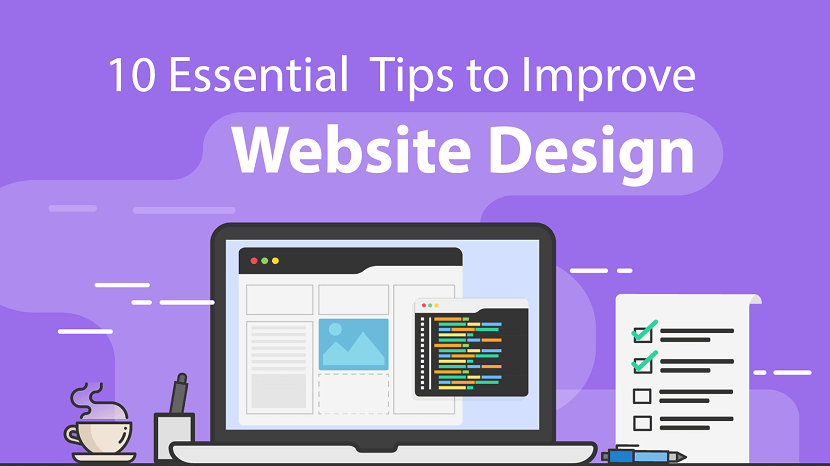
You have about 5-seconds (give or take) to let your website visitors know what your company or brand is and what they do. Is your website easy to navigate? Is the layout of your pricing easy to see and understand? Do you have a high bounce rate? It may be time to improve website design.
If the answer to all of the above questions is “no,” it might be time to take a hard look at the way you’ve been designing and optimizing your website. It never hurts to go over website improvement ideas, especially if you are trying to learn how you can improve the layout.
So much of today’s business is conducted online. From shopping to marketing, to communicating with providers, people depend on the Internet to help them perform everyday tasks. Without a website, businesses, blogs and brands are destined for failure.
Developers like yourself have numerous ways to improve website design. Even if you have a clean, smooth, professional website, that doesn’t mean it is converting how you want.
You should always consider website improvement ideas as time goes by.
When it comes to designing, you want to make sure the layout conveys the right message without overwhelming visitors.
10 Tips to Improve Website Design
There is a lot of information out there about ways to improve website design. Narrowing it down can be difficult. You want to make sure you cover the most important website design tips out there.
These are 10 essential tips to improve your website design. So, when you ask yourself… “How can I improve my website,” these are the ones you definitely want to review and implement.
1. Mobile Friendly and Responsive
There really is no argument here. Of course, you want several things in place to improve your website design. But no matter what anyone tells you, a mobile friendly and responsive website should be at the top of your website design tips list.
Having a website that is not mobile friendly or responsive hurts you in several different ways. Not only does Google drop you in rankings (started in 2015) and searches, but you lose visitors anyway because they have a hard time looking at your content in certain formats.
While responsive and mobile friendly work together to create a streamlined user experience, they are actually two different things.
More than likely you have created a responsive and mobile friendly website by now. If you use WordPress or another popular platform for your website then you are definitely good to go.
However, if for some reason your site is not mobile friendly and responsive, this is the first website design tip you should tackle to improve the overall look, feel and functionality.
2. Simple Navigation
Look at this from a user’s perspective. How often do you visit a website and find the navigation is cloudy and muddled? Is it difficult to get around the site? Are menus, links and other information displayed all over the place?
It is important that you simplify the navigation for users. Even if you have a lot of content and need to map it out differently, simple navigation will give you a traffic spike almost immediately.
Here are a few things to remember when simplifying website navigation. These can be followed loosely, but following them closely will help.
When it comes to ways to improve your website, simplified navigation should be toward the top of the list. Remember, if your website users can access information and get around easily, they are going to stay on your website much longer.
3. Improve Page Speed
Your website page speed is crucial for keeping users on the site and interested. Remember, over 53% of people will abandon a mobile site if it takes longer than 3-seconds to load.
So, when you are making your site mobile friendly and responsive, you also want to take steps to improve website design by making sure your page speed is up to par.
This goes for any type of website you have. Blog, business, shopping cart, etc. Matter of fact, if you have even a 2-second delay in your load time during a transaction, the chances are that your potential customers will abandon carts and you will end up with one customer less than you started with.
There are several things you can do to optimize and speed up your website. Some of them include:
Page speed goes hand-in-hand with other ways to improve website design. Consider this a top priority when you are thinking about website design tips that will improve the functionality of your website.
4. Remove Unnecessary Content
Believe it or not, a massive amount of content is not always better. In many instances, less is actually more. This applies even more so when we talk about website design tips.
You want your website to be clean, smooth, professional and to the point. It’s all about walking the line of saying what you need without being visually overbearing.
You may have certain things you need to remove from the website. This is called unnecessary content. Getting rid of it will improve website design tremendously, as they do not follow website design best practices. Consider removing some of the following items if they are on your site:
Furthermore, it is a very good idea to be careful with the words you are using. If you can, go through your current content and look for the following words you may have used:
While these are not necessarily awful words, they are overused by hundreds, if not thousands of companies. They don’t make your content any more appealing or original.
5. Social Sharing and Social Follow
The world we live in these days has become a Facebook and Twitter world. That is to say, people connect and keep up with news and each other through social media.
Any website improvement ideas should involve taking advantage of social sharing and social following. Why? There are 800 million monthly active users on Instagram and 100 million daily active users on Twitter.
Those are astronomical numbers, but both come in behind Facebook, which has over 1 billion users. This is why it’s important for your website to offer social buttons to your visitors.
If by some chance you are unfamiliar with social sharing buttons, you need to get acquainted. They are the small buttons that are around the top or bottom of blog posts. They contain icons of different social media sites and allow you to share the page directly on the channel of your choice.
The idea is to get guests to share your content when they like what they read. Sharing content puts it out for everyone else to see without you having to do any work. This will allow your website to become more popular and gain site visitors that would have never known about you otherwise.
Social sharing options are a fantastic way to improve website design. This is one of the many tips that will quickly boost your social media engagement.
6. Strong and Visible Call to Action
Your website is a place to sell your products and services, pump your brand or blog, blog, blog. Make sure you have a strong and visible call to action in place. Give your site visitors a way to connect with your company.
A call to action can be a number of things including a free trial, account creation, linking them to buy something or have them sign up for a newsletter. A strong call to action will be the thing that increases your conversions, so make sure you put some time into coming up with the perfect one.
Other great examples of high converting calls to action include:
A call to action can be in the form of a banner, buttons, a popup box or basically anything that helps grab the site visitor’s attention. They can even be full landing pages. Improve website design by giving site users something to do and let them interact with the site.
7. Use White Space to Your Advantage
Oftentimes people get nervous about white space on a website. In reality, you can use whitespace to your advantage and it should be a part of your layout.
Also called “negative space,” white space refers to the areas around elements on a page that are empty and lacking content or visual items. White space is an essential design element that helps you break up the page and increase readability.
Too often I come across websites with no white space. Elements, text and graphics run into each other and overflow. Every part of the main page is colored and used, and no white space is available.
This is a mistake.
If you have a front page or any page of your website that lacks white space, then you should review the layout. Strip the content and design, and create some white space to break up the content more appropriately. This will also make things more visually appealing to your site visitors.
With all the website improvement ideas floating around out there, this is one that could get lost in the mix.
Don’t let it. Proper use of white space is one of the better ways to improve website design.
8. SEO Strategy
You will hear people talk about SEO (Search Engine Optimization) all the time when it comes to ways to improve website design. While this visually will not affect the front of your website, it is extremely important to have a good SEO strategy in place.
Having proper SEO in place will do a number of things to improve your site. Most of all, it will allow you to rank higher in Google and will also allow you to trend for what you want and get properly indexed in search engines.
Also, consider an SSL certificate if your website does not already have one. Google has been pushing the https protocol and giving better ranking to sites that have these certificates.
Most website hosts will now offer a free version of the Let’s Encrypt SSL.
9. Have a Blog
One of the best ways for people to know what you do is by reading your content. Not only is a blog visually appealing to your site visitors, but also gives you a place to push content.
This is a great website design tip. So much so that oftentimes you will see older websites implement a blog, even after being online for years.
Having a blog on your site will also encourage user interaction and keep your potential customers engaged. You should post various articles that are relevant to your business and services.
Blog pages will generate more online traffic to your business website, which leads to more sales. It can also establish you as an authority in your industry, which will increase confidence in your services.
Remember to integrate your social share buttons within your blog section.
10. Use Color Theory to Your Advantage
Color theory and psychology matter and how they are used affects website conversion. Colors, how they are used and what they represent matter.
Use this to your advantage when you are designing or updating a website. Using color theory can add so much more to your site and is a website design tip that should not be ignored.
The standard language for color communication is called Pantone, and yes that is a real thing. You should know about it, and probably do if you are in the marketing field.
To help you a little, here is what colors represent:
Final Thoughts
You have dozens of ways to improve website design at your disposal. You should at least entertain most of them if you haven’t already. The 10 website design tips that are listed in this article are ones I consider to be the most important and are the best ways to improve website design.
Start implementing some of these right away and you will notice a big change in visitor traffic and behavior.
If you found this article helpful, we encourage you to share it on your social media platforms—because sharing is caring! For more information about article submissions on our website, feel free to reach out to us via email.
Send an emailWritten by RGB Web Tech
Latest Technology Trends
Latest technology trends shaping the future, including AI advancements, blockchain innovation, 5G connectivity, IoT integration, and sustainable tech solutions. Explore breakthroughs in quantum computing, cybersecurity, augmented reality, and edge computing. Stay ahead with insights into transformative technologies driving innovation across industries and revolutionizing how we live, work, and connect.
12 Principles of Design & How to works
Last updated on January 19, 2025 by RGB Web Tech

You can’t just flip a switch and create beautiful designs on a whim. Like learning to walk before you run, there are certain fundamentals you’ve got to learn first.
The problem is that if you don’t have the time or inclination to take a design course, resources are pretty scarce. Sure you can rely on Canva templates, but even then you need to know how to use them properly.
This is why we've put together this post. It’s for you if you’ve ever wondered what goes into good design. You'll find it handy whether you're a complete amateur or a budding designer—so let's get stuck in.
What are design principles?
Design principles are guidelines to follow if you want to create effective visuals, from oil paintings and blog graphics to eye-catching social media posts.
Think of design as carpentry and these principles as your toolbox. You can use them to help you during the design process, and unlike hammers, nails and screwdrivers, they can exist entirely inside your head.
These tools give you a better understanding—and appreciation—of what goes into the designs we see every day. As you become acquainted with them, you’ll start to see what does and doesn’t work (and why), as well as how you can apply these principles to your own creative work.
What is "good design"?
We’re told that piece of art is subjective. For the most part, that’s true. But if you’ve ever seen an unintelligible parking sign or a website from the early days of the web, you’ll know there’s definitely such a thing as bad design.
As Jared Spool, an expert on design and usability, says, “good design, when it’s done well, becomes invisible. It’s only when it’s done poorly that we notice it.” This is why good design is tricky to define.
Luckily for us, in the late 1970s, an influential designer named Dieter Rams saw this problem. In response, he asked himself what constituted good design and came up with his own list of ten principles.
Little did he know, they would go on to inspire generations of designers, including Johnny Ive, the mastermind behind Apple’s most famous products.
Rams’s principles are:
You might notice that these principles are aimed at product design. Rams worked at Braun, so products were in his wheelhouse, but these principles are easily adapted to UX, UI, or any other design context.
Rams’s principles aren’t the only principles out there. Other notable design principles include Nielsen’s 10 usability heuristics and Whitney Hess’s five guiding principles for experienced designers.
The 12 principles of design
These are the building blocks graphic designers and artists use to put creative works together; the core principles of art that make up every design, from the fine art of the Louvre to the boxes of Corn Flakes at the local grocery store.
1. Balance
Where objects in real life carry physical weight, elements in design carry visual weight. Large elements are heavier and small elements lighter, with each element having its own "weight" based on how much attention they draw.
Visual balance is about ensuring your design is equally weighted on both sides of the central point. It’s like a seesaw—too much weight on either side and the whole thing becomes unbalanced.
By striking this balance you create visual harmony and stop your design from feeling too chaotic to the viewer. It’s one of the most important parts of visual composition, and comes in three basic forms:
Symmetrical balance

Symmetrical design uses an imaginary vertical (or sometimes horizontal) line to divide a design into two halves around a central point. Elements of equal visual weight are balanced on each side of the axis to create symmetry.
There are two variants of symmetrical balance: Reflectional symmetry, where the two halves are exact mirror images, and translational symmetry, where the same shape or elements are repeated on both sides of the design.
Asymmetrical balance

An asymmetric composition is when a design uses unequal weighted elements. One side might have a visually heavy element, balanced with multiple lighter elements on the opposite side.
To run with the seesaw example, it would be like having a 100kg weight on one side and 100 kg of feathers stacked on the other. It still achieves balance but provides a whole different experience.
Asymmetry is often more visually interesting. Where symmetrical designs can be quite static and predictable, asymmetrical balance can give designs a more dynamic feel.
Radial balance

Radial balance is when elements “radiate” from a point in the centre of a design. Think of rays shining from the sun, petals blossoming from a rose, or a squirt of tomato sauce in the middle of a juicy meat pie.
This form of symmetry is a way to add depth and movement to a design and works to draw attention to an object in the centre of a composition.
2. Emphasis

Emphasis is used to focus the viewer’s attention on a certain part of a composition. The effect is achieved by manipulating elements (like colour, shape and size) to make specific parts of a design stand out.
For example, say you wanted to bring attention to a call to action on a landing page. You could increase the text size and use colours that stand out from the background, emphasising the CTA and making sure visitors can’t miss it.
3. Repetition

As you may have already guessed, repetition refers to when an element is repeated throughout a design. It could be anything, from using a certain font colour to adding a repetitive pattern to a social media post.
Repetition makes designs visually exciting and cohesive. It also creates a sense of consistency by using a repeating motif that the viewer comes to expect. This makes it particularly useful when it comes to creating your distinct brand identity.
Brand identity is the visible element of your brand. The colours; design; logo. It acts to distinguish your company from the millions of others out there, so when folks see your designs they immediately know it’s your business.
Every successful business uses repetition. Why do we equate the swoosh and “just do it” with Nike? The blue can with Pepsi? Because these visuals were repeated so often that eventually they became synonymous with the brands they represent.
So while repetition can just help you make a sweet iPhone wallpaper, it’s a crucial tool for any company looking to build a visual identity and brand recognition.
4. Movement

When we think of movement we think of, well, things moving. A pendulum swinging. A Ferrari roaring down the freeway. But in design, it refers to the path a viewer’s eye takes when they look over a composition.
It’s not just what you look at; it’s the way you look at it. Designers can guide this by using lines, edges, shapes and colours to create focal points and encourage certain ways of seeing.
Movement can be harnessed to distract, direct and pull the viewer’s gaze around a design. By using subtle cues (particularly with lighting and perspective) a savvy artist can control this entire process. You can use lines to create directional cues and make images feel more alive.
5. Proportion

Proportion is the relationship between two or more elements in a design, particularly the size and scale of them. When things are "proportionate”, it means there’s a coordination between them that makes the design look aesthetically pleasing.
For example, when you’re reading a blog post you expect headings to be larger than the body text. Or if you were looking at a realistic drawing of a tortoise and a hare, you expect the hare to be larger than the tortoise.
Proportion is about finding harmony between two elements. You want to make sure things look “right”— that the elements look as if they belong together.
This is something that comes up when creating digital assets and websites online. It’s the bane of many an amateur designer’s existence. Here are a few tips for keeping the elements in your design in proportion:
You can also play with proportions in a variety of ways to emphasise elements or get a certain message across. It’s a strategy you’ll notice advertisements do often and is usually best used for more creative projects.
6. White Space
\
The region between different design elements is referred to as "negative” or “white” space. This is part of the design that doesn’t contain anything. No images, drawings, shiny colours or text. Nothing.
The name is kind of misleading — it’s not a "negative" thing and it doesn’t have to be "white". It can be any colour: white space refers to what you don’t add; the empty parts around and within your design.
It’s one of the fundamental building blocks of design and is just as important as any elements you do include. Think of it like a diet: what you eat matters, but what you don’t eat matters just as much.
“White Space in design composition is the same as the use of silence in a musical composition. Without proportionate use of silence, music is unstructured. Similarly, without white space, design is unstructured and difficult to consume." — Mark den Hartog
There are two types of white space: micro and macro. Micro white space is the space between small elements (like text), while macro white space refers to the area between large elements or surrounding a design.
7. Contrast

Contrast is produced when two or more visual elements in a composition are different. It can be used to create specific effects, emphasise the significance of certain elements, and add visual appeal to your designs.
Designs that look the same are boring—by experimenting with contrasting colour hues, shapes, sizes, textures and typography, you can liven things up. Humans tend to like contrast. It’s a great way to grab attention, control the visual flow and keep folks engaged.
Keep in mind that adding too many variations can be confusing for viewers (the opposite effect you want to have.) As with most of the different elements of art, it’s about striking a balance.
8. Hierarchy

Visual hierarchy is about organising the value of the elements within your design. By ranking information from most important to least important, you make it easier for the viewer to digest your content.
This plays a critical role in UI and UX design. Ever noticed how most landing pages have the same layout? There’s a logo at the top, a menu at the top and then elements in descending order of importance below.
It’s not because they copied each other's homework—there’s a certain hierarchy that designers stick to in order to draw attention to the right things in the right order (and make it pretty to look at.)
The viewer’s eye should be drawn to the most important element first. These sit atop the throne at the top of the hierarchy, with the elements laid out below ranked in order of importance.
There are a number of visual tricks to influence this flow, including:
Patterns of hierarchy
People read a page in the same way: from top to bottom. But we don’t just stare blankly at s page and wait for information to register, we scan it.
The human eye tends to follow the same path during this process. For that reason, designers stick to two common patterns to make it faster to absorb information: the F-pattern and the Z-pattern.
The F-pattern applies to pages made up mostly of text, like an online or printed article. Readers scan in the shape of an “F”—first, with the headline across the top, then down the left side of the page and to the right as they identify things they find interesting.

Designers use a Z-pattern for layouts with less text and more visuals. With this pattern, viewers scan across the top of the page and then diagonally down towards the opposite corner. They then scan the bottom in the same way as the top.
Most websites are designed in this way (including Paperform). Notice how the most important parts like the logo and navigation menu are at the top, while the secondary information like clients and chatbot is at the bottom.
9. Rhythm

Don’t worry, you can leave your dancing shoes at home. In design, rhythm hasn’t got anything to do with the way you move your hips. It’s about giving your composition a feeling of action and movement.
Designers create rhythm by repeating lines, shapes, colours and other elements. This makes a path for our eyes to follow, builds patterns and imbues the design with a sense of flow. There are a few different types of rhythm:
Rather than letting the viewer’s eye settle on a focal point, rhythm encourages viewers to move their eyes across the entire piece, following the lines and forms to their natural endpoints. It’s something you see reflected across nature and works of art.
10. Pattern

People tend to get confused between repetition in patterns, which is understandable, as they both deal with repeated elements. But the similarities end there.
While repetition occurs when the same elements are repeated throughout a design, a pattern is composed of different components repeated in the same way. Think of the way gift wrapping is usually made up of a few different repeated elements—that's a pattern.
You'll also notice patterns commonly used as backgrounds on websites and in mobile applications.
As a general rule, it's best to use colours, textures and shapes to create patterns. Try to avoid doing so with words — it tends to just give folks headaches. Despite the occasional bright colours and wacky designs, the key to creating effective patterns is simplicity.
11. Variety

Variety isn’t just the spice of life—it’s the spice of design too. It’s integral not to revert to the same old elements within a design to make sure things are visually interesting for your viewers.
Variety keeps things engaging. It stops designs from being stagnant, predictable and downright boring — all things you want to avoid. By making sure elements are varied you stop designs from feeling monotonous and uninspired.
The easiest way to do this is through juxtaposition and contrast. Place bright colours next to lighter hues, text next to images, and round shapes next to square ones. By doing so you can keep viewers engaged and your design interesting.
12. Unity

We've put unity last on this list for a reason—it only occurs when all the various elements within a design coexist to form a holistic experience that’s pleasing to the eye.
Unity adds order and makes a piece feel like a coherent whole, instead of a messy combination of individual parts that just so happen to exist on the same page. It's developed both visually and conceptually.
To achieve unity you need to look out for three things: whether the elements you’ve used have a good reason to be there, whether they work together, and whether the message or concept you’re trying to display is communicated clearly.
By making sure your designs unite you reduce cognitive load and ensure viewers actually understand whatever it is your design is trying to achieve.
Put these design principles to work
Hopefully, these 12 design principles can help inspire you to take your creative work to the next level.
No matter what you’re designing—from product pages to actual products—if you take the time to learn and apply these concepts you’ll be firmly set on the path to success.
Remember, design is always evolving. Look at what other people are doing and think about how you can apply their techniques to your own work: it’s a great way to hone your design skills.
Now, all that’s left is to put your creative cap on and create your own work of art. Happy creating!
If you found this article helpful, we encourage you to share it on your social media platforms—because sharing is caring! For more information about article submissions on our website, feel free to reach out to us via email.
Send an emailWritten by RGB Web Tech
Latest Technology Trends
Latest technology trends shaping the future, including AI advancements, blockchain innovation, 5G connectivity, IoT integration, and sustainable tech solutions. Explore breakthroughs in quantum computing, cybersecurity, augmented reality, and edge computing. Stay ahead with insights into transformative technologies driving innovation across industries and revolutionizing how we live, work, and connect.
17 Best FREE Web Hosting Services
Last updated on January 19, 2025 by RGB Web Tech

Is free website hosting any good? Well, “free” is always good but not always worth it in the long run. Let me explain:
In short, if you want to run a test website, you’re not expecting to get much from it, and you don’t want to invest any money into it at all, then free website hosting might indeed work for you!
In 95% of other cases, you’re going to be better off with a cheap website hosting plan like Bluehot, Hostinger etc. no more expensive than $2.75 or even $1.99 per month (small businesses or online stores often choose something in this price range).
If you’re in a hurry, here’s a summary of our findings based on the analysis below:
Free website hosting is okay for a hobby project or a proof-of-concept type of project. It’s okay if you want to run a site for a short while, get your data and then shut it off.
For any sort of serious website building project or a site that’s meant to stay online for a long while, you’re better off with an affordable web hosting plan or even a pick from the very best web hosting services out there.
For example, Bluehost is our recommended self-hosted website server. If you check them out through our link, you’ll unlock a special discounted price of $2.75 / mo vs the $3.75 standard entry-level price. You also get a free domain name bundled in.
Alternatively, you might opt for an all-in-one solution. For example, Wix is a good choice for a quick start, covering both hosting and website builder in one place. Although there is a free plan, you can try any premium plan offering 14 days of money-back.
Want to get the full story? We compared 17 best free website hosting options to help you make your decision.
The limitations of free website hosting
In life, you tend to get what you pay for, and web hosting is no exception. If you choose the free hosting route, be prepared for some common issues that come along with it.
Even the best free hosting tends to be fairly unstable, which can result in downtime. Also, providers typically place restrictions on storage space and bandwidth, limiting your site’s growth and traffic capacity. Your personal website or business website may also have slow performance.
That said, there are times you may want to consider free hosting. For a personal project, it may be all you need. The same is true if you’re practicing your web design and web development skills and just want a space to try out new ideas.
Perhaps you’re setting up an area to test new plugins or themes. In that case, the limitations of free hosting shouldn’t be a barrier to what you want to accomplish. Of course, if you simply need a staging site, you may want to use a local development tool, such as Local, and not worry about hosting at all.
However, if you need a live site and don’t want to deal with the drawbacks of free web hosting, there are some affordable alternatives to consider. A cheap host can help you keep your budget low while avoiding poor site availability.
17 Best FREE Website Hosting Services
The good news is that you can test drive free website hosting at no cost to see if it might work for you. If you’ve decided to give it a try, here are 17 options to consider.
1. InfinityFree
InfinityFree is a free web hosting service that boasts a 99.9% uptime guarantee. It offers users:
You’ll also have access to the Softaculous Script Installer to set up WordPress. This hosting service provider doesn’t offer domain registration, but you can use one you’ve acquired from another registrar.
Once your website is published, your visitors won’t see ads. However, there will be ads in cPanel on the back end. Your site is also limited to 50,000 hits per day.
2. Wix
Wix is a drag-and-drop website builder – similar to tools like Weebly or Squarespace; and yup, you don’t need to be familiar with PHP, like you do with other solutions (e.g. – Joomla).
However, we’re featuring Wix on this list because it’s kind of an all-in-one solution for both a website platform and server space to host that website. Since Wix does come with a free plan, this makes it a free website hosting service as well. This free website builder is a unique way to enjoy awesome site-building features backed by enterprise-grade reliability. On that free plan, you get:
Unfortunately, if you’re expecting no ads, you will be disappointed. Just like most of the free web hosting providers, Wix places their own ads on free plan sites. You can only connect a Wix subdomain and would have to move to a paid plan for connecting a custom domain.
The eCommerce functionality is also unavailable in the free version. However, you can still set up things like bookings, events, and forums, and fill in your site with SEO-friendly content with just a few clicks.
3. ByetHost
ByetHost is another free hosting service that you could use. Its plan features:
ByetHost offers solid support for its free plan, which can be rare. You can access a self-service knowledge base and video tutorials, but a ticketing system is also available.
In addition, you’ll receive usage statistics such as disk space, bandwidth usage, and daily hits. You can find this data in VistaPanel, which is ByetHost’s free hosting control panel. Then, you can use the information to help budget your resources.
4. 000WebHost
000WebHost is a free hosting option from Hostinger. Some of its features include:
000WebHost comes with the Zyro website builder, which should make designing your site less intimidating. Like InfinityFree, visitors to your website won’t see ads, but there will be ads in your WordPress dashboard.
Free hosting from 000WebHost doesn’t even require a credit card to set up, and you can use it as long as you like. Also, if you outgrow your free plan, you can easily upgrade to a cheap plan from Hostinger. Hostinger plans start at $1.99 / month for your first billing cycle.
5. Google Cloud Hosting
Google Cloud Hosting isn’t technically free. However, it does offer a one-year free trial that includes:
While Google Cloud Hosting is tailored towards large businesses, anyone can use it. To get started, all you need is a Google account.
The free trial lasts for 12 months, or until you’ve used up the $300 credit it includes. After this, you only pay for the resources you use. Google offers a price calculator to help you estimate your costs.
6. AwardSpace
AwardSpace offers a variety of hosting services. It’s best known for its free plan, which includes:
Awardspace includes one-click content management system (CMS) installation as well as the Zacky website builder. Also, the 24/7 live chat is available to free plan users if you have questions.
Once launched, your own website will be ad-free. Plus, you can place ads to monetize it. AwardSpace provides you with the ability to monitor your bandwidth usage as well, which may help you budget your resources.
7. Freehostia
Freehostia offers paid and free hosting. The free plan, called ‘Chocolate’, provides:
Freehostia’s cluster platform aims to offer more reliability from its free hosting. Hopefully, this results in less downtime for your website.
You’ll have access to a website builder complete with templates. If you run into issues, you can have an answer to your support ticket in one hour, even with the free plan.
8. FreeWebHostingArea
FreeWebHostingArea is a volunteer-maintained free hosting service. It offers:
9. W3Schools Spaces
W3Schools Spaces features of the free plan:
10. Glitch
Glitch features of the free plan:
11. Fleek
Fleek features of the free plan:
12. Netlify
Netlify features of the free plan:
13. Render
Render features of the free plan:
14. Surge
Surge features of the free plan:
15. Vercel
Vercel features of the free plan:
16. Firebase
Firebase features of the free plan:
17. HyperPHP
HyperPHP is a free hosting and domain service for personal websites. Its plan offers:
HyperPHP offers a few ways to make launching a new website easy. Firstly, a free domain transfer is available. This host also offers an automatic script installer, which you can access through VistaPanel.
FAQs - Free Web Hosting
1. Is free web hosting reliable?
Answer : No, free web hosting isn’t reliable. Most free web hosting has absurdly limited resources and you’re also likely to run into multiple issues. This includes poor performance, complicated interface, compromised security, and ads on your website. Not to mention questionable terms of service.
2. Can I get free hosting and a domain?
Answer : Free hosting and domain is rarely possible, none of the providers here has such a deal. However, many hosts offer free subdomain hosting. You can choose a desired name for your site, but it will look something like this: desiredname.freehosting.com.
3. Can I use free hosting for selling online?
Answer : Yes, as long as you can host WordPress and install WooCommerce on your paid plan, it's possible to sell online using free hosting. Yet, it’s extremely likely to cause many problems and potentially ruin the seller/buyer relationship. If your online store is always down or very slow, the buyers will simply go to more professional sites.
4. Can I host my own website?
Answer : Yes, you can host your own website if you have the tech skills and 100% uninterrupted network. It will require significant skills, technical know-how, resources, and time among other things. Plus, many Internet service providers also forbid personal hosting.
5. Does it matter where you host your website?
Answer : Yes. With a bad hosting provider, your website may be plagued with slow loading times, a lack of proper security, and extensive downtime. It’s really important to choose a web host with a discerning eye.
Conclusion
While your free web hosting platform might not be perfect, it can be a viable option in some scenarios. However, finding a quality provider that delivers on its promises is no easy task.
In this article, we shared our opinions on the 17 best free website hosting options available. You have nothing to lose by giving one a try. Our top pick in the category of best free web hosting is AwardSpace for its 24/7 live chat support and easy WordPress installation.
However, for any type of serious project, we recommend using at least a cheap paid shared hosting service. In our collection of cheap web hosting sites, you’ll find services that cost just a few dollars per month.
As we mentioned earlier in this post, you can get quality, affordable website hosting like Bluehot, Hostinger etc. for $2.75 or even $1.99 per month
Recommendation - Paid Web Hosting Service Providers
If you are looking for safe and secure website hosting, we recommend to use paid web hosting services.
Read More : You can explore here 30+ Best Web Hosting Providers 2023
Video - Best Web Hosting For Small Business
Affordable Website Hosting for your domainIf you found this article helpful, we encourage you to share it on your social media platforms—because sharing is caring! For more information about article submissions on our website, feel free to reach out to us via email.
Send an emailWritten by RGB Web Tech
Latest Technology Trends
Latest technology trends shaping the future, including AI advancements, blockchain innovation, 5G connectivity, IoT integration, and sustainable tech solutions. Explore breakthroughs in quantum computing, cybersecurity, augmented reality, and edge computing. Stay ahead with insights into transformative technologies driving innovation across industries and revolutionizing how we live, work, and connect.
Build eCommerce Website with Shopify - FREE Trial
Last updated on January 19, 2025 by RGB Web Tech

Introduction of Shopify
Shopify is a leading eCommerce website builder that empowers businesses of all sizes to establish and manage their online stores. With a user-friendly interface and a wide array of customizable themes and templates, Shopify simplifies the process of creating professional and visually appealing online stores. It provides a comprehensive suite of features, including inventory management, secure payment options, order fulfillment, and customer support tools. Shopify offers seamless integration with numerous third-party applications, enabling businesses to enhance their store's functionality and scalability. Its robust analytics and reporting tools help businesses gain valuable insights and make data-driven decisions. With its extensive range of features and user-friendly interface, Shopify is a go-to platform for anyone seeking to launch and grow their eCommerce business.
Table of Article Contents
How does Shopify work?

Shopify works as an all-in-one eCommerce website builder, providing businesses with the tools they need to create and manage their online stores. Here's a simplified overview of how Shopify works:
1. Sign up and create a store: To get started, you sign up for a Shopify account and go through the setup process. This involves selecting a store name, customizing the design with themes and templates, and adding products.
2. Product management: With Shopify, you can easily add, edit, and organize your products. You can upload product images, set prices, manage inventory, create product variations, and categorize items into collections.
3. Store customization:Shopify offers a range of customizable themes and templates. You can modify the design elements, such as colors, fonts, and layouts, to match your brand and create a unique online store.
4. Payment processing:Shopify integrates with various payment gateways, allowing you to accept online payments securely. It supports popular options like credit cards, PayPal, Apple Pay, and more.
5. Order management: When customers make purchases, Shopify helps you manage the orders efficiently. You can view and process orders, track shipments, send notifications to customers, and handle returns and refunds.
6. Marketing and SEO:Shopify provides built-in marketing tools and SEO features to promote your online store. You can create discount codes, run marketing campaigns, optimize product pages for search engines, and integrate with social media channels.
7. Apps and integrations:Shopify offers an extensive app store where you can find additional functionalities and integrations. These apps can enhance your store's features, such as email marketing, customer support, analytics, and inventory management.
8. Analytics and reporting:Shopify provides detailed analytics and reports to track your store's performance. You can monitor sales, visitor behavior, conversion rates, and other key metrics to make data-driven decisions and optimize your business strategy.
9. Security and reliability:Shopify ensures the security of your store and customer data. It includes features like SSL certificates, PCI compliance, and automated backups, providing a secure shopping experience.
10. Scaling your business:Shopify is built to scale with your business. Whether you're starting small or growing rapidly, it offers flexible plans and options to accommodate your needs, including advanced features like multi-channel selling and enterprise solutions.
Pros and cons of Shopify
Pros of Shopify
Cons of Shopify
What can you sell on Shopify?
Shopify is a versatile eCommerce website builder that allows you to sell a wide range of products and services. Here are some examples of what you can sell on Shopify:
1. Physical products: This includes tangible items such as clothing, electronics, home goods, accessories, beauty products, and more. You can set up product variations, manage inventory, and fulfill orders for physical goods.
2. Digital products:Shopify supports the sale of digital products like e-books, software, music, videos, courses, and graphic designs. Customers can download or access these products electronically after purchase.
3. Services:Shopify enables businesses to sell services, such as consulting, coaching, graphic design, web development, event planning, and various professional services. You can create service listings and accept bookings or appointments through the platform.
4. Subscriptions: With Shopify's recurring billing feature, you can sell subscription-based products or services. This includes subscription boxes, memberships, software licenses, or any product that customers can subscribe to on a recurring basis.
5. Dropshipping:Shopify integrates seamlessly with dropshipping apps and platforms, allowing you to sell products from suppliers without having to handle inventory or fulfillment. You can create a store, choose products to sell, and the supplier ships the products directly to customers.
6. Handmade and crafts: If you create handmade products or crafts, Shopify provides a platform to showcase and sell your unique creations. This can include items like jewelry, artwork, ceramics, candles, and other artisanal products.
7. Wholesale and B2B:Shopify offers features for businesses that want to sell products in bulk or target other businesses as customers. You can set up wholesale pricing, create customer-specific catalogs, and manage bulk orders.
8. Events and tickets:Shopify allows you to sell tickets for events, concerts, workshops, or any kind of ticketed experience. You can manage ticket inventory, set pricing tiers, and handle ticket delivery or check-in through the platform.
These are just a few examples, and the flexibility of Shopify allows you to sell almost any type of product or service. Whether you have a physical store and want to expand online or you're starting a brand new eCommerce business, Shopify provides the tools and features to support a wide range of product offerings.
What is Shopify POS (Point of Sale)?
Shopify POS (Point of Sale) is a system that enables businesses to sell products and accept payments in-person, whether it's at a physical retail store, pop-up shop, trade show, or any other offline location. It seamlessly integrates with the Shopify eCommerce platform, providing a unified system for online and offline sales. Here are key features and benefits of Shopify POS:
1. Hardware integration:Shopify POS works with a range of hardware devices, including iPads, iPhones, Android devices, barcode scanners, receipt printers, and cash registers. This allows businesses to set up a complete point-of-sale system tailored to their needs.
2. Centralized inventory management: With Shopify POS, inventory management becomes centralized across online and offline channels. It automatically updates inventory levels in real-time, ensuring accurate stock counts and avoiding overselling.
3. Product and order management: You can easily add products, set prices, and organize them into collections within the Shopify POS system. It also enables you to create orders, apply discounts, and manage customer information for in-person transactions.
3. Omnichannel selling:Shopify POS enables businesses to seamlessly switch between online and offline sales. You can sell products from your online store in-store and vice versa, providing a consistent shopping experience for customers.
4. Payment options:Shopify POS supports various payment methods, including credit cards, debit cards, cash, gift cards, and digital wallets. It integrates with leading payment providers, ensuring secure and reliable payment processing.
5. Customer management: You can create customer profiles, track purchase history, and collect customer information at the point of sale. This data can be utilized for personalized marketing, loyalty programs, and customer support.
6. Offline capabilities: In case of an internet outage, Shopify POS has offline capabilities. It allows you to continue accepting payments and processing orders, which will sync with the Shopify platform once you're back online.
7. Reporting and analytics:Shopify POS provides detailed reports and analytics, giving insights into sales, inventory, and customer behavior. This data helps businesses make informed decisions and optimize their operations.
Shopify POS offers a seamless integration between your online and offline sales channels, providing a unified system for inventory management, order processing, and customer engagement. It simplifies the process of selling products in-person and ensures a cohesive experience for both merchants and customers.
Alternatives of Shopify
There are several alternatives to Shopify as eCommerce website builders. Here are some popular ones:
1. BigCommerce: BigCommerce is a scalable eCommerce platform that provides a comprehensive set of features to build and grow an online store. It offers a wide range of customizable templates and integrates with various third-party tools.
2. PrestaShop: PrestaShop is an open-source eCommerce platform that provides a flexible and customizable solution for building online stores. It offers a range of features, modules, and templates.
3. Squarespace:Squarespace is a popular website builder that includes eCommerce functionality. It offers visually appealing templates and a user-friendly interface to create and manage an online store.
4. Volusion: Volusion is a comprehensive eCommerce platform that provides tools for building and managing an online store. It offers customizable templates, marketing tools, and various integrations.
5. WooCommerce:WooCommerce is a powerful plugin for WordPress that allows you to turn your WordPress website into a fully functional eCommerce store. It offers a wide range of themes and extensions to customize your online store.
These are just a few alternatives to Shopify, and each platform has its own strengths and target audience. When choosing an eCommerce website builder, consider factors such as your business needs, budget, scalability requirements, customization options, and the level of technical expertise required.
FAQ - Shopify Online Store
Here are some frequently asked questions (FAQs) about Shopify as an eCommerce website builder:
1. What is Shopify?
Answer :Shopify is an eCommerce platform that allows businesses to create and manage online stores. It provides a user-friendly interface, a wide range of customizable themes, and a robust set of features to sell products or services online.
2. How much does Shopify cost?
Answer :Shopify offers different pricing plans to cater to various business needs. The plans range from Basic Shopify ($29/month) to Shopify ($79/month) and Advanced Shopify ($299/month). There is also Shopify Plus, an enterprise-level solution with custom pricing.
3. Can I use my own domain name with Shopify?
Answer :Yes, you can use your existing domain name or purchase a new one through Shopify. You can either connect your domain to your Shopify store or purchase a domain directly from Shopify.
4. Is Shopify secure for online transactions?
Answer : Yes, Shopify prioritizes security and provides SSL encryption for all online stores. It is Payment Card Industry Data Security Standard (PCI DSS) compliant, ensuring that customer payment information is securely handled.
5. Can I sell products in multiple currencies?
Answer : Yes, Shopify supports selling products in multiple currencies. This feature is available on Shopify's higher-tier plans and allows you to expand your business globally and cater to customers in their preferred currency.
6. Does Shopify integrate with third-party apps and services?
Answer : Yes, Shopify has an extensive App Store with a wide range of apps and integrations. You can find apps for various purposes, such as marketing, analytics, customer support, inventory management, shipping, and more.
7. Can I migrate my existing online store to Shopify?
Answer : Yes, Shopify provides migration tools and resources to help you transfer your store from other platforms. You can import your product data, customer information, and other relevant data to Shopify.
8. Does Shopify offer customer support?
Answer : Yes, Shopify offers 24/7 customer support through various channels, including live chat, email, and phone. They also provide extensive documentation, tutorials, and a community forum to help users navigate the platform.
9. Can I sell both physical and digital products on Shopify?
Answer : Yes, Shopify supports the sale of both physical and digital products. You can create product listings for physical items with inventory management features, and sell digital products by offering downloadable files or access codes.
10. Does Shopify provide marketing and SEO tools?
Answer : Yes, Shopify offers built-in marketing and SEO features to help you promote your online store. This includes options for creating discounts, running promotions, generating discount codes, optimizing product listings for search engines, and integrating with social media platforms.
Final Verdict Shopify
In summary, Shopify is a top-notch eCommerce website builder that offers a user-friendly interface, a wide range of customizable themes, and powerful features to create and manage online stores. It provides scalable solutions for businesses of all sizes, with reliable security measures for online transactions. While the cost and specific needs of a business may vary, Shopify's extensive integrations, app ecosystem, and strong customer support make it a popular choice. Overall, Shopify is a reliable and comprehensive platform that empowers businesses to establish and grow their online presence with ease.
If you found this article helpful, we encourage you to share it on your social media platforms—because sharing is caring! For more information about article submissions on our website, feel free to reach out to us via email.
Send an emailWritten by RGB Web Tech
Latest Technology Trends
Latest technology trends shaping the future, including AI advancements, blockchain innovation, 5G connectivity, IoT integration, and sustainable tech solutions. Explore breakthroughs in quantum computing, cybersecurity, augmented reality, and edge computing. Stay ahead with insights into transformative technologies driving innovation across industries and revolutionizing how we live, work, and connect.
How to Sell or Promote your Shopify Store?
Last updated on January 19, 2025 by RGB Web Tech

Promoting your Shopify store is vital for driving traffic and increasing sales. Utilize social media marketing by creating engaging content and collaborating with influencers. Implement content marketing through blogging and guest posting to boost visibility. Leverage email marketing to nurture customer relationships and provide exclusive promotions. Optimize your store for search engines with SEO techniques and consider running targeted paid advertising campaigns. Explore influencer partnerships and seek customer reviews and referrals to build trust. Regularly analyze the performance of your promotional efforts and make data-driven adjustments to optimize your store's growth.
How to Sell or Promote your Shopify Store?
Promoting your Shopify store is crucial to driving traffic, increasing sales, and growing your business. Here are some effective strategies to promote your Shopify store:
1. Social Media Marketing
2. Content Marketing
3. Email Marketing
4. Influencer Marketing
5. Search Engine Optimization (SEO)
6. Paid Advertising
7. Collaborations and Partnerships
8. Customer Reviews and Referrals
Remember, it's important to track and analyze the results of your promotional efforts. Monitor website analytics, conversion rates, and customer feedback to understand what strategies work best for your store and make data-driven adjustments accordingly.
Conclusion
Promoting your Shopify store is an ongoing process that requires a strategic and multi-faceted approach. By utilizing social media marketing, content marketing, email marketing, SEO, paid advertising, influencer collaborations, and customer referrals, you can effectively drive traffic and increase sales. Regularly analyze the performance of your promotional efforts and make data-driven adjustments to optimize your store's growth. Remember to engage with your audience, provide valuable content, and prioritize customer satisfaction. With consistent effort and adaptability, you can successfully promote your Shopify store, expand your reach, and achieve long-term success in the competitive e-commerce landscape.
If you found this article helpful, we encourage you to share it on your social media platforms—because sharing is caring! For more information about article submissions on our website, feel free to reach out to us via email.
Send an emailWritten by RGB Web Tech
Latest Technology Trends
Latest technology trends shaping the future, including AI advancements, blockchain innovation, 5G connectivity, IoT integration, and sustainable tech solutions. Explore breakthroughs in quantum computing, cybersecurity, augmented reality, and edge computing. Stay ahead with insights into transformative technologies driving innovation across industries and revolutionizing how we live, work, and connect.
Tips for Shopify Store all New Owner Need to Know
Last updated on January 19, 2025 by RGB Web Tech

If you're a new store owner on Shopify, there are several key tips you should know to maximize your success. First, select a clean and professional theme that aligns with your brand identity. Customize your store's appearance and optimize your product pages with compelling descriptions and high-quality images. Streamline your checkout process to reduce cart abandonment, and set up shipping and fulfillment options to provide a smooth customer experience. Implement SEO best practices to increase organic traffic, leverage social media and marketing channels, and install essential apps to enhance your store's functionality. Monitor analytics, provide excellent customer support, and continuously refine your strategies for long-term success.
Shopify Tips All New Store Owners Need to Know
If you're a new store owner on Shopify, here are some tips to help you get started and make the most out of your Shopify store:
1. Choose a clean and professional theme: Select a visually appealing theme that aligns with your brand identity and provides a user-friendly experience for your customers. Shopify offers a wide range of free and paid themes to choose from.
2. Customize your store: Take advantage of Shopify's customization options to create a unique store that stands out. Customize your theme's colors, fonts, and layout to match your branding. Add a logo, high-quality product images, and compelling product descriptions.
3. Optimize your product pages: Make sure your product pages are well-optimized for conversions. Use clear and enticing product titles, include detailed descriptions, and highlight the benefits and unique selling points of your products. Add high-quality images and consider using product videos to showcase your items.
4. Streamline your checkout process: Simplify the checkout process to reduce cart abandonment. Enable guest checkout, minimize the number of required form fields, and offer popular payment options like credit cards, PayPal, and Apple Pay. Install trusted payment gateways to ensure secure transactions.
5. Set up shipping and fulfillment: Configure your shipping settings accurately, including shipping rates, zones, and carrier integration if applicable. Consider offering free shipping or setting up conditional free shipping based on order value. Streamline your fulfillment process by integrating with fulfillment apps or services.
6. Implement SEO best practices: Optimize your store for search engines to increase organic traffic. Use relevant keywords in your product titles, descriptions, and meta tags. Create unique and descriptive page titles and URLs. Install an SEO app to help you manage and improve your store's SEO performance.
7. Leverage social media and marketing channels: Promote your store and products through social media platforms like Instagram, Facebook, and Pinterest. Run targeted ads to reach your ideal audience. Implement email marketing campaigns to engage with your customers and drive repeat sales.
8. Install essential apps:Shopify's app store offers a wide range of apps to enhance your store's functionality. Install apps for email marketing, social media integration, analytics, customer reviews, and more. However, be cautious not to install too many apps that could slow down your store's performance.
9. Monitor analytics and make data-driven decisions: Utilize Shopify's built-in analytics or integrate with third-party analytics tools to track your store's performance. Monitor key metrics such as sales, conversion rates, traffic sources, and customer behavior. Use this data to identify areas for improvement and make informed decisions to optimize your store.
10. Provide excellent customer support: Offer multiple channels for customer support, such as live chat, email, or phone. Respond promptly to customer inquiries and provide helpful and friendly assistance. Positive customer experiences can lead to repeat purchases and word-of-mouth recommendations.
Remember, building a successful online store takes time and effort. Continuously monitor and refine your strategies, stay up to date with the latest e-commerce trends, and adapt your approach based on customer feedback and market demands.
Conclusion
In conclusion, as a new store owner on Shopify, implementing these tips can greatly benefit your business. By choosing a professional theme, customizing your store, and optimizing your product pages, you'll create an appealing and user-friendly shopping experience. Streamlining your checkout process, setting up shipping and fulfillment, and implementing SEO best practices will help drive conversions and attract organic traffic. Leveraging social media and marketing channels, installing essential apps, and monitoring analytics will further enhance your store's performance. Lastly, providing excellent customer support ensures a positive experience for your customers, leading to repeat sales and growth. By following these tips, you'll be on your way to building a successful Shopify store.
If you found this article helpful, we encourage you to share it on your social media platforms—because sharing is caring! For more information about article submissions on our website, feel free to reach out to us via email.
Send an emailWritten by RGB Web Tech
Latest Technology Trends
Latest technology trends shaping the future, including AI advancements, blockchain innovation, 5G connectivity, IoT integration, and sustainable tech solutions. Explore breakthroughs in quantum computing, cybersecurity, augmented reality, and edge computing. Stay ahead with insights into transformative technologies driving innovation across industries and revolutionizing how we live, work, and connect.
Best Employee Monitoring Software
Last updated on January 19, 2025 by RGB Web Tech

Introduction of SentryPC - Employee Monitoring Software
SentryPC is an advanced employee monitoring software designed to enhance productivity and security in the workplace. With its powerful features and intuitive interface, SentryPC allows employers to monitor and manage employee activities on company devices effectively. From real-time monitoring to comprehensive activity logs, this software offers valuable insights into employee behavior and helps enforce compliance with company policies. Whether you need to track time spent on applications, monitor web browsing, or control access to certain websites or applications, SentryPC provides a comprehensive solution for employee monitoring and productivity optimization.
Table of Article Contents
Cost for SentryPC - Remote Employee Monitoring Software
Although many employee monitoring software solutions have seemingly affordable rates like $10 per user per month, many plans require you to have a certain minimum number of users, which drives up the total cost. For a smaller business with few employees, it can be difficult to find the right monitoring software for your team.
SentryPC solves that problem by eliminating user minimums; companies can purchase a single license for a flat annual rate. Each additional license is steeply discounted from the initial rate, making it a scalable solution that won’t cut too deeply into a small business’s budget.
Here’s what you will pay for each of SentryPC’s six plans:
Basic Plan
Business 50
Business 100
Business 250
Business 500
Business 1,000
Additional screenshots: With any SentryPC plan, you can add extra screenshots in increments of 500 for a one-time fee of $19.95. You’ll have access to the extra screenshot capabilities for the entirety of your subscription.
Features of SentryPC - Best Employee Monitoring Software
SentryPC offers a range of robust features that enable efficient employee monitoring and management. Here are some key features:
1. Real-time Monitoring: SentryPC provides live monitoring of employee activities, allowing you to view their screens in real-time. This feature enables supervisors to stay updated on work progress and identify potential issues or distractions.
2. Application and Website Tracking: The software tracks and records the applications and websites accessed by employees, providing detailed insights into their digital activities. This helps identify time wastage, unproductive habits, and potential security risks.
3. Keystroke Logging: SentryPC captures all keystrokes made by employees, allowing you to review typed messages, emails, and other textual content. This feature is useful for compliance purposes, troubleshooting, and detecting unauthorized activities.
4. Time Tracking: The software records the time spent by employees on specific applications and websites. It enables you to monitor productivity levels, identify time-consuming tasks, and optimize workflow efficiency.
5. Screenshots and Remote Viewing: SentryPC captures periodic screenshots of employee screens, allowing you to review their activities visually. Additionally, you can remotely view employee screens in real-time, promoting transparency and accountability.
6. File and Document Monitoring: This feature tracks file and document access, modification, and transfer activities. It helps prevent data breaches, intellectual property theft, and ensures compliance with data security protocols.
7. Internet Usage Controls: SentryPC allows you to block or restrict access to specific websites or categories, promoting responsible internet usage and minimizing distractions.
8. Alerts and Notifications: The software can generate alerts and notifications for specified activities or events, such as accessing prohibited websites or attempting to bypass security measures. This enables prompt action and intervention.
9. Reporting and Analytics: SentryPC generates comprehensive reports and analytics, providing detailed insights into employee productivity, usage patterns, and trends. These reports facilitate informed decision-making and performance evaluations.
10. Stealth Mode and Security: The software operates in stealth mode, remaining hidden from employees to ensure unbiased monitoring. It also offers password protection and encryption features to safeguard sensitive data.
Overall, SentryPC offers a comprehensive suite of features to help employers effectively monitor and manage employee activities, enhance productivity, and maintain a secure work environment.
How to Setup SentryPC - Employee Monitoring Software Small Business
To set up SentryPC, follow these general steps:
1. Purchase and Obtain License: Visit the official SentryPC website and select the appropriate pricing plan for your organization. Complete the purchase process and obtain the necessary license or activation key.
Download and Install: After purchasing, download the SentryPC software from the official website. Run the installer and follow the on-screen instructions to install the software on the computers you wish to monitor. Ensure that you have administrative privileges on the target devices.
Create an Account: Launch SentryPC on the target device, and you will be prompted to create an account. Provide the required information, such as your email address and password, to create a new account.
Configure Monitoring Settings: Once logged in, you can customize the monitoring settings according to your organization's requirements. This includes options such as website and application tracking, keystroke logging, screenshots, internet usage controls, and more. Set up any desired restrictions or permissions.
Install SentryPC Agent: To enable monitoring, you need to install the SentryPC Agent on each target device. From your SentryPC account, access the "Add Computer" or similar option and follow the instructions to install the agent on the respective devices. The agent installation process may vary depending on the operating system (e.g., Windows or macOS).
Customize Monitoring Policies: After the agent is installed, you can further customize monitoring policies. This includes setting up specific websites or applications to track, defining internet usage restrictions, configuring alert notifications, and adjusting other parameters based on your organization's needs.
Monitor and Manage: Once the setup is complete, you can log in to your SentryPC account from any device with an internet connection to monitor and manage employee activities. Access real-time data, review logs and reports, and utilize the various features offered by SentryPC.
Remember to comply with applicable privacy laws and regulations when monitoring employee activities. It's essential to inform your employees about the monitoring practices and obtain any necessary consent or legal requirements before implementing such software.
Pros and Cons of SentryPC - Top Employee Monitoring Software
Pros of SentryPC:
Cons of SentryPC:
Overall, the implementation of SentryPC and similar employee monitoring software should be approached with careful consideration of both the benefits and potential drawbacks, taking into account legal, ethical, and organizational factors.
FAQs - SentryPC Employee Monitoring Software
Here are some frequently asked questions (FAQs) about SentryPC - Employee Monitoring Software:
1. Is SentryPC legal to use?
Answer : Using SentryPC or any employee monitoring software must comply with applicable laws and regulations. It is important to consult with legal professionals to ensure compliance with local, state, and national laws regarding employee privacy, consent, and monitoring practices.
2. Can employees detect or bypass SentryPC?
Answer : SentryPC operates in stealth mode and remains hidden from employees. However, it is important to note that technically skilled employees may attempt to bypass or disable monitoring software. Implementing appropriate security measures and educating employees about monitoring policies can help mitigate such risks.
3. Does SentryPC support remote monitoring?
Answer : Yes, SentryPC supports remote monitoring. It allows supervisors or managers to remotely monitor employee activities, making it convenient for distributed or remote teams. However, limitations may exist for monitoring employees working on personal devices or through personal internet connections.
4. What data does SentryPC capture and track?
Answer : SentryPC captures various types of data, including application and website usage, keystrokes, screenshots, file and document access, and time tracking. The specific data captured can be customized based on your monitoring settings and preferences.
5. How does SentryPC handle data privacy and security?
Answer : SentryPC takes data privacy and security seriously. It offers features like encryption, password protection, and secure data storage to safeguard sensitive information. It is important to review the software's privacy policy and security features to ensure they align with your organization's requirements and industry standards.
6. Can SentryPC be used on multiple devices?
Answer : Yes, SentryPC can be used on multiple devices within your organization. Depending on your licensing plan, you may need to purchase additional licenses for each device you wish to monitor.
7. Does SentryPC offer reporting and analytics?
Answer : Yes, SentryPC provides reporting and analytics features. It generates comprehensive reports and analytics, offering insights into employee productivity, usage patterns, and trends. These reports can assist in decision-making, performance evaluations, and identifying areas for improvement.
8. Can SentryPC be used for remote workforce management?
Answer : Yes, SentryPC can be used to monitor and manage remote workers. It allows supervisors to monitor employee activities and track productivity levels, regardless of their location. However, it's important to establish clear policies and guidelines to ensure transparency and compliance with privacy regulations.
Remember to consult with the official SentryPC website or contact their support team for the most accurate and up-to-date information regarding their software and its features.
Conclusion - SentryPC Employee Monitoring Software
In conclusion, SentryPC is a powerful employee monitoring software designed to enhance productivity, security, and compliance in the workplace. With features such as real-time monitoring, application and website tracking, keystroke logging, and time tracking, it provides valuable insights into employee activities and helps optimize productivity levels. SentryPC offers remote monitoring capabilities and generates comprehensive reports and analytics, enabling informed decision-making and performance evaluations. While implementing employee monitoring software like SentryPC can bring benefits such as increased productivity and enhanced security, it is important to address privacy concerns, establish transparent communication, and comply with applicable laws and regulations. Exploring alternatives and considering specific organizational needs will assist in making an informed decision about choosing the most suitable employee monitoring software.
If you found this article helpful, we encourage you to share it on your social media platforms—because sharing is caring! For more information about article submissions on our website, feel free to reach out to us via email.
Send an emailWritten by RGB Web Tech
Latest Technology Trends
Latest technology trends shaping the future, including AI advancements, blockchain innovation, 5G connectivity, IoT integration, and sustainable tech solutions. Explore breakthroughs in quantum computing, cybersecurity, augmented reality, and edge computing. Stay ahead with insights into transformative technologies driving innovation across industries and revolutionizing how we live, work, and connect.
Best eCommerce Website Builder
Last updated on January 19, 2025 by RGB Web Tech
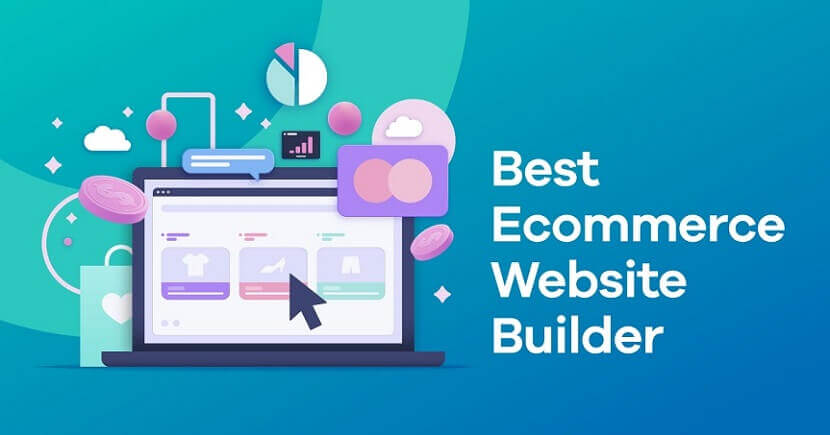
Introduction of eCommerce Website Builder
An eCommerce website builder is a powerful tool that enables individuals and businesses to create and manage their own online stores without extensive technical knowledge. It provides a user-friendly interface, pre-designed templates, and integrated features for setting up product listings, managing inventory, processing payments, and handling shipping. With an eCommerce website builder, users can customize the design of their online stores, optimize them for search engines, and leverage various marketing tools to attract and engage customers. These platforms offer a cost-effective and efficient solution for establishing a professional online presence and tapping into the vast potential of the eCommerce market.
Table of Article Contents
Top 11 eCommerce Website Builder
Here are the top 10 eCommerce website builders.
1. Shopify:Shopify is one of the most popular and widely used eCommerce website builders. It offers a user-friendly interface, a wide range of templates, and robust features to build and manage an online store.
2. BigCommerce: BigCommerce is a scalable eCommerce platform that provides a comprehensive set of features to build and grow an online store. It offers a wide range of customizable templates and integrates with various third-party tools.
3. PrestaShop: PrestaShop is an open-source eCommerce platform that provides a flexible and customizable solution for building online stores. It offers a range of features, modules, and templates.
4. Squarespace:Squarespace is a popular website builder that includes eCommerce functionality. It offers visually appealing templates and a user-friendly interface to create and manage an online store.
5. Renderforest AI Website Builder: Renderforest offers an AI-driven website builder specifically for creating polished and efficient online platforms quickly. Ideal for those looking to streamline the design process, it features a host of templates and tools that adapt to your content, making it easier to launch a professional website with minimal effort.
6. Volusion: Volusion is a comprehensive eCommerce platform that provides tools for building and managing an online store. It offers customizable templates, marketing tools, and various integrations.
7. WooCommerce:WooCommerce is a powerful plugin for WordPress that allows you to turn your WordPress website into a fully functional eCommerce store. It offers a wide range of themes and extensions to customize your online store.
8. 3dcart:3dcart is a feature-rich eCommerce platform that caters to businesses of all sizes. It offers a wide range of customizable templates, SEO tools, and integrations to create a successful online store.
9. Weebly:Weebly is a beginner-friendly website builder that includes eCommerce capabilities. It offers a drag-and-drop interface, mobile-responsive templates, and various features for building an online store.
10. Magento:Magento is an open-source eCommerce platform known for its scalability and flexibility. It offers a wide range of features and customization options for building robust online stores.
11. Wix:Wix is a versatile website builder that offers eCommerce functionality. It provides a drag-and-drop interface, a variety of templates, and a range of features to create an online store.
Key Features and Benefits of eCommerce website builders
1. User-friendly interface: Website builders offer intuitive interfaces that allow users to easily create and customize their online stores. They often use drag-and-drop functionality, enabling users to add and arrange elements on their webpages without any coding knowledge.
2. Templates and design customization: eCommerce website builders offer a range of professionally designed templates to choose from. These templates are customizable, allowing users to personalize their store's appearance, including colors, fonts, layouts, and branding elements, to match their unique style and brand identity.
3. Product management: A website builder provides tools for managing product listings, including adding product descriptions, images, pricing, and inventory tracking. Some builders also offer options for categorizing products, creating variants (e.g., different sizes or colors), and managing product attributes.
4. Payment and checkout integration: Integration with popular payment gateways allows customers to make secure online payments, while offering multiple payment options such as credit cards, PayPal, or other digital wallets. eCommerce website builders often provide pre-built checkout pages and streamlined purchasing processes.
5. Order and inventory management: Builders include features for tracking and managing orders, inventory levels, and shipping. This helps businesses stay organized by providing real-time updates on order status, stock availability, and automated notifications for customers.
6. SEO optimization: Website builders often include built-in SEO tools to optimize your online store for search engines. They provide features such as customizable meta tags, URL structures, and site maps to improve visibility and rankings in search engine results.
7. Mobile responsiveness: With the increasing use of mobile devices for online shopping, eCommerce website builders ensure that websites are mobile-responsive. This means that the design and layout of the store automatically adjust to fit various screen sizes, providing a seamless browsing and shopping experience on smartphones and tablets.
8. Analytics and reporting: Builders offer built-in analytics tools that provide insights into customer behavior, sales data, and website performance. These analytics help store owners make informed decisions and optimize their marketing and sales strategies.
9. Support and security: eCommerce website builders often provide customer support through various channels such as live chat, email, or phone. They also prioritize security measures like SSL certificates and data encryption to protect sensitive customer information and ensure safe transactions.
Pros and Cons of eCommerce Website Builder
Using an eCommerce website builder has its own set of pros and cons. Let's explore them:
Pros:
Cons:
Considering these pros and cons, it's important to assess your specific business needs, technical expertise, and long-term goals when deciding whether an eCommerce website builder is the right choice for you.
Paid V/S Free eCommerce Website Builder
Choosing between a paid and a free eCommerce website builder depends on various factors, including your budget, business needs, and desired level of customization and support. Let's explore the pros and cons of each option:
Paid eCommerce Website Builder:
Pros:
Cons:
Free eCommerce Website Builder:
Pros:
Cons:
Ultimately, the decision between a paid and a free eCommerce website builder depends on your specific needs, budget, and long-term goals. If you require advanced features, scalability, and professional support, a paid builder may be worth the investment. However, if you have simple requirements and want to minimize costs, a free builder could be a suitable option. Assess your priorities and evaluate the available options to make an informed decision.
FAQs - eCommerce Website Builder
Certainly! Here are some frequently asked questions (FAQs) about eCommerce website builders:
1. What is an eCommerce website builder?
Answer : An eCommerce website builder is a platform or tool that enables individuals or businesses to create and launch their own online stores without extensive coding or technical expertise. It provides pre-designed templates, drag-and-drop functionality, and integrated tools for managing products, payments, and shipping.
2. Do I need coding skills to use an eCommerce website builder?
Answer : No, coding skills are generally not required when using an eCommerce website builder. These platforms offer user-friendly interfaces and drag-and-drop functionality, allowing users to create and customize their online stores without writing code.
3. Can I customize the design of my online store?
Answer : Yes, eCommerce website builders typically provide customizable templates and design options. You can personalize the appearance of your online store by selecting colors, fonts, layouts, and adding your branding elements to match your unique style and brand identity.
4. Can I sell physical and digital products with an eCommerce website builder?
Answer : Yes, most eCommerce website builders support the sale of both physical and digital products. They provide features for managing product listings, descriptions, pricing, and inventory tracking. Some builders also offer options for selling services or memberships.
5. How do I accept payments on my online store?
Answer : eCommerce website builders integrate with various payment gateways, allowing you to accept secure online payments from customers. Popular payment options include credit cards, PayPal, and other digital wallets. You will need to set up an account with the chosen payment gateway and connect it to your online store.
6. Can I track inventory and manage orders with an eCommerce website builder?
Answer : Yes, eCommerce website builders typically provide inventory management features that allow you to track product availability, set stock levels, and receive notifications for low inventory. They also offer order management tools to track and fulfill customer orders.
7. Can I optimize my online store for search engines?
Answer : Yes, many eCommerce website builders offer built-in SEO tools to optimize your online store for search engines. These tools include options for customizing meta tags, URLs, and sitemaps to improve your store's visibility and rankings in search engine results.
8. Can I get support if I have issues or questions?
Answer : Most eCommerce website builders provide customer support through various channels such as live chat, email, or phone. They often have extensive documentation, tutorials, and community forums to help users troubleshoot issues or find answers to their questions.
9. Can I switch eCommerce website builders later?
Answer : Yes, it is possible to switch eCommerce website builders, although the process may involve migrating your store's data and settings to the new platform. It's important to carefully evaluate your needs and research the migration process before making a switch.
10. How much does an eCommerce website builder cost?
Answer : The cost of an eCommerce website builder varies depending on the platform and the plan you choose. Prices can range from free (for limited features) to monthly or annual subscription fees that can vary based on features, storage, and transaction fees. Some builders also offer premium plans with additional features or enterprise-level options for larger businesses.
Conclusion
In conclusion, eCommerce website builders provide an accessible and convenient solution for creating and managing online stores. They offer user-friendly interfaces, customizable templates, and integrated features that simplify the process of establishing an online presence. Shopify, WooCommerce, BigCommerce, Wix, and Squarespace are among the top choices, each with their own strengths and suitability for different needs. It's essential to consider factors like ease of use, customization options, scalability, pricing, support, and integrations when selecting the right eCommerce website builder. By making an informed decision and continually optimizing your online store, you can create a successful and professional eCommerce business.
If you found this article helpful, we encourage you to share it on your social media platforms—because sharing is caring! For more information about article submissions on our website, feel free to reach out to us via email.
Send an emailWritten by RGB Web Tech
Latest Technology Trends
Latest technology trends shaping the future, including AI advancements, blockchain innovation, 5G connectivity, IoT integration, and sustainable tech solutions. Explore breakthroughs in quantum computing, cybersecurity, augmented reality, and edge computing. Stay ahead with insights into transformative technologies driving innovation across industries and revolutionizing how we live, work, and connect.
10 Best Practices for Secure Online Payment Processing
Last updated on January 19, 2025 by RGB Web Tech
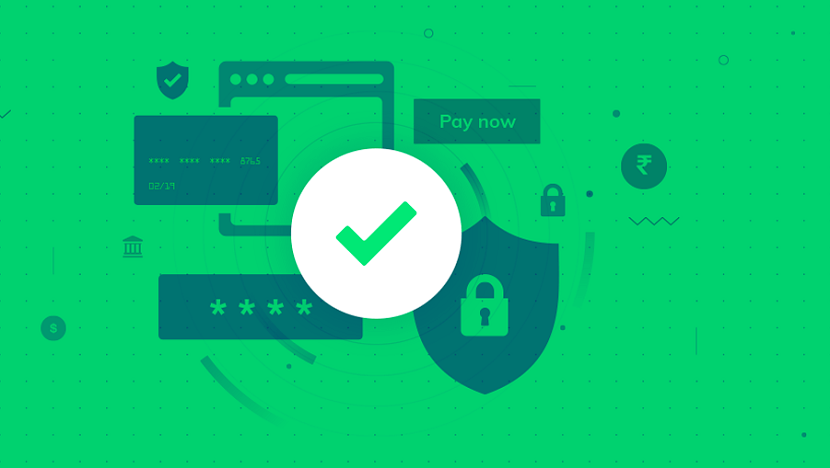
Learn how secure online payment processing protects your customers and business from risk and fraud.
There are so many brands and businesses selling products and services online. This makes it easy for customers or consumers to have access to varying choices when they want to make purchases. Customers need the assurance that when they share their payment details online in an e-commerce store their details will not be compromised.
However, hackers are constantly looking for ways to steal the banking and payment details that are shared on websites. It makes it increasingly important for e-commerce owners to ensure that payment processing is secure and that customers’ data are not breached because doing so will lead to a dent in the brand’s reputation. Therefore, we will be sharing with you the 10 best practices that you can implement for secure online payment processing. They include:
1. Match the IP and Billing Address Information
During online payment processing, matching the IP and billing address information is frequently done because it helps to prevent fraud and ensure that the payment is secure. To match the IP and billing address information, customers must first input their billing information while making the payment online; this includes details like their address, city, state, country, and postal code. While this is being input, the IP address of the customer will be simultaneously captured. This IP address is usually a numerical label that has been given to the customer’s device once connected to the internet. With the help of geolocation services, the billing and IP address will be compared to see if it matches. Where this does not match, there is a possibility that it is a fraud and the customer can be notified. Including matching IP address and billing address helps secure online payment processing for both the e-commerce store and the customer shopping.
2. Encrypt Data
Another best practice for secure online payment processing is by encrypting data. With the use of TLS and SSL on the websites, data can be encrypted which makes it difficult or impossible for hackers to access the data and make use of it.
The benefit of using an SSL certificate is that customers can share data securely with a website while trying to make online payments. This data can be the card number, pin, CVV codes, expiration date, and other information that if it falls into the wrong hands, can be bad. Here, SSL can be either domain validated, extended validated (EV) or organization validated (validation types). It depends upon the type of SSL certificate that a payment process has in built. Most payment processors go with an EV SSL certificate that provides the highest authentication and security. Many resellers offer low priced or cheap EV SSL certificate in the market.
When a customer’s browser and your company’s website server want to communicate data between both ends, no hacker can intercept that data. It also ensures there is no interception or decryption of data that is shared with you.
3. Use Payment Tokenization
With the use of payment tokenization, payment processing is made secure. How this works is that immediately the card details are inputted on the seller’s server, and a unique token is assigned to it and used while processing the transaction. This token is often randomly generated and a reference is made between the card details and generated token to keep it safe. Therefore, when this token is being communicated to the seller’s server, the seller cannot see the original information on the card detail, but can only see the payment token. So, it becomes impossible for hackers to access the original card details because of the payment token.
4. Require Strong Passwords
Ask your customers to input strong passwords when they want to sign into the payment option of their website. The password should not be something that can be easily guessed by hackers like the birthdates of the customer or that of their loved ones. It is better if the password is something randomly generated but strong. A strong password is usually eight characters long and made up of numbers, alphabets, and symbols. There are times that up to eight characters may not be accepted, but you should still use a strong password. It is advisable to have a password manager to store your passwords, and if you ever have to click on the ‘forgot password’ option, ensure that the OTP that will be sent is to your email address or the phone number you are currently using.
5. Implement 3D Secure
You have to choose a payment service provider (PSP) that supports and allows 3D secure, because it will help to secure payment processing. When you settle on the PSP, you have to sign up and fully get on to make use of it and that will involve supplying relevant data like business name and banking information. With the 3D secure fully integrated on your website, each time a customer provides their card details to make payments, the request for payment and the cardholder's data will be sent directly to your payment service provider's API.
If their card is enrolled in 3D secure, a redirect URL will be given to them to initiate the 3D secure authentication process where they will be asked to enter a one-time password (OTP). After the customer inputs the OTP, he will be directed to the website to complete the payment process. Some cards are not enrolled in 3D secure and it is usually a bit good because of the high risk and the potential of hackers accessing the data. So, implementing 3D secure will help to secure payment processing.
6. Request the CVV
CVV stands for card certification value. It is usually made up of 3 or 4 digits and at the back of a credit card. Ecommerce store owners have seen and agreed with the need of asking customers to input this CVV code for secure online payment processing. The benefit of customers inputting the CVV is to prevent fraudulent transactions because even when someone can access your payment details if they do not have your card, they will not be able to add the CVV hence the payment transaction will not go through.
7. Use Strong Customer Authentication (SCA)
Based on your state or country, there are different strive customer authentication (SCA) guidelines or procedures that you can make use of to secure payment processing. There are certain monetary thresholds that when it is exceeded, you have to make use of SCA. Therefore, on your website, you have to make use of two-factor authentication, and appropriate authentication methods, which can involve you including third parties, authentication methods on your website.
SCA methods are constantly evolving so for the benefit of your customers you should keep abreast with it and educate your customers on setting up authentication methods and its importance. When your customers have an idea and implement authentication methods, it makes it easier for you both to work together towards securing payment processing.
8. Monitor Fraud Continuously
To monitor fraud for secure online payment processing, you have to make use of real-time monitoring and proactive measures to watch out for this fraud. There are fraud detection tools, address verification systems (AVS), two-factor authentication, chargebacks and refunds, data analysis, and other things you can do to monitor fraud. If you want to monitor fraud in real time, you have to employ a data analyst who can go through all incoming data. Spending the time and resources to do this will help you spot fraudulent activities and any form of hacking attempt during payment processing.
9. Manage PCI Compliance
As an e-commerce store owner or any person who is accepting credit card payments online, you have to comply with Payment Card Industry Data Security Standards (PCI DSS). The standards that must be covering protecting the data of customers and credit cards being used on your website. It ensures that some security systems and networks have been built, and regularly looks out for malicious software that tries to access your website or data. The team should look for who can access sensitive data on your website, each time you notice unauthorized access quickly take notice of it and put a security system in place to prevent an attack and if there is an attack, try to respond immediately to rectify it. Doing all these will help secure online payment processing for your business and customers.
10. Train Employees
Securing payment processing is the work of customers, e-commerce store or website owners, and employees. When your employees are trained on how to secure online payment processing, it will help minimize payment insecurities and hackers accessing sensitive data. So, teach your employees to log out of their accounts when they leave their workstations, not keep work USB drives unattended, and watch out for phishing emails or spam so that they do not click on them. They should not give anyone their accounts or log in details to prevent unauthorized access to their information. Employees should frequently keep abreast of how to secure payment processing.
Rapyd Offers Built-In Payment Fraud Protection with Advanced Features, which will be beneficial to your website or e-commerce stores each time someone wants to make a payment. Additionally, you can download the useful guide: How to Reduce Your Payment Risks for Cross-Border e-commerce. This guide will help you need to secure online payment processing. Know that you can keep or lose your customers online based on the security measures you implement to process payments.
Conclusion
Securing online payment processing is important for a business or brand that does not want to lose customers' data and harm their brand's reputation in the process. So, as an e-commerce store owner, make use of these 10 steps to secure payment processing. Do not fail to keep abreast with relevant and innovative ways to secure payment processing online.
If you found this article helpful, we encourage you to share it on your social media platforms—because sharing is caring! For more information about article submissions on our website, feel free to reach out to us via email.
Send an emailWritten by RGB Web Tech
Latest Technology Trends
Latest technology trends shaping the future, including AI advancements, blockchain innovation, 5G connectivity, IoT integration, and sustainable tech solutions. Explore breakthroughs in quantum computing, cybersecurity, augmented reality, and edge computing. Stay ahead with insights into transformative technologies driving innovation across industries and revolutionizing how we live, work, and connect.
Unlocking Success: How Web Design and Development Impact Your Online Presence
Last updated on January 19, 2025 by RGB Web Tech
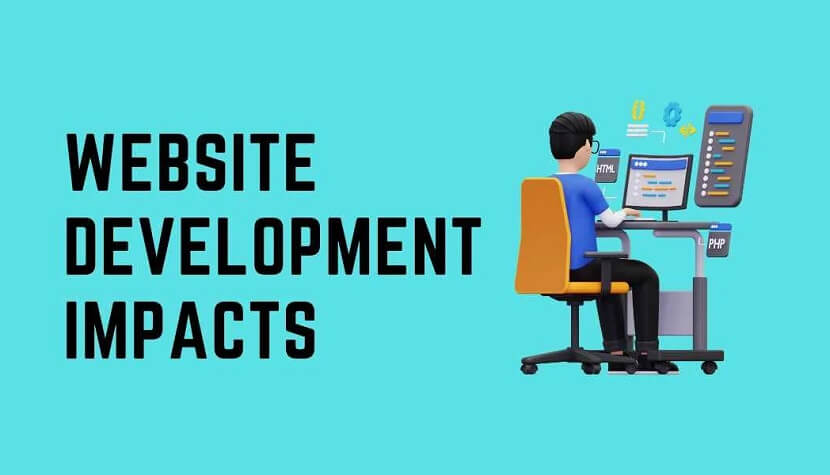
In the era of rapid digital advancements, establishing a formidable online footprint becomes imperative for the triumph of any business venture. A meticulously crafted and expertly engineered website can potentially wield a profound impact on the perception of your brand, ultimately ushering you toward the gateway of triumph. Within the confines of this article, we shall delve deep into the realm of web design and development, unraveling its intrinsic capabilities to instill a positive transformation in your virtual presence. Brace yourself as we commence this enthralling odyssey toward attaining boundless success!
The Power of First Impressions
In the realm of your website, initial impressions hold immense significance. Studies have revealed that mere seconds are all visitors take to shape their perception of your site. Hence, it becomes paramount to fashion a design that is visually enchanting and user-friendly, seizing your audience's attention right from the moment they land on your virtual domain.
An aesthetically captivating framework, complemented by alluring imagery and captivating content, possesses the power to leave an indelible mark on your visitors. It conveys a sense of professionalism, credibility, and reliability, all of which are pivotal elements in establishing a robust online presence.
Navigating the User Experience
The success of a website is intricately tied to the user experience (UX) it offers. The seamless flow of navigation, an intuitive interface, and flawless functionality collectively contribute to a positive user experience. It is imperative that visitors can effortlessly find the information they seek, devoid of any sense of confusion or frustration.
The user experience can be considerably improved by adding simple navigation menus, clear call-to-action buttons, and strategically arranged content. By placing utmost importance on user experience during web design and development, you can effectively captivate and retain your audience, minimize bounce rates, and maximize conversions.
Mobile Optimization: A Must-Have
In an era dominated by the ubiquity of smartphones and tablets, optimizing your website for mobile devices is not merely a choice—it has become an absolute necessity. Neglecting the necessity of mobile optimization can seriously harm your online presence because a substantial amount of internet traffic comes from mobile users.
Responsive web design ensures the seamless adaptation of your website to diverse screen sizes and resolutions. It guarantees a consistent and intuitive user experience across a myriad of devices, thereby empowering mobile users to navigate and engage with your digital domain effortlessly. By embracing the essence of mobile optimization, you can extend your reach to a broader audience while concurrently enhancing your search engine rankings.
Leveraging Social Media Integration
Social media has become an inseparable part of our daily lives in our modern interconnected world. Harnessing the power of social media integration in your web design and development endeavors can revolutionize your online presence.
By seamlessly integrating social sharing buttons on your website, you can actively encourage and empower visitors to effortlessly share your valuable content with their extensive networks. Furthermore, real-time social media feeds display allows you to showcase captivating updates and actively engage with your cherished audience. By forging a solid and seamless connection between your website and various social media platforms, you can expand your reach, nurture unwavering brand loyalty, and attract a fresh influx of new followers.
Consider using QR codes as a cutting-edge and creative strategy as well. By strategically incorporating QR codes into your web design, you can provide a quick and convenient way for users to access and share your website or specific content. QR codes act as a bridge between the physical and digital worlds, enabling effortless interaction and expanding the potential for connection with your target audience.
Search Engine Friendliness: Climbing the Ranks
Unleashing triumphant outcomes within the digital landscape necessitates a profound grasp of the indispensability of search engine optimization (SEO). A meticulously optimized website can heighten your visibility in search engine results, propelling organic traffic and magnetizing prospective clientele.
To augment the search engine friendliness of your website, integrate pertinent keywords seamlessly into your content, meta tags, and headings. Skillfully employ appropriate HTML tags, such as H1, H2, and H3, to meticulously structure your content, thereby endowing search engines with a clear comprehension of your website's hierarchical framework. Additionally, craft descriptive and succinct meta descriptions for each page, enthralling users and enticing them to click through to your digital abode fervently. By meticulously implementing these SEO strategies, you can fortify your online presence and unlock the gates to unrivaled success.
Enhancing Loading Speed: Faster Than a Blink
In the contemporary whirlwind of our world, swiftness reigns supreme. Research unequivocally demonstrates that users demand websites to load swiftly within two seconds or less. Any semblance of delay in loading speed can elicit exasperation, urging visitors to forsake your digital abode in favor of a nimbler alternative.
Optimizing your website's loading speed is an imperative measure to avert the potential loss of visitors. Embrace techniques such as image compression, minimizing HTTP requests, and harnessing caching mechanisms, as they wield power to enhance loading times significantly. By according to the importance to speed within your web design and development endeavors, you can seamlessly bestow a browsing experience without hindrance, thereby ensuring the unwavering engagement of your cherished users.
Maximizing Accessibility for All
Web accessibility is a paramount facet of web design and development that must never be disregarded. Ensuring the accessibility of your website to individuals with disabilities resonates not only as an ethical imperative but also as a legal mandate in numerous jurisdictions.
Incorporate proper HTML tags, furnish an alternative text for images, and employ descriptive link texts to facilitate users utilizing screen readers. Deliberate upon color contrast to enhance readability and extend keyboard navigation options to cater to those unable to hire a mouse. By rendering your website accessible to all, you exhibit an unwavering commitment to inclusivity, fostering a positive online presence that reverberates with the utmost integrity.
Conclusion
Realizing unprecedented triumph within the digital realm necessitates acknowledging the profound influence of web design and development on your online presence. According to the paramount importance of factors such as visual allure, user experience, mobile optimization, search engine friendliness, and accessibility, you pave the way for creating a captivating website that magnetizes and enthralls your intended audience. Remember, your website serves as the digital countenance of your brand, and investing in its design and development catalyzes your unparalleled accomplishments in the online sphere.
If you found this article helpful, we encourage you to share it on your social media platforms—because sharing is caring! For more information about article submissions on our website, feel free to reach out to us via email.
Send an emailWritten by RGB Web Tech
Latest Technology Trends
Latest technology trends shaping the future, including AI advancements, blockchain innovation, 5G connectivity, IoT integration, and sustainable tech solutions. Explore breakthroughs in quantum computing, cybersecurity, augmented reality, and edge computing. Stay ahead with insights into transformative technologies driving innovation across industries and revolutionizing how we live, work, and connect.
7 Ways to Improve Your Accounting System Benefits
Last updated on January 19, 2025 by RGB Web Tech

Accounting is the only way for small business owners to know if their business is doing well and the only thing keeping them out of prison. This is why it needs to be accurate and resilient. No matter what happens, you need to know that the numbers in the books correspond to the real numbers with a 1:1 ratio. Still, how do you achieve this reliability? Here are our top seven suggestions for the ideas you should implement to reap more accounting benefits.
1. Segregation of duties
To commit fraud, one person must have control over multiple accounting processes. It’s like having more than one checkpoint that you have to pass. It’s not about distrusting people in your accounting. It’s just acknowledging that people will be tempted if you make it too easy to alter data and manipulate financial records for personal gain.
By segregating duties, you make this a distant possibility, dissuading many potential troublemakers. Also, by making a whole system more robust, you’ll make it resilient even in the face of staffing changes.
This means that the level of quality remains continuously high and you don’t have to worry about the future, as much.
2. Pick the right platform
Another thing you need to do is choose the right accounting software. The right platform can drastically reduce the likelihood of human error. With the help of an invoice processing API armed with OCR technology, invoices can be scanned. Since there’s no manual entry, the likelihood of human error is drastically reduced.
This also saves labor and allows a single accountant or bookkeeper to do the work of many. You can have a functional accounting department with a good platform, one accountant, and a bookkeeper (or a virtual assistant).
The benefit of this is that you get the functionality of a department even with a skeleton crew. So, your payroll remains low and your accounting improves.
3. Internal control
You need to control your accounting as thoroughly as you can. Just think about it – it’s not just maliciousness you seek. It’s incompetence or errors due to a lack of attention. Do you think that an explanation that you’re not fraudulent, it’s just your accountant who is incompetent, that will stick in court?
You must also stay compliant with regulations and laws, maintain high operational efficiency, and ensure that your financial statements have high integrity. Sometimes, investors or stakeholders will insist that you control your accounting more closely, and you must oblige.
This gives you mechanisms to rapidly discover anything suspicious going on in your accounting, which benefits you from both financial and legal standpoints.
4. External audits and reviews
You can never be too careful. Therefore, on top of the internal control that we’ve already discussed, you also need some independent external verification. The key thing to bear in mind is the fact that these controls are more credible. Internal control can be biased. For this reason, an external audit may even be a regulatory requirement.
Even more importantly, this way, you can control your internal controllers. If the results are not the same, there’s something amiss. This is important since your internal control will conduct a more frequent overview.
5. Careful selection when hiring/outsourcing
When hiring help, you need to be extra careful. Whom are you hiring, and can you trust them? These two questions are pivotal for your selection process, especially when it involves tasks like legal document comparison. First of all, make sure to ask around. Look at their previous employment and their stay in each firm.
There’s so much you can do to research the reputation of the person or agency you decide to work with. The key lies in carefully selecting who you’re working with. There are reviews online, and you can even ask for contacts with old clients.
This keeps track of your own team and helps you make a better staffing selection in the future.
6. Continuous training
We live in a dynamic world. The truth is that regulations change more frequently than they did half a century ago. New tools and accounting practices are also hitting the market every day. Continuous education and training is the only way to keep up with this. These are just not things you can know intuitively.
Also, continuous education will ensure that your problem-solving abilities remain sharp. Your skills deteriorate when not used, and even in accounting, not all skills are present in day-to-day tasks. This way, you’ll just be ready for everything.
Once again, in order to benefit from a system in the long run, you need to make all your accounting methods systemic.
7. Emphasis on data security and privacy
Accounting is always full of sensitive information. This is why you need to ensure that all the data is protected. First of all, your systems need to be sturdy. If your accountants work from their private devices (which is not advised), you must have a firm BYOD policy.
Also, ensure they have strong passwords and never open anything via an unsecured network. This is especially important when it comes to online payment processing. Most importantly, think twice about who you’re hiring. It’s not just their honesty that’s dangerous, but also their recklessness that may put you at risk. Wrap up
In the end, there’s not one of these tips that you can afford to skip and stay safe in the process. You need to ensure that your accounting remains reliable no matter what changes in the legislative or technical accounting field. Also, you want to make this systemic so that nothing significantly changes, even when you hire a new accountant. This way, you’ll get to enjoy these accounting benefits in the long run, not just benefit from them temporarily.
If you found this article helpful, we encourage you to share it on your social media platforms—because sharing is caring! For more information about article submissions on our website, feel free to reach out to us via email.
Send an emailWritten by RGB Web Tech
Latest Technology Trends
Latest technology trends shaping the future, including AI advancements, blockchain innovation, 5G connectivity, IoT integration, and sustainable tech solutions. Explore breakthroughs in quantum computing, cybersecurity, augmented reality, and edge computing. Stay ahead with insights into transformative technologies driving innovation across industries and revolutionizing how we live, work, and connect.
Most Essential Elements of eCommerce Website
Last updated on January 19, 2025 by RGB Web Tech

Do you want to open a new online store or eCommerce website? It’s the right time to do so. The eCommerce world is growing with every passing day. People nowadays, especially Gen Z, prefer online shopping to buying things from brick-and-mortar stores. If you create an outstanding eCommerce website, you can take your business to the next level.
Here arises a question: Is it easy to develop, design, and successfully run an eCommerce website? Not at all, especially when you are new to the online world. You can hire professional developers for that purpose, but when you don’t know the most crucial elements of eCommerce websites, you may waste time, energy, and money.
Responsive web design is also crucial for business or eCommerce websites. Your website must be responsive to each device. Nowadays, people explore the internet and buy products using their mobile phones. That’s why you must always make your website mobile-friendly. If your website is not mobile-friendly, you may lose a lot of leads. Hiring a Magento enterprise developer can help ensure that your site is optimized for all devices, enhancing user experience and retention.
But don’t worry at all. This article will help you learn about the essential elements of online stores that can help you create an extraordinary website that can help you generate more sales than your physical outlet.
Here they are!
1. Eye-catching and Detailed Product Pictures
Product photography is also very crucial when it comes to eCommerce websites. You must capture each picture carefully to perfectly showcase your products and help people know what it looks like. If you don’t know the art of product photography, you can hire professional photographers and designers.
Eye-catching product images can enhance your sales and convert leads into conversions. If you compromise on product photography, you may not get a lot of orders. Therefore, there is no margin of error in product photography.
2. Unique and Relevant Content
Unique and relevant textual content is also essential for your website. Content helps people learn more about each product and your brand values. You must add content to every page which can help you inform people about your products.
However, that content must be unique and not copied from any other online platform.
To know the originality of your content, you should always check the content for plagiarism using an authentic and dependable online plagiarism checker. That plagiarism detector can help you know which sentences or phrases are already published on other websites.
Moreover, they can also help you see the percentage of original and plagiarized content. It can help you decide whether to paraphrase the content or publish it as it is.
3. Clear Call to Action
A clear call to action is more critical on eCommerce websites than any other. That’s why you must add clear calls to action wherever needed. That’s how you can help people take the next step and purchase your products.
CTAs can significantly enhance conversions and help you reduce bounce rates as well. That’s why every eCommerce store adds CTAs to their websites to help people know what to do next. They also play a catalyst role in your website’s success. So, whatever the case is, never forget to add CTAs.
4. Price Filters
It can help if you add price filters to your website. Almost all websites add this feature to help consumers find the right products according to their budget. Most eCommerce stores offer tons of products with varying price ranges.
Consumers don’t want to see products they cannot afford. To satisfy those consumers’ nee ds, brand owners must add price filters to their websites.
Price and other filters help consumers quickly explore all the products in their range. That’s why you should always add all the filters and offer a great user experience.
5. Responsive Design
Responsive web design is also crucial for business or eCommerce websites. Your website must be responsive to each device. Nowadays, people explore the internet and buy products using their mobile phones. That’s why you must always make your website mobile-friendly. If your website is not mobile-friendly, you may lose a lot of leads.
Responsive web design can also improve your SEO score and help you get a lot of traffic regularly. Search engines usually don’t show consumers websites with unresponsive web designs. So, you should always take care of responsiveness to help your website get a better ranking and enhanced traffic.
6. Search Functionality
In order to help users quickly find their desired products, you must add the search functionality to your website. This functionality can help users visit the website and search for a specific product they have seen somewhere. Moreover, it can help them find the correct categories and explore all the products in that particular category.
Users usually don’t like websites without search functionality as they don’t find the website easy to use. That’s why almost every eCommerce expert suggests new brands add this functionality.
7. Secure Payment Options
Payment security is another essential element that can help you build trust and generate more sales. Many scammers have entered the eCommerce world that doesn’t provide secure payment options, and they fraud their consumers. It has also dented the entire online market, and now consumers are more cautious regarding payment options.
People will start trusting and purchasing items from your brand if you provide reliable payment options. On the other hand, if you use unreliable and insecure payment options, you may not win consumers’ trust and get orders.
8. Review and Rating Options
You should also add review and rating options to your website so that every user can give reviews about your products and help new buyers know how great your products are. Most people like reading reviews and checking ratings before making the final purchase decision. When they find great reviews on your website, they tend to buy the products from your website.
However, you must always provide extraordinary products and services to your customers to get better reviews. That’s how you can encourage them to open your website and give positive feedback that can skyrocket your sales and help you generate a lot of revenue.
9. User Friendly Interface
One of the most crucial elements of every eCommerce website is a user-friendly interface that assists users in quickly exploring your website and finding the products they want to buy. Nowadays, people prefer easy-to-use websites with excellent user experience.
If you have a great user interface, the visitors will stay on your website longer and can quickly explore all the products they want to buy. It can also leave a great first impression on every visitor, and they will also love to stay on your website and recommend others.
If you found this article helpful, we encourage you to share it on your social media platforms—because sharing is caring! For more information about article submissions on our website, feel free to reach out to us via email.
Send an emailWritten by RGB Web Tech
Latest Technology Trends
Latest technology trends shaping the future, including AI advancements, blockchain innovation, 5G connectivity, IoT integration, and sustainable tech solutions. Explore breakthroughs in quantum computing, cybersecurity, augmented reality, and edge computing. Stay ahead with insights into transformative technologies driving innovation across industries and revolutionizing how we live, work, and connect.
Top SEO Trends to Consider
Last updated on January 19, 2025 by RGB Web Tech

Search engine optimization (SEO) is an ever-evolving field, and staying ahead of the curve is crucial for online businesses looking to thrive in the digital landscape.
As people step into closing 2023, several SEO trends are emerging, promising to reshape the way websites rank in search engine results and engage with their audiences. While you can always get a reliable service provider, such as a good SEO Agency San Antonio to take care of your SEO needs, it is still important to have good knowledge of the expectations.
1. Core web vitals
Core Web Vitals have been on the radar for some time, but in 2023, they have become even more important. These metrics focus on user experience, measuring factors like page loading speed, interactivity, and visual stability. Websites that prioritize Core Web Vitals have an advantage in search rankings, as Google aims to reward websites that provide a smoother user experience.
2. Mobile-first indexing
Mobile-first indexing is not a new concept, but in 2023, it has become the default for all websites. Search engines mainly focuses on the mobile version of a website to determine how high to rank it. Therefore, it's imperative to ensure that your website is mobile-friendly, loads quickly on mobile devices, and provides a seamless user experience across all screen sizes.
3. Voice search optimization
Voice search is on the rise, thanks to the increasing use of voice-activated devices like smart speakers and virtual assistants. To optimize your site for voice search, ensure that you emphasize the long-tail keywords of your content. Moreover, it is also important to consider natural language queries. Create content that answers specific questions concisely, as voice search queries tend to be more conversational.
4. Video SEO
Video content continues to dominate online platforms. To leverage this trend for SEO, optimize your videos by using relevant keywords in titles, descriptions, and tags. Additionally, make sure your video content is accessible, engaging, and provides value to your audience. Video SEO is not limited to YouTube; it extends to platforms like TikTok and Instagram as well.
5. User Experience (UX) and Page Experience
User experience has always been important, but it will play an even more significant role in 2023. Search engines are placing a premium on websites that provide a seamless, user-friendly experience. This includes having a well-structured site, intuitive navigation, and content that engages and satisfies user queries.
6. Content quality over quantity
In 2023, the focus shifts from churning out high volumes of content to creating high-quality, in-depth pieces that provide genuine value to users. Long-form content that thoroughly addresses a topic will be favored by search engines and audiences alike. Invest time and resources in comprehensive, well-researched content that positions you as an authority in your niche.
The SEO landscape continues to evolve, demanding a holistic approach that incorporates technical optimization, user experience enhancement, and content quality.
Staying updated with these emerging trends and adapting your SEO strategy accordingly will be essential for maintaining and improving your website's search engine rankings and online visibility. Moreover, you can also work with a reputable SEO Agency San Antonio to help you achieve your SEO results much faster.
If you found this article helpful, we encourage you to share it on your social media platforms—because sharing is caring! For more information about article submissions on our website, feel free to reach out to us via email.
Send an emailWritten by RGB Web Tech
Latest Technology Trends
Latest technology trends shaping the future, including AI advancements, blockchain innovation, 5G connectivity, IoT integration, and sustainable tech solutions. Explore breakthroughs in quantum computing, cybersecurity, augmented reality, and edge computing. Stay ahead with insights into transformative technologies driving innovation across industries and revolutionizing how we live, work, and connect.
Understanding the Interplay between SEO and Business Operations Management
Last updated on January 19, 2025 by RGB Web Tech

In an era where digital visibility can make or break a business, Search Engine Optimization (SEO) has emerged as an indispensable tool. SEO, at its core, ensures that a business's online content resonates with both search engines and its target audience. It's no longer just about ranking high on search results; it's about creating a significant and authentic digital footprint.
Parallelly, Business Operations Management plays a pivotal role in ensuring a company's gears run smoothly, from supply chains to human resources. It is integral in guaranteeing that businesses function efficiently, maximizing both profitability and customer satisfaction.
So, where does the interplay between these two seemingly distinct fields lie? As businesses strive to make their operations more transparent and client-centric, the influence of SEO on operations becomes evident.
For instance, through feedback from SEO analytics, businesses can refine their product offerings or customer service strategies. Moreover, for those unfamiliar with the intricacies of SEO or looking to optimize their business strategies, you can use online accountability coach services. Such accountability coaching helps businesses align their SEO efforts with operational goals, ensuring a cohesive and efficient approach.
Basic Concepts of SEO
In the vast digital landscape, Search Engine Optimization (SEO) stands out as a pivotal tool for driving organic traffic to websites. At its core, the objective of SEO is to improve a website’s visibility in search engines like Google, thereby increasing the probability of attracting potential customers or readers.
Delving deeper, SEO is categorized into three primary elements:
1. On-page SEO: This pertains to the content present on your website. It's about optimizing individual pages to rank higher and earn relevant traffic. This includes incorporating quality content, relevant keywords, and ensuring a user-friendly experience.
2. Off-page SEO: This is primarily about building the authority of your website through external methods, chiefly backlinks. These are links from other websites to yours, serving as 'votes of confidence' in the eyes of search engines.
3. Technical SEO: Beyond content and links, this involves the backend facets of your site. It ensures that search engines can easily crawl and index your content. Factors like website speed, mobile-friendliness, and site architecture fall under this category.
Fundamentals of Business Operations Management
Key Components:
The Symbiotic Relationship Between SEO and Business Operations
In the rapidly evolving world of digital business, the line between Search Engine Optimization (SEO) and traditional Business Operations Management is increasingly blurring. The once-distinct boundaries are now intertwined, leading to a more holistic approach to running a business in the digital age.
Firstly, let’s consider keyword research, a cornerstone of SEO. Today, this isn't merely about identifying search terms to rank for. It has transformed into a strategic tool that offers insights into consumer behavior.
For instance, a surge in searches for a specific product feature could guide product development, ensuring businesses are in sync with consumer demand. Likewise, unexpected search trends could influence inventory decisions, ensuring that businesses stock products most in demand.
Furthermore, operations now encompass more than just physical processes. Monitoring website uptime, page speed, and technical glitches have become integral aspects of operational quality control. A slow-loading website isn’t just an SEO concern; it's an operational one, affecting sales, conversions, and customer satisfaction.
Moreover, SEO plays a pivotal role in shaping a business's reputation. Positive online visibility builds trust, influencing customer relations and thereby affecting operational outcomes like customer service and retention strategies.
Lastly, having a robust online presence isn't just about attracting visitors. It's about ensuring operational readiness to handle the influx of digital customers, from smooth website navigation to efficient backend processes.
Challenges in Merging SEO with Business Operations
The integration of SEO into business operations presents its own set of unique challenges. As companies recognize the value of a strong online presence and its role in driving organic traffic, it's vital to consider these hurdles to craft an effective strategy.
1. Balancing SEO Needs with Operational Constraints: Every business operates within specific constraints, be it budgetary, resource-related, or time-based. SEO, with its ever-evolving demands, can sometimes clash with these limitations. For instance, an SEO recommendation might include the revamp of a website's entire structure for better search crawlability. However, operational constraints like limited IT resources or budget might not allow such a comprehensive overhaul, leading to the need for compromises.
2. Adapting to the Constantly Changing SEO Landscape: Search engines, primarily Google, frequently update their algorithms. These changes can significantly impact a company's search rankings and subsequently, their digital visibility. Businesses need to be agile, adapting their strategies regularly. However, constant adaptation may disrupt operational consistency, making it a challenging balancing act.
3. Training and Development Hurdles: SEO and business operations are both intricate fields, each with its evolving trends and best practices. Ensuring that teams are updated with the latest in both areas requires consistent training and development. This continuous learning curve not only demands investment but also poses challenges in keeping staff aligned with both SEO goals and operational targets.
Future Trends and Predictions
As the digital landscape continuously evolves, businesses must be attentive to forthcoming trends, especially in the domain of Search Engine Optimization (SEO). Let's delve into some predictions and insights for the future of SEO and its implications for business operations.
1. Evolution of SEO: Historically, SEO was primarily about keyword density and backlink quality. Now, it encompasses a broad range of factors like user experience, mobile optimization, and voice search. Looking ahead, we can expect search engines to become even more user-centric. This means businesses will need to focus not just on what products or services they offer, but how they can provide the most seamless and intuitive user experience.
2. AI and Machine Learning: As artificial intelligence (AI) and machine learning become more advanced, their roles in SEO will become increasingly prominent. Search engines will use these technologies to better understand user intent and deliver more personalized search results. For businesses, this translates to a necessity for highly tailored content that genuinely addresses user needs.
Moreover, AI will aid businesses in predictive analytics, identifying potential market trends based on search data. This could significantly streamline operations, as companies will have clearer insights into consumer demand and can adjust their strategies accordingly.
Conclusion
In the digital age, where a business's online presence can make or break its success, the importance of Search Engine Optimization (SEO) cannot be understated. But SEO isn't just about getting to the top of search results; it's intrinsically tied to how a business operates day-to-day. As we've journeyed through this exploration, it becomes evident that SEO and Business Operations Management are not parallel lines; they are intertwined.
Business Operations Management, with its focus on optimizing efficiency, productivity, and profitability, finds a natural ally in SEO. When SEO strategies are seamlessly integrated into business operations, companies are better equipped to adapt to the ever-evolving digital landscape, predict consumer behaviors, and maintain a competitive edge.
Yet, understanding this interplay is just the beginning. It's crucial for businesses to act on this knowledge. By adopting an integrated approach that marries the best practices of both SEO and Business Operations Management, businesses not only stand to improve their online visibility but also streamline their internal processes, ensuring a more robust and resilient organizational structure.
If you found this article helpful, we encourage you to share it on your social media platforms—because sharing is caring! For more information about article submissions on our website, feel free to reach out to us via email.
Send an emailWritten by RGB Web Tech
Latest Technology Trends
Latest technology trends shaping the future, including AI advancements, blockchain innovation, 5G connectivity, IoT integration, and sustainable tech solutions. Explore breakthroughs in quantum computing, cybersecurity, augmented reality, and edge computing. Stay ahead with insights into transformative technologies driving innovation across industries and revolutionizing how we live, work, and connect.
The Role of AI Slides in Crafting a Compelling Digital Marketing Story
Last updated on January 19, 2025 by RGB Web Tech

Digital marketing, since its inception, has been a dynamic force, continually adapting and evolving with the rapid advancements in technology and shifts in consumer behavior. If we trace back to the late 1990s and early 2000s, we find ourselves in an era where businesses were just beginning to recognize the potential of the Internet as a marketing platform. Banner ads, rudimentary search engine optimization, and email marketing were the order of the day.
Fast forward to the present, and the landscape is drastically different. With the proliferation of social media, influencer marketing, video streaming, and mobile technology, businesses have access to an array of tools and platforms to reach their target audience. However, with this explosion of data and platforms, the challenge of sifting through massive amounts of information and crafting tailored, compelling messages has intensified.
Enter Artificial Intelligence (AI). The role of AI in today's marketing is akin to having a super-powered assistant that can analyze vast datasets at lightning speed, predict consumer behavior, automate repetitive tasks, and even create content.
AI’s capabilities aren't just limited to analytics or automation. It's fundamentally reshaping the way brands interact with consumers, making experiences more personalized and efficient. From chatbots offering instant customer service to algorithms that curate personalized content recommendations, AI has seamlessly integrated itself into the very fabric of modern marketing.
Background: The Shift to Digital Storytelling
In the evolving landscape of marketing, a significant shift has occurred from traditional methods to digital strategies.
Traditional marketing, encompassing mediums like television, radio, and print, was primarily one-directional. Brands sent out their messages, hoping they'd resonate with their target demographic.
On the other hand, digital marketing operates in a more interactive realm—thanks to social media, email campaigns, SEO, and more, marketers can establish a two-way communication with their audience.
This brings us to the heart of the matter: storytelling. At the core of every memorable marketing campaign is a compelling story. While traditional marketing did employ storytelling, the digital age has magnified its importance manifold.
In the digital world, audiences have a plethora of options at their fingertips. To capture their attention, brands must craft narratives that are not only engaging but also relatable, helping to boost sales with stunning visuals.
Digital storytelling isn't just about promoting a product or service; it's about creating a connection, eliciting emotions, and fostering loyalty. With the power of digital tools, stories can be woven seamlessly across multiple platforms, ensuring a cohesive and immersive experience for the audience. Moreover, digital storytelling allows for instant feedback, letting brands tweak their narratives based on audience reactions in real-time.
What are AI Slides?
In the rapidly evolving digital landscape, the term "AI Slides" has been gaining traction. But what exactly are they? At its core, AI Slides refer to presentation slides that are either created, enhanced, or managed with the help of artificial intelligence. Unlike the traditional method of manually designing each element, these slides harness the power of AI to optimize content, design, and delivery for the target audience.
The difference between AI Slides and traditional slide presentations is profound. For one, the manual labor required in conventional slides often means hours spent on design, content placement, and formatting. While human creativity is irreplaceable, it can sometimes be hampered by the tediousness of slide creation.
AI Slides, streamline this process. By analyzing the content, they can suggest or even automatically implement design choices that maximize clarity and engagement. Furthermore, these AI-enhanced slides can adapt in real-time. Imagine presenting to an audience and having your slides adjust based on their reactions or feedback, ensuring optimal engagement throughout.
In essence, while traditional slide presentations rely heavily on the presenter's skill in both design and delivery, AI Slides augment this process, making it more efficient and tailored. They represent a blend of human creativity with machine efficiency, promising a future where presentations are more engaging, adaptive, and effective than ever before.
The Unparalleled Benefits of Using AI Slides in Digital Marketing
In the ever-evolving landscape of digital marketing, the ability to tell a compelling story is paramount. AI Slides, an innovative tool that can seamlessly convert text to presentation, is playing a pivotal role in reshaping this narrative. Here are the standout benefits of incorporating AI Slides into your digital marketing strategy:
Crafting a Narrative with AI
In the modern era of digital marketing, crafting a captivating narrative has never been more essential. And with the advent of Artificial Intelligence (AI), this process has become more dynamic and tailored than ever before.
Every audience is unique. They have different preferences, pain points, and aspirations. Traditionally, understanding these nuances required extensive market research, often consuming significant time and resources.
Enter AI. With its unparalleled data processing capabilities, AI sifts through vast amounts of data, offering insights about the target audience's behavior, preferences, and more. By leveraging these insights, marketers can craft content that resonates deeply with their intended audience. Whether it's a millennial tech enthusiast or a baby boomer health aficionado, AI helps in pinpointing precisely what appeals to them, ensuring every word and image hits the mark.
Predicting how an audience will react to a marketing message has always been a mix of art and science. However, AI is tipping the scales towards science. Sophisticated algorithms can now predict audience reactions based on historical data, current trends, and more.
If a piece of content is likely to evoke a less-than-desirable reaction, marketers can tweak it in real-time. It's akin to having a crystal ball that offers glimpses into potential future outcomes, allowing for timely adjustments. In an age where the digital landscape is incredibly fluid, this ability to adapt on-the-fly is invaluable.
Conclusion
Digital marketing has undergone transformative changes with the advent of advanced technologies, especially artificial intelligence. At the forefront of this revolution are AI Slides, which have proven to be indispensable tools for marketers. Their ability to craft compelling narratives tailored to specific audiences is unparalleled. By analyzing vast datasets, these AI-driven slides bring forward stories that resonate, ensuring that brands can communicate their messages more effectively and engagingly than ever before.
Looking ahead, AI's influence in digital marketing is poised for even greater expansion. It's not just about slides or presentations; the entire digital marketing ecosystem is becoming more intertwined with AI. From chatbots that provide personalized shopping experiences to predictive analytics shaping content strategies, AI's footprint is omnipresent.
As algorithms become more sophisticated, we can anticipate a future where marketing campaigns are predominantly AI-driven, ensuring maximum reach and impact. This isn't just a possibility; it's an imminent reality. Marketers, thus, must embrace and adapt to this AI-centric world, ensuring they harness its full potential while maintaining the authentic human touch that connects us all
If you found this article helpful, we encourage you to share it on your social media platforms—because sharing is caring! For more information about article submissions on our website, feel free to reach out to us via email.
Send an emailWritten by RGB Web Tech
Latest Technology Trends
Latest technology trends shaping the future, including AI advancements, blockchain innovation, 5G connectivity, IoT integration, and sustainable tech solutions. Explore breakthroughs in quantum computing, cybersecurity, augmented reality, and edge computing. Stay ahead with insights into transformative technologies driving innovation across industries and revolutionizing how we live, work, and connect.
E-commerce SEO in Highly Competitive Markets
Last updated on January 19, 2025 by RGB Web Tech

In the ever-evolving world of e-commerce, achieving success with Impressive Digital eCommerce SEO Agency by optimizing your online store for search engines is a critical component. For businesses operating in highly competitive markets, the challenges are even more pronounced. To help you navigate these treacherous waters, we, as seasoned SEO experts, have compiled this comprehensive guide on E-commerce SEO in Highly Competitive Markets.
1. Understanding the Landscape
Before delving into the strategies that can help your e-commerce site stand out in fiercely competitive markets, it's crucial to understand the unique challenges you'll face. In these markets, numerous established giants and emerging contenders vie for the same digital real estate. The stakes are high, but the rewards are substantial.
2. The Power of Keyword Research
The foundation of any successful SEO strategy is comprehensive keyword research. In highly competitive markets, this becomes even more pivotal. To outshine the competition, you must unearth the most relevant and valuable keywords for your niche. Utilize tools like Google Keyword Planner, SEMrush, or Ahrefs to identify long-tail keywords and high-traffic search terms. Tailor your content around these keywords to rank higher in search engine results.
3. Optimizing Your Product Pages
In e-commerce, your product pages are the lifeline of your business. To outperform your competitors, ensure that each product page is meticulously optimized. Here's how:
4. Content is King
In the SEO realm, "Content is King," and in competitive e-commerce markets, it reigns supreme. Create in-depth, informative, and engaging content that resonates with your target audience. Consider:
5. Link Building Strategies
Backlinks remain a cornerstone of SEO success. In competitive markets, your link-building strategies must be both innovative and relentless. Here are a few tactics to consider:
6. Technical SEO Matters
While content and links are paramount, don't overlook the technical aspects of SEO. Ensure your site is user-friendly and search engine-friendly by:
7. Analyze, Adapt, and Innovate

In highly competitive e-commerce markets, the key to long-term success is continuous analysis and adaptation. Stay updated with the latest SEO trends, monitor your performance, and be ready to innovate.
Remember, SEO is an ongoing process, and outranking your competition in Google search results requires a strategic, consistent effort.
Conclusion:
In highly competitive e-commerce markets, optimizing for SEO is crucial. Understanding the landscape and conducting effective keyword research is essential. Optimizing product pages, creating quality content, and implementing innovative link-building strategies are key.
Additionally, technical SEO, including site speed optimization, schema markup, and XML sitemaps, matters. In this ever-evolving landscape, continuous analysis, adaptation, and innovation are vital for long-term success. Outranking your competition in Google's search results demands a consistent, strategic effort.
If you found this article helpful, we encourage you to share it on your social media platforms—because sharing is caring! For more information about article submissions on our website, feel free to reach out to us via email.
Send an emailWritten by RGB Web Tech
Latest Technology Trends
Latest technology trends shaping the future, including AI advancements, blockchain innovation, 5G connectivity, IoT integration, and sustainable tech solutions. Explore breakthroughs in quantum computing, cybersecurity, augmented reality, and edge computing. Stay ahead with insights into transformative technologies driving innovation across industries and revolutionizing how we live, work, and connect.
SEO for Startups: A Guide to Growing Your Online Presence
Last updated on January 19, 2025 by RGB Web Tech

In the ever-evolving landscape of the internet, startups face unique challenges in establishing and growing their online presence. One of the most effective ways to overcome these challenges is through elevating your website's visibility with SEO services in Sydney. This comprehensive guide will help you understand the fundamentals of SEO and provide valuable insights for startups looking to thrive in the digital world.
Understanding SEO Basics

What is SEO?
SEO, or Search Engine Optimization, is the practice of enhancing your website's visibility on search engine result pages (SERPs). The goal is to improve your website's organic (non-paid) ranking, making it more likely for users to find your site when searching for relevant keywords.
How Search Engines Work
Search engines like Google and Bing use complex algorithms to determine the relevance and authority of web pages. These algorithms consider factors such as keyword relevance, content quality, user experience, and backlinks. Understanding these factors is crucial for effective SEO.
Conclusion
In conclusion, SEO is a powerful tool for startups looking to grow their online presence. Understanding the basics, optimizing on-page and off-page elements, and staying updated with the latest trends and algorithm changes can make a significant difference. By prioritizing user experience and producing high-quality content, startups can compete effectively in the digital space.
FAQs
1. How long does it take to see results from SEO for startups?
Results can vary, but it often takes several months to see significant improvements in search engine rankings.
2. Is SEO a one-time effort, or does it require ongoing maintenance?
SEO is an ongoing process. Regular updates and optimization are necessary to maintain and improve your rankings.
3. Can startups with a limited budget still benefit from SEO?
Yes, there are cost-effective SEO strategies and tools available that can benefit startups with budget constraints.
4. What role does social media play in startup SEO?
Social media can indirectly benefit SEO by increasing brand visibility and driving traffic to your website.
5. How do I choose the right keywords for my startup's SEO strategy?
Keyword research is essential. Choose keywords that are relevant to your niche and have a reasonable search volume.
If you found this article helpful, we encourage you to share it on your social media platforms—because sharing is caring! For more information about article submissions on our website, feel free to reach out to us via email.
Send an emailWritten by RGB Web Tech
Latest Technology Trends
Latest technology trends shaping the future, including AI advancements, blockchain innovation, 5G connectivity, IoT integration, and sustainable tech solutions. Explore breakthroughs in quantum computing, cybersecurity, augmented reality, and edge computing. Stay ahead with insights into transformative technologies driving innovation across industries and revolutionizing how we live, work, and connect.
Achieving Perfect Transitions: How to Merge Videos with Style
Last updated on January 19, 2025 by RGB Web Tech

Video transitions go beyond merely shifting from one scene to another; they are instrumental in maintaining narrative flow and enhancing the viewer's experience.
They come in various forms, each imparting a unique effect on the story being told. For instance, a fade transition might convey a passage of time, while a sharp cut could indicate an abrupt change or shock.
This article delves into the intricacies of merging videos, focusing on achieving smooth and stylistically consistent transitions that enhance rather than detract from the video's overall impact.
Understanding video transitions
Any video merger can quickly stitch one clip to the next with a click of a button. The choice of a transition impacts the storytelling aspect of the video. It can set the pace, tone, and mood, thereby influencing the viewer's emotional response.
For example, a documentary might benefit from slow, thoughtful transitions that give the audience time to reflect, while a fast-paced action sequence might require quick cuts to keep up with the intensity of the scene. Understanding the narrative and emotional context of each part of your video is essential in making these decisions.
Types of transitions in video editing
1. Cut : The most basic and common transition, a cut is an instantaneous change from one scene to another. It's great for moving the story forward, without any particular emphasis on the transition itself.
2. Dissolve : This transition gradually fades out one scene while fading in the next. It often signifies a passage of time or a softening of the narrative flow.
3. Wipe : In a wipe transition, one scene is replaced by another through a boundary line that moves across the screen. It can be used to indicate a change in location or a passage of time.
4. Fade : Fades involve a scene gradually going to black (fade out) or a black screen gradually brightening to a scene (fade in). This type often signifies the beginning or end of a sequence or the entire video.
5. Zoom : This transition gives the effect of the camera moving closer (zoom in) or further away (zoom out) from the subject. It can be used to focus the viewer's attention or switch between scenes in a dynamic way.
6. Slide : One scene slides in from a side, top, or bottom, pushing the existing scene out of the way. You can find this in presentations, and it can give a dynamic, modern feel to the transition.
7. J-Cut and L-Cut : These transitions involve the audio of the next scene starting before the visual transition (J-Cut) or the audio from the current scene continuing into the next scene (L-Cut). They are effective in creating a seamless narrative flow.
8. Match Cut : A match cut takes the viewer seamlessly from one scene to another by matching the composition, action, or subject of the two scenes. It's a creative way to maintain continuity and can be very impactful when done correctly.
How to merge videos effectively
Combine multiple videos clips into a single continuous video. That’s how to merge videos. Sounds simple, isn’t it? You can achieve this process through any video editing software.
There are several options available, ranging from beginner-friendly applications, to more high-end, feature-rich software for seasoned professionals. Select a video merger that best suits your needs and skill level.
Below are general steps that apply to most video editing programs:
Step 1: Import your video clips

Step 2: Arrange the clips

Step 3: Apply transitions

Step 4: Preview your video

Step 5: Export the merged video
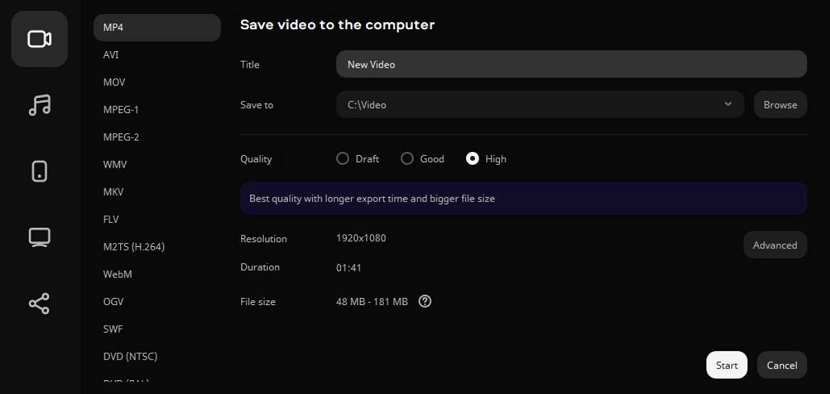
Additional tips
Tips for creating organic transitions
Make videos with organic transitions that blend seamlessly with the style. Ensure each transition feels natural and relevant to the content. For instance, using a whimsical transition in a serious documentary can feel out of place. Similarly, overly complex transitions in a simple vlog can distract from the content.
Here are some essential tips to create effective transitions:
1. Ensure subtlety : Transitions should enhance the video's storytelling without drawing too much attention to themselves. Another important aspect is consistency; maintaining a uniform style of transitions throughout the video keeps a coherent narrative structure.
2. Avoid common mistakes : Don’t overuse transitions. While they can be effective storytelling tools, excessive use can make a video feel disjointed and confusing. Another mistake is not considering the audio aspect of transitions. Audio should always complement visuals for a seamless experience.
3. Use advanced techniques : For those looking to delve deeper, there are advanced techniques you can do in a video merger that involve using transitions for narrative purposes. This includes matching to the mood of the scene, using color and light to convey the time of the day, or employing motion to indicate movement or progression.
4. Optimize for different platforms : Different platforms, like YouTube or Instagram, often require different editing tricks and styles. For YouTube, longer transitions might be more acceptable, whereas Instagram stories might benefit from quicker, more dynamic transitions. Understanding the norms and expectations of each platform is key to effective video editing.
5. Be creative : Transitions offer a canvas for creativity. Experimenting with different types of transitions can lead to unique and compelling video. For example, a transition that mimics the opening of an eye can be used to reveal a new scene, adding a layer of creativity to the narrative.
6. Practice : The applications of effective video merging are vast, from vlogging and documentary filmmaking to marketing and educational content. Each field has its specific needs and stylistic approaches, making the video merging skill versatile and valuable.
Wrap up
Merging videos is a fundamental skill in video editing that not only allows you to put two videos together, but also offers endless creative possibilities. With the right software, techniques, and considerations, anyone can create impactful and engaging video content.
Remember to practice regularly and experiment with different approaches to find your unique style. As you continue to hone your skills, you will be able to seamlessly merge videos and create visually stunning content that captivates your audience.
If you found this article helpful, we encourage you to share it on your social media platforms—because sharing is caring! For more information about article submissions on our website, feel free to reach out to us via email.
Send an emailWritten by RGB Web Tech
Latest Technology Trends
Latest technology trends shaping the future, including AI advancements, blockchain innovation, 5G connectivity, IoT integration, and sustainable tech solutions. Explore breakthroughs in quantum computing, cybersecurity, augmented reality, and edge computing. Stay ahead with insights into transformative technologies driving innovation across industries and revolutionizing how we live, work, and connect.
AI in Digital Marketing – Tips and Best Practices
Last updated on January 19, 2025 by RGB Web Tech
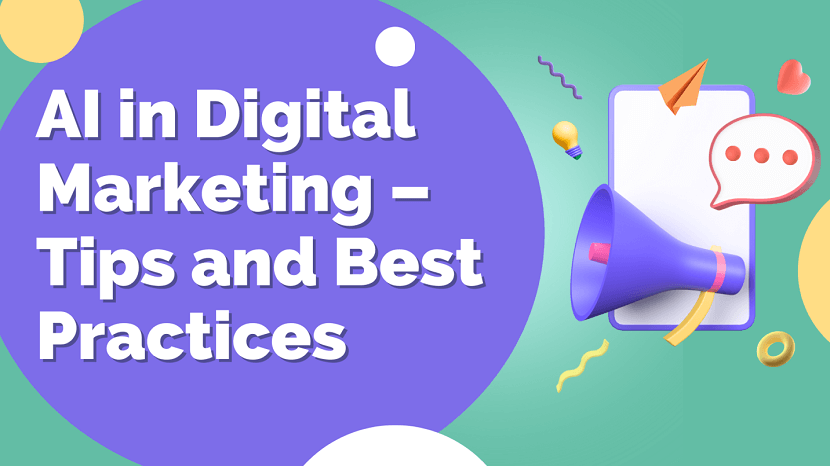
As is the case with many different fields, AI plays a helpful role in digital marketing. There are many different uses and applications of AI – which, when effectively employed, can improve the efficiency and efficacy of the whole process. This is all the more reason to study it in detail. Enroll in OdinSchool, whose digital marketing course syllabus is updated and industry-vetted

In this post, we’re going to start at the bottom and look at what digital marketing is and how AI can be utilized in it. We will discuss some examples of online AI software and their role in digital marketing. Then, we’ll wrap up by talking about the benefits of the same.
What is digital marketing?
Digital marketing is a fairly broad term. It brings into its ambit:
…all the marketing activities that are done via the Internet.
When a brand or its offerings are promoted or advertised via some channels across the Internet, the promotional/advertising activities are referred to as digital marketing.
There are many sub-types of digital marketing. Some of them are explained below:
How is AI used in digital marketing?
Now, let’s take a look at some of the ways in which AI is used in digital marketing. The following content will be helpful for you if you ever want to utilize it yourself in your own digital marketing endeavors.
It has to be mentioned that digital marketing is a very vast and expansive field. We have talked about three common sub-types above, but there are a lot more. Keeping that in mind, we won’t be able to cover everything that AI can be used for. Rather, we will stick to some of the main aspects.
1. AI can be used to create high-quality contenta
The first type of digital marketing that we discussed above is content marketing. We’re going to correspond with that and mention the first use of AI in terms of content.
Creating high-quality content is challenging – especially now that there is so much of it available on the Internet. You have to make an effort to make it stand out by making it authoritative, unique, original, credible, and easy to understand. With this type of content in hand, you can make your marketing successful.

We’re going to break down the process of creating written content (along with how the process is aided by AI).
This is how the entire writing process can be selectively and individually tackled with the help of AI. For people who want to entirely do the process with AI, there is that option available. For people who want to do it partially, those options are available as well.
These types of AI writing tools are usually available in the form of collective toolkits on the Internet. One such toolkit that you can find online is Editpad. On Editpad, there is a range of different AI tools that can aid you in the writing process.
2. AI can be used to automate and optimize email campaigns
One type of digital marketing that we discussed above was email marketing. We’re going to talk about an AI perk related to that now.
Emailing is a very effective digital marketing strategy. Many brands and businesses utilize it. The bigger a business gets, the more extensive its emailing campaign becomes. Large corporations and organizations may find themselves having to send thousands of emails in one day.

Now, in email marketing – just like any other digital marketing – content quality is very important. But that we’ve discussed in the heading above. Here, we are going to discuss a different element.
With the help of AI, the email-sending process can be scheduled and automated. This helps save a lot of time and effort – and it also saves the marketer(s) from the hassle of sending messages to each and every person individually.
3. AI can be used to automate SMM activity
The third and last type of marketing that we discussed above was SMM (social media marketing). Just as you can use AI for other types of digital marketing, you can also use it for SMM.
Social Media Marketing (SMM) on social media in the form of posts, etc. This process, i.e., of creating and publishing content, can be time-consuming.

Plus, depending on the schedule of your SMM strategy, you may have to post content at some strange hour – which would require you to be up and active at said hour.
With AI, all of this becomes a whole lot easier. You can simply automate the whole publishing process. This allows you to create the posts at any time that suits you. Then, you can simply automate it to be published at the most opportune time.
Final Thoughts
AI can play a very helpful role in digital marketing. It can help out in different ways in the many different sub-types of digital marketing, such as SMM, email marketing, and so on.
We’ve talked about some of the ways in which you can apply AI in your digital marketing campaigns. You can save a lot of effort and time by doing so.
If you found this article helpful, we encourage you to share it on your social media platforms—because sharing is caring! For more information about article submissions on our website, feel free to reach out to us via email.
Send an emailWritten by RGB Web Tech
Latest Technology Trends
Latest technology trends shaping the future, including AI advancements, blockchain innovation, 5G connectivity, IoT integration, and sustainable tech solutions. Explore breakthroughs in quantum computing, cybersecurity, augmented reality, and edge computing. Stay ahead with insights into transformative technologies driving innovation across industries and revolutionizing how we live, work, and connect.
3 Best AI Content Detection Tools
Last updated on January 19, 2025 by RGB Web Tech

As the AI Content Generator tools are fast, efficient in creative writing and never get tired or run out of ideas, people started relying on these tools to enhance their working productivity.
Although the benefits of such tools are undeniable, the AI-generated content may contain wrong facts, repetitious statements, emphasis on quantity over quality etc that ultimately ruin web ranking and pose ethical concerns.
To combat this issue, AI content detector tools have been invented so that writers, students, educators etc. would know the worth of the content they are using or delivering.
These tools operate on advanced NLP and ML algorithms to identify human-writing patterns, sentence structuring, etc to conclude whether or not the provided text is AI-written.
This article contains the 03 top most-trusted, widely-used and highest accuracy bearing tools for effortless identification of AI and Human-written content.
Best AI Content Detection Tools
Contentdetector.org
Contentdetector.org is a well-known AI tool that can efficiently detect whether or not the content is human-written or AI-generated.
The tool utilizes various NLP and AI techniques to identify the patterns, and style and to count the probability score of each of the provided words to predict the chances of the text being automated or manually written.
As a result, the content detector will highlight the AI content as red and human-written as green. The tool is proficient in identifying the text generated by the Chatgpt, Rytr.me, Paraphrasingtool.ai, and Jasper.ai tools.
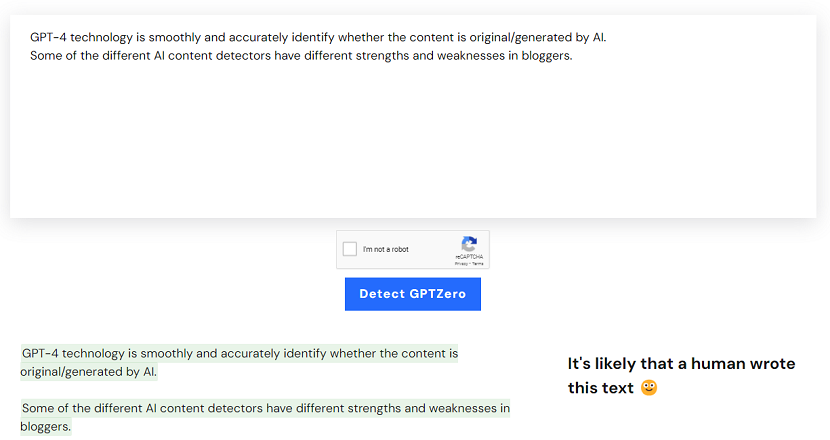
How AI Content Detector Tool Works?
It operates on the following 03 AI techniques to detect the AI content with a high level of accuracy:
Pricing:
Contentdetector.org is completely free for unlimited use. It features the easiest-to-use interface and doesn’t require any expertise to use it.
Pros:
Cons:
AI Text Detector by Paraphrasingtool.ai
AI Text Detector by Paraphrasingtool.ai is another authentic tool for predicting AI or human written content.
It features the most advanced GPT-4 technology that can effortlessly and accurately differentiate between the original and AI-generated content.
The tool is absolutely free and an efficient alternative to Originality.ai and Gptzero. It is proficient in identifying the text generated by large language models such as NLP and ML tools.
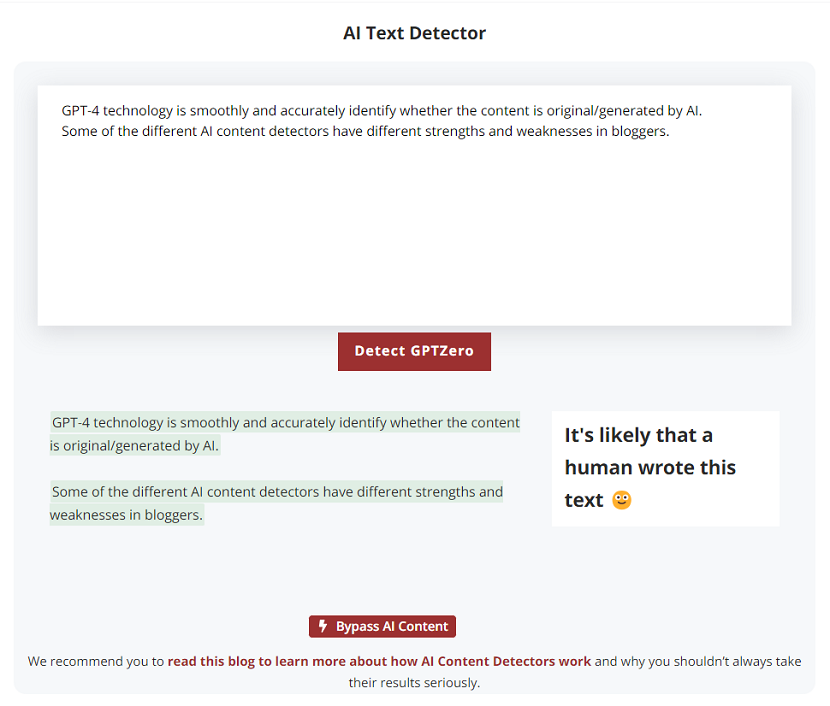
Pricing:
The tool is free for detecting AI content. However, the user is required to sign up when they are using it for the first time. The rest of the layout or the process of checking the content for AI is the simplest and easiest.
Pros:
Cons:
AI Content Detector by Copyleaks
AI content detector by Copyleaks is a well-reputed and trusted AI tool for detecting text generated by artificial intelligence tools.
It is proficient in identifying human writing patterns (by analyzing the trillions of samples of creative writing done by humans).
The tool can efficiently recognize the text created or rephrased by Chatgpt and Bard, two of the most widely used AI content generator tools.
As claimed by the tool, it has tested over 20K human-written papers and the total of false positives was less than 0.2% showing the tool’s efficiency in predicting the original content accurately.
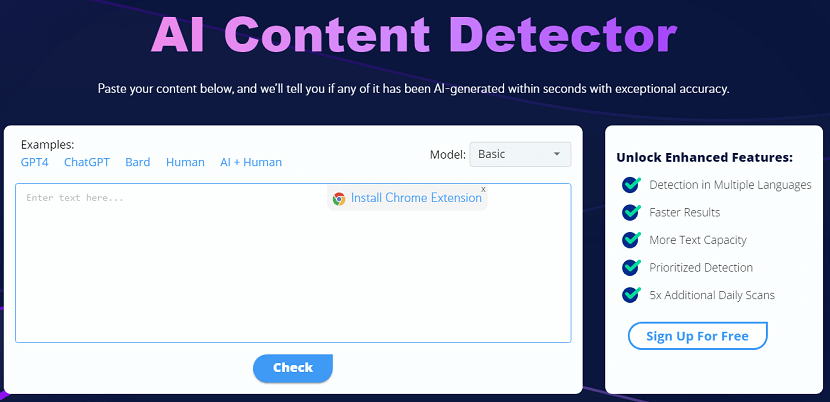
Pricing:
Although the tool is available for free. However, there is a limitation in terms of the availability of features. It offers a monthly ($8.33) plan that includes the following benefits:
Pros:
Cons:
A Brief Comparison of the 03 Best AI Content Detector Tools in 2024
| Features | Contentdetector.org | AI Content Detector by Paraphrasingtool.ai | AI Content Detector by Copyleaks |
|---|---|---|---|
| User-Friendly and Free-to-Use | ✔ | ✔ | ✔ |
| Accurate and Efficient | ✔ | ✔ | ✔ |
| Multilingual | ✖ | ✖ | ✔ |
| Free of cost | ✔ | ✔ | ✔ |
Summary
The three of the above-mentioned content detector tools are among the most popular, accurate and reliable ones for differentiating between human-written and AI-generated content.
Being more advanced, fast and accurate, Contentdetector.org is at the top of the list. It can process unlimited words for detecting AI text at no cost and in the blink of an eye.
Secondly, the AI content detector by paraphrasingtool.ai is free, features a user-friendly interface and is well-known for its accuracy and efficiency.
Lastly, the AI content detector by Copyleaks is also an accurate, multilingual and fast tool to catch AI-generated content.
Long story short, all are affordable, reliable and accurate tools recommended for content writers, social media marketers, bloggers, students and educators.
If you found this article helpful, we encourage you to share it on your social media platforms—because sharing is caring! For more information about article submissions on our website, feel free to reach out to us via email.
Send an emailWritten by RGB Web Tech
Latest Technology Trends
Latest technology trends shaping the future, including AI advancements, blockchain innovation, 5G connectivity, IoT integration, and sustainable tech solutions. Explore breakthroughs in quantum computing, cybersecurity, augmented reality, and edge computing. Stay ahead with insights into transformative technologies driving innovation across industries and revolutionizing how we live, work, and connect.
Humbot Review: The Premier AI Essay Detector Bypasser
Last updated on January 19, 2025 by RGB Web Tech

Plagiarism has long been a contentious issue in the academic world. Every year, countless students are caught submitting essays that are not entirely their own work, resulting in severe consequences such as failing grades or even expulsion from educational institutions. To combat this problem, many professors and educational organizations have deployed advanced AI essay detectors to identify instances of plagiarism. However, as technology advances, so does the ability to bypass these detection systems.
In this review, we will explore a groundbreaking solution called Humbot, which claims to be the premier AI essay detector bypasser. We will discuss its features, benefits, and limitations, and evaluate its effectiveness in addressing the concerns surrounding plagiarism AI detection.
Humbot Features and Functionality
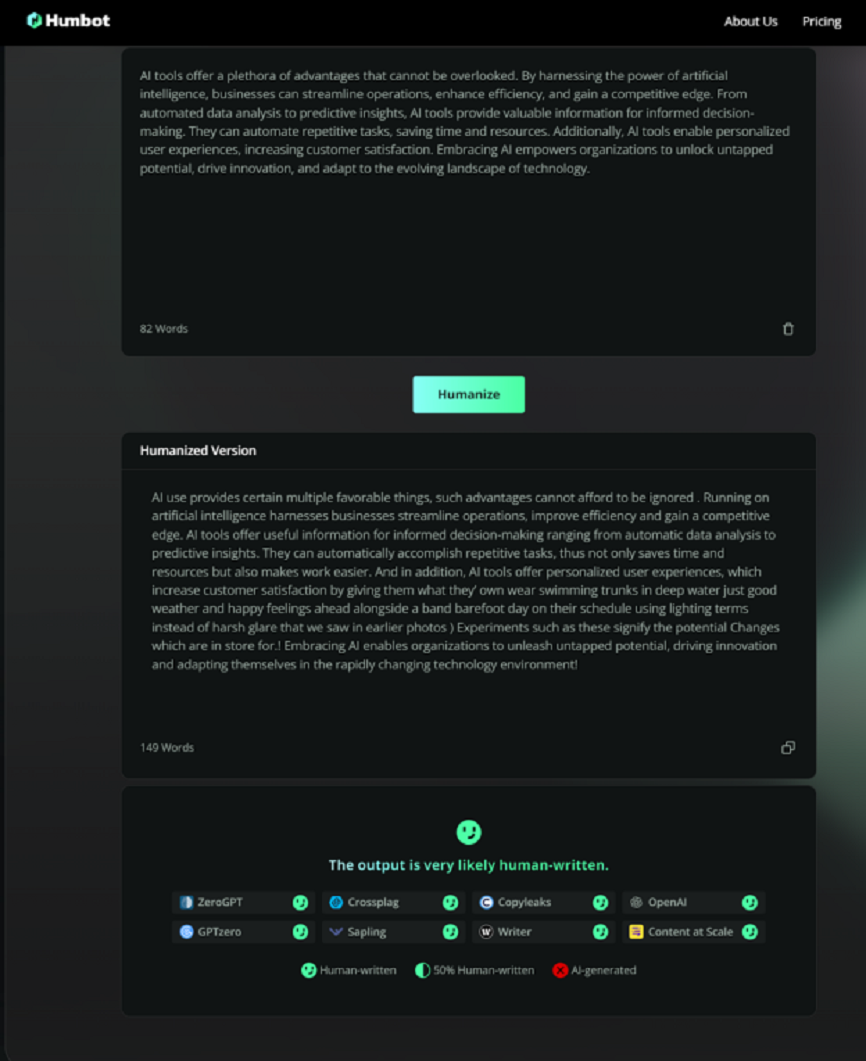
Humbot sets itself apart by offering a sophisticated AI algorithm that aims to outsmart existing essay detection systems. This tool works by leveraging advanced machine learning techniques to paraphrase and restructure original content while maintaining the essence of the message. The idea behind this approach is to disguise the plagiarized content to the point where it becomes undetectable by conventional essay detectors.
The creators of Humbot promote its user-friendly interface, which allows users to effortlessly upload their essays and receive a bypassed version within minutes. With its cloud-based architecture, the tool can handle large volumes of essays simultaneously, making it suitable for both individual users and educational institutions. Additionally, Humbot claims to support multiple languages, broadening its application to various academic disciplines and regions.
The Benefits of Humbot

One of the primary advantages touted by Humbot is its ability to protect students from the dire consequences of accidental plagiarism. It is not uncommon for students to unintentionally include content that resembles existing works. With the help of Humbot, students can ensure their essays undergo a process that reduces the risk of false accusations and penalties. By employing AI technology, Humbot aims to strike a balance between academic integrity and the potential for human error.
Another benefit is the potential for Humbot to encourage critical thinking and originality. By offering an alternative to traditional essay writing, this tool enables students to focus more on the generation of unique ideas rather than simply paraphrasing existing ones. By bypassing detection, Humbot allows students to express their thoughts and arguments freely without constant fear of plagiarism accusations.
Additionally, you may find a comprehensive review of Humbot at this link.
The Limitations of Humbot
While Humbot presents promising features and benefits, it is crucial to acknowledge its limitations. One major concern is the ethical implications of using such a tool to evade plagiarism detection mechanisms. It is essential to recognize that submitting work that is not entirely one's own is academically dishonest and undermines the principles of integrity and personal growth that education seeks to uphold.
Furthermore, there is no guarantee that Humbot is foolproof. As AI essay detection systems continue to evolve, it is possible that they will adapt and become more resilient to bypassing techniques like those employed by Humbot. This raises the question of whether relying on such tools is a sustainable long-term solution or merely a temporary workaround.
Conclusion
Humbot undoubtedly offers a unique solution to the issue of plagiarism detection in academia. By leveraging advanced AI algorithms, it claims to bypass existing essay detection systems, potentially protecting students from the consequences of accidental plagiarism and fostering originality. However, it is crucial for students and educators to consider the ethical implications of utilizing such tools. Additionally, the longevity of Humbot's effectiveness remains uncertain as essay detection systems continue to improve.
As we navigate the ever-evolving landscape of technology, it is essential to realize that tools like Humbot should not replace personal integrity and the values of originality and critical thinking. While it may be convenient to bypass detection systems, the ultimate goal of education should be to nurture ethical behavior and inspire independent thought. As students and educators, we must reflect on the broader implications and consequences of relying on AI-driven bypassing tools like Humbot.
If you found this article helpful, we encourage you to share it on your social media platforms—because sharing is caring! For more information about article submissions on our website, feel free to reach out to us via email.
Send an emailWritten by RGB Web Tech
Latest Technology Trends
Latest technology trends shaping the future, including AI advancements, blockchain innovation, 5G connectivity, IoT integration, and sustainable tech solutions. Explore breakthroughs in quantum computing, cybersecurity, augmented reality, and edge computing. Stay ahead with insights into transformative technologies driving innovation across industries and revolutionizing how we live, work, and connect.
What Challenges are Associated with Generative AI Testing: Unpacking the Complexity
Last updated on January 19, 2025 by RGB Web Tech

Generative AI represents a tremendous leap forward in the realm of software development and quality assurance, introducing the ability to create content, solve problems, and generate test cases autonomously. However, on the flip side, this advanced technology comes with a set of unique challenges when it comes to testing. Establishing a robust QA strategy with generative AI requires a keen understanding of its inherent complexities, as the technology's capacity to produce an infinite range of diverse outputs tests the limits of traditional testing frameworks.
The core difficulty in testing generative AI systems lies in the unpredictability of their output. Since these systems are designed to generate novel content, defining what constitutes a 'correct' or expected result can be elusive. This phenomenon, often referred to in the testing community as the Oracle Problem, is only the tip of the iceberg. Testers also need to grapple with scenarios where generative AI's versatility can lead to biased or ethically questionable outputs, demanding a meticulous approach to validation that goes beyond conventional methods.
Key Takeaways
Fundamentals of Generative AI Testing
Testing Generative AI (GenAI) systems requires an understanding of their unique characteristics, the methods that can be applied to test their functionality, and the role of data throughout the testing process. This ensures the quality assurance, reliability, and accuracy of the systems developed.
Distinctive Characteristics of GenAI Systems
Generative AI Development Services systems exhibit certain characteristics that set them apart from traditional software. These systems, based on advanced machine learning models such as transformers and generative adversarial networks (GANs), can produce highly creative and varied outputs, making standard test cases challenging to design. Unlike traditional software, GenAI systems lack a single correct answer or output, complicating the task of verifying their reliability.
Methods for Testing Generative AI
Developing novel testing approaches is essential as traditional testing techniques often fall short when applied to GenAI systems. In software engineering research, methods that adapt to the fluidity of generative outputs are being explored. For example, quality assurance teams may use synthetic data or transformers to craft test cases that can handle the unpredictable nature of AI-generated content. This approach ensures that tests are flexible yet stringent enough to assure system accuracy.
Importance of Data in AI Testing
Data privacy is paramount when testing GenAI systems, as they often require substantial amounts of data to learn and generate outputs. The use of synthetic data can help address privacy concerns, allowing for the creation of realistic test data without compromising sensitive information. In this context, the quality of the test data directly influences the effectiveness of the tests, ensuring the GenAI system operates as intended while upholding high standards of data privacy.
Key Challenges and Considerations
When testing generative AI (GenAI) systems, developers and quality assurance professionals grapple with several pressing issues, from ensuring consistent output quality to navigating a complex legal landscape.
Quality and Reliability Concerns
In the realm of GenAI systems, maintaining quality and reliability is paramount. For instance, the variability in outputs from tools like language models and chatbots presents unique challenges; the Oracle problem cited in software testing complicates the validation process, as there may not be straightforward correct answers against which to verify the output of GenAI.
Addressing Bias and Ethical Issues
Another critical issue is the potential for algorithmic bias, where models may inadvertently perpetuate prejudices present in their training data. It is crucial to strive for unbiased, representative datasets and to incorporate ethical considerations into the testing process to mitigate harmful outputs—a principle echoed in research on bias and fairness in GenAI.
Navigating the Evolving Landscape
The field of generative AI is a rapidly evolving domain, with continuous advancements in transformers and GANs (Generative Adversarial Networks). Keeping pace requires adapting quality assurance and testing strategies to new technologies and methods.
Tools and Techniques for Effective Testing
Effective testing requires leveraging a variety of tools and techniques. Test automation platforms, as found on sites like GitHub, and testing methods such as data-driven testing and scripted automation are integral to the software testing process. Selecting appropriate tools, like those for verifying authenticity to counter deep fakes, is critical.
Legal and Regulatory Implications
Lastly, legal and regulatory implications pose a challenge, especially with concerns around copyright, data privacy, and fraud prevention. It is evident that balancing innovation with compliance demands keen attention to legal safeguards and regulations applicable to content creation and distribution.
Conclusion
Generative AI systems present a complex landscape for testing due to their inherent unpredictability and the subjective nature of their outputs. They confront testers with the Oracle problem where definitive correct answers may not exist, complicating the validation process. It is essential to design innovative strategies incorporating diversity, adaptability, and thorough evaluation metrics to overcome these challenges. Effective testing ensures the reliability of generative AI systems while fostering trust in their integration into diverse sectors.
If you found this article helpful, we encourage you to share it on your social media platforms—because sharing is caring! For more information about article submissions on our website, feel free to reach out to us via email.
Send an emailWritten by RGB Web Tech
Latest Technology Trends
Latest technology trends shaping the future, including AI advancements, blockchain innovation, 5G connectivity, IoT integration, and sustainable tech solutions. Explore breakthroughs in quantum computing, cybersecurity, augmented reality, and edge computing. Stay ahead with insights into transformative technologies driving innovation across industries and revolutionizing how we live, work, and connect.
Without an SEO Checklist Your Google Ranking Will Fall. Read Why?
Last updated on January 19, 2025 by RGB Web Tech

Maintaining a strong internet presence is essential in the competitive world of online business.
Your Google ranking is critical to this success, since it is a measure that may make or break your online presence. To secure the success of your company, an SEO checklist is essential. Without it, your Google ranking would inevitably decline, resulting in missed chances and reduced online influence. In this article, we'll look at the key reasons why an SEO checklist is your passport to long-term success in the digital world.
Why is SEO Checklist Important?
Being prominent on Google's Search Engine Results Pages (SERP) is essential for success in the continuously changing world of online business. The process of optimising the visibility of your website necessitates a planned approach, and the SEO checklist is an essential tool in this endeavour.
An SEO checklist functions as a road map for achievement, providing a methodical framework that enables you to effectively manage the intricacies of digital marketing.
Blueprint for Success
Time-Saving and Focused Efforts
Process-Oriented Approach
Understanding the value of an SEO checklist is critical in the digital marketing scene. SEO, or search engine optimisation, is crucial for increasing a website's visibility and rating. An SEO checklist serves as a practical reference, covering important topics such as keyword optimisation and technical SEO.
As organisations strive to improve their online presence, an SEO checklist is quite useful. Working with an SEO agency like ours can take off your burden.
SEO and its relevance in digital marketing
SEO is more than just a technicality; it's a calculated strategy that helps you beat the competition and rank higher in search results. In this part, we'll look at the varied importance of SEO and digital marketing and how it helps to smart work, content optimization, keyword-centric ad campaigns, and general efficiency.

Smart Work and Competitive Edge
Optimising Content for Meaningful Information
Ad Campaigns Aligned with High-Ranking Keywords
Accelerating Processes
Quality Traffic Generation
Cost-Effective Marketing Strategy
Adaptation to Changing Algorithms
Data-Driven Decision Making
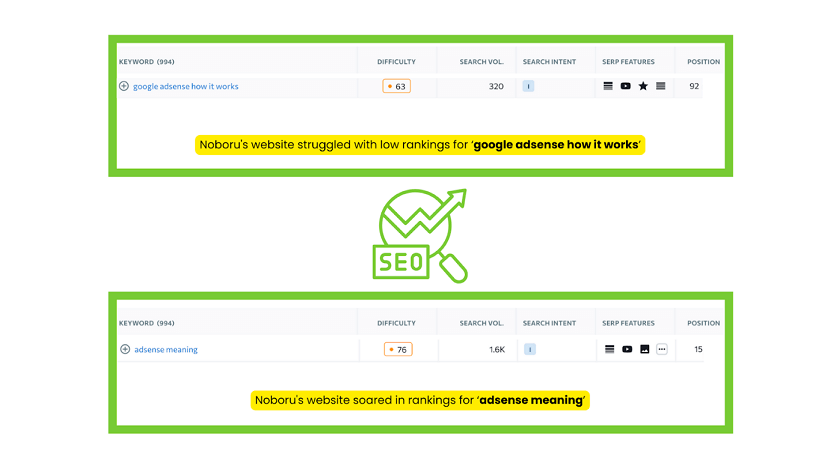
SEO plays a crucial role in digital marketing by optimizing content for specific keywords. In this case, the lower ranking for "Google AdSense how it works" suggests potential challenges in competitiveness or content optimization. Conversely, a higher ranking for "AdSense meaning" indicates effective SEO alignment with search intent, making the website more visible to users seeking a general understanding of AdSense. Strategic keyword targeting and content optimization, key aspects of SEO, contribute to improved visibility and performance in digital marketing efforts.
Complete SEO Checklist for 2024
The absence of a well-structured SEO checklist can have detrimental consequences for your website's ranking. Navigating the digital landscape without this essential guide leaves your online presence vulnerable to overlooked details and missed opportunities. In this section, we'll delve into the repercussions of not having an SEO checklist and how it impacts your ability to monitor and improve your Google ranking.
Ranking Goes Untraced
Inability to Chase Rankings
Income Stagnation Amid Decreased Growth
Data-Driven Insights
1. 90.63% of Web Pages Get No Organic Traffic from Google :
2. 75% of Users Never Scroll Past the First Page of Search Results :
3. 70-80% of Users Ignore Paid Ads and Focus on Organic Results:
4. Local Searches Lead 50% of Mobile Users to Visit Stores within One Day:
In conclusion, the data from Webfx.com highlights the vital role SEO plays in business success. Without a solid SEO strategy, businesses risk getting lost in digital noise, missing out on organic traffic, trust, and growth opportunities. Embracing SEO is not a choice but a necessity for thriving online. Stay ahead with the "Complete SEO Checklist for 2024" and consider expert guidance from Noboru at hello[at]noboruworld.com for a tailored SEO checklist. Take the leap towards digital success with Noboru's experience and insights.
If you found this article helpful, we encourage you to share it on your social media platforms—because sharing is caring! For more information about article submissions on our website, feel free to reach out to us via email.
Send an emailWritten by RGB Web Tech
Latest Technology Trends
Latest technology trends shaping the future, including AI advancements, blockchain innovation, 5G connectivity, IoT integration, and sustainable tech solutions. Explore breakthroughs in quantum computing, cybersecurity, augmented reality, and edge computing. Stay ahead with insights into transformative technologies driving innovation across industries and revolutionizing how we live, work, and connect.
The Role of Data Science in Business Intelligence and Decision-Making
Last updated on January 19, 2025 by RGB Web Tech

In today's data-driven era, the marriage of data science and business intelligence, bolstered by specialized training such as Data Scientist Certification, has become a cornerstone for organizations aiming to thrive in a competitive landscape. The seamless integration of these disciplines empowers businesses to extract meaningful insights from data, fostering informed decision-making and strategic planning. This convergence not only enhances the analytical capabilities of organizations but also positions them to navigate the complexities of the modern business environment with confidence. As businesses increasingly recognize the value of skilled professionals with a "Data Scientist Certification," the symbiotic relationship between data science and business intelligence is poised to shape the future of decision-making, providing a strategic edge to those who embrace the transformative possibilities of their data.
The Foundation: Data Science Unleashing Insights
At the core of modern business strategies lies the dynamic synergy between data science and business intelligence, with data science serving as the foundation that unleashes invaluable insights. This foundational role of data science is pivotal in transforming raw data into actionable knowledge, providing organizations with the analytical capabilities to navigate the complexities of the contemporary business landscape.
Data science, characterized by advanced analytics, machine learning, and statistical modeling, plays a crucial role in unraveling patterns and trends within vast datasets. It goes beyond the conventional methods of data analysis, delving deep into the intricacies of information to extract meaningful insights. By leveraging sophisticated algorithms, data scientists can distill complex data into comprehensible patterns, empowering organizations with a profound understanding of their operations and the factors influencing their performance.
The process begins with data collection, where diverse datasets from various sources are gathered. These datasets could include customer interactions, financial transactions, market trends, and more. Data scientists then employ their expertise to clean, preprocess, and analyze this data, uncovering hidden patterns that might elude traditional analytical approaches.
The power of data science lies in its ability to turn data into actionable insights. Through exploratory data analysis, predictive modeling, and other advanced techniques, data scientists can provide a comprehensive view of the business landscape. This includes identifying correlations, predicting future trends, and understanding the relationships between different variables. In essence, data science transforms data into a strategic asset that guides decision-making processes.
The foundational role of data science becomes particularly evident in predictive analytics. By leveraging historical data, organizations can anticipate future trends, customer behaviors, and market dynamics. Predictive models developed through data science allow businesses to make proactive decisions, adjust strategies in real time, and stay ahead of market shifts. This forward-looking approach is instrumental in achieving a competitive edge in industries where adaptability and foresight are paramount.
Business Intelligence: Transforming Raw Data into Actionable Insights
Business intelligence (BI) is the lens through which organizations make sense of the insights unearthed by data science. BI tools and platforms transform raw data into visually comprehensible reports, dashboards, and key performance indicators (KPIs). These intuitive representations empower decision-makers at all levels to grasp complex information swiftly, facilitating a more responsive and agile business environment.
The Raw Material
Before the transformation occurs, data science plays a fundamental role in unleashing the potential inherent in raw data. With sophisticated techniques such as advanced analytics, statistical modeling, and machine learning, data scientists delve into vast datasets to uncover patterns, trends, and correlations. This goes beyond traditional analysis, providing organizations with a profound understanding of their operations and the various factors influencing their performance.
Business Intelligence Tools
Armed with the insights extracted by data science, organizations then leverage Business Intelligence tools to translate complexity into clarity. These tools act as the bridge between raw data and actionable insights, offering intuitive dashboards, reports, and visualizations that transform complex datasets into comprehensible and actionable information.
Actionable Knowledge at Your Fingertips
BI tools empower decision-makers at all levels to access and comprehend complex information swiftly. With user-friendly interfaces, these tools allow users to interact with the data dynamically, drilling down into specific details or zooming out for a holistic view. Key Performance Indicators (KPIs), trends, and critical metrics are presented in a visually intuitive manner, enabling quick and informed decision-making.
Strategic Decision-Making Precision
One of the transformative aspects of BI is its impact on decision-making precision. Traditionally influenced by intuition and experience, decisions are now guided by evidence-based insights derived from data science. Whether it's identifying market trends, understanding customer behavior, or optimizing operational processes, BI ensures that decisions are grounded in data-driven analyses, reducing risks and increasing the likelihood of successful outcomes.
Enhanced Decision-Making
One of the most transformative aspects of data science in business intelligence is its impact on decision-making. Traditionally, decisions were often influenced by intuition and experience. However, data science injects precision into this process by providing evidence-based insights. Decision-makers can now rely on data-driven analyses, reducing risks, and increasing the likelihood of successful outcomes.
Predictive Analytics: Anticipating the Future
Data science's predictive capabilities amplify the foresight of business intelligence. By leveraging historical data and advanced modeling techniques, organizations can anticipate future trends, customer behaviors, and market shifts. Predictive analytics allows businesses to proactively adjust strategies, identify opportunities, and mitigate potential risks, giving them a competitive edge in dynamic markets.
Customer-Centric Approaches: Tailoring Experiences
In the realm of business intelligence, understanding customer behavior is paramount. Data science equips organizations with the tools to analyze customer preferences, purchasing patterns, and engagement metrics. This insight enables businesses to tailor their products, services, and marketing strategies, creating personalized and enriching experiences for their customers.
Operational Efficiency: Streamlining Processes
Data science not only guides strategic decisions but also enhances operational efficiency. Through the analysis of internal processes and workflows, organizations can identify bottlenecks, streamline operations, and optimize resource allocation. This operational intelligence contributes to cost savings, improved productivity, and a more agile response to market demands.
Challenges and Opportunities: Navigating the Data Landscape
While the integration of data science and business intelligence opens new doors, it also presents challenges. Data privacy, security, and the need for skilled professionals are among the hurdles organizations face. However, these challenges also represent opportunities for growth, innovation, and differentiation in an increasingly data-centric business environment.
Conclusion: A Synergistic Future
In conclusion, the symbiotic relationship between data science and business intelligence has ushered in a new era of strategic decision-making. As organizations harness the power of data to gain insights, optimize operations, and understand their customers, the synergy between these disciplines becomes a driving force for innovation and success. The future of business intelligence is inherently intertwined with the continuous evolution of data science, promising a dynamic and insightful journey for organizations ready to embrace the transformative possibilities of their data.
If you found this article helpful, we encourage you to share it on your social media platforms—because sharing is caring! For more information about article submissions on our website, feel free to reach out to us via email.
Send an emailWritten by RGB Web Tech
Latest Technology Trends
Latest technology trends shaping the future, including AI advancements, blockchain innovation, 5G connectivity, IoT integration, and sustainable tech solutions. Explore breakthroughs in quantum computing, cybersecurity, augmented reality, and edge computing. Stay ahead with insights into transformative technologies driving innovation across industries and revolutionizing how we live, work, and connect.
Navigating the Data Revolution: The Role of Snowflake Optimization in Business Success
Last updated on January 19, 2025 by RGB Web Tech

Data has emerged as the new cornerstone of business success in the ever-evolving digital era. Amidst this data revolution, Snowflake, a cloud data platform, has become a necessary tool for businesses aiming to harness the power of data.Snowflake optimization stands at the forefront of this transformation, offering a pathway to streamline data processes and unlock new avenues of business growth and innovation.
1. Enhanced Data Storage and Accessibility
The first critical aspect of the optimization of Snowflake is its ability to revolutionize data storage and accessibility. Traditional data storage methods often lead to siloed and inaccessible data, hindering efficient decision-making. Snowflake's unique architecture allows for centralized storage, eliminating data silos. This optimization ensures that all relevant data is readily available to stakeholders, facilitating more informed decision-making and strategy development.
2. Real-time Data Processing and Analysis
In the world of instant gratification, real-time data processing is no longer a luxury but a necessity. Optimizing Snowflake caters to this need by enabling multiple companies to process and analyze data in real-time. This capability is crucial for organizations that rely on timely data to make critical decisions. The agility afforded by real-time processing allows businesses to stay ahead of the newest market trends and respond swiftly to customer needs.
3. Scalability and Cost-Effectiveness
Another significant advantage of Snowflake optimization is its scalability. As businesses grow, their data needs evolve. Snowflake's cloud-based platform scales effortlessly to meet these changing demands without requiring substantial upfront investments in infrastructure. This scalability supports business growth and ensures cost-effectiveness, as companies pay only for the resources they use.
Moreover, Snowflake's unique architecture allows for rapid scaling, both vertically and horizontally, providing flexibility during fluctuating workloads. This adaptability is crucial for businesses facing seasonal trends or unexpected spikes in data usage, ensuring uninterrupted access and performance without the need for manual adjustments or over-provisioning of resources.
4. Enhanced Security and Compliance
Data security and compliance are highly significant in today's digital landscape. Optimizing Snowflake addresses these concerns by providing robust security features, including automatic encryption and advanced access controls. Furthermore, it aids businesses in maintaining compliance with various data protection regulations. This security and compliance assurance is essential for building customer trust and avoiding costly legal and reputational risks.
5. Data Democratization and Collaborative Opportunities
Optimization of Snowflake plays a vital role in democratizing data within organizations. Breaking down technical barriers allows individuals across various departments to access and interpret data. Such democratization fosters a culture of collaboration and innovation, as diverse perspectives lead to more comprehensive insights and creative solutions.
Optimization of Snowflake democratizes data access and empowers employees with varying degrees of technical expertise to engage with data analytics. This inclusivity enhances decision-making processes at all organizational levels, as it integrates insights from a broader range of sources, enriching the overall data narrative and driving more effective business strategies.
6. Advanced Analytics and Machine Learning Integration
Finally, integrating advanced analytics and machine learning represents a frontier in optimizing Snowflake. By harnessing these technologies, businesses can uncover deeper insights, predict trends, and personalize customer experiences. This integration transforms raw data into a strategic asset, driving innovation and competitive advantage.
Conclusion
Snowflake optimization is not just an enhancement of data management practices; it's a strategic imperative in the data-driven business world. Its ability to provide real-time insights, scalability, enhanced security, data democratization, and advanced analytics integration positions businesses to steer the complexities of the digital age successfully. As companies grapple with huge amounts of data, the optimization of Snowflake emerges as a crucial ally in turning data challenges into business opportunities. Embracing this revolution is not just about staying relevant; it's about leading the charge in a data-centric future.
If you found this article helpful, we encourage you to share it on your social media platforms—because sharing is caring! For more information about article submissions on our website, feel free to reach out to us via email.
Send an emailWritten by RGB Web Tech
Latest Technology Trends
Latest technology trends shaping the future, including AI advancements, blockchain innovation, 5G connectivity, IoT integration, and sustainable tech solutions. Explore breakthroughs in quantum computing, cybersecurity, augmented reality, and edge computing. Stay ahead with insights into transformative technologies driving innovation across industries and revolutionizing how we live, work, and connect.
3 Helpful AI Tools for Teachers and Educators
Last updated on January 19, 2025 by RGB Web Tech

When we talk about online AI tools, we often think of them as being useful for students writers, etc. But just as they are useful to these types of people, they are also helpful to teachers and educators.
There are many tasks that teachers and educators have to perform on a daily basis that can be time-consuming to do manually. They can be anything, from lesson preparation to test marketing. To get help for these tasks, online tools can be used.
In this post, we’re going to be looking at some AI tools that can be helpful for educators and teachers. Let’s dive right in.
1. Grammarcheck.ai
Checking for grammar issues is typically something that students are expected to do before they hand in their assignments. Checking for grammar and spelling errors can be done manually, but online tools make it a lot easier.
But, apart from students, using grammar checkers can also be very helpful for teachers and educators. For example,
Considering these types of uses, the first tool that we’re mentioning on our list is Grammarcheck.ai.

As the name indicates, Grammarcheck.ai is an online grammar checker tool. It has a simple functionality. You can enter your text into it and start the checking process. Once the checking process is done, the errors and mistakes in the content are highlighted.
After the errors are pointed out, you can click on each of them one by one to see the correct suggestions. You can then apply those suggestions by giving them a click.
While the working is simple enough, there are some perks and features that make this tool excellent to use. We will list some of those before moving on to the next one.
Features of Grammarcheck.ai
2. Imagetotext.info
There can be many different situations where teachers and educators may face the need to extract written text from an image. For example, they may want to take an image of their physical lecture notes and provide them to the students in digital form. Or, they may want to convert an assignment in image form to normal text, etc.
To address these types of needs and requirements, the next tool that we’re mentioning on our list is Imagetotext.info.
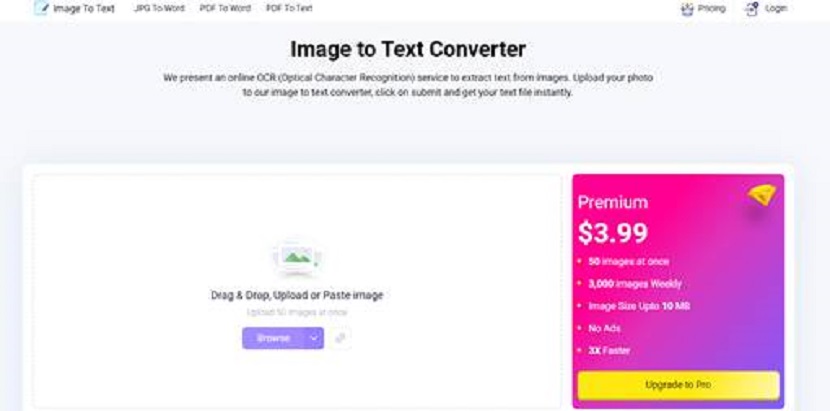
Imagetotext.info is an online OCR tool. It serves the purpose of converting an image into text. In other words, if there is an image that contains written text, the tool extracts it and presents it in a simple text form.
It provides a number of different features. One of the most remarkable features of this tool is that it can process multiple images at once. It can be a bit of a hassle to enter an image, get the text, copy it, and then move on to the next one. With this particular tool,, you don’t have to worry about that. You can simply enter images in bulk and get their results collectively.
There are, of course, other features that this tool provides that make it a good choice to use. We’re going to mention them next.
Features of Imagetotext.info
3. Plagiarism Checker by Editpad
Plagiarism checkers are perhaps one of the most useful online tools that teachers and educators can need. These tools help them check for plagiarism in the work submitted by students. Checking for plagiarism manually is not possible, which is why using tools is necessary.
Keeping that in mind, the third and last tool that we’re mentioning here on this list is the plagiarism checker by Editpad.
The plagiarism checker is made to analyze a piece of text and find out if it contains anything that already exists on the Internet. If there is any content that the tool finds to be already existing on an online source, it is pointed out as plagiarism in the input text.
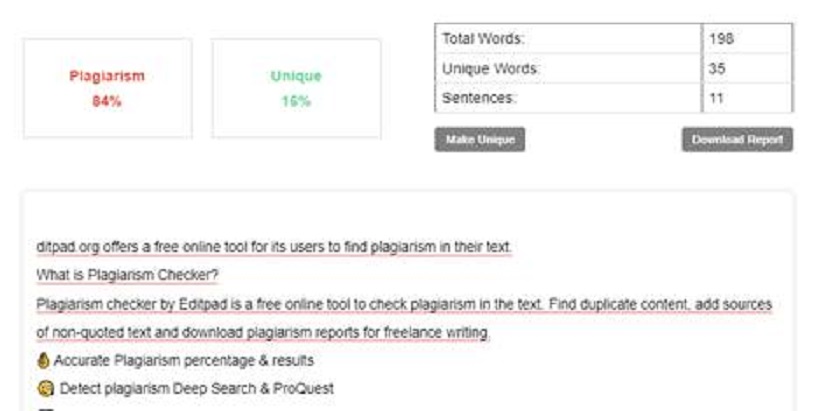
Once again, while the working is quite simple, there are some features that this tool provides that make it better than the rest. We are listing those below.
Features of the Plagiarism Checker by Editpad
Final Thoughts
While there are a lot of others as well, the AI tools that we’ve mentioned above are some of the ones that we think can be very helpful to teachers and educators. An online grammar checker has great uses for teachers, such as helping them quickly check their students’ work.
An online OCR tool can help teachers convert images to text, and share the text files with their class. Last but not least, an online plagiarism checker can help teachers determine the uniqueness of the write-ups submitted by their students.
If you found this article helpful, we encourage you to share it on your social media platforms—because sharing is caring! For more information about article submissions on our website, feel free to reach out to us via email.
Send an emailWritten by RGB Web Tech
Latest Technology Trends
Latest technology trends shaping the future, including AI advancements, blockchain innovation, 5G connectivity, IoT integration, and sustainable tech solutions. Explore breakthroughs in quantum computing, cybersecurity, augmented reality, and edge computing. Stay ahead with insights into transformative technologies driving innovation across industries and revolutionizing how we live, work, and connect.
Common Myths and Misconceptions About ITIL Debunked
Last updated on January 19, 2025 by RGB Web Tech
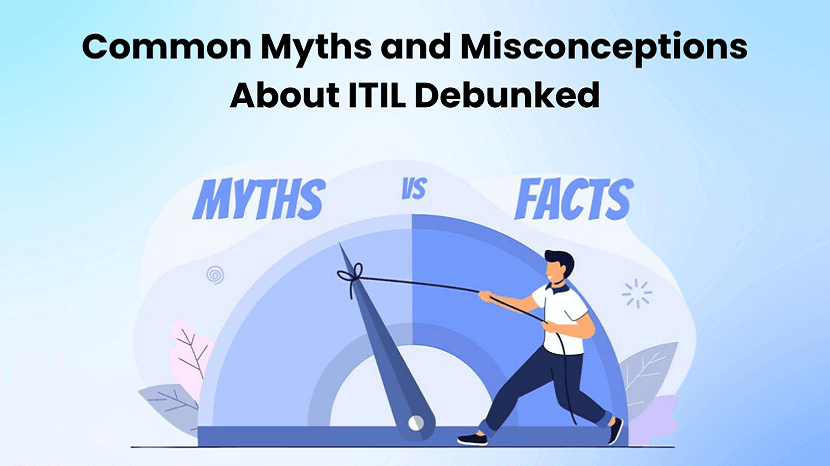
It's essential to keep ahead of the curve in information technology. Businesses worldwide use ITIL (Information Technology Infrastructure Library) to ensure effective service delivery and optimise operations. As more people think about pursuing an ITIL Certification, it's important to debunk some common misconceptions about this framework.
In this blog, we will examine What is ITIL,, debunk common myths about it, and help you distinguish reality from fiction.
Table of Contents
What is ITIL Certification?
Let's get the basics down before we start dispelling myths. Fundamentally, ITIL is a collection of procedures meant to match business requirements with IT services. What does ITIL certification mean now? It is a certification that attests to a person's competence in using ITIL procedures for service management. Everyone involved in IT service delivery can benefit from ITIL certification, which is sometimes misinterpreted and is not just for IT service managers.
Myth 1: ITIL is Only for Large Organisations
One widespread misunderstanding about ITIL is that it's only meant for big businesses. In actuality, ITIL is flexible and scalable. Thus, it can be used for any organisation of any size. ITIL practices can be used by small and medium-sized businesses (SMEs) to improve service delivery, guaranteeing effectiveness and client satisfaction. The concepts are adaptable and can be made to match the particular requirements of any organisation.
Myth 2: ITIL is Too Rigorous and Inflexible
Some people think that using ITIL requires following strict, unbending procedures. The main goal of ITIL is to provide a framework that can be customised to meet the unique needs of any company. It offers a collection of standards and recommended procedures, enabling adaptability in application. Efficiency gains are the aim, not the suppression of originality or creativity. ITIL is not a one-size-fits-all solution but a tool for improving service management.
Myth 3: ITIL is All About Documentation
A common misconception is that implementing ITIL entails becoming completely overwhelmed by paperwork. Although it plays a role in the process, documentation is not the primary objective. ITIL strongly emphasises finding a balance between implementation in practice and documentation. The secret is to record crucial procedures without adding needless red tape, making sure that the documentation helps, not hinders, overall service administration.
Myth 4: ITIL is Just a Buzzword; It Doesn't Deliver Results
Sceptics frequently write off ITIL as just another industrial term with no real advantages. Nonetheless, many case studies and success stories confirm the beneficial effects of implementing ITIL. Adopting ITIL techniques has yielded tangible benefits for enterprises in various areas, including enhanced customer satisfaction, cost savings, and efficiency. ITIL is a tried-and-true approach that yields measurable results, not simply an idea.
Myth 5: ITIL is Only for IT Professionals
Contrary to common assumption, ITIL is not exclusive to the IT division. Although it started as a collection of IT service management best practices, its ideas can be used by various departments inside a company. ITIL methods can be adopted by HR, finance, and customer service departments to improve their respective service delivery. ITIL is a comprehensive methodology that cuts beyond departmental lines.
Myth 6: ITIL is a One-Time Implementation
Some people believe that ITIL is a one-time undertaking with a limited scope. ITIL encourages a constant improvement mindset. The framework pushes businesses to conduct routine process reviews and improvements to keep up with evolving business requirements and technological breakthroughs. ITIL is a path toward continuous improvement and optimisation rather than a destination.
Myth 7: ITIL is Too Expensive
Organisations are frequently discouraged from pursuing ITIL deployment due to cost concerns. However, considering ITIL as a cost ignores its long-term advantages. The initial installation and training costs may exist, but the benefits can outweigh them in terms of increased customer happiness, efficiency, and service delivery. ITIL is an investment in a company's long-term viability and success.
Myth 8: ITIL Implementation Requires a Complete Overhaul
Another myth is that putting ITIL into practice requires a total reworking of current procedures. In actuality, ITIL promotes the thoughtful and progressive integration of its tenets. Organisations may gradually implement ITIL procedures, facilitating a more seamless transition and less interference with ongoing business activities. Instead of completely transforming everything at once, the goal should be to gradually move toward a service management strategy that is more effective and efficient.
Conclusion
In conclusion, for individuals who are thinking about adopting ITIL, it is important to debunk common misconceptions about it. Large companies or strict regulations are not the only uses for ITIL; it is a flexible, scalable framework that encourages continuous growth. As you work toward your ITIL certification, remember that it may be applied to different departments and concentrate on a well-rounded documentation strategy.
Don't let the upfront expenses stop you; consider ITIL as an investment that will pay off in the long run by improving customer satisfaction, efficiency, and service delivery. It involves establishing a culture of continuous improvement and revamping your company's service management. Remember these busted myths as you explore ITIL and clear the path for a more profitable, customer-focused, and efficient future.
If you found this article helpful, we encourage you to share it on your social media platforms—because sharing is caring! For more information about article submissions on our website, feel free to reach out to us via email.
Send an emailWritten by RGB Web Tech
Latest Technology Trends
Latest technology trends shaping the future, including AI advancements, blockchain innovation, 5G connectivity, IoT integration, and sustainable tech solutions. Explore breakthroughs in quantum computing, cybersecurity, augmented reality, and edge computing. Stay ahead with insights into transformative technologies driving innovation across industries and revolutionizing how we live, work, and connect.
Image SEO : How to Optimize Images for the Web
Last updated on January 19, 2025 by RGB Web Tech

Image SEO, or Search Engine Optimization, is the practice of optimizing images to enhance a website's visibility and ranking in search engine results pages (SERPs). It involves various strategies aimed at making images more accessible and understandable to search engine algorithms. This includes optimizing image filenames, alt text, captions, and descriptions with relevant keywords. Additionally, image size and format optimization, as well as proper use of structured data markup, contribute to better image SEO. Effective image SEO not only improves website visibility but also enhances user experience by providing visually appealing and relevant content in search results.
What is Image SEO?
Image SEO, or Image Search Engine Optimization, refers to the process of optimizing images on a website to improve their visibility and ranking in search engine results pages (SERPs). It involves various techniques and best practices aimed at making images more accessible, understandable, and relevant to search engine algorithms.
Image SEO Techniques
Image SEO encompasses various techniques to optimize images for search engines and enhance their visibility. Here are some effective techniques:
FAQs - Image SEO
Certainly! Here are some frequently asked questions (FAQs) about Image SEO:
1. What is Image SEO?
Answer : Image SEO, or Image Search Engine Optimization, refers to the process of optimizing images on a website to improve their visibility and ranking in search engine results pages (SERPs).
2. Why is Image SEO important?
Answer : Image SEO is important because it helps improve the visibility of images in search engine results, driving organic traffic to your website. It also enhances user experience by ensuring faster loading times and providing relevant image content.
3. What are some key elements of Image SEO?
Answer : Key elements of Image SEO include optimizing image file names, adding descriptive alt text, compressing images for faster loading times, choosing the right image format, and implementing structured data markup.
4. How do I optimize image file names for SEO?
Answer : Optimize image file names by using descriptive filenames that include relevant keywords related to the image content. Avoid generic filenames like "IMG_1234.jpg" and instead use descriptive names like "red-rose-bouquet.jpg."
5. What is alt text, and why is it important for Image SEO?
Answer : Alt text is a brief description of an image that is displayed when the image cannot be loaded or viewed. It is important for Image SEO because search engines use alt text to understand the context of images and improve accessibility for users with disabilities.
6. How can I improve the loading speed of images on my website?
Answer : You can improve the loading speed of images by compressing them without sacrificing quality, optimizing image size, choosing the right image format, and implementing responsive design techniques.
7. Should I use thumbnails on my website, and how can I optimize them for SEO?
Answer : Thumbnails can be useful for displaying images in a compact format, but they should be optimized for SEO. Use descriptive filenames and alt text for thumbnails, and ensure they are appropriately sized and compressed for faster loading times.
8. What role does structured data markup play in Image SEO?
Answer : Structured data markup provides search engines with additional information about the images on your website, such as the subject, location, or author. This helps search engines understand the image content better and may result in rich snippets displayed in search results.
Conclusion of Image SEO
In conclusion, Image SEO is a vital aspect of optimizing websites for search engines and enhancing user experience. By implementing techniques such as optimizing image file names, adding descriptive alt text, compressing images, and utilizing structured data markup, websites can improve the visibility and relevance of their images in search engine results. Image SEO not only drives organic traffic to websites but also ensures faster loading times and better accessibility for all users. By prioritizing image optimization alongside traditional SEO practices, website owners can create a more engaging and effective online presence, ultimately leading to increased visibility, traffic, and conversions.
If you found this article helpful, we encourage you to share it on your social media platforms—because sharing is caring! For more information about article submissions on our website, feel free to reach out to us via email.
Send an emailWritten by RGB Web Tech
Latest Technology Trends
Latest technology trends shaping the future, including AI advancements, blockchain innovation, 5G connectivity, IoT integration, and sustainable tech solutions. Explore breakthroughs in quantum computing, cybersecurity, augmented reality, and edge computing. Stay ahead with insights into transformative technologies driving innovation across industries and revolutionizing how we live, work, and connect.
Video for Search Engine Optimisation (SEO)
Last updated on January 19, 2025 by RGB Web Tech

Video SEO, or Search Engine Optimization, is the practice of optimizing video content to rank higher in search engine results pages (SERPs). With the proliferation of video content on platforms like YouTube, Vimeo, and social media, effective Video SEO has become crucial for businesses and content creators to increase visibility and drive organic traffic to their videos. It involves various strategies, including keyword research, optimizing video titles, descriptions, and tags, improving video quality and engagement metrics, as well as incorporating structured data markup. Successful Video SEO not only boosts search rankings but also enhances user experience, resulting in higher engagement and conversions.
What is Video SEO?
Video SEO, or Video Search Engine Optimization, refers to the process of optimizing video content to improve its visibility and ranking in search engine results pages (SERPs). It involves various techniques and strategies aimed at making videos more discoverable by search engines like Google, Bing, and YouTube.
Video SEO Techniques
Video SEO techniques are essential for maximizing the visibility and reach of your video content. Here are some effective techniques:
Frequently Asked Questions (FAQs) about Video SEO:
1. What is Video SEO?
Answer : Video SEO, or Video Search Engine Optimization, involves optimizing video content to improve its visibility and ranking in search engine results pages (SERPs).
2. Why is Video SEO important?
Answer : Video SEO helps increase the visibility of your video content, attract more viewers, and drive organic traffic to your website or channel. It can also enhance user engagement and conversions.
3. How do I optimize my videos for SEO?
Answer : To optimize your videos for SEO, focus on keyword research, optimizing metadata (titles, descriptions, tags), creating engaging thumbnails, providing transcriptions or closed captions, and promoting your videos across multiple channels.
4. Which platforms support Video SEO?
Answer : Video SEO techniques can be applied to various platforms, including YouTube, Vimeo, Facebook, Instagram, and your own website or blog.
5. What are the best practices for Video SEO?
Answer : Best practices for Video SEO include creating high-quality, relevant content, using descriptive titles and tags, optimizing video thumbnails, providing transcriptions, promoting your videos, and monitoring performance metrics.
6. How can I improve user engagement with my videos?
Answer : Encourage user engagement by asking viewers to like, comment, share, and subscribe to your channel. Respond to comments and engage with your audience to build a community around your videos.
7. Does video quality affect SEO?
Answer : While video quality itself may not directly impact SEO, high-quality videos tend to attract more viewers and engagement, which can indirectly improve SEO performance.
8. Is it important to include keywords in video titles and descriptions?
Answer : Yes, including relevant keywords in your video titles, descriptions, and tags helps search engines understand the content of your videos and improves their chances of ranking for relevant search queries.
9. How long should my videos be for optimal SEO?
Answer : The ideal video length depends on your content and audience preferences. However, aim to keep your videos informative, engaging, and concise, focusing on delivering value rather than meeting a specific length requirement.
10. How can I track the performance of my videos?
Answer : Use analytics tools such as YouTube Analytics, Google Analytics, or platform-specific insights to monitor metrics like views, watch time, audience retention, and conversion rates. Use this data to refine your Video SEO strategy over time.
Conclusion of Video SEO
In conclusion, Video SEO plays a pivotal role in enhancing the visibility and reach of video content across various platforms. By implementing strategic optimization techniques such as keyword research, metadata optimization, and user engagement tactics, businesses and content creators can improve their video rankings in search engine results pages (SERPs) and attract more organic traffic. Moreover, fostering user engagement and providing high-quality, relevant content are essential for sustaining audience interest and driving conversions. Continuously monitoring performance metrics and adapting strategies accordingly ensures the effectiveness of Video SEO efforts, ultimately leading to increased visibility, engagement, and success in the digital landscape.
If you found this article helpful, we encourage you to share it on your social media platforms—because sharing is caring! For more information about article submissions on our website, feel free to reach out to us via email.
Send an emailWritten by RGB Web Tech
Latest Technology Trends
Latest technology trends shaping the future, including AI advancements, blockchain innovation, 5G connectivity, IoT integration, and sustainable tech solutions. Explore breakthroughs in quantum computing, cybersecurity, augmented reality, and edge computing. Stay ahead with insights into transformative technologies driving innovation across industries and revolutionizing how we live, work, and connect.
Content that Converts: Leveraging Quality Writing in Digital Marketing Campaigns
Last updated on January 19, 2025 by RGB Web Tech

The heart of a good marketing campaign in this digital age beats through well-written content. Since there is so much information online now, standing out is more important and harder than ever. How, then, can good writing not only catch people's attention but also keep it? Let's go over how to use good writing in digital marketing efforts to make sure that your message not only gets to the right people, but also sticks with them.
Understanding the Power of Quality Content
Have you ever thought about what makes you stop looking through your feed on social media and read a post or article? The reason is that good content has a magnetic pull. Good writing is like a light; it draws people in with its clarity, usefulness, and interest. It's the difference between content that just tells you something and content that makes you want to read more and buy something.
1. Why Quality Writing Wins
When it comes to the internet, information is king. But not just any content—content that is well-written, based on solid study, and interesting to the emotions. This kind of material goes beyond the ordinary and turns readers into active participants. Building trust and credibility is important for making a link that is meaningful and sticks in people's minds.
2. The Impact on SEO
Good content and search engine optimization (SEO) go together like peanut butter and jelly. Search engines like Google give more weight to material that is useful, informative, and interesting to readers. Focusing on good writing will not only meet the needs of your readers but also make you more visible online. If you have good content, it will probably get backlinks, be shared on social media, and rank better in search engine results pages (SERPs), which will bring free traffic to your site.
Crafting Content that Converts
It's an art to make material that gets people to buy. You need to know your target well, have a clear message, and be able to start a conversation with your readers. Here are some ways to improve your writing and get people to buy from you.
1. Literature Review
In the vast ocean of digital content creation, the role of meticulous writing cannot be overstated. A literature review on the subject reveals a fascinating trend: individuals and businesses alike are increasingly seeking professional writing services to sharpen their digital presence. Amidst this landscape, the US dissertation writer service emerges as a beacon of excellence, offering unparalleled help to those embarking on the rigorous content creation journey. This service not only aids in elevating the quality of writing but also ensures that the message conveyed is clear, compelling, and accurately targeted. The demand for such specialized help underscores the critical nature of well-crafted content in achieving digital marketing objectives, highlighting the indispensable role of expert writing services in the contemporary content ecosystem.
2. Know Your Audience
Knowing your audience is the first step to making material that works. Just what do they want, need, and dislike? Customizing your content to address these issues adds a personal touch that can greatly boost interest and conversion rates.
3. Embrace a Conversational Tone
Short, stiff writing is a thing of the past. The internet audience of today wants realness and personality. A conversational tone makes your writing easier to understand and relate to, which makes people more likely to fully connect with your message.
4. Focus on Value, Not Just Selling
Even though the end goal may be to convert, focusing only on selling can be annoying. Instead, focus on giving something of worth. Give your readers answers to their questions, solutions, and information that will help them. This method not only builds trust, but it also makes your brand look like an expert in its area.
The Role of Headlines and CTAs
1. Crafting Compelling Headlines
Sometimes, your title is the only thing that can get people's attention. Be clear, interesting, and focused on the benefits to make it work. A catchy headline tells the reader that they will get something out of reading it, which makes them want to keep reading.
2. Effective Call-to-Actions (CTAs)
There needs to be a call to action for people to act on the information. It should be short, clear, and interesting, and it should tell people what to do next. It doesn't matter if the CTA is to sign up for a newsletter, download a guide, or buy something; it should fit with the meaning of the content and your marketing goals.
Measuring Success: Beyond Likes and Shares
Conversion rates are the best way to tell if content is successful, not how many likes, shares, or comments it gets. Tracking website traffic, lead generation, and sales data will help you figure out how well your content is doing. This information will not only show you how well your content is doing, but it will also help you plan better efforts in the future.
The Future of Content Marketing
It will only become more important for digital marketing efforts to have good writing in the future. As AI and machine learning get better, personalized and dynamic content will become the standard. This makes it more important than ever to write in a real, high-quality way.
Conclusion
When it comes to digital marketing, information that gets people to buy is king. Good writing can hook viewers, persuade them, and turn them into loyal customers. You can make content that not only does well in search engines but also connects with your audience by focusing on them, writing in a chatty style, and giving them something of value. Keep in mind that quality is the key to success and standing out in a world full of information.
If you found this article helpful, we encourage you to share it on your social media platforms—because sharing is caring! For more information about article submissions on our website, feel free to reach out to us via email.
Send an emailWritten by RGB Web Tech
Latest Technology Trends
Latest technology trends shaping the future, including AI advancements, blockchain innovation, 5G connectivity, IoT integration, and sustainable tech solutions. Explore breakthroughs in quantum computing, cybersecurity, augmented reality, and edge computing. Stay ahead with insights into transformative technologies driving innovation across industries and revolutionizing how we live, work, and connect.
What Should a Great Software Development Proposal Include
Last updated on January 19, 2025 by RGB Web Tech

Crafting a stellar software development proposal requires meticulous attention to not only showcase your technical capabilities but also to align with the prospective client’s needs. Before you even begin drafting, conducting thorough client discovery is crucial. This deep dive into the potential client's business helps tailor your proposal, ensuring it resonates with their unique challenges and goals. Then, with a comprehensive understanding of the client's background, you can move on to structure your proposal in a way that clearly outlines how your services will address their specific requirements.
A powerful software development proposal template can give you a head start, shaping your document into a persuasive, organized pitch. Your proposal should present a clear narrative, beginning with an executive summary that captures attention and highlights the value of your proposition. The main body should detail the project scope, timelines, budget, and any key technologies or methodologies you’ll employ. Good proposals frequently include visuals such as diagrams or charts to elucidate complex information, making the proposal not just informative but also engaging.
Key Takeaways
Proposal Structure and Content
Creating a comprehensive software development proposal necessitates clear structuring and detailed content that touch upon each crucial aspect of the project. This ensures that you fully understand what is being offered and the value it brings to your business.
1. Executive Summary
This section succinctly summarizes the entire proposal, outlining the primary goals, deliverables, and benefits that align with your needs. It will provide you with a compelling overview, capturing the essence of the proposed software solution and how it addresses your pain points.
2. Project Details
The project details give you a clear picture of the project name, project overview, and the full scope of work. The subsection thoroughly explains the features, deliverables, and project timeline, including key milestones, for a well-defined path forward.
3. Business and Technical Approaches
The focus here is on the methodology and transparency of the proposed technical solutions. You'll gain insight into how the development team plans to utilize specific programming languages, frameworks, and agile methodology to meet your project's requirements.
4. Pricing, Licensing, and Terms
A transparent breakdown of costs, budget, pricing, licensing, and payment terms is essential. You'll find clear information on terms and conditions, intellectual property rights, and confidentiality to ensure there are no surprises down the line.
5. Company Overview and Credentials
Get to know the company with an overview highlighting differentiators and competition. This part includes case studies, client testimonials, and the expertise of team members to build confidence in their ability to deliver.
6. Project Management and Follow-up
This segment outlines the project management processes and the implementation strategy post-deployment. It details the follow-up support to ensure that communication and any questions you may have are addressed throughout the project lifespan.
7. Proposed Solution and Benefits
Discover the tailored proposed solution along with a detailed explanation of how it will benefit your organization. It focuses on the differentiation from other market solutions and how it catively solves your specific challenges.
8. Additional Information and Appendices
Here you'll find detailed documentation, proposal templates that can be customized, and any additional information or responses to a request for proposal (RFP) that support the overall proposal.
9. Closing Statement
The proposal concludes with a call to action that encourages you to take the next step, whether it's setting up a meeting for further discussion or moving towards contract and signature.
Each of these subsections is strategically crafted to give you a full understanding of what the software development proposal seeks to accomplish and how it can transform your business operations.
Conclusion
Crafting a top-notch software development proposal is essential for showcasing your technical capabilities, understanding of client needs, and project management skills. Remember to articulate the scope of work, benefits to the client, and your unique strengths clearly. It's important to always end with a call to action to encourage the client towards the next step. Stick to these pillars, and your software proposal will stand out.
If you found this article helpful, we encourage you to share it on your social media platforms—because sharing is caring! For more information about article submissions on our website, feel free to reach out to us via email.
Send an emailWritten by RGB Web Tech
Latest Technology Trends
Latest technology trends shaping the future, including AI advancements, blockchain innovation, 5G connectivity, IoT integration, and sustainable tech solutions. Explore breakthroughs in quantum computing, cybersecurity, augmented reality, and edge computing. Stay ahead with insights into transformative technologies driving innovation across industries and revolutionizing how we live, work, and connect.
Why Social Media Followers are Important in this modern World
Last updated on January 19, 2025 by RGB Web Tech

In the day to day life Social media plays a very important part. It has several sites to change the way it connects. To share moments with friends and promote businesses. But social media followers are a secret gem that can be found among the pictures and status updates. Some people may not think these followers are very important, but the truth is that they are very useful for both people and companies. There are many possible ways to buy likes.
To buy instagram followers for making content and products for the audience, this will increase interest and loyalty in the long term.
Building Trust and Credibility
People who follow you on social media are important because they give you trust and respect. Imagine coming across a business page that doesn't have many followers. It's only reasonable to wonder if that business is real. A page with thousands or even millions of followers, on the other hand, quickly shows that it is trustworthy and real. Brands with a lot of followers on social media are more likely to get people to interact with and support them.
Increasing our influence and reach
People who follow you on social media act as brand spokespeople for you or your personal brand. Every fan you have is a possible supporter who can spread your word to more people. When people who follow you like, share, or comment on your posts, they automatically share your content with their own networks. This ripple effect can have a big effect, helping you get more followers and spread your power across more platforms.
Getting more traffic and sales
Followers on social media sites can do more than just make you more visible; they can also bring people to your website or online store. You can get people who are interested in your content to read more or buy something by sharing links to your website or blog posts.
Building community and engagement
Social media is about to make friends and gathering people together. There are real people behind your followers, not just numbers on a screen. A feeling of community can grow around your brand if you react to comments, ask questions, and start conversations. This kind of interaction not only improves relationships with followers who already follow you, but it also brings in new ones who are drawn to the sense of community and connection.
Getting Useful Information
Followers on social media can give you a lot of useful information that can help you make business and marketing choices. Looking at demographic information, participation measures, and audience feedback can help you learn more about the likes, dislikes, and problems of your target audience. To buy followers for making content and products for the audience, this will increase interest and loyalty in the long term.
Conclusion
Followers are very important to your online success and presence because they help build trust and confidence and make your reach and effect bigger. You can use the power of your social media followers to reach your goals and dreams if you build important relationships with them, give them value, and use their feedback to shape your strategies. No matter if you want to be a celebrity, a business, or a seasoned marketer, you should never forget how important it is to grow and care for your social media following.
If you found this article helpful, we encourage you to share it on your social media platforms—because sharing is caring! For more information about article submissions on our website, feel free to reach out to us via email.
Send an emailWritten by RGB Web Tech
Latest Technology Trends
Latest technology trends shaping the future, including AI advancements, blockchain innovation, 5G connectivity, IoT integration, and sustainable tech solutions. Explore breakthroughs in quantum computing, cybersecurity, augmented reality, and edge computing. Stay ahead with insights into transformative technologies driving innovation across industries and revolutionizing how we live, work, and connect.
10 Reasons to Invest in React App Development
Last updated on January 19, 2025 by RGB Web Tech

In today's dynamic business environment, the pursuit of effective customer engagement is a top priority. React, an acclaimed framework crafted by Facebook stands out as a leading choice for creating robust and interactive web applications. Renowned for its flexibility, speed, and developer-centric approach, React has become a staple in modern development workflows. This article outlines ten persuasive arguments supporting businesses' decision to invest in React for their app development endeavors.
1. Component-Based Architecture:
React's component-based architecture allows developers to break down complex UIs into smaller, reusable components. This modularity makes code easier to manage and facilitates collaboration among developers. With React, teams can work on different parts of an application simultaneously, leading to faster development cycles and reduced time-to-market.
2. Virtual DOM for Improved Performance:
React utilizes a virtual DOM (Document Object Model) to optimize rendering performance. Instead of re-rendering the entire DOM on every change, React updates only the necessary components, resulting in faster page load times and smoother user experiences. This efficiency is particularly beneficial for large-scale applications with dynamic content.
3. Declarative Programming:
React's declarative programming paradigm allows developers to describe the desired UI state, and React handles the rest. Unlike imperative programming, where developers have to specify each step to achieve a result, declarative programming simplifies code and makes it more predictable. This approach enhances code readability and reduces the likelihood of bugs, leading to higher-quality applications.
4. One-Way Data Binding:
React follows a unidirectional data flow, where data flows from parent components to child components. This one-way data binding ensures predictable data flow and makes it easier to debug and maintain code. Additionally, React's use of immutable data structures further enhances data consistency and prevents unexpected side effects.
5. Rich Ecosystem of Libraries and Tools:
React benefits from a vast ecosystem of libraries and tools that enhance its functionality and productivity. Popular libraries like Redux for state management, React Router for navigation, and Material-UI for pre-designed components streamline development processes and empower developers to build feature-rich applications efficiently.
6. Cross-Platform Compatibility:
With React Native, developers can leverage their React skills to build native mobile applications for iOS and Android platforms. React Native shares the same component-based architecture and development principles as React, allowing for code reuse across web and mobile platforms. This cross-platform compatibility reduces development costs and accelerates time-to-market for mobile apps.
7. Strong Community Support:
React boasts a large and active community of developers, contributors, and enthusiasts. This vibrant community continuously contributes to the framework's growth by sharing best practices, providing support through forums and communities, and developing useful tools and extensions. Businesses investing in React can tap into this wealth of knowledge and resources to accelerate their development efforts.
8. SEO-Friendly Applications:
Unlike traditional single-page applications (SPAs) that may face challenges with search engine optimization (SEO) due to limited content visibility, React enables server-side rendering (SSR) and pre-rendering capabilities. SSR ensures that search engines can crawl and index content effectively, improving the visibility and discoverability of React-based applications in search engine results pages (SERPs).
9. Scalability and Performance Optimization:
React's scalability and performance optimization features make it well-suited for building enterprise-grade applications. Techniques such as code splitting, lazy loading, and memoization allow developers to optimize bundle sizes, reduce initial load times, and improve overall application performance. These optimizations are crucial for delivering responsive and efficient user experiences, especially in high-traffic scenarios.
10. Continuous Updates and Improvements:
The React framework is actively maintained by Facebook and a dedicated team of developers. This ensures that React remains up-to-date with the latest web standards, browser capabilities, and industry trends. Regular updates and improvements enhance React's stability, security, and performance, providing businesses with a reliable and future-proof foundation for their applications.
Conclusion
In conclusion, investing in React app development offers numerous benefits for businesses looking to build modern, high-performing web and mobile applications. From its component-based architecture and virtual DOM optimization to its rich ecosystem of libraries and strong community support, React provides developers with the tools and resources they need to create scalable, efficient, and engaging digital experiences.
Moreover, integrating tools for Figma to React code generation has further streamlined the development process. Designers can seamlessly translate their Figma prototypes into React components, fostering collaboration between design and development teams and ensuring a consistent and pixel-perfect user interface. This integration enhances productivity and accelerates the iteration cycle, leading to faster time-to-market and better user satisfaction.
By embracing React and leveraging design to code generation tools, businesses can stay ahead of the competition, deliver exceptional user experiences, and drive growth in today's competitive digital landscape. The combination of React's robust capabilities and innovative tools empowers developers to build cutting-edge applications that meet the evolving needs of users and businesses alike.
If you found this article helpful, we encourage you to share it on your social media platforms—because sharing is caring! For more information about article submissions on our website, feel free to reach out to us via email.
Send an emailWritten by RGB Web Tech
Latest Technology Trends
Latest technology trends shaping the future, including AI advancements, blockchain innovation, 5G connectivity, IoT integration, and sustainable tech solutions. Explore breakthroughs in quantum computing, cybersecurity, augmented reality, and edge computing. Stay ahead with insights into transformative technologies driving innovation across industries and revolutionizing how we live, work, and connect.
Why are cloud device farms necessary for mobile application testing
Last updated on January 19, 2025 by RGB Web Tech

In the world of mobile app development, there's a big challenge: making sure the app works well on all kinds of devices and operating systems. According to Statista, in 2021, global mobile devices reached nearly 15 billion, and projections indicate a rise to 18.22 billion by 2025. With so many different devices out there, it's impossible to manually test the app on each one. Also, the expense associated with procuring, installing, and maintaining these devices is often beyond the means of many organizations.
As a result, testers find themselves making compromises on the extent of their testing, resulting in incomplete evaluations and subpar testing reports. This, in turn, contributes to the release of applications with inadequate performance. That's where the importance of mobile application testing comes in. With a reliable testing platform that offers a device farm with easy access to all kinds of mobile devices for testing across real-world conditions, companies can ensure the best possible digital experiences from their mobile apps.
What is a Device Farm?
A device farm refers to a testing environment that enables testing teams to assess the performance of their web apps, websites, and mobile apps on a wide array of real devices. It provides access to both current and older device models from various manufacturers. These device farms can be either managed internally or hosted on a cloud platform.
Establishing an internal device farm is often challenging due to the complexities involved, coupled with high maintenance and operational expenses. Setting up an in-house farm requires the team to have diverse devices installed and set up different browser versions and operating systems. Additionally, if they wish to conduct tests from various locations, arrangements for that must also be made. Therefore, it’s a prudent decision to opt for a cloud-based device farm.
What is a Device Cloud?
A device cloud is a testing environment with access to a collection of real devices that are stored in the cloud. These devices come with pre-installed operating systems and browsers.
While some device clouds offer emulators and simulators, those that provide access to real devices offer a significant advantage to testers. This setup allows them to observe how their creations perform in real-world conditions. Testers can interact with mobile devices just like regular users on a genuine desktop, tablet, or phone.
Testing on a real device cloud involves developers using and controlling actual devices to see how the user interface works on each one. This helps easily spot functional issues and missing elements. Additionally, it allows for assessing app performance by considering hardware factors like battery usage, CPU activity, network strength, and interruptions, like incoming texts or notifications from other apps. Device clouds empower testers to manually check how well apps and websites function from an end-user's perspective.
Why Should You Use a Cloud Device Farm?
They grant access to numerous real devices, eliminating the requirement to buy and maintain physical devices. With features like test automation, collaboration, and reporting, these tools multiply the efficiency and effectiveness of the testing process. A device farm typically gives the following features:
1. Device Management: The tool efficiently handles a variety of mobile devices, offering access to different types, operating system versions, and configurations. It takes care of device setup, configuration, and maintenance, letting testers and developers concentrate on testing.
2. Test Automation Framework: The device farm usually integrates with popular test automation platforms, enabling testers to create and execute automated tests on the devices.
3. Collaboration and Reporting: It provides collaboration features for testers and developers to work cohesively, share results, and discuss issues. Detailed reporting, including test outcomes, device logs, and screenshots, is also part of the package.
4. Security and Privacy: Device farms ensure the security and privacy of tested data and applications through secure data transfer, storage, and isolation.
5. Billing and Pricing: They offer a pricing model that allows customers to make payments based on device usage, either hourly or monthly, depending on their needs.
Overall, device farms present a cost-effective and scalable solution for testing mobile applications.
Benefits of a Cloud Device Farm
1. Improve Customer Experience: Gain the advantage of testing your applications on the exact devices and setups your customers use, ensuring a more realistic evaluation.
2. Debug issues faster: Quickly identify and address problems in your applications, leading to a more streamlined debugging process.
3. Real User Scenario Testing: Evaluate your applications under genuine user conditions like varying network conditions or low battery, allowing for more accurate testing and ensuring optimal performance in real-world scenarios.
4. Instant Device Accessibility: Instantly access a variety of devices for testing purposes, facilitating a more dynamic and comprehensive testing process.
5. Browser Compatibility Testing: Ensure your applications are compatible with the latest and older browser versions, guaranteeing a broader reach to users with diverse browser preferences.
6. Saves Time: Minimize the time testers spend waiting, leading to a more efficient testing cycle and faster progression in the development lifecycle.
7. Accelerated Time to Market: Speed up the overall development process, allowing your products or services to reach the market more swiftly and stay ahead of the competition.
8. Seamless Integration with Tools: Easily incorporate the device cloud into your existing bug tracking and management tools, ensuring a seamless and organized workflow for issue tracking and resolution.
Conclusion
In the dynamic landscape of mobile application development, ensuring seamless functionality across diverse devices and platforms is a formidable challenge. The traditional manual testing approach is not only impractical due to the multitude of devices but also poses financial constraints for many organizations.
The solution to these problems is reliable and secure cloud device farms like that of TestGrid. They provide a versatile testing environment that allows testing teams to evaluate the performance of their applications on an extensive range of real devices.
TestGrid's Private Device Cloud enables end-to-end AI and codeless automation, enhancing testing capabilities. Firewall-friendly and fully secure, it provides granular control over test environments, global teams, and sensitive data. The 24x7 access and device reservations ensure flexibility and continuity in testing, eliminating concerns about data deletion.
TestGrid provides a robust infrastructure for manual and automated testing on real devices, replicating the real-world user experience. Its scalability, security, and integration capabilities make it a cost-effective and efficient choice for organizations aiming to deliver high-performance mobile applications to a diverse user base.
If you found this article helpful, we encourage you to share it on your social media platforms—because sharing is caring! For more information about article submissions on our website, feel free to reach out to us via email.
Send an emailWritten by RGB Web Tech
Latest Technology Trends
Latest technology trends shaping the future, including AI advancements, blockchain innovation, 5G connectivity, IoT integration, and sustainable tech solutions. Explore breakthroughs in quantum computing, cybersecurity, augmented reality, and edge computing. Stay ahead with insights into transformative technologies driving innovation across industries and revolutionizing how we live, work, and connect.
Why Keeping Up with E-Commerce Trends Matters for Your Business Success
Last updated on January 19, 2025 by RGB Web Tech

Discover why staying informed about emerging e-commerce trends is vital for your business success. Explore future trends in e-commerce and learn how to leverage them to stay ahead of the competition and drive growth.
Modern trends in the B2B e-commerce
In modern B2B e-commerce, several trends are reshaping the landscape and transforming the way businesses buy and sell. Here are some of the key trends:
1. Artificial Intelligence (AI): AI is revolutionizing B2B e-commerce by offering predictive analytics, personalized recommendations, and intelligent automation. Businesses use AI-powered algorithms to analyze data, predict customer behavior, and optimize product recommendations, leading to more personalized and efficient transactions.
2. Progressive Web Apps (PWAs): PWAs combine the best features of websites and mobile apps, offering fast performance, offline capabilities, and an app-like user experience. B2B companies are increasingly adopting PWAs to provide seamless and engaging experiences to their customers, whether they're accessing the platform on desktop or mobile devices.
3. Chatbots: Chatbots are AI-powered virtual assistants that can interact with customers in real-time, providing support, answering questions, and guiding users through the buying process. B2B e-commerce platforms are integrating chatbots to offer personalized assistance, improve customer service, and streamline sales processes.
4. Voice and image search. Voice and image search technologies are gaining popularity in B2B e-commerce, enabling users to search for products using natural language commands or images. By integrating voice and image search capabilities, B2B platforms enhance usability and provide more intuitive ways for customers to find the products they need.
5. Flexible payment options: B2B buyers expect flexible payment options that align with their business needs and preferences. Modern B2B e-commerce platforms offer a variety of payment methods, including credit cards, digital wallets, purchase orders, and financing options. By providing flexible payment solutions, businesses can improve customer satisfaction and drive sales.
Implementing the latest trends in your online store
Implementing the latest trends in your online store can boost your business, but it's not something you can do alone. You need a skilled development team to make it happen. These experts know how to make your website look great and work smoothly on all devices. They'll also add cool features like interactive displays and easy checkout processes to make shopping easier and more fun for your customers.
By keeping up with the latest trends, you'll attract more attention to your store and keep customers coming back. Plus, you'll show that you're on top of your game, which builds trust with shoppers. So, while it might take some expertise to pull off, embracing trends can pay off for your online business.
In conclusion, keeping up with e-commerce trends isn't optional—it's essential for business success. By staying updated, you improve user experience, boost engagement, and foster customer loyalty. But it's not easy; it takes commitment and the right team. With the help of experts and a willingness to adapt, your business can thrive in the fast-paced world of online retail.
If you found this article helpful, we encourage you to share it on your social media platforms—because sharing is caring! For more information about article submissions on our website, feel free to reach out to us via email.
Send an emailWritten by RGB Web Tech
Latest Technology Trends
Latest technology trends shaping the future, including AI advancements, blockchain innovation, 5G connectivity, IoT integration, and sustainable tech solutions. Explore breakthroughs in quantum computing, cybersecurity, augmented reality, and edge computing. Stay ahead with insights into transformative technologies driving innovation across industries and revolutionizing how we live, work, and connect.
Why Terminal Emulators Are Key for Efficient Coding Practices
Last updated on January 19, 2025 by RGB Web Tech

Image Source: Pexels
Programming efficiency is improving all the time, and terminal emulators are particularly significant in this context since they ensure that coders can streamline their workflows, enhance multitasking, and implement automation effectively.
Moreover, they epitomize the shift from traditional graphical user interfaces (GUIs) to command-line interfaces (CLIs), which offer a more direct and scriptable control over software development tasks.
Let’s look at how these benefits are playing out, and why the future of efficient coding almost certainly lies in the lap of terminal emulators, rather than anywhere else.
The Multitasking Might of Terminal Emulators
Multitasking is not just about doing more things at once - it's about doing them effectively. Terminal emulators stand out by significantly enhancing the multitasking abilities of developers.
Here are a few ways these tools change the game:
For instance, terminal emulators like PuTTY allow programmers to manage remote sessions effortlessly while maintaining local command-line operations - a dual advantage crucial for efficient debugging and testing across different environments.
This matters because the issues of productivity and time management in a development context are tricky to get a handle on, and a McKinsey report found that while 70% of a coder’s day is usually dedicated to critical tasks associated with their role, the remaining 30% gets taken up by so-called ‘outer loop’ issues, including attending meetings and ensuring compliance with relevant regulations. If pros are able to make more of their available time, and spend less of it on unfulfilling duties, this is better for every stakeholder in a project.
The Significance of Script Automation
Another of the standout features of terminal emulators is their ability to automate repetitive tasks through scripting. Automation both speeds up the development process and also minimizes human error, leading to a more reliable coding practice.
Here’s how terminal emulators facilitate this:
We’re already seeing the focus on many coding projects being switched over to enabling increased business automation on a broader scale, so it’s not surprising that this is being applied on a micro level to the process of software development itself.
A Gartner study shows that API testing and integration testing make up the lion’s share of automation, being used by 56% and 45% of respondents respectively - and this will surely climb higher as terminal emulators take center stage.
Moreover, the integration of scripting in terminal emulators allows for customization according to individual or project-specific needs. Whether it's compiling reports, managing databases, or deploying code in popular languages, automation scripts crafted within terminal interfaces provide a tailored approach to enhance productivity and ensure consistency across projects.
Wrapping Up
As we’ve learned, terminal emulators are increasingly indispensable to the modern coding scene, with their ability to bolster multitasking capabilities and enable precise script automation consequently empowering developers to optimize their workflows and elevate productivity.
Whether it's PuTTY or another advanced interface, adopting a robust terminal emulator can significantly transform your coding efficiency - and moreover, if you aren’t at least dabbling with these tools, then you’re leaving a gap for competitors to squeeze into, which really shouldn’t be tolerated.
If you found this article helpful, we encourage you to share it on your social media platforms—because sharing is caring! For more information about article submissions on our website, feel free to reach out to us via email.
Send an emailWritten by RGB Web Tech
Latest Technology Trends
Latest technology trends shaping the future, including AI advancements, blockchain innovation, 5G connectivity, IoT integration, and sustainable tech solutions. Explore breakthroughs in quantum computing, cybersecurity, augmented reality, and edge computing. Stay ahead with insights into transformative technologies driving innovation across industries and revolutionizing how we live, work, and connect.
How Does Access Control Impact Your Websites Security?
Last updated on January 19, 2025 by RGB Web Tech

Image Source: Pexels
Think about the last time you updated your website's security measures - if access control wasn’t on your checklist, it should be in future. And while overlooking it might be forgivable because of how much else there is to encompass in order to protect your site, once you’ve learned about its potential impact, there’s no excuse for neglecting it again.
So to bring you up to speed, here’s a look at what part access control plays in keeping malicious actors at bay, and how this unfolds in day to day site operations.
Understanding the Basics of Access Control
Just as a carefully chosen lock prevents unauthorized entry into a building, access control restricts who can view or use your web resources. Here’s an overview of what makes it particularly crucial:
A report from Verizon found that around 17% of breaches involve internal actors, highlighting the necessity of robust access controls not just externally but also within organizations.
So in the same way that developers use KSPM solutions to secure their Kubernetes infrastructure, website administrators must implement strong access control mechanisms to safeguard their setups against unauthorized changes or viewing attempts. This strategic approach minimizes risks and preserves integrity across all levels of online engagement.
Implementing Advanced Access Control Features for Enhanced Security
There are tons of tools out there to ensure that access control is not a point of vulnerability in your site’s infrastructure. Here’s how they can make a substantial difference to the extent of its defenses:
A study from 2019 by Google found that MFA can eliminate all automated attacks against user accounts, while also fending off 76% of deliberately targeted breach attempts - and while the benefits are dropping off according to more recent data, there’s still no good reason for site owners to skip over this security measure.
Each additional security layer acts as another hurdle for potential attackers, making unauthorized entry exponentially more difficult - and also being a proactive way of showing users that you really care about keeping them safe.
The Bottom Line
A website without access control is like a house with its front door left unlocked and thrown open so the whole world can see inside.
So if yours is lacking in this area, or doesn’t have the features and functions offered by the latest tools, then you need to act immediately to avert a laundry list of potential disasters.
If you found this article helpful, we encourage you to share it on your social media platforms—because sharing is caring! For more information about article submissions on our website, feel free to reach out to us via email.
Send an emailWritten by RGB Web Tech
Latest Technology Trends
Latest technology trends shaping the future, including AI advancements, blockchain innovation, 5G connectivity, IoT integration, and sustainable tech solutions. Explore breakthroughs in quantum computing, cybersecurity, augmented reality, and edge computing. Stay ahead with insights into transformative technologies driving innovation across industries and revolutionizing how we live, work, and connect.
Domains vs Hosting vs Website: Understanding the Difference
Last updated on January 19, 2025 by RGB Web Tech

In today's digital age, online presence is crucial for individuals and businesses. However, many people need clarification about the differences between domains, hosting, and websites. This article will explore the definitions, explanations, and importance of each and how they work together. Additionally, we will discuss the benefits of using a managed WordPress hosting plan to streamline your online presence.
While often used interchangeably, these terms have distinct meanings and functions. Understanding the differences between them is essential for creating a robust online presence, and in this article, we will delve into the definitions, explanations, and importance of each.
Let's consider an example to illustrate the difference, using Elementor, a famous website builder:
For example, you want to create a website for your handmade crafts business using Elementor. You would:
Understanding the differences between these three elements is crucial for creating a strong online presence. In the following sections, we will explore each in more detail, highlighting their importance and how they work together to form the foundation of your digital identity.
Domains vs Hosting vs Website
1. Domains: The Address of Your Website
(A) What is a Domain? A domain is like your website's home address on the internet. It's what people type into their browsers to find your site. For example, www.example.com is a domain.
(B) Domain Registration: To claim a domain, you need to register it. This involves reserving the name for a specific period (usually a year). Domain registrars handle this process and ensure your domain points to the correct IP address.
(C) Availability Check: Use a domain checker to see if your desired domain is available before registering. If not, explore alternatives or use a domain name generator to find something unique.
(D) Pricing: Domain prices vary based on the TLD and registrar. Some popular TLDs are more expensive than others.
2. Hosting: Where Your Website Lives
(A) What is Web Hosting? Hosting is like renting space for your website's files. It provides server storage for your site's content (images, text, videos).
(B) Types of Hosting:
(C) Pricing: Hosting costs vary based on the type and features. Shared hosting is the most budget-friendly option.
3. The Website: Your Digital Storefront
(A) What is a Website? Your website is the digital representation of your brand, business, or personal project. It's where visitors explore your content, products, or services.
(B) Components of a Website:
(C) Building a Website: You can create a website using WordPress, Wix, or custom code. Hosting providers offer tools to help you set up your site.
(D) Remember: A domain points to your website's location (hosting), creating your online presence together.
In summary, domains give your site an address, hosting provides storage, and your website is the digital hub where everything comes together. Happy website building!
Tips for selecting the right domain name, hosting, and website:
Domain Name:
Hosting:
Website:
FAQ's
1. What is the difference between a domain and hosting?
Answer : A domain is the address of your website (e.g. (link unavailable)) while hosting refers to the service that stores and serves your website's files. Think of it as a physical address (domain) and a building (hosting) where your website lives.
2. Do I need a domain and hosting to have a website?
Answer : You need a domain and hosting to have a website. Your domain directs users to your website, and your hosting service stores and serves your website's files.
3. What is a managed WordPress hosting plan?
Answer : A managed WordPress hosting plan is a hosting service that specializes in hosting WordPress websites. It includes automated updates, security, backups, and optimization, making managing and maintaining your website easy.
4. Why do I need a managed WordPress hosting plan?
Answer : A managed WordPress hosting plan ensures your website is secure, fast, and always up-to-date. It also includes expert support, automated backups, and scalability, making it ideal for businesses and individuals who want a hassle-free website experience.
5. Can I use a managed WordPress hosting plan for any website?
Answer : While managed WordPress hosting plans are optimized for WordPress websites, some providers support other content management systems (CMS) like Joomla or Drupal. However, it's essential to check with the provider before signing up.
6. How do I choose the right managed WordPress hosting plan for my website?
Answer : When choosing a managed WordPress hosting plan, consider pricing, storage, bandwidth, security features, and customer support. Also, look for providers that offer a free trial or money-back guarantee.
7. Can I switch to a managed WordPress hosting plan if I already have a website?
Answer : You can switch to a managed WordPress hosting plan even if you already have a website. Most providers offer migration services or tools to help you transfer your website to their platform. Just check compatibility and back up your website before making the switch.
These FAQs help clarify the benefits of using a managed WordPress hosting plan for your website!
Conclusion
In conclusion, domains, hosting, and websites are vital to your online presence. Understanding the differences and how they work together is crucial for creating a professional and effective online presence. Using a managed WordPress hosting plan, you can streamline your online presence, ensuring optimal performance, security, and ease of use.
With a managed WordPress hosting plan, you can focus on creating high-quality content and growing your online presence while leaving the technical aspects to the experts. A managed WordPress hosting plan is perfect for individuals and businesses seeking a solid online presence. By choosing a managed WordPress hosting plan, you can rest assured that your domain, hosting, and website are in good hands. With a managed WordPress hosting plan, you can enjoy peace of mind and focus on what matters most – your online success.
If you found this article helpful, we encourage you to share it on your social media platforms—because sharing is caring! For more information about article submissions on our website, feel free to reach out to us via email.
Send an emailWritten by RGB Web Tech
Latest Technology Trends
Latest technology trends shaping the future, including AI advancements, blockchain innovation, 5G connectivity, IoT integration, and sustainable tech solutions. Explore breakthroughs in quantum computing, cybersecurity, augmented reality, and edge computing. Stay ahead with insights into transformative technologies driving innovation across industries and revolutionizing how we live, work, and connect.
Discover Why Elementor Makes Managed Cloud VPS Hosting the Ultimate Choice for Your Website!
Last updated on January 19, 2025 by RGB Web Tech

Welcome to the forefront of website development and hosting solutions. In this ever-changing digital era, the foundation of a successful website is a robust hosting solution. Amidst the vast sea of hosting services, managed cloud VPS hosting emerges as a beacon of reliability, especially when synergized with Elementor, the distinguished website builder tailored for WordPress.
This article is about the harmonious blend of Elementor’s versatile design capabilities with the robustness of managed cloud VPS hosting. Together, they create an unparalleled ecosystem for your website, ensuring performance, security, and scalability.
Let’s begin by discussing the intricacies of managed cloud VPS hosting and how Elementor enhances this hosting solution. We’ll delve into the benefits, features, and practical insights that make managed cloud VPS hosting the optimal choice for your website’s needs. Embark on this journey with us as we unravel the secrets to a powerful online presence
1. Unmatched Performance and Reliability
Managed cloud VPS hosting offers unparalleled performance and reliability compared to traditional hosting solutions. With dedicated resources and scalable infrastructure, your website can handle high traffic volumes and deliver lightning-fast loading speeds, ensuring an exceptional user experience for your visitors. When combined with Elementor's optimized code and efficient design tools, you can create a website that not only looks great but also performs flawlessly across all devices in the realm of hosting solutions, managed cloud VPS hosting stands as a beacon of unparalleled performance and unwavering reliability. Let’s delve into why this combination is a force to be reckoned with:
2. Enhanced Security Features
Enhanced Security Features: Security is paramount when it comes to hosting your website online. Managed cloud VPS hosting providers offer robust security features such as regular malware scans, firewalls, and DDoS protection to safeguard your website against cyber threats. Additionally, Elementor's secure coding practices and continuous updates ensure that your website remains protected from vulnerabilities and exploits, giving you peace of mind knowing that your online presence is in safe hands. When it comes to hosting your website online, security is non-negotiable. Let’s explore how the marriage of managed cloud VPS hosting and Elementor fortifies your digital fortress, whether you opt for managed or unmanaged cloud VPS hosting.
3. Seamless Integration and Compatibility
One of the key advantages of using Elementor with managed cloud VPS hosting is the seamless integration and compatibility between the two platforms. Elementor is built to work seamlessly with WordPress, the most popular content management system (CMS) in the world. As a result, you can easily install and activate Elementor on your WordPress site hosted on a managed cloud VPS server without any compatibility issues or technical headaches.The synergy between Elementor and managed cloud VPS hosting extends beyond mere coexistence—it’s a harmonious partnership. Let’s explore why:
4. Scalability and Flexibility
Managed cloud VPS hosting offers unparalleled scalability and flexibility, allowing you to easily adjust your server resources as your website grows. Whether you're experiencing a sudden spike in traffic or planning to launch a new feature-rich website, you can quickly scale up your server resources to accommodate your evolving needs. Elementor's intuitive drag-and-drop interface and customizable design elements make it easy to update and expand your website's content and functionality without any coding knowledge or technical expertise.Managed cloud VPS hosting is synonymous with scalability and flexibility, offering a robust platform that adapts to your website’s changing demands. Here are two more points to consider:
5. Dedicated Support and Maintenance
With managed cloud VPS hosting, you'll have access to dedicated support and maintenance services to ensure that your website remains up and running smoothly at all times. Experienced professionals will monitor your server infrastructure 24/7, perform regular maintenance tasks, and troubleshoot any issues that may arise. Additionally, Elementor's comprehensive documentation, video tutorials, and active community forums provide additional support and resources to help you make the most of your website-building experience. Have a look on these points:
Conclusion
In conclusion, managed cloud VPS hosting paired with Elementor offers a winning combination of performance, security, scalability, and ease of use, making it the ultimate choice for hosting your website. Whether you're a small business owner, a freelancer, or a large enterprise, investing in managed cloud VPS hosting with Elementor can help you create a powerful online presence that stands out from the competition. So why wait? Discover the benefits of managed cloud VPS hosting with Elementor today and take your website to new heights of success!
If you found this article helpful, we encourage you to share it on your social media platforms—because sharing is caring! For more information about article submissions on our website, feel free to reach out to us via email.
Send an emailWritten by RGB Web Tech
Latest Technology Trends
Latest technology trends shaping the future, including AI advancements, blockchain innovation, 5G connectivity, IoT integration, and sustainable tech solutions. Explore breakthroughs in quantum computing, cybersecurity, augmented reality, and edge computing. Stay ahead with insights into transformative technologies driving innovation across industries and revolutionizing how we live, work, and connect.
An Integrated SEO and SEM Approach to B2B Lead Generation
Last updated on January 19, 2025 by RGB Web Tech

When it comes to B2B marketing, leveraging the power of search engine optimisation (SEO) and search engine marketing (SEM, also known as PPC or pay-per-click) is a 'winner takes it all' game and it could be the differentiating factor in lead generation and lead conversion. For niche B2B companies, which normally target specific segments of industries and professional audiences, integrated SEO and SEM are a direct way to connect with prospective customers who have high buyer intent. In this article, we will uncover the relationship between SEO and SEM and why their function of driving lower funnel traffic and enhancing conversion rates in B2B niches cannot be underestimated.
In today's digital era, B2B lead generation requires a mix of various organic and paid search strategies. SEO and SEM are the two sacred pillars of the niche eBusiness that, when combined properly, can power impressive growth. In identifying the specific nature of these styles and how they work together companies can create an online presence that will turn leads into buyers.
The Value of SEO & SEM for Niche B2B Businesses
The niche B2B cases without a doubt value the power of SEO and SEM. These tactics allow companies to focus on keywords and search phrases related to their area, which makes them available to a highly qualified consumer base that is actively looking for particular solutions or services. By participating simultaneously in the organic and paid search channels, niche B2B businesses can lift brand awareness and speed up people's way to the site as well as conversions which are a highly targeted goal. It is not by chance but by the precision of an SEO agency that the long-term visibility and credibility within the search engine results are achieved, positioning the entities as the authoritative ones in their niche. While SEM results in immediate visibility through targeted advertising, allowing every business to capture their target audience's interest in various buying journey stages, on the other hand, it also encourages prospects to develop their buying decision in the most informed way. This joint framework is aimed at providing an all-comprehensive strategy that renders a high impact towards the digital marketing endeavour of the niche B2B sectors while supporting their companies for long-term growth and market advantage.
Leveraging Lower Funnel Traffic
B2B targeting lower funnel traffic with SEO and SEM as the latter group consisting of users who are at the end of the decision-making processes is also among the advantages of SEO and SEM for niche B2B businesses. By contrast to top-of-funnel advertising which seeks the audience’s articulation, bottom-of-funnel traffic consists of prospective shoppers with high buyer intent. Precision targeting can be achieved when B2B companies optimise their campaign for results they want to attract with commercial keywords, and that leads to more qualified contacts, with the possibility to convert them into profit.
Conversion Rate Dynamics in Commercial Keywords
SEO and SEM campaigns bring out more success for retail keywords where the conversion rate from these channels is much bigger compared to other marketing channels. Niche industries with strategic targeting have high imperium level conversion rates and 7% -10% per cent, that in most cases exceed social media conversions and generic advertising. That shows the results of SEO and SEM are the key factors that can drive the business successfully in tangible actions.
Integrating SEO & SEM Strategies
The biggest problem is how to employ SEO and SEM correctly and in a synchronised way. This will ensure that businesses of niche B2B can make use of different avenues available to them. For example, Google Ads management services allow you to target keywords precisely based on postcodes/suburbs, age range, income range etc (options that would not otherwise be available to you through SEO/organic campaigns). With a unified strategy, you will be able to cover a broad array of keywords, will get the most visibility due to top positions of search engine results pages (SERPs), and will be able to allocate higher control over aiming and budgeting. Focusing on the synergy of these two search engines, B2B organisations can create a holistic online lead generation architecture that consistently gets clients and drives up their business growth.
Comprehensive Keyword Research
Discretion of an integrated SEO and SEM strategy is long-based research beating keywords. Conducting proper keyword research by targeting some of the most relevant—in terms of search volumes and buyer intent—that relate to a certain B2B sector is key to the campaign's success. Picking the best tools to maximise results should not be a problem. Google Keyword Planner, SEMrush, and Ahrefs can offer great quantity and quality insights: search volumes, competition levels, and keyword alterations. It can finally give marketers the power to optimise their business content and ad campaigns for superior results.
Implementing an Effective SEO & SEM Campaign
Developing a winning SEO and SEM strategy entails paying attention to detail and applying a strategic plan. For SEO, it is necessary to focus on strengthening website structure, content quality and backlink profile as a means of getting into the top positions in search engines results list. First of all, we should keep in mind that successful SEM campaigns imply careful keyword selection, powerful text ads, and close observation of performance. Through this siting support, and by refining the tactics according to data-driven insights, niche B2B businesses would be able to achieve sustainable lead generation outcomes.
Conclusion
At the end of the day, an integrated approach to SEO and SEM gives niche B2B businesses a strong weapon to drive up lead generation and revenue. Subsequently, businesses can utilise lower funnel traffic and search using commercial keywords having high conversion prospects to be pioneers in the industry and win a larger share of their respective markets. The development and evolution of digital marketing are tied together through the process of maintaining an integrated SEO and SEM strategy; to keep up and to achieve long-term success in the dynamic world of B2B marketing.
Through employing best practices, comprehensive keyword research and running fine-tuned campaigns, a small B2B company can grab hold of SEO and SEM and use them to lead generation and nurture them into loyal customers. Realise the power of combining organic and paid search strategies, and be the winner in online marketing of your B2B niche. Make the digital marketing strategy unique and compliant with your business.
If you found this article helpful, we encourage you to share it on your social media platforms—because sharing is caring! For more information about article submissions on our website, feel free to reach out to us via email.
Send an emailWritten by RGB Web Tech
Latest Technology Trends
Latest technology trends shaping the future, including AI advancements, blockchain innovation, 5G connectivity, IoT integration, and sustainable tech solutions. Explore breakthroughs in quantum computing, cybersecurity, augmented reality, and edge computing. Stay ahead with insights into transformative technologies driving innovation across industries and revolutionizing how we live, work, and connect.
Boost Your Web Traffic: How To Increase Bulk Traffic
Last updated on January 19, 2025 by RGB Web Tech

In today's digital era, the internet is a vast ocean of websites, each trying to capture users' attention. With millions of websites out there, how can you ensure that yours stands out and attracts significant traffic? Boosting your web traffic https://www.sparktraffic.com is not about making your presence known; it's about increasing meaningful interactions that contribute to your site's growth, engagement, and success. In this article, we will dive into the strategies that can help you increase bulk traffic to your website.
1. Understand Your Audience
The first and most critical step towards increasing your web traffic is understanding your target audience. Knowing who you are trying to reach will guide every decision you make, from the type of content you produce to the platforms you use for promotion. Conduct audience research to determine their interests, needs, and online habits. Tailoring your content and marketing strategies to meet your audience's preferences will make your efforts more effective in attracting traffic.
2. Optimize for Search Engines
Search Engine Optimization (SEO) is a powerful tool in driving organic traffic to your website. By optimizing your site for search engines, you improve its visibility for relevant queries. This involves using targeted keywords, creating high-quality content, improving page loading times, and ensuring your site is mobile-friendly. An SEO strategy that focuses on both on-page and off-page elements will significantly boost your search engine rankings, making it easier for potential visitors to find you.
3. Leverage Social Media
Social media platforms are excellent channels for increasing website traffic. Utilize platforms like Facebook, Twitter, LinkedIn, and Instagram to share your content, engage with your audience, and drive visitors to your website. Each platform has its unique features and audience, so tailor your content accordingly. Engaging visual content works well on Instagram, while LinkedIn is more suited to professional and industry-specific content. Regular posts, interaction with followers, and promotional campaigns can significantly increase your website's visibility and traffic.
4. Invest in Content Marketing
Content is king in the digital world. High-quality, valuable, and relevant content is what will attract visitors to your site and keep them coming back. Blog posts, infographics, videos, and podcasts are all effective forms of content that can engage your audience. By consistently creating and sharing great content, you establish your authority in your niche, which, in turn, boosts your website traffic. Additionally, evergreen content can continue to attract visitors long after it was first published.
5. Pay-Per-Click Advertising
While organic methods are essential for long-term traffic growth, paid advertising can give your website an immediate traffic boost. Pay-per-click (PPC) advertising allows you to display ads in search engine results and on various platforms, and you only pay when someone clicks on your ad. PPC campaigns can be targeted, reaching potential visitors based on their search queries, interests, and demographics. With the right strategy, PPC can drive significant traffic to your site.
6. Collaboration and Guest Posting
Collaborating with other websites, influencers, and businesses in your niche can expose your website to a broader audience. Guest posting on popular blogs or websites is a great way to get your name and website out there. It provides you with backlinks that not only drive direct traffic but also improve your SEO. Engaging with influencers for promotions or partnerships can also leverage their followers to increase your website's visibility and traffic.
7. Email Marketing
Email marketing remains one of the most effective ways to drive traffic to your website. By building an email list of subscribers interested in your content, products, or services, you have a direct channel to communicate with your audience. Regular newsletters, promotional offers, and personalized content can encourage visits to your site. Ensure your emails add value to your subscribers' lives and include compelling calls to action to visit your website.
8. Analyze and Adapt
Lastly, it's crucial to monitor your website traffic and analyze the data to refine your strategies continually. Use tools like Google Analytics to track your traffic sources, visitor behavior, and the performance of your content. Understanding what works and what doesn't allows you to adapt your approach, focusing on the most effective methods for increasing traffic.
Boosting your web traffic involves a combination of strategies, each playing a crucial role in attracting and retaining visitors. By understanding your audience, leveraging SEO, social media, content marketing, PPC, collaborations, and email marketing, and continually analyzing your performance, you can increase bulk traffic to your website. Remember, the key to success is being patient and persistent. Growing your web traffic is a long-term effort, but with the right strategies, the rewards are well worth the effort.
In essence, increasing bulk traffic to your website requires a multi-faceted approach, focusing on providing value to your audience while optimizing for visibility. By applying the strategies discussed in this article, you're well on your way to boosting your web traffic and achieving your website goals. Keep experimenting, refining, and, most importantly, engaging your audience. Your website's traffic growth is within reach.
If you found this article helpful, we encourage you to share it on your social media platforms—because sharing is caring! For more information about article submissions on our website, feel free to reach out to us via email.
Send an emailWritten by RGB Web Tech
Latest Technology Trends
Latest technology trends shaping the future, including AI advancements, blockchain innovation, 5G connectivity, IoT integration, and sustainable tech solutions. Explore breakthroughs in quantum computing, cybersecurity, augmented reality, and edge computing. Stay ahead with insights into transformative technologies driving innovation across industries and revolutionizing how we live, work, and connect.
7 SEO Tips to Boost Your Website Search Engine Ranking
Last updated on January 19, 2025 by RGB Web Tech
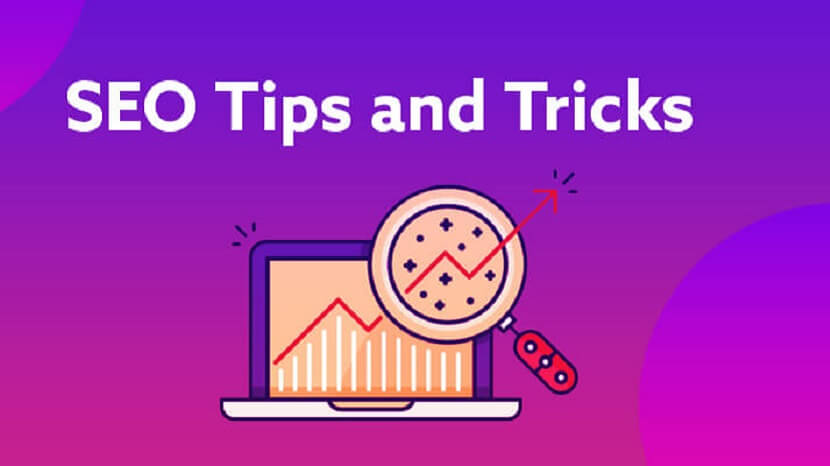
A solid online presence for your business in today's digital age is essential. Whether you are a small mom-and-pop business or a large company with over 100 employees, your online presence is more important than you think. Consider implementing the correct SEO strategies to improve your search engine rankings. Doing this will reward you with more organic traffic and potential customers who visit your site.
This guide will go over the seven SEO tips you need to follow to boost your website's search engine ranking. Let's dive right in and share what you need to know.
1. Conduct Thorough Keyword Research
Of course, any successful SEO strategy begins with thorough keyword research. You must identify the keywords and phrases that will resonate with your target audience the most, especially when customers search for products or services related to your business. You want to consider looking for keywords such as "buyer intent," which means that the customer is intent on purchasing the product or service that will solve their problem.
In addition, you can look for any keywords using tools like Google Keyword Planner, SEMrush, and Ahrefs, which can help you find high-volume, low-competition keywords related to your business. Next, you can optimize your content based on these keywords so you can increase your chances of ranking higher on the results page based on said keywords.
2. Optimize On-Page Elements
On-page SEO entails optimizing individual pages on your website so they rank higher and get more traffic. There are plenty of on-page elements that you need to know about, including the following:
3. Create High-Quality, Relevant Content
Any SEO agency can tell you that content will matter most in the SEO world. Search engines will prioritize websites that provide plenty of valuable and relevant information for users, especially when such content can be evergreen or relevant forever. You must create high-quality content that will address the needs and interests of the target audience you are reaching out to.
Create blog posts, how-to guides, infographics, videos, and more that can be utilized, and be sure to update them regularly. By doing regular updates, search engines will notice this, and it will be perfect for allowing you to maintain your ranking.
4. Improve Website Loading Speed
It is crucial to ensure your website is loading at an appropriate speed. The reason for this is that it will help improve not only your SEO ranking but it will also be essential for the overall user experience. Search engines like Google will consider loading speeds as a ranking factor. It would be best if you utilized tools like Google PageSpeed Insights to analyze your website's performance and identify any bottlenecks where you can improve.
Be sure to optimize images, use browser caching, and minimize CSS and JavaScript files to ensure that your loading speed is always fast. If you can do this, rest assured that your website might be favorable for Google and other search engines.
5. Ensure Mobile-Friendliness
In today's digital age, many people use mobile devices and access websites using their smartphones, tablets, and other devices on the go. It's essential to have a mobile-friendly website so it's easily accessible. Google utilizes what is known as mobile-first indexing, which means it prominently uses the mobile version of the content as part of its index and ranking system.
You want to ensure that your website is responsive and provides an easy and seamless experience across all devices for your users. To see if your website is mobile-friendly, be sure to utilize Google's Mobile-Friendly Test Tool. If the test fails, you must work to make it more mobile-friendly.
6. Build High-Quality Backlinks
Also known as inbound links from other websites, backlinks will be a huge factor in SEO. That's because these high-quality backlinks are from reputable websites, which means your site is trustworthy and authoritative. You can focus on building backlinks through various means, such as influencer outreach, guest posting, and creating shareable content. We highly suggest avoiding black hat SEO practices such as buying links.
Not only will you be penalized, but it may also lead to other repercussions. Build your high-quality backlinks ethically and through legal means.
7. Use Local SEO
You want to utilize local SEO if your business has a physical location or targets a specific geographic area. Ensure your business is listed on Google My Business and similar directories. At the same time, make sure that your website is optimized for local search, including your city, region, and state in your keywords. Likewise, you should create location-specific content to be ranked with those keywords.
Final Thoughts
These seven tips will help boost your SEO ranking so your website performs very well under specific keywords that your customers are searching for. It may take some time for you to climb the ranks of search engines in particular, but it is important to invest in the time and effort it will take to get there.
If you found this article helpful, we encourage you to share it on your social media platforms—because sharing is caring! For more information about article submissions on our website, feel free to reach out to us via email.
Send an emailWritten by RGB Web Tech
Latest Technology Trends
Latest technology trends shaping the future, including AI advancements, blockchain innovation, 5G connectivity, IoT integration, and sustainable tech solutions. Explore breakthroughs in quantum computing, cybersecurity, augmented reality, and edge computing. Stay ahead with insights into transformative technologies driving innovation across industries and revolutionizing how we live, work, and connect.
Understanding the Role of Managed Network Services in Digital Marketing Strategy
Last updated on January 19, 2025 by RGB Web Tech

Scour the terrain of digital marketing success, and you'll find a less celebrated champion at its core: network efficiency. Modern businesses tap into managed network services not for luxury but necessity - to sharpen operational agility, fortify website fortitude, and bolster security protocols.
Now picture a website that snaps to attention with lightning speed and stalwart uptime. Such traits transcend mere convenience; they are the linchpins in heightening user engagement and ensuring precise analytics. The prowess of a network can sculpt your digital campaign's impact - subtly yet profoundly.
Faster Page Loads and User Engagement
A fast-loading website dramatically boosts user engagement. Users expect instant access to content, so delays often lead to increased bounce rates. Managed network services ensure your website delivers a smooth, swift experience by optimizing server performance and reducing latency.
Consider the implications for digital marketing: Faster page loads enhance user satisfaction, leading to longer site visits and higher conversion rates. Capturing a user's attention in milliseconds is crucial for successful online campaigns.
Moreover, search engines favor faster websites in their ranking algorithms (improved load times contribute directly to better SEO results). This increases your site's visibility and attracts more organic traffic, ultimately driving higher revenue from digital marketing efforts. Fast websites are not just an advantage; they are essential in today's market.
Reduced Downtime and Analytics Accuracy
Downtime negatively impacts user experience, but it also skews your analytics data. Managed network services reduce downtime through proactive monitoring and maintenance, ensuring continuous availability of your digital platforms.
Test environments like a cloud device farm become essential for assessing the performance of web apps, websites, and mobile apps under various conditions. This allows for identifying potential issues before they affect end-users.
Consistent uptime leads to more reliable analytics data. Accurate insights into user behavior help refine marketing strategies (eliminating guesswork). When campaigns run on stable networks, marketers can trust their data to make informed decisions that drive better results.
Enhancing Security to Protect Campaigns
Security is paramount in digital marketing. Cyber threats can compromise campaigns, damage reputations, and lead to financial losses. Managed network services for businesses offer robust security measures that safeguard your digital assets.
Corsica Tech's insights highlight the importance of advanced threat detection and response capabilities. Their features align with digital marketing performance goals by ensuring uninterrupted campaign execution (keeping data safe from breaches).
A secure network fosters trust among users, which enhances brand credibility. When users feel confident their information is protected, they engage more freely with your content. This increased engagement drives higher conversion rates and strengthens overall marketing effectiveness.
Optimizing Bandwidth for Marketing Automation Tools
Marketing automation tools require significant bandwidth to function effectively. Within the machinery of managed network services, bandwidth optimization is a quiet powerhouse. It quietly reallocates resources, smoothing out the potential snags in data flow that can interrupt vital marketing crusades.
Consider the heavy lifters of any digital strategy - real-time analytics engines, sophisticated email campaigns, social media scheduling tools. They all demand unwavering connectivity to operate at peak effectiveness. Optimizing bandwidth is less about raw power and more about ensuring these platforms deliver without missing a beat.
Corsica Tech emphasizes the role of tailored bandwidth solutions in maximizing tool efficiency. By aligning network capabilities with specific campaign needs, businesses can enhance their automation efforts (achieving smoother operations). This strategic alignment enables marketers to focus on creativity and strategy rather than technical constraints.
Streamlined Data Management for Targeted Advertising
Effective digital marketing relies on precise data management. Managed network services streamline data flow, ensuring accurate and timely delivery of critical information across platforms.
Efficient data management supports targeted advertising by allowing marketers to segment audiences and tailor campaigns accurately. With seamless data integration, ad targeting becomes more precise, improving engagement rates.
Consistent and reliable network performance enables real-time updates to marketing databases (facilitating rapid adjustments). This agility in managing and utilizing data enhances the overall impact of advertising efforts, driving better outcomes from every campaign. The synergy between robust networks and strategic marketing creates a powerful engine for growth.
Scalability to Support Growing Campaign Demands
As digital marketing campaigns grow, network demands increase. Managed network services provide the scalability needed to support these expanding efforts without compromising performance.
Scalable networks allow for seamless adjustments in bandwidth and resources, ensuring your campaigns remain effective as they scale. This flexibility is crucial during high-traffic periods or when launching new initiatives.
The ability to scale up quickly prevents potential bottlenecks and maintains consistent user experiences. Adapting swiftly to changing demands enables marketers to pursue ambitious goals confidently, knowing their infrastructure can handle increased loads.
Integrating AI and Machine Learning in Digital Marketing
Artificial intelligence (AI) and machine learning are transforming digital marketing. Managed network services support the infrastructure needed for these cutting-edge technologies.
AI tools like predictive analytics and personalized content systems rely on strong networks to process large data sets quickly. Managed services provide the necessary bandwidth, ensuring seamless performance and low latency.
Machine learning algorithms enhance campaign effectiveness through real-time data analysis. A stable network infrastructure allows these systems to run smoothly, delivering insights that drive better marketing decisions. Implementing AI and machine learning in your strategy becomes more practical with a reliable, high-performance network as the foundation.
Maximizing Digital Marketing Through Network Excellence
Effective digital marketing hinges on robust network management. Faster page loads, reduced downtime, enhanced security, and optimized bandwidth create a strong foundation for successful campaigns. Scalable networks support growth while seamless data management and integration of AI tools enhance targeting precision.
Managed network services not only ensure operational efficiency but also drive significant improvements in marketing performance. Investing in these services empowers marketers to achieve their goals with confidence and precision.
If you found this article helpful, we encourage you to share it on your social media platforms—because sharing is caring! For more information about article submissions on our website, feel free to reach out to us via email.
Send an emailWritten by RGB Web Tech
Latest Technology Trends
Latest technology trends shaping the future, including AI advancements, blockchain innovation, 5G connectivity, IoT integration, and sustainable tech solutions. Explore breakthroughs in quantum computing, cybersecurity, augmented reality, and edge computing. Stay ahead with insights into transformative technologies driving innovation across industries and revolutionizing how we live, work, and connect.
How to Choose the Best Programmatic Ad Platforms for Your Strategy
Last updated on January 19, 2025 by RGB Web Tech

In today's digital world, programmatic advertising has become essential to any successful marketing strategy. This automated method allows advertisers to reach targeted audiences with precision and efficiency. However, with the plethora of programmatic ad platforms available, choosing the right one for your needs can be overwhelming. In this post, we will explore key factors to consider when selecting a programmatic ad platform, ensuring you make an informed decision. So, read on and gain valuable insights from professionals who are well-versed in the art of programmatic ad platforms.
1. Understanding Programmatic Advertising
Before diving into the selection process, let's briefly understand what programmatic advertising entails. Essentially, it refers to automated buying and selling instead of digital ads in real-time using algorithm-based decisions. It streamlines the ad-buying process across multiple platforms and publishers, enabling marketers to optimize their campaigns more effectively.
2. Identify Your Advertising Goals
To select the best programmatic ad platforms for your strategy, it is crucial to define your advertising goals clearly. Consider whether you aim to increase brand awareness, drive website traffic, generate leads, or boost conversions. Understanding your objectives will help you identify which features and functionalities are critical for success.
3. Compatibility with Your Target Audience and Channels
Every business has its unique target audience and preferred channels for engagement. While evaluating programmatic ad platforms, prioritize those that align seamlessly with your target demographics and channels. Check if they offer targeting options such as age group, gender, location targeting, and interest-based targeting data segments – all essential for reaching your ideal customers.
4. Transparency in Data Insights
Data plays a pivotal role in optimizing advertising campaigns. Ensure that your chosen platform provides comprehensive data insights that allow you to track performance at various levels—from campaigns to individual placements or creative elements. Transparent reporting will enable you to measure campaign success accurately and make data-driven decisions regarding future optimizations.
5. Ad Inventory Quality
Not all programmatic ad platforms provide access to high-quality ad inventory. To safeguard your brand reputation, assess the platform's inventory partners and ensure they align with your brand standards. Look for platforms that offer ad verification tools and inventory quality controls.
6. Advanced Targeting Capabilities
Effective targeting is crucial for campaign success. Consider platforms that offer advanced targeting capabilities, such as contextual, device-specific, or behavior-based targeting. Reaching the right audience at the right time significantly enhances campaign performance and ROI.
7. Ad Formats and Creative Customization
Diversifying your ad formats can help you better engage with your audience. Assess whether the programmatic ad platform supports a wide range of ad formats, such as display ads, video ads, native ads, or even emerging formats like OTT (Over-The-Top) advertising. Additionally, evaluate whether the platform allows creative customization options to stay consistent with your brand identity.
8. Support and Account Management
When investing in a programmatic ad platform, it is essential to consider the platform provider's level of support and account management. Check whether they have a dedicated support team to assist you whenever needed. Clear communication channels alleviate any roadblocks while maximizing the effectiveness of your campaigns.
9. Pricing Structure
Programmatic advertising offers various pricing models, such as cost per thousand (CPM), cost per click (CPC), and cost per acquisition (CPA). Understand the pricing structure offered by different platforms and assess which model best suits your budget and marketing goals. Remember that pricing transparency should be a key factor when comparing options.
Conclusion
Selecting a programmatic ad platform that aligns with your advertising goals is imperative for delivering successful campaigns. By assessing factors such as compatibility with target audiences, transparency in data insights, quality of ad inventory, advanced targeting capabilities, customizable creative options, excellent customer support, and suitable pricing structures - you will be well-equipped to make an informed decision on choosing the best programmatic ad platform for your strategy. Remember to continually evaluate and optimize your campaigns as you progress, ensuring the utmost effectiveness in reaching your business objectives.
If you found this article helpful, we encourage you to share it on your social media platforms—because sharing is caring! For more information about article submissions on our website, feel free to reach out to us via email.
Send an emailWritten by RGB Web Tech
Latest Technology Trends
Latest technology trends shaping the future, including AI advancements, blockchain innovation, 5G connectivity, IoT integration, and sustainable tech solutions. Explore breakthroughs in quantum computing, cybersecurity, augmented reality, and edge computing. Stay ahead with insights into transformative technologies driving innovation across industries and revolutionizing how we live, work, and connect.
How to Evaluate the Success of your Guest Post Campaign
Last updated on January 19, 2025 by RGB Web Tech

Guest posting is crucial for companies seeking to enhance their web profile, SEO, and overall reach. Many companies leverage the power of guest posting, but how do you know if your campaign worked? Evaluating guest post success requires looking at various indicators and how they relate to your general marketing objectives. Here are the essential elements to assess the success of your guest post campaign.
Understanding the Objectives of Guest Posting
Utilizing guest post services can expand your reach, guiding readers from established blogs to your own site. Before you can get into metrics and evaluation, understand the key goals of a guest post campaign. These objectives generally include:
With these goals in mind, you can define objectives and KPIs to evaluate campaign results.
1. Website Traffic
One of the most immediate effects of a successful guest post campaign is increased website traffic. To measure this, use tools like Google Analytics to monitor the number of visitors on your website from guest posts. See if traffic surges right after your guest posts are published. Look out for these metrics:
A substantial increase in referral traffic, longer session durations, and a low bounce rate all indicate that your guest post is reaching your audience.
2. Backlinks and SEO
Among the main reasons businesses use guest post services is to obtain quality backlinks to boost search engine rankings. Backlinks from high-domain websites tell search engines that your website is authoritative and trustworthy.
To evaluate the way your guest posts impact SEO, use these indicators:
Remember, SEO improvement takes some time to materialize, so track these metrics over time.
3. Brand Awareness and Authority
Guest posting on established blogs and websites can increase your brand awareness, exposure, and authority. Measure this with quantitative or qualitative metrics using:
4. Lead Generation and Conversion
Ultimately, the success of your guest post campaign comes down to its impact on lead generation and conversions. Assess the manner in which your campaign is driving actionable results using:
You can set goals, track conversions, and attribute them to your guest post efforts through tools like Google Analytics and CRM software.
5. Audience Expansion
Another critical objective of guest posting is to broaden your audience base. To measure this essential metric, consider this:
Tracking these metrics will show you how your guest post campaign reaches new followers while boosting your reach.
Guest Posting Websites
Here's a list of popular Guest Posting Websites across various niches:
| Sr.No | Website | DA | DR | Contact Us |
|---|---|---|---|---|
| 1 | rgbwebtech.com | 52 | 70 | Mail Us |
| 2 | allsuccesspath.com | 52 | 39 | Mail Us |
| 3 | fitnessgoal4u.com | 53 | 28 | Mail Us |
| 4 | a1truejobs.com | 53 | 40 | Mail Us |
| 5 | webjeevan.com | 59 | 12 | Mail Us |
| 6 | webxsky.com | 56 | 17 | Mail Us |
| 7 | appskystar.com | 57 | 21 | Mail Us |
| 8 | digitalskystar.com | 56 | 13 | Mail Us |
| 9 | appjeevan.com | 56 | 15 | Mail Us |
| 10 | techskystar.com | 56 | 19 | Mail Us |
| 11 | webskystar.com | 56 | 11 | Mail Us |
Wrapping Up
The success of your guest post campaign requires an integrated approach with the appropriate metrics. Track site traffic, audience expansion, lead generation, brand awareness, and backlinks to see how your guest posts perform.
Remember that guest posting is a long-term strategy. Some metrics like SEO improvements and brand authority might show results quickly. However, consistently reviewing and analyzing these essential indicators can help you refine your approach, maximize your return on investment, and reach your marketing and advertising objectives.
If you found this article helpful, we encourage you to share it on your social media platforms—because sharing is caring! For more information about article submissions on our website, feel free to reach out to us via email.
Send an emailWritten by RGB Web Tech
Latest Technology Trends
Latest technology trends shaping the future, including AI advancements, blockchain innovation, 5G connectivity, IoT integration, and sustainable tech solutions. Explore breakthroughs in quantum computing, cybersecurity, augmented reality, and edge computing. Stay ahead with insights into transformative technologies driving innovation across industries and revolutionizing how we live, work, and connect.
How to Start API Testing in your Organization?
Last updated on January 19, 2025 by RGB Web Tech

Applications and third-party programs can communicate with each other thanks to APIs. The effectiveness and efficiency of an API can have a detrimental influence on business procedures and app quality.
It's difficult to argue against the necessity of API testing. However, learning how to test APIs may quickly become a complex procedure. An API testing checklist is helpful in this situation. After all, testing APIs is simpler when the testing process has clear stages to follow. More questions may arise when creating an API security testing checklist.
Here's more on how to start API testing in your organization.
What is an API?
An Application Programming Interface, or API, is a collection of guidelines and conventions that facilitate communication between different programs. By allowing requests and replies to move across systems via a collection of API endpoints, it effectively serves as a bridge. Here, every endpoint relates to a particular resource or function that an application is able to use.
These endpoints are the main focus while evaluating an API. Ensuring that their behavior matches expectations is the aim here. Typically, computer code is the intended user of an API—not actual people. When an API provider documents their response, a developer writing code to interface with it expects that response.
What is API Testing?
API testing is essentially using an API. Testing is a crucial component of any application development. In this way, API testing extends beyond ensuring that the API works. Instead, it has additional features, such as ensuring API dependability, speed, and security. While it is possible to test APIs manually, automation improves speed and efficiency.
Types of API Testing
The major goal of this testing is to check the API's functionality and performance. Basic assertions begin with verifying the response content, schema, and response codes. Other tests, such as API security and performance testing, must still be conducted.
Here are some of the most frequent categories for which test cases can be created:
What are the Benefits of API Testing?
API testing provides several benefits that are critical for guaranteeing the stability and performance of API-based applications. Key benefits include increased test coverage and efficiency and guaranteed operation, performance, security, and compatibility. By executing API tests on a regular basis as part of DevOps processes or CI/CD pipelines, development teams may shorten release cycles and focus on core development tasks.
Furthermore, the shift-left technique to API testing enables early issue discovery, resulting in faster bug fixes and increased efficiency in finding performance bottlenecks and scalability difficulties. Moreover, support for several programming languages and good documentation for API usage facilitate greater cooperation among development teams while also assisting in data security by finding vulnerabilities and applying required security measures.
How Do You Get Started with API Testing in Your Organization?
When tackling API testing, it is critical to understand the technology that underpins your APIs. With this information, you will be able to select the appropriate API testing tools and programming language for developing automated tests.
Once the tools are in place, you'll need to develop a plan that incorporates both positive and negative test scenarios. Positive tests ensure data integrity and proper operation under typical circumstances. On the other hand, negative tests examine how the API handles mistakes and edge situations.
The next step is to include API testing early in your development lifecycle. This allows you to proceed with continuous testing, which involves running automated tests against new code changes.
Finally, consider the security and performance implications of your APIs. Create tests that replicate various security risks. These may include injection attacks or illegal access. Furthermore, performance testing should be performed to guarantee that the API can manage the predicted traffic level.
API testing checklist is as follows:
1. Understand API Testing: Begin by educating your team about the importance of API testing and its benefits, such as improved integration, better test coverage, and early defect detection.
2. Choose the Right Tools: Evaluate and select the appropriate API testing tools that align with your organization's technology stack and requirements.
3. Define Testing Strategy: Develop a comprehensive API testing strategy that covers various aspects, including test case design, data management, automation, and integration with other testing processes.
4. Train Your Team: Invest in training your team members on API testing concepts, API testing tools, and best practices. Hands-on workshops and practical exercises can help them gain the necessary skills.
5. Start Small: Begin with a pilot project or a subset of APIs to validate your testing approach and iron out any potential issues before scaling up.
6. Automate Testing: Implement automation for API testing to ensure efficient and consistent execution, particularly for regression testing and continuous integration/deployment pipelines.
7. Monitor and Report: Establish processes for monitoring API test execution, analyzing results, and generating comprehensive reports to facilitate timely decision-making and problem resolution.
8. Continuous Improvement: Regularly review and refine your API testing processes, incorporating stakeholder feedback and leveraging industry best practices to ensure constant improvement.
Conclusion
In conclusion, APIs are a crucial component of any contemporary company. One of the most important things an organization can do to improve the quality of the application it is testing is to introduce API testing. Teams new to this area must adhere to established best practices. When done correctly, API testing may provide several advantages that make it an essential part of developing applications.
If you found this article helpful, we encourage you to share it on your social media platforms—because sharing is caring! For more information about article submissions on our website, feel free to reach out to us via email.
Send an emailWritten by RGB Web Tech
Latest Technology Trends
Latest technology trends shaping the future, including AI advancements, blockchain innovation, 5G connectivity, IoT integration, and sustainable tech solutions. Explore breakthroughs in quantum computing, cybersecurity, augmented reality, and edge computing. Stay ahead with insights into transformative technologies driving innovation across industries and revolutionizing how we live, work, and connect.
Enhancing Virtual Engagement: Leveraging Technology for Smooth Interactions
Last updated on January 19, 2025 by RGB Web Tech

In the constellation of today’s fast-paced digital environment, the essence of engagement has significantly transformed. Gone are the days when face-to-face meetings were the cornerstone of interaction. Virtual engagement has sailed into the spotlight, becoming indispensable across various sectors such as business, education, healthcare, and social connections. Communication, the act of exchanging views or providing an exchange of ideas and information, has been altered beyond recognition due to virtual interaction that allows us to overcome temporal and spatial restrictions.
The most important aspect of backing the efficacy of these digital engagements is the potent technological aspect. Technology and strategy are the answers to elevating the efficacy of these digital engagements. Leveraging technological advancements not only makes the virtual interaction high-quality but also perfects the path of proper and effective communication.
This blog explores the full range of weaponry that has been developed to improve our virtual collaboration. We find out how the fundamental high-speed internet and the choice of a suitable virtual platform intricacies are being followed by wizardly video conferencing software and fun interactive tools. We also unplug the location of the chatbots, the mobile friendliness account for the way these tools interact with the lightspeed rise of smartphones, the VR and AR revolution dramatically enhancing things, the fearsome server precautions, the good karma of the reasonable race for accessibility, and the psychologist’s notebook, which constitutes analytics.
And now – I hope – our digital journey is about to begin, promising to arm you with the knowledge to master the art of virtual engagement.
The Role of High-Speed Internet Connectivity
A high-octane sports car is only as good as the fuel it runs on; similarly, the potential of virtual engagement is inherently bound to the quality of internet connectivity powering it. High-speed internet connectivity is no longer a luxury; it's the lifeblood of today's digital ecosystem. Whether it's a global webinar, a telehealth session, a remote classroom, or a virtual family reunion, stable and speedy internet is paramount.
But how often do we gauge our internet stability or speed? Do we question if our connectivity is robust enough to support the increasingly weighty demands of high-definition video calls or the swift exchange of large data packets? The first step towards improving virtual engagement is ensuring that our connection does not fail at crucial moments.
Here are a few tips to evaluate and improve your internet speed and stability:
We can mainly start by focusing on high-speed internet connectivity, and in all our virtual endeavors, our foundation will be robust, enabling us to move smoothly and productively across our virtual journey.
Choosing the Right Platform for Your Needs
Just as one might select the appropriate venue for a live event, choosing the right virtual platform for your online engagement is critical. The choices are abundant, with platforms designed to cater to webinars, virtual conferences, workshops, or even simple team meetings.
Several factors should inform your platform choice:
Here's an overview of how to find a platform that aligns with your specific virtual interaction demands:
Selecting the right platform is like finding the right stage for your performance—it can greatly amplify the success of your virtual engagement.
Video Conferencing Software: Creating a “Near-Real” Experience
The rise of video conferencing software has altered the meaning of connecting. We can now achieve a “near-real” feeling of an in-person experience with the aid of realistic and effective interaction. Your selection of video conferencing software like FreeConference.com is critical; the platform you select will help direct how well or how poorly your meetings or events go.
Key features to look for in video conferencing software include:
Investing time into selecting a high-quality video conferencing software that ticks these boxes will ensure that your virtual engagements are as close to the 'real thing' as possible.
Make it Interactive with Virtual Tools
A higher degree of engagement is facilitated by interaction that encourages participation and feedback during virtual sessions. Several tools and features enable interaction that may be as straightforward as chatbox discussions and as elaborate as collaborative projects.
Factors to consider while selecting your virtual engagement tools include:
Remember, the key is not to simply convey information but to engage your audience actively. When participants feel part of the conversation, they are more likely to remain attentive and invested in the subject matter.
Leverage the Power of Chatbots
From customer service to personal reminders, chatbots have infiltrated virtually every digital space. They should be no exception when it comes to virtual engagement. Chatbots can be utilized for things such as automatically repeating the same responses to commonly asked questions or guiding people through banal processes quickly. Chatbots can respond to a countless number of inquiries at the same time, making them ideal for large main virtual engagement platforms.
If you're planning to use a chatbot, focus on the following aspects:
Bridge the gap between technology and personal touch with a chatbot that can cater to your participants' needs without placing strain on human resources.
Mobile Optimization: Meeting Users Where They Are
With smartphones dominating our daily communication, any virtual engagement strategy would be incomplete without addressing mobile users. Whether it's attending a webinar, watching a live presentation, or participating in an online workshop, the experience must be optimized for small screens.
Here are a few ways to ensure your engagement is mobile-friendly:
By prioritizing mobile optimization, you ensure access to your virtual engagements anytime, anywhere, broadening your reach and convenience.
The Promise of Virtual Reality (VR) and Augmented Reality (AR)
The realms of VR and AR offer exciting prospects for virtual engagement. With VR, you can host virtual events that offer a highly immersive, interactive experience, creating virtual environments for meetings, concerts, or classrooms. AR can similarly enrich virtual experiences by overlaying digital content onto the real world, making the virtual engagement seem more 'real'.
While VR and AR technology usage in day-to-day communications is still gaining traction, keeping an eye on these emerging trends can ensure you're at the forefront of virtual engagement.
Cybersecurity: Safeguarding Your Virtual Space
As we increasingly turn to virtual settings for engagement, cybersecurity has taken center stage. Just as you would secure a physical location for an event, online spaces require strong protective measures to prevent data breaches, Zoom bombing, or other intrusions.
Here are some ways to ensure safety during virtual engagements:
Security measures not only protect you and your audience from unpleasant experiences but also foster trust in your audience, thereby encouraging future engagements.
The Need for Accessibility in Virtual Engagements
Just like physical engagements, virtual engagements should be designed with inclusivity in mind. Participants may have varying needs and abilities that require accommodations, and it's vital that these needs are addressed.
To foster a more inclusive virtual space, there are a few aspects to consider:
Remember, inclusivity leads to a broader reach and a richer experience for all.
Tracking Success with Analytics
To measure the success of your virtual engagements in order to enhance their success, as well as to determine areas that need improvement, it is obviously necessary to measure the success of virtual promotions. This includes measurement of attendance rates, participant interplay, sustainability of the participants, and other key indicators. Most websites have in-built data analysis tools with which a user can determine these factors.
Here are a few metrics that you might like to track:
Nothing about planning or executing any event is perfect. Tracking the identified metrics can reveal valuable knowledge about what works and what needs to be fixed. As a result, you create a micro-loop for continuous improvement to increase the quality of your virtual events on the whole.
Conclusion
Thriving in the world of virtual engagement requires the delicate balancing act of technology and strategy. From ensuring high-speed internet connectivity to leveraging the power of chatbots, from selecting the right virtual platform to prioritizing mobile optimization and inclusivity, many elements demand our attention. By adopting these strategies and harnessing the power of advanced technology, we can revolutionize our approach to virtual engagement, making it a rewarding experience for all involved.
If you found this article helpful, we encourage you to share it on your social media platforms—because sharing is caring! For more information about article submissions on our website, feel free to reach out to us via email.
Send an emailWritten by RGB Web Tech
Latest Technology Trends
Latest technology trends shaping the future, including AI advancements, blockchain innovation, 5G connectivity, IoT integration, and sustainable tech solutions. Explore breakthroughs in quantum computing, cybersecurity, augmented reality, and edge computing. Stay ahead with insights into transformative technologies driving innovation across industries and revolutionizing how we live, work, and connect.
Effective Search Engine Marketing Tactics for B2B Software and Technology Advancements
Last updated on January 19, 2025 by RGB Web Tech

Technology is undoubtedly an unstoppable trend in the current business world. In order to remain competitive and effective, organizations must continuously develop in this area, and B2B marketing in relation to software and technology development is a key factor. One effective method to increase exposure and take full advantage of this vast market is Search Engine Marketing (SEM).
SEM is a mechanism that various businesses apply to elevate their ranking on search engine results pages (SERPs). It involves techniques such as Search Engine Optimization (SEO), Pay-Per-Click (PPC) advertising, and content marketing. The application of SEM in advertising software and other technology forms is wide and versatile. First of all, it builds a pathway for more searches from the intended audience. On the second note, it enhances online brand credibility, expands the market, and thirdly converts.
A critical takeaway is that understanding the nuances of your B2B audience is part of successful SEM. And that goes beyond knowing who needs your software or whatever technology solution you offer. It includes psychographics- understanding your customers’ behaviors, inclinations, and DMPs.
Identify your B2B personas. To efficiently evaluate your B2B target audience and optimize your SEM strategy later, you will need to identify and define your B2B personas. This should specifically include the typical stakeholders taking part in the purchase decisions—for example, IT managers, CTOs, and other professionals.
Additionally, mapping the B2B customer journey is important. This journey, unlike that of a B2C customer, often involves multiple individuals and can be relatively longer due to the scale and complexity of the decisions involved. Recognizing the unique decision-making process in B2B markets and incorporating it in your SEM efforts can significantly enhance targeting and effectiveness.
Consider that a particular piece of software or technology might be used by an IT professional but may require approval from a C-suite executive. In this case, tailoring SEM campaigns to resonate with both these personas can deliver impressive results.
Crafting an Effective Keyword Strategy and Leveraging PPC Advertising
A cornerstone of successful SEM lies in the efficient selection and use of keywords. For B2B software and technology marketers, the keyword strategy should focus on identifying terms that reflect both the industry's nuances and the specific solutions being offered. High-converting keywords are typically those that are closely aligned with the user's search intent. These could range from "cloud computing solutions for small businesses" to "enterprise resource planning software features."
The significance of long-tail keywords in B2B marketing cannot be overstated. Given the complex nature of B2B purchasing decisions and the specificity of the required solutions, long-tail keywords offer a way to precisely target the audience. They might have lower search volumes, but their conversion rates often justify their use. For instance, "affordable cybersecurity solutions for fintech startups" is a long-tail keyword that targets a specific subset of the B2B market.
Transitioning to Pay-Per-Click (PPC) Advertising, it offers a direct and often swift route to enhanced visibility on search engine results pages. The primary benefit of PPC in the B2B sector is its ability to target specific demographics, keywords, and even timeframes, ensuring that your ads reach the right audience at the right time.
Developing effective PPC campaigns involves a nuanced approach. Ad copy should not just be compelling; it must speak directly to the unique needs and pain points of the B2B decision-makers. A/B testing different headlines, call-to-actions (CTAs), and value propositions can help identify the most effective messaging.
Equally important is landing page optimization. The landing page for each PPC ad must be relevant, user-friendly, and focused on conversion. This means clear CTAs, concise messaging, and a seamless pathway to take the next step, whether it's signing up for a demo, downloading a whitepaper, or contacting sales. The coherence between the ad and the landing page significantly influences conversion rates.
Enhancing Organic Reach with SEO and the Role of Content Marketing
While PPC provides a faster track to visibility, SEO remains the bedrock of sustained organic reach. Understanding SEO involves recognizing its role in enhancing a website's ranking on search engines through optimizations that cater to search engine algorithms.
A well-focused content strategy supported by keyword optimization is crucial to achieving this end. Content creation not only needs to be informative and engaging to one’s audience but also easily crawlable and indexable by search engines. This is enabled by the smart use of keywords, optimizing site speed, and ensuring that all platforms are mobile-friendly.
The role of backlinks in SEO also bears mentioning. Earning backlinks from reputable sites within the technology and software industry not only drives traffic but signals to search engines the credibility and authority of your site, positively impacting your rankings.
SEO, being a sophisticated process, can seem stressful, primarily for those businesses choosing the path of development in the tech industry. In this regard, the first competitive advantage of a B2B SEO agency like Nine Peaks is the possibility of avoiding dealing with all of it. A professional agency would rather propose an individual approach to understanding your market segment and business. It is important for a business to select an SEO agency based on experience, case studies, and B2B-specific knowledge.
For example, how content marketing supports Search Engine Marketing when the various target audiences get to know your brand at different stages of their journey, as we educate them on the problems they face, acquire materials such as whitepapers and blogs to solve them, and read our case studies and gain industry insights, which is expected of a leader in the technology sector.
The Significance of Analytics, Reporting, and Local SEO
An essential component of SEM is the continuous monitoring, assessing, and refining of strategies based on performance. Most importantly, the end-user cannot do without analytics and reporting tools to evaluate campaign performance. Thus, it is essential to make the most of the data to perfect the strategy and core SEM’s alignment with business goals and market conditions.
Secondly, even in B2B marketing, local SEO has significant advantages that are frequently disregarded. Tactics such as optimizing for local keywords, claiming Google My Business listings, and garnering positive local reviews can enhance visibility among locally-based businesses in need of your software and technology solutions.
Conclusion
In conclusion, B2B SEM is a multilayered strategy that embraces keyword strategy, PPC, SEO, content marketing, and accurate analytics optimization. Each element is to be developed according to the advanced features of the B2B software and technology market and cannot be suitable if followed by the book.
In the end, the main condition for the effectiveness of all these efforts is value. The requisite to make the strategy work is to continuously learn, be flexible, and have an integrated SEM strategy. By implementing such a strategy, businesses can enhance their visibility within the technology landscape that changes rapidly.
If you found this article helpful, we encourage you to share it on your social media platforms—because sharing is caring! For more information about article submissions on our website, feel free to reach out to us via email.
Send an emailWritten by RGB Web Tech
Latest Technology Trends
Latest technology trends shaping the future, including AI advancements, blockchain innovation, 5G connectivity, IoT integration, and sustainable tech solutions. Explore breakthroughs in quantum computing, cybersecurity, augmented reality, and edge computing. Stay ahead with insights into transformative technologies driving innovation across industries and revolutionizing how we live, work, and connect.
Tackling App Development Issues with a Practical Troubleshooting Guide
Last updated on January 19, 2025 by RGB Web Tech

A large number of users uninstall the apps on account of the issues that persist and cannot help in functionality and user experience. An effective solution for such app development challenges requires a practical troubleshooting guide.
This article explores the impactful insights and strategies toward finding, analyzing, and solving common problems in apps to help provide a smooth and satisfactory user experience. Discover key techniques to enhance app performance and retention.
Effective Planning and Requirement Gathering
Effective planning and requirement gathering is the foremost step toward the development process of any application. This will ensure that the project is in line with the users' needs and the business goals right at the start. If there is no clear planning and requirements upfront, there may be miscommunication, scope creep, and other associated expensive delays that the development teams face.
1. Define goals: The first step in designing is to define the primary objectives and goals of the app. It also considers the type of audience that the app shall attract, its main functionalities, and any value addition that shall be provided to the end-users. Setting clear, measurable goals is very critical to guide the development process and provide success benchmarks. Utilizing the SMART criteria (Specific, Measurable, Achievable, Relevant, and Time-bound) helps in formulating goals that are clear and attainable, ensuring a focused and efficient development process.
2. Stakeholder Involvement: Engage all relevant stakeholders, including clients, end-users, developers, and project managers. Conduct individual interviews, surveys, and workshops to glean different perspectives and ensure that all requirements have been considered. This step of collaboration allows for aligning the project to business and user expectations.
3. Things to Do: Requirements Document: A detailed requirements document needs to be prepared, denoting all functional and non-functional requirements in the format of user stories, use cases, and technical specifications. Each requirement needs to be prioritized by importance and impact on the project.
4. Feasibility Analysis: Feasibility analysis needs to be run with respect to the technical, financial, and operational viability of the project. In this way, some risks and constraints could be noticed in advance so that informed decisions could be made and risk mitigation strategies developed.
5. Prototyping and Feedback: Build prototypes or wireframes of the cell application to start working out how it will look and function. Share these prototypes with all stakeholders and get feedback for modification. Prototyping early lets you refine the requirements and be sure that the final product will satisfy the user's needs.
6. Review and Approve: When the requirements are documented and prototypes are validated, review the plan with the stakeholders. Get formal approval so that everyone is on the same page or committed to the project scope.
The first and foremost steps in effective planning and requirements gathering lie at the heart of successful app development. Ensuring these processes are meticulously executed is therefore instrumental in delivering a quality application that will certainly meet the user's needs and achieve business objectives.
Resolving Technical and Connectivity Issues
Technical and connectivity issues can not only slow down your app's performance but also reduce its overall usability, frustrating users and raising uninstall rates by tough percentage margins. Constant crashes, slow loading, or any other connectivity errors such as err_connection_reset that stop the user from using your app at will are definitely going to ward off users. All these issues should be taken care of promptly and efficiently if you would like to stick to a positive user experience. A negative experience certainly affects the decision of whether to update an application.
Technical and Connectivity Issues—Tips and Tricks:
Designing an Intuitive User Experience

In 2021, 44.5% of respondent organizations worldwide indicated that customer experience is now a key competitive differentiator. With this, to make your app outstanding, it will become most critical to focus on user-friendly design principles serviceable to the needs and preferences of your target audience.
Conduct detailed user research to understand user behavior patterns, preferences, and pain points. One will work from here on the user personas and journey maps that shall guide the design process. Emphasize simplicity and ease of navigation: how easily a user can do a certain task without misconceived expectations about its completion.
Design patterns should be consistent, and the user interface should be intuitive about what the user expects to see. Feedback loops, in the form of usability testing and user feedback, should be utilized in the constant refinement and improvement of the user experience. This would increase user satisfaction and retention greatly.
Benefits of Intuitive User Experience:
Comprehensive Testing and Quality Assurance
Comprehensive testing and QA are inseparable parts of the development process that will give an app success. Thorough testing helps to find out and rectify bugs before they reach end-users, hence ensuring a smooth and reliable user experience. Negligence of this phase may result in poor app performance and dissatisfied users, consequently increasing uninstall rates.
Key Steps for Comprehensive Testing and Assurance of Quality
1. Unit testing: Run unit tests to make sure that independent components of the app work as intended. These are important in catching bugs at the early stages and in making the debugging process quite easy.
2. Integration Testing: Test interactions between different modules and components to make sure they work well with each other. This is necessary for spotting problems that might be created when tying together various parts of the app.
3. System Testing: System testing should be done to test the whole application as an integrated unit. The testing that involves checking the application as a whole against the specified requirements is called system testing.
4. User Acceptance Testing: Conduct user acceptance testing to verify if the app meets all the needs and expectations of the end-user. UAT uncovers usability issues by emphasizing that the application should be user-friendly.
5. Performance Testing: Test the application under different conditions like different network speeds and high user loads. It ensures that your app performs well in real-world usage without degradation.
6. Security Testing: Test for security vulnerabilities in the app and fix them to ensure the safety of the users' data from various threats and compliance with regulations.
Conclusion
In a nutshell, handling problems in the development of apps effectively requires a systematic approach: sufficient planning, intuitive design, rigorous testing, and proactive problem-solving. The development of a reliable and user-friendly app by a developer faces technical and connectivity-related issues, overall testing and quality assurance, and enhancement of the user experience. The guide gives actionable strategies for finding and fixing common problems in the app to boost app performance and user satisfaction.
If you found this article helpful, we encourage you to share it on your social media platforms—because sharing is caring! For more information about article submissions on our website, feel free to reach out to us via email.
Send an emailWritten by RGB Web Tech
Latest Technology Trends
Latest technology trends shaping the future, including AI advancements, blockchain innovation, 5G connectivity, IoT integration, and sustainable tech solutions. Explore breakthroughs in quantum computing, cybersecurity, augmented reality, and edge computing. Stay ahead with insights into transformative technologies driving innovation across industries and revolutionizing how we live, work, and connect.
How to write a cold email? Techniques that generate leads
Last updated on January 19, 2025 by RGB Web Tech

Did you know cold emails generate a higher ROI than any other lead generation form? In fact, 89% of marketers of different companies claim that emailing is their primary channel for lead generation, and 760% of marketing professionals have experienced increased revenue from email marketing.
Cold emails play a crucial role in sales engagement and automation. They help businesses reach out to potential clients and generate leads effectively. Over time, cold emails have evolved from generic pitches to personalized, strategic communication. This evolution has made them more effective in building relationships and converting leads.
What is a сold email?
A cold email is a message sent to someone without a prior relationship with the sender. Its primary purpose is to initiate a conversation and build a business relationship.
Unlike warm emails, sent to someone with whom you have had previous interactions, or marketing emails, often sent to a broad audience, cold emails are targeted and personalized to engage specific recipients.
Cold emails are essential for growing your business. They allow you to introduce your product or service, offer custom solutions, and build trust. When done right, cold emails can transform strangers into valuable business partners.
How to write a cold email and generate more leads
Personalization and timing are crucial when it comes to cold email campaigns. Tailoring your message to the recipient and properly scheduling it can significantly improve your chances of generating leads.
1. Write an engaging subject line
According to OptinMonster, 47% of recipients open cold emails based on the subject line. So it’s crucial to make it appealing and eye-catching.
To optimize your subject lines, start with the length: the ideal word count is between six and ten words. When in doubt, keep it shorter. Here are some tips:
Examples of effective subject lines:
2. Keep your email simple and concise
Long or wordy email copy often demotivates your recipients from reading it. Shorter email are more effective because they quickly convey your point to recipients who have yet to decide to invest time in your service.
3. Personalization
Researching your prospect is vital with an email finder tool. Use LinkedIn, company websites, and industry news to gain insights into the recipient's business, role, and challenges.
4. Send emails at the right time
Best practices for scheduling your emails include:
Statistics show that Tuesday and Thursday mornings are the best times for email open rates.
5. Follow-up

Follow-up emails are very important in the sales process. They remind recipients of your initial message and increase the chances of a response. Send a follow-up email in 2-3 days after the initial email.
Mistakes to avoid when sending cold emails
There are certain pitfalls when it comes to cold email outreach. Check out our list to ensure your emails bring the best results.
1. Over-automating
Relying too heavily on automation without customization can make your messages look impersonal and more likely to be ignored or marked as spam.
Luckily, many email automation tools offer a number of features to help you set up personalized campaigns. Choose the one that fits your goals and budget and helps you find the much-needed balance between automation and manual work.
2. Ignoring feedback
Tracking metrics and prospects’ feedback is crucial. Monitoring open rates, response rates, and other data helps you understand what works and doesn’t. The feedback from recipients can provide valuable insights into their preferences and pain points.
Use this data to tweak your subject lines, email content, and follow-up strategies. Regularly update your marketing and sales strategy.
3. Overlooking audience segmentation
Sending generic emails to a broad audience often results in poor engagement. One-size-fits-all messages are unlikely to resonate with most recipients.
Effective audience segmentation involves dividing your customer base based on industry, job role, company size, previous interactions, etc. This lets you craft targeted messages that meet each prospect's needs.
Conclusion
When done right, cold emailing can be an effective tool for generating leads and building lasting relationships. By following the key techniques outlined in this article, you can craft compelling cold emails that grab attention, deliver value, and convert strangers into valuable leads.
Remember, personalization, timing, and a clear call to action are all crucial for success.
So, what are you waiting for? Start crafting your cold emails today and watch your lead-generation efforts pay off!
If you found this article helpful, we encourage you to share it on your social media platforms—because sharing is caring! For more information about article submissions on our website, feel free to reach out to us via email.
Send an emailWritten by RGB Web Tech
Latest Technology Trends
Latest technology trends shaping the future, including AI advancements, blockchain innovation, 5G connectivity, IoT integration, and sustainable tech solutions. Explore breakthroughs in quantum computing, cybersecurity, augmented reality, and edge computing. Stay ahead with insights into transformative technologies driving innovation across industries and revolutionizing how we live, work, and connect.
The Path to Mastery: Developing Copywriting Skills for Beginners
Last updated on January 19, 2025 by RGB Web Tech

Copywriting has become one of the most important skills to possess in today's digital age. It makes a real difference in marketing, advertising and content creation. But newcomers entering this field have a tough time. A practical guide to the basics of copywriting, from topics to the art of editing and advanced stylistic techniques.
For those who use artificial intelligence tools to create initial drafts, improving content to respond to human emotion and nuance can be challenging. Enter humanize ai, the leading free online platform designed to convert AI-generated text into human-like content. AI Humanizer AI expertly paraphrases text created by AI writers, eliminating any robotic overtones. The result using Humanize AI is guaranteed to be 100% original and bypasses all existing AI detection systems, ensuring that your content retains a personality that is truly eye-catching.
Understanding Copywriting
Copywriting entails the writing of words that are persuasive through advertisements or some other marketing purposes. It is supposed to raise awareness about a brand and convince the individual or group in favor of the intended persuasion to take action. Good copywriting is combining creativity with strategy, psychology, and a deep understanding of the target audience.
Choosing Topics Carefully
1. Know Your Audience
One should write after knowing the people one is writing for. Knowing their interest and need prior will further enable you to pick up topics that are likely to resonate with them. For instance, if you write for a site on health and wellness, the top writers' favorite topics could be "10 Quick Healthy Dinner Recipes" or "How to Start a Meditation Routine."
2. Stay Relevant
Find topics that resonate with the times and interests of your viewers. Current trends and industry news can give useful insights and inspire relevant content. You may use tools such as Google Trends and BuzzSumo to see which topics in your industry are currently relevant.
Writing Your First Draft
1. Ensure to Start with a Headline
It's your headline that generally makes the first, possibly only, early impression for a potential reader, so it had better be something that literally compels them to read further with an increased spark of interest. Well, by using very basic for a headline—for instance "Car Maintenance Tips"—use something straightforward and suffused with benefit, such as, "5 Must-Do's That Are a Snap toward Keeping Your Car Running Smoothly."
2. Structure Your Content
You must organize your content with a clear structure.
3. Grammar Clear Writing
Use simple language. A simple and straightforward style will communicate ideas much more clearly than complex and wordy language, especially if you're hoping to persuade a reader. Say "use" instead of "utilize." Say "or" instead of "due to the fact that."
Tips and Editing Your Text
1. Be Ruthless in Editing
Editing is where good writing becomes great. A critical review of text should remove jargon, replace passive constructions with active verbs, and remove the words you don't need. For example, replace "The meeting that was held by the managers" by "The managers held the meeting".
2. Seek Feedback
Testimonials are gold. Ask for peer review of your drafts and listen to feedback. Go through one more cycle of refining the copy considering the feedback. Perhaps asking direct questions like, "Is the main point clear?" or "Do you have a desire to follow the call to action?" might be useful.
Stylistic Devices That Make Your Writing Better
1. Use of Persuasive Language
Include persuasive points and attributes, e.g.:
2. Storytelling
People are desperately keen to listen to stories. The use of narrative will engage people. People will remember it. For example, rather than saying just how great your product is, you would tell a story about a customer who simply loved how your product solved their problem.
3. Calls to Action
Every piece of marketing copy should urge the reader to do something—make your calls to action clear and compelling. In other words, instead of using "Click here," use "Download our free e-book on budgeting now!"
Copywriter's Tools and Resources
1. Digital Tools
2. Books and Courses
Copywriting is not essentially about writing, but rather about how one structures his message most effectively to reach his audience and hence, attain certain goals. If you understand the basics of copywriting very clearly, do really hard work to put these into practice, and learn things consistently, you can become a good copywriter. Keep in mind that every copy you create is a new challenge towards working out the best in yourself and engaging your audience. Now, let's take on the challenge and keep writing!
If you found this article helpful, we encourage you to share it on your social media platforms—because sharing is caring! For more information about article submissions on our website, feel free to reach out to us via email.
Send an emailWritten by RGB Web Tech
Latest Technology Trends
Latest technology trends shaping the future, including AI advancements, blockchain innovation, 5G connectivity, IoT integration, and sustainable tech solutions. Explore breakthroughs in quantum computing, cybersecurity, augmented reality, and edge computing. Stay ahead with insights into transformative technologies driving innovation across industries and revolutionizing how we live, work, and connect.
Using the correct software solutions helps one to address management issues in the travel and hospit
Last updated on January 19, 2025 by RGB Web Tech

In the always-changing Travel & Hospitality sector, good management is vital. Among the difficulties CEOs and CTOs sometimes have are improving guest experiences, optimizing processes, and keeping effective lines of contact. Here is where solid hotel software development can change things. Acropolium offers comprehensive hospitality software solutions tailored to address these specific needs.
Typical Management Obstacles in Hospitality
Selecting the Ideal Software Solution
Consider the following while choosing the correct software program for your hospitality and travel company:
Advantages of tailored Custom Software Solutions catered to your requirements
Conclusion
In essence, solving management problems in the Travel & Hospitality sector calls for a calculated choice of software. Finding the ideal program to improve your company operations and guest experiences starts with knowing your needs, looking at possible solutions, and assessing suppliers.
If you found this article helpful, we encourage you to share it on your social media platforms—because sharing is caring! For more information about article submissions on our website, feel free to reach out to us via email.
Send an emailWritten by RGB Web Tech
Latest Technology Trends
Latest technology trends shaping the future, including AI advancements, blockchain innovation, 5G connectivity, IoT integration, and sustainable tech solutions. Explore breakthroughs in quantum computing, cybersecurity, augmented reality, and edge computing. Stay ahead with insights into transformative technologies driving innovation across industries and revolutionizing how we live, work, and connect.
Web Hosting Services in Dubai: A Comprehensive Comparison
Last updated on January 19, 2025 by RGB Web Tech

Find out the best web hosting services Dubai, providing top-notch data centers, ultra-fast speed, and localized hosting solutions for ae domain names. This detailed comparison underlines the features, flexibility, ease of use, customer support, pricing, and benefits and weaknesses of the top web hosting providers in Dubai, helping you discover the right hosting services for creating your digital presence in Dubai.
Understanding What Is Web Hosting In Dubai
Web hosting services in Dubai relate to website hosting services that run data centers near or in the United Arab Emirates, customized to serve businesses or individuals operating in that region.
These web hosting services are specially optimized for exceptional speed and flexibility for visitors accessing your website from Dubai and nearby regions. You’ll require web hosting services in UAE when your website needs fast page load times, increased performance, and compliance with Dubai regulations for data security and privacy.
It is highly beneficial for businesses that manage confidential user data, need to protect online transactions or have the goal of ranking higher in local search results.
Key Determinants For Selecting Web Hosting Services In Dubai
Selecting the right web hosting services in Dubai for ae domain name requires considering various crucial factors to make sure your web host fulfills your distinct requirements:
1. Performance
Search for a web host with a history of 99.9% or more uptime and faster page load times, specifically in Dubai.
2. Data Center Locations
Ideally, the web host must have data centers located within Dubai or in nearby regions to reduce latency.
3. Native Customer Support
Make sure that the web host provides technical support in your local time zone and language, together with hosting services customized to the Dubai market.
4. Compliance
The web host must abide by Dubai regulations on data security, privacy, and e-commerce.
5. Scalability
Select a web host that provides flexible and scalable plans that you can upgrade with your growing website or business requirements.
A Detailed Comparison of Web Hosting Services Dubai
1. Bluehost
Bluehost emerges as one of the best web hosting services in the Dubai market by providing the perfect combination of speed, stability, flexibility, and customer assistance. Which makes it a perfect solution for businesses and individuals in the UAE region.
With the best web servers carefully placed to ensure faster page loading times and improved performance, Bluehost meets the distinct requirements of the Dubai audience, offering unparalleled hosting solutions to scale your business.
Prioritizing customer experience, Bluehost provides an efficient and modern hosting platform, accompanied by a user-friendly control panel, LiteSpeed, and LSCache; 24*7 and 365 days of customer support; a 99.95% uptime guarantee; higher security; free domains; daily backups; a 30-day money back guarantee; and free website migration.
Robust Features:
Bluehost’s web hosting Dubai plans range from shared web hosting plans to cloud and dedicated servers at the most competitive price. You can triumph with your ae domain name in one go! Bluehost offers the best Dubai-based top-level domain extensions to escalate your business.
Their web hosting Dubai plans contain free email, unlimited free SSL, unmetered bandwidth, managed WordPress options, a free 1-click WordPress install, and premium CDN, making sure that customers get everything they require to increase online visibility.
Benefits:
2. HostArmada
HostArmada is another contender in the web hosting Dubai sector, providing increased performance, safety, and user assistance customized to meet customers' demands within the Dubai location.
They use modern technology and emphasize providing a responsible, effective, and flexible hosting platform. Their range of hosting plans is devised to strengthen small businesses and startups in the UAE.
Starting with shared hosting services to cloud VPS, they make sure to offer excellent performance with functionalities such as SSD storage, daily backups, free SSL, and server caching solutions.
Robust Features
HostArmada’s Dubai web hosting plans contain robust features intended for improving website loading speed and safety, together with Cloudflare CDN integration, the latest DDoS protection, and malware scanning systems.
Using cloud technology for improved uptime and reliability, it promises 99.5% server uptime, assuring your website always remains up and running.
Benefits and Weaknesses:
Benefits
Weaknesses
3. FastComet
FastComet is well-known for its web hosting services in Dubai due to its unwavering offerings like security, speed, and technical support. Developed to serve Dubai-based websites, it provides an all-encompassing set of hosting services, from shared hosting to dedicated servers.
By offering worldwide data center locations to choose from, FastComet also gives options for UAE customers so as to reduce latency and increase page load times. They also offer sophisticated safety measures, daily backups, and free SSL to provide a reliable and protected web hosting platform.
Robust Features:
FastComet’s web hosting packages are comprised of SSD storage, Cloudflare CDN, free website migration, and a user-friendly cPanel, assuring increased performance and an intuitive user experience.
By offering guaranteed 99.9% uptime and advanced infrastructure, FastComet makes sure that your website is available 24*7 to its users and always works efficiently.
Strengths & Weaknesses:
Strengths
Weaknesses
Conclusion
The best web hosting services in Dubai for your site will be based on your unique needs, together with your target niche, the web hosting type you’re using, and your budget. For businesses and individuals who are targeting the local Dubai region, selecting a web host with local data centers and customer support could be beneficial with respect to website performance and customer experience.
For those who are prioritizing compliance and data privacy, make sure that the web host sticks to UAE regulations.
Finally, the right web hosting Dubai service will provide a perfect combination of reliability, flexibility, speed, and local capabilities, allowing you to develop and expand your digital footprint effortlessly in the area.
Begin by selecting a web hosting plan that suits your existing requirements and has the flexibility to scale up resources as your business or website grows.
If you found this article helpful, we encourage you to share it on your social media platforms—because sharing is caring! For more information about article submissions on our website, feel free to reach out to us via email.
Send an emailWritten by RGB Web Tech
Latest Technology Trends
Latest technology trends shaping the future, including AI advancements, blockchain innovation, 5G connectivity, IoT integration, and sustainable tech solutions. Explore breakthroughs in quantum computing, cybersecurity, augmented reality, and edge computing. Stay ahead with insights into transformative technologies driving innovation across industries and revolutionizing how we live, work, and connect.
How White Hat Link Building Avoids Google Penalties?
Last updated on January 19, 2025 by RGB Web Tech

Are you tired of constantly worrying if your link-building efforts might land you in trouble with Google? Well, you’re not alone. Many of us have been there, questioning whether our strategies are truly "white hat" or if we're unwittingly venturing into risky territory.
What if I told you there's a way to build links that stay within Google's guidelines and drive sustainable, long-term growth for your website? Interested? Let’s dive into the world of white hat link building and discover how it can be your secret weapon for SEO success!
What Is White Hat Link Building?
White hat link building refers to acquiring backlinks through ethical and legitimate means that comply with search engine guidelines. These techniques focus on creating high-quality content and building genuine relationships with other websites and content creators.
White Hat Link Building Strategies
1. Creating High-Quality Content
One of the most effective white hat link-building strategies is to create exceptional content that naturally attracts links. This includes:
By producing valuable content, you increase the chances of other websites linking to you as a credible source of information.
2. Guest Blogging
Guest blogging involves writing articles for other reputable websites in your industry. This strategy allows you to showcase your expertise, reach a wider audience, and earn high-quality backlinks. When done right, guest blogging can be a powerful white hat technique.
3. Broken Link Building
Broken link building involves finding broken links on other websites and offering your content as a replacement. This strategy benefits both parties: you gain a valuable backlink, and the other site fixes a broken link, improving its user experience.
4. Digital PR and Earned Media
Earning media coverage through digital PR efforts can result in high-quality, natural backlinks from authoritative news sites and industry publications. This includes:
5. Resource Link Building
Creating comprehensive resource pages or tools that other websites in your industry find valuable can attract natural backlinks. These resources include:
How White Hat Techniques Avoid Google Penalties
The Importance of Ethical Link Building
Ethical link building is crucial for long-term SEO success. It not only helps improve your website's authority and rankings but also ensures that your site remains in good standing with search engines like Google. By avoiding manipulative tactics, you can build a strong and sustainable online presence.
Google's Stance on Link Building
Google has clear guidelines on link-building practices. The search engine giant emphasizes the importance of natural, relevant, and high-quality links. Any attempts to manipulate search rankings through artificial link schemes are strictly prohibited.
Websites that engage in black hat link building techniques risk facing severe penalties from Google. These penalties can range from a drop in search rankings to complete removal from Google's index, effectively making the site invisible to searchers.
Monitoring and Maintaining Your Link Profile
1. Regular Link Audits
Conducting regular link audits is essential for maintaining a healthy link profile. This involves:
2. Using SEO Tools
Utilizing SEO tools can help you monitor your link profile and identify potential issues before they become problems. Popular tools include:
3. Staying Informed About Algorithm Updates
Keeping up-to-date with Google’s algorithm changes and SEO best practices is crucial for maintaining an effective white hat link building strategy. This involves:
Comparing White Hat vs. Black Hat Link Building
| Aspect | Black Hat Techniques | White Hat Techniques |
|---|---|---|
| Results | Quick but short-lived | Sustainable, long-term growth |
| Risk | High risk of penalties | Lower risk |
| Rewards | Immediate but unstable | Stable over time |
| Relationships | Can damage and burn bridges | Builds genuine industry relationships |
| Opportunities | Limited due to potential reputation damage | Fosters collaboration and mutual growth |
| Adherence to Guidelines | Violates search engine guidelines | Complies with search engine guidelines |
| Long-term Viability | Poor, due to the risk of penalties | Excellent, supports sustainable growth |
Overcoming Common White Hat Link-Building Challenges
The Future of White Hat Link Building
The future of white hat link building is marked by continuous evolution and adaptation to changing search engine algorithms. Emerging trends in this field include an increased focus on user experience signals, greater emphasis on brand mentions and implied links, and the growing importance of video content for link acquisition.
As search algorithms become more sophisticated, white-hat link-building strategies must adapt accordingly. Focus on topical authority rather than just domain authority. Prioritize quality referrers over link count and tie link-building to broader digital marketing.
Conclusion
So, what do you think? Are you ready to embrace the power of white hat link-building? I know it might seem daunting at first, especially if you’re used to quicker, riskier methods. But trust me, the long-term benefits are worth it.
Remember, it's not just about avoiding penalties; it's about building a robust, reputable online presence that stands the test of time. Why not give it a shot? Start small, focus on creating valuable content, and watch as those high-quality links start rolling in naturally.
Who knows? You might just find that playing by the rules is not only safer but also more rewarding in the long run. So, are you up for the challenge?
Key Takeaways
Frequently Asked Questions
1. How long does it take to see results from white hat link building?
Answer : Results from white hat link building typically take 3 to 6 months to become noticeable. However, the exact timeline can vary depending on factors like your industry, competition, and the consistency of your efforts. Remember, white hat techniques prioritize long-term, sustainable growth over quick wins.
2. What types of content are best for attracting natural backlinks?
Answer : Content that tends to attract natural backlinks includes:
3. How often should I conduct a link audit?
Answer : It's recommended to conduct a thorough link audit at least once every 6 months. However, for larger websites or those in competitive industries, quarterly audits may be more appropriate. Regular monitoring using SEO tools can help you spot issues between full audits.
If you found this article helpful, we encourage you to share it on your social media platforms—because sharing is caring! For more information about article submissions on our website, feel free to reach out to us via email.
Send an emailWritten by RGB Web Tech
Latest Technology Trends
Latest technology trends shaping the future, including AI advancements, blockchain innovation, 5G connectivity, IoT integration, and sustainable tech solutions. Explore breakthroughs in quantum computing, cybersecurity, augmented reality, and edge computing. Stay ahead with insights into transformative technologies driving innovation across industries and revolutionizing how we live, work, and connect.
The Future of Business Messaging: Trends and Technologies
Last updated on January 19, 2025 by RGB Web Tech

Business messaging is evolving at an astonishing pace. Think about how we communicated just a decade ago versus today—the difference is mind-blowing.
With advanced technology at our fingertips, businesses now have a plethora of tools to connect with their customers. From good old SMS to fancy social media messengers, the landscape is not only wide but also exciting.
But what’s on the horizon? Let’s explore some thrilling trends and technologies shaping the future of business messaging.
How is AI Revolutionizing Business Messaging?
Artificial Intelligence (AI) is taking how businesses chat with customers to the next level. Picture this: you're messaging a company and getting instant, spot-on responses. That's the magic of AI-powered chatbots in action.
Whether it’s answering FAQs or guiding you through a purchase, these chatbots are becoming increasingly sophisticated, delivering seamless, human-like interactions. They learn from each interaction, getting better and more intuitive over time.
Chatbots: The Silent Heroes

Chatbots have become an integral part of customer service. They handle queries tirelessly, 24/7.
Ever wonder why your midnight question got answered instantly? Probably a chatbot. These virtual assistants provide immediate assistance, making customers happy.
However, not all chatbots are created equal. Advanced ones can understand and process human language better, offering more meaningful interactions.
Personalization Powerhouse
Not only do chatbots answer questions, but they also personalize messages. AI can analyze a customer’s history and tailor responses accordingly.
This personalization generates loyalty and increases satisfaction rates. Businesses using such technologies often see higher engagement and conversion rates.
Why Are Omnichannel Strategies Becoming Essential?

Omnichannel strategies are no longer optional; they're vital for success. With so many communication platforms available, sticking to just one limits reach.
Unified Customer Experience
Think about the last time you interacted with a brand on different platforms. Did the experience feel consistent? If yes, that brand likely had an omnichannel strategy.
Customers expect fluidity across channels – whether it's SMS, email, or social media. Consistency boosts trust and reliability in a brand.
Tracking and Analytics
With omnichannel approaches, businesses can track customer interactions across multiple touchpoints. This data is invaluable. It helps companies refine their strategies, improving both services and products.
Imagine knowing precisely where your marketing efforts yield the best results; that's possible with omnichannel tracking.
Are Messaging Apps Outshining Traditional Communication Methods?

Gone are the days when emails were the primary means of communication. Messaging apps have taken over.
Popular Platforms
Apps like WhatsApp, Facebook Messenger, and WeChat dominate the scene. Their convenience and immediacy make them favorites among users globally. Unlike traditional email, messaging apps allow for real-time interactions.
Lower Costs and Higher Engagement
Using these platforms often costs less than other methods like phone calls or direct mailers. For small businesses, this is a game-changer.
Moreover, open rates for messages on these apps are impressively high – often above 70%. Compare that to email open rates around 20%, and you'll see why businesses are flocking to these apps.
How Will SMS Evolve in Business Messaging?

Despite the rise of various platforms, SMS isn’t going anywhere. Instead, it’s evolving.
Rich Communication Services (RCS)
RCS is like SMS on steroids. Imagine sending not just text but images, videos, and interactive buttons through your usual messaging app. Many consider RCS the next step in messaging evolution.
Integration with CRM Systems
Businesses are integrating SMS directly into their Customer Relationship Management (CRM) systems. This allows for seamless communication without switching platforms. Companies offering SMS business solutions and Text recruiting make this integration simple and efficient.
What Role Does Security Play in Messaging Technologies?
Security can’t be overlooked as we advance in business messaging technologies.
Encryptions and Secure Platforms
Customers entrust companies with sensitive information. Encryptions ensure this data remains safe during transfers. Apps like Signal prioritize security features by default, which makes them ideal for businesses concerned about data protection.
Fraud Prevention
Advanced technologies now include fraud detection algorithms within messaging systems. These algorithms identify unusual patterns that may indicate fraud attempts, keeping both businesses and customers safe.
The Human Touch: Is It Becoming Obsolete?

With all these advancements, one might think human interaction will fade away. Not really.
Balance in Automation
While automation offers efficiency, it can't replace the human touch completely.
Ever tried resolving an issue with an overly robotic system? Frustration ensues. Balancing automation with personal interactions ensures a comprehensive service experience.
Empathy in Customer Service
Bots can't feel empathy; humans can. Empathetic customer service representatives solve issues effectively while making customers feel valued. Therefore, having trained human staff remains crucial.
Final Thoughts
Business messaging is evolving with groundbreaking trends and technologies at play.
Whether it's AI bringing smarter chatbots or omnichannel strategies ensuring consistency, there's no denying that messaging will only get better from here on out.
FAQs
1. What is the primary advantage of using chatbots?
Answer : The main benefit is their ability to provide instant responses to customer inquiries. Available 24/7, they ensure queries are addressed swiftly without any wait time.
2. How do omnichannel strategies enhance customer experience?
Answer : Omnichannel strategies create a seamless interaction across various platforms like SMS, email, and social media. This consistency builds trust and enhances overall customer satisfaction.
3. What makes messaging apps more effective than traditional methods?
Answer : Messaging apps offer real-time interaction at lower costs and enjoy higher engagement rates compared to methods like email or direct mailers.
4. Why should businesses still consider using SMS?
Answer : SMS remains relevant due to its high open rates and emerging technologies like RCS that enhance traditional text messaging by incorporating multimedia elements.
5. How important is data security in business messaging?
Answer : Data security is paramount as sensitive information is shared through these channels. Features such as encryption help protect this information from potential threats.
If you found this article helpful, we encourage you to share it on your social media platforms—because sharing is caring! For more information about article submissions on our website, feel free to reach out to us via email.
Send an emailWritten by RGB Web Tech
Latest Technology Trends
Latest technology trends shaping the future, including AI advancements, blockchain innovation, 5G connectivity, IoT integration, and sustainable tech solutions. Explore breakthroughs in quantum computing, cybersecurity, augmented reality, and edge computing. Stay ahead with insights into transformative technologies driving innovation across industries and revolutionizing how we live, work, and connect.
Transforming Retail Spaces with Interactive Digital Signage
Last updated on January 19, 2025 by RGB Web Tech

Retailers today need to do more with less and maximize the value of every square foot of their stores.
One of the best ways to accomplish this is through the use of interactive digital signage solutions.
Using the latest in top digital signage software and hardware technology, it’s possible to create engaging, interactive and personalized customer experiences that will delight visitors and increase revenue.
Interactive Digital Signage
Interactive digital signage goes beyond traditional static displays by incorporating elements like touchscreens and motion-detecting sensors, allowing customers to actively engage with the information presented.
Modern cloud server digital signage software enables instant updates and customization of media across multiple locations.
| Interactive Element | Examples and Uses |
|---|---|
| Touchscreens | 1. Product Information Stations:Shoppers can tap product images to read detailed descriptions, view specs, and see customer reviews. 2. Self-Service Kiosks:Customers can check prices, search for product availability, and locate items within the store. 3. Ordering Systems:In restaurants and quick-service locations, touchscreens allow customers to customize orders and complete the checkout process themselves. 4. Wayfinding Displays:Large touchscreen maps help visitors navigate large retail spaces like malls or department stores. |
| Motion Sensors | 1. Entrance Displays: Motion-triggered welcome messages or promotions displayed as customers enter the store, creating an inviting atmosphere. 2. Interactive Showcases:As a customer approaches a merchandise display, information about the product is automatically shown on nearby screens. |
| QR Codes for Mobile Integration | 1. Product Details:Customers scan QR codes beside products to access extensive details, how-to videos, ingredient lists, and user guides on their mobile devices. 2. Digital Coupons: Instantly apply discounts or special offers directly from their phones by scanning QR codes on in-store signage. 3. Loyalty Programs:Quick sign-up for loyalty programs or integration with existing digital accounts for personalized shopping experiences. 4. Surveys and Feedback: Conduct instant surveys to gather customer feedback through easily accessible mobile interfaces. |
| Interactive Kiosks | 1. Virtual Fitting Rooms: Customers can simulate trying on clothes using AR technology in fashion stores, minimizing the need for physical fitting rooms. 2. Check-In Points:In service environments like airports or hotels, kiosks streamline check-ins or reservations. 3. Feedback and Surveys:Easily collect customer opinions right after their shopping experience with dedicated feedback kiosks. |
While the cost is often substantial, interactive digital signage solutions simply offer advantages impossible for more traditional means.
Such a digital approach:
Level of Customer Engagement
Strategically placed digital signage enhances customer engagement by embedding interactivity within the shopping journey.
Powered by the best systems on the market, touchscreens at key points allow shoppers to dig deep into product details, including specifications, user reviews, video demos, and even compare different models without needing assistance from sales staff.
This self-service approach helps consumers to make confident purchase decisions while creating an enriching shopping atmosphere.
Moreover, integrating augmented reality (AR) features can revolutionize the retail experience. In the home decor and furniture stores, AR applications let customers visualize products within their own living spaces.
This capability drastically reduces uncertainty and returns, as buyers can better assess whether a piece fits both stylistically and spatially in their home environment.
Key engagement strategies:
Such dynamic approaches encourage not just browsing but active participation, further enhancing dwell time and increasing the likelihood of purchase.
Additionally, personalized messages and recommendations driven by past purchasing behavior ensure that each customer's interaction feels unique and valued.
Cloud Server Digital Signage
Adopting cloud server digital signage is a strategic move for retailers aiming to simplify operations while offering customizable customer experiences.
Cloud-based systems enable centralized management, allowing owners to update content across multiple stores simultaneously from any location.
Of course, cloud-based digital signage has other advantages that go beyond just operating everything from one location:
Another standout feature of cloud-based solutions is their capacity for data integration, which can yield highly tailored experiences.
In simple terms, the data pulled from customer accounts can be synced with digital signage software to offer personalized content.
For instance, the system can display loyalty points, recommend products based on purchase history, or highlight ongoing promotions that align with a customer's preferences.
Additionally, integrating external data sources such as weather forecasts can dynamically alter displays to show relevant products - like umbrellas on rainy days - further personalizing the shopping environment.
Track Performance
The ability to track performance through interactive digital signage offers substantial benefits for retailers aiming to optimize their marketing strategies.
Detailed analytics provide insights into customer interactions - such as which call-to-action buttons are most effective or which types of content drive longer engagement times.
This data is invaluable for refining marketing efforts and improving overall efficacy of the digital signage strategy.
Other key metrics that can be effortlessly tracked include:
Comprehensive analytics dashboards offered by cloud server digital signage platforms can compile these metrics into easy-to-understand reports that highlight key performance indicators.
The continuous feedback loop generated by this data allows businesses to iterate quickly and improve user experiences consistently. All of which has a positive effect on sales and customer satisfaction.
The Future is Bright
Interactive digital signage is set to become even more influential as associated technologies evolve.
Artificial intelligence (AI) and machine learning will play increasingly significant roles in optimizing customer experiences based on behavioral data analysis.
These systems will be capable of adjusting content dynamically in response to real-time shopper behaviors, further tailoring the shopping experience.
The incorporation of Internet of Things (IoT) devices can transform regular stores into smart stores where everything from lights to interactive screens adjusts according to consumer presence and needs.
While this might sound like science fiction as of 2024, customer expectations are constantly rising. Staying ahead by innovating and experimenting will be crucial for long-term success.
Final Thoughts
Interactive digital signage offers a multifaceted solution, merging cutting-edge technology with practical functionality to transform the shopping experience.
Investing in cloud server digital signage helps retailers create deeply personalized and engaging customer journeys that can adapt in real-time to shopper behaviors and external data.
Moreover, the integration of advanced technologies such as AI, machine learning, and IoT devices promises even greater possibilities for enhancing customer interaction and operational efficiency.
These tools enable a level of personalization and immersion that traditional retail methods simply cannot match - from helping customers visualize products in their living spaces to providing real-time product recommendations based on purchasing history.
As we look ahead, we can safely say that the future of retail is undoubtedly digital, interactive, and intelligent.
If you found this article helpful, we encourage you to share it on your social media platforms—because sharing is caring! For more information about article submissions on our website, feel free to reach out to us via email.
Send an emailWritten by RGB Web Tech
Latest Technology Trends
Latest technology trends shaping the future, including AI advancements, blockchain innovation, 5G connectivity, IoT integration, and sustainable tech solutions. Explore breakthroughs in quantum computing, cybersecurity, augmented reality, and edge computing. Stay ahead with insights into transformative technologies driving innovation across industries and revolutionizing how we live, work, and connect.
The Complete Link Building Guide: Proven Techniques to Enhance Your SEO
Last updated on January 19, 2025 by RGB Web Tech

Acquiring links also means you gain a “vote of confidence” in the digital landscape. In Google’s eyes, your website is more credible, which raises your domain authority score. This will lead to better SEO metrics and more search traffic!
Now, how would I gain more votes of confidence to make my website more credible? The simple answer is to maximize your link building strategy to improve your off-page performance. With a proper link building strategy, you will get more backlinks that can improve your page’s trustworthiness. To achieve this, read the article to learn more about link building and how you can use it to improve your website’s reputation.
Understanding Link Building
To start with the guide, it’s helpful to answer the following question: What is link building? This way, you can have a better understanding.
Link building is the process of earning links from other websites to your own (backlink acquisition). These links can also be called hyperlinks, and they help online users navigate from one webpage to another.
In the context of SEO, link building can also help search engines crawl and discover new web pages on your website, improving your online visibility and ranking higher in Search Engine Result Pages or SERP.
Types of Links
Now, it’s also essential to understand the different types of links to understand better how SEO can be utilized in a link building strategy.
How Links Impact SEO
Backlinks in SEO are indeed one of the most effective ways to improve your website’s performance. Here’s how:
Key Concepts in Link Building
SEO in link building will be more successful if you know some key concepts. This way, you can utilize them properly and understand their function in improving your website.
1. Anchor Text
Anchor text is clickable text usually highlighted in a hyperlink. These are the links you can click to redirect to other websites. The importance of anchor text is to help search engines understand the webpage's context. In doing so, search engines will be able to determine the relevance of your website. Anchor text should also follow these best practices:
2. Link Juice

Link juice is the value or equity passed down from one website to another. This process helps improve the authority score of a webpage or blog article. You should see how link juice flows through a website to give you a guide.
For example, this web page has a domain authority of 50. If you interlink it to your blog article, the link juice you will get is 30%, adding to the value of your web page/article. This can be used when building a tiered link because you pass more link value from one page to another.
Hierarchical structure of tiered link building:-
Your Website ← Tier 1 links ← Tier 2 Links ← Tier 3 Links
3. Nofollow vs. Dofollow Links
It’s also helpful to learn the difference between nofollow and Dofollow links to improve your backlink building.
Additional Tip: Dofollow links can improve website authority scores, while Nofollow links can increase referral traffic. Use dofollow links to endorse high-quality, relevant sites you trust, and nofollow links for paid, untrusted, or user-generated content. Visit Dofollow/Nofollow Link Checker to check whether a link is dofollow or nofollow.
4. Domain Authority and Page Authority
Learning the difference between domain authority and page authority can help you strategize for your link acquisition.
You can strategically use certain links to improve a web page or your website for a more effective off-page SEO performance.
5 Strategies for Effective Link Building

When you build links effectively, Google will view your website as more authoritative and rank it higher in search engine results pages. Thus, you should learn some link building methods that can boost your website's ranking.
1. Content Creation and Marketing
In SEO, link building is an effective way to earn quality links. Still, you must do it by creating quality content and marketing it on your social media platforms for better visibility. There is plenty of content that you can make, like guest blogging, infographics, video content like shorts, and visual content.
To give you an idea for content creation, here are some things you can do:
2. Outreach and Relationship Building
Influencer marketing is also an effective way to earn backlinks because you partner with experts within your industry niche. Hence, you can do outreach and relationship-building to improve your credibility.
You can do this in three steps:
3. Utilizing Directories and Listings
Another way to improve your link building is to utilize directories and listings. As long as the directories are credible, this can help you earn quality links. You can also look for link building services to help you find directories and listings for local SEO. With this, you will be able to improve your backlink profile.
4. Broken Link Building
Indeed, you can turn errors into opportunities with broken link building because you will also get opportunities to improve your backlink acquisition. This process will also improve the link quality, which enhances your website's credibility. Here are the top 2 tips to follow to do your broken link building:
5. Improve Brand Awareness
Do you want to earn links naturally? It would help to improve your brand awareness so people can naturally link your web pages or content because it's credible and trustworthy. Once you improve your brand awareness, people will trust and use your brand name as a reference.
In return, you will be able to get many backlinks from high-quality sources! One tip to do this is to work with journalists and the media. You will need your PR materials, which you will give to media professionals so they can promote your brand.
Additional Tip: Using Tools and Resources for Link Building—To implement these strategies, you can use SEO tools like Ahrefs, SEMrush, and MOZ to accurately use your link building methods. These tools can help you determine critical metrics for developing your strategy and improving overall performance.
3 Steps to Measuring and Analyzing Link Building Success
After implementing the effective link building methods mentioned above, it's also your responsibility to measure and analyze the performance of your strategies. Here's how you can do it:
Step 1: Key Metrics to Track
Of course, you should know the key metrics to track to know whether your backlinks in SEO are successful. The data can give you an overview of whether your strategy is working. So, here are the metrics you should consider to check:
Step 2: Using Analytics Tools
Another way to measure and analyze the effectiveness of your link building strategies is to use analytics tools. You can use these tools to check the key metrics to track. Here are they:
Step 3: Adjusting Your Strategy
Finally, using the tools above, you can adjust your strategy to improve your off-page SEO performance. This will allow you to adapt and refine your approach to make it more effective.
You can analyze what's working and what's not to adjust your backlink strategies to fit your business's needs.
Common Mistakes and How to Avoid Them
There is a process when making backlink acquisition, and yes, there is no cheat code for acquiring quality links. Indeed, you have to make your link building effective, diverse, and natural.
To adhere to these guides, here are the common mistakes and how to avoid them:
Additional tip: To avoid common mistakes and penalties, consider hiring professional SEO link building services to help you improve your off-page SEO performance.
Optimize SEO with link building…
Improving SEO performance takes time and patience because acquiring backlinks requires a process. Your link building should have a step-by-step method to ensure you have implemented each strategy correctly and efficiently. So, if you want to boost your SEO, using this article as a guide for your link acquisition is helpful.
If you found this article helpful, we encourage you to share it on your social media platforms—because sharing is caring! For more information about article submissions on our website, feel free to reach out to us via email.
Send an emailWritten by RGB Web Tech
Latest Technology Trends
Latest technology trends shaping the future, including AI advancements, blockchain innovation, 5G connectivity, IoT integration, and sustainable tech solutions. Explore breakthroughs in quantum computing, cybersecurity, augmented reality, and edge computing. Stay ahead with insights into transformative technologies driving innovation across industries and revolutionizing how we live, work, and connect.
How can marketing automation drive personalized communication through WhatsApp?
Last updated on January 19, 2025 by RGB Web Tech

Marketing automation can significantly improve how businesses communicate with customers on WhatsApp by enabling more personalized messaging. With automation tools, companies can customize their messages to align with individual customer preferences and behaviors, ensuring that each interaction is relevant and timely. This strategy not only enhances customer engagement but also fosters stronger relationships by offering a more tailored experience. In this post, we will explore how marketing automation can power these personalized interactions and the advantages it offers to businesses.
How does marketing automation enhance personalization on WhatsApp?
Marketing automation boosts personalization on WhatsApp by leveraging tools like WhatsApp CRM to customize messages based on customer data. This allows businesses to send messages that are precisely aligned with each customer's interests and previous interactions. For instance, automation can be used to deliver special offers or updates that are directly relevant to the individual, rather than sending out generic messages. This tailored approach strengthens customer relationships and creates a more engaging and relevant experience for the user.
What are the benefits of using marketing automation for personalized WhatsApp messages?
Utilizing marketing automation for personalized WhatsApp messages provides several significant benefits. A key advantage is the ability to segment customers effectively, allowing businesses to categorize them based on preferences and behaviors. This enables the delivery of targeted messages that resonate more deeply with each group, making communication more relevant and meaningful. Additionally, automation ensures that messages are sent at optimal times, enhancing engagement and increasing overall customer satisfaction. By integrating these elements, businesses can offer a more personalized and impactful experience, ultimately strengthening customer relationships.
How can automation tools help segment WhatsApp contacts for better targeting?
Automation tools play a crucial role in segmenting WhatsApp contacts for more precise targeting in marketing automation. By categorizing contacts into specific groups based on their behaviors and preferences, businesses can send more relevant and impactful messages. Here's how this approach benefits companies:
What strategies ensure effective use of WhatsApp for personalized marketing?
To maximize the effectiveness of WhatsApp for personalized marketing, businesses can adopt several strategic approaches. One crucial method is the use of a WhatsApp bot to automate and personalize interactions. By configuring a bot capable of managing various customer inquiries and delivering tailored responses, companies can ensure that each message feels relevant to the individual user. Moreover, continually updating the bot’s responses based on customer feedback and evolving preferences is essential for maintaining a high degree of personalization. This blend of automation and customization enhances customer engagement and delivers a more satisfying experience.
How can businesses design automated WhatsApp campaigns to engage customers?
Businesses can create successful automated WhatsApp campaigns by emphasizing personalized marketing. This involves crafting automated messages that cater specifically to each customer's preferences and previous interactions. For instance, automation can be used to send targeted special offers or updates that align with the interests of different customer segments. By ensuring that the content is both relevant and timely, these automated messages maintain customer engagement and encourage greater interaction with the brand. Regularly reviewing and refining the content based on customer feedback is key to keeping these campaigns effective and engaging.
What role does data integration play in enhancing WhatsApp personalization?
Data integration is essential for improving WhatsApp personalization, as it enables businesses to leverage workflow automation to deliver more relevant and timely messages. By combining data from various sources, such as customer interactions and purchase history, businesses gain deeper insights into each customer's preferences. Workflow automation can then use this integrated data to send personalized messages at optimal moments, enhancing the overall customer experience. Ensuring that customer information is continuously updated and applied effectively allows businesses to craft messages that genuinely resonate with each individual, fostering stronger connections and engagement.
Effective use of WhatsApp for personalized marketing hinges on leveraging automation and data integration. By employing strategies like personalized messaging and workflow automation, businesses can create highly relevant interactions that engage customers and enhance their experience. Keeping data updated and ensuring messages are tailored to individual preferences are key to successful campaigns.
If you found this article helpful, we encourage you to share it on your social media platforms—because sharing is caring! For more information about article submissions on our website, feel free to reach out to us via email.
Send an emailWritten by RGB Web Tech
Latest Technology Trends
Latest technology trends shaping the future, including AI advancements, blockchain innovation, 5G connectivity, IoT integration, and sustainable tech solutions. Explore breakthroughs in quantum computing, cybersecurity, augmented reality, and edge computing. Stay ahead with insights into transformative technologies driving innovation across industries and revolutionizing how we live, work, and connect.
Design Portfolios: Mastering The Art Of Creating And Presenting
Last updated on January 19, 2025 by RGB Web Tech

The world of design is vibrant and requires an equally vibrant way of displaying talent and creation with a portfolio. It is more than just a collection of your work, it is the reflection of your thought process, your biography, and your brand. It is the best weapon at your disposal in the fierce and competitive design industry. Whether you are a professional or are just starting out in any industry be it interior designing, fashion, digital art, photography or others, you need to master the art of presenting yourself through your portfolios. Design portfolios which leave a crucial impact on everyone, opening new doors to opportunities for you.
Things To Keep In Mind When You Design Portfolios

Designing a portfolio is not a difficult task, but it is a smart one. It can be daunting, but you can hit your goal with the right approach. It leads to an exciting opportunity to show new people your talents and passion. Keep the following things in mind when you are designing your portfolio for a better and lasting impact on your audience:
1. Understand Your Audience
Your portfolio needs to cater to a specific type of audience if you want it to be successful. If you are creating a portfolio for applying to jobs at the top firms in your industry, it should be up to the standards and preferences of that company. The audience should be able to easily understand your content and style when navigating through your portfolio.
2. Know Your Goals
Before starting to put together a portfolio to showcase your work, keep your objective clear. The end goal of your portfolio matters, as it would be designed differently for every goal. If you are applying to a school, your portfolio would require different work and styles of navigation than it would when you were looking to freelance.
3. Showcase Your Best Work
When working on presenting your creativity, it is essential to showcase only the best of your work. Quality over quantity, as a general thumb rule, goes a long way in the design industry. Make sure to include a well-curated selection of your projects that represent your versatility and tell the observer about your identity as a designer. In every industry, everyone looks for diversity to know that your creativity is reliable and you will be able to handle different challenges.
4. Every Project Needs To Tell A Story
Every project included in your portfolio should include a brief narrative about the project, your process, the background of the project, the challenges faced during the project, and how you managed to overcome them. The storytelling of the project ensures you not only display the end result but also give an insight into your process of working and ability to navigate different problems.
5. Use The Highest Quality Of Visuals
One of the most important things to keep in mind when you design portfolios is that you use the highest quality of visuals. They have the potential to make or break your portfolio and your future. A high-resolution and well-composed image can leave a strong impression on the audience. If you are using PNGs or JPGs, make sure you convert your PNG/ JPG to PDF so that your visuals retain their quality over time. You can use online tools like Adobe Acrobat, which provides services where you can convert JPG to PDF or PNG to PDF.
6. Update Your Portfolio
We all learn more as we work, and there is no harm in updating your portfolio if you create better designs or click better pictures. If you use the PDF format, you can edit it using online services like Adobe Acrobat or even convert it to the format you want to edit it in.
Formats To Use When You Design Portfolios
When you are designing a portfolio, try using PDFs to store your work because of the following reasons:
1. Retains High-Quality Images
A PDF can retain the high resolution of images over long periods of time without the pictures losing their quality.
2. Shared Easily
PDFs can be shared easily with anyone, anywhere in the world. They are the most commonly used ways of sharing information in today's world.
3. Less Storage
They require less storage space, which makes keeping all the files in one place easier and more beneficial.
The portfolios can be designed in any format you want, depending on your field of work. It can consist of PNG images, texts, jpegs and more. But the best way to present your portfolios is through PDFs, as they collect and keep all of your work in a single file and are easily shareable. Convert jpg to pdf or png to pdf for your portfolios now and showcase the best of your work to your new clients. Make sure your portfolios capture the essence of your creativity so that you stand out among the plethora of candidates for your dream role.


If you found this article helpful, we encourage you to share it on your social media platforms—because sharing is caring! For more information about article submissions on our website, feel free to reach out to us via email.
Send an emailWritten by RGB Web Tech
Latest Technology Trends
Latest technology trends shaping the future, including AI advancements, blockchain innovation, 5G connectivity, IoT integration, and sustainable tech solutions. Explore breakthroughs in quantum computing, cybersecurity, augmented reality, and edge computing. Stay ahead with insights into transformative technologies driving innovation across industries and revolutionizing how we live, work, and connect.
How to Write Guest Posts That Get Accepted Every Time
Last updated on January 19, 2025 by RGB Web Tech

Guest posting is an excellent way to reach new audiences, build backlinks, and establish yourself as an authority in your niche. However, getting your guest posts accepted can be challenging. In this article, we'll explore practical tips and strategies to help you craft guest posts that get accepted every time.
Understanding Guest Blogging
Guest blogging involves writing content for another website in your industry. This can help you reach a broader audience, enhance your credibility, and drive traffic to your site. To make the most of guest blogging, you need to understand the basics and follow best practices.
Research the Target Blog
Before you start writing, spend time researching the blog you want to contribute to. Understand their audience, tone, and style. Read several posts to understand what works and what doesn't.
Choose the Right Topic
Once you understand the blog and its audience, choose a topic that will resonate with them. Your topic should be relevant, interesting, and add value to the blog's readers.
Create a Captivating Pitch
A well-crafted pitch is crucial to getting your guest post accepted. Your pitch should be concise, compelling, and demonstrate your understanding of the blog and its audience.
Write High-Quality Content
Quality is key when it comes to guest blogging. Your content should be well-researched, well-written, and error-free.
Follow the Blog's Guidelines
Each blog has its own set of guidelines for guest posts. Make sure you read and follow these guidelines carefully.
Engage with the Blog Owner
Building a relationship with the blog owner can increase your chances of getting your guest post accepted. Engage with them on social media, comment on their posts, and share their content.
Promote Your Guest Post
Once your guest post is published, promote it on your own channels. Share it on social media, link to it from your website, and include it in your email newsletter.
Leverage Guest Blogging Services
If you find it challenging to manage all aspects of guest blogging, consider using guest blogging services. These services can help you find the right blogs, craft pitches, and write high-quality content.
Guest Blogging Sites
Here's a list of popular Guest Blogging Sites across various niches:
| Sr.No | Website | DA | DR | Contact Us |
|---|---|---|---|---|
| 1 | rgbwebtech.com | 52 | 70 | Mail Us |
| 2 | allsuccesspath.com | 52 | 39 | Mail Us |
| 3 | fitnessgoal4u.com | 53 | 28 | Mail Us |
| 4 | a1truejobs.com | 53 | 40 | Mail Us |
| 5 | webjeevan.com | 59 | 12 | Mail Us |
| 6 | webxsky.com | 56 | 17 | Mail Us |
| 7 | appskystar.com | 57 | 21 | Mail Us |
| 8 | digitalskystar.com | 56 | 13 | Mail Us |
| 9 | appjeevan.com | 56 | 15 | Mail Us |
| 10 | techskystar.com | 56 | 19 | Mail Us |
| 11 | webskystar.com | 56 | 11 | Mail Us |
Conclusion
Writing guest posts that get accepted every time requires research, planning, and high-quality writing. By understanding the target blog, choosing the right topic, crafting a compelling pitch, and following the blog's guidelines, you can increase your chances of success. Building relationships with blog owners and leveraging guest blogging services can also enhance your efforts. Follow these tips, and you'll be well on your way to becoming a successful guest blogger.
If you found this article helpful, we encourage you to share it on your social media platforms—because sharing is caring! For more information about article submissions on our website, feel free to reach out to us via email.
Send an emailWritten by RGB Web Tech
Latest Technology Trends
Latest technology trends shaping the future, including AI advancements, blockchain innovation, 5G connectivity, IoT integration, and sustainable tech solutions. Explore breakthroughs in quantum computing, cybersecurity, augmented reality, and edge computing. Stay ahead with insights into transformative technologies driving innovation across industries and revolutionizing how we live, work, and connect.
Unlocking User-Centricity with Generative AI
Last updated on January 19, 2025 by RGB Web Tech

Could Generative AI be the key to truly understanding our users? Let's find out.
According to a recent survey by Oracle, only 32% of CX professionals feel they have access to the information they need to understand customers’ needs and previous interactions.
So, how do we bridge this divide? Enter Generative AI (GenAI) and Large Language Models (LLMs). These technologies are changing the game when it comes to understanding and responding to users.
Collecting feedback is like gathering puzzle pieces. The more you have, the clearer the picture. As traditional methods can be time-consuming and limited, GenAI steps in by enhancing chatbots and virtual assistants, making them better listeners and more responsive.
AI can handle multilingual support, personalize interactions, and even pick up on nuanced user sentiments. For example, tools like Condens and Dovetail use AI to sift through user interviews and surveys, highlighting key themes and insights you might have missed.
Companies like Elsewhen believe that using GenAI for mass personalization will significantly enhance customer satisfaction and engagement.
GenAI can help analyse vast amounts of data to identify these personas more accurately. And some companies are even using AI to create synthetic personas!
Imagine having virtual users that can test your products and provide feedback instantly. It's like having an infinite focus group at your fingertips.
Closing the Feedback Loop
Many organizations are using AI tools in Notion, Figma, and Miro to brainstorm and validate ideas based on real user feedback.
Personalization isn't just about slapping a user's name on an email anymore. With GenAI and LLMs, we can tailor experiences in real time, based on a user's behaviour and preferences.
Consider Klarna's smooth shopping assistant that uses ChatGPT to offer personalized shopping suggestions. Or Walmart's Voice Order, which lets customers add items to their cart just by speaking. These aren't just cool gimmicks—they're redefining how users interact with brands.
The Employee Experience Gets a Boost
Employees stand to gain a lot from GenAI too. Studies suggest that GenAI could automate 60–70% of employees' tasks, potentially adding up to $4.4 trillion annually to the global economy.
Impact of GenAI on Productivity
| Metric | Potential Impact |
|---|---|
| Tasks Automated | 60–70% of employee tasks |
| Annual Economic Addition | $2.6 trillion to $4.4 trillion |
| Productivity Growth (with GenAI) | 0.1% to 0.6% annually till 2040 |
| Productivity Growth (with other tech) | Up to 3% annually |
By automating routine tasks, employees can focus on more meaningful work, boosting both productivity and job satisfaction. In fact, 67% of workers using AI report higher levels of job satisfaction.
Companies like Walmart are already providing their staff with AI assistants to streamline tasks, while tools like Microsoft's Copilot help employees uncover insights and automate repetitive work.
Strategic Steps to Embrace an AI-Driven Focus on Users
Adopting GenAI isn't just about implementing new software; it requires a shift in culture and leadership.
Airbnb's CEO Brian Chesky spent six months living in Airbnb properties to understand user experiences firsthand. This time-intensive but hands-on approach led to significant changes in their strategy, focusing more on individual room rentals.
Similarly, medical device company Medtronic requires its engineers to observe surgical procedures annually. This user-focused culture has helped them become the largest in their industry.
So, what can we learn from this?
Leadership needs to be engaged and set the tone. Employees should be empowered to experiment with AI, and organizations must address ethical considerations. Generative AI offers a powerful toolkit to truly focus on user needs, from enhancing feedback mechanisms to personalizing experiences and improving employee satisfaction.
To harness this power, we need to be bold and proactive. Start small by experimenting with AI tools to gather user insights. Engage teams across your organization to brainstorm AI applications.
Remember, early adopters of AI are likely to reap the biggest rewards.
FAQs
1. How does AI improve user feedback collection?
Answer :AI enhances feedback collection by using advanced chatbots and virtual assistants that can understand natural language, personalize interactions, and analyze sentiments across multiple languages.
2. Can AI really personalize user experiences effectively?
Answer : Yes, AI can analyze vast amounts of data in real time to tailor experiences to individual users, improving engagement and satisfaction.
3. How can my organization start adopting GenAI?
Answer : Begin by experimenting with AI tools for small projects, engage cross-functional teams to identify use cases, and develop a strategic plan that includes training and ethical guidelines.
If you found this article helpful, we encourage you to share it on your social media platforms—because sharing is caring! For more information about article submissions on our website, feel free to reach out to us via email.
Send an emailWritten by RGB Web Tech
Latest Technology Trends
Latest technology trends shaping the future, including AI advancements, blockchain innovation, 5G connectivity, IoT integration, and sustainable tech solutions. Explore breakthroughs in quantum computing, cybersecurity, augmented reality, and edge computing. Stay ahead with insights into transformative technologies driving innovation across industries and revolutionizing how we live, work, and connect.
How to Advance Your Career with Online Realty Courses
Last updated on January 19, 2025 by RGB Web Tech

The property market is a dynamic field with plenty of career options and opportunities. You can work as a salesperson or broker running a limited brokerage firm. The best thing is that you can use online courses to elevate your career.
Online realty programs are flexible and versatile, allowing you to complete the course at your own pace. You can also juggle between your career and studying without having to quit your day job. Herein, we delve into the benefits of online realtor classes, how to find the best programs, and tips for getting the most out of your continuing education.
Online Realty Courses to Advance Your Career
1. Continuing Education Courses
These are the most common and are offered to licensed relators who need to keep their licenses active. The licenses are active for two to three years depending on the state. However, to stay licensed, you must complete the continuing education program before making a license renewal application.
2. Specialized Courses
These courses are for realtors or brokers who want to specialize in a specific field in the property market. Taking and passing the course makes you an expert in the field while boosting your professional standing. Some of the specialized courses focus on property management, foreclosures and auctions, property investment, and investment analysis.
3. Brokerage Courses
This is for salespeople or realtors who want to become brokers. You must ensure that you meet all of the prerequisites as required by the state. The process of getting your broker’s license is almost similar to that of getting your salesperson license.
How to Find the Best Continuing Education Online Programs
There are several factors you must consider when reviewing continuing education classes.
The first thing you must do is identify your career goals. Are you planning to renew your license, or do you want to become a broker? Do you want to specialize in a specific niche like property investment analysis? The answers to these questions will help you identify which course to pursue.
You must ensure that the course is accredited by the relevant Department of State. A valid accreditation status is a sign the course curriculum is on par with the guidelines and that your course completion certificate will be relevant.
Examine the school’s reputation. Look for a realty school with a good reputation from past students. You can research the school by reading reviews and testimonials. Also, contact the school if you have questions about their curriculum or mode of teaching.
Also, ensure that the delivery or teaching style suits you. Some schools only offer study guides and PDF notes. You will also find schools providing one-on-one virtual classes. Choose a format that works best for your learning style. Visit the school’s homepage to learn more about their course packages and curriculum.
Affordability matters when reviewing online courses. Having your budget in mind will help you when shortlisting potential courses or programs within your price range. However, don’t make the decision based on money alone. Ensure that the course meets your requirements before signing up.
Getting the Most Out of Online Realtor Courses
The first thing you must do is work on a personal study schedule. Sometimes, juggling work, family, and studies can be stressful. However, having a timetable can help you stay consistent and finish the coursework on time. While you’re at it, track your assignments and deadlines.
Also, invest in other study resources and materials. Participate in online discussions with other students taking the same course. This will be a fantastic opportunity to ask questions and get to know more about your colleagues.
Some schools have live webinars with experienced realtors and brokers. Attending such events can have a positive impact on your learning. There, you will learn about what's happening in the property market and also network with other students. This will help you later when looking for a job.
Summing Up
Working your way up the career ladder is a worthy investment. Online realty courses make the process easier and more convenient, especially if you have a job. The tips in this guide will help you find the right program for your career progression.
Our advice is to always do your research before enrolling into any program. Talk to other professionals and study market trends. This will help you especially if you want to specialize in a specific field of the property market.
Lastly, network as much as you can. Join professional bodies and attend seminars or webinars related to property market topics. There you will learn a lot and you might earn CPD points which can help you when looking for a job.
If you found this article helpful, we encourage you to share it on your social media platforms—because sharing is caring! For more information about article submissions on our website, feel free to reach out to us via email.
Send an emailWritten by RGB Web Tech
Latest Technology Trends
Latest technology trends shaping the future, including AI advancements, blockchain innovation, 5G connectivity, IoT integration, and sustainable tech solutions. Explore breakthroughs in quantum computing, cybersecurity, augmented reality, and edge computing. Stay ahead with insights into transformative technologies driving innovation across industries and revolutionizing how we live, work, and connect.
Exploring the Marketing Impact of Emerging Trends in Digital Payments
Last updated on January 19, 2025 by RGB Web Tech

Digital payments are everywhere now. We use our phones to pay for almost everything — from groceries to coffee. This shift isn't just convenience, it's changing how we shop and interact with businesses. Digital payments offer a whole new way for companies to connect with customers.
Think about those personalized offers you see online or the quick and easy checkouts on your favorite apps. And for businesses and marketers, understanding these changes is key to staying competitive.
So, let’s explore how digital payments are changing the marketing world. We’ll talk about the major trends and how businesses can use them to their advantage.
5 Trends in Digital Payments that Change Marketing
1. Mobile Wallets and In-App Payments
Mobile wallets, like Apple Pay, Google Pay, and Samsung Pay, have changed how we pay for goods and services. These digital wallets store your payment information securely — allowing you to tap your phone at checkout or scan a QR code for a quick and easy transaction. The convenience factor alone has made mobile wallets incredibly popular, but they offer more than just ease of use.
Like, they help businesses with the ability to collect valuable data. When customers use mobile wallets, companies can track their spending habits, preferred stores, and even their location. This data allows for highly targeted marketing campaigns, sending personalized offers and promotions directly to customers' phones.
In-app payments have also become powerful for businesses. When you buy something directly through an app, it's a smooth experience that keeps you engaged and encourages you to spend more. Plus, the app can track your browsing and purchasing behavior, allowing businesses to recommend other products or services you might be interested in. This personalization can boost sales and customer loyalty, confirms Khashayar Shahnazari, Chief Executive Officer at FinlyWealth.
Let’s take Amazon as an example. They change online shopping with its one-click checkout feature — powered by digital payments.
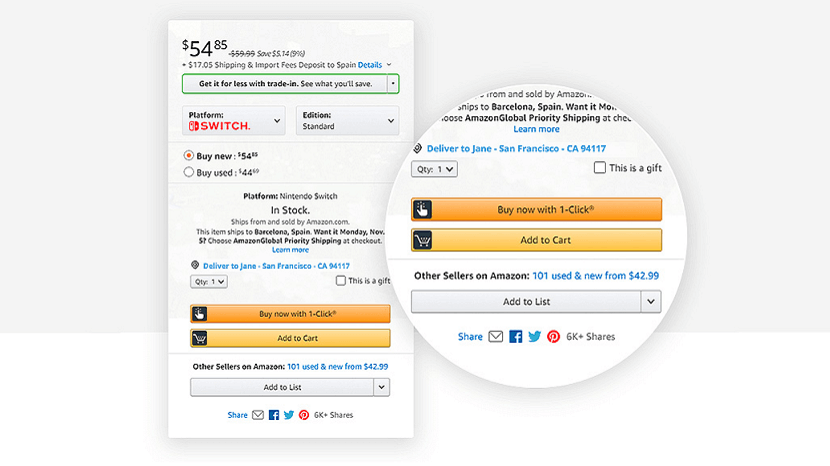
This streamlined checkout process eliminates the need to enter payment information repeatedly, making it easier and faster for customers to complete purchases. This convenience has contributed to Amazon's success, driving sales and customer loyalty.
2. Contactless Payments
Have you ever simply tapped your card or phone on a reader to pay? That's the beauty of contactless payments. This technology has exploded in popularity, especially during the pandemic when we all sought ways to minimize contact. But even beyond hygiene, contactless payments offer a faster, smoother checkout experience that customers love.
From a marketing perspective, contactless payments are a win-win. They reduce friction at checkout, which leads to happier customers and fewer abandoned carts. But they also offer a treasure of data. By analyzing contactless payment data, businesses can gain insights into peak shopping times, popular products, and even customer demographics, says Noam Friedman, CMO of Tradeit.
Plus, contactless payments open the door to innovative marketing tactics. Imagine receiving a special offer on your phone as you tap to pay at your favorite store, or being able to collect loyalty points with a simple tap. Contactless payments are not just a trend — they're a way that's reshaping the way businesses connect with their customers.
3. Buy Now, Pay Later (BNPL)
“Buy now, pay later (BNPL) services have taken the shopping world by storm. These platforms, like Klarna, Affirm, and Afterpay, let you split your purchase into smaller, interest-free installments. This flexibility appeals to budget-conscious shoppers and those who want to avoid credit card debt.
For businesses, BNPL reduces cart abandonment rates, as customers are more likely to complete a purchase if they know they can pay over time. It can also increase average order values, as shoppers may be tempted to add more to their carts when the cost is spread out,” says Don Evans, CEO of Crewe Foundation Services.
But BNPL's impact goes beyond just sales. It's also about building customer relationships. By offering a flexible payment option, businesses show that they understand and cater to their customers' financial needs. This builds trust and loyalty, leading to repeat purchases and positive word-of-mouth.
BNPL is also a goldmine of data. By analyzing purchase patterns and payment behavior, businesses can gain valuable insights into customer preferences and financial habits. This information can be used to create even more targeted marketing campaigns and tailor product offerings to specific customer segments.
4. Cryptocurrency and Blockchain
Cryptocurrency and blockchain technology are shaking up the financial world, and their impact on marketing is just beginning to unfold. Cryptocurrencies like Bitcoin and Ethereum offer a decentralized, secure, and borderless way to make payments.
One of the most exciting aspects of cryptocurrency for businesses is the potential for direct, peer-to-peer transactions. This eliminates the need for intermediaries like banks, reducing fees and allowing for faster, more efficient payments. From a marketing perspective, this could lead to new ways to engage with customers, such as offering exclusive discounts or rewards for using cryptocurrency.
Blockchain, the technology behind cryptocurrency, offers even more possibilities. Its decentralized nature and tamper-proof record-keeping make it ideal for creating transparent and secure loyalty programs, tracking the provenance of products, and even verifying the authenticity of digital assets.
But cryptocurrency and blockchain are still growing, and there are challenges to overcome. The volatility of cryptocurrency prices, regulatory uncertainty, and the need for consumer education are all factors that businesses need to consider.
5. Biometric Authentication
Forget PINs and passwords — biometric authentication is the next frontier in secure payments. Fingerprint scanning and facial recognition are becoming common ways to verify your identity and authorize transactions.
For consumers, this means faster, more convenient checkouts. A quick touch or glance is all it takes to pay, eliminating the need to fumble for cards or remember passwords. This frictionless experience can improve customer satisfaction and encourage repeat business.
Aleksander Nowak, Research Analyst at Highticket.io says, “From a marketing standpoint, biometric authentication can be a powerful tool for building trust and loyalty. Customers are more likely to trust brands that prioritize security and protect their personal information. By implementing biometric authentication, businesses can show their commitment to safeguarding customer data.”
Plus, biometric data can be used to personalize the shopping experience. Imagine walking into a store and being greeted by name, with personalized recommendations based on your past purchases. Biometric authentication can make this a reality, creating a more engaging and tailored shopping journey.
Winning Marketing Strategies in the Digital Payments
Here are the strategies.
1. Data-Driven Insights
Digital payments provide a wealth of data that businesses can use to create highly targeted and personalized marketing campaigns. By analyzing customer transaction data, companies can gain valuable insights into purchasing behavior, preferences, and demographics. This information can be used to tailor marketing messages, offers, and promotions to specific customer segments.
This smooth integration of digital payments with a loyalty program has resulted in increased consumer spending and a boost in app usage.
Dan Close, Founder and CEO at We Buy Houses in Kentucky says, “Data-driven insights also enable businesses to optimize their marketing channels and timing. By understanding when and where customers are most likely to make purchases, companies can strategically time their marketing campaigns and focus their efforts on the most effective platforms.”
2. Loyalty Programs and Rewards
Loyalty programs have long been a staple of marketing, but digital payments are taking them to the next level. By integrating loyalty rewards with digital wallets and payment apps, businesses can make it easier than ever for customers to earn and redeem points.
Think about how satisfying it is to see your points accumulate every time you tap your phone to pay. This instant gratification not only makes customers feel valued, but it also incentivizes them to keep coming back.
Digital loyalty programs offer businesses a wealth of data. They can track customer spending habits, identify their most loyal customers, and tailor rewards to individual preferences.
For example, Starbucks mobile app shows how digital payments can drive customer engagement and loyalty.
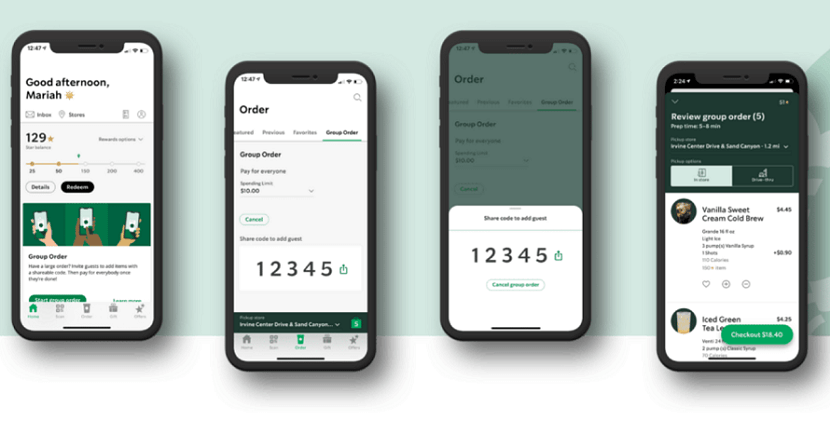
Customers can order and pay for their drinks ahead of time, earn rewards through the Starbucks Rewards program, and receive personalized offers based on their purchase history.
3. Social Media and Influencer Marketing
Social media platforms are a natural fit for promoting digital payments. These platforms are where consumers spend a lot of time, making them ideal channels for reaching a wide audience and generating buzz around new payment options, explains Danny Jay, Founder of Long Weekend.
Businesses can use social media to educate consumers about the benefits of digital payments, showcasing their convenience, security, and rewards. Engaging content, such as how-to videos, customer testimonials, and contests, can spark interest and drive adoption.
Influencer marketing is also good in the digital payments space. By partnering with popular social media figures, businesses can tap into their established audiences and use their credibility to promote digital payment solutions. When an influencer you trust raves about the convenience of a mobile wallet or the benefits of a BNPL service, you're more likely to give it a try.
Moreover, social media and influencer marketing can help to humanize digital payments, making them more relatable and less intimidating for consumers. By showcasing real people using these payment methods in their everyday lives, businesses can create a sense of familiarity and trust.
4. Omnichannel Marketing
Today's consumers move between online and offline channels — expecting a consistent experience no matter where they interact with a brand. Digital payments are a key enabler of omnichannel marketing, allowing businesses to create a unified customer journey across all touchpoints.
Imagine browsing for shoes on your phone, adding a pair to your cart, and then heading to the store to try them on. With a mobile wallet, you can effortlessly complete the purchase in-store, and the retailer can track your entire journey, from online browsing to in-store purchase. This valuable data allows for a more personalized shopping experience, whether you're online or offline.
Omnichannel marketing is also about delivering consistent messaging and promotions across all channels.
For example, Nike has used omnichannel marketing by integrating digital payments across its online and offline channels. Customers can browse products online, reserve items for in-store pickup, and pay using their mobile wallet at checkout.

This integrated approach provides a convenient and personalized shopping experience — whether customers are shopping online or in-store.
5. Location-Based Marketing
With digital payments, your phone becomes more than just a wallet — it's a map to personalized deals and offers. Businesses can use location data from mobile wallets and payment apps to send you targeted promotions when you're near their stores or in specific areas, says Martin Seeley, CEO of Mattress Next Day.
Imagine walking past your favorite coffee shop and receiving a notification for a buy-one-get-one-free offer on your phone. Or maybe you're strolling through a mall and a pop-up ad appears for a discount at a store you've been meaning to check out. This is location-based marketing in action, and it's changing the way businesses interact with customers in the real world.
By using location data, businesses can make their marketing messages more relevant and timely. They can target specific demographics based on where they live, work, or frequent, and deliver offers that are tailored to their interests. This not only increases the likelihood of engagement but also enhances the overall customer experience.
Location-based marketing is particularly effective for brick-and-mortar businesses, as it helps drive foot traffic and encourages impulse purchases. But it's not just for physical stores. Restaurants can use it to promote daily specials, event venues can send out last-minute ticket offers, and even service providers like hair salons can entice customers with location-based discounts.
Challenges and Considerations
While digital payments offer a wealth of opportunities for businesses and consumers alike, they also come with their fair share of challenges and considerations. As we use financial transactions, it's crucial to be aware of the pitfalls and take steps to mitigate the risks.
1. Security Concerns
Security is perhaps the most pressing concern when it comes to digital payments. The digital nature of these transactions makes them vulnerable to fraud, data breaches, and cyberattacks. Hackers are looking for ways to exploit vulnerabilities in payment systems, putting sensitive financial information at risk.
To address these concerns, businesses and payment providers are investing heavily in security measures. Encryption, tokenization, and two-factor authentication are just a few of the technologies being used to protect customer data. Plus, regulatory bodies are imposing stricter security standards on businesses that handle digital payments.
According to David Martinez, VP Enterprise & OEM Accounts at Cybernet Manufacturing, “As a consumer, you can also take steps to protect yourself. Be cautious about sharing your payment information online, use strong passwords, and be wary of phishing scams. By staying vigilant and practicing safe online habits, you can minimize your risk of becoming a victim of fraud.”
2. Regulatory Landscape
The world of digital payments is constantly growing, and so are the regulations that govern it. Governments and financial institutions are working to establish clear rules and guidelines to ensure the safety and security of digital transactions.
For businesses, keeping up with these ever-changing regulations can be a challenge. It requires a thorough understanding of the legal landscape and a commitment to compliance. Failure to comply with regulations can result in hefty fines, reputational damage, and even legal action.
Consumers also need to be aware of the regulatory framework surrounding digital payments. Understanding your rights and responsibilities as a consumer can help you make informed decisions about how you use digital payment methods and protect yourself from potential risks, says Distasio Personal Injury Lawyers.
3. Technological Infrastructure
The success of digital payments hinges on a robust and reliable technological infrastructure. This includes everything from secure payment gateways and processing systems to user-friendly interfaces and mobile apps.
Businesses need to invest in the right technology to ensure smooth and secure transactions for their customers. This may involve partnering with reputable payment providers, implementing the latest security protocols, and regularly updating their systems to stay ahead of evolving threats.
For consumers, a reliable technological infrastructure means being able to access and use digital payment methods easily and without interruption. It also means having confidence that their transactions are secure and their personal information is protected.
4. Consumer Adoption
While digital payments are becoming popular, there's still a portion of the population that is hesitant to grab them. Concerns about security, privacy, and the learning curve associated with new technologies are some of the main barriers to adoption.
To overcome these challenges, businesses need to focus on educating consumers about the benefits of digital payments and addressing their concerns head-on. This could involve offering incentives for using digital payment methods, providing clear instructions and tutorials, and highlighting the security measures that are in place to protect customer data.
- David Carter, Personal Injury Attorney at Gould Cooksey Fennel
Wrap Up
So, it's clear that digital payments aren't just a passing trend — they're here to stay and they're changing the way we shop and interact with brands.
For businesses, these changes mean a new way to reach customers and build lasting relationships. While there are challenges ahead, the possibilities are exciting. The future of marketing is digital, and it's happening right now.
If you found this article helpful, we encourage you to share it on your social media platforms—because sharing is caring! For more information about article submissions on our website, feel free to reach out to us via email.
Send an emailWritten by RGB Web Tech
Latest Technology Trends
Latest technology trends shaping the future, including AI advancements, blockchain innovation, 5G connectivity, IoT integration, and sustainable tech solutions. Explore breakthroughs in quantum computing, cybersecurity, augmented reality, and edge computing. Stay ahead with insights into transformative technologies driving innovation across industries and revolutionizing how we live, work, and connect.
How Real-Time Tracking Improves Task Management
Last updated on January 19, 2025 by RGB Web Tech
The wisdom ‘time is money’ is one that has been sung again and again. Still, even with the tune humming in the back of our minds, most of us often find ourselves in last-minute scrambles, wishing the gods of time would smile down on us and reverse the clock just a few minutes or hours so we can do whatever we’d promised to do. Sometimes, you get sidetracked by distractions or fear of failure. Other times, it’s because we just find increased motivation when under pressure and have, therefore, developed a habit of doing things last minute.
However, many times, it’s just an issue of slacking oversight or misjudging how long a task will take, leading to poor planning. If only there were a way to streamline workflow, visualize time investment, and boost individual or overall team productivity. Oh, you know what? There is something like that, after all. It's called real-time task management – and while the sound of real-time project tracking might make some people nervous, those who’ve already understood it using the best time tracking software know it’s not about getting obsessed with time or the boss breathing down your neck.
No, real-time tracking is not one of those nightmarish situations. It comes from the data brigade and is concerned with getting data on workflow and productivity to improve processes and efficiency. If you haven’t embraced it, it’s time to understand it.
What’s real-time task management?
Real-time task management involves using digital tools to track, manage, and update tasks as they unfold. It’s different from basic project tracking, where you simply log task completion time. Instead, real-time tracking endeavors to capture the moment-to-moment flow of the workday, revealing much-desired insights into one’s processes and time allocation.
Depending on the business, it can be a whole lot of projects on its own, with software, dashboards, and notifications.
The best time tracking software provides many features without overwhelming users. It is easy to use, allows for customization, and integrates with existing software to form a robust task management solution.
Advantages of Real-Time Tracking in Project Management
Real-time tracking allows project managers or each team member to record hours spent on individual tasks and create a timeline of their projects. Project managers, businesses, and employees could benefit from the habit of tracking work time using real-time tracking software.
Lastly, real-time tracking is for everyone. It can help individuals and teams identify and address impediments to work, including distractions, communication issues, and lack of collaboration.
It helps managers identify issues such as red tape, insufficient resources, or even a problematic employee. Overall, real-time tracking keeps things running and leads to improved efficiency and productivity.
Wrapping Up
While real-time tracking may give employees the shivers, it’s not about micromanaging or instructing your team to start obsessing over time. You are not monitoring things to second-guess their decisions and dictate details. It’s about using data insights to improve workflow and achieve goals on time.
Once you help them understand this, they’ll be much more inclined to use whatever tools you provide to track their time and generate useful reports. If you can embrace real-time tracking, check out the best time tracking software available.
If you found this article helpful, we encourage you to share it on your social media platforms—because sharing is caring! For more information about article submissions on our website, feel free to reach out to us via email.
Send an emailWritten by RGB Web Tech
Latest Technology Trends
Latest technology trends shaping the future, including AI advancements, blockchain innovation, 5G connectivity, IoT integration, and sustainable tech solutions. Explore breakthroughs in quantum computing, cybersecurity, augmented reality, and edge computing. Stay ahead with insights into transformative technologies driving innovation across industries and revolutionizing how we live, work, and connect.
Top-Rated Cloud Hosting Services: A Review
Last updated on January 19, 2025 by RGB Web Tech

Cloud hosting has become a technologically indispensable tool for all businesses in today's digital world. Taking full advantage of low cloud server cost allows organizations to access scalable, reliable, and cost-effective forms of cloud hosting solutions. However, it is sometimes very difficult to pick the best cloud hosting service considering a litany of providers.
In this blog post, we're going to dive into some of the top-rated web hosting cloud services and give detailed insights into the major features, pricing, and target audience. We will also discuss all the must-have factors that determine your choice of service, thereby guaranteeing that you find the right cloud hosting solution for your business.
Considerations while choosing cloud hosting providers
A few key factors come into play when choosing a cloud hosting service. These can make or break the difference between success and failure for your website. So here are the key considerations that help you select the right cloud hosting service:
Scalability
Organizations majorly opt for cloud hosting because they need scalability. Scalable cloud hosting means you can scale up your resources according to your requirements without having your website crash. A good cloud hosting service provider like MilesWeb makes it a seamless process without complicated configurations or even downtime.
Reliability
Websites must be up and available to the users at all times. A reliable provider invests in very high-tier infrastructure, including a lot of data centers with redundant systems and failover mechanisms that would prevent outages and hence promise uptime guarantees of 99.9% and higher.
Performance
Go for a service provider, for instance, MilesWeb, that offers you unmetered bandwidth, low latency, and performance-optimized servers so that you'll be able to handle the traffic from your website. Low load times can negatively affect your SEO rankings, decrease user engagement, and even the overall conversions of your site. Hence, investing in a high-performance cloud hosting service is fully justified.
Cost
The cost is another very crucial factor when choosing a cloud hosting provider. Many providers are offering tiered pricing packages but including hidden fees that increase charges over time. A good host must ensure the right balance between affordability and the features that meet the needs of your business.
Security
First and foremost, security is a primary point when choosing the best cloud hosting service. Any business that operates online is vulnerable to hacking, data breaches, and malware attacks. Your secure cloud hosting provider must have adequate security features that protect websites from hackers. Users go for providers such as MilesWeb, as they secure your website and data with firewalls, encryption, multi-authentication, DDoS protection, and regular updates for security.
Customer Support
Responsive and knowledgeable customer support will make your cloud hosting journey effortless.
Consider a hosting provider that not only offers 24/7 customer support but also multiple channels like live chat, email, or phone. Good customer service will enhance the experience with a hosting provider at a time of critical problems.
Additional Features
In addition to the basic services, a good cloud hosting service provider should provide some value-added features. Some of the core features that you must check out include managed services, content delivery networks, automated backups, SSL certificates, migration services, domains, and more. These features make your hosting experience enriching as well as convenient for managing your website.
Top 4 Top-Rated Cloud Hosting Service Providers
1. MilesWeb
Cloud Features:
2. Hostinger
Cloud Features:
3. HostGator
Cloud Features:
4. A2 Hosting
Cloud Features:
Bottom Line
Choosing a cloud hosting service is one of those key decisions that online businesses demand. In the above blog, we have presented a quick review of the leading cloud server providers. With a comparison of their features, plans, prices, and more, you can get a holistic view of your choice.
Among them, MilesWeb tackles the lead as they offer the most suitable hosting plans with the best prices, impeccable features, and unmetered resources.
Whether you are a beginner or an expert, you’ll find MilesWeb’s cloud hosting servers suitable for your various needs. Be sure to balance the need for scalability, reliability, performance, cost, security, and customer support in making your selection. The options listed here are all diverse in solution but best cater to your needs.
If you found this article helpful, we encourage you to share it on your social media platforms—because sharing is caring! For more information about article submissions on our website, feel free to reach out to us via email.
Send an emailWritten by RGB Web Tech
Latest Technology Trends
Latest technology trends shaping the future, including AI advancements, blockchain innovation, 5G connectivity, IoT integration, and sustainable tech solutions. Explore breakthroughs in quantum computing, cybersecurity, augmented reality, and edge computing. Stay ahead with insights into transformative technologies driving innovation across industries and revolutionizing how we live, work, and connect.
Black Friday Web Hosting Deals: A Comprehensive Guide
Last updated on January 19, 2025 by RGB Web Tech

Black Friday has evolved into one of the most significant anticipated events for shoppers and businesses, offering incredible discounts on various products and services. Web hosting service providers participate by providing some of their important price cuts of the year, making it a prime time for businesses, entrepreneurs, and bloggers to secure high-quality hosting at a fraction of the regular cost. From shared hosting to dedicated server hosting comes under the Black Friday hosting offers to save operational costs for website owners.
In this festive season, securing a reliable web hosting service provider at a reduced cost. Securing a reliable hosting service at a reduced cost can provide website owners with essential features that support growth, improve loading speeds, and enhance security. This guide dives into the top Black Friday deals that give the cheapest web hosting per year.
Best Black Friday Web Hosting Deals
1. Shared Hosting Deals
Shared hosting is an ideal choice for small websites, personal blogs, and new businesses that don’t require extensive resources. On Black Friday, shared hosting packages are discounted up to 70%-90%. MilesWeb is a reliable web hosting service provider that gives 80% off on shared hosting plans. These web hosting plans are mostly configured for entry-level plans at unbeatable rates. It enables users to access essential features like SSL certificates, one-click installations, and round-the-clock customer support.
These Black Friday discounts mean that for just a few dollars a month, users access the quality of the web hosting environment without the need for heavy initial expenses. Additionally, some providers extend special add-ons or freebies during this period, like extra storage or marketing credits, making shared hosting an even more appealing choice for newcomers to web hosting.
2. VPS Hosting Deals
For websites that require more control and flexibility than shared hosting can offer, virtual private servers (VPS) provide a solid alternative. Black Friday often brings up to 49%-64% off VPS hosting plans, making it affordable for medium-sized businesses and websites with moderate traffic.
VPS hosting deals during Black Friday typically include generous CPU and RAM allocations, enhanced security features, and scalable resources to support website growth. These offers provide users with an opportunity to upgrade from shared hosting to VPS without too much of a cost. It makes an ideal time for businesses expecting to expand their online presence.
3. Managed WordPress Hosting Deals
Many web hosting service providers offer managed WordPress hosting, a specialized service customized to WordPress users that provides optimized speed, security, and ease of use. On Black Friday, discounts for managed WordPress hosting can reach 80% or more. It makes an affordable option for bloggers and businesses heavily invested in the WordPress ecosystem.
Many advantages are offered by managed WordPress hosting to users who will focus on content creation rather than on website maintenance. Black Friday discounts allow users to enjoy time-saving features and better performance at a lower cost; managed WordPress hosting is therefore a great choice for any scale-up of websites based on WordPress.
4. Cloud Hosting Deals
For businesses looking for scalable and reliable hosting, cloud hosting offers a flexible solution, as resources can be adjusted to match traffic demands. Black Friday web hosting deals by MilesWeb bring 60%-71% off on the cloud hosting services. Cloud hosting deals include benefits such as high availability, improved performance, and ease of scalability, perfect for websites with fluctuating traffic or large resource demands.
Utilizing cloud hosting deals guarantees that a business website is designed to handle peak traffic times without resultant downtime, which happens to be the most vital factor for all online retail sites during holidays. The pay-as-you-go structure followed by cloud hosting further enables users to optimize costs, which itself takes the form of a cost-saving measure while coupled with discounts during Black Friday.
Summing Up
Black Friday is the perfect time to get a robust hosting plan at an affordable price that ensures the best performance. Whether you are running a small business, you're a blogger or a large enterprise company, Black Friday web hosting deals present the perfect opportunity to get the robust features and solid service that will go a long way in serving your needs for better website performance and a seam-free user experience.
Utilize the limited deals today to get every value from your web hosting investment. The best Black Friday deal for you will highlight your website's performance and secure it with robust strength while ensuring scalability, thus making it set up to thrive in the future. Since web hosting is a base upon which your website's reliability and growth are laid, discounts like these are an invaluable resource for many online businesses that thrive in the digital landscape.
If you found this article helpful, we encourage you to share it on your social media platforms—because sharing is caring! For more information about article submissions on our website, feel free to reach out to us via email.
Send an emailWritten by RGB Web Tech
Latest Technology Trends
Latest technology trends shaping the future, including AI advancements, blockchain innovation, 5G connectivity, IoT integration, and sustainable tech solutions. Explore breakthroughs in quantum computing, cybersecurity, augmented reality, and edge computing. Stay ahead with insights into transformative technologies driving innovation across industries and revolutionizing how we live, work, and connect.
Exploring Python Through Mobile Applications
Last updated on January 19, 2025 by RGB Web Tech

Python-what a beautiful name! But oh boy, is it a tough language to comprehend? Yes, sir! For beginners, Python is a programming language renowned for its widespread popularity and global demand. Its versatility is evident as it finds applications in various fields such as Data Science, Big Data, and software development. In recent years, Python's popularity has surged, attracting thousands of individuals eager to enhance their programming skills.
If you are among those aspiring to learn Python, you have come to the right place. This post aims to spotlight leading mobile applications that facilitate efficient and accelerated Python learning. Many of these apps are available for free, alleviating concerns about budget constraints. Your primary expense will likely be your internet connection, so it's advisable to opt for a reliable provider.
If you are seeking recommendations in this regard, looking up fiber internet near me will help you find the most reliable fiber internet providers in no time. Make sure the reviews are good, the plans affordable, and customer services reliable.
Having that said, once your internet connection is secured, the next step is to download these apps. Below, we have gathered a list of some of the finest apps to aid you in mastering Python:
1. Mimo
Mimo stands out as an exceptional app for learning Python and various other programming languages. Renowned for its simplicity and high-quality learning experience, this amazing app covers the entire Python curriculum, making it a favorite among developers worldwide.
One of Mimo's key features is its interactive exercises and built-in code playground, allowing users to practice coding in a dynamic environment. Additionally, the app enables users to set personalized learning goals and embark on real-world project development journeys. For those interested in web development, Mimo offers comprehensive resources to facilitate skill acquisition in this domain.
Moreover, Ezoic, the platform boasts user-friendly interfaces and a range of tutorials tailored for learners at every level, from beginners to advanced practitioners. With its interactive exercises and playground, Mimo provides a hands-on approach to learning, fostering deeper understanding and skill mastery.
Talking about additional features, Mimo offers a wealth of resources to enhance the learning experience. Whether accessed through the app stores or their website, Mimo provides a convenient platform for individuals eager to delve into Python and beyond.
2. Online Python Tutorial
For Python enthusiasts seeking comprehensive study materials, this app offers a tailored solution. Crafted with professionals, high school, and college students in mind, it provides offline access to study materials, eliminating the need for a constant internet connection or a computer. Bursting with features for learning Python coding, such as free offline notes, a coding compiler, and an extensive question bank with solutions, this app serves as a one-stop destination for Python programming education.
Particularly beneficial for students preparing for board exams or interviews, it sets itself apart with exclusive features like past years' exam question banks and frequently asked interview questions, all accessible offline without interruptions from advertisements.
3. DataCamp
This stands out as a comprehensive learning platform for Python, R, and SQL. Catering to data scientists and Python beginners alike, it offers problem statements tailored to learners' skill levels, accompanied by certificates upon lesson completion. With just 5 minutes a day, students can delve into Python and data science, benefiting from free lessons, interactive challenges, and quizzes designed to enhance data analysis skills.
4. CodeHub
For those committed to rapid and effective coding mastery, CodeHub offers an exceptional platform. With each course comprising 50 lessons, learners can tailor their learning experience to their preferences. Featuring four levels of lessons, individuals can focus on their strengths in each department and bypass basics if they are already familiar with coding. This flexibility in course structure provides a wealth of information to suit diverse learning styles.
5. Programiz
Ideal for beginners, Programiz offers an intuitive platform for learning Python. Featuring an interactive code editor and practical example projects, it facilitates hands-on learning. Additionally, the app provides challenges and quizzes suitable for learners of all levels, consolidating essential Python knowledge. Available for download from their website or app stores, Programiz also offers resources in other programming languages, making it a versatile choice for aspiring coders.
Learning Python is a valuable endeavor in today's technology-driven world, regardless of one's motivations. As a fundamental skill, programming proficiency opens doors to countless opportunities. Starting with mastering basic syntax and progressing to small projects is an effective approach. Exploring courses and projects aligned with personal interests further enhances learning. Ultimately, hands-on experience through project work strengthens resumes and solidifies Python proficiency.
If you found this article helpful, we encourage you to share it on your social media platforms—because sharing is caring! For more information about article submissions on our website, feel free to reach out to us via email.
Send an emailWritten by RGB Web Tech
Latest Technology Trends
Latest technology trends shaping the future, including AI advancements, blockchain innovation, 5G connectivity, IoT integration, and sustainable tech solutions. Explore breakthroughs in quantum computing, cybersecurity, augmented reality, and edge computing. Stay ahead with insights into transformative technologies driving innovation across industries and revolutionizing how we live, work, and connect.
How an AI to Human Text Converter is Revolutionizing Communication
Last updated on January 19, 2025 by RGB Web Tech

Artificial intelligence has been changing different industries in recent years, and one of the most interesting applications is the AI to Human Text Converter. This tool helps bridge the gap between complex AI-generated text and human-friendly language. With the help of this technology, AI can create content that sounds natural and conversational, thus making it easier for humans to understand.
AI to Human Text Converters are quite popular in generating text that is both lucid and interesting. Businesses, educators, and content developers can, therefore, use these converters to produce better-quality communications. The software ensures the output follows how a human would articulate it, which is helpful in improving the user experience.
How does AI to Human Text Converter work?
This advanced NLP algorithm is in fact AI to Human Text Converter which changes the tone, style, and complexity of the text. It is basically something which turns technical or machine-like language into something that can be a bit more relatable and conversational. Therefore, this means that AI is going to analyze the text, break it down to smaller elements, and then rewrite it in a manner where it would be more human-like.
It learns from vast amounts of data, even written text that it draws from real conversations that people engage in in real life. This way, it may be able to imitate the way people talk and write. Thus, this can make its production easy to read and nontechnical jargon nonrobotic.
Benefits of Using AI to Human Text Converter
One of the great benefits that a Human Text Converter affords is efficiency. A blog post, a social media update, or just an update for a customer service message saves time and gives out text really quickly. This avoids rewriting for too long, so you may do more important things in its place.
Another very significant benefit is access. Sometimes, text created by AI can be really hard to understand, especially when technical subjects are the subject. An AI to Human Text Converter helps alleviate this by converting jargoned language into something everybody can understand. It increases access to information among people.
Why Businesses Need AI to Human Text Converters
Communication is the connection to an organization. Market material, customer support information, or in-house documents-mean whatever a company writes-can be the victory or defeat for the organization as regards its relationship with the customer. With the AI-to-human text converter, businesses make sure their message gets cut across and reaches the intended receiver.
This can further increase the satisfaction level of customers with such a service provided by AI to Human Text Converters. To get support, the customer waits for clear and useful answers. AI will support this by providing texts with a human voice tone, thereby giving a much better feel of customer service. With this, frustration drops to zero, and businesses obtain trust from their clients.
How AI to Human Text Converter Improves SEO
It is incomplete in online content creation without SEO, and a Human Text Converter would be very helpful in ranking high in SEO. The generation of human-friendly text that flows well and engages will help create informative and readable content.
That one's of value to its user is the content that rather be preferred by search engines such as Google. The likelihood of which is that too technical and even complicated web contents would never come first on the SERPs is very great. A conversion into an AI-to-Human text converter would most certainly make the content to become read, thereby increasing a possible share and linking or getting ranked high in the SERPs.
Future for the AI to Human Text Converters
Future of AI to Human Text Converters looks very promising. With the advancements of AI, we will look forward to even much advanced tools which would generate even close to indistinguishable texts from the human writing. Such technologies have impacts on such industries as customer support, content creation, and education.
More future improvements will include personalizing AI. It may make adjustments to particular writing styles, better understand the meaning of words in context, and generate text that imitates the voice of its user. Such customization levels will make AI to Human Text Converters even more priceless.
Conclusion
In conclusion, AI to Human Text Converters open new dimensions in human communication in the digital world. They change awkward and machine-generated text into coherent and natural language further enhancing efficiency, accessibility, and engagement. It could be either improving the service operations of customer service or simply creating SEO-friendly content material, Human Text Converters have proven to be extremely resourceful.
With the ability to enhance communication and save time, AI Human Text Converters are among the most important technologies of the future. The future will surely see greater progress in the AI industry as the converters become even more effective and user-friendly.
You can make your content more accessible, human-like, and engaging with the help of a Human Text Converter. Apply these tools to write emails, create blog posts, or manage customer service, and deliver better communication with a better chance of success for your brand.
If you found this article helpful, we encourage you to share it on your social media platforms—because sharing is caring! For more information about article submissions on our website, feel free to reach out to us via email.
Send an emailWritten by RGB Web Tech
Latest Technology Trends
Latest technology trends shaping the future, including AI advancements, blockchain innovation, 5G connectivity, IoT integration, and sustainable tech solutions. Explore breakthroughs in quantum computing, cybersecurity, augmented reality, and edge computing. Stay ahead with insights into transformative technologies driving innovation across industries and revolutionizing how we live, work, and connect.
User Interface Design Tips for Better User Experience
Last updated on January 19, 2025 by RGB Web Tech

User interface is very important for producing aesthetic satisfaction for clients. Great UI can fill the gap between a purely technical side of an application and its functionality. User interface design is mostly about usability, utility, and desirability. This is why it is applicable for businesses to invest in great UI designs. Tips like using exhibition lightboxes can come in handy.
Let us look at some great user interface design tips for creating a better user experience.
User-centered user interface design
A user-centered interface design is one that revolves around incorporating the preferences and needs of end-users. This means that designers have to first research and understand the needs, goals, and preferences of clients and then use this information to come up with a user-interface design. Listening to clients’ suggestions is the key for creating a user-centered interface design. Doing this will help with improving usability and increased user-satisfaction.
Accessibility
Accessibility is very important when it comes to satisfying the needs of users. Mobile UI designs help with promoting accessibility. By providing an accessible UI design, you will be able to broaden your user base, create a good reputation for your brand on the market, and result in higher user satisfaction. In addition to mobile UI designs, you should also consider designing solutions for users with disabilities and impairments. For example, for clients with visual impairments, you can consider design elements like adding screen readers, enlarged texts, and text alternatives.
Using linear gradients for showing contrast
When designing content, creating visual contrast between different elements can help a lot with promoting a better user experience. You can create contrast by adding a linear gradient to your design. For instance, if you have a design with a heading and background images, you can add a linear gradient on top of the background image to create contrast.
Make sure the system status is visible
Users need to be able to keep track of what is going on throughout their experience with a product or service. So, you can improve user experience by making a system status that is visible. This will help clients understand the outcome of their prior interactions with your product so that they can decide on their next steps intuitively. This will prevent hassles like having to think too hard about the process.
Give users control and freedom
Users require clear market instructions to avoid accidental and unwanted actions. This will save them time by preventing redos of entire processes. It will also give them more control and freedom, which will eventually foster trust in your product or brand. Furthermore, it will help reduce frustrations and any negative feelings that may prevent users from viewing your brand and products as user-friendly.
Error prevention
Users get frustrated when trying to interact with a product or a brand and they keep receiving an error message. User interface designers can prevent this issue by preventing errors before they occur. It is possible for UI designers to find and eliminate error-prone functions during the testing process before product launches. By doing so, UI designers can promote a better user experience.
Flexibility is very important
UI designers can promote flexibility by providing shortcuts and customization options. For example, adding a customizable dashboard to a UI or shortcuts and touch gestures can help improve user experience by speeding up common functions and making users’ interactions with products more friendly. In addition to flexibility, consistency and uniformity can also come in handy. These elements of UI design can help build trust and intuition with users.
Minimalism is the way to go
Minimalist designs are very popular when it comes to UI. Such UI designs are ones that streamline an interface to only include vital information. This way, there isn’t much for clients to sieve through. Keeping unimportant components in a UI design can reduce visibility and negatively impact user experience. However, the design does not have to be boring. You can still make it aesthetically appealing while maintaining minimalism.
Final Word: Creating a better user experience with exhibition lightboxes
In addition to all the tips above, you can also create a better user experience for your clients by using lightboxes. They help create a visual appeal for your display. For instance, if you want to display your products on your exhibition stand, a lightbox will help bring attention to it by creating even illumination. A lightbox can turn into a powerful retain tool for your products and services. When thinking of ways to improve user experience with user interface design, you should always keep in mind the fact that the core focus of a user interface design is anticipating the needs of users so as to make their experience as intuitive and satisfying as possible.
If you found this article helpful, we encourage you to share it on your social media platforms—because sharing is caring! For more information about article submissions on our website, feel free to reach out to us via email.
Send an emailWritten by RGB Web Tech
Latest Technology Trends
Latest technology trends shaping the future, including AI advancements, blockchain innovation, 5G connectivity, IoT integration, and sustainable tech solutions. Explore breakthroughs in quantum computing, cybersecurity, augmented reality, and edge computing. Stay ahead with insights into transformative technologies driving innovation across industries and revolutionizing how we live, work, and connect.
SEO Companies for Attorneys: How to Tell You’ve Found the Right One
Last updated on January 19, 2025 by RGB Web Tech

As an attorney, you can join a law firm or start your own. Both have their benefits. Maybe you want to have autonomy. If so, then starting your own firm makes sense. However, signing on with an established one might also appeal.
Either way, you need clients if you’re going to stay solvent. That means marketing your legal services.
You can do that in many ways, but you should probably at least consider online marketing and SEO. You can hire a permanent employee who can handle your various SEO task, or perhaps you might engage a freelancer.
If you have a larger law firm, you might need to contact an SEO agency instead. You’ll often find that the best SEO companies for lawyers share some particular qualities.
In this article, we’ll talk about the qualities you’ll want to see from an SEO agency or company that can help your law firm attract more clients and improve its visibility.
What Does SEO Mean?
First, let’s describe the term “SEO” so you know what we mean. SEO means search engine optimization. You probably already know that when someone mentions search engines, they mean algorithms like Google or Bing.
You can use search engines free of charge. Google dominates this market. Some people prefer Bing for B2B interactions, but most people Google something if they need information.
Search engine optimization means that you’re improving your website so that more people visit it and interact with it. However, you also have some online SEO elements that don’t directly involve your website.
Though some business owners don’t know the first thing about SEO, that doesn’t mean they don’t need it. As a company owner or CEO, you should at least know about some fundamental SEO basics.
Why Do Lawyers Need SEO?
Lawyers definitely need SEO for their websites. The right SEO elements will drive more traffic your way. If you’re new to the industry, then that’s going to potentially help you a great deal.
Even if you operate a well-established law firm, though, you still need SEO both on your site and elsewhere online. Maybe you can’t attract as many clients as you’d like. Perhaps you don’t have the best industry reputation, and you must take steps to improve it.
That’s when you will want to hire someone who can help with your SEO. Again, it’s possible you might hire a fulltime SEO specialist if you have enough money in your payroll at the moment to do that. If you don’t feel like that’s the best option, you will want to locate and hire an SEO freelancer or agency.
Now, let’s talk about how you can feel confident that you have found the right SEO specialist or company to help you.
You Want an SEO Company That Can Operate Within Your Budget
SEO companies cost money, like virtually any other service. You must find one that can operate within your budget restraints.
In that respect, hiring an SEO company equates to hiring a plumber, or a roofer, or an electrician. You probably only have a certain amount of money to spend. You can’t go over that budget, so you need to locate a company that finds this amount acceptable.
You can shop around to see what prices, services, and packages some of the candidates have. Maybe you know someone who already has an SEO company working for them. If they give you a recommendation, then you can research this company to see if their pricing plans match your budget.
You Want a Company That Guarantees a Certain Amount of Engagement
SEO often means driving new customers to your website. You need that engagement. More site visitors typically mean more conversions. Conversions, in marketing parlance, mean individuals who visit your website and then purchase your products or utilize your services.
It’s hard to find an SEO company that can promise you a certain number of conversions. That’s unrealistic, since you never know whether someone might convert when they visit your site.
However, you should still find an SEO agency that can guarantee a particular number of new site visitors. That number, unique site visitors, often equates to new customers. The more site visitors you have, the more likely you will get at least a few conversions. It becomes a numbers game.
If an SEO agency guarantees a number of new site visitors per day, week, or month that sounds good to you, then you can hire them with a lot more confidence.
You Want an SEO Company That Keeps Up with the Latest Trends
You should also understand that SEO changes as time passes.. The industry-recognized best practices from ten years ago won’t resemble the ones you’ll see today.
SEO agencies should know that, and they should stay on top of industry trends. For instance, an SEO agency should know to modify your law firm’s Google listing if it has some incorrect information. They should know to add some professional-quality photos and videos to your website if you only have generic stock images at the moment.
An SEO agency might improve a law website’s copy to make it more engaging. They might add industry and location-specific keywords to that copy. They may add a company blog or social media buttons on the landing page if they feel that will help with engagement numbers.
Lawyers who try to improve their websites and off-site SEO without an individual or agency that has relevant, timely advice for them will often struggle to do that. SEO is such a complex, multifaceted industry. It’s constantly changing, and sometimes individuals or companies that make it their specialty must change strategies if what they’ve tried so far doesn’t work.
Law firms need to keep that in mind. If they ignore SEO, then they will probably fall behind. In such a competitive industry, that can spell disaster. By partnering with the right SEO company, a law firm can completely reverse its fortunes.
If you found this article helpful, we encourage you to share it on your social media platforms—because sharing is caring! For more information about article submissions on our website, feel free to reach out to us via email.
Send an emailWritten by RGB Web Tech
Latest Technology Trends
Latest technology trends shaping the future, including AI advancements, blockchain innovation, 5G connectivity, IoT integration, and sustainable tech solutions. Explore breakthroughs in quantum computing, cybersecurity, augmented reality, and edge computing. Stay ahead with insights into transformative technologies driving innovation across industries and revolutionizing how we live, work, and connect.
Benefits and Risks of Using API for Crypto Trading
Last updated on January 19, 2025 by RGB Web Tech

The adoption of APIs in cryptocurrency trading has revolutionized how traders interact with exchanges. A crypto API trading platform enables traders to execute transactions programmatically, automating repetitive tasks and offering precision in decision-making.
Crypto API Trading Explained
An API (Application Programming Interface) serves as a bridge between a trader and a cryptocurrency exchange. It allows traders to programmatically access exchange functionalities such as placing orders, monitoring market data, and managing account balances.
By using an API, traders can implement custom strategies, automate transactions, and even integrate third-party tools for advanced analytics. These functionalities have made API trading crypto a preferred approach for individuals and institutions aiming to streamline trading operations.
Advantages of API Crypto Trading
Here are the benefits you get when integrating APIs in trading:
Risks of Using Cryptocurrency Trading API
Consider these factors before using APIs:
To reduce these risks, traders should implement robust security measures, thoroughly test their strategies, and stay informed about exchange policies. By balancing the benefits and risks of API trading crypto, traders can optimize their operations and maintain a competitive edge in the cryptocurrency market.
If you found this article helpful, we encourage you to share it on your social media platforms—because sharing is caring! For more information about article submissions on our website, feel free to reach out to us via email.
Send an emailWritten by RGB Web Tech
Latest Technology Trends
Latest technology trends shaping the future, including AI advancements, blockchain innovation, 5G connectivity, IoT integration, and sustainable tech solutions. Explore breakthroughs in quantum computing, cybersecurity, augmented reality, and edge computing. Stay ahead with insights into transformative technologies driving innovation across industries and revolutionizing how we live, work, and connect.
How Tailored SEO Solutions Can Revolutionize HVAC Industry Growth
Last updated on January 19, 2025 by RGB Web Tech

The HVAC industry operates in a dynamic space where customer needs often arise unexpectedly, requiring swift solutions. In such a competitive market, simply relying on word-of-mouth referrals or traditional advertising methods can leave your business lagging behind. With the majority of consumers turning to search engines to find heating and cooling services, having a strong online presence is no longer optional—it’s essential.
Tailored SEO solutions provide HVAC companies with the tools to enhance visibility, attract more leads, and build credibility. By adopting a customized approach to SEO, HVAC businesses can unlock new opportunities and redefine their path to success.
Why HVAC Businesses Need SEO to Stay Competitive
The HVAC industry thrives on being accessible to customers who need immediate services. Whether someone’s air conditioner breaks down on a hot summer day or their heating system fails in the dead of winter, they’re likely to search online for the fastest solution. SEO (Search Engine Optimization) ensures that your business shows up when and where customers are looking.
Here’s why SEO is vital for HVAC businesses:
Crafting an SEO Strategy Unique to HVAC Services
Every HVAC business has its own set of challenges, goals, and customer demographics. A generic SEO plan won’t cut it. Instead, a tailored approach will ensure that your strategy aligns with your specific needs and market.
1. Focus on Seasonal Trends
HVAC services are often seasonal, with demand peaking during extreme weather. Tailored SEO can capitalize on these trends by optimizing for seasonal keywords like:
Publishing seasonal blog posts, running time-sensitive campaigns, and adjusting content based on weather patterns can help your business to stay relevant year-round.
2. Highlight Energy Efficiency Solutions
Modern customers are increasingly eco-conscious. Tailored SEO can position your business as a leader in energy-efficient HVAC solutions by targeting keywords like:
Educational content that explains how your services contribute to sustainability can attract environmentally conscious clients while establishing your authority.
3. Optimize for Voice Search
With the rise of smart speakers and voice assistants, customers are asking devices for help with phrases like, “Who can fix my heater nearby?” Tailored SEO should include long-tail, conversational keywords that align with voice search patterns to capture this growing segment of users.
4. Use Data to Drive Decisions
Tailored SEO isn’t just about implementing strategies—it’s about refining them. By analyzing customer behavior, you can uncover insights like:
Outsourcing SEO: A Smart Move for HVAC Companies
While some business owners attempt to handle SEO in-house, it often requires significant time, expertise, and resources. Outsourcing SEO strategies to a trusted partner allows HVAC companies to focus on delivering top-notch services while experts handle the complexities of optimization.
Outsourcing provides numerous benefits:
For example, partnering with a specialized service like www.clickintelligence.com ensures that your business benefits from tailored strategies designed to increase visibility and drive results.
Expanding Reach Beyond Local SEO
While local SEO is essential for targeting nearby customers, national strategies can help HVAC companies to expand their footprint. For businesses that offer specialized services or operate in multiple regions, focusing on broader keywords and content can unlock new growth opportunities. Here’s how:
Conclusion
Tailored SEO solutions offer a transformative way for HVAC businesses to grow, connecting with the right customers at the right time. From optimizing for voice search to leveraging seasonal trends and outsourcing to professionals, these strategies can help you to build a competitive advantage in a crowded market.
With the right approach, SEO doesn’t just boost visibility—it redefines success, creating a steady stream of loyal customers and setting the foundation for long-term growth. If you’re ready to take your HVAC business to the next level, consider investing in personalized SEO strategies that deliver measurable results.
If you found this article helpful, we encourage you to share it on your social media platforms—because sharing is caring! For more information about article submissions on our website, feel free to reach out to us via email.
Send an emailWritten by RGB Web Tech
Latest Technology Trends
Latest technology trends shaping the future, including AI advancements, blockchain innovation, 5G connectivity, IoT integration, and sustainable tech solutions. Explore breakthroughs in quantum computing, cybersecurity, augmented reality, and edge computing. Stay ahead with insights into transformative technologies driving innovation across industries and revolutionizing how we live, work, and connect.
Top Benefits of Omnichannel Contact Center for Agencies
Last updated on January 19, 2025 by RGB Web Tech

7 Key Benefits of Implementing Omnichannel Contact Center for Tech and Digital Agencies
A customer today is all about the quick and predictable flow of communication. There are always mounting high demands regarding the satisfaction of the clients part of the tech and digital agencies.
That is where the omnichannel contact center comes into the scene, which makes all the different platforms such as email, chat, and social media fall under one roof. Now, let's discuss how this might help the agencies improve their services and expand their business.
1. Contact Center Services Enhances Customer Experience
An omnichannel contact center ensures that everyone is catered to without missing a beat, allowing businesses to provide a seamless and unified experience across all channels. By leveraging cloud-based contact center solutions, businesses can integrate different communication methods into one system, offering a streamlined service.
One of the biggest benefits of omnichannel contact centers is a better customer experience. The first one is perfect communication. For instance, a customer makes a primary query via live chat on your website but then also sends a subsequent message via social media. The omnichannel system will guarantee that all conversations on various platforms are in front of your agents.
Well-pleased clients come back, and they become your agency's referral sources, but a good customer experience will build trust and loyalty, which is the backbone of long-run success in an industry as competitively brutal as technology and digital services.
2. Deeper Collection and Understanding of Data
The strength of an omnichannel contact center lies in its comprehensive data collection across all communication channels. Every type of interaction, whether it’s a live chat conversation, a remark through email, social networking, or any other platform, is stored in one centralized system.
This centralized data allows you to understand how different customers behave and what they want. For example, you may discover that most of your customers prefer live chats over emails. With this insight, you can allocate a larger portion of resources to your chat team and develop strategies to improve response times.
By monitoring patterns in customer inquiries, you can identify pain points or frequently asked questions. This will enable you to fine-tune your services, enhance your products, and create targeted marketing strategies. In simple terms, data from an omnichannel contact center helps you make smarter, data-driven decisions that benefit both your business and your customers.
3. Cloud Call Centers Stimulates Powerful Team Collaboration
The nature of communication tends to improve the quality of teamwork automatically when all forms of communication happen in one system. With cloud-based contact center solutions, all your team members gain access to real-time information, ensuring that nobody is confused about the customer's needs.
For example, suppose a customer who contacts your social media team requires the input of your IT team to solve a technical problem. In an omnichannel contact center, a social media agent can easily hand over the case with all the details to the IT team without hassle.
This collaboration at such a high level can facilitate the work of a large number of departments, allowing tasks to be executed simultaneously and efficiently, thus saving time for both your team and your customers. When each person within your company is aligned, customer concerns are solved quickly and with higher precision.
4. Omnichannel Contact Center Solutions: Improves Efficiency and Productivity
Handling numerous communication platforms independently would be chaotic and time-consuming for your team. They will constantly have to change between email, social media, and even customer relationship management software. All these factors not only waste time but also increase the likelihood of mistakes and delays.
An omnichannel contact center streamlines things by bringing all communication channels into one system. By utilizing cloud-based contact center solutions, agents can easily manage everything from a single dashboard. For example, if there is an urgent email coming while an agent is chatting with a customer on live chat, they can switch tasks without missing a beat.
Omnichannel contact center automation tools help boost productivity. Automated ticketing and the use of chatbots can address the simplest customer questions, allowing agents to focus on more complex issues.
By integrating the best call center software with your operations, your team can deliver faster, higher-quality support without juggling multiple platforms. This makes it possible for your contact center operations to run more smoothly, increasing both efficiency and customer satisfaction.
5. Increased Opportunities for Sales
Happy customers, for instance, will spend more and talk positively about your services. An omnichannel contact center ensures that you maintain the best relationship with your clients, as they are always listened to and cared for at all times.
However, the advantages don’t end there; the data that an omnichannel contact center collects can be used to identify sales opportunities. For example, if a client is repeatedly asking about a certain service or feature, you can follow up and offer them that service or feature directly.
Personalization is the key driver of sales. If the offer aligns with a customer's specific needs and preferences, that customer is more likely to accept it. With an omnichannel contact center, you can send targeted messages and promotions through the customer’s preferred channel, whether it’s email, SMS, or social media.
6. Cost Savings
The initial perception of any customer about employing an omnichannel contact center was that it is going to cost them an enormous amount but returns them huge over the course.
The omnichannel system reduces the need for additional staff as it streamlines processes with efficiency. An example of this is an automation tool such as a chatbot that can respond to simple customer inquiries about FAQs or direct a customer to another department. It will free up your team to focus on more complex and high-priority tasks.
Moreover, the centralized system will also avoid errors and communication misplacement which will be a nightmare to rectify. Your team will function smoothly, thereby saving you another very precious business resource: time.
7. Cloud-Based Contact Center Solutions Enhances Brand Image
Your brand image is one of your most valuable assets, and an omnichannel contact center can help you strengthen it. Being responsive and accessible across multiple platforms shows that your agency is professional, customer-focused, and forward-thinking.
Customers will have full confidence in your business the more they feel they can reach you anytime, through any platform. This confidence is reinforced by good word of mouth and quality online reviews, which are crucial factors in attracting new clients.
For a tech or digital agency working in a highly competitive environment, a strong brand image can help you stand out from the crowd. Consistently excellent service, facilitated by cloud-based contact center solutions and omnichannel contact center capabilities, is what positions an agency as an industry leader.
Conclusion
An omnichannel contact center enables tech and digital agencies to deliver a better customer experience, improve operations, and position them for growth. Whether you're big or small, this system will place your business at the forefront of the fast-moving world of today’s digital landscape.
It’s not just about keeping pace with customer demand but surpassing it to create a brand clients can trust and refer to. By leveraging cloud-based contact center solutions and advanced call center technology, you can enhance your customer engagement strategies and stay ahead of the competition.
FAQs
1. Is it difficult to deploy an omnichannel contact center?
Answer : No, many providers offer easy-to-implement solutions with training and ongoing support.
2. Are small agencies good candidates for an omnichannel contact center?
Answer : Yes, small agencies can become more efficient, develop better relationships with clients, and compete with bigger businesses.
3. What is the difference between a multichannel and an omnichannel contact center?
Answer : Multichannel would use different tools for each channel, while an omnichannel system integrates all channels as one seamless experience.
If you found this article helpful, we encourage you to share it on your social media platforms—because sharing is caring! For more information about article submissions on our website, feel free to reach out to us via email.
Send an emailWritten by RGB Web Tech
Latest Technology Trends
Latest technology trends shaping the future, including AI advancements, blockchain innovation, 5G connectivity, IoT integration, and sustainable tech solutions. Explore breakthroughs in quantum computing, cybersecurity, augmented reality, and edge computing. Stay ahead with insights into transformative technologies driving innovation across industries and revolutionizing how we live, work, and connect.
Revolutionizing Customer Support with Call Center Software
Last updated on January 19, 2025 by RGB Web Tech

How Call Center Software Drives Customer-Centric Innovations in the Web Industry
Businesses face the challenge of keeping up with rapidly changing customer expectations. Customers demand faster, more personalized service across multiple channels, and failure to meet these demands can lead to lost loyalty and revenue.
Modern call center software, especially cloud-based contact center solutions, is helping companies stay ahead by providing seamless, efficient, and customer-centric service.
This transformation is particularly significant in the web industry, where businesses must continuously innovate to meet ever-evolving customer needs.
Leveraging Omnichannel Integration to Enhance Customer Experience
The shift from traditional on-premise applications to cloud-based contact center solutions has enabled businesses to provide seamless customer support across multiple channels. This evolution from multichannel to omnichannel contact center solutions represents a significant leap forward in customer service technology.
Cross-channel Engagement
Modern CCaaS (Contact Center as a Service) platforms integrate voice, email, live chat, social media, and SMS channels into a unified interface. This integration ensures customers can reach out through their preferred communication method while maintaining conversation context across channels.
Customer Journey Mapping
Cloud-based contact center solutions track and respond to customer touchpoints in real-time. These platforms can analyze 100% of customer interactions, providing deep insights into customer behavior and preferences. This comprehensive view enables businesses to:
Proactive Support Strategies
By leveraging predictive analytics, modern contact center operations can anticipate and address potential issues before they escalate. This proactive approach has significantly improved customer satisfaction scores and reduced support costs.
Data-Driven Insights and Real-Time Decision Making
Cloud contact centers offer more than just communication capabilities by providing powerful analytics tools that turn data into actionable insights. Advanced call center technology improves customer satisfaction by analyzing real-time interactions, recognizing behavioral patterns, and using predictive modeling to anticipate customer needs. Automated sentiment analysis further enhances this understanding.
Additionally, cloud solutions enable continuous performance monitoring, allowing contact centers to track key metrics like average handling time, customer satisfaction scores, first contact resolution rates, and agent performance for optimization.
Automation and AI in Customer Service
AI-powered automation is transforming CCaaS platforms by enhancing efficiency and customer service. Chatbots and virtual assistants handle routine inquiries, offering 24/7 support, instant responses, and seamless escalation to agents. Intelligent automation reduces operational costs through features like smart routing, automated call distribution, and quality monitoring.
Also, AI enables personalized experiences by analyzing past interactions, predicting customer needs, and recommending actions based on customer history, ensuring tailored support.
Scalability and Flexibility: Enabling Growth in the Web Industry
Cloud-based contact center solutions offer unmatched scalability and flexibility, enabling businesses to handle fluctuating call volumes without compromising service quality. This adaptability is crucial during seasonal peaks, marketing campaigns, product launches, or unexpected surges.
Additionally, cloud systems enhance customer satisfaction by quickly implementing new features and adjusting to evolving preferences, ensuring personalized support. These platforms also facilitate global expansion, offering multilingual support, local number provisioning, and compliance management across regions.
Security and Compliance: Safeguarding Customer Data
Modern call center software incorporates robust security measures to protect sensitive customer information. Essential measures for data protection include end-to-end encryption, multi-factor authentication, frequent security audits, and safe storage of data. All these ensure that customer data remains unexposed even in the case of potential breaches.
On top of everything, cloud call center solutions are engineered to achieve compliance with GDPR, HIPAA, PCI-DSS, and local regulations concerning data protection. Such compliance standing helps businesses keep customer privacy and adhere to the corresponding standards and legal requirements.
Frequently Asked Questions
1. What technology can a call center use?
Answer : The operations at the call center can be made simpler using technologies such as ACD, IVR, CRM software, cloud-based systems, and especially AI-powered Chatbots, offering ease to their efforts toward contact handling processes.
2. How does call center software work?
Answer : Call center software manages calls both from inbound and outbound, routes them to particular agents, and integrates them with CRM. It allows for call recording, analytics, and reporting to extend improved service features.
3. How can technology improve customer service in contact centers?
Answer : Technology enhances services by allowing for quicker response times, personalization of interactions, 24/7 support using chatbots, efficient call routing, data analytics for insights, and omnichannel communication for a seamless customer experience.
Conclusion
Cloud-based contact centers are transforming customer service. Scalability, AI-powered automation, and analytics tools are giving companies the capacity to handle spiky demand while offering personalized support and optimizing performance in real-time.
With the ability to analyze customer interactions, predict needs, and monitor key metrics, companies can enhance customer satisfaction and drive operational efficiency. The flexibility and intelligence of cloud solutions ensure that businesses can adapt quickly to changing demands and maintain high service standards.
If you found this article helpful, we encourage you to share it on your social media platforms—because sharing is caring! For more information about article submissions on our website, feel free to reach out to us via email.
Send an emailWritten by RGB Web Tech
Latest Technology Trends
Latest technology trends shaping the future, including AI advancements, blockchain innovation, 5G connectivity, IoT integration, and sustainable tech solutions. Explore breakthroughs in quantum computing, cybersecurity, augmented reality, and edge computing. Stay ahead with insights into transformative technologies driving innovation across industries and revolutionizing how we live, work, and connect.
Boost Scalability with CCaaS for Growing Businesses
Last updated on January 19, 2025 by RGB Web Tech

How CCaaS Enhances Web Tech Scalability for Growing Businesses
Growing businesses encounter considerable challenges in scaling their operations while maintaining high-quality customer service. As demand rises, companies require solutions that can manage the surge in customer interactions without overloading their internal resources.
Contact Center as a Service (CCaaS) provides the scalability and flexibility necessary for efficient growth. In this blog, we will examine how CCaaS and cloud call center improves web technology scalability, enabling businesses to streamline customer service and enhance their growth potential.
Understanding the Scaling Imperative for Growing Businesses
As businesses grow, the need for scalable technology becomes paramount. Expanding operations often leads to an increase in customer inquiries, interactions, and support tickets. To keep up with these demands without sacrificing the quality of service, businesses must adopt flexible and scalable tech solutions. The benefits of CCaaS are particularly clear when it comes to managing customer interactions across various touchpoints.
The term technology scalability refers to the ability of a system to grow and remain effective under increasing loads. This means businesses can manage customer support through email, chat, social media, voice, and other channels while they grow. CCaaS solutions, often referred to as cloud call center platforms, allow companies to run operations without straining employees, which in turn prevents a slowdown in service response times.
How CCaaS Drives Scalable Customer Service Solutions
Adaptability and Flexibility of CCaaS
CCaaS can scale up or down according to the user's preferences. This is a cloud-based solution that can be further advanced for more users, places, and communication channels. Many CCaaS solutions include features commonly found in artificial intelligence call centers, helping businesses handle customer interactions more efficiently. The system can scale to meet new demands, so there is no need for businesses to constantly modify their infrastructure when they grow.
Rapid Deployment
With CCaaS, businesses can onboard new agents and open new locations or channels quickly. This means that when the need arises, businesses can deploy new services without significant delays, ensuring minimal disruption to customer service.
Customization
Their services include configuring the contact center communications in the manner the business requires. This includes setting up automated reply systems, business tool integrations, or modifying business communications channels. CCaaS, from a different angle, ensures the service quality of the business is not affected whilst meeting rising demands.
Real-time Insights
One of the more valuable advantages of using CCaaS is advanced analytics and reporting capabilities. By leveraging tools similar to those found in an artificial intelligence call center, firms can track various parameters, including agent performances, customer satisfaction, and call volume in real-time. This enables businesses to adjust responses instantly and deploy resources optimally for effective service delivery.
Cost Efficiency and Optimizing Resources with CCaaS
Scaling a business isn’t just about handling more interactions, it's about doing so efficiently and cost-effectively.
Lower Operational Costs
Unlike contact center solutions that operate on-premise, CCaaS has no appreciable capital outlay in hardware or software. It does not incur costly maintenance, infrastructure upgrades, and licensing fees. Instead, it charges a subscription fee that's directly proportional to the usage. It is thereby economical for growing businesses.
Resource Optimization
The use of CCaaS decreases the demand for large physical infrastructure, making it a preferred option among modern call center solutions. This enables businesses to expand operations without the need for extra equipment. Companies can grow their customer service teams quickly and efficiently by leveraging cloud-based tools that can be accessed from anywhere.
Predictable Expenses
Generally, CCaaS operates on a subscription model which ensures predictable monthly or annual charges to businesses. This thus allows the companies to project their spending and avoid any occurrences of unexpected financial constraints due to excessive growth.
Seamless Technology Integration for Enhanced Scalability
Integration with Existing Infrastructure
The CCaaS solution should seamlessly integrate with other existing business tools such as CRM, marketing automation platforms, and all customer service systems. Unlike traditional call center solutions, CCaaS enables businesses to enhance their existing infrastructure rather than starting from scratch, ensuring a smoother transition and improved efficiency.
Omnichannel Capabilities
Its strongest strength point is that CCaaS integrates multi-channel communications, hence unifying voice, email, chat, and social media on a single platform to bring improved management in customer interactions across various touchpoints. This capability is essential for efficient contact center management, allowing businesses to handle all communications seamlessly without forming silos or disrupting the conversation.
Enhancing Customer Experience While Scaling Operations
As businesses scale, maintaining an exceptional customer experience is crucial. CCaaS solutions offer several features that improve service quality as you grow.
Consistency Across Touchpoints
CCaaS ensures that customer interactions remain consistent, whether they occur through chat, email, phone, or social media. This consistency is vital as businesses expand across regions and add more agents to their teams.
Personalization
Using customer data, CCaaS allows businesses to have more personalized interactions with customers. With the integration of customer service data into the system, companies can personalize conversations, recommendations, and solutions to every customer's specific needs, all while benefiting from an omnichannel contact center approach. This ensures that businesses can engage customers across multiple touchpoints, enhancing the overall experience as their customer base grows.
Self-Service Options
Many CCaaS systems feature automated self-service portals, IVR, and chatbots, among others. These help streamline business processes, and they assist in handling a large volume of customers, lightening the workload on human agents, while response times have improved significantly.
Security, Compliance, and Risk Mitigation in Scalable Solutions
As businesses scale, security and compliance become even more critical, especially when handling sensitive customer data.
Data Security
CCaaS solutions are designed with strong security controls to ensure customer data is protected. Many providers align with industry standards, such as GDPR, HIPAA, and SOC 2, to give companies peace of mind when dealing with sensitive information.
Regulatory Compliance
For businesses in regulated industries, CCaaS can prove to be extremely valuable. Most CCaaS solutions help businesses comply with industry-specific regulations, such as data retention and security standards, which allows them to scale confidently without worrying about violations.
Disaster Recovery and Business Continuity
Cloud-based solutions Most CCS providers have disaster recovery measures in place. This ensures that businesses can work unaffected during unexpected downtime, giving high uptime and reliability.
Choosing the Right CCaaS Solution for Your Business
Not all CCaaS solutions are created equal. When selecting a provider, businesses should consider several factors to ensure they choose the right solution.
Evaluating Providers
When choosing a CCaaS solution, it's important to evaluate its reliability, scalability, and customer support. Businesses should consider a provider’s track record, the flexibility of their contact center solutions, and how well they can support growth in the long term.
Cost Considerations
CCaaS solutions vary in price, and businesses must carefully compare the pricing models for the best option that fits within their budget but still offers all the features needed. Remember that the decision should balance short-term affordability with long-term scalability.
Flexibility and Support
The right CCaaS solution should grow with your business. Select a provider whose system can change with your needs, providing the flexibility to update and adapt along the way. They should also make available customer support that will help resolve issues as they come up.
The Future of Scalable Businesses with CCaaS
As companies expand, the need for efficient and cost-effective customer care solutions increases. CCaaS enables businesses to scale their customer service capabilities while remaining effective and efficient, which, in turn, improves customer satisfaction, streamlines operations, and optimizes resources better than their competitors.
FAQs
1. What are the main advantages of CCaaS for businesses experiencing rapid growth?
Answer : CCaaS will allow businesses to scale, adapt, and manage costs in ways that do not strain internal resources to meet the growing volume of customer interactions. It also gives real-time analytics and seamless integration with existing systems that help businesses grow efficiently with good service quality.
2. How does CCaaS help businesses scale their customer service operations without sacrificing quality or incurring huge costs?
Answer : CCaaS helps companies upgrade their customer service capabilities with cloud-based technologies that don't require costly, on-premise infrastructure. Companies can grow their support teams with flexible pricing models and advanced automation features, which allow them to maintain the same quality of service even while scaling up.
3. How easy is it to integrate CCaaS with existing customer service platforms and technologies?
Answer : CCaaS solutions are designed to work as an extension of the customer service tools, CRMs, and business systems companies already use. This means businesses can build on their existing technology investments while enriching their services with advanced features such as omnichannel support, real-time analytics, and automation.
If you found this article helpful, we encourage you to share it on your social media platforms—because sharing is caring! For more information about article submissions on our website, feel free to reach out to us via email.
Send an emailWritten by RGB Web Tech
Latest Technology Trends
Latest technology trends shaping the future, including AI advancements, blockchain innovation, 5G connectivity, IoT integration, and sustainable tech solutions. Explore breakthroughs in quantum computing, cybersecurity, augmented reality, and edge computing. Stay ahead with insights into transformative technologies driving innovation across industries and revolutionizing how we live, work, and connect.
Enhancing Web Tech Solutions with Contact Center
Last updated on January 19, 2025 by RGB Web Tech

How Contact Center Make Web Tech Solutions More Customer-Friendly
What makes businesses stand out in today’s competitive landscape? It’s the ability to deliver an exceptional customer experience. With customer expectations constantly evolving, contact center plays a crucial role in transforming web technology. By enhancing usability, accessibility, and effectiveness, they ensure seamless service across all channels. These hubs of innovation reshape web solutions, providing personalized and efficient support that drives customer satisfaction and loyalty.
Transforming Customer Interaction with Web Tech Integration
The contact center utilizes cutting-edge tools like AI-driven chatbots and virtual assistants to create smoother and more responsive customer interactions. These technologies not only provide instant answers to queries but also operate 24/7, ensuring uninterrupted support. For people who wondering what is contact center, it is a centralized hub that handles customer interactions across various channels. By integrating CRM systems, contact centers deliver personalized experiences tailored to user preferences.
Self-service portals, an essential part of web tech, are often designed using insights from contact centers. These portals offer users a quick and hassle-free way to resolve common issues, boosting convenience and empowering customers to find solutions independently.
Traditional vs Contact Center-Enhanced Web Tech
| Feature | Traditional Web Tech | Contact Center-Enhanced Web Tech |
|---|---|---|
| Feedback Collection | Sporadic and limited | Real-time, comprehensive |
| User Personalization | Basic | Advanced with CRM integration |
| Problem Resolution | Reactive | Proactive |
| Accessibility | Standard | Inclusive and user-centric |
Feedback Loops that Drive Innovation with a Contact Center
Contact centers are a treasure trove of valuable customer feedback. Acting as the primary touchpoints, they collect and analyze data from user interactions to identify pain points and areas for improvement in web technology. This feedback informs web developers, ensuring navigation, functionality, and overall user experience align with customer needs.
Building Seamless Multichannel Experiences
Today’s customers expect a unified experience across all platforms. Contact centers bridge the gap by facilitating multichannel integration, syncing live chat, email, and social media support with web solutions. This approach ensures consistency, whether users are seeking assistance on a website, mobile app, or social media platform.
By creating omnichannel ecosystems, contact centers enable users to switch seamlessly between channels without losing context or information. This fluidity enhances user convenience and builds trust in the brand’s digital infrastructure.
Proactive Problem Resolution
One of the greatest strengths of contact centers lies in their proactive approach to issue resolution. Leveraging real-time data analytics, contact centers monitor customer interactions to detect patterns, identify technical glitches, and flag recurring problems. This early intervention prevents issues from escalating, ensuring smooth customer experiences.
By addressing potential challenges before they arise, contact centers not only minimize disruptions but also build trust and loyalty, showcasing their commitment to seamless, customer-centric service.
Ensuring Accessibility and Inclusivity with a Contact Center
Inclusivity is a cornerstone of customer-friendly web technology. The Contact center plays a pivotal role in advocating for features that cater to a diverse user base, including those with disabilities. Based on contact center services insights, accessibility tools such as screen readers, voice navigation, and real-time translation are often implemented.
By prioritizing inclusive design, companies not only comply with regulations but also expand their customer base and enhance satisfaction across demographics. Contact centers act as champions of these efforts, ensuring that web technologies are built with accessibility in mind.
Key Metrics Driving Customer-Friendly Web Tech
Key metrics like Customer Satisfaction (CSAT), Net Promoter Score (NPS), and First Call Resolution (FCR) are pivotal for contact centers in driving customer-friendly web tech. These benchmarks offer actionable insights, highlighting strengths and pinpointing areas for improvement.
By analyzing these metrics, contact centers refine web solutions, enhance usability, and ensure seamless interactions. This ultimately fosters customer loyalty and delivers superior digital experiences tailored to evolving user expectations.
FAQs
1. How do contact center operations contribute to web platform improvements?
Answer : Contact centers provide critical feedback, monitor user interactions, and recommend design enhancements. This ensures that web platforms remain user-centric and aligned with customer expectations.
2. What technologies are contact centers using to enhance web solutions?
Answer : Contact centers leverage AI tools, CRM systems, analytics dashboards, and multichannel communication platforms to create customer-friendly web tech solutions.
3. Why is customer feedback essential in web tech design?
Answer : Feedback ensures that web solutions address real user pain points, leading to improved usability, higher satisfaction, and better engagement.
Conclusion
Contact centers are revolutionizing web technology by leveraging advanced tools, real-time data, and multichannel integration to deliver seamless, personalized, and inclusive user experiences. Through feedback-driven innovation and proactive solutions, they ensure web platforms meet evolving customer needs. As essential drivers of enhanced satisfaction, contact centers continue to redefine customer engagement, making web solutions more intuitive, accessible, and customer-centric than ever before.
If you found this article helpful, we encourage you to share it on your social media platforms—because sharing is caring! For more information about article submissions on our website, feel free to reach out to us via email.
Send an emailWritten by RGB Web Tech
Latest Technology Trends
Latest technology trends shaping the future, including AI advancements, blockchain innovation, 5G connectivity, IoT integration, and sustainable tech solutions. Explore breakthroughs in quantum computing, cybersecurity, augmented reality, and edge computing. Stay ahead with insights into transformative technologies driving innovation across industries and revolutionizing how we live, work, and connect.
Boost Customer Retention with Omnichannel Contact Center
Last updated on January 19, 2025 by RGB Web Tech

How Omnichannel Contact Center Enhance Customer Retention in Web-Based Businesses
How can businesses retain customers in an increasingly competitive digital landscape? In today’s digital world, seamless and personalized experiences are key to fostering loyalty. Omnichannel contact center solutions emerge as the ultimate tool, bridging communication gaps and revolutionizing customer retention. This blog highlights how an omnichannel contact center enhances customer retention in web-based businesses.
Seamless Integration Across Communication Channels
Web-based businesses interact with customers across email, chat, phone, social media, and other platforms. Omnichannel contact center solutions unify these channels into a single cohesive system. By this, they can enhance customer retention in web-based businesses.
One of the key benefits of omnichannel integration is that customers don’t have to repeat themselves, no matter which channel they use. This seamless experience eliminates communication silos, reduces frustration, and fosters trust through consistent, efficient support.
Personalization Through Data Consolidation
In a world where personalization is increasingly valued by consumers, a cloud-based contact center plays a critical role. This platform consolidates customer data from past interactions, enabling agents to offer tailored solutions.
For example, when a customer reaches out to support multiple times, agents can quickly access their previous interactions, sparing the customer from having to repeat their concerns. Personalized interactions driven by data insights not only enhance satisfaction but also create emotional connections with the brand, significantly improving retention.
Accelerated Response Times
Time is of the essence for today’s customers, and faster response times are a hallmark of an omnichannel contact center. These centers leverage cloud solutions for call centers and advanced call center technology, such as automated routing and chatbots, to resolve issues more efficiently.
Automated tools handle simple queries, while complex problems are routed to the most suitable agents. Faster resolutions ensure customers feel prioritized and valued and it directly impacts the customer's satisfaction and loyalty.
Consistency Across Platforms
Consistency is critical to building trust and credibility in web-based businesses. Omnichannel solutions ensure a uniform brand voice and experience across all customer touchpoints, regardless of whether a customer contacts support via chat, email, or social media. A consistent approach eliminates confusion, fosters reliability, and strengthens customer relationships. This cohesive experience creates a sense of familiarity, reinforcing trust in the brand.
Proactive Customer Support
Proactive customer support is a powerful tool for retention, and an omnichannel contact center enables businesses to anticipate and address customer needs before issues arise. By using real-time analytics and monitoring tools, businesses can identify potential problems and resolve them preemptively.
This approach not only minimizes disruptions but also demonstrates a commitment to customer satisfaction. Personalized follow-ups and targeted recommendations based on past behavior further strengthen the customer-business relationship, increasing loyalty over time.
Scalability for Growing Businesses
Web-based businesses often face fluctuating customer demands. Cloud-based contact center solutions offer the flexibility to scale operations without compromising service quality.
Why Scalability Matters
Analytics-Driven Continuous Improvement
Data is the crux of a modern customer retention strategy, and an omnichannel contact center supplies businesses with highly robust analytics capabilities to refine their activities. With analytics, organizations can monitor these metrics - like response time, customer satisfaction score, and resolution rate- and can improvise the improvement strategies by assessing the data accordingly.
Implementing those techniques to remain with what the customer expects. Omnichannel systems offer superior analytics compared to multichannel models, enabling continuous improvement in customer service and retention efforts.
FAQs
1. What are the benefits of omnichannel contact centers compared to traditional models?
Answer : An omnichannel contact center provides communication, personalization, and proactive support that are unavailable in traditional models, thus enhancing customer retention remarkably.
2. How do cloud-based contact center solutions improve scalability?
Answer : They enable businesses to efficiently manage fluctuating customer demands without the need for costly infrastructure upgrades, maintaining high service quality.
3. What distinguishes an omnichannel vs. multichannel contact center?
Answer : Multichannel systems provide multiple communication options, but they operate independently. Omnichannel solutions integrate these channels for a unified and consistent customer experience.
Conclusion
Omnichannel contact centers are transforming how web-based businesses approach customer retention. By seamlessly integrating communication channels, enabling personalization through data consolidation, ensuring consistency, and offering proactive support, these solutions address the core needs of modern customers. They don’t just resolve issues they create lasting connections by enhancing every interaction.
As businesses scale and competition intensifies, the ability to deliver fast and personalized support across platforms becomes a crucial differentiator. With the added advantage of data-driven insights for continuous improvement, omnichannel contact centers empower web-based businesses to customer expectations and exceed them.
If you found this article helpful, we encourage you to share it on your social media platforms—because sharing is caring! For more information about article submissions on our website, feel free to reach out to us via email.
Send an emailWritten by RGB Web Tech
Latest Technology Trends
Latest technology trends shaping the future, including AI advancements, blockchain innovation, 5G connectivity, IoT integration, and sustainable tech solutions. Explore breakthroughs in quantum computing, cybersecurity, augmented reality, and edge computing. Stay ahead with insights into transformative technologies driving innovation across industries and revolutionizing how we live, work, and connect.
What Are the Key Differences Between Nearshore and Offshore Java Application Outsourcing? A Comprehe
Last updated on January 19, 2025 by RGB Web Tech

Businesses looking to expand their technical capabilities often explore outsourcing options for Java application development. The two main models are nearshore and offshore outsourcing. Nearshore outsourcing involves partnering with companies in nearby countries, offering easier communication and cultural similarities. On the other hand, offshore outsourcing reaches out to partners from farther regions, typically resulting in lower costs.
Choosing between nearshore and offshore outsourcing depends on various factors. Businesses might prioritize budget efficiency or the ability to work with culturally aligned teams. It's important to evaluate needs carefully, especially when you check outsourcing services for Java applications, to guarantee the right fit.
Businesses ready to expand should consider how each outsourcing model aligns with their specific goals. When in need of partners for Java projects, businesses can explore Java application outsourcing services to find suitable providers. This strategic approach can guide organizations toward successful partnerships in software development.
Comparing Nearshore and Offshore Outsourcing Models
Choosing between nearshore and offshore outsourcing for Java applications involves examining key factors such as geographical location, cost, and communication. Each model has distinct characteristics that can impact software development.
Geographical Proximity and Time Zone Alignment
Nearshore outsourcing involves selecting partners in neighboring countries. This choice offers significant advantages regarding time zone alignment, which can lead to more effective real-time collaboration. Teams can work together during similar business hours, reducing delays in decision-making and feedback loops.
In contrast, offshore outsourcing partners are often located in distant countries, resulting in a greater time zone difference. This can introduce challenges, including coordinating meetings and resolving issues promptly. Despite potential drawbacks, offshore options tend to have access to a broader global talent pool.
Understanding Cost Implications
The financial aspects play a major role in choosing an outsourcing model. Nearshore solutions often present moderate cost savings, balancing lower travel and communication expenses with slightly higher labor costs compared to offshore options.
Offshore outsourcing can provide significant cost-effectiveness due to lower labor rates in certain regions, which can lead to substantial cost savings. However, businesses must consider hidden costs such as increased travel expenses and potential time delays.
Cultural and Communication Considerations
Cultural alignment is an important factor in outsourcing decisions. Nearshore models benefit from cultural similarities and alignment, resulting in smoother communication and fewer misunderstandings. This helps in aligning business practices and reduces the risk of communication barriers.
On the other hand, offshore outsourcing may encounter challenges due to cultural differences and language barriers. These issues can impact effective communication and collaboration. Addressing cultural nuances can require additional effort and understanding to guarantee successful project outcomes.
Operational and Strategic Factors
Choosing between nearshore and offshore Java application outsourcing involves understanding operational and strategic factors. These include assessing quality and scalability, managing projects effectively, and protecting security and intellectual property.
Assessing Quality and Scalability
Quality and scalability are important in both nearshore and offshore software development. Nearshore outsourcing often provides advantages like similar time zones, facilitating easy communication and quicker response times. This is beneficial for maintaining quality control and enables the rapid addressing of issues.
Offshore outsourcing can offer specialized skills and cost efficiency due to a larger pool of skilled talent. However, the varied time zones might pose challenges to real-time collaboration. When considering scalability, offshore companies might handle larger, more complex projects due to the availability of extensive resources.
The choice should depend on the specific project requirements and the desired outcomes in terms of quality and scalability.
Project Management and Oversight
Effective project management is necessary for guaranteeing project success in outsourcing models. Nearshore software development provides more seamless project oversight because of fewer cultural and language barriers, facilitating clearer project requirements and agile development practices.
With offshore software development, overcoming project management challenges requires strong planning and clear communication strategies. The larger distance often demands a stronger emphasis on structured oversight and may require IT professionals to travel for face-to-face meetings.
Both nearshore and offshore projects rely on skilled professionals who can adapt to remote work environments while maintaining effective decision-making and control over the software development process.
Security and Intellectual Property
Security concerns and protection of intellectual property are major considerations in IT outsourcing. Nearshore collaboration usually combines easier legal alignment and more similar standards for intellectual property protection, which can simplify compliance processes.
On the other hand, offshore outsourcing may involve additional legal complexities due to varying regulations across countries. Companies should evaluate the service provider’s track record in maintaining data privacy and security before proceeding.
Employing best practices in software development and establishing clear contractual agreements with offshore partners can mitigate risks and improve intellectual property protection. Understanding these operational and strategic factors aids in choosing the best outsourcing model for Java application development.
Conclusion
When deciding between nearshore and offshore Java application outsourcing, proximity is a key factor. Nearshore outsourcing offers cultural and time zone similarities, which can simplify collaboration. Teams can communicate more effectively due to fewer language barriers and time differences.
Offshore outsourcing can offer cost advantages. Companies may find lower labor costs and broader talent pools in more distant locations. It can be a good option for projects where budget is a primary concern.
Both models have their pros and cons. Nearshore can provide easier communication, while offshore might cut costs more significantly. Companies should assess their specific needs and project goals to choose the model that fits best.
If you found this article helpful, we encourage you to share it on your social media platforms—because sharing is caring! For more information about article submissions on our website, feel free to reach out to us via email.
Send an emailWritten by RGB Web Tech
Latest Technology Trends
Latest technology trends shaping the future, including AI advancements, blockchain innovation, 5G connectivity, IoT integration, and sustainable tech solutions. Explore breakthroughs in quantum computing, cybersecurity, augmented reality, and edge computing. Stay ahead with insights into transformative technologies driving innovation across industries and revolutionizing how we live, work, and connect.
How to Set Up Your Own WhatsApp Chatbot in Minutes
Last updated on January 19, 2025 by RGB Web Tech

WhatsApp has emerged as a crucial communication tool for companies trying to effectively interact with their clientele in today's digitally first society. Setting up a chatbot on WhatsApp can automate conversations, improve customer satisfaction and save valuable time. The best part? Making your own chatbot doesn't require weeks of development time or sophisticated technological knowledge. In just a few minutes you can have a fully operating WhatsApp chatbot by following these easy instructions.
Step 1: Establish Your Chatbot's Goals
It's important to outline your whatsapp chatbot's Objective before beginning any technical setup. Consider this:
1. What specific tasks do you want the chatbot to perform? e.g. answering questions, processing orders, booking appointments or sending updates.
2. Who is your target audience?
3. What tone and language will your chatbot use?
For instance a retail business might use a chatbot to provide product recommendations while a clinic might use it to schedule appointments. By defining the purpose upfront you'll generate a chatbot that aligns with your audience’s needs.
Step 2: Gain Entry to the Business API for WhatsApp
1. The foundation of your chatbot is the whatsapp business API. In contrast to the standard whatsapp this API enables companies to grow and automate chats while still adhering to whatsapp's guidelines. To begin follow these steps:
2. Apply for API Access: To apply for API access go to the official whatsapp Business website. Providing information about your company and intended use is frequently necessary for approval.
3. Use a Verified Business Number: In order to register your company with the API you will need a specific phone number. There cannot be an existing whatsapp account linked to this number.
Step 3: Choose Your Chatbot Development Method
When it comes to creating a chatbot there are a number of solutions available. Decide which best suits your technical know-how and commercial requirements:
1. No-Code Platforms:
2. Custom Coding:
3. Open-Source Frameworks:
Step 4: Plan Your Chatbot’s Conversation Flow
A seamless user experience depends on a well-designed conversation flow. Here’s how to plan it:
1. Identify Key User Queries: List the most common questions or tasks users are likely to have such as:
2. Design Clear Responses: Ensure the chatbot’s answers are concise, friendly and accurate.
3. Add Interactive Elements: Use buttons, quick replies and menus to simplify navigation and reduce user effort.
4. Include Fallback Responses: For queries the bot doesn’t understand create a fallback response like:I’m sorry I didn’t get that. Can you rephrase it or contact a live agent?
Step 5: Integrate the Chatbot with WhatsApp
Once your chatbot logic is ready the next step is to connect it to whatsapp. Here’s how:
1. Set Up the WhatsApp Business API:
2. Host Your Chatbot:
3. Test the Integration:
Step 6: Test and Refine Your Chatbot
Before launching your chatbot to the public conduct thorough testing to ensure it performs flawlessly:
Step 7: Launch and Promote Your Chatbot
When your chatbot is prepared it's time to announce its availability to users. The following advice can help you market your chatbot:
Step 8: Maintain and Update Your Chatbot
A chatbot is not a one-and-done solution. Regular maintenance ensures it continues to meet user needs:
Conclusion
So, setting up a WhatsApp chatbot may sound complicated, but if you break it down into small milestones, then you can actually create one within a few minutes. Ultimately, be it a no-code platform or a custom-made solution, the key is to understand your users needs and deliver experience without a hitch. You’ve trained your bot and now it’s live — sugar rushing through you, not only would you save time but a whole lot of effective communication and relations with your audience. [Act Now] and see your business Boom!
If you found this article helpful, we encourage you to share it on your social media platforms—because sharing is caring! For more information about article submissions on our website, feel free to reach out to us via email.
Send an emailWritten by RGB Web Tech
Latest Technology Trends
Latest technology trends shaping the future, including AI advancements, blockchain innovation, 5G connectivity, IoT integration, and sustainable tech solutions. Explore breakthroughs in quantum computing, cybersecurity, augmented reality, and edge computing. Stay ahead with insights into transformative technologies driving innovation across industries and revolutionizing how we live, work, and connect.
AI Video Maker Features and Benefits
Last updated on January 19, 2025 by RGB Web Tech

In the digital era, AI Video Maker Tools have revolutionized the way content is produced. Whether you are a marketer, educator, YouTuber, or business owner, AI Video Maker tools simplify video creation by offering automation, text-to-video conversion, and advanced editing features. This article explores the top 10 AI Video Maker tools, highlighting their descriptions and features.
What is an AI Video Maker?
An AI Video Maker is a software powered by artificial intelligence that helps users create videos automatically. It uses machine learning algorithms to analyze text, images, and video clips, assembling them into a professional-looking video. These tools often include features like voice-over generation, text-to-video conversion, and automated editing, making content creation efficient and accessible for businesses and individuals.
Top 10 AI Video Maker with Their Features
1. InVideo
InVideo is a powerful AI Video Maker designed for marketers, businesses, and content creators. It offers templates, AI-powered voiceovers, and automation to simplify video production.
Features:
2. Synthesia
Synthesia is an AI Video Maker that creates realistic human-like avatars with text-to-speech capabilities. It is ideal for businesses, training videos, and corporate communication.
Features:
3. Pictory
Pictory allows users to convert text into engaging videos with AI-generated scenes. It is widely used for social media marketing, educational content, and YouTube videos.
Features:
4. Animoto
Animoto is an easy-to-use AI Video Maker that transforms photos and video clips into stunning presentations and marketing videos.
Features:
5. Lumen5
Lumen5 is an AI Video Maker that turns blog posts and articles into engaging videos for social media and marketing campaigns.
Features:
6. Veed.io
Veed.io is a cloud-based AI Video Maker with an intuitive interface that enables users to create and edit videos with captions, animations, and effects.
Features:
7. Magisto
Magisto uses AI to analyze videos and create high-quality, professional edits with music, transitions, and special effects.
Features:
8. Descript
Descript is an AI Video Maker that provides transcription, editing, and enhancement features for both audio and video content.
Features:
9. Rephrase.ai
Rephrase.ai specializes in AI-driven personalized video creation by generating realistic avatars with customizable text and voice inputs.
Features:
10. Runway
Runway is an AI Video Maker that allows video editing, background removal, and real-time video manipulation.
Features:
Benefits of using an AI Video Maker
1. Saves Time & Boosts Productivity
AI automates video editing, cutting down hours of manual work. With ready-made templates and smart editing features, you can create high-quality videos in minutes.
2. Cost-Effective Solution
Hiring professional editors or investing in expensive software isn’t always feasible. AI video makers offer budget-friendly options, making video production accessible to everyone.
3. No Technical Skills Required
You don’t need to be a professional editor to create engaging videos. AI video makers come with user-friendly interfaces, drag-and-drop tools, and automated features that make video creation simple.
4. Professional-Quality Videos
AI tools enhance video quality with automatic color correction, smooth transitions, and stunning effects. This ensures your videos look polished and visually appealing.
5. AI Voiceovers & Auto Subtitles
AI-powered voice generators provide natural-sounding voiceovers in multiple languages. Additionally, automatic subtitles improve accessibility and boost engagement.
6. Customization & Branding
Easily add your logo, brand colors, fonts, and other elements to maintain consistency across all your videos. AI video makers allow full customization to align with your brand identity.
7. Smart Editing & AI Recommendations
AI suggests the best music, animations, and visual effects based on your content. It also optimizes video flow with smart trimming and scene detection.
8. Multi-Platform Optimization
AI tools create videos in different formats, ensuring compatibility with YouTube, Instagram, Facebook, TikTok, and other platforms. This helps in maximizing audience reach.
9. SEO & Engagement Benefits
Video content ranks higher in search engines and increases user engagement. AI-generated videos also include eye-catching thumbnails and subtitles to boost visibility.
10. Scalability for Businesses
Whether you need a single video or multiple videos at scale, AI tools streamline bulk video creation for marketing, training, and social media campaigns.
Conclusion
AI Video Maker tools have transformed video production, making it accessible and efficient for all users. Whether you need an AI Video Maker for marketing, education, or entertainment, the above tools offer a variety of features to suit your needs. Selecting the right AI Video Maker depends on your specific use case, budget, and required functionalities.
Looking to create professional AI videos? Try out one of these AI Video Maker tools today!
Top 10 AI Video Generator
AI Video Generator Features and Benefits
If you found this article helpful, we encourage you to share it on your social media platforms—because sharing is caring! For more information about article submissions on our website, feel free to reach out to us via email.
Send an emailWritten by RGB Web Tech
Latest Technology Trends
Latest technology trends shaping the future, including AI advancements, blockchain innovation, 5G connectivity, IoT integration, and sustainable tech solutions. Explore breakthroughs in quantum computing, cybersecurity, augmented reality, and edge computing. Stay ahead with insights into transformative technologies driving innovation across industries and revolutionizing how we live, work, and connect.
Social Media Marketing for Events: Ultimate Guide
Last updated on January 19, 2025 by RGB Web Tech

How to Do Social Media Marketing for Your Event: A Step-by-Step Guide
Organizing an event is a significant endeavor, but ensuring people show up is an even bigger challenge. Even if you have top-notch speakers, a fantastic venue, and an engaging agenda, without effective promotion, your event may go unnoticed. Social Media Marketing is a powerful tool to create buzz, reach the right audience, and drive registrations. Here’s a comprehensive guide to leveraging Social Media Marketing for your event promotion.
1. Define Your Target Audience
Before diving into promotion, clearly define your target audience. Ask yourself:
Research past similar events to identify attendee demographics and engagement patterns. Conduct surveys, analyze competitor strategies, and review analytics to refine your audience segmentation.
2. Create a Compelling Event Page
Your event page serves as the information hub. Ensure it includes:
Essential Details:
Where to Host the Event Page:
Optimizing for SEO:
3. Develop a Content Strategy & Post Consistently
Once your event page is live, maintain excitement with a well-structured content strategy.
Types of Content to Post:
Best Times to Post:
4. Leverage Paid Advertising for Greater Reach
While organic reach is valuable, paid ads can amplify your event’s visibility.
Ad Targeting Options:
Platforms for Paid Ads:
5. Collaborate with Influencers, Speakers & Partners
Your event’s credibility increases when trusted figures promote it.
Ways to Collaborate:
Pro Tip:Provide your partners with pre-designed promotional content for easy sharing.
6. Create and Promote a Unique Event Hashtag
A well-branded hashtag increases online visibility and engagement.
Benefits of Hashtags:
How to Promote Your Hashtag:
7. Use Reminder Posts & Follow-Up Emails
People forget easily, so keep reminding them.
Reminder Strategies:
Pro Tip:Personalize emails with the recipient’s name and a special discount offer.
8. Live Updates & Engagement on Event Day
Keep the buzz alive even during the event.
Ways to Engage Attendees:
Creating FOMO (Fear of Missing Out):
9. Post-Event Engagement & Follow-Up
The event may be over, but marketing shouldn’t stop.
Post-Event Strategies:
How to Keep Attendees Engaged:
Conclusion
Social Media Marketing is a game-changer for event promotion. By identifying the right audience, crafting engaging content, leveraging influencers, and using paid ads strategically, you can maximize attendance and create a memorable experience. Start early, stay consistent, and engage actively to ensure your event’s success.
Now, go ahead and make your next event a Social Media Marketing success story!
If you found this article helpful, we encourage you to share it on your social media platforms—because sharing is caring! For more information about article submissions on our website, feel free to reach out to us via email.
Send an emailWritten by RGB Web Tech
Latest Technology Trends
Latest technology trends shaping the future, including AI advancements, blockchain innovation, 5G connectivity, IoT integration, and sustainable tech solutions. Explore breakthroughs in quantum computing, cybersecurity, augmented reality, and edge computing. Stay ahead with insights into transformative technologies driving innovation across industries and revolutionizing how we live, work, and connect.
AI Writing Tools Features and Benefits
Last updated on January 19, 2025 by RGB Web Tech

Artificial Intelligence (AI) has revolutionized the way content is created, making writing faster, easier, and more efficient. Whether you are a blogger, marketer, student, or business professional, AI writing tools can help you generate high-quality content, correct grammar mistakes, and even improve SEO rankings. In this article, we will explore the top 10 AI writing tools, their features, and how they can benefit you.
What is an AI Writing Tool?
An AI Writing Tool is a software or online platform powered by artificial intelligence (AI) and natural language processing (NLP) that helps users generate, edit, and improve written content. These tools can create various types of content, such as blog posts, articles, product descriptions, social media captions, scripts, and academic writing, based on user input or prompts.
AI Writing Tools use machine learning algorithms to analyze text patterns, grammar, tone, and readability, making writing faster, more efficient, and high-quality.
Top 22 AI Writing Tools with Their Features
1. ChatGPT
Developed by: OpenAI
A conversational AI model by OpenAI that engages in human-like dialogue, offering assistance in writing, brainstorming, and problem-solving across diverse topics.
Features:
Best For: Content creators, marketers, and customer support chatbots.
2. Jasper AI
Developed by: Jasper (formerly Jarvis)
An AI-powered content creation platform that helps marketers, writers, and businesses generate high-quality copy, blog posts, ads, and more with ease and creativity.
Features:
Best For: Marketers, businesses, and copywriters looking for automated content generation.
3. Writesonic
Developed by: Writesonic Inc.
A versatile AI writing assistant that generates blog posts, social media content, ads, and product descriptions quickly, helping businesses and creators save time and boost productivity.
Features:
Best For: Bloggers, e-commerce businesses, and digital marketers.
4. Copy.ai
Developed by: Copy.ai Team
An AI tool that generates compelling marketing copy, including emails, social media posts, product descriptions, and blog content, designed to increase conversions and engagement.
Features:
Best For: Marketers, sales teams, and small business owners.
5. Grammarly
Developed by: Grammarly Inc.
An AI-driven writing assistant that checks grammar, spelling, style, and tone, helping users improve writing clarity, readability, and effectiveness in documents and communications.
Features:
Best For: Students, professionals, and anyone looking to improve their writing quality.
6. Rytr
Developed by: Rytr.me
An AI writing assistant that helps you create high-quality content in various formats, including blog posts, emails, ads, and social media, saving time and increasing efficiency.
Features:
Best For: Freelancers, small businesses, and content creators on a budget.
7. Frase.io
Developed by: Frase Inc.
An AI content research and writing tool that generates SEO-optimized articles and content briefs by analyzing top-ranking pages and providing keyword insights for better visibility.
Features:
Best For: SEO professionals, content marketers, and bloggers.
8. Scalenut
Developed by: Scalenut Technologies
A content creation platform that leverages AI to help marketers, writers, and businesses generate SEO-friendly blog posts, articles, and marketing copy to drive growth and engagement.
Features:
Best For: Businesses, agencies, and digital marketers.
9. Quillbot
Developed by: Quillbot.com
An AI-powered paraphrasing tool that helps users rephrase, summarize, and rewrite content with improved clarity, fluency, and style for various writing needs.
Features:
Best For: Students, researchers, and content creators looking to paraphrase or summarize text.
10. Sudowrite
Developed by: Sudowrite Team
An AI writing assistant designed for fiction writers, offering tools for brainstorming, enhancing creativity, generating ideas, and overcoming writer's block with ease.
Features:
Best For: Authors, fiction writers, and creative storytellers.
11. Write For Me – AI-Powered Content Generation
By: puzzle.today
This tool helps writers generate engaging, high-quality content while maintaining a focus on precision and relevance. It is perfect for bloggers, marketers, and content creators who need quick and tailored writing solutions.
Key Features:
12. AI Humanizer – Make AI-Generated Text More Human-like
By: mmchdigital.solutions
AI-generated content often lacks a natural human touch. AI Humanizer helps transform such content into natural, fluent, and meaningful text, ensuring better engagement and readability.
Key Features:
13. Humanize AI – Human-like Content Transformation
By: gptinf.com
Similar to AI Humanizer, this AI Writing Tool refines AI-generated text by making it sound more natural, improving coherence, and eliminating robotic tone.
Key Features:
14. Copywriter GPT – Marketing, Branding, and Ads Optimization
By: adrianlab.com
Designed for marketers and advertisers, Copywriter GPT helps craft compelling ad copies, brand messages, and marketing materials with high engagement potential.
Key Features:
15. AI Humanizer Pro – Achieve 100% Human Score
By: bypassgpt.ai
If your goal is to pass AI detection and make AI-generated content appear as if it were written by a human, AI Humanizer Pro is an excellent AI Writing Tool.
Key Features:
16. Generator Text to Video Maker – Convert Text into Engaging Videos
By: Lee
For those who want to turn written content into engaging video presentations, this AI Writing Tool offers an AI-powered solution for creating dynamic videos with voiceovers.
Key Features:
17. CV Writer – AI-Powered Resume and CV Creation
By: Curtis Fogelberg
This AI Writing Tool specializes in crafting personalized and professional CVs that are optimized for Applicant Tracking Systems (ATS).
Key Features:
18. Fully SEO Optimized Article with FAQs – Advanced SEO Writing
By: mtsprompts.com
For bloggers and content marketers, this AI Writing Tool ensures that articles are optimized for search engines, improving visibility and engagement.
Key Features:
19. Automated Writer – AI-Assisted Content Creation
By: Matthew Schlicht
A tool for anyone who needs assistance in writing blogs, essays, and emails. Automated Writer ensures content is unique, researched, and in the user's tone.
Key Features:
20. Academic Assistant Pro – Professional Academic Writing
By: siribot.cn
For students and researchers, this AI Writing Tool offers academic writing assistance with a professorial touch.
Key Features:
21. Insta Guru – Instagram Growth and Content Assistance
By: gptsdex.com
A social media expert bot that helps boost your presence on Instagram with engagement strategies and content suggestions.
Key Features:
22. Cover Letter – AI-Generated Job Application Assistance
By: masterinterview.ai
This AI Writing Tool helps job seekers craft compelling cover letters tailored to specific job applications.
Key Features:
Benefits of using an AI Writing Tool?
1. Saves Time & Increases Productivity
2. Enhances Writing Quality
3. Boosts Creativity & Idea Generation
4. SEO Optimization
5. Personalization & Tone Adjustment
6. Cost-Effective
7. Multilingual Support
8. Error-Free & Plagiarism-Free Content
9. Versatility for Different Content Types
10. Improves Consistency in Writing
Conclusion
AI writing tools have transformed the way content is created, making it easier for professionals across various industries to generate high-quality content efficiently. Whether you need help with grammar correction, SEO optimization, or creative writing, there is an AI tool for your needs.
If you're a content creator, ChatGPT, Jasper AI, and Writesonic can be excellent choices. If you need an AI-powered grammar checker, Grammarly and Quillbot are the best options. For SEO optimization, Frase.io and Scalenut can help boost your rankings.
By leveraging these top 10 AI writing tools, you can save time, improve your writing, and enhance productivity effortlessly.
If you found this article helpful, we encourage you to share it on your social media platforms—because sharing is caring! For more information about article submissions on our website, feel free to reach out to us via email.
Send an emailWritten by RGB Web Tech
Latest Technology Trends
Latest technology trends shaping the future, including AI advancements, blockchain innovation, 5G connectivity, IoT integration, and sustainable tech solutions. Explore breakthroughs in quantum computing, cybersecurity, augmented reality, and edge computing. Stay ahead with insights into transformative technologies driving innovation across industries and revolutionizing how we live, work, and connect.
AI Image Generators - Features and Benefits
Last updated on January 19, 2025 by RGB Web Tech

Artificial Intelligence (AI) has revolutionized the field of digital art, enabling anyone to create stunning visuals with minimal effort. AI Image Generators use advanced algorithms to transform text prompts into realistic and artistic images. In this article, we explore the best AI Image Generators available, providing a brief description and highlighting key features for each.
What is an AI Image Generator?
An AI Image Generator is a tool powered by artificial intelligence that creates images based on text descriptions or specific inputs. It uses deep learning models, such as Generative Adversarial Networks (GANs) or Diffusion Models, to generate high-quality visuals, including illustrations, paintings, realistic photos, and more. AI image generators, like DALL·E, MidJourney, and Stable Diffusion, can transform creative ideas into stunning visuals without requiring manual drawing or designing skills.
The Best AI Image Generators in 2025: Features & Benefits
1. DALL·E 2
DALL·E 2, developed by OpenAI, is a powerful AI Image Generator that creates highly detailed and realistic images from text prompts. It is widely used for artistic, commercial, and educational purposes.
Features:
2. MidJourney
MidJourney is an AI-powered art generator that specializes in high-quality, artistic images. It is popular among digital artists and designers who seek unique and creative visuals.
Features:
3. Artbreeder
Artbreeder uses generative adversarial networks (GANs) to allow users to create and modify images by blending existing artworks. It is widely used for character design, landscapes, and abstract art.
Features:
4. Deep Dream Generator
Deep Dream Generator by Google enhances images with dream-like, surreal transformations using neural networks. It is favored by artists looking for unique, psychedelic effects.
Features:
5. RunwayML
RunwayML is an AI-powered creative toolkit designed for artists, designers, and developers. It supports real-time video editing and AI Image Generation using machine learning models.
Features:
6. Stable Diffusion
Stable Diffusion is an open-source AI Image Generator that produces high-quality visuals from text prompts. It is known for its flexibility and ability to run on consumer hardware.
Features:
7. NightCafe Studio
NightCafe Studio is a powerful AI Image Generator that allows users to create stunning visuals using multiple AI techniques. It offers various artistic styles and deep customization options.
Features:
8. Craiyon
Formerly known as DALL·E mini, Craiyon is a free AI Image Generator that creates images based on text descriptions. It is accessible to users who want quick and easy AI-generated artwork.
Features:
9. Dream by Wombo
Dream by Wombo is a mobile-friendly AI Image Generator that creates dream-like visuals from text inputs. It is popular for its user-friendly interface and fun art styles.
Features:
10. DeepAI
DeepAI offers a powerful text-to-image generator that creates unique AI-generated images. It is a versatile tool for artists, designers, and content creators.
Features:
11. Fotor
Fotor is an AI-powered image editor that includes an AI Image Generator, enhancing photos and creating unique artworks with a single click.
Features:
Benefits of Using AI Image Generator
Conclusion
AI Image Generators have transformed the creative landscape, making art accessible to everyone. Whether you're an artist, designer, or casual user, these tools offer endless possibilities for creativity. Choosing the right AI Image Generator depends on your needs—from high-quality professional images to fun, experimental art. Try out these AI Image Generators and unleash your creativity today!
If you found this article helpful, we encourage you to share it on your social media platforms—because sharing is caring! For more information about article submissions on our website, feel free to reach out to us via email.
Send an emailWritten by RGB Web Tech
Latest Technology Trends
Latest technology trends shaping the future, including AI advancements, blockchain innovation, 5G connectivity, IoT integration, and sustainable tech solutions. Explore breakthroughs in quantum computing, cybersecurity, augmented reality, and edge computing. Stay ahead with insights into transformative technologies driving innovation across industries and revolutionizing how we live, work, and connect.
AI Social Media Post Generator Features and Benefits
Last updated on January 19, 2025 by RGB Web Tech

In the fast-paced world of social media marketing, crafting engaging and consistent posts can be time-consuming. AI-powered social media post generators help businesses and content creators save time while maintaining high-quality, engaging posts tailored to their audience. These tools use artificial intelligence to generate captions, hashtags, and even entire posts based on user input.
This article explores the top AI social media post generators, providing detailed descriptions and key features to help you choose the best one for your needs.
What is an AI Social Media Post Generator?
An AI social media post generator is a software application powered by artificial intelligence that creates social media posts automatically. These tools analyze data, trends, and user inputs to generate engaging content tailored to various platforms like Instagram, Facebook, Twitter, LinkedIn, and more.
AI Social Media Post Generator: Best Tools to Automate Your Content Creation
1. ChatGPT (via Plugins or Custom Setups)
ChatGPT, developed by OpenAI, is a versatile AI model that can generate high-quality social media posts through plugins or custom setups. It provides engaging captions, witty responses, and creative content tailored to different platforms.
Features:
2. Jasper (Formerly Jarvis)
Jasper is an advanced AI writing assistant that helps marketers generate compelling social media posts, blogs, and ad copies with ease. It uses GPT-4 technology to create high-quality content.
Features:
3. Copy.ai
Copy.ai is a powerful AI writing tool designed to generate creative and engaging social media posts in seconds. It offers various templates for different content needs.
Features:
4. Writesonic
Writesonic is a comprehensive AI-powered content generation tool that helps users create social media posts, blogs, and marketing copies quickly and efficiently.
Features:
5. Scalenut
Scalenut is an AI-driven content marketing platform that generates engaging social media posts, SEO-optimized content, and marketing copies.
Features:
6. Rytr
Rytr is an AI writing assistant that helps businesses and marketers create engaging social media posts, captions, and ad copies effortlessly.
Features:
7. AI Writer
AI Writer is a cutting-edge AI-powered tool that generates high-quality, original social media content and blog posts with minimal input.
Features:
8. SocialBee
SocialBee is a social media management tool that includes AI-powered content generation, helping businesses create engaging posts effortlessly.
Features:
9. Lately.ai
Lately.ai is an AI-powered social media management tool that transforms long-form content into engaging social media posts.
Features:
10. Postly
Postly is an AI-powered social media post generator that simplifies content creation and scheduling for brands and influencers.
Features:
How to Choose the Best AI Social Media Post Generator?
When selecting an AI social media post generator, consider the following factors:
Benefits of Using AI Social Media Post Generators
Conclusion
AI social media post generators have revolutionized content creation, making it easier, faster, and more efficient. Whether you're a marketer, small business owner, or influencer, these tools can help streamline your social media strategy. With features like AI-driven captions, SEO optimization, and automated scheduling, they enable you to maintain an active and engaging social media presence effortlessly.
If you found this article helpful, we encourage you to share it on your social media platforms—because sharing is caring! For more information about article submissions on our website, feel free to reach out to us via email.
Send an emailWritten by RGB Web Tech
Latest Technology Trends
Latest technology trends shaping the future, including AI advancements, blockchain innovation, 5G connectivity, IoT integration, and sustainable tech solutions. Explore breakthroughs in quantum computing, cybersecurity, augmented reality, and edge computing. Stay ahead with insights into transformative technologies driving innovation across industries and revolutionizing how we live, work, and connect.
Top 10 AI Logo Generators: Easy & Professional
Last updated on January 19, 2025 by RGB Web Tech

Creating a unique and professional logo is essential for brand identity, but hiring a designer can be costly and time-consuming. AI-powered logo generators simplify the process, offering high-quality designs with just a few clicks. In this article, we explore the top 10 AI logo generators, their features, and how they can help businesses create stunning logos effortlessly.
What is an AI Logo Generator?
An AI Logo Generator is an online tool powered by artificial intelligence (AI) and machine learning that helps individuals and businesses create unique and professional logos instantly. It automates the design process by analyzing user preferences, industry trends, and branding elements to generate custom logos without requiring graphic design skills.
AI Logo Generator Tools
1. Looka
Looka is an AI-powered logo maker that combines machine learning with user preferences to generate unique and high-quality logos instantly.
Features:
2. Hatchful by Shopify
Hatchful by Shopify is a free AI logo maker designed for entrepreneurs and small businesses looking for quick and easy branding solutions.
Features:
3. Wix Logo Maker
Wix Logo Maker utilizes AI to generate professional logos based on user preferences, ensuring a personalized and high-quality design experience.
Features:
4. Tailor Brands
Tailor Brands is an AI-driven branding platform offering a comprehensive suite of tools for logo design, business cards, and social media branding.
Features:
5. Canva
Canva is a versatile design platform that includes an AI-powered logo maker, offering a range of templates and customization tools for all skill levels.
Features:
6. LogoMakr
LogoMakr is a free AI-powered logo generator with an extensive library of icons and fonts, allowing users to create professional designs easily.
Features:
7. Brandmark
Brandmark uses AI to create modern and professional logos tailored to business needs, offering branding packages for online and offline use.
Features:
8. Designhill Logo Maker
Designhill Logo Maker is an AI-based tool that helps users generate professional logos with customizable templates and branding options.
Features:
9. Logo Genie
Logo Genie is a user-friendly AI logo generator that provides high-quality logos with an easy design process and customization options.
Features:
10. Ucraft Logo Maker
Ucraft Logo Maker is a free AI-powered tool that allows users to create simple and professional logos quickly using its easy-to-use editor.
Features:
How to Choose the Best AI Logo Generator?
When selecting an AI Logo Generator, consider the following factors:
Benefits of Using an AI Logo Generator
Conclusion
AI logo generators have revolutionized branding by offering affordable and efficient solutions for businesses of all sizes. Whether you need a simple logo for a startup or a complete branding package, these AI tools provide excellent features and customization options. Choose the best AI logo generator that fits your business needs and create a professional logo in minutes!
If you found this article helpful, we encourage you to share it on your social media platforms—because sharing is caring! For more information about article submissions on our website, feel free to reach out to us via email.
Send an emailWritten by RGB Web Tech
Latest Technology Trends
Latest technology trends shaping the future, including AI advancements, blockchain innovation, 5G connectivity, IoT integration, and sustainable tech solutions. Explore breakthroughs in quantum computing, cybersecurity, augmented reality, and edge computing. Stay ahead with insights into transformative technologies driving innovation across industries and revolutionizing how we live, work, and connect.
AI PowerPoint Makers for Smart Presentations
Last updated on January 19, 2025 by RGB Web Tech

AI PowerPoint Makers: Revolutionizing Presentation Design with Artificial Intelligence
In today’s fast-paced digital world, creating visually appealing and effective presentations is crucial for businesses, educators, and professionals. AI-powered PowerPoint makers have transformed how presentations are designed by automating layout, design, and content suggestions. These tools help users create stunning presentations in minutes without requiring advanced design skills. This article explores the best AI PowerPoint makers available, highlighting their features and benefits.
Top AI PowerPoint Makers
1. Beautiful.ai
Beautiful.ai leverages artificial intelligence to create professional-looking presentations effortlessly. It optimizes slide layouts, ensuring consistency and visual appeal.
Features:
2. DesignScape by Visme
DesignScape by Visme offers AI-powered tools to help users craft engaging presentations with pre-designed templates and smart design elements.
Features:
3. Zoho Show
Zoho Show is a cloud-based presentation tool that integrates AI-driven features to streamline slide creation and enhance user experience.
Features:
4. Tome
Tome is an AI-powered storytelling tool that helps users create visually compelling presentations using smart layouts and dynamic content.
Features:
5. Slidesgo
Slidesgo provides AI-powered templates for Google Slides and PowerPoint, enabling users to design engaging presentations quickly.
Features:
6. Lumen5
Lumen5 is primarily a video presentation tool, but it also includes AI features to convert text into visually appealing slide decks.
Features:
7. Prezi
Prezi is an AI-driven presentation tool known for its dynamic and non-linear slide transitions, making presentations more engaging.
Features:
8. Google Slides with AI Add-ons
Google Slides can be enhanced with AI-powered add-ons, providing automation features and smart design suggestions.
Features:
9. Microsoft Designer
Microsoft Designer is an AI-enhanced tool within PowerPoint that provides intelligent design suggestions and automation features.
Features:
Benefits of AI PowerPoint Makers
How to Choose the Best AI PowerPoint Maker
When selecting an AI PowerPoint maker, consider the following factors:
Conclusion
AI-powered PowerPoint makers are revolutionizing the way presentations are created. Whether you need a quick business pitch, a visually appealing report, or an engaging educational slideshow, AI presentation tools can save time, enhance design, and improve content quality. With a variety of options available, selecting the right AI PowerPoint maker depends on your specific needs and preferences. Try out these tools to transform your presentation experience!
If you found this article helpful, we encourage you to share it on your social media platforms—because sharing is caring! For more information about article submissions on our website, feel free to reach out to us via email.
Send an emailWritten by RGB Web Tech
Latest Technology Trends
Latest technology trends shaping the future, including AI advancements, blockchain innovation, 5G connectivity, IoT integration, and sustainable tech solutions. Explore breakthroughs in quantum computing, cybersecurity, augmented reality, and edge computing. Stay ahead with insights into transformative technologies driving innovation across industries and revolutionizing how we live, work, and connect.
Best AI Code Generators for Fast & Efficient Coding
Last updated on January 19, 2025 by RGB Web Tech

AI Code Generator: Revolutionizing Software Development
Artificial Intelligence (AI) has transformed various industries, and software development is no exception. AI-powered code generators have emerged as essential tools for developers, enhancing productivity, reducing errors, and accelerating the coding process. These AI-driven tools assist programmers by offering code suggestions, auto-completing code snippets, debugging, and even generating entire functions or scripts based on user input.
In this article, we explore some of the top AI code generators available today, their features, and how they benefit developers.
What is an AI Code Generator?
An AI code generator is a software tool that uses machine learning and natural language processing to generate code automatically. These tools analyze user input, recognize patterns, and offer relevant code snippets to improve efficiency. AI code generators are widely used in IDEs and coding platforms to assist programmers in writing error-free and optimized code.
List of AI Code Generators
1. GitHub Copilot
GitHub Copilot, developed by GitHub and OpenAI, acts as an AI-powered coding assistant that suggests entire lines or blocks of code based on contextual analysis.
Features:
2. Tabnine
Tabnine is an AI-based code completion tool that helps developers by providing context-aware code suggestions, improving productivity and reducing repetitive tasks.
Features:
3. Replit Ghostwriter
Replit Ghostwriter is an AI-driven code assistant that helps developers generate, debug, and optimize code within the Replit development environment.
Features:
4. Codex by OpenAI
OpenAI Codex is the AI model behind GitHub Copilot, offering powerful code generation capabilities based on natural language input.
Features:
5. Kite
Kite is an AI-powered code completion tool designed to boost productivity with intelligent code suggestions and deep learning capabilities.
Features:
6. IntelliCode (Microsoft)
Microsoft IntelliCode is an AI-powered extension that enhances IntelliSense by providing intelligent code recommendations based on best practices.
Features:
7. Sourcery
Sourcery is an AI-driven code review and refactoring tool that helps developers optimize and clean up their code automatically.
Features:
8. DeepCode
DeepCode uses AI-powered static code analysis to detect vulnerabilities and improve code quality by analyzing coding patterns.
Features:
9. CodeT5
CodeT5 is a transformer-based AI model designed for code generation, auto-completion, and understanding natural language prompts.
Features:
10. Ponicode
Ponicode is an AI-powered testing and code quality tool that generates unit tests automatically, ensuring robust and error-free code.
Features:
Benefits of Using AI Code Generators
1. Enhanced Productivity: AI code generators help developers write code faster by providing intelligent suggestions and auto-completions, allowing them to focus on logic rather than syntax.
2. Reduced Errors and Debugging Time: By suggesting optimized code and identifying potential issues, AI code generators minimize errors, reducing the time spent on debugging and testing.
3. Improved Code Quality: These tools ensure high-quality code by enforcing best practices, identifying security vulnerabilities, and providing refactoring suggestions.
4. Supports Multiple Programming Languages: Most AI code generators support multiple languages, making them versatile tools for developers working across various technologies.
5. Seamless Integration with IDEs: AI code generators integrate with popular IDEs such as Visual Studio Code, PyCharm, IntelliJ, and more, providing a smooth development experience.
6. Better Collaboration and Learning: These tools assist developers in understanding new programming concepts and best practices, making them beneficial for both beginners and experienced programmers.
Conclusion
AI code generators have revolutionized the way developers write, debug, and optimize code. With tools like GitHub Copilot, Tabnine, and Codex, developers can significantly enhance their productivity and code quality. As AI technology advances, we can expect even more sophisticated coding assistants that further streamline the software development process.
If you're a developer looking to improve efficiency and write cleaner, error-free code, exploring these AI code generators is a step in the right direction.
If you found this article helpful, we encourage you to share it on your social media platforms—because sharing is caring! For more information about article submissions on our website, feel free to reach out to us via email.
Send an emailWritten by RGB Web Tech
Latest Technology Trends
Latest technology trends shaping the future, including AI advancements, blockchain innovation, 5G connectivity, IoT integration, and sustainable tech solutions. Explore breakthroughs in quantum computing, cybersecurity, augmented reality, and edge computing. Stay ahead with insights into transformative technologies driving innovation across industries and revolutionizing how we live, work, and connect.
What is Artificial Intelligence?
Last updated on January 19, 2025 by RGB Web Tech

Artificial Intelligence (AI) refers to the simulation of human intelligence in machines that can perform tasks that typically require human cognition, such as learning, reasoning, problem-solving, and decision-making. AI integrates various technologies like machine learning, natural language processing, robotics, and computer vision to enable machines to perform complex tasks autonomously.
How Does Artificial Intelligence Work?
AI functions through a combination of algorithms, computational power, and vast amounts of data. The key components of AI include:
AI works by collecting data, analyzing patterns, making predictions, and improving its accuracy over time through training models.
How to Create an Artificial Intelligence System
Creating an AI system involves several steps:
Types of Learning in Artificial Intelligence
AI learns through different approaches:
Types of Agents in Artificial Intelligence
AI agents are classified based on their functionality:
How to Make an Artificial Intelligence Working Model
To create a working AI model, follow these steps:
Advantages of Artificial Intelligence
Disadvantages of Artificial Intelligence
How to Make a Career in Artificial Intelligence
A career in AI requires a strong foundation in mathematics, programming, and machine learning. Here are the steps to get started:
Conclusion
Artificial Intelligence is transforming industries and reshaping the future. Understanding its working principles, learning methodologies, advantages, and challenges is crucial for leveraging AI effectively. A career in AI offers numerous opportunities, and with the right skills and knowledge, individuals can contribute to this evolving field. As AI continues to advance, its impact on society will only grow, making it an exciting area for exploration and innovation.
If you found this article helpful, we encourage you to share it on your social media platforms—because sharing is caring! For more information about article submissions on our website, feel free to reach out to us via email.
Send an emailWritten by RGB Web Tech
Latest Technology Trends
Latest technology trends shaping the future, including AI advancements, blockchain innovation, 5G connectivity, IoT integration, and sustainable tech solutions. Explore breakthroughs in quantum computing, cybersecurity, augmented reality, and edge computing. Stay ahead with insights into transformative technologies driving innovation across industries and revolutionizing how we live, work, and connect.
Boost Your Website with ReactJS Hosting: Here is Why It Matters
Last updated on January 19, 2025 by RGB Web Tech

In this fast-paced digital world, having a website that is fast and responsive is non-negotiable. ReactJS, one of the most popular JavaScript libraries, has revolutionized web development by enabling developers to create dynamic websites. There are cloud VPS server hosting services that host dynamic websites with higher resources.
ReactJS hosting plays a crucial role in determining the speed, security, and reliability of the website. The appropriate React hosting server ensures optimal performance, seamless scalability, and minimal downtime, directly influencing the user experience and search engine rankings. If you are planning to build React-powered websites, understanding the importance of specialized hosting can help you make the right decision.
Why ReactJS Hosting Matters?
1. Optimized Performance and Speed
ReactJS applications are known for their efficiency, but without the proper hosting, they can suffer from slow loading speeds and lagging performance. A web hosting provider optimized for ReactJS ensures that the app benefits from features like CDN integration, SSD NVMe storage, and high-speed caching mechanisms. Faster load times enhance user experience, reduce bounce rates, and improve search engine rankings.
2. Seamless Deployment and Updates
A dedicated ReactJS hosting solution simplifies deployment by providing pre-configured environments. Many web hosting providers offer CI/CD (Continuous Integration/Continuous Deployment) pipelines, enabling developers to push updates without any downtime. This is especially beneficial for businesses that require frequent updates and want to roll out new features seamlessly.
3. Scalability for Growing Traffic
One of the major advantages of ReactJS hosting is its scalability. If you are running a small startup or a large enterprise, your hosting plan must handle the traffic spike effectively. Cloud-based ReactJS hosting services like AWS, Vercel, and Netlify allow automatic scaling, ensuring the website remains accessible during the high-traffic count.
4. Enhanced Security Features
Don't get trapped under the web security loopholes. Remember that ReactJS applications are vulnerable to cyber threats. Hence, choose the web hosting provider offering SSL certificates, DDoS protection, and automated backups to safeguard your website from risks. Advanced security features ensure data integrity and protect both user and business information.
5. Support for Modern Web Technologies
ReactJS web hosting providers are comprised of the latest server-side rendering (SSR) with Next.js, static site generation (SSG), and API integrations. These security features enhance website performance and enable developers to create more powerful applications without compatibility issues.
Choosing the Right ReactJS Hosting Provider
While selecting the right ReactJS hosting service provider, you need to consider these factors.
1. Performance
Look for web hosting offering SSD NVMe storage, global CDN, and high-speed caching. Performance optimization features like edge computing, lazy loading, and compression technologies significantly enhance website speed. Optimizing your ReactJS hosting makes your app load instantly, no matter how much dynamic content it handles.
Check if the hosting company distributes network servers around the world to serve users with minimal latency delays. Sites load better and gain higher rankings when users find no delays when searching.
2. Ease of Deployment
Look for those service providers that support one-click deployment or integration with GitHub, GitLab, and Bitbucket. A web hosting service with automated workflows and containerization capabilities simplifies deployment. Features like a preview environment and rollback options ensure a smoother development cycle.
ReactJS hosting solutions that include CI/CD features help developers test and deploy their work faster. These services automatically manage deployment processes to keep live applications running at their highest uptime levels.
3. Scalability
Look for cloud-based solutions that allow easy scaling based on traffic requirements. Web hosting providers with auto-scaling capabilities automatically adjust resources to handle higher traffic. It ensures uninterrupted performance. This is beneficial for applications where there is an unpredictable user demand.
Moreover, scalable web hosting solutions offer flexible pricing models, allowing businesses to pay only for consumed resources. So, web hosts don't over-provision resources, resulting in the peak performance of higher-traffic websites in a cost-effective manner.
4. Security
Check if your hosting service provider includes basic safety measures, including firewalls, SSL, encryption, plus automatic daily data backups. An updated security hosting environment works to block attacks and protects data from unauthorized breaches. Additional security benefits come from using 2FA and live security tracking measures.
Review if the hosting provider meets security standard requirements, including GDPR, HIPAA, and ISO certification standards. When security regulations are followed, user data receives dependable professional protection.
Conclusion
A top-quality website depends on effective ReactJS hosting. A trustworthy hosting partner lets your app function well while staying safe against threats while growing needs require no effort to manage. Your website performance depends on the hosting option you select, whether you have just started or run an existing business.
Your ReactJS web application will work faster and more securely and perform better on both user and search engine results when you invest in professional ReactJS hosting. Choosing the right hosting environment to support your ReactJS website becomes vital for its success.
If you found this article helpful, we encourage you to share it on your social media platforms—because sharing is caring! For more information about article submissions on our website, feel free to reach out to us via email.
Send an emailWritten by RGB Web Tech
Latest Technology Trends
Latest technology trends shaping the future, including AI advancements, blockchain innovation, 5G connectivity, IoT integration, and sustainable tech solutions. Explore breakthroughs in quantum computing, cybersecurity, augmented reality, and edge computing. Stay ahead with insights into transformative technologies driving innovation across industries and revolutionizing how we live, work, and connect.
Critical Factors for Selecting the Best Web Hosting in the UK
Last updated on January 19, 2025 by RGB Web Tech

Choosing the ideal web hosting provider is no easy task, and selecting UK based VPS hosting can be twice as hard. At its core, it's about finding a perfect blend of performance, security, and affordability to strengthen your digital footprints in the UK market. The web hosting provider you choose can significantly impact whether your website achieves its long-term objectives.
There are various factors to consider when selecting the best web hosting UK, some of which are more crucial than others. For instance, performance always tops the list. However, several other factors aren’t equally important but still play a key role in shaping the overall experience of the website. In this brief blog, we’ll explore these factors to make a well-informed decision.
Evaluate Your Business Needs
One of the most essential factors to contemplate when choosing the best web hosting plan is evaluating your business needs. What’s essential for your brands, and will the web hosting provider you choose be able to deliver those needs? If a web host fails to deliver the bare essentials, you can immediately remove it from your list.
These questions are easy, and you should have the solutions easily available. However, this doesn't imply that the practice should be ignored. Taking ample time to analyze these questions will enable you to focus beyond the prominent features a web host highlights and emphasize what matters for your business.
Areas of Consideration
1. Speed and Performance
Speed, generally correlated to performance, is certainly the most appealing factor when choosing a web host. While you can deploy a CDN, advanced caching, code minification, and various other optimization techniques, a slow web host will still lead to a substandard experience.
Various factors influence a web host's performance. The first aspect is the infrastructure they use. As technology transforms rapidly, your web hosting provider should update its platform to leverage its advancements. Failure to do so not only affects your website performance concerning those using modern technologies but also produces risks to security.
2. Server Resources
Server resources play a significant role in speed and performance. How much bandwidth does your plan offer? How much storage space is allocated? If you answered the question at the beginning of this article, you should already have a clear idea of what you need for ideal performance. Another crucial aspect to consider is the server location concerning where your visitors are located. A server in the UK serving nearby visitors will reduce latency and enhance your website’s performance.
3. Reliability and Uptime
A web hosting provider might offer all the perks like a website builder, email accounts, and much more, but it has no significance if it’s not reliable. An unreliable web host will experience frequent downtime, and the issue is that your visitors will associate the poor experience with your brand. Every moment of downtime leads to a loss of sales.
Before choosing a free web host, do proper research about its uptime scores. Look out for a web host that offers 99.9% uptime. For instance, reputed web hosting providers like Hostinger offer 99.95% uptime. Once you’ve compared hosts, it’s a good idea to use server monitoring tools to track uptime. If you notice a decrease in uptime, it may be an indication to choose another web host.
4. Usability
Another essential factor is how convenient it is to carry out essential functions. Can you seamlessly deploy an SSL certificate? How much time does it take to add another domain to your hosting? If it includes a website builder, are the options easy for a beginner to use and get started?
Often, you can’t test a web host before signing up. However, popular web hosting providers like Hostinger offer a comprehensive knowledge base and tutorials to streamline the process. Are the tasks easy to execute, or do they feel complicated? If they feel too technical, you may need to consider another web host.
5. Pricing
It’s common for hosting providers to provide an alluring welcome price, only to raise it after the first month of subscription. This strategy works perfectly, but you need to analyze how much you’ll be paying after renewal. Many web hosting providers keep that information hidden or complicate it by frequently changing the prices.
Avoid web hosting providers that raise prices by more than 100% upon renewal unless the initial cost is exceptionally low. For instance, Hostinger offers competitive pricing for long-term subscriptions. As long as the renewal price fits within your budget, the web host is worth considering.
6. Security
A single breach can ruin all your hard work if someone gains unauthorized access to sensitive areas. While some security measures are your responsibility, many others fall under the responsibility of your hosting provider, such as DDoS attacks, network firewalls, OS updates, and much more.
There are many other security features a web hosting provider should cover. First, it should offer regular malware detection and mitigation services. If this is not included in your hosting plan, it's often available as a premium service.
Another essential feature a web host should have is a periodic backup service. Can you seamlessly restore your website if you can't clean up malware? Additionally, your hosting service must support SSL certificates. Most prominent web hosts offer a free SSL certificate for at least the first year. In short, there should be dedicated support for SSL certificates, as they protect your website and are often sought by customers.
Conclusion
There are several factors to consider when looking for the best web hosting provider for the UK. This blog highlights some of the essential factors. Be sure to prioritize your business needs above everything else, ensuring you make a well-informed decision that aligns with your long-term objectives.
An unreliable web host can lead to poor user experience, frequent downtime, and security issues. That’s why it's recommended to choose a reliable web hosting provider like Hostinger, which can serve as the perfect platform to support your online brand with ease.
If you found this article helpful, we encourage you to share it on your social media platforms—because sharing is caring! For more information about article submissions on our website, feel free to reach out to us via email.
Send an emailWritten by RGB Web Tech
Latest Technology Trends
Latest technology trends shaping the future, including AI advancements, blockchain innovation, 5G connectivity, IoT integration, and sustainable tech solutions. Explore breakthroughs in quantum computing, cybersecurity, augmented reality, and edge computing. Stay ahead with insights into transformative technologies driving innovation across industries and revolutionizing how we live, work, and connect.






